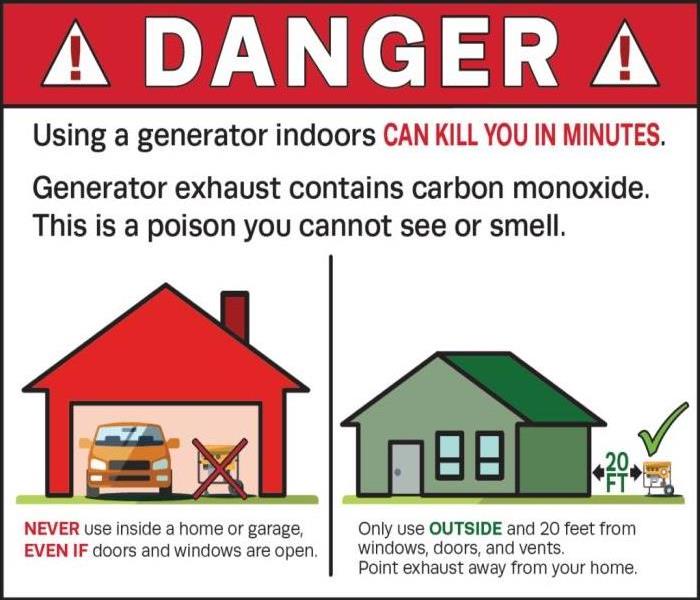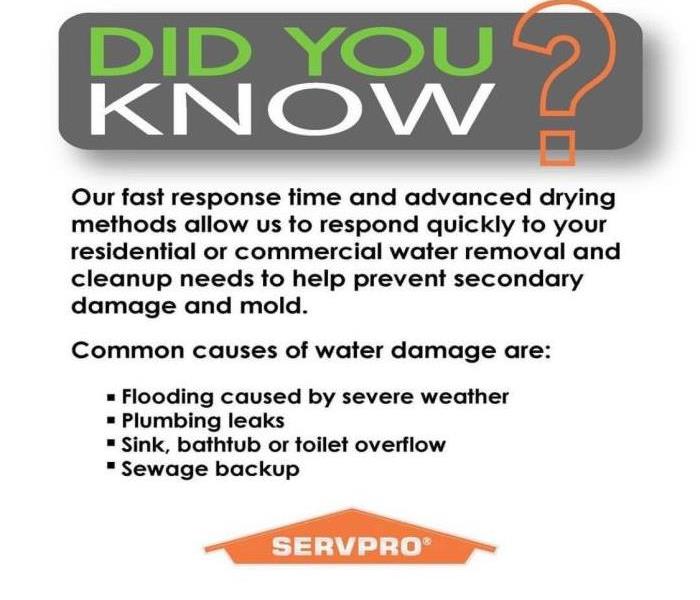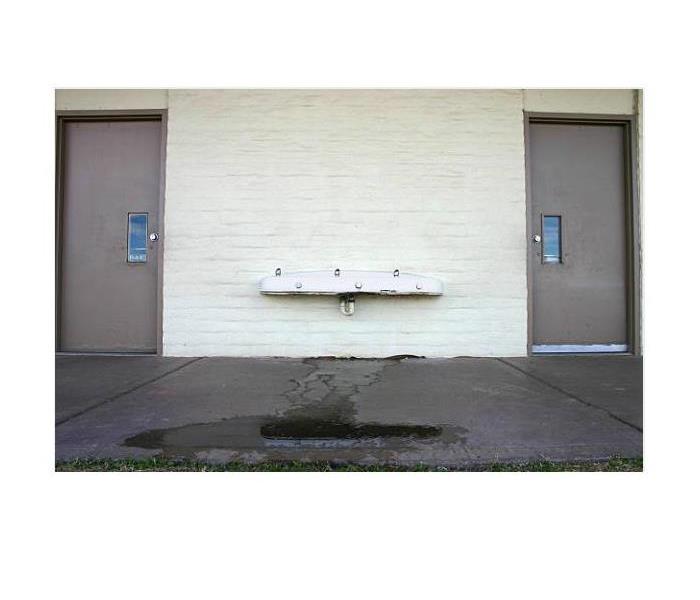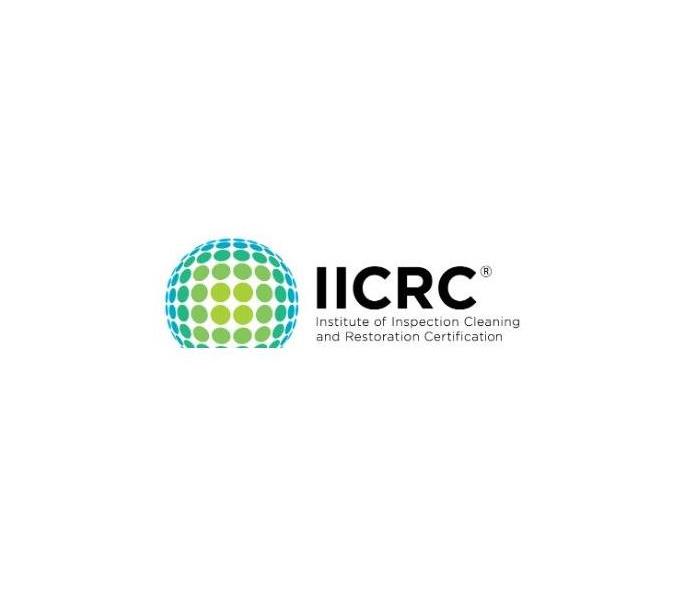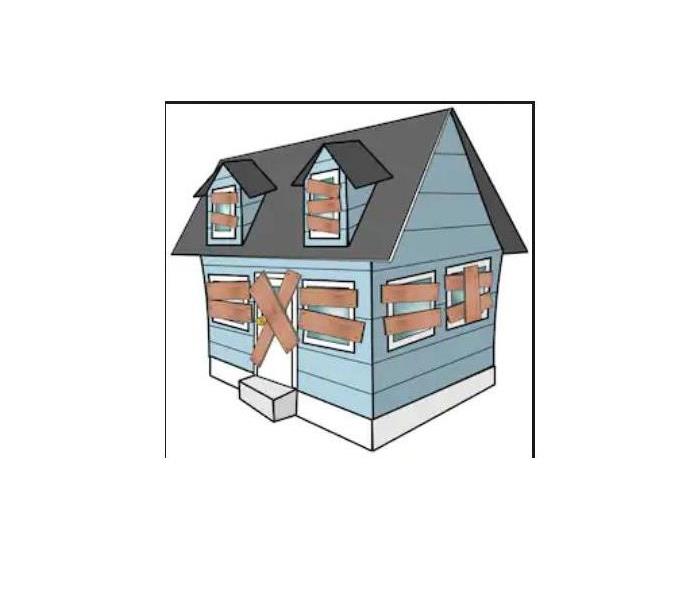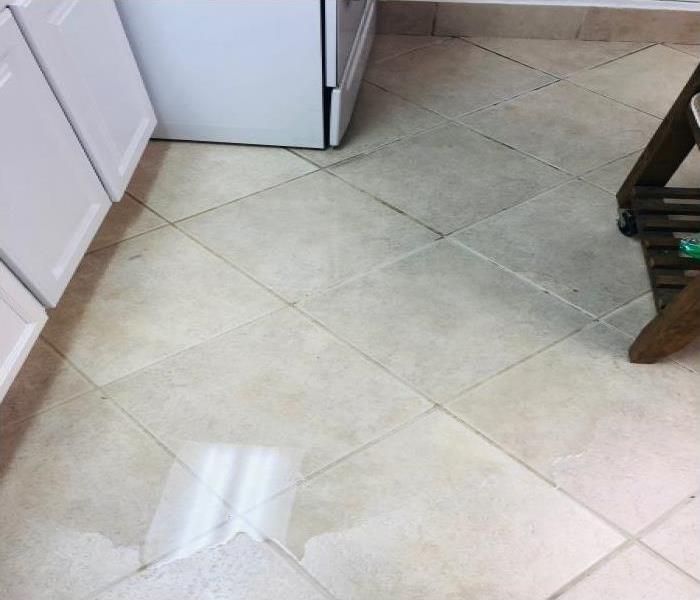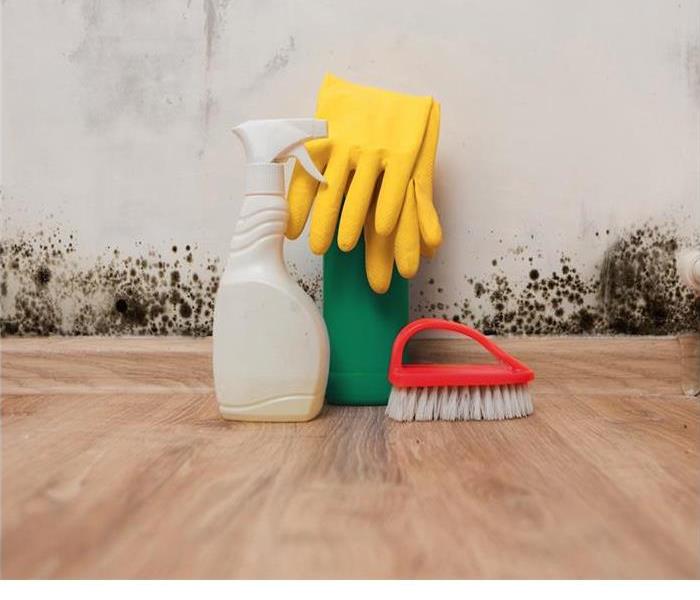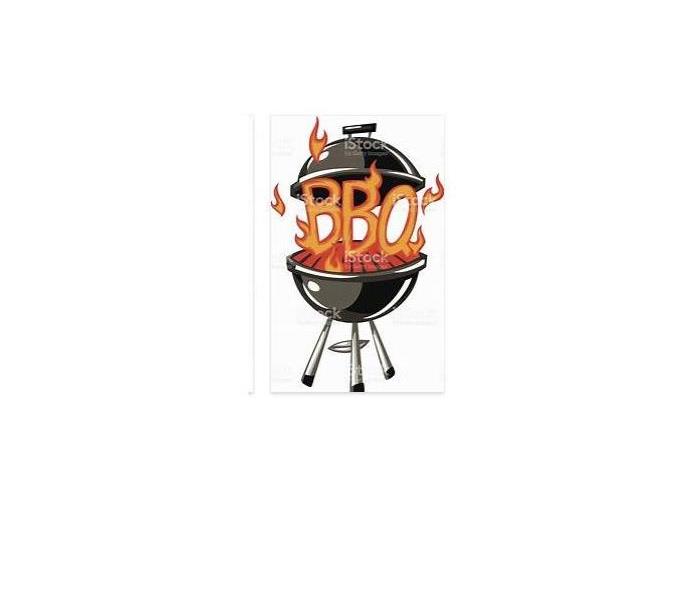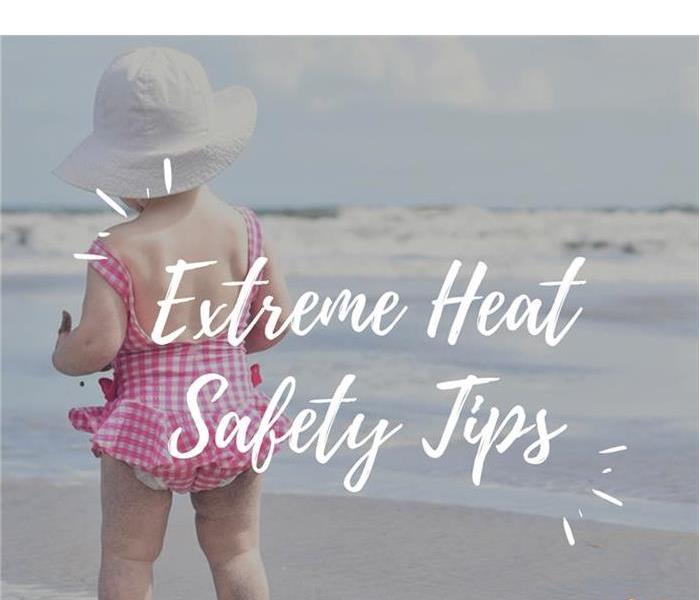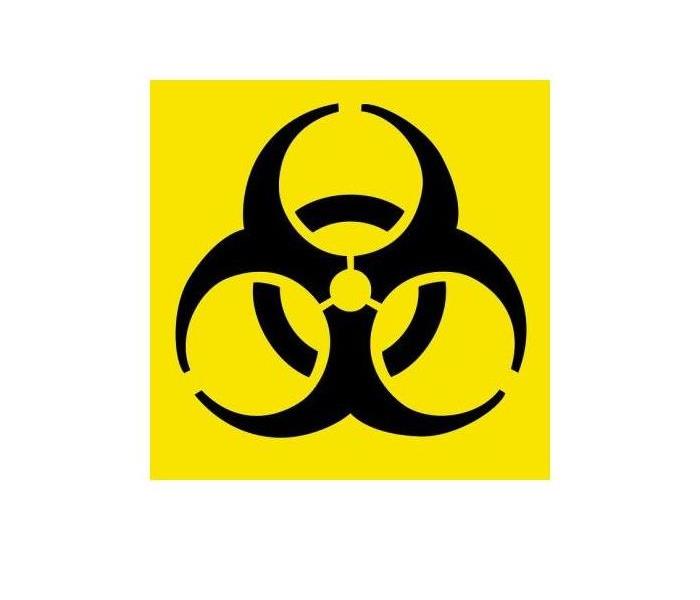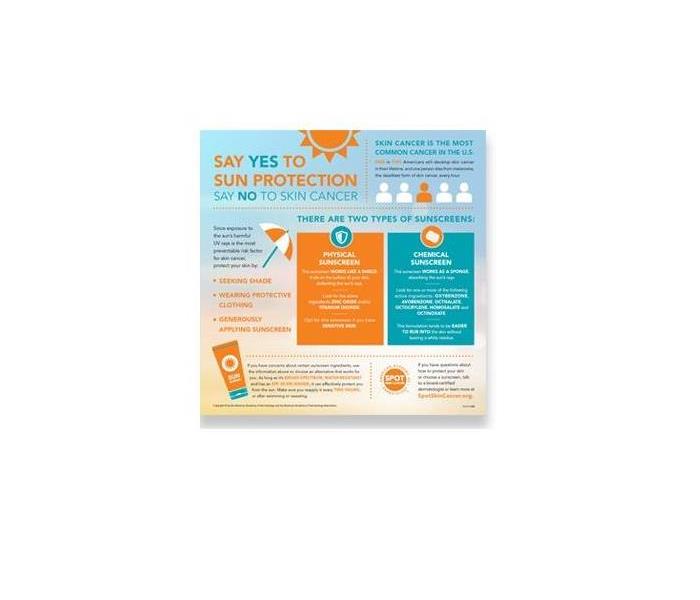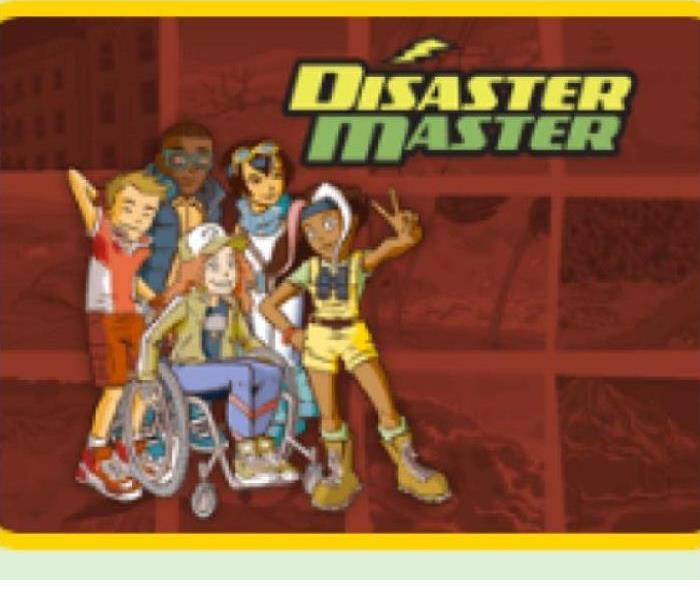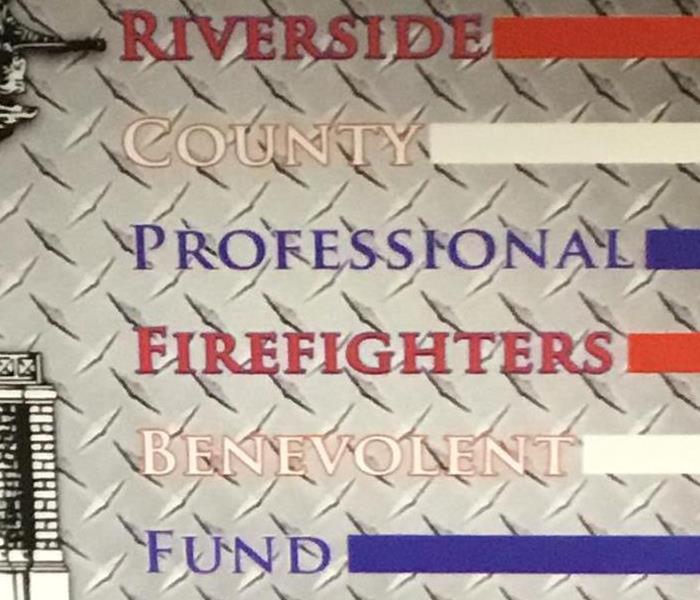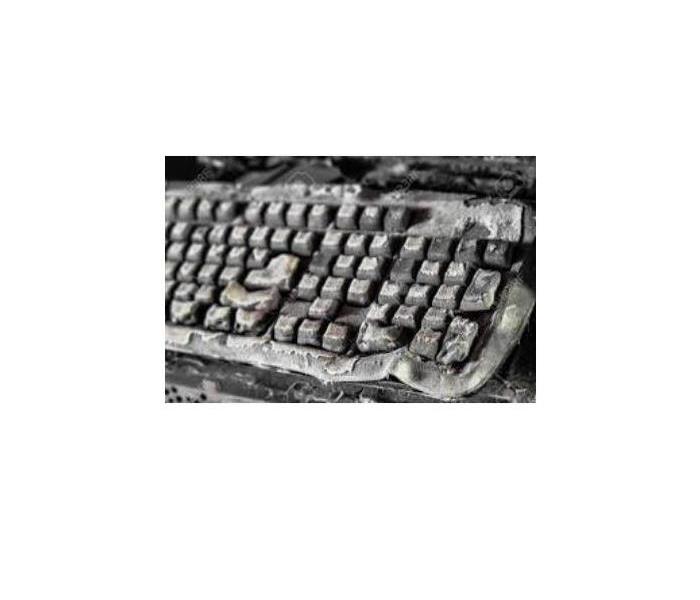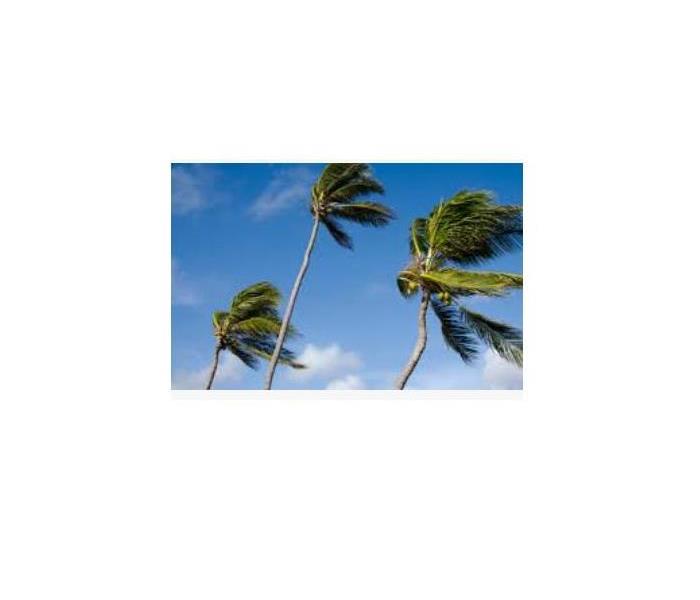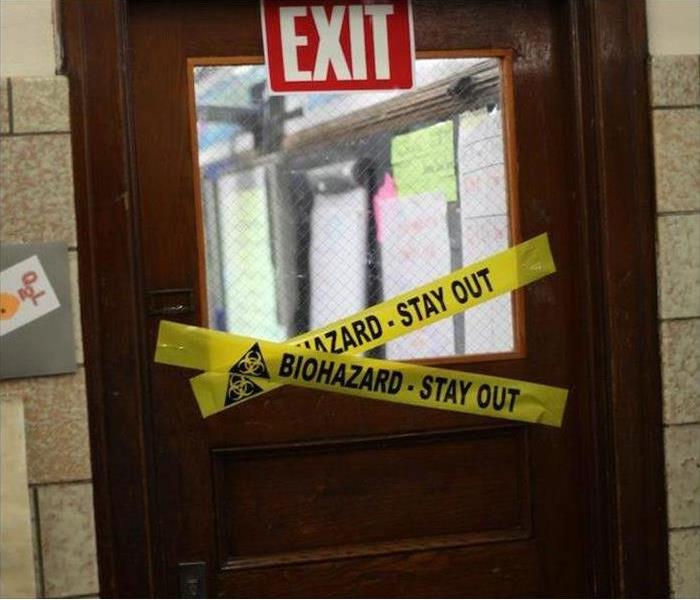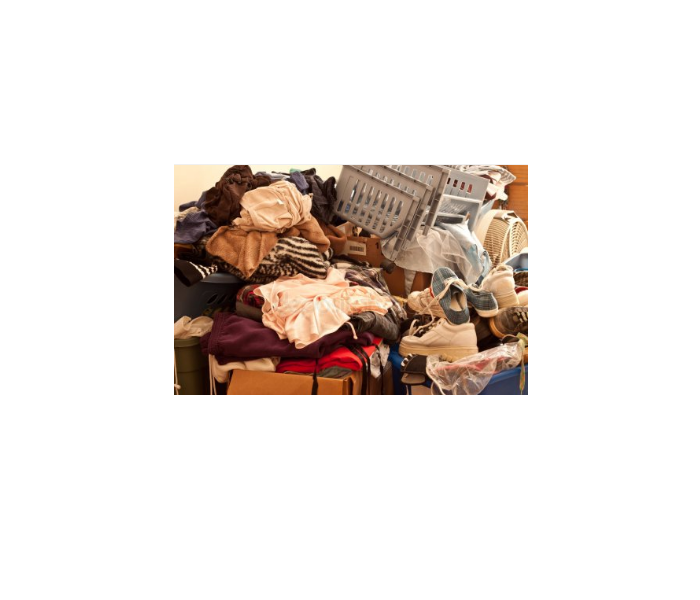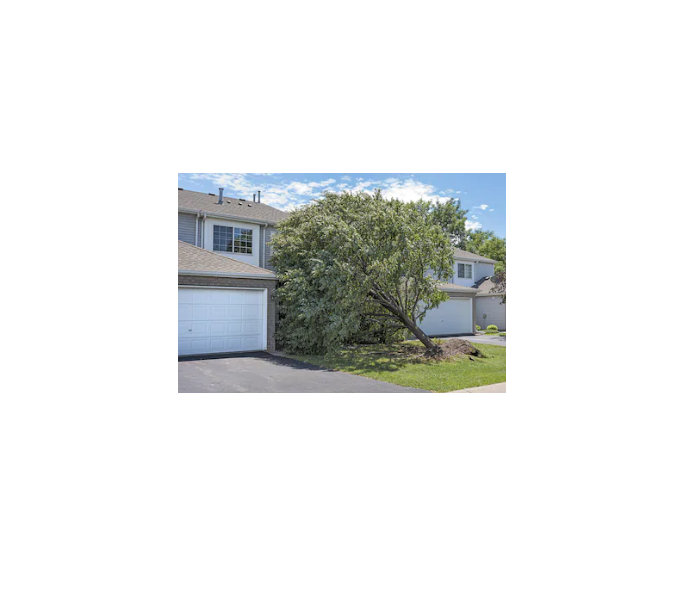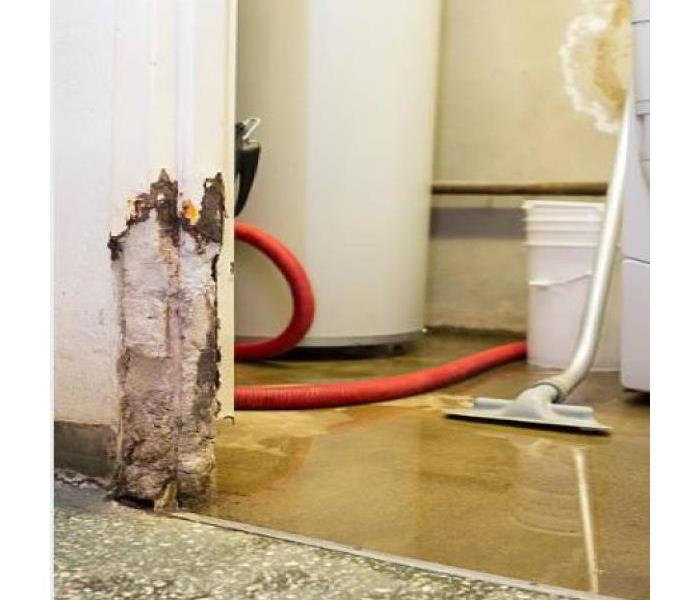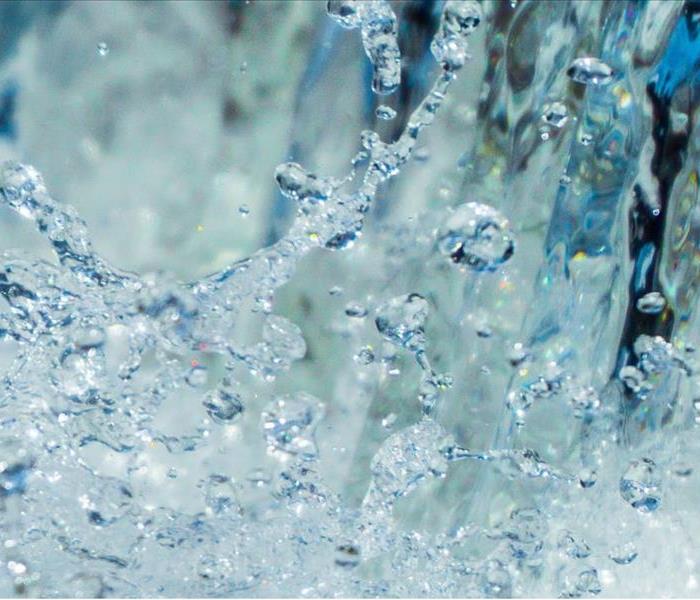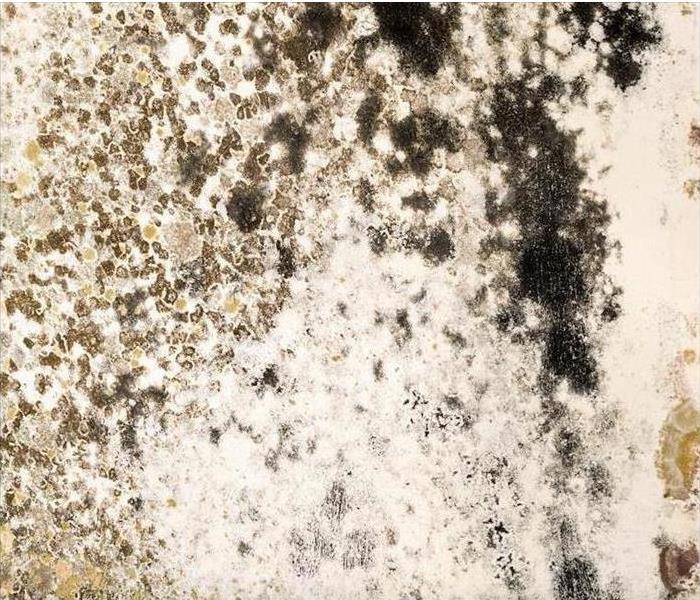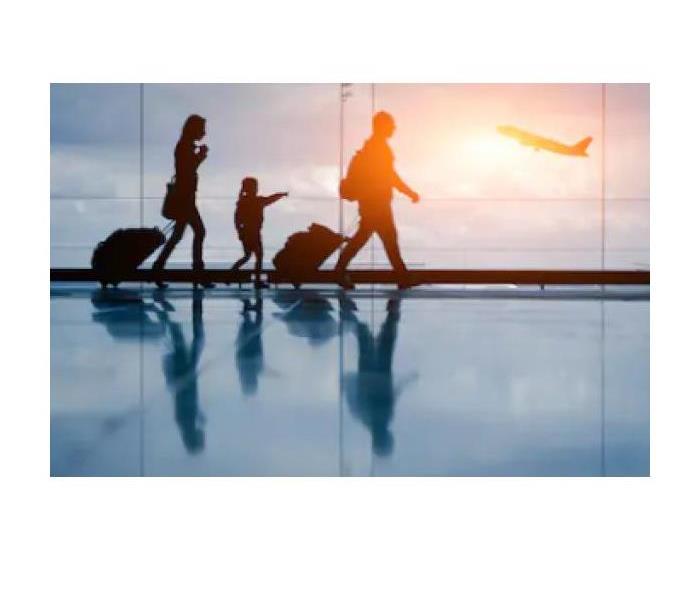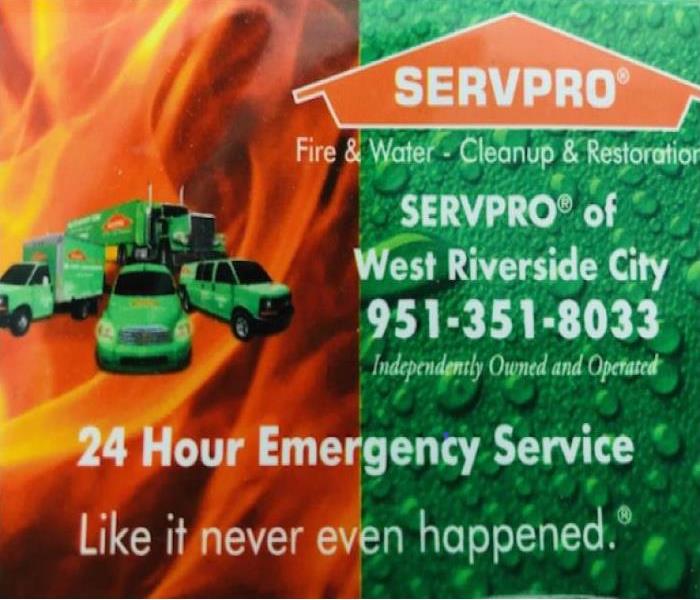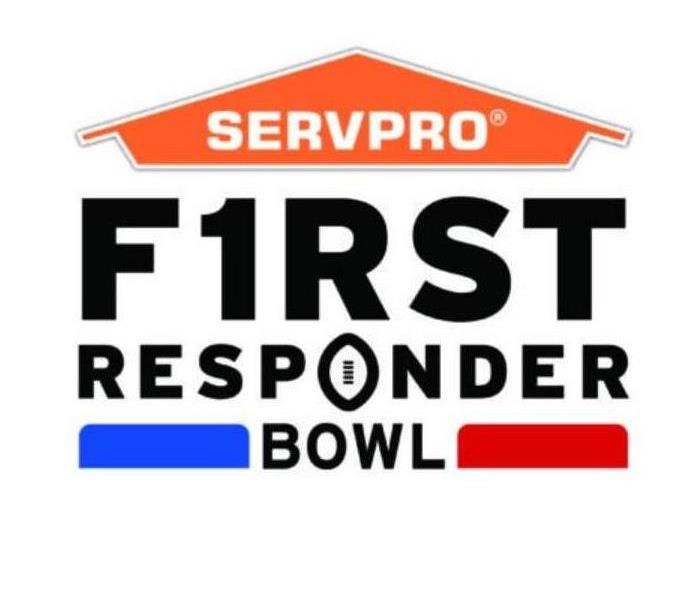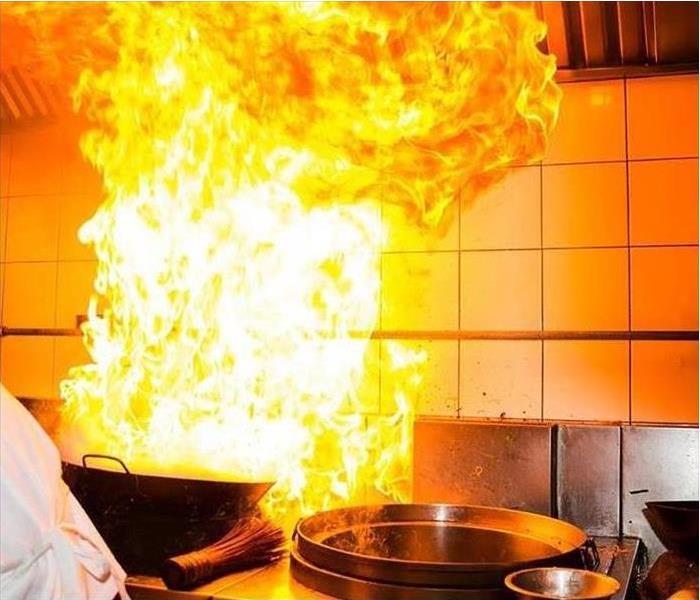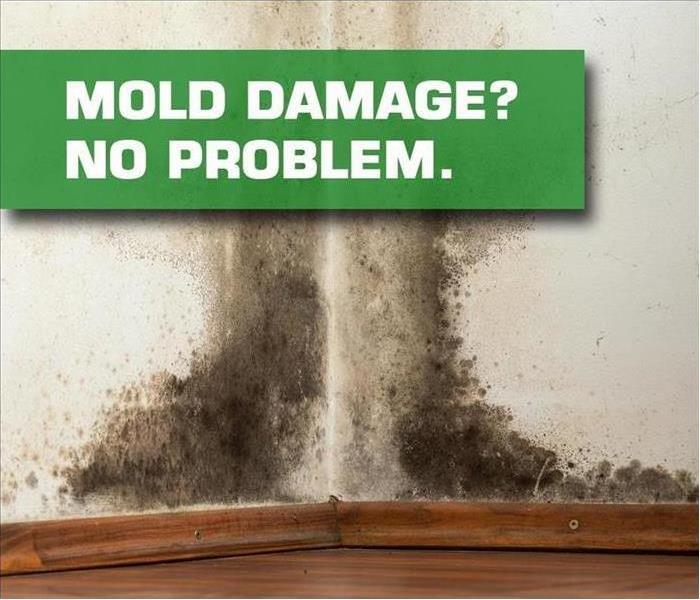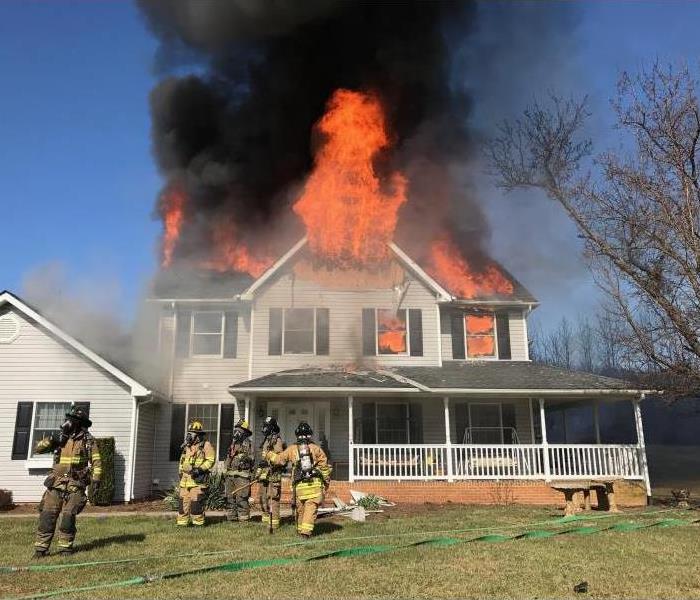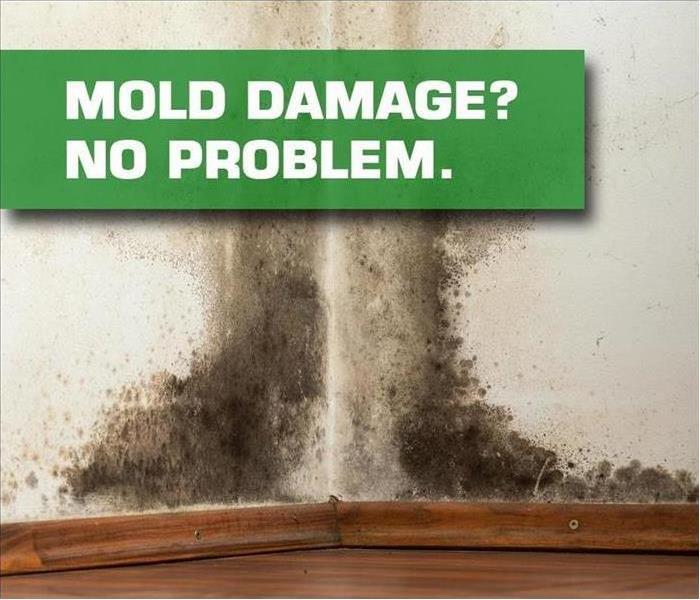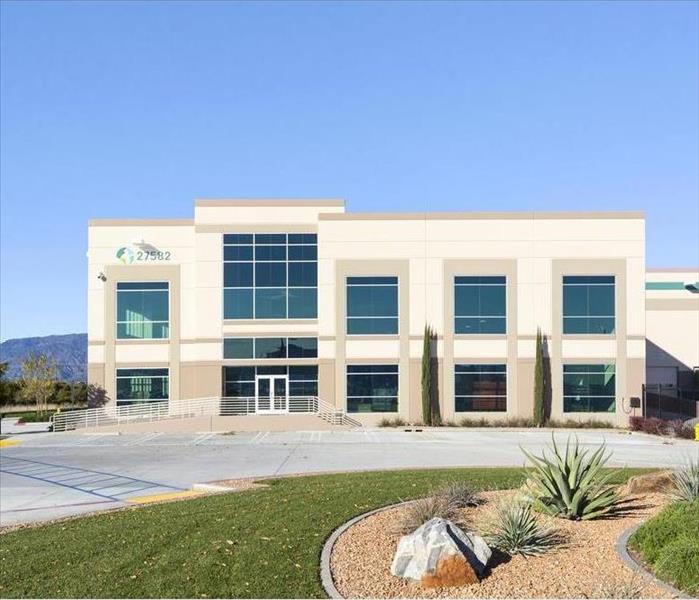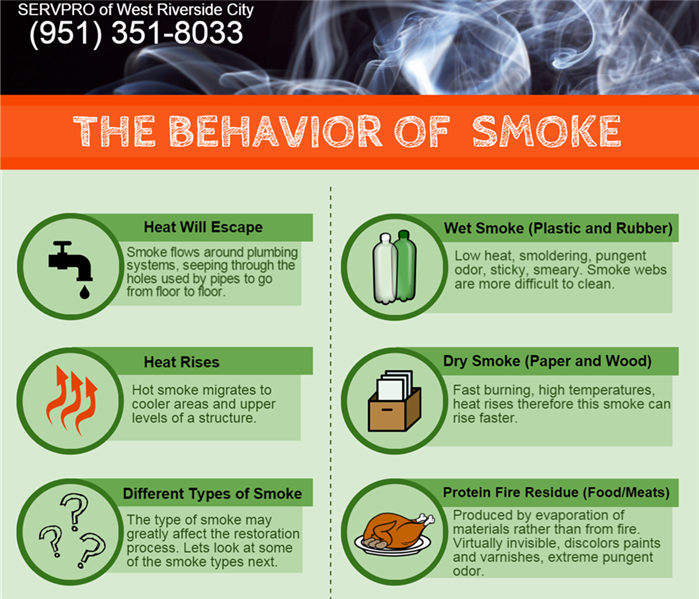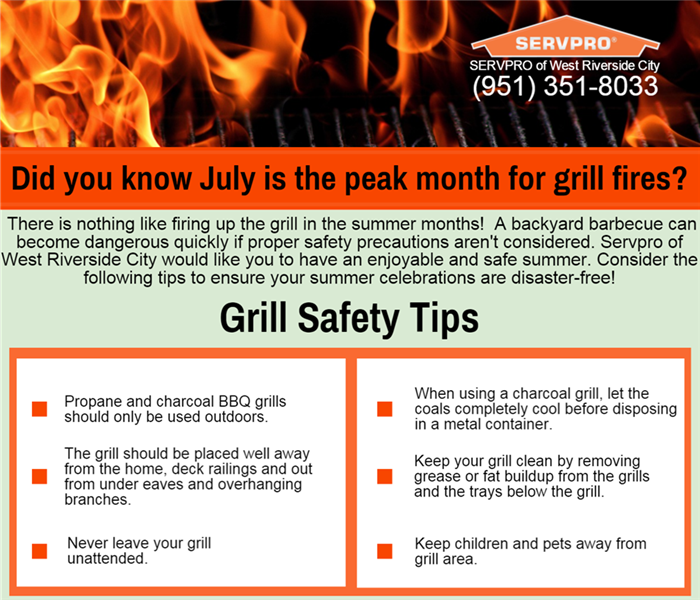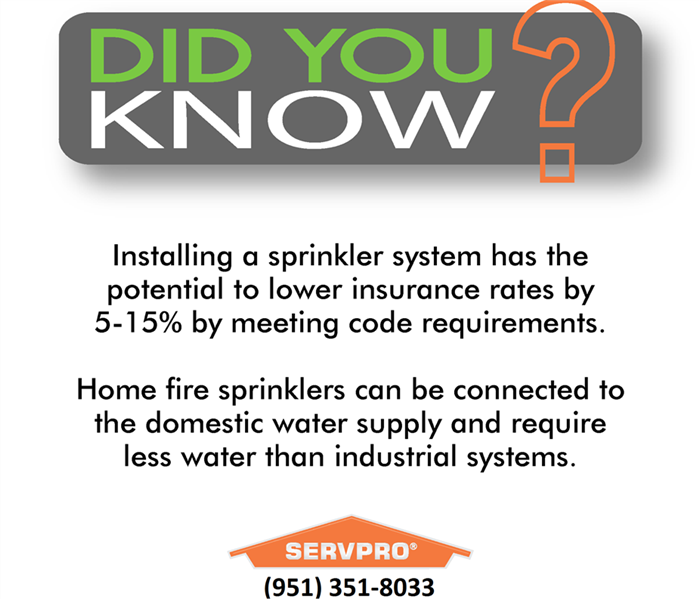Archived Blog Posts
Learn To Secure Your Riverside Property From Water Damage Related Problems
7/31/2022 (Permalink)
Preventing Leaks to Your Riverside Home Is Better Than Mitigating Damages
Water damage can occur in many ways and all we have to do is to know our options to mitigate the effects. For instance, think about the kind of challenges that a clogged gutter can make your Riverside home experience. By failing to address it in time, the water leaks and accumulates around the foundation of your house. Within no time, cracks appear, and that means foundation damage could be the end-result.
Even when the foundation of your Riverside home does not suffer from water damage, there are chances that the resulting dampness may lead to mold growth. Mildew growth may lead to health effects and to avoid that you need to work with a restoration company like SERVPRO. This is when you need the right equipment to extract that water within the shortest time possible. When there is stagnant water on your property, our team may use water extraction method. Vacuum pumps work in such a way that they remove the water from a given area and direct it to a distant place or in a tank outside the house.
One of the most important activities we undertake during a typical water removal exercise is to identify concealed areas that might contain the moisture. Our SERVPRO technicians use specialized equipment such as infra-red cameras, moisture meters, and detectors to sense the presence of water in such areas and work towards removing it. In the process, we inspect whether the ceilings and wooden floors in your property are safe, and if not, we recommend a replacement.
While some water-related challenges are hard to prevent, there are some that our SERVPRO team can help you reduce chances of happening. I am referring to having an inspection of your plumbing system, washing machine, water heater and air conditioning units which are known to cause moisture build-up.
SERVPRO of West Riverside City is a proven industry leader in water damage restoration. Call us at (951-351-8033) at any time of the day for service.
How Do Homeowners Choose Among Riverside Water Restoration Companies?
7/30/2022 (Permalink)
 SERVPRO delivers the assistance you and your water-damaged property needs, adhering to the industry’s best practices for restoration
SERVPRO delivers the assistance you and your water-damaged property needs, adhering to the industry’s best practices for restoration
Have Confidence that Water Clean Up Success Will Follow Your Call to SERVPRO After Burst Pipes Cause Basement Flooding in Riverside
As if you do not have enough on your plate when the supply line to your home ruptures, the task of sifting through dozens of Riverside water restoration companies now delays recovery efforts. Finding a reputable local firm is vital for arranging water removal services and regaining your peace of mind.
How Does SERVPRO Stand Out Compared to Other Riverside Water Restoration Firms?
The sum and substance of premier water mitigation and remediation company is high-caliber workforce training and a scalable inventory of commercial-grade water removal and drying equipment. SERVPRO insists on the Institute of Inspection, Cleaning and Restoration Certification (IICRC) training for all our managers and technicians. Our evaluations, plans, and interventions for your project offer you a clear advantage by prioritizing:
Assessments by managers and crew chiefs with extensive experience in resolving residential basement flooding cleanupLicensed and certified crews and fully stocked service vehicles are ready to ready to roll around the clock.Openness to learning and implementing innovative and advanced resources and technology for both residential and commercial customersHonesty, transparent communication, and integrityWhat Does SERVPRO’s Response Look Like at Your Riverside Residence?
SERVPRO delivers the assistance you and your water-damaged property needs, not only adhering to the industry’s best practices for restoration but also working closely with you and your family to minimize disruptions and stress. Our on-site crews use state-of-the-art equipment to extract all water, clean and disinfect thoroughly and dry all wet materials and contents to proper specifications. At the same time, our office staff facilitates insurance claims and finds answers to all of your water damage restoration questions.
The team at SERVPRO of Riverside awaits 24/7. Call us at (951) 351-8033 for prompt and professional water damage repairs.
How to Clean Water Damage in Your Riverside Home
7/27/2022 (Permalink)
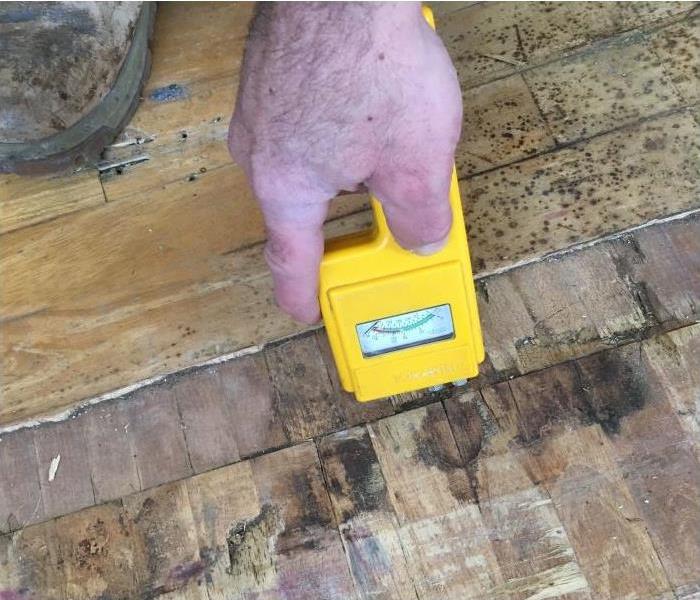 SERVPRO technicians evaluate all contents of your home exposed to water or high humidity for cleaning and restoring.
SERVPRO technicians evaluate all contents of your home exposed to water or high humidity for cleaning and restoring.
Water Damage Restoration and Cleanup for Your Home in Riverside
Any kind of water disaster in your home in Riverside can be stressful and overwhelming. One minute your home is safe and dry, the next minute it could be underwater from a leaking pipe, overflowing tub or toilet, or a broken washing machine. Whatever the cause, you need help cleaning up the mess and restoring your home.
Water damage to your Riverside property requires fast action to get it cleaned up before additional damage occurs. When you call our professionals at SERVPRO, you get trained staff who do not hesitate to get to you quickly. Once we get all the excess water out and your home dry again, our job is to clean and sanitize everything that was affected.
Structural items like subflooring and walls may need cleaning. We use appropriate cleaning methods for each restorable material that was affected by the water using professional products made just for the job. For carpeting, we use a method of cleaning that is right for the level of soiling. We inspect the carpets to see if the dirt is primarily on the fiber tips or ground down into the fibers. We also see if the threads are very matted, or sticky and stiff. If carpet is not restorable, we remove carpeting and padding and dry the surface below.
SERVPRO technicians evaluate all contents of your home exposed to water or high humidity for cleaning needs. Some wooden furniture can require cleaning and polishing from high humidity exposure. We check all storage areas, closets, and clothing for anything needing deodorizing and cleaning. We also look at wall hangings and photographs for damage from high humidity and condensation. Electronics might need special cleaning and drying services to restore them, as might sensitive items like pool tables, pianos, and clocks.
When all our restoration services are complete, we finalize the job by ensuring you are happy with our work. We do one last check on the moisture levels to make sure your home is dry and do a complete walk-through as well, and if any issues are found we fix them before leaving.
SERVPRO of West Riverside City prides ourselves in communication and maintaining a relationship with you throughout the restoration process of your home in Riverside. When you reach out to us at (951) 351-8033, you are getting a trusted company who cares about our customer.
Why do I Need Commercial Water Removal Services in Riverside?
7/26/2022 (Permalink)
SERVPRO Ensures Commercial Water Cleanup in Your Riverside Office is Addressed Quickly to Reduce Damage
You arrive at your office to find that a pipe burst, it adds a great deal of stress. However, having the experts help with restoration ensures your business is back up and running sooner than later. The restoration process often includes securing your contents and moving them to a dry area so mitigation can get underway.
How Do Skilled Technicians Rid My Office of Moisture?
Successful commercial water cleanup in Riverside involves more than removing all visible fluids. Your office has carpeting, furnishings, and small cavities where water migrates, leaving behind notable damage and the potential for mold and mildew growth. Our team of skilled technicians at SERVPRO brings along powerful equipment to tackle the job, including:
• Submersible and truck-mounted pumps that allow us to remove hundreds to thousands of gallons of water.
• Light wand technology for the removal of excess water and moisture from carpets and the padding below.
• Moisture sensors allow us to detect moisture left behind in soft materials, while moisture meters help us to monitor the total moisture content in various materials so that we can determine when the structure is thoroughly dry.
• Antimicrobial agents are applied to fight against the development of microorganisms and bacteria that cause foul odors.
There are some situations where DIY mopping from your maintenance crew can get the job done. However, the real issue lies in failing to locate all areas of hidden moisture where damage multiplies. SERVPRO is Faster to Any Size Disaster, and we work hard to restore your office space to normal quickly so that you can resume daily operations.
SERVPRO of West Riverside City is available whenever you need help with high-quality commercial water cleanup. Give our team a phone call 24 hours a day, 7 days a week at:
(951) 351-8033, and we send out a team as soon as possible to begin the assessment.
Balancing Expectations After Commercial Fire Damage In Riverside
7/25/2022 (Permalink)
Our Crew Is Your Best Option When It Comes To Restoring Your Commercial Property In Riverside To Pre-Damage Condition
The damages left by a fire at your workplace may disrupt regular operations, but perhaps the most pressing issue is the expectations from different parties affected by the blaze. Your customers want you to resume serving them immediately, while your employees could be traumatized by the event thus requiring a few days off. You also need to liaise with the property owner to ensure the restoration done does not lead to friction later on. We offer professional restoration services in Riverside that can help you meet all these needs.
Depending on the intensity of the blaze, restoring commercial fire damage in Riverside can take days or weeks. Giving your regular employees time off as you handle the restoration can help them cope with the loss. Since we send an entire team of restorers from SERVPRO, it is easy for your employees to take days off. Our team handles the core restoration tasks such as cleanup of residues, debris removal and refinishing, as well as mundane tasks such as moving items and rearranging spaces to their preloss state.
Working quickly to fix the damage helps you resume serving your customers as usual. It can also help save costs. For example, smoke residues are acidic so cleaning them from surfaces fast prevents secondary damages like staining. By working in teams, our SERVPRO crew can deliver results faster. We also use different equipment like HEPA vacuums to clean residues from surfaces, and self-propelled scissor lifts to ease access to different sections in a house including high walls and ceilings.
Fire can leave severe damage to structural components necessitating replacement. Apart from the extra costs involved whenever replacements are necessary, there is also a need to involve the property owner to ensure you meet expectations. Our SERVPRO technicians help in different ways. First, we do a thorough inspection to unearth every possible issue including problems in the HVAC system. We also prioritize restorative cleaning over replacement where possible saving unnecessary costs. We also work closely with the parties involved including the property owner and insurance adjusters.
Seeking professional help makes it easier to deal with the different aspects of fire damage. Call SERVPRO of West Riverside City to assist. You can reach us at (951) 351-8033 any time.
Who Helps with Storm and Flood Damage in Riverside?
4/27/2022 (Permalink)
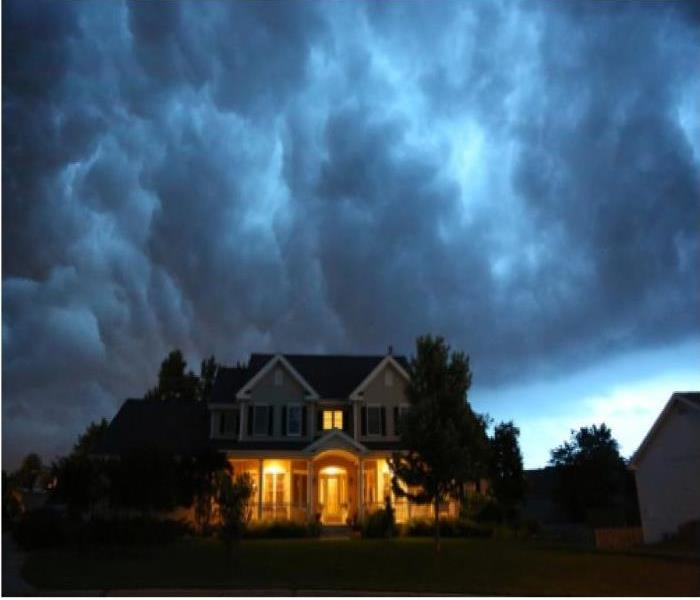 Storm and flood losses can both equally impact and threaten your home. Contact SERVPRO of West Riverside for your Riverside home storm damage.
Storm and flood losses can both equally impact and threaten your home. Contact SERVPRO of West Riverside for your Riverside home storm damage.
Our Professionals and In-House Contractors Provide Full-Service Restoration and Recovery after Flooding.
The combination of both storm and flood damage can be a compromising situation for your entire Riverside household. With so many of the restoration companies that you might choose only capable of addressing part of the problems that your home might face, it can be time and money-saving to choose a more comprehensive and full-service approach that our SERVPRO professionals can provide.
Post-disaster cleaning, repair, and restoration of storm and flood damage in Riverside homes begin the moment that our professionals first arrive at your damaged property. From your initial call to our emergency line, you get the full measure of our restoration and reconstruction team that can arrive together to begin vital mitigation and emergency services after structural damage and potential flooding occurs.
What Are the Emergency Services Offered by Professional Restorers?
Emergency services are the immediate tasks that our responding technicians and professionals begin upon arrival. While these actions might vary from one structure to the next, there are several common tasks that many can expect in a flood-damaged property. After substantial storm systems pass through the area, some of these same emergency services can help to clean up the debris and remove immediate risks so that our restoration technicians can get to work on recovering the property. Some of these emergency services include:
Temporary Construction Solutions – As you might expect, after a strong storm system passes through the area, much like we have seen with some weather events in recent years, structural damage is inevitable. By tarping roofs and sealing over structural breaches, we can more efficiently begin extraction and drying inside the house. Tree Removal – The same robust systems that can remove shingles and destroy portions of a standing structure can also knock down trees and break off limbs. Falling portions of trees can be destructive to your home and its roof. Our professionals can remove these limbs or trunks of trees to get the structural openings covered back over. Content Management – Your personal belongings are one of the priorities that need protection when our professionals first arrive at your home. We assess each item on a case-by-case basis, determining if we can restore it on-site or if off-site restoration and recovery are necessary.How Can Flooding Get Resolved Quickly?
When you recognize flooding has occurred in your home, it can be overwhelming to see. One of the struggles that homeowners face in this situation is taking the appropriate steps immediately to get the flooding cleaned up and extracted. The longer that you wait to address this moisture and standing water, the more destructive it can become to the house. When you choose our SERVPRO professionals, you are choosing:
Fast Extraction – Extraction is one of the vital elements of restoration and recovery after substantial water losses or flooding impact your home. Our professionals have capable extraction equipment like trash pumps and truck-mount extractors for continual, powerful removal of standing water.Efficient Drying – Drying your home after a flood can only happen after extraction and debris removal take place. Because water can migrate quickly through the house and into porous structural materials, drying involves a wide range of cutting-edge tools and equipment. Moisture Detection – The ability to check on the progress of our drying in real-time is one of the advantages of professional restoration. We can be continually moving drying equipment to provide the most efficient and thorough drying approach. What Extraction Tools Are Best?
Because extraction is such a pivotal element to the successful restoration of your home after a flood, the choice of the right equipment for the job becomes a vital decision. Choosing wrong can lead to longer or more costly restoration periods. Some of the ideal choices for this work include:
Submersible PumpsWet VacuumsCarpet WandsDoes Build Back Start Right After Restoration?
As a full-service restoration and recovery team, we have a full team of in-house contractors that can oversee the reinstallation of damaged materials. In most cases, reconstruction and repairs can begin as soon as mitigation completes. This seamless transition is one that can prevent West Riverside city longer recovery times or higher costs.
Storm and flood losses can both equally impact and threaten your home. In most situations, you can address both of these scenarios the same by contacting our experienced SERVPRO team. With our fast response and premier equipment, we can make it “Like it never even happened.” You can reach our experienced team 24/7 at (951) 351-8033.
Steps That Must be Completed When Dealing with Water Removal in Riverside
4/25/2022 (Permalink)
SERVPRO Offers Swift, Professional Water Extraction to Mitigate Damages for your Riverside Home
Water damage might occur in your residence in Riverside when you least expect. It can be a shattering experience, and not too many individuals may know what to do when it happens. Note that it demands reaction as soon as possible to help reduce damage and salvage as much property as possible.
Homeowners in Riverside may not have the know-how to deal with water damage efficiently. You are better off working with professionals who have the training and equipment to extract the water and restore your home to its preloss condition.
SERVPRO is your go-to partners when seeking a reputable water damage restoration company that offers 24-hour emergency service and has the expertise and training to handle the removal and drying services. A Trusted Leader in the Restoration Industry, our SERVPRO technicians, can arrive swiftly to identify the source of moisture in your house. If the water intrusion is caused by a plumbing or appliance issue, we can attempt to shut-off the valve, preventing further water from spilling onto your home.
From here, our experts identify the category and classification of water damage. We do this to ensure that correct techniques are utilized that are based on industry guidelines. Contamination levels affect the restoration process. Many water issues do not soak large areas of possessions and building elements but require a vacuuming to mitigate damage and then the removal of lingering moisture.
Our SERVPRO WRT water damage restoration technicians move property contents and furniture from the affected areas to mitigate secondary damage. We also can block the items to prevent further stains, rust, and degradation. We inspect the carpet pad to determine if it can be salvaged or discarded. We try to restore rather than replace whenever possible. Depending on the extent of damage, experts may also utilize deodorizers and disinfectants as part of the treatment process.
Our SERVPRO crew typically discards non-salvageable items with the approval of the homeowner and if involved, the insurance adjuster. Our aim is complete customer satisfaction with our services. Our technicians go the extra mile.
Contact SERVPRO of West Riverside city anytime you need professionals to handle a water problem. We proudly serve Inland Empire and surrounding areas. Reach us at (951) 351-8033.
Why Professional Biohazard Cleanup and Restoration Is Important For Your Riverside Home
4/20/2022 (Permalink)
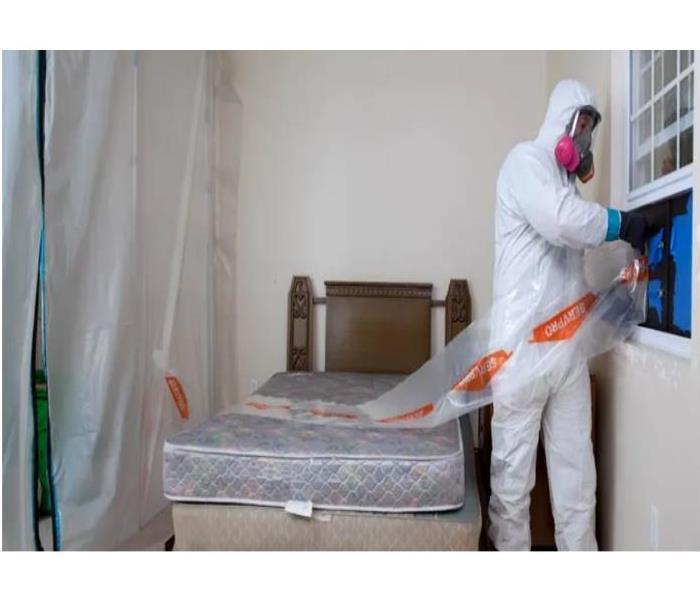 When you need biohazard cleanup and restoration services, trust the SERVPRO of West Riverside City team to help you through every step of this process
When you need biohazard cleanup and restoration services, trust the SERVPRO of West Riverside City team to help you through every step of this process
Be Safe and Let SERVPRO Cleanup Any Biohazardous Conditions at Your Property
There are plenty of disasters that can threaten your Riverside home. Among the most serious and traumatic of these events often require unique practices to safely clean and restore. From something as unfortunate as a sewer backing up into your home to the crime scene and homicide/suicide damage restoration and cleanup, professional assistance is required to remove all of the potential contaminants in the area and to help you and your family move forward in the house.
Biohazard cleanup and restoration in your Riverside home might be a requirement for several different reasons. Exposure to biological materials, bloodborne and airborne pathogens, and the presence of chemicals can make a home unsafe and dangerous to live in. Our SERVPRO team can help you to overcome these obstacles to safely live in your house once again, by providing a professional and thorough cleaning and restoration process that conventional cleaning methods just cannot replicate.
As with any biohazard cleanup, proper training is at the heart of what our SERVPRO technicians offer your home in the wake of a severe disaster or recent tragedy. That is why many specialists on our team get specially trained in the most modern and effective restoration techniques for all manner of contaminants and foreign substance so that this knowledge can get translated into a thorough and efficient process in your own home.
From the moment that our team arrives at your property, we put on our protective equipment and begin meticulously assessing the damage and hazards present in your home. This process provides a concise strategy for our SERVPRO technicians to follow, from the tools that we need, to the techniques to employ. This inspection also details the areas that require our attention overall, from issues with building materials that require cleaning or replacement to widespread concerns that simultaneously affect multiple rooms.
There are unfortunate circumstances that can make it unsafe to live in your own home. When you need biohazard cleanup and restoration services, trust the SERVPRO of West Riverside City team to help you through every step of this delicate process. Give us a call today at (951) 351-8033.
This page provides a listing of the Safety and Health Topics pages OSHA maintains for various biological agents and toxins. here.
What is the Difference Between a Protein Fire and Typical Fire?
4/18/2022 (Permalink)
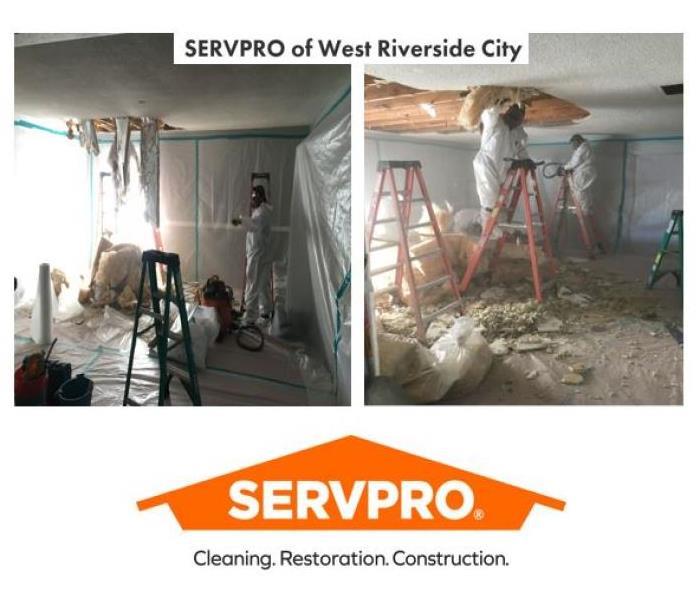 A protein fire caused the damage in this Riverside home. The smell permeated into the insulation. SERVPRO of West Riverside city was called to help!
A protein fire caused the damage in this Riverside home. The smell permeated into the insulation. SERVPRO of West Riverside city was called to help!
You're cooking a ribeye on the stove, you get distracted and forget you have it cooking.
Wait! What's that smell? You've burnt the rib eye that you left unattended in the pan!
Protein Fire occurs when the decomposition of animal fats from beef, poultry, fish among others produces a fine clear mist, which has a very obnoxious odor that is capable of penetrating even the smallest of areas.
Many homeowners may think a home fire is a home fire but there is a big difference between protein fires versus typical fires. Many homeowners underestimate the damage of a protein fire because they don’t see the “typical” black smoke residue commonly associated with home fires. A protein fire produces a fine mist that has a rancid strong odor that can also compromise structural materials and contents in the home. These protein residues can penetrate cabinets, drawers, air ducts, furniture and clothing. A quick fix cleanup will not adequately remove the mist and odors as the proper cleaning steps are required to remove this odor from the structure and contents. It takes extensive cleaning of walls, floors, ceiling and contents of the home to rid the home of this offensive odor.
How Does the Fire Start?
It’s actually not the meat that catches fire but the grease. As the meat slowly cooks in the pan, the sides get coated with grease, which is what catches fire first. The burnt meat adds to the catalyst and that’s how the flame rises. Grease fire can quickly spread all over the stove if the knobs and other areas are covered with grease too. The soot slowly starts to cover the walls and floor which makes the tiles slippery and greasy.
When you enter the kitchen, the smoke smell goes through you and folds you in its odor. Your clothing smells like smoke, as well as your hair. The smoke smell permeates the house for days.
What Are the Signs of a Protein Fire?
The signs of protein fires may after burning food, but they also will build up over time.
- Persistent meat or grease smells that become rancid over time
- Sticky surfaces that are nearly impossible to clean
- Yellowish to brown stains that form drip-like patterns
- Brown or black soot stain that seems to appear after cooking
There may not be any noticeable damage, but there might be a foul odor that you just can’t seem to get rid of, no matter how many times you Febreeze! This odor permeates furniture and structures in your home even more so than other fires. Since protein fires usually occur in a small space of the kitchen, the odor can be pushed into floorboards, cracks in the wall — even electrical outlets! No wonder it’s such a frustrating and confusing mess.
To prevent a protein fire in your home, make sure that you don’t leave foods such as eggs, meat or beans on the stove when you are not home and make sure to keep these foods from burning or boiling over.
You Need Professional Assistance
Because of the way the residue penetrates into porous materials, standard cleaning job won’t do. You need a thorough cleaning. Only specialized cleaners will break up the residue and you need special cleaning techniques to get deep enough to scrub that smell away. In some cases, even that may not be enough, so it’s necessary to apply a sealing agent. You may also need to repaint tainted surfaces. The process is lengthy, taking several days and multiple cleanings to completely remove the scent.
Exercise Kitchen Safety
The best way to deal with a protein fire is to avoid having one in the first place. For that, you just need to follow some basic kitchen safety rules.
Remember to set a timer whenever you cook something. It’s very easy to forget something in the oven, especially if you get distracted. A timer with a loud alarm will save you from this mistake.
Restoration will use very specific techniques when restoring your home and belongings after a protein fire. Our technicians are professionally trained, with unique products and techniques. Using everyday household cleaners will not remove the residue. The products that we use and their application techniques are implemented in stages to ensure that everything in your home are thoroughly cleaned. This process will possibly take multiple days, but in the end, your home will be restored back to how it was. Fresh and no more rancid smell.
Contact SERVPRO of West Riverside City, we have the experience and knowledge to correctly restore your home!
Call us at 951-351-8033
Extension Cords Can Be the Most Dangerous Piece of Equipment
4/13/2022 (Permalink)
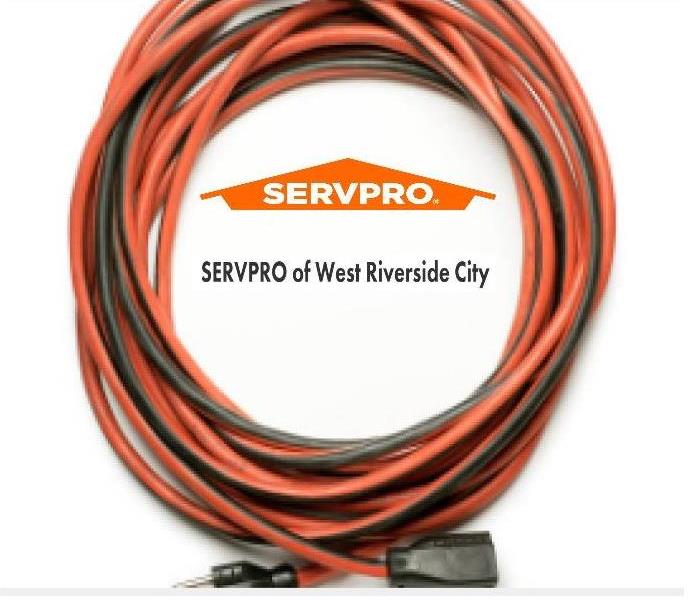 Did you know the extension cord is one of the most abused and misused pieces of equipment on a job?
Did you know the extension cord is one of the most abused and misused pieces of equipment on a job?
One of the most common pieces of equipment used in mitigation work, besides air-movers and dehumidifiers, is an extension cord.
They are the easiest way to provide electrical power to a piece of equipment with a cord too short to reach an outlet. But, did you know the extension cord is one of the most abused and misused pieces of equipment on a job?
Have you looked over some water mitigation teams and noticed extension cords that were plugged into an outlet? Were these cords rolled up, laying on the floor? What if it was a 100 feet of cord? My first thought is—my, that is a trip hazard. Why was such a long extension cord being used for such a short distance?
When a long extension cord is used, this will cause a drop in voltage to the piece of equipment being powered. It will also overload the extension cord. And too, I am sure we have all seen the extension cord that is curled up like an old phone cord. If so, this is a cord that has been overloaded and should be replaced.
By OSHA standards, the maximum length of an extension cord is 100 feet. There are three basic types of extension cords—light-duty, medium-duty and heavy-duty.
Light Duty - 25-feet light-duty cables typically come—18 AWG. 50-foot cords—16 AWG, and 100-foot cords—14 AWG. Most light-duty extension cords do not come with a grounding wire and should not be used on a job site.Medium Duty – 25-feet medium-duty extension cords recommend a16 AWG. A 50-foot cord—14 AWG, and a 100-foot cord—12 AWG.Heavy Duty – 25 ft. heavy-duty extension cords recommend 14 AWG. 50- foot cords —12 AWG and a 100-ft. cord—10 AWG.AWG stands for American Wire Gauge. This is the US standard measure for the diameter of electrical conductors. The higher the AWG number is, the smaller the wire diameter is.
What are some common mistakes made when using extension cords?
Plugging one into the other –The maximum length of an extension cord is 100 ft. by OSHA standards. This doesn’t mean to plug two 50 ft. cords together to reach the distances needed. Use the correct length and AWG needed for the job. Daisy-chaining extension cords could lead to overheating and cause a fire.
Trip Hazards – People can trip over extension cords if not properly placed around the walls. They should be placed out of high foot traffic areas. Never attach extension cords with staples or nails.
Not checking the power rating – If you are dealing with extension cords, you should know the amperage rating of your equipment. Each piece of equipment requires a certain amount of power. The manufacturer describes this along with the amperage rating. Each extension cord can only handle a particular amount of power. Make sure you always match the equipment cord to the same AWG of the extension cord or larger.
Not inspecting – Due to high use and high abuse, extension cords should be visually inspected for damage prior to each use. Look for external defects such as deformed or missing pins, missing grounding pins, loose plug or receptacle ends, broken plug head, uses of duct or electrical tape, damage to outer jacket or insulation, and pinched or crushed outer jacket.
Repairing cords – Any damaged extension cords should be replaced and never repaired. If damaged, remove from service and destroy.
Remember—before setting up your next job, be mindful of the size and how much equipment you are plugging into the extension cord you are using. It’s worth taking the time to properly inspect.
Spring Cleaning - DIY Homemade Cleaners
4/11/2022 (Permalink)
 Spring is for cleaning! Try these DIY cleansers!
Spring is for cleaning! Try these DIY cleansers!
Spring Cleaning safely and Naturally!
This year for spring cleaning, try making your own cleaning products at home with natural and unprocessed ingredients! Make your home environment safer for your children and pets.
Here are 7 cleansers you can DIY, give them a try!
Home Made Glass Cleaner
*Mix 1 part Vinegar with 2 parts water
*Add ½ teaspoon dish soap for every cup of water
*Shake to mix
ALL-Natural Homemade Floor Cleaner
*1 part water
*1 part white vinegar
*1 part 70% Isopropyl (rubbing) alcohol
*A few drops of liquid dish detergent
*1/4 part lemon juice
DIY Upholstery & Carpet Cleaner
(If you have animals this can be a life saver)
*¼ cup of baking soda
*¼ cup of white vinegar
*3/4 cup of warm water
*1/2 tablespoon of dish liquid soap
Homemade Garbage Disposal Cleaner
*3/4 cup baking soda
*1/2 cup salt
*1/2 teaspoon liquid dish soap’
*1 lemon
After first 3 ingredients are mixed, grate lemon peel into mixture. Then cut lemon the lemon in half and remove the seeds. Squeeze both halves into the mixture until lemon is fully incorporated. Grab a sheet pan, spoon and some parchment paper. Cover the sheet pan with parchment paper, use the spoon to mold in half rounds, and then tap them out onto the pan. Allow the tablets to dry overnight. Place dried mixture into a sealable container.
Clean Your Washer
*2 cups vinegar
*1/4 cup baking soda
*1/4 water
Pour mixture directly into the machine’s drum. Run a normal cycle at least twice. Make another batch and use a brush and scrub the edges.
DIY Dishwasher Detergent
*2 cups of Borax
*2 cups washing soda
*4 packets of sugar-free lemonade Kool-aid.
All-Natural Homemade Floor Cleaner
*1 part water
*1 part white vinegar
*1 part 70% Isopropyl (rubbing) alcohol
*A few drops of liquid dish detergent
*1/4 part lemon juice
This information was compiled from various on-line sources. SERVPRO is not responsible for any and all claims made by these sources. If the mess can’t be cleaned then make sure to call the professionals. Our SERVPRO team is here to help!
Why Choose SERVPRO of West Riverside City!
4/6/2022 (Permalink)
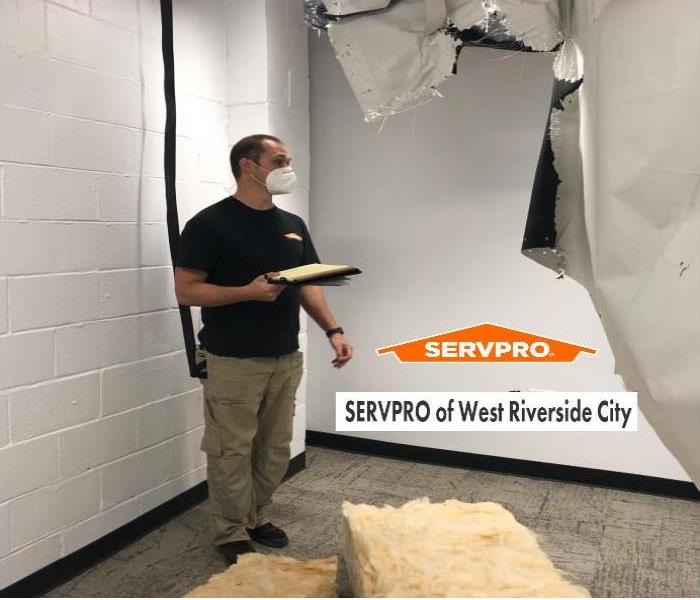 Each team member is trained in clean up and restoration which can range from bio hazard, fire, mold to water damage.
Each team member is trained in clean up and restoration which can range from bio hazard, fire, mold to water damage.
Its more than just the brand recognition, it’s also the qualified personnel, the expertise and dedication to the community that make us the place to call.
Below are additional reasons why:
Qualified
We have the best training in the industry. Each team member is trained in clean up and restoration which can range from bio hazard, fire, mold to water damage. We are IICRC certified (Institute of Inspection Cleaning and Restoration Certificate) for fire and water cleanup and restoration. Our job is to make sure our clients understand the loss and how we will help restore their home or facility. We live up to the motto and we leave each location looking “Like it never even happened.”
Immediate
Our team understands that the best way to limit further damage is to begin the clean up and restore the property as soon as possible. For this reason our team is available 24/7 - day, night, or holiday! This also helps with keeping costs down. We strive to always answer the first call or respond within a few hours.
Latest Technology
We take pride in the fact that we are able to keep up with some of the advancements technology has to offer. This allows us to restore your property as quickly and efficiently as possible so you can get back to what you were doing preloss.
No Loss Too Big or Too Small
Whether you have multiple locations, or a room that has suffered a loss we can help restore your property. SERVPRO is a national company and as a result our SERVPRO of Mattapan & Hyde Park team has access to the 1,800+ other franchises to handle any scope of loss. You call us and we will handle the rest!
Future Loss Prevention
With every job we ensure we understand what the cause of the loss was. We do this to ensure the cause of loss is addressed to prevent similar damage from occurring again.
Our Community
Our office is located in Riverside, California. We love what we're here and we have the ability to help our community. We know the roads, the neighborhoods, and what makes our city so special. It is important to us that our city thrives so we are highly motivated to do all we can to make this an even better city to live in.
Help is always here
Whether you have a question or a loss give us a call and we will help 951-351-8033. We serve ALL - businesses, home owners, property managers and tenants in Riverside and surrounding area.
Cleaning Up After a Fire: 5 Things to Throw Away
4/4/2022 (Permalink)
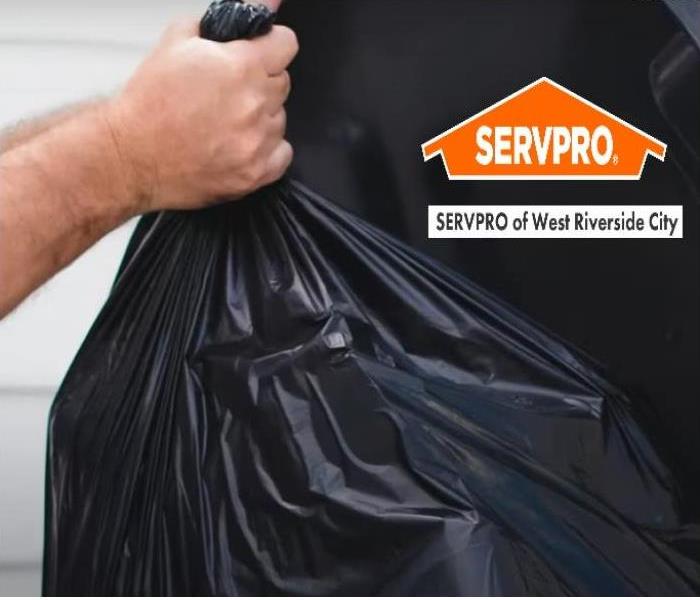 A hard pill to swallow comes when we realize that certain cherished items may have to go away
A hard pill to swallow comes when we realize that certain cherished items may have to go away
We all have a place we call home, where we retire at the end of a hard day's work.
However, the dangers of fires, natural catastrophes and theft remain closer than we may think. When a fire breaks out, the cleaning up process forms a key factor to recovery and healing from the traumatic experience. A hard pill to swallow comes when we realize that certain cherished items may have to go away!
Medication
When a fire razes your home, any medicine present may absorb the high temperature and change the chemical components. The medicine also absorbs the soot and the contents of the fire extinguisher. Ingesting smoke and the contents of the fire extinguisher may expose you and your family to health complications. There are no buts on medications when it comes to choosing what to throw away after a fire.
Food and Other Consumables
The smoke from the fire and fire extinguisher chemicals contaminate any food products. Food products include perishable and non-perishable food products.
Exposure to heat also alters the chemical elements of the food items, including the containers used for storing the food. Cloth packaging, metal tins, cardboard and plastics all change their chemical composition after exposure to high heat levels. Therefore, do not compromise on health at any standard.
Food stored in the freezer may have a slight chance of non-contamination, but it is better to be safe, discard the food. The trauma after a fire coupled with health complications from ingesting contaminated food may weigh down on your recovery process.
Cosmetic Products
The standard while deciding what to throw away after a fire should focus on any products of a chemical nature. Cosmetic products such as make-up, oil products, perfumes and hair extensions have a chemical component. The high-temperature exposure during the fire may alter their chemical composition. Warped casings show that the fire contaminated the products. Fire extinguisher chemicals and soot add another chemical component into the products. Applying any of these contaminated products to your skin may result in an allergic reaction that may add to your woes.
Clothing Material
Any clothes and bedding in the house catch fire. Thus, sort out all the burnt garments and throw them away. Some clothes may have escaped the wrath of the fire but may have soot and fire extinguisher chemicals on their surface. If the clothes belong to children, precaution dictates that you discard them too. However, the use of the appropriate detergents may help to rehabilitate burnt clothes and bedding.
Burnt Electrical Equipment
Electrical equipment within the house has power cords and wiring that may burn during a fire. Electrical equipment that show signs of damage qualifies in the things to throw away after a fire. Compromised electrical equipment could result in another fire due to short circuits. Equipment includes computers, coffee makers, laundry machine, iron box and television sets.
Recovering from the trauma after a fire occurs over some time. The healing process may take time and patience from your side. We at SERVPRO of West Denver understand your pain at this trying time and wish to walk you through the healing process. Let us help you rebuild your new home. We help in the clean-up process and follow up on the tiring process of the insurance claim. To get started, contact us today!
Call Us When Disaster Strikes California!
3/30/2022 (Permalink)
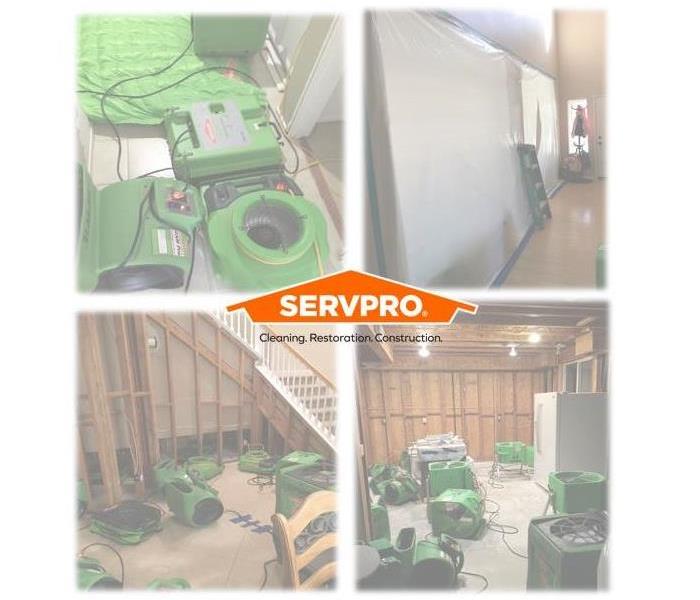 No job is too big or too complicated for our field technicians with the right approach, equipment, and attitude.
No job is too big or too complicated for our field technicians with the right approach, equipment, and attitude.
With decades of experience across the restoration services that we offer, we know how to help when every minute counts.
We have ready trailers and service vehicles prepared to roll out from our SERVPRO facility 24/7 to address the harsh effects of water, fire, storm, and mold losses. We have trained professionals to handle more specific recovery niches like air duct cleaning, biohazard cleaning, abatement, and reconstruction efforts. These talents, aiding in every facet of our customers' work, improve our efficiency and effectiveness in your home or business.
Storm
Storm damage in California homes is a situation that our SERVPRO Professionals can address. Properties I should remain prepared for fires, earthquakes, flooding, damaging winds and other conditions. Our ability to handle these situations is partly due to our commitment to the training and growth of our specialists, ensuring that each loss incidents gets technicians that can:
- Extract and dry up floodwater (WRT – Water Restoration Technician)
- Clean contaminated areas where they exist (Biohazard Cleaning)
- Deploy air movers and dehumidifiers for effective drying solutions (ASD – Applied Structural Drying)
- Clean Carpets and other flooring types (CCT – Carpet Cleaning Technician)
- Prevent microbial growth or address present colonization (AMRT – Applied Microbial Remediation Technician)
The other aspect that has allowed our disaster relief team to become so successful is our commitment to having the top-tier equipment that gets the job done quickly and correctly. SERVPRO keeps storm trucks stocked with a deep inventory of recovery and mitigation tools, including submersible pumps, engine-driven trash pumps, power washers, air movers, and dehumidifiers.
SERVPRO can offer a full-service approach amid a crisis so that our customers do not have to waste time finding secondary contractors to handle other aspects of their recovery. We have the skilled professionals to perform board-up and tarping services for your residence. We can also oversee full-scale reconstruction once mitigation completes in your Riverside property.
Water
We know how easily water loss incidents can develop, and that's why training our restoration technicians in this niche is a constant and continual process. The science of restoring water damage in homes is evolving and consistently changing. So our professionals have to move along with it – putting these new practices and equipment into use to help our customers with the most efficient and practical approach. Our commitment to customer satisfaction and the outcome of your loss incidents goes far beyond our IICRC training.
Our restoration team has access to equipment and machines that far exceed the limitations of conventional recovery tools. The truck-mounted water extractors that our SERVPRO team uses, for example, can handle the removal of thousands of gallons of water every day. Combined with multiple other impressive equipment pieces, this vehicle sets our professionals apart in water damage restoration for the greater Riverside area.
We also have the capability of addressing the massive loss of water damage for commercial properties and houses. 67 years of industry experience and a roster that features Commercial Drying Specialists (CDS) and those with WRT and ASD endorsements, no job is too big or too complicated for our field technicians with the right approach, equipment, and attitude.
Fire
Our team is responsible for many structures in this area alone; the possibility of fire damage is a persistent threat. Knowing the best approach to handle these conditions hinges on the severity of the situation and what materials, surfaces, and contents have become affected. Our IICRC-Certified Fire & Smoke Restoration Technicians (FSRT) and those with additional training in odor control and upholstery/carpet cleaning have access to equipment that can help our team restore loss incidents quickly.
Much of our efficiency in fire recovery stems from these advanced and cutting-edge machines. Soot removal and cleaning, for example, often fall to a combination of specially-formulated cleaning agents and products with automated surface scrubbers that can eliminate residues on surfaces.
Every minute counts in fire restoration. Our technicians obtain IICRC certifications and train to understand how fire damage in Coral Gables homes and businesses spreads and the best approach to overcome the damages.
Mold
Before our certified AMRTs can set up containment barriers and begin the often-intricate process of mold remediation in your Riverside home or business – our professionals must locate the source of the moisture and dampness. These conditions are likely to happen again without adequately identifying how the water damage facilitated mold growth.
You can count the swift response of SERVPRO of West Riverside City team in a crisis. Give our professionals a call anytime that you need us at (951) 351-8033.
Your Riverside Business is Flooded. Now What?
3/28/2022 (Permalink)
If your business has been affected by flood the most important thing you can do is act quickly.
This reduces the level of damage and helps contain recovery costs. If no one is injured the first thing you want to do is call your insurance company. Then do the following:
Be Safe
Make sure your building is safe before you enter. Do a quick assessment of the exterior of the building to see if there are any structural damages. You should also check for possible electrical hazards. The safest thing you can do is to turn off the power if possible. Since there is the potential for electrocution if electricity is still running make sure you are wearing protective gear as you walk through the property.
Be Quick
Time is of the essence when dealing with standing water. It takes less than 48 hours for mold to grow and spread. For this reason you want to quickly remove the excess water. Open windows and use air movers to help with drying. You then want to ensure there are no pockets of concealed water – either under carpet or on water absorbing material (i.e. concrete). If a flood is laden with bacteria or chemicals do not try to clean on your own get a professional like SERVPRO of West Riverside City involved.
If you have suffered a flood or other water disaster at your home or business, call SERVPRO of West Riverside City 951-351-8033
Be Thorough
Make sure you document everything! Take a picture of the damaged condition and anything you are throwing out. This will be important for the recovery process with your insurance company.
If all of this seems like a lot of work that you are not ready or do not have the time to take on do not worry! SERVPRO of West Riverside City can ease the stress and complete the entire process for you.
If all of this seems like a lot of work that you are not ready or do not have the time to take on do not worry! SERVPRO of West Riverside City can ease the stress and complete the entire process for you. All we need is your insurance carrier name and your claim number and we will take care of the rest. SERVPRO offers claim services to both the client and the insurance professionals. They provide an itemized loss inventory when possible. They also offer pretesting on every loss. Since restoring property is usually less expensive than replacing it, this saves the client time and the insurance company money.
We are here for you during this time of need and our trained technicians will make the damage look “Like it never even happened."
When Disaster Strikes, Choose SERVPRO | SERVPRO of West Riverside City
3/23/2022 (Permalink)
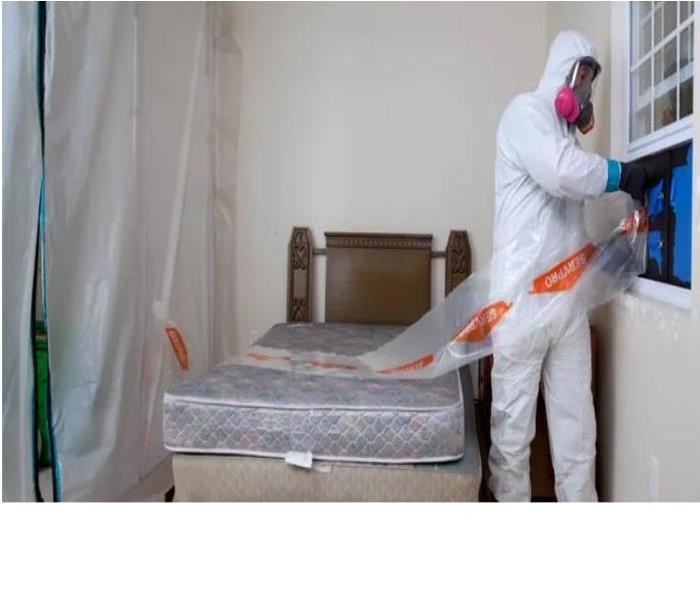 We have custom plans for many situations, and we’re prepared to get your home or business back to normal ASAP!
We have custom plans for many situations, and we’re prepared to get your home or business back to normal ASAP!
Homeowners, business owners and property managers, it’s your job to make sure operations run smoothly.
Keeping morale high and the family happy is a priority.
When something like a disaster strikes, the status quo is upset! All of those responsibilities take a back seat, and you now have a new focus. You may have never managed a crisis before—and that’s why we’re here.
Managing and handling a crisis is our job, not yours! Let us handle the pressure, we do it for a living.
When life tries to get a fast one by you, trust SERVPRO to take over and get you back to normal.
Equipped, Qualified & Ready
Our job is to be ready when needed. When you call, we’ll be on the way in a moment’s notice. We understand there is no time to spare when fire damage, flooding or a natural disaster is at hand.
When a crisis happens, we’re queued up and ready to go.
Being Faster to Any Disaster Is What We Do
When a disaster hits, we understand that we need to drop everything and come running. After all, in a disaster situation, every second counts.
For every minute that passes, mold can grow, and you can have more smoke or water damage. A fast response is critical, and with a local office right here nearby, you’ll be the beneficiary of a local company with national resources.
We Know the Best Disaster Recovery Techniques
Disasters don’t care where or when they strike, and homes and businesses can suffer accidental or natural damage.
We have custom plans for many situations, and we’re prepared to get your home or business back to normal ASAP!
Our Expertly Trained Techs Restore Your Property "Like it never even happened."
We’re not a “here today and gone tomorrow” type of operation. SERVPRO is an expert in the recovery and restoration business because we care about your satisfaction enough to ensure your property is restored to its original condition.
We are committed to ensuring your restoration is exceptional from start to finish.
Fires burn, storms rage, pipes leak—it happens. Your local SERVPRO is ready to take on the challenge so you can get back to life.
Regardless of why you need cleanup or disaster recovery, SERVPRO of West Riverside City has the tools, the technicians and the training to get your situation under control.
We're here for you, call us!
951-351-8033
Planning Ahead in Case of a Burst Pipe | SERVPRO of West Riverside City
3/21/2022 (Permalink)
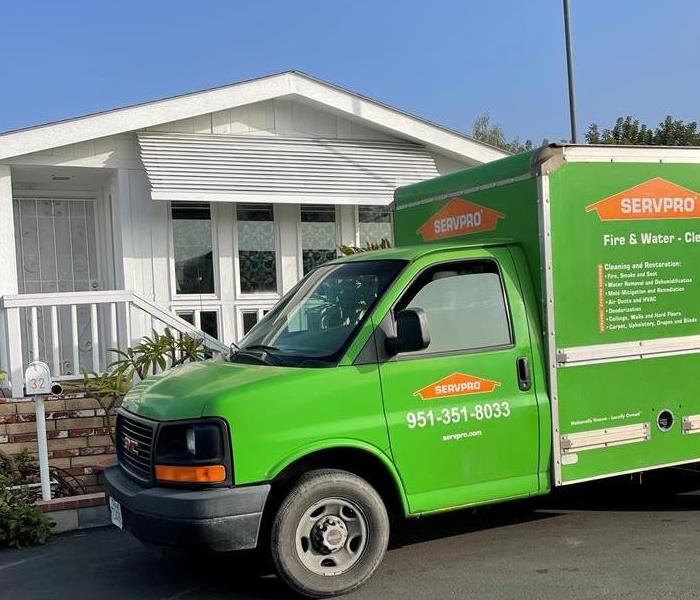 If you have water damage in your home due to a burst pipe or another cause, you can count on us for restoration assistance.
If you have water damage in your home due to a burst pipe or another cause, you can count on us for restoration assistance.
Burst pipes are something that can happen when you least expect it, causing serious damage in a brief amount of time.
While there is no way to know when a pipe may burst, knowing what to do in the event that one does can help you act quickly to mitigate the damage that the water can cause.
In a perfect world, water damage would be a rare occurrence—but many people are surprised to find out how often it occurs. Every year, one in 50 homes will experience some type of water damage, but a plan can significantly lessen the impact that it has.
Having a Plan in the Event a Pipe Bursts in Your Home
Shut off your water main. When a pipe bursts in your home, in some situations, it can continue pouring water into the area, creating even more damage. If it is safe to do so, shutting off your water main can reduce the overall damages that are caused.
Shut off your electricity. Water and electricity definitely do not mix, so if you are able to get to your circuit breaker to cut your electricity off safely, it is wise to do so. This will ensure that if water comes in contact with outlets or appliances, there is not a shock or fire hazard.
Contact your restoration company. Setting your restoration in motion quickly is one of the best things you can do for water damage, so it is wise to get in touch with your restoration company right away. We recommend always choosing a company that is available 24⁄7 so you never have to wait for a call back when you report your damages.
Take a record of the damages. Not only is keeping good records helpful for you, but it will also be helpful if you are eligible to file a claim with your insurance provider. Take photos and videos in addition to making a list of everything that is damaged by the water.
Contact your insurance company. The type of coverage you will receive for water damage of this nature can vary, so your insurance company is the authority on what is and is not eligible to be covered by filing a claim. Contacting them quickly can help you set this process in motion so you can get it settled as fast as possible.
Open windows and doors if possible. If the weather permits and it is safe to do so, increasing the airflow around water damage by opening windows and doors can speed up the drying time by encouraging evaporation.
If you have water damage in your home due to a burst pipe or another cause, you can count on us for restoration assistance. Contact us at any time 951-351-8033 to learn more about our restoration services.
Have You Considered What Could Cause a Fire in Your Riverside Workplace?
3/16/2022 (Permalink)
A fire in an office or store can be devastating to a community.
In addition to potential deaths and property loss, people may lose their jobs and the community may lose a vital service provided by the business. There 18,700 office and store fires in the United States in 2019 that caused $744 million in direct property damage-US Fire Administration.
Electrical Fires
Over 25% of all fires are linked to a malfunction of either a piece of electrical equipment, wiring, or both. Electricity is a common source of ignition for major fires. One way to avoid problems with electrical fires is to establish an electrical safety program.
All employees should be thoroughly familiar with the safety procedures for their particular jobs. To maximize his or her own safety, an employee should always use tools and equipment properly. Extension cords must be inspected before use, and those found questionable, removed from service and properly tagged. Damage or inadequate maintenance can cause equipment to deteriorate, resulting in unsafe conditions.
Flammable and Combustible Materials
There are thousands of chemicals in use in the modern American workplace. One of the most prevalent dangers of these chemicals is their flammability or combustibility. Improper handling of flammable materials brings a great risk of fire. When a flammable liquid is spilled, vapors begin to form immediately. It is the vapors that will ignite, and which pose the greater danger.
Flammable liquid spill cleanup should begin immediately. Vapors will continue to build until the liquid is removed, and they can be ignited by a variety of sources in the average workplace. The best way to avoid fire caused by these materials is to follow all OSHA guidelines when dealing with flammables.
Human Error
The most common reason for a sprinkler system failure is human error. Often times the water supply was turned off at the time of the fire. The success of fire prevention strategies depends primarily on pre-planning, preparation, equipment quality, and the readiness of personnel. Employees and loss prevention practitioners must be knowledgeable about the proper use of extinguishers. If the wrong extinguisher is used, a fire may become more serious.
General Negligence
Negligence is another common cause of fire in the workplace. It’s slightly different from fires caused by human error. Negligence occurs when an employee does not follow established procedures and knowingly undertakes an activity that is a potential fire hazard.
Fire caused by negligence can be the result of:
- Hot surfaces too close to heating equipment
- Open flame that’s not properly located or protected
- Not following smoking restrictions or careless disposal of butts, ashes, and matches
Good common sense, self awareness, and close adherence to policy are a great way to avoid fires caused by general negligence. Posting fire safety signs in common areas is another way to keep fire safety at top of mind.
Grease Fires
If grease is spilt, have it cleaned by staff straight away. Grease left on floors, walls or work surfaces can be extremely dangerous. Not only is it a fire hazard it can also cause falls and other workplace injuries.
Make it a rule within your kitchen – if there’s a spill, clean it up immediately!
Arson
The premise behind arson prevention, like other prevention programs, is to address the opportunity to commit the crime. Arsonists, like other criminals, typically prefer to start fires in locations that are secluded or hidden. Prevention programs often suggest improving the surveillance in these areas by lighting the area, removing visual obstructions to natural observation, and moving the targets such as dumpsters.
Emergency Response Profile
If your Business would like a free Emergency Response Profile, please call SERVPRO of West Riverside city, we can help you collect pertinent information in the event of a disaster.
Contact us:
Office: 951-351-8033
Residents Experience Fire Damage, What To Do While Waiting For Your Contractor
3/3/2022 (Permalink)
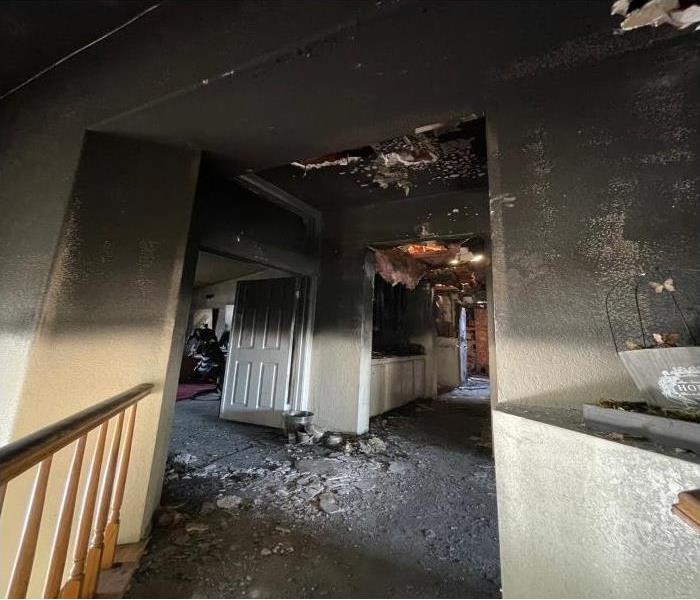 After fire damage, SERVPRO helps Riverside county residents take control and restore their homes
After fire damage, SERVPRO helps Riverside county residents take control and restore their homes
Navigate the restoration process with ease by following SERVPRO’s four tips for preparing for fire restoration services while waiting for your contractor, from addressing safety concerns to minimizing the chance of further damage.
The first step in the fire restoration process should always be calling a trained professional. However, many homeowners find themselves at a loss for what to do after that.
The experts at SERVPRO put together this list of things to do while waiting for a fire restoration contractor to help with that. They also stress that no one should enter the building until it has been cleared for entry by the fire department.
SERVPRO of West Riverside City is a local leader in the fire damage restoration industry. In addition to fire restoration, they offer a wide range of other emergency restoration services, such as water removal and mold remediation.
Fire Damage Restoration Tips: What to Do While Waiting for Your Contractor
#1: Start an Insurance Claim
While the fire restoration contractor will likely help manage the insurance claims process, it helps to notify the applicable insurance company of the fire as soon as possible and open a claim. Likewise, it's vital to take pictures of all the damage before moving anything or beginning any clean-up efforts. Detailed documentation is key to a successful claim.
#2: Air Out the House for Mold and Mildew
Firefighters often use large amounts of water and sometimes even chemicals to put out house fires. A problematic side effect can come in the form of mold and mildew that develops in dark and damp areas. These fungi can compromise the internal strength of the house while also posing potential health effects.
Mold should only be removed by a trained professional due to the risk of exposure to harmful spores. Instead, leave it alone and open the windows to help air out the space. This step may also help with humidity levels.
#3: Only Move Around the House if Necessary
The main concern with initiating cleaning is the possibility of exacerbating any damage. This also holds true for soot which can stick to shoe soles and transfer to other surfaces.
Avoid spreading unnecessary stains and creating more work by limiting movement throughout the space. To this end, it may be prudent to focus on areas further from the damage and leave more significant damage to the fire restoration contractor.
#4: Inspect and Clean Personal Items
Smoke can affect clothing and other personal items in addition to interior surfaces. Avoid loading affected clothing in the washing machine as soot and other small particles can build up and cause clogs. Instead, check the local area for dry cleaners that can handle fire-damaged clothing.
Kitchen items may also require attention if the space is still inhabitable. Try soaking any dishes, utensils, and other kitchen gadgets in water and bleach to remove smoke damage. Do not consume any food or ingredients that were near the fire or suppression efforts, whether it remains intact or not.
About SERVPRO
After fire damage, SERVPRO helps Riverside county residents take control and restore their homes. For more information on fire damage restoration services in the Riverside area, call SERVPRO today at (951)351-8033 for a fast and free quote.
With Chilly Winter Weather, Reduce the Risk of Chimney Fires
2/24/2022 (Permalink)
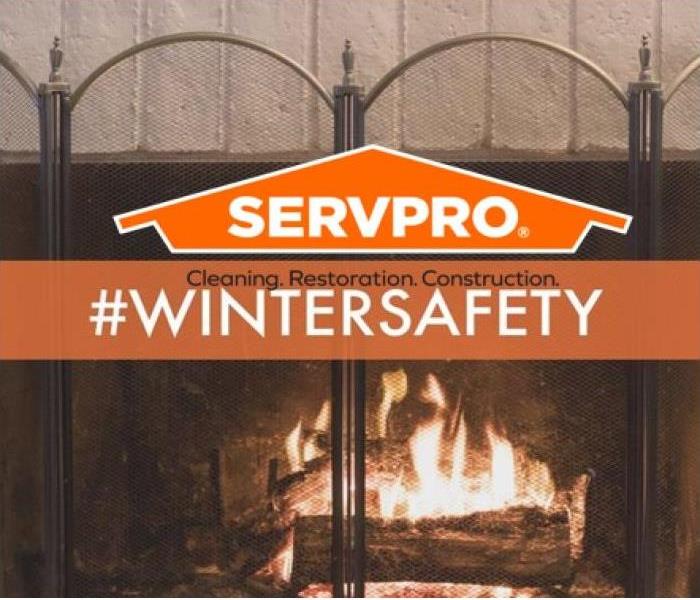 Fire or smoke damage can be an incredibly stressful event, be sure to take the appropriate measures in cleaning and maintaining your fireplace.
Fire or smoke damage can be an incredibly stressful event, be sure to take the appropriate measures in cleaning and maintaining your fireplace.
There is nothing quite like the warmth and glow of a wood burning fire.
Fire is one of humanities oldest tools. It has the power to heat our bodies, cook our foods, refine our metals and light the darkness. We are connected to fire at a primal level and deep down we are all mystified when we see the flames dancing between logs. Nowadays we may be lucky enough to bring that joy inside but the comfort of a cozy indoor fire brings with it, plenty of danger, especially if the fireplace and chimney are not properly inspected and maintained. Here are a few tips to keep your house and family safe from the danger of an indoor fire:
Here are a few tips to keep your house and family safe from the danger of an indoor fire:
- Inspection
According to The National Fire Protection Association, “Chimneys, fireplaces, and vents shall be inspected at least once a year for soundness, freedom from deposits, and correct clearances. Cleaning, maintenance, and repairs shall be done if necessary.” An inspector will come and make sure your fireplace is safe to use and let you know if there are any repairs necessary. If you haven’t used your fireplace in a long time, birds or other creatures may have built nests that could clog your flue or chimney chamber. Winter freeze cycles, inclement weather, and moisture combine to take an annual toll on masonry and liner materials. Year in and year out these elements can cause deterioration that will eventually require attention. Seasonal wear and tear that is left unchecked will affect the performance of your system and the longer the defects go without being addressed, the more expensive the repairs are likely to be. That is why staying on top of your systems is not only the smartest and safest choice but the most cost-effective too. - Chimney cleaning
The best practice is to keep things simple and safe. Make sure to clean the fireplace regularly and know if it’s well built. It is also a good idea to have a professional initially inspect the fireplace and chimney even if you plan to clean and maintain it yourself. The Chimney Safety Institute recommends cleaning the chimney when creosote is 1/4 inch or thicker on the chimney walls or there is visible build up in the system. A chimney sweeping company will take their time to make sure they clean everything and keep your house soot free while doing it. The best time to schedule a cleaning is at the end of the indoor fire season as acids in the creosote, or humidity combined with creosote, can both damage the fireplace mortar. After an initial professional cleaning you should, with the right knowledge, be able to clean and maintain it yourself. Of interest… after cleaning your own fireplace, you could dispose of the ashes and creosote by sprinkling them on flowerbeds. They are a great source of calcium and other nutrients. - Chimney cap
These are a small but important piece of your chimney. Having a chimney cap installed can prevent objects, rain, and snow from falling into your chimney reducing downdrafts which lower the performance of your fireplace. These caps have side vents so smoke escapes and the mesh around the cap sides acts as a spark arrester. Chimney caps also prevent animals and other unwanted guests from making their home in your chimney during the spring and summer months. Another tip is to trim trees back that surrounds the chimney and make sure there is no debris building up on our around it. All in all, even though a chimney cap is a small and generally inexpensive piece of equipment, it can prevent numerous issues from happening. It might also save you thousands of dollars in chimney repairs or damage expense.
SERVPRO of West Riverside City offers these tips from Federal Emergency Management Agency for preventing creosote buildup that can cause chimney fires:
Limited air supply and unseasoned wood encourage the buildup of creosote. To avoid that buildup, do not restrict the air supply by:
- Closing the glass doors
- Not opening the damper wide enough
- The longer the smoke is in the flue, the more likely it is that creosote will form
- By closing down the stove damper or air inlets on a wood stove too soon or too much
- Do not burn unseasoned wood
- In the case of wood stoves, overloading the firebox with wood in an attempt to get a longer burn time also contributes to creosote buildup
Fireplace and Woodstove Safety
- Keep a glass or metal screen in front of the fireplace to prevent embers or sparks from jumping out
- Do not burn paper in your fireplace or woodstove
- Put ashes in a metal container with a lid, outside, at least three feet from your home
- Put the fire out before you go to sleep or leave your home
Experiencing fire or smoke damage can be an incredibly stressful event so be sure to take the appropriate measures in cleaning and maintaining your fireplace and chimney. SERVPRO of West Riverside City specializes in water restoration as well as fire and/or smoke damage and we will do our best to get you and your family back on the couch for a cozy, crackling fire on that cold winter evening.
Call Us!
When Riverside residents and businesses have fire damage, they can trust SERVPRO of West Riverside City to restore the damage, “Like it never even happened.” Call us today at 951-351-8033.
Franchises are independently owned and operated.
Why Does SERVPRO Use Containment During Mold Remediation?
2/21/2022 (Permalink)
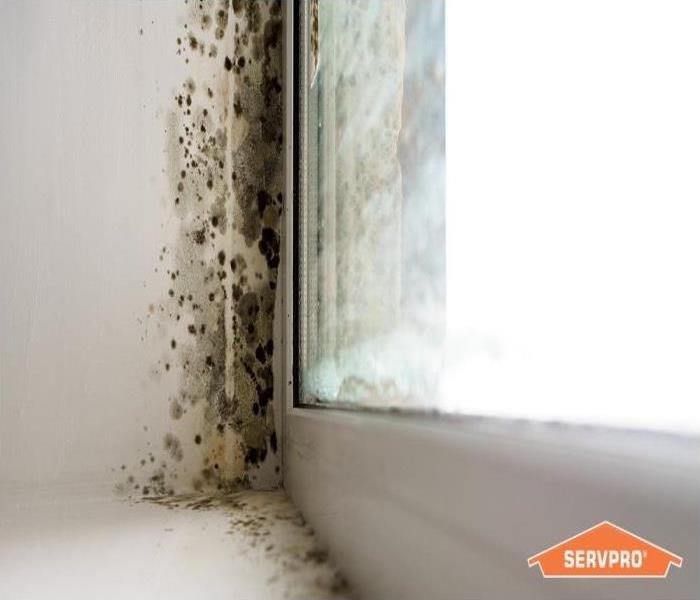 Prevents further damage to your property by making it harder for spores to find a new home elsewhere
Prevents further damage to your property by making it harder for spores to find a new home elsewhere
Riverside Homeowners Can Rely on Us to Control the Spread of Spores
People living in Riverside know that the upkeep of a house is a significant undertaking. There are always items needing repairing or replacing, and there is a list of chores each week. Some jobs require professional help, and you need a company on which you can rely.
If you need mold remediation in Riverside, SERVPRO is your go-to remediation company. We put our technicians through a comprehensive training program, which is the Institute of Inspection, Cleaning, and Restoration Certification certified. Our services are available all day, including on holidays, so you know we have always got your back.
Proper containment procedures are an essential part of our technician training. But what is containment – and why does it matter to you?
How does mold travel?
To understand the necessity of containment, it helps to know how mold travels. Mold spores are microscopic. The mold growth you see as black patches is a network of tiny tube-like filaments called hyphae. A mold colony comprises many hyphae, and the mold grows and lives in areas that provide moisture and a food source.
Unfortunately, mold does not just stay in its colony. Tiny mold spores can break free and become airborne. Once the mold is in the air, it can attach to clothes, bags, shoes, and even pets. It can also enter the home through doors and windows. If the breakaway mold spores find another location with moisture, oxygen, and a food source, they can form a new colony.
How does containment help?
Containment makes it harder for mold spores in Riverside to leave the affected area. If it is harder for spores to go, they are less likely to travel and set up a new colony in another part of your home.
Containment does not only stop mold spores, however. It is also helping to prevent the spread of:
- Silica dust
- Asbestos
- Lead-based paint
- Leftover soda crystal particles from soda blasting
Containment means we keep the contamination in one area, which makes it easier to handle and produces better long-term results for you.
What exactly is containment?
There are two main types of containment.
We use limited containment for smaller areas (usually less than 100 square feet). SERVPRO technicians wrap the affected area in a single layer of polyethylene sheeting. We use tape to seal up all windows, doors, ducts, and vents to close off potential exit points. The sheeting contains a slit for entry and exit covered by a flap when not in use.
We use full containment in larger areas, or more severe cases of mold. Full containment includes two layers of polyethylene sheeting and the addition of a decontamination area. SERVPRO employees use this area to decontaminate themselves and their equipment before entering the rest of your home.
Are there any other benefits of containment?
Yes. As well as stopping the spread of mold or other harmful particles throughout your home, containment:
- Prevents further damage to your property by making it harder for spores to find a new home elsewhere
- Makes the cleanup process much easier
- Ensures we carry out mold remediation in the safest possible environment
What about air filtration?
Air filtration is an essential part of containment. We use powerful air scrubbers, equipped with HEPA filters, to pull microscopic spores from the air and trap them. The HEPA filters are small enough to capture tiny mold spores, as well as other airborne contaminants.
In some cases, we also use negative air machines. While air scrubbers are self-contained units, negative air machines vent the contaminated air outside of your home. They create a vacuum to prevent mold from becoming airborne and escaping.
Does containment stop mold?
It is impossible to ensure that mold will never take hold in your home again. Because it can enter through doors, windows, on your clothes, or your pets, we cannot truthfully say it will not come back. However, containment means that the mold spores in the currently contaminated area cannot spread. And if they cannot spread, they cannot set up new colonies.
Containment is highly effective for treating the current mold infestation and discouraging spores from traveling elsewhere. We also use moisture meters and sensors, and thermal-hygrometers, to monitor moisture levels in the affected area, so there is less moisture to feed mold.
We also use highly effective cleaning procedures such as baking soda blasting to clean away as many visible colonies as possible. The combination of containment with effective remediation makes your home much less friendly to mold spores and removes existing colonies. If you need help with mold remediation, give SERVPRO of West Riverside City a call at (951) 351-8033.
Unattended Death in Riverside, What Should You Do?
2/14/2022 (Permalink)
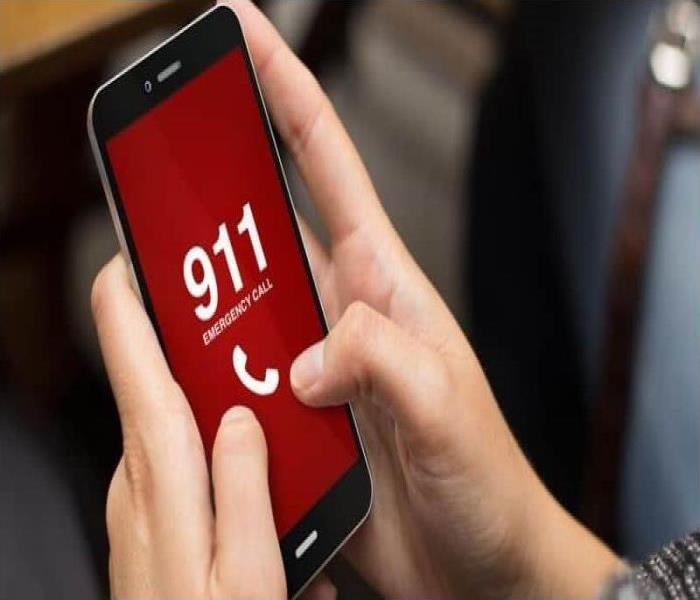 When discovering an unattended death, the first step is contact authorities by dialing 911.
When discovering an unattended death, the first step is contact authorities by dialing 911.
Death is always difficult to face, especially when a loved one dies alone.
Death is called an unattended death and requires a thorough, careful approach to remediate the scene.
In this blog, we’ll discuss the steps you can take to clean up after an unattended death, and when to hire after death cleaning services.
What Does Unattended Death Mean?
The term unattended death refers to a case where nobody discovers the deceased’s body for days, weeks, or months.
Today, unattended deaths are most common with older adults, especially those who live alone and do not have family or friends that check on them frequently. In other cases, unattended death can be the result of an accident, suicide, or homicide.
What to Do after an Unattended Death
When a person dies, the natural process of decomposition begins quickly. Within hours of death, dangerous bacteria are released into the air surrounding the body and will start to impact nearby materials. This bacteria causes the odor of decomposition, and remediating it requires a comprehensive, skilled approach. It’s not enough to bleach the floors and throw away the bedding.
Instead, take the following steps to begin reclaiming the area:
- Contact the authorities. The first thing you should do if you find yourself in the unfortunate position of discovering an unattended death is to call 911. Police will arrive at the scene to investigate and determine the cause of death. Even if the deceased died of natural causes, this is a critical step. The police will help you contact the local coroner’s office, who will transport the body to the morgue.
- Notify friends and family. Since the death was unattended, friends and family won’t know the deceased has passed. Reach out to notify friends, family members, congregants at the individual’s church, and other individuals in the social circle of the person’s passing.
- Avoid DIY cleanup. Biohazard cleanup can be dangerous. Don’t risk your health or wellbeing by trying to clean the area on your own. Instead, contact a professional cleanup service to deal with substances like bodily fluids, blood, and other pathogens. You should also wait to collect sentimental items from the deceased’s home, as they may be contaminated.
Why is Proper Unattended Death Cleanup Important?
Cleaning and sanitizing an area after an unattended death isn’t an easy job. When an unattended death occurs in a residence, it creates a variety of infectious materials that can be dangerous for years–unless they’re dealt with properly. If you intended to sell or rent the property in the future, it’s critical to ensure proper cleanup now.
Here are a few reasons it’s critical to hire a professional unattended-death cleanup team:
- Porous material, including wood, carpet, drywall, and concrete absorb body fluids. Unfortunately, surface cleaning these porous materials won’t sterilize them, and you should never attempt to do so on your own. Instead, contact a bioremediation company that can properly dispose of these items for you.
- Depending on the health of the deceased person before their death, there’s a potential to encounter bloodborne pathogens at the unattended death site, which can be dangerous for anyone in the area. Professional cleanup crews wearing commercial-grade personal protective equipment (PPE) are the only ones who can enter the area safely.
- While decomposition is perfectly normal, traditional home cleaning solutions aren’t sufficient to safely clean, sanitize and disinfect areas affected by human decomposition. Instead, you need a professional team that has access to the cleaning compounds and commercial tools needed to resolve contamination resulting from decomposition.
- It’s impossible to get rid of all traces of biological material with DIY cleaning tactics. Unfortunately, even a trace amount of biological material left behind can make a residence unsafe to live in and render it impossible to sell or rent.
Don’t the Police Help Clean up?
The short answer to this question is no. Paramedics, law enforcement officials, the county coroner, and fire rescue teams may all respond to an unattended death scene, but none of them are responsible for cleaning and sanitizing the space afterward.
Instead, these professionals typically recommend contacting a privately-owned company like SERVPRO of West Riverside for unattended death cleanup services. Teams like ours are the only professionals who understand how to use microorganisms to degrade and neutralize organic contaminants and sanitize an unattended death site.
What is the Cost of Unattended Death Cleanup?
The costs of unattended death cleanup vary depending on the severity of the scene, your location, how long the body has been unattended, the number of technicians needed to sanitize a space, the amount of time they spend doing so, and the extent of organic matter in the area.
What Conditions Does Mold Grow In?
1/31/2022 (Permalink)
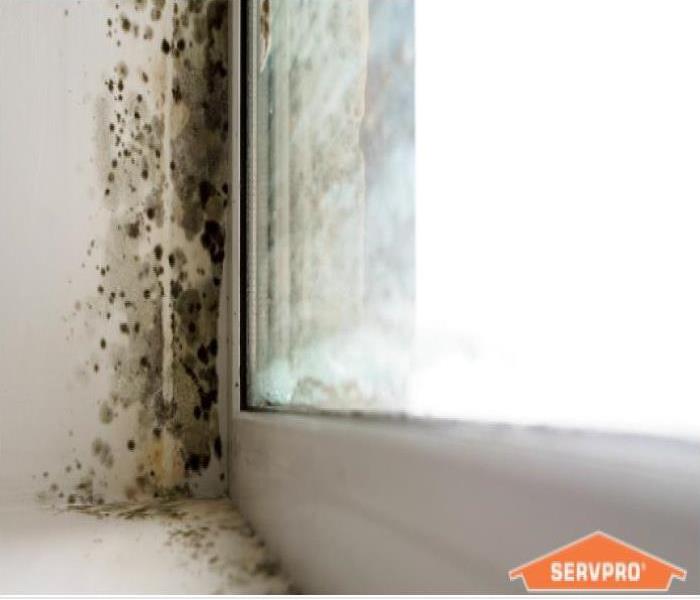 If you've discovered mold in your property, give us a call about removing it.
If you've discovered mold in your property, give us a call about removing it.
While mold is a preventable problem, if it does break out, it can be a serious issue to tackle for homeowners, and if it is not handled properly from the beginning, it can quickly return on a repeat basis.
Fortunately, there are things that every homeowner can do to prevent mold from growing in the first place—namely, by avoiding creating conditions where it is likely to thrive. Below, we will take a look at how mold finds its way into your home as well as the conditions that it likes so you can be on the lookout for susceptible places in your home.
How Does Mold Get Into a Home?
Mold spores are airborne, and they can easily be transported from the outdoors to the inside of a home when the door is opened, when people walk inside with their shoes on or when pets and people carry the spores in on their fur or clothes.
Mold is nearly everywhere, which is normally not an issue because it needs a very specific set of conditions to begin to grow and reproduce.
An indoor mold problem can show itself in different ways. Some common indicators include:
Visible mold growthMusty or moldy smellStaining/discoloring of the ceiling or walls (water damage stains)Known leak or water damage (within the past few years)Any of the above should bring about concern with property owners or occupants as they can be an indicator of an indoor mold problem.
Unfortunately, while these conditions should warrant a reaction, many people don’t react until their health or the health of someone they know is impacted.
Despite the indicators, addressing a potential mold problem is important. The first step in this process is to verify whether or not you actually have a problem and, if one is present, the size of the problem.
Several environmental inspection companies are available to investigate a property to determine if a harmful mold growth and environmental contamination exists. During the property inspection, samples of the air and surfaces may be taken during the mold testing process. These samples should then be analyzed by an independent third party lab to detect the presence or absence of mold growth within the area in question.
The Conditions That Mold Finds Favorable
There are many different types of mold that may grow in areas, but they all have one thing in common: They cannot grow without an adequate amount of moisture.
Mold requires dampness to take hold and begin reproducing, which is why it is often found in basements, bathrooms and areas that have experienced water damage.
An indoor mold problem can show itself in different ways. Some common indicators include:
Visible mold growthMusty or moldy smellStaining/discoloring of the ceiling or walls (water damage stains)Known leak or water damage (within the past few years)Any of the above should bring about concern with property owners or occupants as they can be an indicator of an indoor mold problem.
Despite the indicators, addressing a potential mold problem is important. The first step in this process is to verify whether or not you actually have a problem and, if one is present, the size of the problem.
Several environmental inspection companies are available to investigate a property to determine if a harmful mold growth and environmental contamination exists. During the property inspection, samples of the air and surfaces may be taken during the mold testing process. These samples should then be analyzed by an independent third party lab to detect the presence or absence of mold growth within the area in question.
If the investigation of the property concludes that the indoor environment is unsafe, mold remediation should be pursued. It is not recommended that mold be remediated by a private party, regular contractor, or maintenance worker as this can exacerbate the problem. The best choice for mold remediation is a professional mold remediation or damage restoration company that is experienced and certified in environmental remediation and decontamination such as SERVPRO of West Riverside City.
How Can I Discourage Mold From Growing?
One of the best things that homeowners can do to prevent mold from growing is increasing circulation and not letting areas in the home become too humid. Adding a fan to a bathroom or installing a dehumidifier in a basement can go a long way in discouraging mold from making itself at home.
Additionally, if you have any water damage to your home, it is best to get it professionally restored right away so mold does not begin to grow in the damaged area.
If you need help with mold remediation or water damage restoration, we are here to help.
If the investigation of the property concludes that the indoor environment is unsafe, mold remediation should be pursued. It is not recommended that mold be remediated by a private party, regular contractor, or maintenance worker as this can exacerbate the problem. The best choice for mold remediation is a professional mold remediation or damage restoration company that is experienced and certified in environmental remediation and decontamination such as SERVPRO of West Riverside City.
Can Delicate Items Be Cleaned After Flood Damage?
1/26/2022 (Permalink)
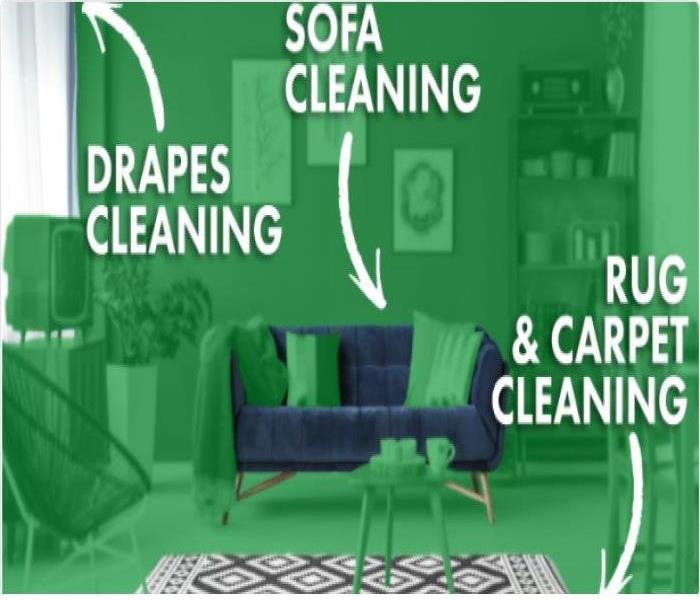 We not only restore the structure of your home but the treasured possessions inside.
We not only restore the structure of your home but the treasured possessions inside.
Not Everything is a Total Loss with Flooding in the City of Riverside – SERVPRO Knows How to Restore Treasured Items with Minimal Damage
Can Stains Be Removed from My Antique Chair Cover?
When homes experience flood damage in Riverside City, the initial focus is on emergency mitigation. Dealing with safety issues, water extraction, and drying out impacted areas is the critical focus. Floodwater is highly contaminated, and items may need to be disposed of, more so than in a home water intrusion. But some things may have peripheral damage, such as spots and stains that can be cleaned. Delicate items such as the upholstery on your antique chair can often be cleaned. While regular cleaning takes place, spot and stain removal is a bit different:
Stain and spot removal are specialized techniques.This type of cleaning occurs before cleaning the entire item.Spot cleaning may cause discoloration to the affected material.Cleaning the content thoroughly after spot cleaning can reduce changes and help the stain blend in. Isn’t a Spot and a Stain the Same Thing?
In most people’s minds, they would be the same if they even gave it much thought. However, there is a difference. A spot is produced when a component is added to the fiber of the material. Things like sugar, gum, or wax produce spots. A stain occurs when the grain of the material becomes discolored by something like wine or coffee. Our technicians are trained in understanding the cause and effect behind water damaged material, allowing them to apply the appropriate treatment.
How Do Items with Spots or Stains Get Treated?
Different types of soils require specific treatments. Fabric items such as upholstered furniture, carpets or rugs, or drapes are examples of often treated possessions. The kind of dirt on them plays a role in the cleaning agent used. Soils can include:
Water-soluble– Sugars and starches fall into this category. These get removed with a water spotting solution.Oil-soluble– Greases and tars come under this heading. An oil-based spotting cleaner gets used to remove these soils.Insoluble– Sand and skin cells cannot be dissolved. Vacuuming works best or suspension and extraction if necessary.Protein-based– These would include soils such as milk or egg. In this case, an enzyme-based product gets used.Color adding– Tannins, think tea or toner are examples. Dry brushing is employed, followed by a spotting agent. When dealing with the home contents that need spot or stain removal, the first step is to extract as much soil as possible. The faster the stain is addressed, the better the chance of repair. The material should ideally be dry, but our technicians advise on the best approach. If the damage is extensive and the item is wet, the technique may vary.
Restoring Your Possessions
Once the excess dirt has been removed from flood damaged items, determining the type of soil is necessary. The fiber content of the item is also defined. Understanding the soil type being dealt with and the fiber content is vital to ensure the right cleaning method gets employed. Before SERVPRO begins any cleaning of your items, we explain the process and the expected outcome. Then the best solvent for the job is chosen, and the item gets cleaned. All content is rinsed and dried, and restored as close to preloss condition as possible.
Flooding can result in devastation to your home and the contents. At SERVPRO, our goal is always to restore rather than replace it if we can. We sympathize with what our customers who have experienced flooding are going through. If we can save even a small portion of your treasured belongings, we are happy to do so.
Your Home is Important to Us
For around the clock professional flood damage, contact:
SERVPRO of West Riverside City
(951) 351-8033.
We not only restore the structure of your home but the treasured possessions inside.
SERVPRO® Named in Top 10... Again!!
1/24/2022 (Permalink)
 SERVPRO Again Named to Franchise 500 List, #1 in Restoration Category!
SERVPRO Again Named to Franchise 500 List, #1 in Restoration Category!
SERVPRO Again Named to Franchise 500 List, #1 in Restoration Category!
SERVPRO, a cleanup, restoration, and construction franchise company, is proud to announce it has been recognized again as one of the best overall franchise opportunities by Entrepreneur magazine’s 2022 Franchise 500, the industry’s most comprehensive franchise ranking. Evaluated on categories such as growth, financial strength and stability, and brand power, SERVPRO was named the #8 overall franchise system, and #1 in the cleaning and restoration industry for the 19th consecutive year.
“SERVPRO is built on the foundation of outstanding customer service, industry-leading training, and the success of following a proven system,” said SERVPRO CEO Rick Isaacson. “On behalf of the more than 1,900 SERVPRO franchises across the U.S. and Canada, we are honored by this recognition.
“The SERVPRO brand and its franchisees share a strong partnership, working together to set and achieve goals which have allowed us to grow each year for more than half a century despite the challenges many businesses have faced, especially over the past 18-24 months.”
To best understand and evaluate the ever-changing franchise marketplace, the Entrepreneur’s editorial team researches and assesses several factors that go into the evaluation, including costs and fees, size and growth, support, brand strength, and financial strength and stability. Each franchise is given a cumulative score based on an analysis of more than 150 data points, and the 500 franchises with the highest cumulative scores become the Franchise 500 in ranking order.
“The past year has been one of the most challenging for businesses in recent memory, which made putting together our 43rd annual Franchise 500 list more enlightening than ever,” said Entrepreneur Editor in Chief Jason Feifer. “The companies named to this year’s list showed us how being resilient, supportive and nimble can help navigate extraordinary challenges and also underscore the grit and innovation that define entrepreneurship.”
SERVPRO franchise owners pride themselves on being “ready for whatever happens,” Isaacson said, which helped the company jump two spots from its #10 ranking in 2021.
“Our franchisees have a ‘never say no’ mentality, working together with other owners to make sure we are able to satisfy all of our customers’ and clients’ cleanup, remediation and restoration needs, which allows us to ‘Keep it Green,’ as we like to say.
“We pride ourselves on rushing in when others are running out – whether that is in response to a natural disaster such as a hurricane, flood, or tornado; cleaning up after a home or business water or fire loss, or helping clean and sanitize spaces from unseen threats like COVID-19. Maintaining our position for nearly 20 years as the best franchise in our category on the Entrepreneur Franchise 500 list validates our long-standing strategy for growing our brand: invest in franchisee training and support and commit resources to continually improving our infrastructure.”
Visit our "Own a Franchise" page to learn more about joining the SERVPRO family.
About SERVPRO
For more than 50 years, SERVPRO has been a trusted leader in fire and water cleanup and restoration services, construction, mold mitigation, biohazard, and pathogen remediation. SERVPRO’s professional services network of more than 1,900 individually owned and operated franchises spans the United States and Canada, responding to property damage emergencies large and small – from million-square-foot commercial facilities to individual homes. When disaster strikes, homeowners, business owners, and major insurance companies alike rely on SERVPRO to make it “Like it never even happened.”
SERVPRO of West Riverside City Can Help With Bio Cleanup
1/19/2022 (Permalink)
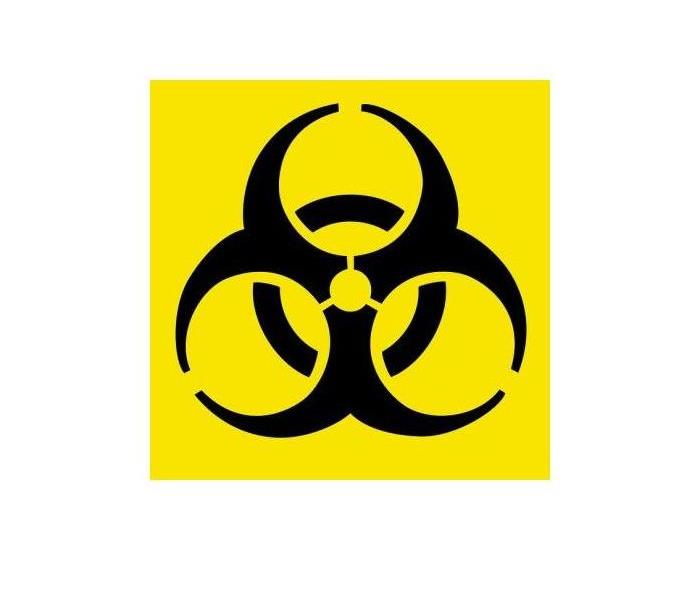 Our technician is certified in Crime Scene and Trauma cleanup.
Our technician is certified in Crime Scene and Trauma cleanup.
What is a Bio-Hazard? Well the dictionary definition is "a biological substance that's dangerous to people or the environment."
Our Primary Concern
It often comes to our attention as a result of a serious injury or death. Cleaning up a Bio-Hazard has many aspects to it. Our primary concern is to make sure our employees and others in the vicinity do not become injured as a result of working in that environment. Blood and any associated blood borne pathogens need to be properly handled due to their inherent risk to humans.
Required PPE
Proper personal protective equipment is just the start. Anyone working with bio-hazards needs proper training in procedures, respirator protection, health and safety and hazard communications. Items such as needles, broken glass or other sharp objects need to be handled very carefully and preferably with a tool that limits our need to contact it.
What Should be Disposed of
Materials that have come in direct contact with blood need to be properly disposed with a licensed waste hauler. This may include PPE, clothing, items used to actually do the cleanup such as paper products and rags, and any cloth material that needed to be removed from the affected site such as cushions, carpeting, bedding, etc.
This work is not particularly difficult, but being able to do the work properly takes a lot of training, planning, careful following of procedures.
Certification
Bio-hazard cleanup is different than any other type of cleanup. Not only is there special training to ensure the safety of the workers, occupants, and other people who may have access to the affected area, but there are other issues as well.
We are Empathetic to the Situation
If the cleanup is in a home or residential facility, emotions will be involved. Was it an accident? Was it fatal? What connections to the injured party does everyone have?
Commercial Safety is Important
If the cleanup is in a commercial facility, is the potential risk of injury to others corrected? Can work continue while the cleanup is being performed, or are critical areas of the facility shut down?
Who Should You Call?
SERVPRO of West Riverside City is fully trained and experienced to handle these cleanups with professional staff that are kind empathetic and caring.
Our technician is certified in Crime Scene and Trauma cleanup. We work closely with Sheriff Department and local morgue who contact us for such cleanups.
As tough as these jobs are, it is important to do them right; the first time.
Call SERVPRO of West Riverside City: 951.351.8033
Is Your Riverside Business Prepared To Evacuate in the Event of an Emergency?
1/17/2022 (Permalink)
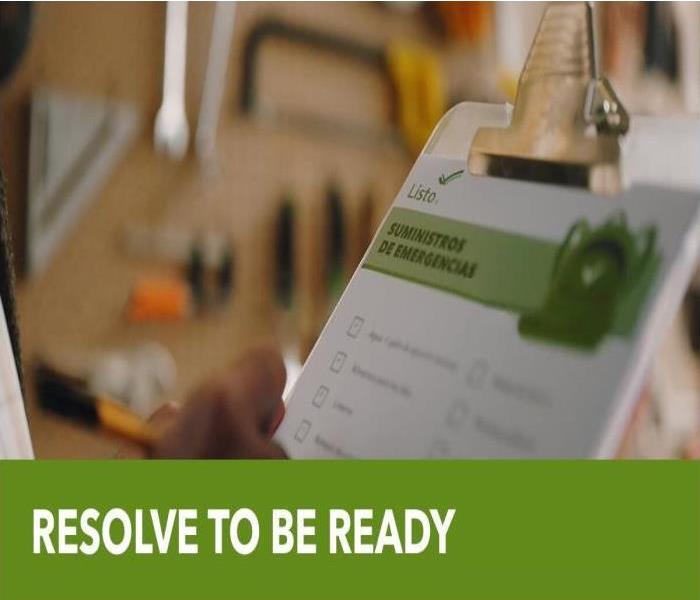 By keeping a few simple guidelines in mind, designing your evacuation procedure can keep you prepared for any disaster.
By keeping a few simple guidelines in mind, designing your evacuation procedure can keep you prepared for any disaster.
Are You Prepared?
While an emergency in the workplace is never expected, disasters happen every day in businesses all around the country. That’s why it’s so important to implement a Evacuation Plan for your employees and customers. By keeping a few simple guidelines in mind when designing your evacuation procedure, you can make sure your business in Riverside, CA is prepared for a worst-case scenario.
1. Pay attention to details.
Where is a fire most likely to break out in your building? How is the customer traffic flow designed? What are the locations of sprinklers and fire extinguishers? These are factors that will need to be considered when planning for an emergency. Map your evacuation route to bypass dangerous areas and allow for the fastest possible exit from the building.
2. Communication is key.
Even the most well-designed fire drill plan is useless if you don’t ensure that every employee knows how to implement it. Keep in mind that your employees will need to guide customers to safety in the event of an emergency, so it’s imperative that they have access to a printed evacuation route and are aware of where all the building exits are located.
3. Repeat, repeat, repeat.
Even the most level-headed employee can panic if a fire breaks out at work. That’s why evacuation drills should be rehearsed on a regular basis to make sure that everyone knows their role in an emergency. Address any issues or confusion after each drill to develop a reliable exit strategy. Shift leaders and managers should have the contact information for a reliable fire damage restoration company to call after ensuring that all customers and employees are out of the building and first responders are on the way.
While no business owner wants to think about a life-threatening emergency in their building, it’s crucial to have a fire drill plan in place to ensure the safety of your employees and customers. By remembering to prepare for the worst-case scenario, you can prevent a tragedy from occurring.
Get Back to Business Quickly After a Fire
As a business owner, you know that any disruption in business affects your bottom line. We have large loss teams that work alongside our local SERVPRO experts. These professionals understand your unique set of problems when faced with fire damage and can respond immediately to your call. Our goal is to help you get your business up and running again as soon as possible after a fire emergency.
Should your business experience a fire, SERVPRO of West Riverside City has the experience and knowledge to make any disaster, "Like it never even happened."
Call for any emergency 951-351-8033
What to do Before and After a Flood in Riverside
1/12/2022 (Permalink)
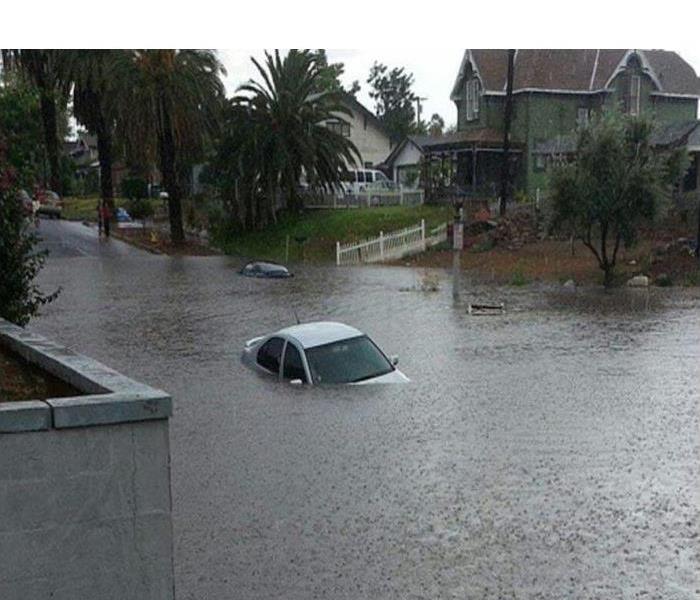 Remember that flash floods can occur suddenly, and miles from the source of water.
Remember that flash floods can occur suddenly, and miles from the source of water.
In Riverside flooding can happen anytime, but October to April are our rainiest months.
What to do before a Flood
Take steps to protect your home, family, and financial security throughout the year, and take extra precautions when flooding is predicted in your area.
The best way to protect your home and belongings from flood damage is to purchase flood insurance – don’t let your hard work be washed away.
Here are a few steps you and your family can take to be ready for flooding:
- Get Flood Insurance- Most homeowners insurance does not cover flood damage. Do an annual “insurance check-up” with your agent to make sure you have the right coverage and amounts of coverage.
- Know Your Risk- Look up your address in the Flood Map Service Center to learn if you live, work, or travel in areas that are prone to flooding.
- Take a Household Inventory- Take photos and videos of all major household items and valuables. Retain these documents in a safe place because they are important when filing insurance claims.
- Store Important Documents- Save copies of birth certificates, passports, medical records, and insurance papers in a safe, dry place. Keep original documents in a watertight safety deposit box.
Did you know?
When flooding is imminent or predicted, National Flood Insurance Program (NFIP) policyholders are eligible to receive up to $1,000 to purchase loss avoidance supplies like tarps, sandbags, and more.
Steps to minimize your flood losses
Minimize your potential losses from flooding by taking the following steps:
- Elevate and Anchor utilities- Elevate and anchor your critical utilities, including electrical panels, propane tanks, sockets, wiring, appliances, and heating systems.
- Clear Debris From Gutters- Make sure that you clear any debris from gutters and downspouts to avoid an accumulation of water.
- Elevate or Move Your Furniture- When flooding is predicted or imminent, move furniture and valuables to a safe place, such as an attic or the highest floor of your home.
When flooding is imminent – take care of your physical safety
When a flood is imminent or occurring, your first priority should be the physical safety of you, your loved ones, and your pets.
Stay alert by monitoring the local news and weather reports and sign up for emergency alerts. Have a communication plan ready in the event of a power outage.
In Riverside flooding can happen anytime, but October to April are our rainiest months. When there's a flood risk, the National Weather Service issues alerts. Sign up to receive emergency alerts.
Sand Bag Locations
Driving
Water depth can be difficult to judge, especially at night, and you may not see a road that is washed out too! Remember: Turn Around, Don’t Drown.
Outdoor Activities
Before going out to hike, bike, or another outdoor activity, check the weather forecast and information about the area. Is it prone to flash floods?
Have a back-up plan. After planning and travelling to your destination, it can be hard to decide to cancel your activity. If you have a back-up plan in an area that is known to be safer, you’re less likely to put yourself in a dangerous situation.
Watch for suddenly darkening skies or listen for thunder. Move to your back-up plan if these conditions start to develop.
Remember that flash floods can occur suddenly, and miles from the source of water. You may not be able to hear or see a storm that can cause a flash flood.
Have an escape plan and be prepared to ride it out, even by climbing a tree or other sturdy object. Some floods can take hours to recede, but even getting behind a jutting piece of canyon wall could protect you from the powerful waterflow.
When there's a flood risk, the National Weather Service issues alerts
Sign up to receive emergency alerts
Call SERVPRO of West Riverside City to Inspect your Property for water damage due to flooding. We can help determine if it's worth submitting a claim through your insurance.
Office 951-351-8033
We are open 7 days a week!
Open 24 hours a day!
Water and Flood Damage in Riverside: What's the Difference?
1/10/2022 (Permalink)
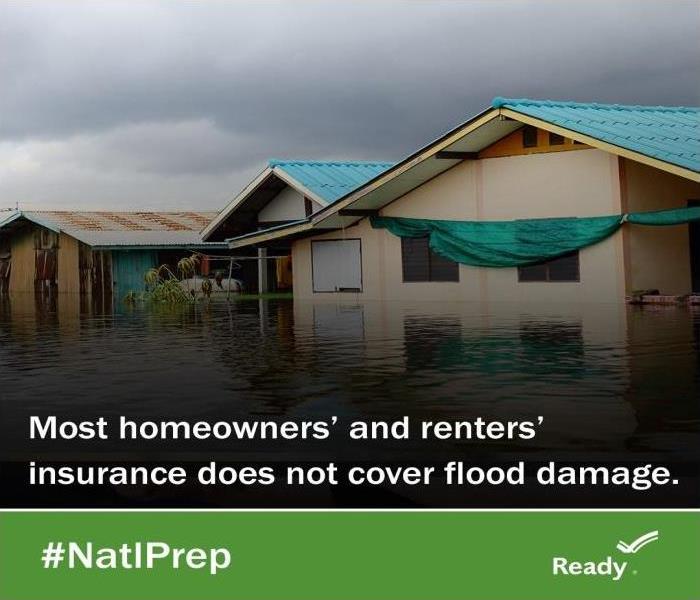 If you are experiencing water or flood damage, SERVPRO of West Riverside City can inspect the damage, remove the moisture, and make repairs!
If you are experiencing water or flood damage, SERVPRO of West Riverside City can inspect the damage, remove the moisture, and make repairs!
Water is a necessity, but not when it is causing damage to your home or business.
If water damage does occur, SERVPRO of West Riverside City can clean and restore your home to make it as though it never happened. However, the cleaning and restoration after damage occurs is not the only piece of the puzzle. When water causes damage, consult a restoration company before submitting an insurance claim.
Filing an insurance claim because of unwanted water can be complicated. The first step is knowing the difference between a water damage claim and a flood damage. This information is crucial to the policyholder because it determines what is covered and what is not.
What is Covered
The distinction between a water damage claim and a flood damage claim can best be defined by the Federal Emergency Management Agency’s (FEMA) flood definition. According to FEMA, a flood is a general and temporary condition of partial or complete inundation of two or more acres and two or more properties of normally dry land.
To simplify the matter, if the water that caused the damage occurred from a natural source and any neighbors are experiencing the same water issues, it is safe to say the situation is a matter of flooding. According to FEMA, flood damage can only be caused by overflow of inland or tidal waters, unusual and rapid accumulation or runoff of surface waters from any source, mudflow, or collapse of land along the shore of a lake or similar body of water as a result of erosion or undermining caused by waves or currents of water exceeding anticipated cyclical levels that result in a flood.
If a flood has caused damage to your home, it is important to know if you currently have flood insurance through the National Flood Insurance Program, because home insurance companies do not offer coverage on flood damage. Having flood insurance is extremely beneficial to homeowners who think they might even have the slightest chance of being affected by a flood. The official site of the National Flood Insurance Program states that flood insurance policies cover physical damage to your property and possessions.
Everything from the actual building and its foundation to the refrigerator and the food inside of it is covered by flood insurance and will be taken into consideration when claims are filed. Flood insurance does cover basements and areas below the lowest elevated floor, but it depends on the flood zone and the date of construction. It is important to remember that flood insurance does not cover the sentimental value of any property, so be sure to remove any precious items such as photos, documents, or personal items that cannot be replaced as quickly as possible.
When Water Damage Occurs
When water damage occurs in your home, did not originate from a natural source, and is not affecting any surrounding buildings, a water damage claim is necessary. Circumstances such as overflowing bathtubs, broken toilets, burst water mains, and broken pipes are all grounds for water damage claims that should be filed by contacting your home insurance company.
Working through the process of filing both a water damage claim and a flood damage claim can be tricky and seem overwhelming. SERVPRO offers a Contents Claim Inventory Service for customers who already have enough stress to deal with. What this service does is provide a detailed and accurate list of all of your belongings. Our Technicians have the experience needed to deliver detailed and accurate reports to insurance companies and help settle claims fast.
If you are experiencing either water or flood damage in your home, SERVPRO of West Riverside City can inspect the damage, remove the moisture, and make repairs using state of the art extraction equipment as quickly as possible.
It is important to take immediate action when it comes to both water and flood damage. Refer to our Water Damage Emergency Tips and keep safety as your primary focus. Do not fret, SERVPRO has the ability and resources to go beyond just basic restoration by repairing electronics such as televisions and computers and also dry photographs and documents.
Highly trained Water Restoration Technicians are available around the clock for when damage occurs and are only a phone call away- 951-351-8033
Riverside Residents, 2022 Resolve to Be Ready!
1/5/2022 (Permalink)
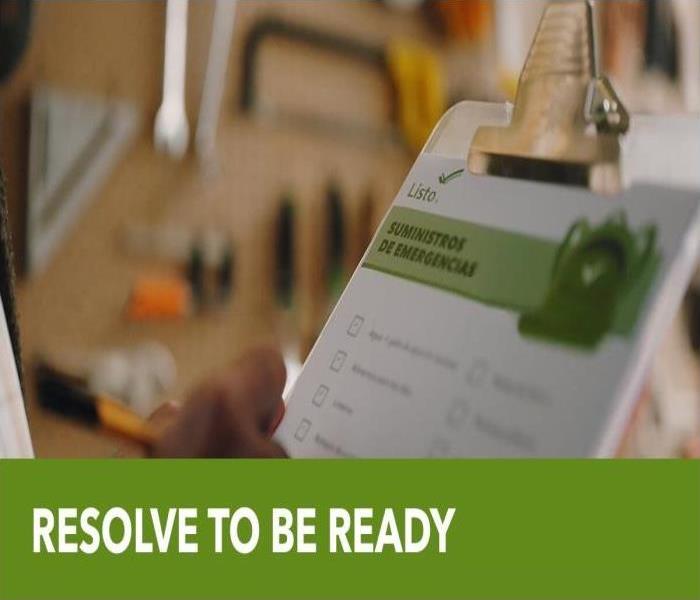 Resolve to be ready now, before a disaster happens!
Resolve to be ready now, before a disaster happens!
With New Year upon us, now is the perfect time to think about making some resolutions.
While resolutions typically involve committing to personal changes and reaching goals, this industry-leading provider of fire and water cleanup and restoration services says the single most important resolution both business and home owners can make is to “Resolve to be Ready.”
Preparing in advance to deal with the unexpected can make a world of difference in how quickly and completely property owners can put the pieces of their lives back together. Emergency readiness plans are the foundation for effective and timely emergency response.
SERVPRO encourages all property owners to take advantage of the no-cost emergency planning tools available from the Federal Emergency Management Agency (FEMA), as well as SERVPRO’s Emergency READY Profile and READY Plan Mobile App.
For homeowners:
- FEMA resources include guidelines for creating a Family Emergency Plan and Emergency Supply List, with additional tips for pet owners, seniors, people with disabilities, and even commuters.
- SERVPRO offers their free SERVPRO READY Plan app, which stores critical contact and property information electronically in advance, where it can be accessed with a mobile device in seconds if disaster strikes.
For business owners:
- FEMA offers materials on topics ranging from creating a Business Continuity Plan to an Insurance Discussion Coverage Form in addition to guidelines for creating an Emergency Response Plan.
- For businesses, SERVPRO offers a no-cost facility assessment and assistance in creating a comprehensive Emergency READY Profile® (ERP). The ERP includes information about emergency contact numbers, priority and high/risk areas, shut-off valve locations and more that can then be stored in the READY app.
The time to gather and store information like emergency contact numbers; insurance contacts; and the location of emergency shut off valves, and such is before an emergency strikes, not during an emergency, having this information at your fingertips can help emergency responders react as quickly and effectively as possible, helping to limit loss of property and even lives.
SERVPRO specializes in disaster restoration, cleanup and repair services, helping to remediate damage, making it “Like it never even happened,” for both commercial and residential customers. For more information on SERVPRO, please visit SERVPRO of West Riverside City. To learn about SERVPRO’s Emergency READY plan, please visit http://ready.SERVPRO.com.
If you would like to set up an appointment to meet with an associate to review our FREE Emergency Ready Profile, please contact us at:
Office- 951-351-8033
#ResolveToBeReady
#PrepTips
#NewYear
Understanding the Temperature of Fire Can Help During a Disaster
12/30/2021 (Permalink)
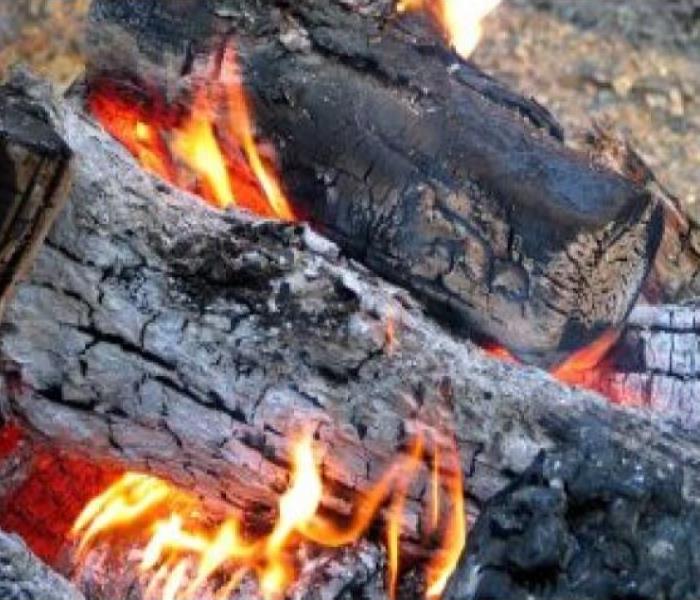 Bonfire – The temperature of a bonfire gradually heats up to around 1112°F, but bonfires can reach 1832-2012°F.
Bonfire – The temperature of a bonfire gradually heats up to around 1112°F, but bonfires can reach 1832-2012°F.
What is the Temperature of Fire?
Fire is versatile and dangerous. No matter what kind of industry you belong to, a working knowledge of the properties of fire is an important part of fire safety. The temperature of fire varies depending on the source and kind of fire you’re dealing with.
Understanding the nuances of fire temperature will inform your overall knowledge of fire and how it works, so in this blog we’re looking at the temperature of fire and how you can identify it.
Temperature and color
The two most distinguishing properties of fire are heat and color. The color of a flame is directly influenced by the temperature, so you should be able to estimate the temperature of a fire by identifying the color of the flames.
Fire is a result of combustion – a chemical reaction between a fuel and oxygen – and when the reaction produces enough heat, flames are formed. Flames themselves change color over time, and will usually have multiple colors in different parts of the flame.
The hottest part of the flame is the base, so this typically burns with a different color to the outer edges or the rest of the flame body. Blue flames are the hottest, followed by white. After that, yellow, orange and red are the common colors you’ll see in most fires.
It’s interesting to note that, despite the common use of blue as a cold color, and red as a hot color – as they are on taps, for instance – it’s the opposite for fire. Red is usually seen on the outer edge of the flame, where the temperature is lower, while blue is the fiercest, hottest temperature.
Fire temperature
From- firefighterinsider.com
Of course, just because there is a hierarchy of temperature for fire, that doesn’t mean that red flames are in any way cold. The fact that you can see flames at all means that the combustion rate is high, so the fuel is burning at a very high temperature.
Red flames, while weaker, can still range from 977°F to 1832°F. The more faint the color, the lower the temperature. A more vibrant red, something closer to orange, will hit the higher end of the scale measuring nearer the 1832°F mark.
Orange flames range from around 2012°F to 2192°F.
White flames are hotter, measuring 2372°F to about 2732°F. The brighter the white, the higher the temperature.
Blue flames, or flames with a blue base, you can expect the temperature to rise dramatically, hitting roughly 4532°F. As you might expect, gas burning fires reach higher temperatures than materials such as wood, paper or textiles, so businesses which store gas tanks such as propane, for example, are most likely to see fires that reach the highest possible temperatures.
Temperature examples
Candle flame – The hottest part of a candle flame burns at around 2552°F, while the average temperature is usually 1832°F.
Wood fire – A household wood fire burns at around 1112°F. Temperature can change depending on the type of wood and its condition.
Bonfire – The temperature of a bonfire gradually heats up to around 1112°F, but bonfires can reach 1832-2012°F.
Burning match – For such a small flame, a household match burns at around 1112-1472°F.
Propane torch – Combustion of propane and air is roughly 3452°F. A butane fire will have a similar temperature.
If you experience a fire in your home or business, SERVPRO of West Riverside City has the knowledge and experience to handle smoke damage from a nearby fire or commercial property containing smoke, soot and water damage. Home or office fires as devastating as they are, we can make it, "Like it never even happened."
Office-951-351-8033
We are open 24/7 to take those emergency calls!
Not Home For the Holidays, Protect Your Riverside Home!
12/22/2021 (Permalink)
 Be sure to notify a trusted neighbor. Ask them to keep an eye on your house and report any suspicious activity and pick up your mail.
Be sure to notify a trusted neighbor. Ask them to keep an eye on your house and report any suspicious activity and pick up your mail.
Traveling to visit family and friends during the holiday season is a perfect time since many have the time off work and kids are out of school.
For many, we live in another city or state than our family or friends. Which means start packing and get the family ready to head out. Before you leave, it’s important take the proper precautions to keep your house safe while you’re away. The holiday break can be enjoyable, as long as you take the steps needed to protect your house for when you return.
Here are few to keep in mind:
Turn Down your Thermostat
Not only will you save money on your electricity or gas bill by turning off the heat or AC, but you limit your chances of an AC leak or furnace malfunction while you’re away from you home.
Notify a Neighbor
Be sure to notify a trusted neighbor. Ask the neighbor to keep an eye on your house and report any suspicious activity. You’ll also want this neighbor to pick up your mail and newspapers while you are away. Make sure your house looks like somebody is home to deter a burglar.
Check your Holiday Lights for Fraying or Damage
December is the deadliest month for electrical fires. Before you string lights on the house or the tree, be sure to inspect the strands to make sure there aren’t any frayed cords or cracked lamps. Replace any broken lamps and throw away strands with frayed cords. This will help prevent any accidental fires.
Heating-equipment
Can cause many deaths every year in the United States. In fact, in 2008, the U.S. Fire Administration reported approximately 2,650 people were killed by house fires. Take the time to have a professional come inspect your furnace and clean the chimney before you need to heat your home.
Turn Off your Water
By turning off your water, it ensures that you won’t come home to water damage. Appliances malfunction when you least expect it and if the water is turned off there is no chance your water heater or pipes will leak.
Locally owned, with national Resources SERVPRO of West Riverside is locally owned and operated. When you have a fire, flooding or water emergency, we’re already nearby and ready to help. As fire and water damage specialists, we have the experience, the expertise, and the advanced training that enables us to get your property restored quickly and thoroughly.
Please Call: 951-351-8033
Do You Know What the Top Causes of Fire are in December?
12/20/2021 (Permalink)
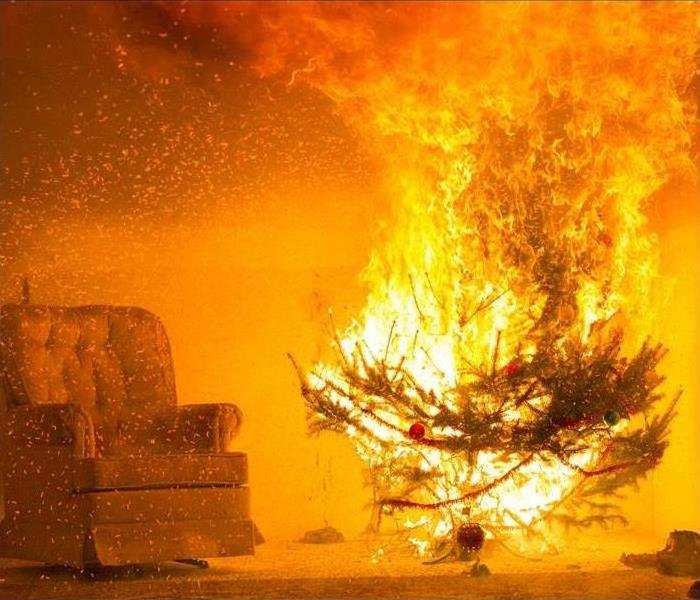 Constant watering keeps trees fresher longer, but the moment the tree appears to drop its needles, it’s a sign that it is drying out.
Constant watering keeps trees fresher longer, but the moment the tree appears to drop its needles, it’s a sign that it is drying out.
Fire damage restoration specialist of SERVPRO of West Riverside City recommend the importance of keeping safety top of mind with a small family gathering as it is with a large holiday party.
Many enjoy bringing the glow of the holiday season to their homes with Christmas trees or menorahs and candlelight, but statistics from the U.S. Fire Administration show how easy it is for home decorating to turn into a home disaster.
Here are are few areas to be watchful of:
- The top three days for home candle fires are Christmas Day, New Year’s Day and New Year’s Eve. More than half of the home decoration fires in December are started by candles.
- A heat source too close to the Christmas tree causes one in every four winter fires. On average, one of every 52 reported home Christmas tree fires resulted in death.
It is also important to follow manufacturers’ guidelines for holiday lighting. According to the National Fire Protection Association, electrical distribution or lighting equipment was involved in 44 percent of home Christmas tree fires.
Only use decorations that are flame-retardant or not flammable, check holiday lights each year for frayed wires or excessive wear and don’t link more than three strands of holiday lights.
- Water your tree daily. Constant watering keeps trees fresher longer, but the moment the tree appears to drop its needles, it’s a sign that it is drying out. From the moment a spark ignites a Christmas tree, it can take only a matter of minutes before noxious smoke and scorching heat fill the entire room, igniting everything within it. Seconds later, the fire can travel up a staircase and perhaps make escape virtually impossible for anyone on the second floor of your home.
For more fire prevention and fire safety tips and information about fire and water damage restoration services, visit SERVPRO of West Riverside City. For more information on SERVPRO of West Riverside City, contact us at 951-351-8033.
Did you know that Christmas Day is the Peak Day for Candle Fires?
12/15/2021 (Permalink)
 While candles are often used for giving off a warm, romantic light and an appealing aroma, they can cause a candle fire if used incorrectly.
While candles are often used for giving off a warm, romantic light and an appealing aroma, they can cause a candle fire if used incorrectly.
Millions of decorative candles are sold every year. They bring a soothing ambiance and different aromas for the rooms in your home.
Are Candles a Fire Hazard?
Candles might seem harmless on the surface until you look at how significant their damages can and have been in U.S. homes. FEMA estimates that there are more than 15.000 home candle fires every year, many resulting in injury for death.
Candle Fire Safety Tips
Here are a few tips to follow to reduce your risk of a fire in your home while your candle is burning:
- Burning candles should never be unattended.
- Candles should never be under shelves or other enclosed spaces.
- Keep candles at least 12 inches from anything that can burn.
- Candles should never be placed where children and pets can knock it over.
- To prevent uneven or rapid burning and excessive dripping avoid drafts, vents or air currents.
- Always put candles on a heat resistant surface.
- Use a suitable candle holder sturdy enough to avoid being easily knocked over.
- NEVER move or touch a candle while it is burning or while the wax is liquefied.
- Make sure that you have a working smoke detector in every room where you burn candles.
- Extinguish candles with a candle snuffer rather than blowing them out, a hot was can splatter.
What To Do if a Fire Starts
If a candle fire ever happens in your home in Riverside, CA, you need to know how to properly extinguish it. When putting out a candle fire, you should never use water, which causes it to spread. If the wax inside the candle catches fire, grab a cover to remove oxygen from the candle. If the flames spread to other parts of your home and get out of control, quickly contact the fire department and evacuate your home. If any fire damage occurs or your home is in need of smoke cleanup services, a fire damage cleanup company can help restore your home back to its original condition.
Candle Alternatives
The best way to prevent candles from causing a fire in your home is to keep them out of your house entirely. There are many candle alternatives to consider including:
- Incense
- Flameless candle
- Essential oil diffuser
- Wax warmer
- Oil warmer
- Stick diffuser
While candles are often used for giving off a warm, romantic light and an appealing aroma, they can cause a candle fire if used incorrectly. It is important to always use candles responsibly or to try out any of the candle alternatives listed in this guide. Visit SERVPRO of West Riverside -Fire Damage for more information on fire loss.
Following a Candle Fire - Fire Restoration
Following these safety tips when you’re enjoying the candle aromas in your home, can lower your risk for a home fire in the future. If candles do happen to cause a home fire and you’re in need of fire restoration solutions, call SERVPRO of West Riverside City at (951)351-8033. Our technicians will be respectful of your home and work with you to put your home back to home sweet home again.
SERVPRO Can Help Get Your Home Prepared for Out of Town Guest
12/13/2021 (Permalink)
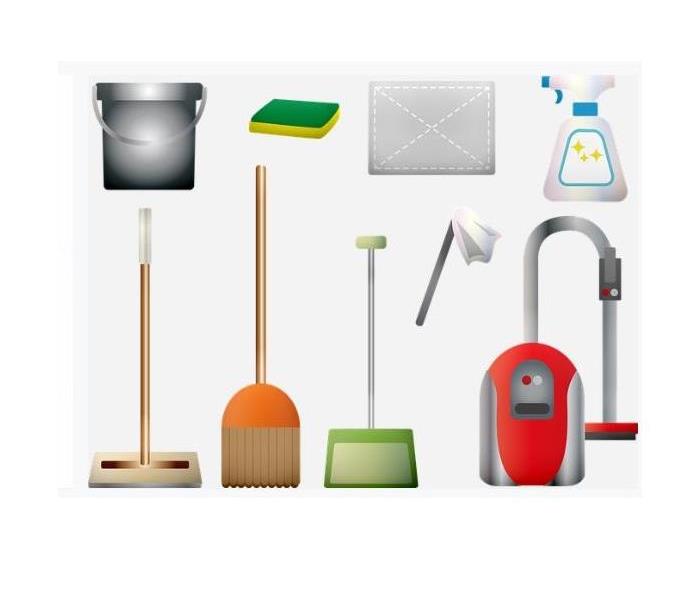 We have the expertise and resources to make any dirt, dust, or grime "Like it never even happened."
We have the expertise and resources to make any dirt, dust, or grime "Like it never even happened."
Are you expecting out of town guests? Too busy to prepare the menu, running around for last minute items. Now you don't have time to deep clean before the arrival of your guests? Let SERVPRO of West Riverside help you!
Let a professional be entrusted with the care of a home, its furnishings and the health of its occupants. With the many new materials and surfaces being used in home décor, a professional house cleaner has a much broader range of knowledge than in the past as many of these newer surfaces require specialized care.
In addition to caring for the home and its contents, a professional house cleaning technician helps care for health. This includes hygienic cleaning, effective sanitizing of surfaces, use of appropriate cleaning agents, and procedures to prevent cross contamination. A thorough vacuuming with a high-efficiency filtration vacuum is an important contributor to improved indoor air quality.
An IICRC-certified House Cleaning Technician is trained to properly care for homes and health. A consumer who uses a certified professional can confidently trust the cleaning and relax in a clean and healthy home.
You know SERVPRO as a leader in Fire and Water Cleanup and Restoration, but our professional residential cleaning services can also make a dirty carpet "Like it never even happened."
Our Residential and Commercial Cleaning Services Include:
- Carpet & Upholstery Cleaning
- Drapes and Blinds
- Air Duct & HVAC Cleaning
- Odor Removal
- Sewage & Biohazard Cleanup
- Trauma and Crime Scene Cleanup
- Ceilings, Walls, and Hard Floors
- Vandalism Cleanup
We have the expertise and resources to make any dirt, dust, graffiti or grime "Like it never even happened." Give us a call to schedule an appointment today!
How Commercial Property Owners Ensure Building Safety During Year-end Holiday Season
12/8/2021 (Permalink)
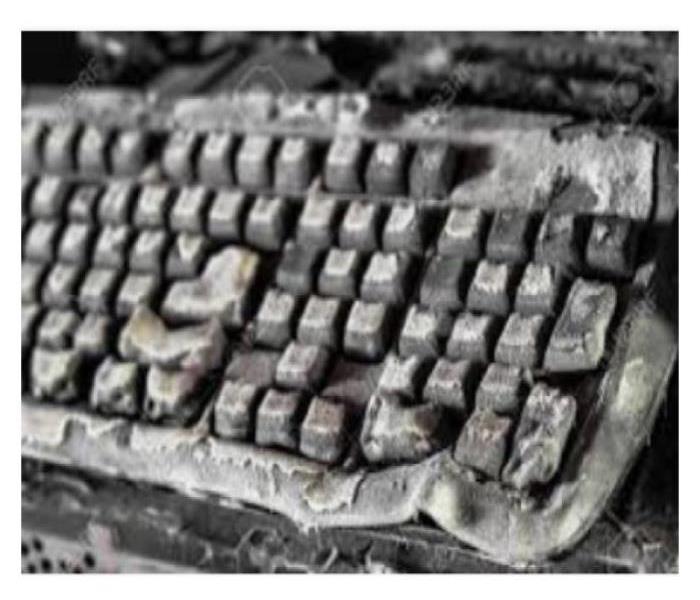 Pay attention to safety, reduce the likely hood of damage to buildings by monitoring hazards and more importantly, ensure the safety of all occupants.
Pay attention to safety, reduce the likely hood of damage to buildings by monitoring hazards and more importantly, ensure the safety of all occupants.
Many Commercial business owners are decorating their properties with Holiday decorations, some are also hosting a year-end event right there on the property.
It’s a way to say thank you to employees, enjoy some good food, maybe games and raffles. One thing to consider is how to do this safely.
Here are seven helpful recommendations to help commercial property owners boost holiday safety at their properties:
- Use fire retardant decorations. Choose and install only decorative materials that will not fuel flames.
- Place decorations wisely so they don’t impede safety systems: sprinkler systems (never hang anything from sprinkler heads), emergency exits, fire alarm pulls, fire extinguishers, hose cabinets, exit signs and fire doors.
- Shun open flames like candles, instead choosing cool lighting like LED bulbs and low wattage illumination. Be particularly careful with holiday cooking, even if conducted outdoors. More than a few fires have been sparked when celebrants explosively deep fried a frozen turkey.
- Don’t overtax electrical circuits and devices. Always follow manufacturer directions for string lights. Don’t overload power strips or outlets.
- Reduce slip, trip and fall hazards such as lighting cords across walkways. During decoration installation and removal, use ladders carefully. If viewers will visit outdoors to appreciate decorations and displays, illuminate walkways and keep them free of snow and ice.
- Put lighting and powered decorations on timers to reduce fire hazards. Few people view commercial holiday decorations during the overnight hours. Timers reduce electricity costs, too.
- Inspect building safety devices during the decoration process. This is an ideal time to verify that smoke alarms, fire extinguishers and carbon monoxide detectors have been properly maintained and are operable.
We don’t want to be distracted from the more important things. Pay attention to safety, reduce the likely hood of damage to buildings by monitoring hazards and more importantly, ensuring the safety of all occupants.
Call SERVPRO of West Riverside City with damage caused by fire, we take the stress of the business owner, ensure the safety of staff members and we can make it, "Like it never even happened."
Office-951-351-8033
What to Do When Making an Insurance Claim After Water Damage
12/1/2021 (Permalink)
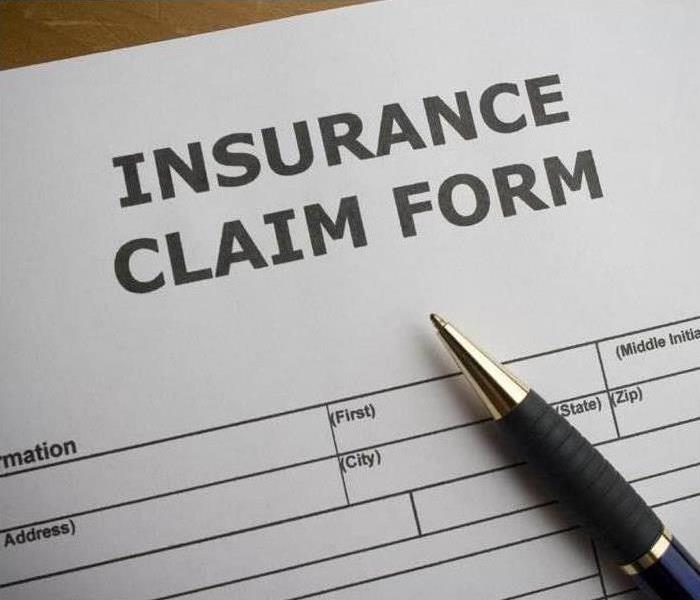 If you are not sure if your damage will be covered by your insurance, contact your insurance agent first!
If you are not sure if your damage will be covered by your insurance, contact your insurance agent first!
How to begin a water damage claims process
Whether it comes from bursting pipes, a broken appliance or a leaky roof, water can cause significant damage to your Riverside home. It can damage building materials, cause mold growth and ruin electronics. Homeowners insurance can help you pay for repairs. Take the following steps if you find yourself in this situation.
1. Call Right Away
It is important to start your insurance claim as quickly as possible. Not only will this result in completing the process sooner, but it will also help ensure that your claim isn’t affected. Some policies require you to report water damage within a certain time. If this is not done, it can reduce the amount you receive or can result in your claim being denied.
2. Document the Damage
Your insurance adjuster will need information on the areas of the house that were damaged, including whether there are bursting pipes and flooding, as well as any belongings that may need to be repaired or replaced. You should provide a list with pictures and the estimated value of included items.
3. Perform Mitigation
Mitigation is the process of preventing damage from spreading and worsening. This should be done quickly to reduce the amount of time and money needed to make repairs. An emergency cleanup and restoration company can inspect your home, fix broken pipes, remove water and repair the building along with damaged belongings.
4. Go Over Your Policy
Because individual insurance policies will vary, you should read over yours carefully. Make sure that you are familiar with anything that is required of you while making a claim as well as what is covered by your insurance. This will help the process go more smoothly.
Bursting pipes and other causes of damage can be frustrating to deal with. Making an insurance claim can also be stressful if you are unprepared. Following these steps can help you get through the situation more easily.
For help with your water damage claim call the experts at SERVPRO of West Riverside City
Phone us at 951-351-8033
The Importance of A Clean Restroom In Your Riverside Office Building
11/29/2021 (Permalink)
An area that employees usually don’t clean up after themselves is the bathroom. It is the most important part of the building to be properly and regularly cleaned and disinfected appropriately. A clean and disinfected restroom helps prevent the spread of illness-causing germs, such as Salmonella, E. coli and norovirus which are routinely found in restrooms. If your employees get sick due to these germs it could impact the bottom line of the company.
Areas of the bathroom that are regularly touched such as the toilets & urinals handles and then other hard surfaces are touched need to be professionally disinfected and cleaned to reduce the risk of passing on germs. Bathroom cleaning also includes cleaning dispensers, walls, stainless steel, vents, stall walls and tops, floor boards and floors, drains, pictures, mirrors, showers, locker areas and other bathroom fixtures.
A detailed checklist for an accurately clean bathroom:
Daily
Inspect paper dispensers and dryers to ensure they’re in working orderRestock and fill soap, toilet paper and towel dispensersSweep floors and mop, making sure to clean around and behind toilets and other hard-to-reach areasWipe down sinks and countersClean and sanitize toilets and urinals, including handlesDisinfect and empty feminine hygiene dispensers and restock with new linersDisinfect door handles and stall locks, both inside and outClean and shine mirrorsMonitor trash receptacles and empty them before they’re fullWeekly
Wipe down stall doors, cabinetry and any hardware inside and outDust all surfaces, light fixtures and light bulbsCheck faucets, pipes and toilets for leaksInspect drains to ensure they remain clog-freeMonthly
Wipe down walls to remove dust and particles that cling to surfacesDeep clean floors and scrub any tile and groutClean baseboards, trim and tops of doorsClean overhead fixtures such as ceiling fans, vents, lighting and sprinklersTo reduce the burden on your employees, save money on cleaning supplies and maintain your company’s reputation, leave the professional cleaning to SERVPRO of West Riverside City. For a free, no-obligation consultation and assessment of your needs call us at 951-851-8033
Brand New Generator? Understanding Safety During Emergencies
11/24/2021 (Permalink)
How many times has a generator restored a sense of normalcy to your life during or in the aftermath of a disaster or outage? Providing us with light, cold air in our refrigerators, the ability to charge our phones, and so much more, generators can be a lifesaver. The hope is that we don’t have to use our generators often, but as a result, how many of us feel confident that we have a sufficient grasp on generator safety? According to Consumer Reports, generators can pose safety risks, such as carbon monoxide poisoning and fire hazards, to residential and commercial properties alike, as well as those living or working in them. Here are our top generator safety tips to keep in mind during or after a storm.
Keep Your Generator OutsideStoring your generator indoors, in a garage, or any enclosed space increases the risk of carbon monoxide poisoning. The American Red Cross recommends that generators should be kept away from windows and doors in order to further prevent carbon monoxide from entering your home or business. Out of an abundance of caution, it is also beneficial to install a carbon monoxide detector and alarm system in your residential or commercial property. These devices will alert anyone inside of the home or building of carbon monoxide so that they can exit the property immediately.
Store Fuel in a Safe LocationGenerators require fuel in order to power your home and in the event of a storm that may cut off your power for multiple days on end, you will likely need to stock up on extra fuel. When storing fuel, it is important to keep it in a cool space that is well-ventilated and outside of any living spaces. Generator fuel is a serious fire hazard, so it is critical that fuel is stored properly in a location protected from any items that may ignite fire.
Consider Installing a Transfer SwitchThe fire hazards associated with extension cords can be avoided with the help of a transfer switch, which connects your generator directly to your property’s circuit panel. It is dangerous to plug your generator into a wall outlet. This practice is also known as “backfeeding” and can increase the risk of electrocution. Transfer switches eliminate the need for engaging in this dangerous activity and can also prevent overloading, as they sometimes display wattage use levels.
SERVPRO Is Standing By
If you decide to utilize a generator to power your home or business after a disaster leaves your property without power, be sure to exercise caution. Serious safety hazards, as well as significant risks to your property, accompany generator usage. Therefore, it is important to have an emergency plan in the event that generator usage leads to fire damage to your property. Our team of fire damage restoration experts will respond immediately when you are in need. Call SERVPRO of West Riverside City right away at (951) 351-8033 if your home or business experiences fire damage resulting from generator usage. Visit our website for an overview of our Storm Damage Restoration, Fire Damage Restoration, and Commercial Fire Damage Restoration services. We are standing by, ready to make it “Like it never even happened.”
Burned Turkeys Can Happen... Home Damage Doesn't Have To Happen!
11/22/2021 (Permalink)
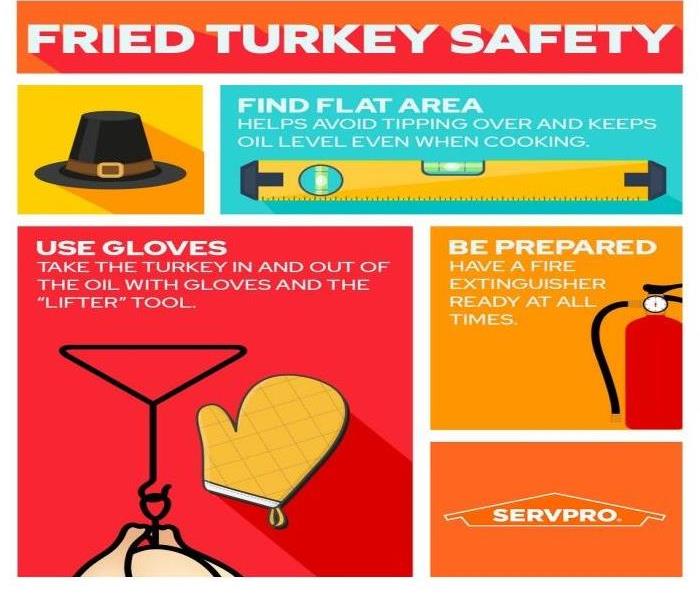 Despite hazards, if you still plan on using a turkey fryer, please follow these safety guidelines.
Despite hazards, if you still plan on using a turkey fryer, please follow these safety guidelines.
November is a month filled with food, family and football, there is also another attribute that may surprise you.
According to the NFPA (National Fire Protection Association), Thanksgiving is the peak day of the year in which home fires occur. The NFPA says that "between 2015 and 2019, cooking was the leading cause of reported home structure fires and civilian fire injuries - as well as the second-leading cause of civilian fire deaths. On Thanksgiving Day in 2019 alone, around 1,400 home cooking fires were reported to U.S. fire departments, which is a 228 percent increase over the daily average."
In order to avoid any potential fire damage or injury, browse these simple guidelines to ensure you have a safe holiday season.
- Stay in the kitchen when you are cooking, even a quick step away can lead to an accident.
- Stay in the home when cooking your turkey and check on it frequently.
- Keep children away from the stove. The stove will be hot, and kids should stay 3 feet away.
- Make sure kids stay away from hot food and liquids. The steam or splash from vegetables, gravy or coffee could cause serious burns.
- Wear protective gear when using indoor fryers.
- Ensure floor and kitchen area is clear of clutter and kiddos, so you don't accidentally trip.
- Keep a lid and fire extinguisher nearby to smother cooking fires.
- Avoid the use of outdoor, gas-fueled turkey fryers, especially indoors or in the garage area.
- Make sure your smoke alarms are working. Test them by pushing the test button.
What about outdoor deep fryers?
The National Fire Protection Association (NFPA) discourages the use of outdoor, gas-fueled turkey fryers, which can lead to devastating burns, destruction of property, and other injuries. Additionally, Underwriters Laboratories (UL), the organization that certifies safe products, does not certify these types of fryers with its UL label. Both organizations discourage the use of open-flame fryers due to the following:
- Turkey fryers tip easily, spilling their contents, and causing oil to ignite.
- Overfilling the fryer is common. The oil spills out of the pot when the turkey is placed in the fryer, engulfing the whole unit in flames.
- With no thermostat controls, the oil is prone to overheating to the combustion point.
- The handles and lid get extremely hot, which can cause severe burns.
- Since the unit is designed for outdoor use, rain or snow can fall on the unit, splattering the oil and converting the water to scalding steam.
Despite these hazards, if you still plan on using a turkey fryer, please follow these safety guidelines:
- Always use the fryer outdoors on a flat surface, safely away from structures, wooden decks, and covered patios. No matter what, DO NOT be tempted to use the fryer in a garage.
- Have the correct kind of fire extinguisher nearby and ready to use.
- To ensure you are using the right amount of oil, place a thawed turkey in the fry pot and add enough water to cover the bird by ½". Remove the turkey and mark the water level. Dump the water and thoroughly dry the pot and turkey. Fill the pot with oil to the marked level.
- Do not leave the fryer unattended. Monitor the temperature of the oil with a thermometer to prevent the oil from overheating and catching fire. If the oil begins to smoke, immediately turn the gas off.
- Ensure the turkey is COMPLETELY THAWED to prevent a fire or explosion hazard.
- Raise and lower the turkey slowly to prevent oil splatter, burns, and fire.
- Keep children and pets away from the fryer to prevent tipping, even after the turkey is done. The oil is dangerously hot for hours.
- Use your safety tools: Oven mitts, gloves, and safety goggles.
- Stand upwind of the propane tank and fryer so heat blows away from you.
In case you're still wondering, Thanksgiving is the peak day for home cooking fires. The day has three times the average number of reported home structure fires involved with cooking equipment. Please be careful this holiday season.
Contact SERVPRO to assist with damage caused by cooking this holiday season.
SERVPRO of West Riverside City
Phone 951-351-8033
November, a Big Month for SERVPRO- New Advertising Campaign
11/15/2021 (Permalink)
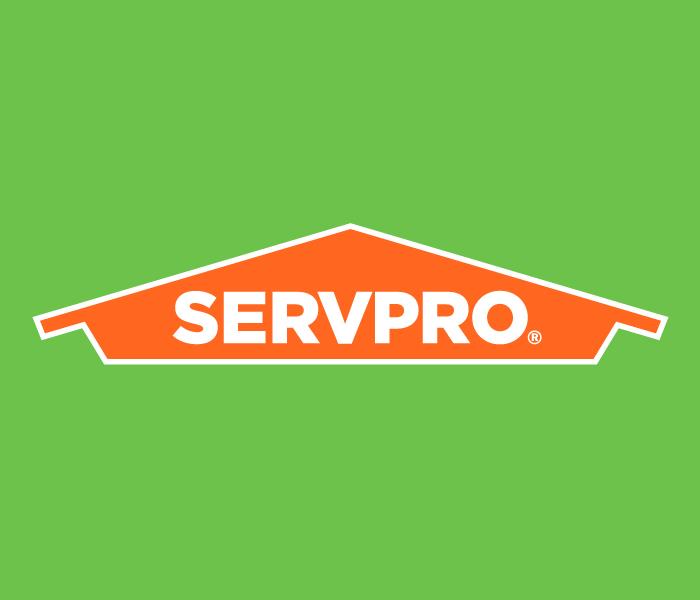 "There's a PRO for that!"
"There's a PRO for that!"
SERVPRO of West Riverside City sharing Press Release
GALLATIN, TN – (November 1, 2021) – SERVPRO®, one of the nation’s leaders in fire and water cleanup and restoration services, will bring its "Like it never even happened," brand promise to life in a fun, visually-striking advertising campaign. The new “There’s a PRO for that” campaign, which is scheduled to launch on November 1, showcases SERVPRO’s industry-leading arsenal of cleaning and restoration capabilities through a series of extreme scenarios that put its services to the test.
The new integrated campaign will feature national broadcast TV, OTT/overlays, paid and organic social media, online video (OLV) retargeting, and website content.
“The inspiration for this campaign comes directly from the amazing work SERVPRO experts do on a daily basis, taking on challenges of any size with an unmatched level of effectiveness,” said Mike Stahl, SERVPRO’s Chief Marketing Officer. “This campaign showcases how SERVPRO makes "Like it never even happened," happen. It dramatizes how no matter what might come your way, you can be reassured because SERVPRO always has a pro for that.”
The campaign was created by BUNTIN, SERVPRO’s lead brand, and advertising partner. The team at BUNTIN partnered with Los Angeles-based production house Smuggler, the top-rated production company in the United States, to produce two spots that combined massive in-camera special effects with high-quality post-production enhancements. Award-winning Swedish director Filip Engstrom was tapped to direct this project, bringing his modern aesthetic and expertise in large-scale productions to make the campaign even more impactful.
“While we’re well-known for our work in fire and water cleanup and restoration, ‘There’s a PRO for That’ also creates a framework for us to promote the other services we offer as well as potential future offerings,” Stahl added.
In addition to the advertising campaign, SERVPRO is unveiling a brand refresh featuring changes to its logo and several significant updates to its website, including a new “look and feel.” This is the first time SERVPRO has updated its logo since 2013. Featuring a new layout, the website changes offer a better user experience by connecting customers to their local SERVPRO location using auto-location detection, which makes the overall site significantly easier to navigate. The site also features new content demonstrating the processes and steps their PROs use to make it look "Like it never even happened," happen.
“With this brand refresh, we’ve maintained the legacy attributes of our brand, but given it a modern look and feel. Along with the new brand platform, our work to make our logo more modern, functional, and iconic is representative of our system-wide commitment toward maintaining our position as the industry leader,” Stahl added.
About the Production
A crew of 85 film industry professionals in Los Angeles collaborated in real-time with a team of digital effects and cinematography experts in Sweden, carefully following COVID-19 safety protocols over three 12-hour filming days.
The production team selected an abandoned factory outside downtown Los Angeles, which also provided the right environment to create a test facility look and feel and to show what SERVPRO experts are capable of doing. The over-the-top nature of the campaign demanded a large versatile production location that could accommodate space for a helicopter to drop a giant water balloon on top of a model home and for an airplane engine to blast the set of a hair salon, as well as tons of gadgets, rigs, engines, extras and SERVPRO experts with their gear, vans, a big-rig truck, and specialized equipment.
This new campaign replaces SERVPRO’s “Whatever Happens” campaign that has been in circulation since early 2019. A separate campaign to promote Certified: SERVPRO Cleaned, an enhanced cleaning program created in response to COVID-19, aired from June through December 2020.
About SERVPRO
For more than 50 years, SERVPRO has been a trusted leader in fire and water cleanup and restoration services, mold mitigation, biohazard, and pathogen remediation. SERVPRO’s professional services network of more than 1,900 individually owned and operated franchises spans the United States and Canada, responding to property damage emergencies large and small – from million-square-foot commercial facilities to individual homes. When disaster strikes, homeowners, business owners, and major insurance companies alike rely on SERVPRO to make it “Like it never even happened.”
How Can Residents Thank our Riverside First Responders?
10/27/2021 (Permalink)
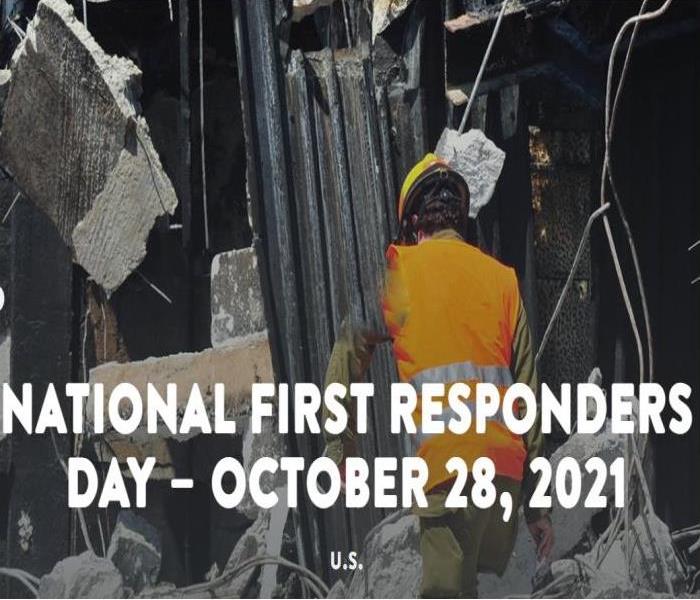 A simple "Thank you for your service" can be a great way to show you respect and appreciate what he or she is doing for the community!
A simple "Thank you for your service" can be a great way to show you respect and appreciate what he or she is doing for the community!
First responders' duties bring them into harm's way every day. Police officers, firefighters and paramedics put themselves on the front lines of dangerous and traumatic events, and it's common to wonder how you can thank these individuals, perhaps lessening the emotional burden of their work.
The following list is just a sampling of the many ways you can show a first responder that you care. These are good ideas to start with, and apply at any time of the year.
1. Cook a meal
Bringing home-cooked food to the local police or fire station can show the local first responder community that you care. Day-to-day life as a police officer, firefighter or paramedic can be stressful and the schedule irregular, meaning that home-cooked meals may be a luxury that will make these first responders grateful. And if you take the meal over yourself, you have a great chance to say a verbal thanks as well. Of course, since an alarm can sound at any time, it may be best if the meal is one that can be returned to later if the diners have to leave off in the middle.
2. Donate to a good cause
There are numerous charity drives in any given community to support the fire departments, police forces and more. A gift to one of these causes can make a material difference in the lives of first responders and the family members. Even if you don't possess the material means to make a big donation, there are plenty of ways to help charities, including organizing or volunteering at a drive or other event.
3. Send a letter of thanks
These days, many people don't take the time to write letters – electronic communication has driven paper out of favor. This means that sending a physical letter thanking first responders for their service may take on greater importance, feeling more personal, permanent and heartfelt than email. If you gather multiple letters from the community and deliver them all at once, the impression on the recipients could be significant.
The first responders in your community will be grateful for your thanks and support.
4. Send a practical gift basket
A gift basket is a classy way to express thanks. If you customize one of these presents to suit the tastes and needs of the local fire department or police force, it could be an incredibly thoughtful choice, one that will make your gratitude clear. Such a basket could include gift cards to restaurants in the area, allowing first responders to relax and unwind with good food between their high-stress assignments.
5. Use word of mouth
When you have a good experience with local first responders, spreading the word either online or in person can do a great service to the department. It's not a direct thanks to the police, fire and paramedic personnel, but speaking well of these individuals is a gesture of gratitude, one that is easy and impactful.
6. Just say 'thanks'
Just about every day, you likely pass police officers, firefighters and paramedics going about their daily business. Just saying a simple "Thank you for your service" can be a great way to show that individual you respect and appreciate what he or she is doing for the community. It's extremely simple, and could make a first responder's day.
Does Your Riverside Mobile Home Park Have an Emergency Preparedness Plan?
10/25/2021 (Permalink)
Do you live in one of the mobile home parks in Riverside, CA? Imagine a fire evacuation, is there clear direction on how you are to evacuate?
With the roads typically being narrow, some are cul-de-sacs how do you know. Are you aware of other exits that may be open during an emergency and which exit is closest to your home?
We will cover some of the things that can be discussed with your park manager if you are not aware of an Emergency Preparedness Plan.
The goal of the emergency plan is to maintain order, and reduce the risk to life, health, and safety of park residents and emergency services personnel in the event of an emergency. The Plan should identify essential evacuation routes that will be used in an emergency situation.
Residents must have access to information on evacuation routes as well as basic emergency preparedness information to enable them to take personal responsibility for themselves during an emergency. An important consideration in any emergency is the ability to coordinate with local responding agencies and personnel. It is imperative that
residents work in conjunction with and assist emergency response personnel as directed or instructed.
Evacuation of a Mobile Home Park
Once evacuation routes have been identified it is essential that park residents have access to this information. Evacuation information could be posted in the park clubhouse or other area within the park, and should be available to park residents before an emergency or disaster occurs. Having this knowledge will enable residents to take personal responsibility for themselves during an emergency.
There may be residents from the park who are willing to volunteer their time and to assist in the evacuation process. This will primarily be accomplished by using a current emergency phone contact list but in cases where phone service is not available or out-of-service, the information can be delivered door to door.
Evacuation considerations:
- Acquire and update emergency phone contact lists for next of kin notifications.
- Consider residents who may require assistance during an evacuation including but not limited to people with disabilities, or those who have access and/or functional needs.
− Residents can voluntarily provide specific limitations or health issues they may have which would require additional assistance during an evacuation.
- Inform other residents of the possibility of an evacuation or of an imminent evacuation during a natural or man-made disaster. Coordinate evacuation of other residents who are unable to transport out on their own.
- Inform/train other residents on procedures for securing their homes prior to evacuation such as gas shut off, water main shut off, electrical shut off, locking doors and windows, and leaving immediately to pre-determined locations.
- Organize and inform other residents of their evacuation route to take in leaving the park in a safe and orderly fashion.
- Conduct training and practice evacuation sessions.
Planning
The following list of questions and statements is only a sampling of items that could be identified and described in the park’s Evacuation Plan. These suggestions are provided as a tool to assist in the development of each parks customized Evacuation Plan.
- How many entrances and exits are there in the ark?
- Is there two way traffic accessible throughout the park?
- Are there concentrations of households who need special assistance to evacuate congregated in certain sections of the park?
- Would any section of the park be easier and quicker to evacuate first?
- Are there any fixed obstacles in the park that would hinder a sections evacuation route?
- If an entrance or exit is blocked, do you have an alternate evacuation route planned?
- In the event that all evacuation routes are disabled, is there a backup plan for evacuation such as a site for air lifting residents from the park?
- Adding information to the park plan that would inform residents how to prepare for an air lift rescue from their roof.
- Identification of the major safe sites in your community that emergency agencies use for evacuation.
- Supplying park residents with maps of the major routes out of the area.
- Safety issues that park residents can address before a disaster to make their homes safer (example: tie downs for LPG tanks; installation of smoke detectors, securing hot water heaters).
At a minimum, the Plan should include the following information: Essential evacuation routes; elevation of the park property, type of disasters common to your area; public warning signals used in the community; local emergency broadcast station frequency location; phone numbers to the local Red Cross chapter or other emergency agencies’ phone numbers.
Evacuation List of Residents by Section
The order of evacuation is for Section I to evacuate first, then Section 2 evacuates second and continues sequentially by Section number until the entire park has been evacuated. If the park contains numerous recreational vehicles, it is recommended that they maintain mobility functions for quick evacuation.
Evacuation Sites
Predetermined buildings/sites to evacuate to in the case of a Natural Disaster:
- Local High School Gymnasium
- Local Park Community Center
- Red Cross designated safe place
- Local Fair Grounds
- Another city or county government agency designated safe place
In the event of a disaster, which does not require evacuation of the entire park, the
designated site of evacuation within the park could be the community room or club house,
if available.
SERVPRO of West Riverside City is here to assist when disasters strikes. We're a phone call away at your time of need, night or day!
951-251-8033
International ShakeOut Day is always the third Thursday of October 21
10/20/2021 (Permalink)
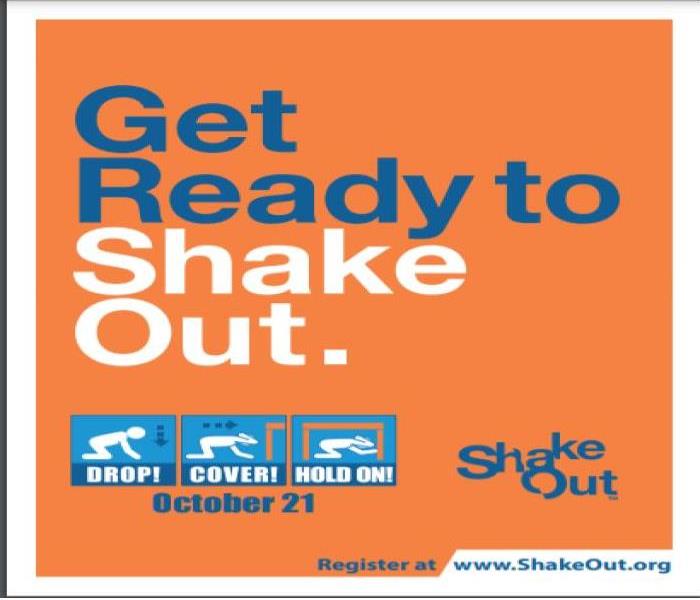 As always, you can hold your #ShakeOut drill when and where you want.
As always, you can hold your #ShakeOut drill when and where you want.
While COVID-19 has brought many uncertainties and challenges, one thing's for sure: ShakeOut is still happening this year!
As always, you can hold your #ShakeOut drill when and where you want. You can choose another date or several dates, and include people in multiple locations (home, work, or school), perhaps through video conferencing. It's a good idea to practice earthquake safety in different situations each year!
An earthquake is a sudden, rapid shaking of the ground caused by the shifting of rocks deep underneath the earth’s surface. Earthquakes can cause fires, tsunamis, landslides or avalanches. While they can happen anywhere without warning, areas at higher risk for earthquakes include Alaska, California, Hawaii, Oregon, Puerto Rico, Washington and the entire Mississippi River Valley.
Prepare Before an Earthquake
The best time to prepare for any disaster is before it happens.
Practice Drop, Cover, and Hold On with family and coworkers.Make an Emergency Plan: Create a family emergency communications plan that has an out-of-state contact. Plan where to meet if you get separated. Make a supply kit that includes enough food and water for several days, a flashlight, a fire extinguisher and a whistle.Protect Your Home: Secure heavy items in your home like bookcases, refrigerators, televisions and objects that hang on walls. Store heavy and breakable objects on low shelves. Consider making improvements to your building to fix structural issues that could cause your building to collapse during an earthquake. Consider obtaining an earthquake insurance policy. A standard homeowner’s insurance policy does not cover earthquake damage.Stay Safe During
If an earthquake happens, protect yourself right away:
If you are in a car, pull over and stop. Set your parking brake.If you are in bed, turn face down and cover your head and neck with a pillow.If you are outdoors, stay outdoors away from buildings.If you are inside, stay and do not run outside and avoid doorways.Protect Yourself During Earthquakes
1. Drop (or Lock)
Wherever you are, drop down to your hands and knees and hold onto something sturdy. If you’re using a wheelchair or walker with a seat, make sure your wheels are locked and remain seated until the shaking stops.
2. Cover
Cover your head and neck with your arms. If a sturdy table or desk is nearby, crawl underneath it for shelter. If no shelter is nearby, crawl next to an interior wall (away from windows). Crawl only if you can reach better cover without going through an area with more debris. Stay on your knees or bent over to protect vital organs.
3. Hold On
If you are under a table or desk, hold on with one hand and be ready to move with it if it moves. If seated and unable to drop to the floor, bend forward, cover your head with your arms and hold on to your neck with both hands.
Stay Safe After
After an earthquake, there can be serious hazards such as damage to the building, leaking gas and water lines, or downed power lines.
Expect aftershocks to follow the main shock of an earthquake. Be ready to Drop, Cover, and Hold On if you feel an aftershock.If you are in a damaged building, go outside and quickly move away from the building. Do not enter damaged buildings.If you are trapped, send a text or bang on a pipe or wall. Cover your mouth with your shirt for protection and instead of shouting, use a whistle.Check yourself to see if you are hurt and help others if you have training. Learn how to be the help until help arrives.Once you are safe, pay attention to local news reports for emergency information and instructions via battery-operated radio, TV, social media or from cell phone text alerts.
Register on the American Red Cross “Safe and Well” website so people will know you are okay.Use text messages to communicate, which may be more reliable than phone calls.Be careful when cleaning up. Wear protective clothing, including a long-sleeved shirt, long pants, work gloves and sturdy thick-soled shoes. Do not try to remove heavy debris by yourself. Wear a mask and maintain a physical distance of at least six feet while working with someone else. Use an appropriate mask if cleaning mold or other debris. People with asthma and other lung conditions and/or immune suppression should not enter buildings with indoor water leaks or mold growth that can be seen or smelled. Children should not take part in disaster cleanup work.Engage virtually with your community through video and phone calls. Know that it’s normal to feel anxious or stressed. Take care of your body and talk to someone if you are feeling upset.
A Disaster Preparedness Planning Guide for Owners and/or Residents in Riverside Mobile Home Parks
10/19/2021 (Permalink)
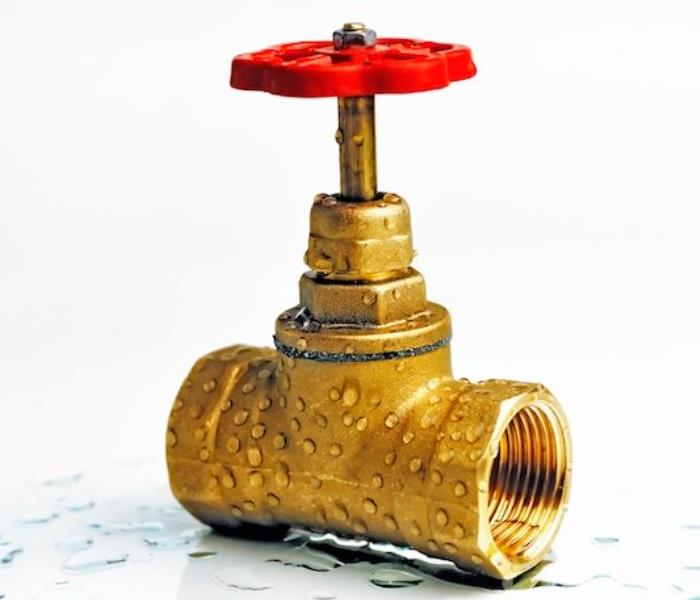 Do you know how to shut off damaged utilities?
Do you know how to shut off damaged utilities?
The most important feature of any home is something you probably do not see when you walk through the door.
But it could save your life. It is safety. Safety comes in all shapes and sizes: smoke detectors; fire extinguishers; escape routes; carefully maintained heating and electrical systems; and knowing what to do and where to go in case of fire, flood, or other disasters. The key to being prepared in the event of a disaster or sudden emergency is preplanning and practice drills.
Disaster Preparedness Emergency Plan
The next time disaster strikes, you may not have much time to act. Prepare now for a sudden emergency. Knowing what to do in an emergency is your best protection and your responsibility. Learn how to protect yourself and your family by planning ahead. To obtain more information, you may want to contact your local emergency management agency or civil defense office and the local American Red Cross chapter - be prepared to take notes.
You will need to gather the following information:
- Find out which disasters are most likely to occur in your area. Ask how to prepare for each disaster.
- Ask how you would be warned of an emergency.
- Learn about your community’s warning signals: what they sound like and what you should do when you hear them.
- Learn your community’s main evacuation routes.
- If needed, ask about special assistance for the elderly or disabled persons.
- Ask about animal care during and after an emergency. Animals may not be allowed inside emergency shelters due to health regulations.
Checklist of Emergency Procedures
Meet with your family and discuss why you need to prepare for disasters. Explain the dangers of fire, severe weather and earthquakes to children, the elderly, and individuals that may need special assistance. Plan to share responsibilities and work together as a team. The following may be used in creating your own Emergency Response Plan:
- Draw a floor plan of your residence and mark two escape routes from each room.
- Install safety features in your home, such as smoke detectors and fire extinguishers.
- Discuss what to do in an evacuation.
- Find the safe spots in your home for each type of disaster. Post emergency telephone numbers near the telephone.
- Instruct household members to turn on a battery powered radio for emergency information.
- Pick one out-of-state and one local friend or relative for family members to call if separated by disaster (it is often easier to call out-of-state than within the affected area).
- Teach children how and when to call 9-1-1 and a long distance contact person.
- Pick two meeting places: 1) a place near your home in case of fire; 2) a place outside your neighborhood in case you cannot return home after a disaster.
- Keep family records in a water and fire-proof container.
- Locate the main electric fuse box, water service main, and natural gas main shut off valve to your mobile home. Learn how and when to turn these utilities off. Teach all responsible family members. Keep necessary tools near gas and water shut-off valves. Turn off the utilities only if you suspect the lines are damaged or if you are instructed to do so. If you turn the gas off, you will need a professional to turn it back on.
- Take a basic first aid and CPR class.
- Prepare a disaster supply kit.
If Disaster Strikes
- Remain calm and patient. Put your plan into action.
- Check for injuries; give first aid and get help for seriously injured.
- Listen to your battery powered radio for news and instructions.
- Evacuate if advised to do so. Wear appropriate clothing and sturdy shoes.
- Check for damage to your home - use a flashlight only. Do not light matches or turn on electrical switches, if you suspect damage.
- Check for fires, fire hazards and other household hazards.
- If you are remaining in your home, sniff for gas leaks, starting at the hot water heater. If you smell gas or suspect a leak, turn off the main gas valve, open windows, and get everyone outside quickly.
- Shut off any other damaged utilities.
- Clean up spilled medicines, bleaches, gasoline and any other flammable liquid immediately.
Remember to:
- Remember to confine or secure your pets.
- Call your family contact - do not use the telephone again unless it is a life threatening emergency.
- Check on your neighbors, especially elderly or disabled persons.
- Make sure you have an adequate water supply in case service is shut off.
- Stay away from downed power lines.
SERVPRO of West Riverside City has years of experience with water and fire damage. We have also handled water damage within mobile homes and we understand that they are not your standard stick home. Call us if you experience an emergency. We are here to help!
SERVPRO of West Riverside City
951-351-8033
Do you Know the Difference Between Disaster Assistance vs. Flood Insurance?
10/14/2021 (Permalink)
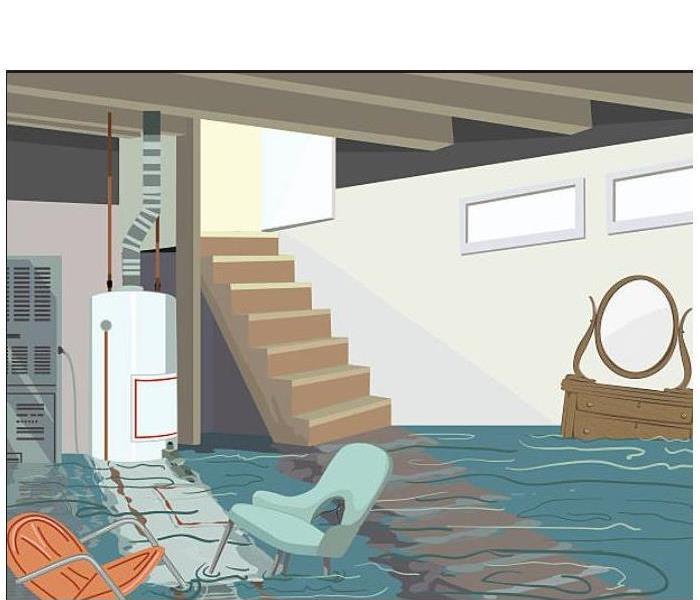 Flood insurance gives you peace of mind that you’ll receive the maximum amount available to fully recover after a flood.
Flood insurance gives you peace of mind that you’ll receive the maximum amount available to fully recover after a flood.
If you experience property damage during a flood, you’ll likely be able to cover your recovery costs through disaster assistance funding—right? Possibly wrong.
In fact, federal disaster assistance isn’t guaranteed, and many residents overestimate the amount of funding they’ll receive (if any). As climate change worsens and residents face an increasing risk of damage from things like hurricanes, levee failures, and post-fire flooding, you’ll want to make sure you’re prepared. Take the first step by visiting FloodSmart.gov to learn how flood insurance can best protect you against the financial impact of flooding.
Ready.gov helps us understand five key differences between disaster assistance and flood insurance:
- Disaster Declarations: Federal disaster assistance requires a Major Disaster Declaration from the president to authorize funding for FEMA’s Individuals and Households Program. Flood insurance does not require a disaster declaration, so policyholders can make a claim almost immediately after any flood event.
- Coverage: Both disaster assistance and flood insurance cover flood damage to your primary residence—but disaster assistance is only designed to make a home “safe, sanitary, and fit to occupy,” not to restore it to pre-disaster condition. Disaster assistance can sometimes be used for additional expenses like vehicle repairs, temporary housing, or medical fees, but only flood insurance offers building and contents coverage that is customizable to meet your needs.
- Payout: Federal disaster assistance often comes in the form of a FEMA disaster grant, which averages about $5,000 per household, or a Small Business Administration (SBA) loan. By comparison, the average flood insurance claim payment over the past five years was approximately $69,000. Unless purchased through a private vendor, flood insurance policies are backed by the National Flood Insurance Program (NFIP) . You will never need to repay the NFIP for your flood insurance, but certain forms of federal assistance, like SBA loans, must be repaid with interest.
- Duplicative Expenses: FEMA cannot provide financial assistance when any other source—such as flood insurance—has already provided such assistance. For example, if your flood insurance company has already provided money for home repairs, you would not be able to receive additional disaster assistance for that claim; however, you could still receive FEMA disaster assistance to cover a separate, not-covered expense like vehicle damage.
- Future Flooding: If you do receive disaster assistance after a flood, you may be required to purchase and maintain a flood insurance policy going forward in order to be eligible to receive aid for any future flooding events.
Flood insurance gives you peace of mind that you’ll receive the maximum amount available to fully recover after a flood. Visit FloodSmart.gov to learn more about how to get started.
Do your Children Know What To Do in the Event of a Disaster?
9/20/2021 (Permalink)
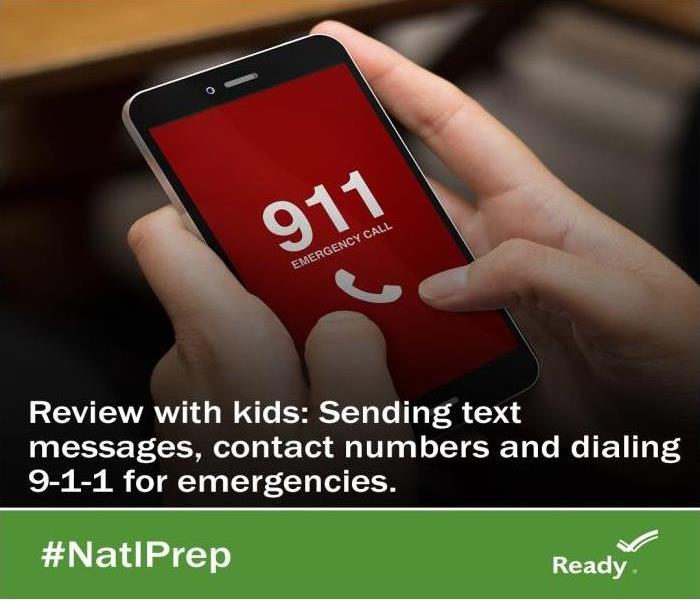 BEFORE an emergency, teach your child how to dial 911 #YouthPrep
BEFORE an emergency, teach your child how to dial 911 #YouthPrep
National Preparedness Month September 19-25: Teach Youth About Preparedness
Week Four of National Preparedness Month focuses on Youth.
Many families are not together during an emergency, its important that your children and young adults know what to do during different types of emergencies.
Talk to your kids about preparing for emergencies and what to do in case you are separated. Reassure them by providing information about how they can get involved.
How Can You Prepare Your Family?
Being prepared for disasters starts at home. Everyone can be part of helping to prepare for emergencies. Young children and teens alike can be a part of the process. As a parent, guardian, or other family member, you have an important role to play when it comes to protecting the children in your life and helping them be prepared in case disaster strikes.
We will touch on how to build your family emergency plan, how you can help children cope if they’ve experienced a disaster, and tips to help your children be ready when disaster strikes. With these tools, both kids and their families can be prepared whether they’re at home, school, or anywhere else.
How to Build and Emergency Plan
Some disasters strike without any warning, and family members may not all be in the same place. How will you get in touch with each other? Where will you meet? How will you get out of your house in case of a fire? What if your neighborhood is being evacuated? It's important to make a plan, now, so that you will know what to do, how to find each other, and how to communicate in an emergency.
How to Build a Kit
Being prepared for an emergency isn't just about staying safe during a storm or a disaster. It's also about how to stay comfortable, clean, fed, and healthy afterwards—when a storm or disaster may have knocked out electricity.
If you lost power, how would you eat? The refrigerator wouldn’t keep your food cold. The microwave couldn’t warm things up. You might not get clean water out of your faucets. How would you find out if it was safe to play outside? Not from your TV or computer!
If power is out, you also might not be able to go to the store or the bank. Being prepared means having your own food, water, cash, and other supplies to last for at least three days, and possibly longer if you are in a remote or hard-to-reach area.
Check out our blog on How Build a Basic Disaster Emergency Supply Kit
Helping Children Cope
Disasters can leave children and teens feeling frightened, confused and insecure. Their responses can be quite varied. It's important to not only recognize these reactions, but also help children cope with their emotions.
Encourage dialogue and answer questions
Listen to your kids. Ask them about their feelings and validate their concerns. When they ask questions, give just the amount of information you feel your child needs.
Make time for them and find support
Help kids understand that they are safe and secure by talking, playing, and doing other family activities with them. Build support networks with friends, family, and community organizations to help you cope, which can also help your children cope.
Keep to a routine
Help your children feel as if they still have a sense of structure, which can make them feel more relaxed. When schools and childcare open again, help children return to normal activities like going to class, sports, and play groups.
Risk Factors
For many kids, reactions to disasters are short-term. But some children can be at risk for more long-term psychological distress. Three risk factors for this longer-lasting response are:
- Direct exposure to the disaster such as being evacuated, observing injuries of others, or experiencing injury.
- Loss/grief relating to the death or serious injury of family or friends.
- Ongoing stress from secondary effects, such as temporary housing, loss of social networks, loss of personal property, or parent's unemployment.
Stay involved with your children and young adults. Our blogs for the month of September all focus on emergency preparedness.
SERVPRO of West Riverside City blogs
Emergency Preparedness, Ways to be Involved in Your Riverside Community
9/15/2021 (Permalink)
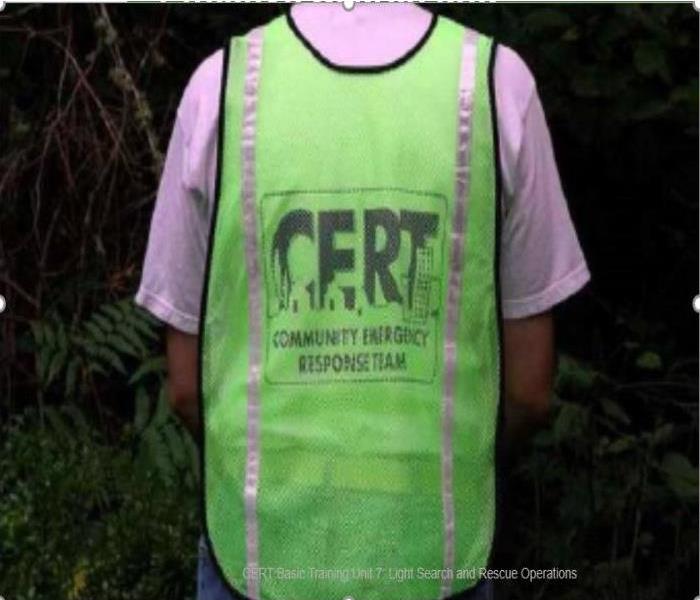 CERT members can assist others following an event when professional responders are not immediately available to help
CERT members can assist others following an event when professional responders are not immediately available to help
Week 3 September 12-18: Low-Cost, No-Cost Preparedness
There are many great organizations and groups you can join that will allow you to help in your community during disasters, some of these are at no cost. Knowing you are able to help others is empowering and highly rewarding.
CPR
You can make a save a life by learning hands-only CPR.
Why Learn Hands-Only CPR:
80% occur at home – so the life you are most likely to help save is a family member or friend. Sudden Cardiac Arrest is an electrical problem with the heart where it stops beating and pumping blood. That causes the brain to shut down, so the person suddenly collapses and is unconscious. EMS can restart the heart using a defibrillator (AED) and/or medications – but take 5 or more minutes to arrive. Hands-Only CPR can keep the heart and brain alive until EMS takes over. Mouth-to-mouth breathing is not necessary – there is oxygen in the blood. CERT-Community Emergency Response Team
CERT Program educates people about disaster preparedness for hazards that may impact their area and trains them in basic disaster response skills, such as fire safety, light search and rescue, team organization, and disaster medical operations.
Using the training learned in the classroom and during exercises, CERT members can assist others in their neighborhood or workplace following an event when professional responders are not immediately available to help.
CERT members also are encouraged to support emergency response agencies by taking a more active role in emergency preparedness projects in their community.
Visit RivCoCERT.org
You Are the Help Until Help Arrives
designed by FEMA, are trainings that can be taken online or in-person, where you learn through simple steps how to save a life before a professional arrives.
Learn five simple steps that may save a life
Call 9-1-1Stay SafeStop the BleedingPosition the InjuredProvide ComfortLife-threatening emergencies can happen fast and emergency responders aren’t always nearby.
You may be able to save a life by taking simple actions immediately.
You Are the Help Until Help Arrives.
Click on the links below to learn more about how you can help:
An animated interactive videoA web-based training programA downloadable instructor guide and student tools to provide in-person trainingSet up Riverside Alert
Riverside Alert allows the City of Riverside to provide you with critical information quickly in a variety of situations, such as unexpected road closures, utility outages, missing persons and evacuations of buildings or neighborhoods.
You will receive time-sensitive messages wherever you specify, such as your home, mobile or business phones, email address, text messages and more. You pick where, you pick how.
The City of Riverside has launched a mass notification service that allows us to alert you in the case of an emergency. You opt-in to enter your contact information and subscribe to notifications you care about. The information you provide is protected and will not be used for any other purpose.
How it works
When we issue a notification about a potential safety hazard or concern, you will receive a message on the voice or text communication methods that you have selected. If requested for the notification, you can confirm that you have received the message and you will not be contacted by any subsequent methods regarding that particular notification. If you do not confirm, the system will continue to attempt to reach you at all of the contact paths that you have registered.
Sign up for notifications
Create an account and add your contact and location information into Riverside Alert. All information you provide will be kept strictly confidential.
Sign Up Here
How To Prepare for Disaster on a Budget?
9/13/2021 (Permalink)
 Natural disasters don’t wait for a convenient time. Preparing for them shouldn’t wait either.
Natural disasters don’t wait for a convenient time. Preparing for them shouldn’t wait either.
National Preparedness Month
Week 3 September 12-18: Low-Cost, No-Cost Preparedness
Natural disasters don’t wait for a convenient time. Preparing for them shouldn’t wait either.
If you are on a tight budget, there are several steps you can take that won't cost anything or that you could coordinate with a low budget. Here are some tips from Ready.gov:
Alerts
Start by signing up for alerts, safe-guarding important documents, and taking other low cost and no cost preparedness actions to lessen the impact of disasters and emergencies for you and your family.
Preparedness Products
Download or order your free preparedness products to help your family plan and prepare for the next emergency.
www.ready.gov/publications
Evacuation Drills
Drills aren’t just for your toolbox. Practice emergency drills with your family regularly. Kids already do this at school, why not implement them on a yearly basis at home.
Have a Communication Plan
Emergencies can happen anytime, and less than half of American families have a communication plan.
Ready.gov provides downloadable resources that are free! Print out a Communications Plan and fill it in with your family.
Plan ahead:
www.ready.gov/kids/make-a-plan
Prepare with Kids
Make preparing fun for kids! Go on a scavenger hunt around your house for items you already have to add to your disaster supply kit. Follow this list: www.ready.gov/kit and see how many items you can check off!
Be aware of disasters in your area
Know what disasters and hazards could affect your area, how to get emergency alerts, and where you would go if you and your family need to evacuate. Visit: www.ready.gov/be-informed.
Here are some tips to help you put together a budget friendly emergency kits
- Go to a dollar store. Here you can find kitchen items, first aid, cleaning supplies, lighting, and water
- Look for grocery food sales- buy 10 with a discount, canned goods are often on sale and use coupons.
- There are many budget grocery stores where you can find many items on your list.
- Buy in bulk for personal items.
- Purchase items when not in high demand
- Buy throughout the year.
- Use what you have at home, soda bottles can be cleaned appropriately and filled with water.
- Purchase off-brand items.
- Purchase electronic emergency supplies on eBay or Amazon
How to Build a Basic Disaster Emergency Supply Kit
9/9/2021 (Permalink)
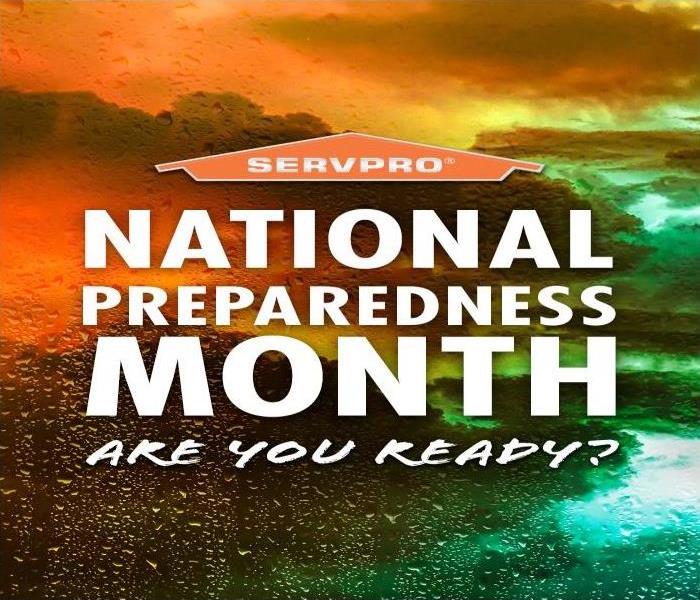 After an emergency, you may need to survive on your own. Being prepared means having your own food, water and other supplies to last for several days
After an emergency, you may need to survive on your own. Being prepared means having your own food, water and other supplies to last for several days
Being prepared means being equipped with the proper supplies you may need in the event of an emergency or disaster.
We've experienced the challenges of gathering supplies during COVID-19 sheltering in place. Many stores were out of basic necessities such as hand sanitizer, toilet paper, water and N95 masks along with a list of other items. How can you be prepared in advance? Week two of National Preparedness Month helps us with building a kit. We will provide tips with the help of Ready.gov on putting together your kit based on your family's needs.
After an emergency, you may need to survive on your own for several days. Being prepared means having your own food, water and other supplies to last for several days. A disaster supplies kit is a collection of basic items your household may need in the event of an emergency.
Week 2 September 5-11: Build A Kit
Gather supplies that will last for several days after a disaster for everyone living in your home. Don’t forget to consider the unique needs each person or pet may have in case you have to evacuate quickly. Update your kits and supplies based on recommendations by the Centers for Disease Control.
Make sure your emergency kit is stocked with the items on the checklist below. Download a printable version to take with you to the store. Once you take a look at the basic items consider what unique needs your family might have, such as supplies for seniors or pets (Check out our next Blog for pets.
Basic Disaster Supplies Kit
To assemble your kit store items in airtight plastic bags and put your entire disaster supplies kit in one or two easy-to-carry containers such as plastic bins or a duffel bag.
A basic emergency supply kit could include the following recommended items:
- Water (one gallon per person per day for several days, for drinking and sanitation)
- Food (at least a three-day supply of non-perishable food)
- Battery-powered or hand crank radio and a NOAA Weather Radio with tone alert
- Flashlight
- First aid kit
- Extra batteries
- Whistle (to signal for help)
- Dust mask (to help filter contaminated air)
- Plastic sheeting and duct tape (to shelter in place)
- Moist towelettes, garbage bags and plastic ties (for personal sanitation)
- Wrench or pliers (to turn off utilities)
- Manual can opener (for food)
- Local maps
- Cell phone with chargers and a backup battery
Consider adding the following items to your emergency supply kit based on your individual needs:
- Non-prescription medications such as pain relievers, anti-diarrhea medication, antacids or laxatives
- Prescription eyeglasses and contact lens solution
- Infant formula, bottles, diapers, wipes and diaper rash cream
- Pet food and extra water for your pet
- Cash or traveler's checks
- Important family documents such as copies of insurance policies, identification and bank account records saved electronically or in a waterproof, portable container
- Sleeping bag or warm blanket for each person
- Complete change of clothing appropriate for your climate and sturdy shoes
- Fire extinguisher
- Matches in a waterproof container
- Feminine supplies and personal hygiene items
- Mess kits, paper cups, plates, paper towels and plastic utensils
- Paper and pencil
- Books, games, puzzles or other activities for children
Maintaining Your Kit
After assembling your kit remember to maintain it so it’s ready when needed:
- Keep canned food in a cool, dry place.
- Store boxed food in tightly closed plastic or metal containers.
- Replace expired items as needed.
- Re-think your needs every year and update your kit as your family’s needs change.
Kit Storage Locations
Since you do not know where you will be when an emergency occurs, prepare supplies for home, work and cars.
- Home: Keep this kit in a designated place and have it ready in case you have to leave your home quickly. Make sure all family members know where the kit is kept.
- Work: Be prepared to shelter at work for at least 24 hours. Your work kit should include food, water and other necessities like medicines, as well as comfortable walking shoes, stored in a “grab and go” case.
- Car: In case you are stranded, keep a kit of emergency supplies in your car.
How Can You Prepare Your Pets For a Disaster
9/8/2021 (Permalink)
 SERVPRO of West Riverside City's mascot Ellie is ready for any disaster!
SERVPRO of West Riverside City's mascot Ellie is ready for any disaster!
Your pets are an important member of your family, so they need to be included in your family’s emergency plan.
To prepare for the unexpected follow these tips with your pets in mind:
- Make a plan.
- Build an emergency kit.
- Stay informed.
Make a Plan
If you have a plan in place for you and your pets, you will likely encounter less difficulty, stress and worry when you need to make a decision during an emergency. If local officials ask you to evacuate, that means your pet should evacuate too. If you leave your pets behind, they may end up lost, injured or worse.
What can you do right now?
- Make sure that cats and dogs are wearing collars and identification tags
- Put your cell phone number on your pet's tag.
Things to include in your plan:
- Have an evacuation plan for your pet. Many public shelters and hotels do not allow pets inside. Know a safe place where you can take your pets before disasters and emergencies happen.
- Develop a buddy system. Plan with neighbors, friends or relatives to make sure that someone is available to care for or evacuate your pets if you are unable to do so.
- Have your pet microchipped. Make sure to keep your address and phone number up-to-date and include contact information for an emergency contact outside of your immediate area.
- Contact your local emergency management office, animal shelter or animal control office to get additional advice and information if you’re unsure how to care for your pet in case of an emergency.
Here is a list of animal-friendly places handy, and call ahead for a reservation as soon as you think you might have to leave your home.
Build a Kit for Your Pet
Just as you do with your family’s emergency supply kit, think first about the basics for survival, such as food and water. Have two kits, one larger kit if you are sheltering in place and one lightweight version for if you need to evacuate. Review your kits regularly to ensure that their contents, especially foods and medicines, are fresh.
Here are some items you may want to include in an emergency kit for your pet:
- Food. Keep several days’ supply of food in an airtight, waterproof container.
- Water. Store a water bowl and several days’ supply of water.
- Medicine. Keep an extra supply of the medicine your pet takes on a regular basis in a waterproof container.
- First aid kit. Talk to your veterinarian about what is most appropriate for your pet’s emergency medical needs.
- Collar with ID tag and a harness or leash. Include a backup leash, collar and ID tag. Have copies of your pet’s registration information and other relevant documents in a waterproof container and available electronically.
- Traveling bag, crate or sturdy carrier, ideally one for each pet.
- Grooming items. Pet shampoo, conditioner and other items, in case your pet needs some cleaning up.
- Sanitation needs. Include pet litter and litter box (if appropriate), newspapers, paper towels, plastic trash bags and household chlorine bleach to provide for your pet’s sanitation needs.
- A picture of you and your pet together. If you become separated from your pet during an emergency, a picture of you and your pet together will help you document ownership and allow others to assist you in identifying your pet.
- Familiar items. Put favorite toys, treats or bedding in your kit. Familiar items can help reduce stress for your pet.
Tips for Large Animals
If you have pets such as horses, goats or pigs on your property, be sure to prepare before a disaster.
In addition to the tips above:
- Ensure all animals have some form of identification.
- Evacuate animals earlier, whenever possible. Map out primary and secondary routes in advance.
- Make available vehicles and trailers needed for transporting and supporting each type of animal. Also make available experienced handlers and drivers.
- Ensure destinations have food, water, veterinary care and handling equipment.
- If evacuation is not possible, animal owners must decide whether to move large animals to a barn or turn them loose outside.
Stay Informed
Being prepared and staying informed of current conditions. Here are some ways you can stay informed:
- Pay attention to wireless emergency alerts for local alerts and warnings sent by state and local public safety officials.
- Listen to local officials when told to evacuate or shelter in place.
- Download the FEMA app and get weather alerts from the National Weather Service, for up to five different locations anywhere in the United States.
- Always bring pets indoors at the first sign or warning of a storm or disaster.
What Is the First Step You Can Take to Plan for a Natural Disaster in Riverside?
9/2/2021 (Permalink)
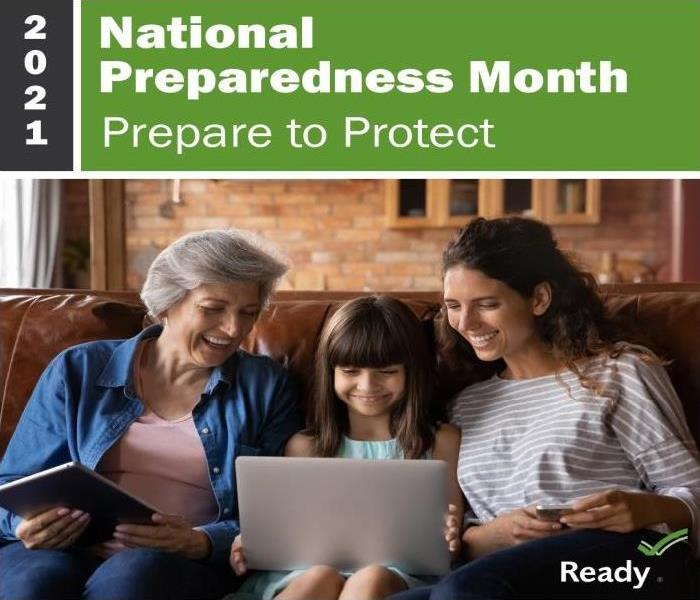 Discuss with your household or family how you will communicate if there is an emergency.
Discuss with your household or family how you will communicate if there is an emergency.
In 2020, 60,714 weather-related events resulted in 585 deaths and 1,708 injuries. Winter weather, tornadoes and floods resulted in the most deaths that year, according to Injury Facts.
Make a plan today. Your family may not be together if a disaster strikes, so it is important to know which types of disasters could affect your area. Within Riverside, California, we can face many different disasters. Riverside is prone to earthquakes, wildfires, flooding, strong winds, thunder storms, lightening, and flash flooding. The most recent disaster affecting all families world wide is our current COVID-19 pandemic. With this pandemic, sheltering in place was mandated so it was necessary to have enough food and items to sustain families for more than a month. Were you prepared? Did you have enough of life's necessities to keep you and your family sustained?
Ready.Gov has provided steps to make a plan.
Week 1 September 1-4: Make A Plan
Talk to your friends and family about how you will communicate before, during, and after a disaster. Make sure to update your plan based on the Centers for Disease Control recommendations due to the coronavirus.
Creating your Family Emergency Communication Plan starts with one simple question: "What If"
- What if something happens and I'm not with my family?
- Will I be able to reach them?
- How will I know if they are safe?
- How can I let them know I'm Ok?
During a disaster, you will need to send or receive information from your family.
Communication networks, such as mobile phones and computers, could be unreliable during disasters, and electricity could be disrupted. Planning in advance will help ensure that all members of your household-including children, pets and people with disabilities, as well as outside caregivers- know how to reach each other and meet up in an emergency.
Planning starts with these three steps:
- Create a paper copy of the contact information for your family and other important people/offices such as medical facilities, doctors, schools, or service providers
- Make sure everyone carries a copy in his or her back pack, purse, or wallet. If you complete your Family Emergency Communication Plan online at Create Your Family Emergency Communication Plan you can print it into a wallet sized card. You should also post a copy in a central location in your home, such as your refrigerator or bulletin board.
- Have regular household meetings to review and practice your plan.
Best way to communicate?
Text is best! If you are using a mobile phone, a text message may get through when a phone call will not. This is because a text message requires much less bandwidth then a phone call. Text messages may also save and then send automatically as soon as capacity becomes available.
Know how you’ll contact one another and reconnect if separated. Establish a family meeting place that’s familiar and easy to find.
- PrepareToProtect means preparing to protect everyone you love. Start by making a plan before disasters and emergencies strike: www.ready.gov/plan
- Discuss with your household or family how you will communicate if there is an emergency.
- Decide and practice your emergency plan with members of your household.
- Houses, mobile homes, apartments, and high-rise buildings have different evacuation considerations. Make a plan for each: www.ready.gov/plan-for-locations
- Involve your entire family, including your children, in planning for disasters and emergencies so they are prepared, not afraid: www.ready.gov/plan
Keep the number of SERVPRO of West Riverside City in your emergency contact list. We are available for those unexpected disasters 24 hours a day, 24 days a week. We are also available during holidays!
951-351-8033
Riverside, Are You Ready for a Disaster? Prepare Now During National Preparedness Month!
9/1/2021 (Permalink)
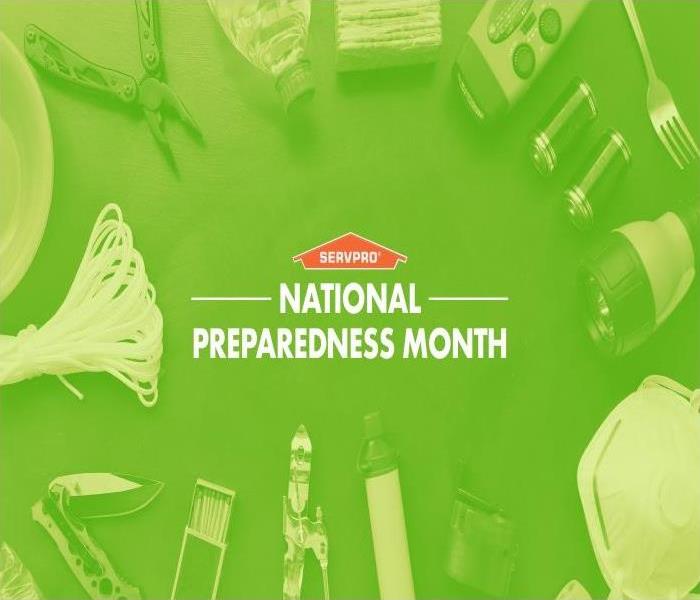 "Prepare to Protect” - Preparing for disasters is protecting everyone you love.
"Prepare to Protect” - Preparing for disasters is protecting everyone you love.
"Prepare to Protect”
Preparing for disasters is protecting everyone you love.
National Preparedness Month (NPM) is an observance each September to raise awareness about the importance of preparing for disasters and emergencies that could happen at any time. The 2021 theme is “Prepare to Protect. Preparing for disasters is protecting everyone you love.”
Why is it so important to be prepared? We are facing disasters more frequently. Not only natural disasters but disaster in our own home or business can happen at anytime.
Wildfires-2021 Fire Season Outlook
While wildfires are a natural part of California’s landscape, the fire season in California and across the West is starting earlier and ending later each year. Climate change is considered a key driver of this trend. Warmer spring and summer temperatures, reduced snowpack, and earlier spring snowmelt create longer and more intense dry seasons that increase moisture stress on vegetation and make forests more susceptible to severe wildfire. The length of fire season is estimated to have increased by 75 days across the Sierras and seems to correspond with an increase in the extent of forest fires across the state. NIFC predicts portions of the Coast Ranges, Sierra, and Cascades in California increasing to above normal fire danger in June and July and continuing through September.
Hurricanes
Hurricane Ida just made landfall in Louisiana, it was more powerful than Katrina exactly 16 years ago to date.
Katrina first made landfall early on August 29, 2005, as a Category 3 storm with maximum winds of about 125 mph near Buras, Louisiana, the National Hurricane Center said. It had been a Category 5 storm in the Gulf of Mexico and weakened significantly before making landfall, but that prior strength meant that it created a very high storm surge.
Earthquakes
Earthquaketrack.com provided these statistics as of 8/30/21:
California, United States has had: (M1.5 or greater)
- 28 earthquakes in the past 24 hours
- 224 earthquakes in the past 7 days
- 885 earthquakes in the past 30 days
- 11,314 earthquakes in the past 365 days
*Insurance Information Institute calculations, based on ISO®, a Verisk Analytics® business, data for homeowners insurance claims from 2015-2019
Insurance Claims
In additional to natural disasters, there are the disasters that occur at home due to damage caused by fire and water. These are sobering statistics. These same causes can also impact your business!
Homeowners Insurance Claims Frequency*
- About one in 20 insured homes has a claim each year.
- About one in 40 insured homes has a property damage claim related to wind or hail each year.
- About one in 50 insured homes has a property damage claim caused by water damage or freezing each year.
- About one in 365 insured homes has a property damage claim related to fire and lightning.
- About one in 425 insured homes has a property damage claim due to theft each year.
- About one in 1,440 homeowners policies has a liability claim related to the cost of lawsuits for bodily injury or property damage that the policyholder or family members cause to others.
*Insurance Information Institute calculations, based on ISO®, a Verisk Analytics® business, data for homeowners insurance claims from 2015-2019
How can we prepare our families and Business'?
Ready.gov has provided weekly themes. Review these with you family. Make everyone aware of yur family or business emergency plan. Schools hold fire evacuation and earthquake drills. Each family can plan to do the same. Ready.gov provides tools and resources to help with your planning. We will blog about the themes each week!
Weekly Themes
Each week in September, the campaign will focus on a different aspect of preparedness for individuals, families and communities.
Week 1 September 1-4: Make A Plan
Talk to your friends and family about how you will communicate before, during, and after a disaster. Make sure to update your plan based on the Centers for Disease Control recommendations due to the coronavirus.
Week 2 September 5-11: Build A Kit
Gather supplies that will last for several days after a disaster for everyone living in your home. Don’t forget to consider the unique needs each person or pet may have in case you have to evacuate quickly. Update your kits and supplies based on recommendations by the Centers for Disease Control.
Week 3 September 12-18: Prepare for Disasters
Limit the impacts that disasters have on you and your family. Know the risk of disasters in your area and check your insurance coverage. Learn how to make your home stronger in the face of storms and other common hazards and act fast if you receive a local warning or alert.
Week 4 September 19-24: Teach Youth About Preparedness
Talk to your kids about preparing for emergencies and what to do in case you are separated. Reassure them by providing information about how they can get involved.
Please follow us on social media for timely tips and ways to keep your loved ones and business ready for any type of emergency.
Instagram- SERVPRO West Riverside
Facebook- SERVPRO West Riverside
Twitter- SERVPRO West Riverside
Please check out our Website for more tips on:
Water Damage
Fire Damage
Commercial Damage
Riverside County Experienced 2 weeks of Summer Thunder Storms and Flash Flood Warning
8/30/2021 (Permalink)
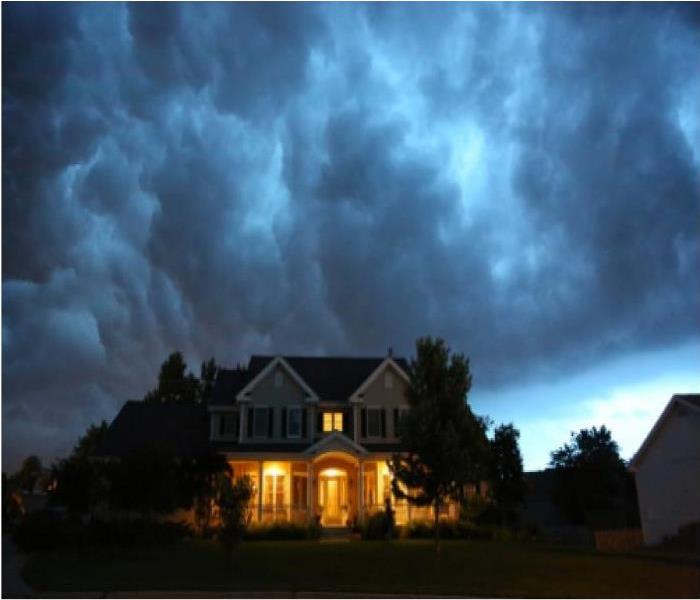 What if Riverside is hit with a random Thunder and Lightening Storm? Are your prepared? Do you know who to call should you experience a water leak?
What if Riverside is hit with a random Thunder and Lightening Storm? Are your prepared? Do you know who to call should you experience a water leak?
Is this common for Riverside County? Not really! Spectrum News 1 Reports:
What You Need To Know
- Summer thunderstorms are not common in Southern California
- Summer storms most often occur in the mountains
- Some rare, tropical-fueled storms bring significant rain
- Generally, summer thunderstorms don't generate much rainfall for SoCal
What if Riverside is hit with a random Thunder and Lightening Storm?
Prepare for Thunderstorms & Lightning
Know Your Risk
Know your area’s risk for thunderstorms. In most places they can occur year-round and at any hour. Sign up for your community’s warning system. The Emergency Alert System (EAS) provide emergency alerts.
Strengthen Your Home
Cut down or trim trees that may be in danger of falling on your home. Consider buying surge protectors, lightning rods or a lightning protection system to protect your home, appliances and electronic devices.
Make an Emergency Plan
Create an emergency plan so that you and your family know what to do, where to go and what you will need to protect yourselves from the effects of a thunderstorm. Identify sturdy buildings close to where you live, work, study and play.
Stay Safe During Thunderstorms & Lightning
If you are under a thunderstorm warning:
- When thunder roars, go indoors! Move from outdoors into a building or car with a roof.
- Pay attention to alerts and warnings.
- Avoid using electronic devices connected to an electrical outlet.
- Avoid running water.
- Turn Around. Don’t Drown! Do not drive through flooded roadways. Just six inches of fast-moving water can knock you down, and one foot of moving water can sweep your vehicle away.
Riverside County is prone to flash floods and high winds that could make driving challenging.
Stay Safe After Thunderstorms & Lightning
- Pay attention to authorities and weather forecasts for information on whether it is safe to go outside and instructions regarding potential flash flooding.
- Watch for fallen power lines and trees. Report them immediately.
Take an Active Role in Your Safety Go to Ready.gov and search for thunderstorm, lightning, or hail. Download the FEMA app to get more information about preparing for thunderstorm, lightning, or hail.
If you experience water damage from heavy down pour, or wind has damaged your roof. We are here to help! 24 hours a day 7 days a week.
SERVPRO of West Riverside City
951-351-8033
Can you Help Spread the Word to Clear Riverside Shelter?
8/23/2021 (Permalink)
 I'm a male, 51.10 lbs, white & gray Siberian Husky.
Estimated to be about 2 yrs, 2 mo old.
I have been at the shelter since 06/08/2! Can I be yours?
I'm a male, 51.10 lbs, white & gray Siberian Husky.
Estimated to be about 2 yrs, 2 mo old.
I have been at the shelter since 06/08/2! Can I be yours?
NBC Universal Local is teaming up with hundreds of shelters across the country to host Clear the Shelters
A nationwide pet adoption drive in August 2021 that helps find loving homes for animals in need. More than 551,000 pets have found their forever homes since 2015.
SERVPRO would like to share some of the available pups located at Riverside County Department of Animal Services
There are currently 126 dogs available for adoption. They come in all sizes, breeds and ages. Some have good training skills, others need a little more attention in training, any dog can be trained out of bad habits.
Our Rescue Cattle Dog
Take our Cattle dog Ellie, she had so much going against her when we found her at the shelter. She was just an 8 week old pup found roaming the streets. Due to her biting and hurting the other pups, she was placed in her own kennel and marked aggressive.
Being a herding dog, she was high energy and needed mental and physical stimulation. On top of that she barked…she barked a lot!
Nothing a dog trainer couldn't help with! This dog grew up to be sociable, obedient, loving pup. We were able to leave her at day camps and she got along great with other doggos. Addressing her barking was the most challenging. We attempted several methods to address the barking as suggested from her trainer, until we found the right remedy. As far as her high energy, walks and play time twice a day helped along with additional hikes & beach days addressed her energy level. She is the sweetest!
Visit our social media pages to take a look at some of the pups available at:
We will post different groups of dogs, by age, breed, and time at the shelter! Stop by the shelter and see them for yourself. It will be hard to make a choice, but we are confident you will find one that will perfectly fit your family.
How to Locate Hidden Water Leaks Before They Cause Severe Water Damage
8/18/2021 (Permalink)
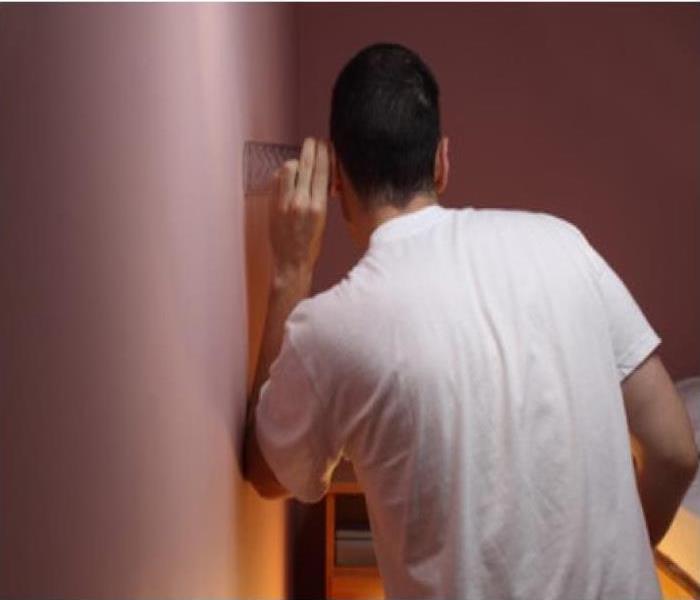 Vigilance is the best prevention for water damage. Knowing where to look and what to look for can detect many leaks before they get out of control
Vigilance is the best prevention for water damage. Knowing where to look and what to look for can detect many leaks before they get out of control
Finding water can sometimes be difficult. Water often travels the path of least resistance, which means water coming in from one area might enter your home in another area.
The water damage mitigation and restoration experts at SERVPRO of West Riverside City are the leading water damage restoration professionals in the Riverside area. A water leak that remains undetected and continues to leak for more than a short time can cause serious property damage. When homeowners or property managers suspect the presence of a water leak, there are several ways to detect the leak before it can do more damage.
SERVPRO of West Riverside City is sharing five tips on how to detect water leaks. Once the leaks are detected, homeowners can either fix the leak as a DIY project if the issue is easily resolved, or they can bring in a qualified, bonded and insured plumber to repair the leak. If the leak is inadequately repaired and not restored to professional standards, the problem could arise again in the future, causing another water damage disaster.
To repair the water-damaged areas of the home, the homeowner should secure the assistance of trained water damage restoration professionals who can safely, efficiently, and properly perform the restoration process. Water leaks that have persisted unnoticed for weeks, months, or even years can cause damage that compromises the structural integrity of the home. Rotted flooring, floor joists, or support beams require special expertise to repair or replace.
Long-term water leaks can also create serious health hazards. An undetected water leak can create a perfect environment for the growth of mold and mildew. In just a few days or weeks, a massive mold infestation can erupt, requiring extensive and expensive mold mitigation. A simple leak that could have been repaired for less than a $100 plumbing bill or for a few dollars in parts from the hardware store ends up costing thousands of dollars to remedy.
Here are the five important hidden water leak detection tips that can save the vigilant homeowner time, money, and stress.
Water leak detection tip #1: Monitor the monthly water bill.
Riverside Public Utilities is proud to serve a city of over 300,000 residents with high-quality water. Monitoring water usage does not require physically reading the meter by the road or sidewalk. Riverside residents can find all the information they need on their monthly water bill. Simply compare last month’s usage with the current month’s usage.
What constitutes a spike in water consumption?
- Standard bath: 27 gallons
- Ten-minute shower: 20 gallons
- Leaky faucet: five gallons per day or 150-300 gallons per month
- Broken or cracked pipe: As much as 500 gallons per hour
- Garden hose left running at an outside faucet (5/8”): 1,000 gallons per hour
An extra bath or two or a long, hot shower after a hard day at work will not show up as a spike in the water usage total or the amount of the water bill. Watering the garden or yard a few times a week or leaving the outside faucet on all night will significantly increase the water bill.
A higher water bill with no known increase in usage signals a problem. At this point, the homeowner may need to run a water usage check at the meter. Make sure all the water in the home is turned off. If the installed meter has a leak indicator, watch for movement. Otherwise, take a meter reading and check back in an hour or two.
Water leak detection tip #2: Conduct a faucet inspection.
A worn rubber washer under the faucet handle is responsible for a portion of the one trillion gallons of water wasted due to household water leaks. The fix for the leak is simple: replace the rubber washer.
Water leak detection tip #3. Perform the toilet tank dye test.
Hundreds of gallons of water can be wasted by a leaking toilet. Remove the tank lid and add some food coloring or a dye tab. If the water in the bowl is still clear after thirty minutes, the system is leak-free. Replacing the flapper takes care of most leaks.
Having to jiggle the handle to stop the toilet from running may indicate that the flush bar and chain are sticking. The remedy may be adjusting the nut that holds the mechanism in place. In other cases, the handle may be so corroded it must be replaced. Plumbing can be intimidating to some homeowners, so do not hesitate to call a qualified plumber to address these simple maintenance issues. The cost of the repairs is worth the peace of mind and the money saved by stopping the leak.
Water leak detection tip #4: Perform a visual inspection of ceilings and walls.
Stains and discoloration on walls and ceilings can go unnoticed for quite a while because the evidence and damage occur so gradually. An infrequent guest may walk into the home and instantly spot the stain, discoloration, bubbled paint or wallpaper, or warping. When dusting or vacuuming, take a few seconds to inspect the walls and ceilings.
Water leak detection tip #5: Be aware of underground water leaks.
Outdoor water leaks may require expensive repairs. A broken pipe can add hundreds of dollars to a monthly water bill. Soft spots, darkened areas, and the smell of water may indicate a major outdoor water leak. If an area of the lawn is moist after many days of dry weather, the cause may be a water leak. Look for unexplained puddles or water flows next to the driveway or along the curb. If an outdoor water leak is suspected, contact the local water company for assistance. If the leak is outside of their coverage area, they can recommend a plumber.
Vigilance is the best prevention for severe water damage. Knowing where to look and what to look for can detect many leaks before they get out of control and cause a water damage disaster and a potential mold infestation.
Trust the water damage restoration experts at SERVPRO of West Riverside City for water, fire, storm, and commercial damage restoration. For more information about water damage restoration in Riverside, contact the office by phone at (951) 351-8033 or by email at office@SERVPROwestriverside.com
We Are in the Midst of Wild Fire Season- Are You Ready?
8/16/2021 (Permalink)
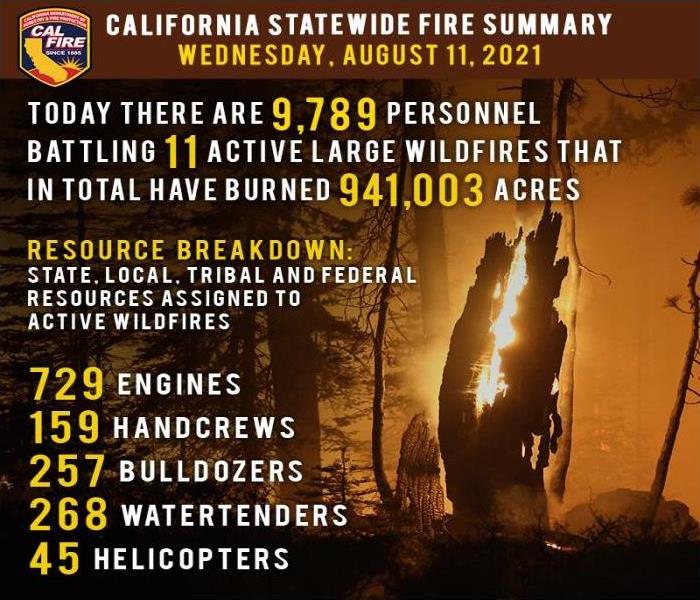 More than 9,700 personnel continue to fight 11 major wildfires/complexes in California.
More than 9,700 personnel continue to fight 11 major wildfires/complexes in California.
More than 9,700 personnel continue to fight 11 major wildfires/complexes in California.
We all have a responsibility to prevent wildfires through proper maintenance and use of campfires, vehicles, outdoor equipment and more.
Recognize Warnings and Alerts
- Have several ways to receive alerts. Download the FEMA app and receive real-time alerts from the National Weather Service for up to five locations nationwide. Sign up for community alerts in your area and be aware of the Emergency Alert System (EAS) and Wireless Emergency Alert (WEA)- which requires no-sign up.
- Sign up for email updates and follow the latest guidelines about coronavirus from the Centers for Disease Control and Prevention (CDC) and your local authorities to prevent the spread of COVID-19.
- Pay attention to air quality alerts.
Make an Emergency Plan
- Make sure everyone in your household knows and understands what to do if you need to quickly evacuate.
Review Important Documents
Strengthen your Home
- Use fire-resistant materials to build, renovate or make repairs.
- Find an outdoor water source with a hose that can reach any area of your property.
- Create a fire-resistant zone that is free of leaves, debris or flammable materials for at least 30 feet from your home.
- Designate a room that can be closed off from outside air. Close all doors and windows. Set up a portable air cleaner to keep indoor pollution levels low when smoky conditions exist.
Know your Evacuation Zone
- You may have to evacuate quickly due to a wildfire. Learn your evacuation routes, practice with household, pets, and identify where you will go.
- If you must evacuate to a public shelter, try to bring items that can help protect you and others in the shelter from COVID-19, such as hand sanitizer, cleaning materials, and two masks per person. Children under 2 years old and people who have trouble breathing should not wear masks.
- Follow the instructions from local authorities. They will provide the latest recommendations based on the threat to your community and appropriate safety measures.
Gather Supplies
- Have enough supplies for your household, include medication, disinfectant supplies, masks, pet supplies in your go bag or car trunk. Being prepared allows you to address smaller medical issues at home, alleviating the burden on urgent care centers and hospitals.
- Being prepared allows you to avoid unnecessary excursions and to address minor medical issues at home, alleviating the burden on urgent care centers and hospitals.
- Remember that not everyone can afford to respond by stocking up on necessities. For those who can afford it, making essential purchases and slowly building up supplies in advance will allow for longer time periods between shopping trips. This helps to protect those who are unable to procure essentials in advance of the pandemic and must shop more frequently. In addition, consider avoiding WIC-labeled products so that those who rely on these products can access them.
- If you already have one at home, set aside a respirator, like an N95 respirator, to keep smoke particles out of the air you breathe. Respirators are not meant to fit children. Due to COVID-19, it may be difficult to find respirators. While cloth masks, surgical masks, and dust masks provide protection from exposure to COVID-19, they will not protect you from smoke inhalation. To ensure that healthcare workers have access to N95 respirators, it is best to limit your exposure to smoke rather than buy respirators.
- Be cautious when carrying flammable or combustible household products that can cause fires or explosions if handled wrong, such as aerosols, cooking oils, rubbing alcohol, and hand sanitizer.
- If you already have an N95 mask, use this to protect yourself from smoke inhalation. N95 masks also protect against the spread of COVID-19, however they should be reserved for healthcare workers. If are in a public cleaner air space or shelter, use a mask to help slow the spread of COVID-19.
- Keep your cell phone charged when wildfires could be in your area. Purchase backup charging devices to power electronics.
Know What to Expect at Your Child’s K- 12 School or Child Care Program
8/11/2021 (Permalink)
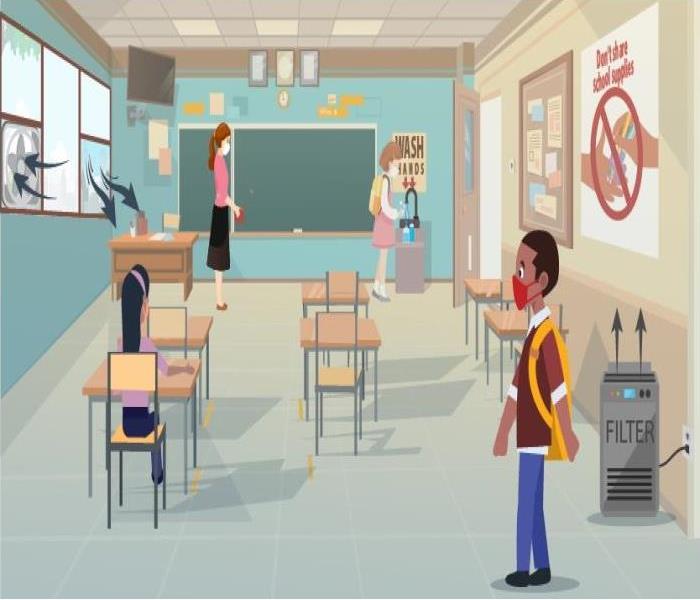 Improving ventilation can reduce the number of virus particles in the air. SERVPRO can help with disinfecting and cleaning your school or classrooms!
Improving ventilation can reduce the number of virus particles in the air. SERVPRO can help with disinfecting and cleaning your school or classrooms!
COVID-19 outbreaks can happen in schools and child care programs, but when multiple prevention strategies are used, most children can safely continue to attend these programs in person. Article from Ready.gov.
Things Your Child’s School or Child Care Program May Consider
When making decisions about how to keep students and staff safe, school and child care program administrators should consider:
How many cases of COVID-19 are in your community.The number of people vaccinated in your community.Ages of children in the school or child care program.As the situation in your community changes, school and child care program administrators may change policies.
Prevention Strategies
Your child’s school or child care program may layer prevention measures in the classroom or during other activities, meaning they may use many prevention measures at the same time. Using layered prevention measures is important when some prevention measures cannot be used. For example, when people are not able to physically distance from each other, using other prevention measures can still help stop the spread of COVID-19.
COVID-19 Vaccines
Getting vaccinated is the best way to prevent COVID-19. When teachers, staff, and students 12 years and older are fully vaccinated, COVID-19 outbreaks in schools or child care programs are less likely to occur.
Everyone 12 years and older is now eligible for COVID-19 vaccination.
Your child’s school or child care program may provide information about how to get vaccinated to families. They may also offer flexible options for excused absences to allow students time to get vaccinated and stay home if they have side effects after vaccinations.
Masks
When teachers, staff, and children who are not fully vaccinated wear a mask, they protect others as well as themselves.
Given new evidence on the B.1.617.2 (Delta) variant, CDC recommends universal indoor masking for all teachers, staff, students, and visitors to K-12 schools, regardless of vaccination status.Mask use is recommended for people who are not fully vaccinated, including children and staff.Children under 2 years of age should not wear a mask.School and child care program administrators may choose to make mask use universally required in your child’s school or child care program if
Children are younger than 12 and are not yet eligible for vaccination.The number of COVID-19 cases is increasing or high in the school or your community.The number of cases caused by a variant of concern is increasing or high in the school or your community.The school or child care program is not able to monitor the vaccine status of children, teachers, or staff.The school or child care program cannot enforce mask policies that are not universal.The number of students or people in your community who are vaccinated is low.Schools and child care programs can make exceptions for children who cannot wear a mask or cannot safely wear a mask.
Masks are required on all public transportation, including school buses. Regardless of the mask policy at school, passengers and drivers must wear a mask on school buses operated by public or private school systems. Learn more about face masks on public transportation.
Your child’s school or child care program will have a policy about physical distancing.
Young children need to be close to caregivers during diapering, feeding, and comforting. Your child’s program may use cohorting. Cohorting means keeping children together in a small group and having each group stay together throughout an entire day. This is used to limit the number of children and staff who come in contact with each other. Your child’s program may also maximize time outdoors, stagger drop-off and pick-up times, and maintain 6 feet between cohorts.
Ventilation
Improving ventilation can reduce the number of virus particles in the air.
Your child’s school or child care program may:
- Open multiple doors and windows.
- Use child-safe fans to increase the effectiveness of open windows.
- Make changes to the heating, ventilation, or air conditioning (HVAC) or air filtration systems.
- Open or crack windows in buses and other forms of transportation, if doing so does not pose a safety risk.
Handwashing
Teachers and staff can:
- Teach students to wash their hands with soap and water for at least 20 seconds.
- Remind students to wash hands frequently and help young children with handwashing.
- Provide hand sanitizer with at least 60% alcohol if handwashing is not possible. Young children should have adult supervision when using hand sanitizer.
- Set up handwashing or hand sanitizing stations at facility entrances.
- Wash their hands after holding, washing, or feeding young children.
- Wash their hands before and after changing a child’s diaper or handling infant bottles.
Keep Your Child Home if They Are Sick
If your child is sick or has symptoms of COVID-19, they should stay home. Call your child’s healthcare provider for testing and care. Staying home when sick with COVID-19 keeps COVID-19 infections out of schools and child care programs and prevents spread to others.
Food Service and Meals
Your child’s school or child care program may adjust where and when children eat meals. This may include:
- Physical distancing as much as possible when moving through the food service line and while eating (especially indoors).
- Using additional spaces outside of the cafeteria for mealtime seating, such as the gymnasium or outdoor areas.
- Reminding children to wash hands, before and after eating.
- Improving ventilation in spaces where children eat.
Physical Education and Physically Active Play
Physical play is important for children. In general, people do not need to wear masks when outdoors. In areas with high numbers of COVID-19 cases, people should consider wearing a mask in crowded outdoor settings and for activities with close contact with others who are not fully vaccinated. When physical education and play are held indoors, children and staff should wear masks. Children and staff should physically distance when possible.
Sports and Other Activities
Some sports may make players, coaches, and trainers more likely to get and spread COVID-19 because of physical contact and increased breathing. Other extracurricular activities, such as band, choir, theater, and school clubs that meet indoors, may also make students and staff more likely to get or spread COVID-19.
- Students should not participate in these activities when they have symptoms of COVID-19 and should be tested.
- Students who participate in indoor sports and other higher-risk activities should continue to wear masks and physically distance as much as possible.
SERVPRO of West Riverside City hopes for a fantastic school year!
If you are a school official and would like information on how SERVPRO can help with disinfecting and cleaning your school or classrooms, give us a call 951-351-8033.
We can help if a student develops symptoms and if a positive COVID test result occurs with one of your students.
Experience a Flood in Your Riverside Home? Here are 3 Important Tips
8/9/2021 (Permalink)
There's nothing worse than the sight of a broken pipe, flooded room, or soaking wet possessions.
If your home in Riverside has suffered from flooding, it can feel overwhelming, but with the right ideas in mind, your home is well on its way to being good as new.
- Don't Touch Anything
Even if the damage in your home looks minor, hidden electrical wires and waterlogged drywall cause big safety issues. It's best to leave the dangerous work to the professionals. Many people don't realize how dangerous water in homes can be. Think of water damage in the same light you view fire damage: Unpredictable and risky. It may be tempting to wade in and recover a precious item but don't.
- Schedule Repairs
Before the cleanup can get started, the source of the water must be found and stopped. If you suspect a broken pipe, call a plumber to get it fixed.
- Call a Professional
After the leak has been repaired, it's time to call in the experts in water damage cleanup to restore your home to normal. With the right equipment, the pros restore homes to a pre-flooded state within a few days. Among several other processes, one of the most important steps that an expert takes is the removal of water from the walls and ceilings. Waterlogged drywall is a serious issue that can lead to collapse, but professionals will save as much as possible by drying the area. Most also employ industrial fans and heaters to dehumidify the area. Along with this, they also test for hidden moisture behind walls. Both of these steps help prevent the growth of mold. A specialist also comes equipped to dry your furniture and other personal items.
Whether it's a broken pipe or another source of water damage, with the right knowledge, you can quickly return your home to normal.
Contact SERVPRO of West Riverside City, we can help. We are located in Riverside, CA and we can inspect your damage free of charge!
Call us at 951-351-8033
Visit our Website for more information and tips to guide your through the process!
For more information on flood damage visit IICRC
Riverside Grow Houses, SERVPRO Offers Advice and Information
8/2/2021 (Permalink)
What to Do if the House You Rent or Purchase Was a Marijuana Grow House in Riverside?
While it is true that if a home was previously used as a meth lab, potential buyers must be given that information unless the home has been successfully remediated; In California selling a property that's been used for the cultivation, manufacturing of, or distribution of marijuana also requires disclosure, if the real estate agent or broker is aware of the activity. Because of both potential health and structure issues from use as a grow house, it is vital to find out and have the home professionally cleaned.
Riverside does have laws regarding grow houses:
According to Riverside Municipal Code section 19.342.030 (B), “no individual or entity may plant, cultivate, harvest, dry, or process marijuana plants inside a private residence, or inside an accessory structure to a private residence located upon the grounds of a private residence, in excess of the limitations imposed by California Health and Safety Code section 11362.2.” And 11362.2 (a)(3) of the Health & Safety code states “not more than six living plants may be planted, cultivated, harvested, dried, or processed within a single private residence, or upon the grounds of that private residence, at one time.”
Ward 4 Councilman Chuck Conder stated “the proliferation of illegal grow facilities in our neighborhoods should not be a surprise to anyone. These dangerous activities have been seen in every state that has legalized the recreational use of marijuana. The illegal and shoddy rewiring of electrical connections needed to provide the massive power requirements to serve these facilities is a fire hazard that threatens surrounding homes. Add to that the volatile chemicals used in the illegal grow houses and you have an explosive situation that could endanger an entire neighborhood.”
How is a Home Used as a Grow House in Riverside?
In a standard grow house operation, each room in the home contains multiple marijuana plants, and usually, no one resides on the property. The windows are often foiled for increase light reflection or blacked out to stop anyone from peeping in and seeing the plants. Little regard is given to the potential for staining floors from the pots or tubs containing the plants.
SERVPRO Says You Should Care if Your Home Was Used as a Grow House!
Non-disclosure for renters or buyers for a home's previous history as a grow house can be concerning on several levels. First and foremost, unsafe modifications may have occurred to the property such as load-bearing walls removed to expand the size of a grow room. The electrical wiring may have been re-run to hook up grow lights and bypass safety regulations to the point of leaving live wires on insulation in the attic which is both an electrocution and fire hazard. An electrical source may have been Gerry-rigged from a neighboring property placing unintended stress on the electrical panel, circuit breakers, or fuses.
And there is the water. Marijuana plants require copious amounts of water and humidity. In hydroponic grow operations, the plants are grown directly in water with little to no soil. For ease of watering multiple plant stations at once, irrigation systems are created indoors with little thought as to the damage caused to floor, walls, ceilings from leaks and spillage. The high humidity creates a perfect environment for mold colonies to flourish and it spreads quickly both inside and outside the home. Mold colonies have been known to cover walls and ceilings with massive colonies completely.
Landlords should have homes professionally mitigated if a grow operation is discovered after a tenant leaves and prospective homeowners should specifically ask inspectors to look for signs the home was used as a grow house before purchasing. A lower asking price for the home may sometimes be negotiated to account for the professional cleaning needed before the property is at a standard for healthy habitation. A biohazardous condition requires certified IICRC technicians like those employed by SERVPRO for safe and secure removal of all mold residues.
If a Landlord Suspects a Tenant is Running a Grow House, What are the Signs?
It is a good idea to inspect your rental properties periodically before extreme structural modifications have a chance to happen. Landlords should use some of the same indications that law enforcement looks for when identifying a grow house such as the refusal of a tenant to let the landlord into the property with excuses such as they are traveling or otherwise away. Condensation collected on the windows is a tell-tale sign of highly humid conditions inside the home. Moreover, of course, the strong odor of marijuana is often a dead giveaway. During mold remediation large LGR low-grain refrigerant dehumidifiers are set in strategic location by the AMRT applied microbial remediation technicians from SERVPRO to restore a normal indoor RH relative humidity.
Why Landlords or Sellers Should Never Self-Clean a Grow House Property
Due to the water damage and probability of mold within the structure, cleaning a grow house is rated as an intense Category Three, Class Four biohazard job and is not a cleanup job for your usual make-ready cleaning crew. Often mold remediation teams must don PPE personal protective equipment when removing mold colonies and spores from a grow house.
The constantly humid conditions can result in structural damage such as buckled sheetrock, crumbling carpet padding from repeated saturation and not being thoroughly dried and staining can occur throughout the home. Every part of the house needs to be inspected for the possibility of mold colonies, including wall cavities, subflooring and even brickwork and eves on the exterior that can harbor mold coming from inside. The ductwork in the home may have been re-routed, cut into and may contain the strong odor of marijuana and mold spores.
The level of cleaning required to return a former grow house to sanitary standards that are safe for habitation needs professional-level remediation techniques. This process can include containment of rooms as they are mitigated for mold and water damage, the use of air scrubbers with HEPA filters to capture mold spores smaller than the human eye can see and disinfection of all surfaces with professional quality solutions designed specifically for biohazard environments. These cleaning, sanitizing, and equipment are in the SERVPRO aresenal. Water can leave a foul odor when it penetrates porous objects in a home, combined with the strong smell of marijuana; the scent can be overwhelming and very difficult to remove. Rather than masking the odor, it requires neutralization at the molecular level.
There are machines such as the hydroxyl generators that neutralize bacteria and odors using the same methods as the sun for breaking down these offenders by emitting UV rays. Ozone machines combine the O3 oxygen molecules with odors and effectively neutralize them. Another technique that is sometimes employed is ULV (ultra-low-volume) fogging. A SERVPRO technician delivers a heated disinfectant solution as a wet penetrating fog that permeates porous items in the home and removes odors while it also disinfects.
While walls and baseboards may require thorough cleaning and sometimes replacement, flooring suffers extreme levels of damage in a grow house. Carpet and padding is often a loss in a former grow house due to deterioration from exposure to water and mold along with contaminated marijuana plant parts. On a case by case basis, hardwood flooring that has buckled or warped from constant exposure to high levels of moisture can be dried using specialized techniques and then sanded and refinished. Composite or other types of wood flooring usually cannot be successfully mitigated and are a loss if saturated with enough water and humidity over time. The demolition technicians from SERVPRO can remove all contaminated materials according to OSHA and local codes.
If you have a property you are renting or want to purchase, and you suspect it was used as a grow house, you should get it professionally cleaned by a company that is certified in the handling biohazards. Remember, at this time potential landlords or sellers in our state have no legal obligation to let you know if the property was used for growing marijuana. A clean bill of health after testing by an Industrial Hygienist following mold remediation provides peace of mind that the structure is once again safe for habitation.
We suggest that you contact SERVPRO of West Riverside City for an inspection and assessment of a grow house in your area. We can remediate and prepare your property for a third party inspection. Contact us at (951) 351-8033.
3 Preferred Vendor Program Advantages
7/28/2021 (Permalink)
Advantages Of Becoming A Preferred Vendor
Many advantages accrue to franchise owners and employees who participate in the SERVPRO Preferred Vendor Program. Program participants are more likely to obtain approval for jobs from leading insurance agencies. Whether you are an insurance agent or prospective investor considering opening a franchise in Riverside, here are three advantages of partnering with or becoming a Preferred Vendor.
1. A Large Franchise Network
An extensive network consisting of more than 1,700 franchise locations across North America provides Preferred Vendor Program participants with the support necessary to deliver the highest quality of cleanup and restoration services for any commercial or residential property. When it comes to calling on specialists or summoning reinforcements for large loss events, this network enables the trusted franchises to provide a consistent level of service.
2. Established Insurer Relationships
An insurance agent can count on a straightforward dealings with a Preferred Vendor. Property owners can also rest assured that more of the total estimate calculated by this restoration franchise and provided to insurers is likely to be covered. An electronic claims center makes it easy for representatives to access information on new, in-progress and past jobs and compare costs to national industry averages.
3. Marketing Resource Access
A SERVPRO franchise that becomes a Preferred Vendor gains access to a full suite of marketing and promotional materials. Furthermore, the Institute for Inspection, Cleaning and Restoration Certification program, which is one of the most trusted bodies in the restoration industry, also has a longstanding relationship with this national company and partnered franchises.
When a restoration company in Riverside, CA is accepted into the Preferred Vendor Network, the owner and employees stand to benefit from a connection to other franchises across the continent. On the other hand, an insurance agent can count on participants in this program to provide the highest level of service for commercial and residential restoration projects.
3 Steps to Prevent a Lint Fire in your Riverside Home
7/26/2021 (Permalink)
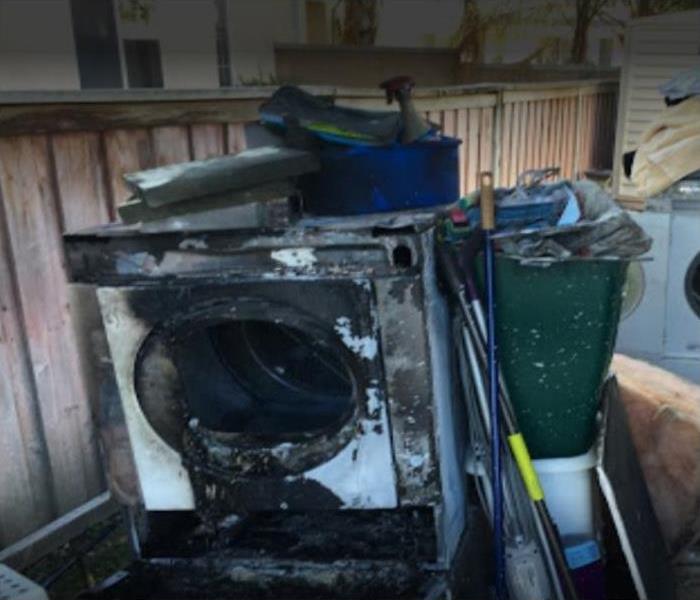 Lint was the cause of this fire. SERVPRO of West Riverside City was there to take care of the smoke, soot, and fire damage!
Lint was the cause of this fire. SERVPRO of West Riverside City was there to take care of the smoke, soot, and fire damage!
Three Steps To Prevent A Dryer Fire
Many homeowners in Riverside, are unaware that lint accumulates poses a dangerous fire hazard. Each time the dryer is used, it releases clothes particles that accumulate inside and around the dryer. When its accumulation is neglected, all it takes is a spark to begin a lint fire. Lint is highly combustible and is made up of:
- Cotton
- Wool
- Synthetic fibers from dryer sheets
Here are three steps you can take to prevent a dryer fire.
- Clean the Dryer Vent and Ensure Proper Ventilation
The hose connection on your dryer leads most of the lint through a pipe to the outside air. When the vent is covered by a mesh screen, the lint will accumulate, forming a combustible blockage. To ensure proper ventilation, make sure the damper is not covered by a mesh screen and that it is opening properly.
- Check Behind the Dryer for Lint
It is easy to miss the lint behind the dryer because of how well hidden it can be. Often, this is a sign that the hose and vent are clogged. Using a vacuum to clean lint behind the dryer could prevent a lint fire. When this begins to happen, it is recommended to hire a professional service to clean your dryer vents.
- Clean the Lint Filter Housing
Along with cleaning the lint filter after each use, clean its housing regularly to prevent lint inside of the dryer. One of the most common causes of dryer fires is lint trapped in the filter housing and the hidden corners of the dryer. Use a small brush and a vacuum cleaner to remove the hidden lint.
You can prevent a house fire by taking precautionary measures with flammable substances. Cleaning your dryer and having it serviced by a professional can keep your house safe from fire damage. If you have experienced a lint fire in your home, call a professional fire damage restoration service to clean and restore your property.
Contact SERVPRO of West Riverside City, we are experienced in these types of fires and can help!
951-351-8033
Follow us on Social Media for tips and updates!
SERVPRO of West Riverside Facebook
SERVPRO of West Riverside Instagram
SERVPRO of West Riverside twitter
Our Water Damage Experts Can Save Delicate Items In Riverside Home
7/23/2021 (Permalink)
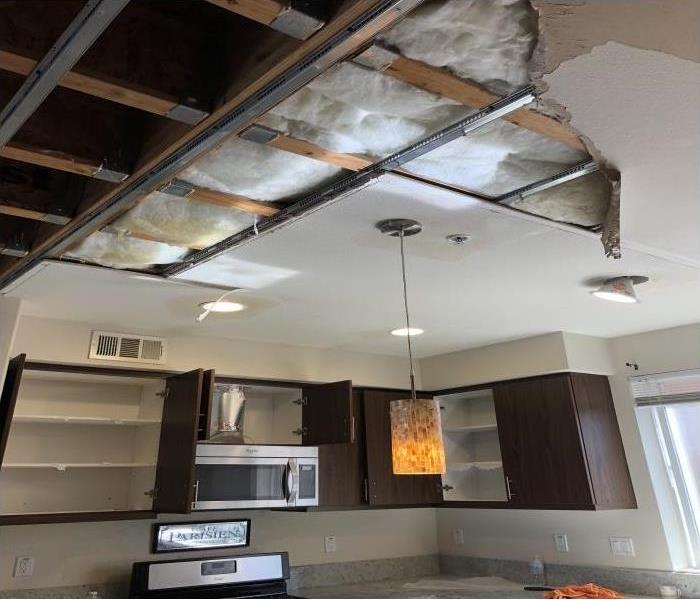 Water damage from sprinkler system wet the ceiling and caused the insulation to soak up water. Removal was done by SERVPRO of West Riverside City!
Water damage from sprinkler system wet the ceiling and caused the insulation to soak up water. Removal was done by SERVPRO of West Riverside City!
Saving Delicate Items Affected by Water Damage Incidents in Riverside
When there is a water spill, some items in the house are more prone to damage because of their structure and material composition. Some actions can help save the items if taken promptly after discovering water damage.
How Water Damages Carpets
If there is carpet in the area that was hit by water damage in your Riverside home, you might end up disposing of it if you do not take any action. Common problems include delaminating, whereby the backing separates from the rest of the material due to water action. Stains can also develop, especially if there are other items such as furniture resting on carpeted areas.
Saving Wet Carpets
Saving the carpet from water damage takes several actions, including removing items that can cause stains immediately after the spill. Our SERVPRO technicians expedite water extraction to reduce the exposure time using sophisticated equipment such as truck-mounted extractors and other high-speed pumps, which minimizes chances of delaminating. Depending on the amount of water spilled, we can do in-place drying. Floating the carpet helps ensure even drying on the bottom surface of the carpet, reducing the chances of mold developing.
Hardwood floor
Water spills on hardwood floors might necessitate replacement of the entire floor, which is quite costly. When wood absorbs significant amounts of water, it swells. Because they are tightly packed, the floorboards buckle at the joints to accommodate the swelling. Apart from reducing the time wood has to absorb water through fast extraction, our SERVPRO technicians also use specialized moisture control methods such as drying, setting up a drying chamber over the floor surface.
Wet Insulation
Wall materials such as drywall and insulation lose structural integrity when they absorb water. Drywall crumbles when wet, while insulation loses R-value. Although it is rarely possible to save these materials after they are wet, stopping the damage from spreading further from affected areas through wicking is necessary. Our water restoration crews from SERVPRO make flood cuts removing all the wet wall materials.
Quick action can help reduce losses incurred from water loss incidents.
Call SERVPRO of West Riverside at (951) 351-8033 to help save some items affected by the incident, “Like it never even happened.”
How To Handle a Partial Loss Fire in Riverside
7/21/2021 (Permalink)
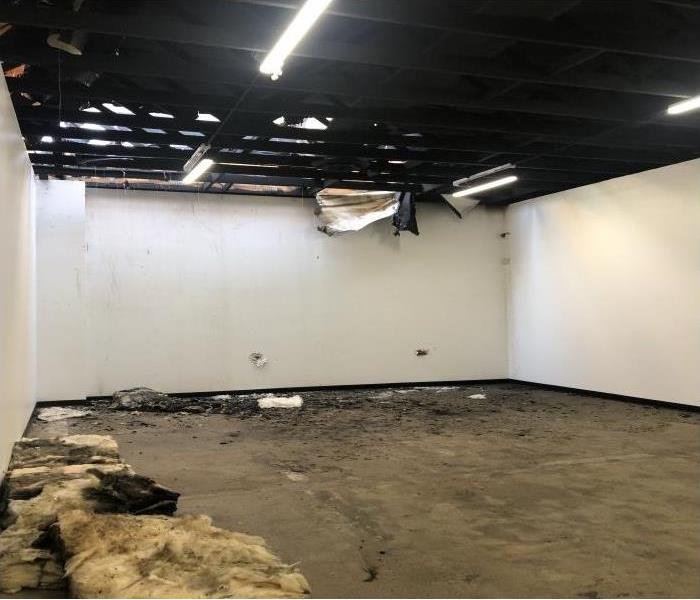 A fire caused smoke, soot and water damage to this commercial building in Jurupa. SERVPRO West Riverside made it, "Like it never even happened."
A fire caused smoke, soot and water damage to this commercial building in Jurupa. SERVPRO West Riverside made it, "Like it never even happened."
A "partial loss" fire is one that damages your commercial property, but doesn't completely destroy it. Before you file a claim, contact a fire restoration service to make a complete assessment of the property. Professionals may uncover damage that you might not notice at first glance. They can also give you an appraisal of what renovations need to take place to get your building back to normal. This information is helpful to your insurance adjuster when they visit your establishment.
What Problems Could Affect Your Insurance Claim?
It's critical to find a reputable fire crew in Riverside to help you through the process, otherwise, it could affect the amount of your settlement. Things to keep in mind include:
Improper cleaning methods - If the cleaning team doesn't use proper cleaning techniques in your fire restoration, your insurance may not cover additional cleaning in the future. An experienced crew removes smoke damage from the building, in addition to fire damaged materials.Hidden damages - Fire loss includes more than just the damage caused by the fire. A trained professional knows where to look for hidden problems, including mold and ash. They will also check the air quality in the facility.Insufficient repairs - An experienced technician understands that the repairs must return your building to a consistent appearance. This means that even if some materials weren't damaged if they don't fit the look of the new materials they must be replaced.How Can You Make the Process Go Smoother?
Before your insurance adjuster arrives, make a list of every item that was destroyed in the fire or damaged by smoke or water. Take pictures of key items that must be replaced. Get quotes from construction crews with itemized details as well. All of these tips can speed up the process so that your claim is filed quicker.
Fire loss doesn't have to destroy your entire building to be devastating. Finding the right renovation service helps the process go much smoother.
How to Recover from Water Damage to Your Riverside Property After a Fire
7/19/2021 (Permalink)
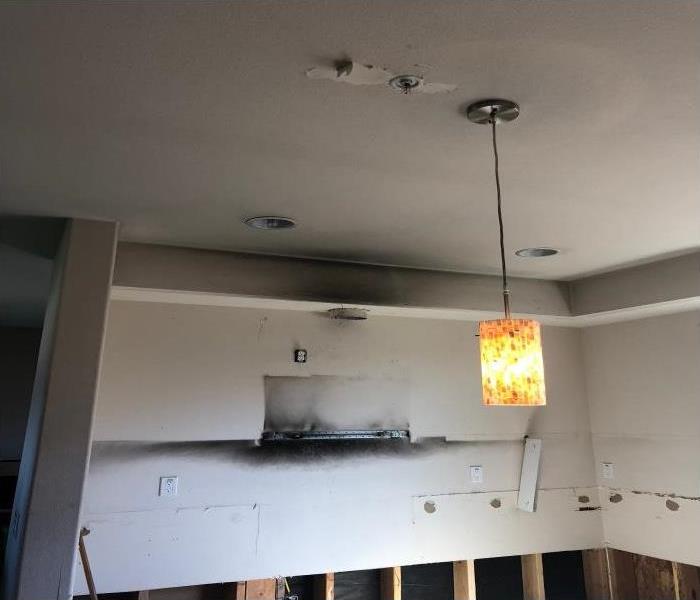 Fire and water damage due to a microwave that effected 3 floors of this apartment. SERVPRO was able to mitigate all damage.
Fire and water damage due to a microwave that effected 3 floors of this apartment. SERVPRO was able to mitigate all damage.
Water Removal After Fire Suppression In Your Riverside Home
Disasters occurring in your Riverside home often do not exclusively fall into one category of damage or another. Recovering from an instance like a fire in your house requires specialists in the effects of the fire, but might also require those with certifications to contend with water damages and drying efforts as well.
While the fire damages to your Riverside home might be more than enough to get overwhelmed as a homeowner when you compound that with the need for water removal services, you need trusted technicians that can arrive quickly like our SERVPRO team. Our rapid response unit is available 24/7 to begin mitigation practices and early stages of restoration work to keep the situation from getting worse.
When it comes to contending with water damages that require extraction, time is of the essence. Our SERVPRO technicians have the tools and equipment to rapidly pull high volumes of water from the affected areas. Extraction is not the only point of concern about the need for water removal, as this damage can spread and saturate quickly through materials in the affected region of the property.
Oversaturation is a common occurrence in these situations, causing construction materials and surfaces to bloat and distort as the abundance of water warps their composition. If managed at the appropriate times, our professionals can work with air movers and dehumidifiers to pull the moisture from the area entirely, pulling the relative humidity in your home back to acceptable parameters to avoid effects like mold growth.
Contact SERVPRO of West Riverside City, we can answer your questions and we provide free estimates. Call us 951-351-8033
Or you may visit our website with all our contact information.
SERVPRO of West Riverside Website
Minor is Major When it Comes to Water Damage in Your Riverside Home
7/14/2021 (Permalink)
 No job is too insignificant for SERVPRO of West Riverside Cit. If you suspect a tiny leak has become a major problem, give us a call at (951) 351-8033
No job is too insignificant for SERVPRO of West Riverside Cit. If you suspect a tiny leak has become a major problem, give us a call at (951) 351-8033
Prevention and Maintenance Help Impede Significant Damage Due to Leaks.
Homeowners frequently make the mistake of thinking slight leaks cause no problems for their homes. Allowing a slow leak to continue depositing water inside a wall, on the floor, or under a cabinet are examples of things that cause significant damage to the structure of a building without the owner noticing. Eventually, you need our help to restore the harm and prevent collateral damage.
A small but steady leak in the waste pipe connecting your kitchen sink to the main drain below contributes to a gradual spread of water damage in your Riverside home. Because the pipe damaged by the leak runs behind some cabinets and then down the basement stairs, you rarely take any note of it. Your neglect now results in a massive bulging of the wall near your water heater and furnace, and dirty water has begun to puddle on the floor and run in a ragged stream to a floor drain. There is a musty smell with a note of decaying food.
One of our SERVPRO water damage teams arrives and assesses the area. We identify problems and devise a plan. Water is extracted from inside the wall with our specialized equipment. If we find mold, we employ EPA approved procedures to contain the area, remove the moldy material, and then sanitize. Our team coordinates with your plumber to replace the drain pipe, essential to make sure the mold remediation is successful.
We then take moisture measurements and use our high-efficiency air movers and dehumidifiers to dry out the lower level area. SERVPRO’s mission is to restore, but because of the mold growth, we likely replace a portion of the wallboard that was soaked by the leaking over time. Porous materials are difficult to sanitize, and drywall is relatively inexpensive to install new.
The cabinets in the kitchen also need inspection, and our team tests for moisture as the leaks may have extended closer to the sink. We take off the kick plates to scan for current or old water damage. If standing water reveals itself, SERVPRO team members extract it and aim air movers into the recesses and position a dehumidifier nearby. Again we evaluate for mold involvement and remediate if necessary.
Although this type of water incursion is hardly dramatic, it is prevalent and causes serious water damage. Our team recommends you remain vigilant for this kind of leaking as it destroys structure from the inside out.
No job is too insignificant for SERVPRO of West Riverside Cit. If you suspect that a tiny leak has become a major problem, give us a call at (951) 351-8033 to schedule a consultation.
How To Deodorize your Smelly Riverside Washing Machine
7/12/2021 (Permalink)
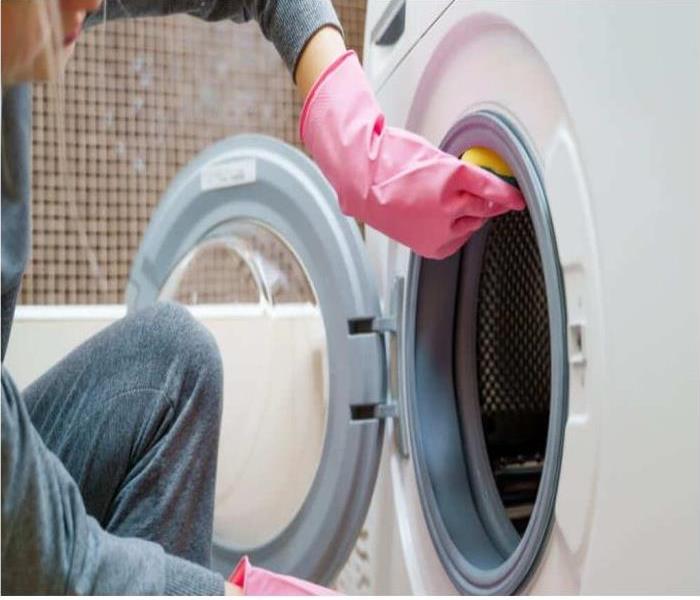 To keep your machine smelling fresh, clean the washer every 30 days or so!
To keep your machine smelling fresh, clean the washer every 30 days or so!
Have you noticed a musty odor coming from your washing machine?
Don’t worry, you’re not the first person in Riverside, to have a smelly washer. Today’s machines are more efficient and eco-friendlier than ever before, but they’re also more susceptible to mildew and mold growth. Luckily, with just a little maintenance, you can easily remove smells and keep them from returning.
What’s Causing It
High-efficiency washers use much less water than their predecessors. This makes it harder for the machine to completely dissolve the dust, hair, and body oils from your dirty laundry, and residue can build up over time. In addition, the interior of your machine tends to be warm and humid most of the time, making your washer the ideal environment for rapid mold growth. The door gaskets on front-loading machines can trap dirt and moisture and are also excellent places for mold and bacteria to flourish.
How To Get Rid of It
Follow these steps to eliminate mold and banish the existing funk from your washing machine:
Clean around the rims of the dispensers using a solution of one-fourth cup of vinegar mixed with two cups of hot water. You may need to use a cotton swab or small toothbrush to get into small areas. If you have a front-loading machine, also clean the gasket around the door.
Sprinkle a cup of baking soda into the drum and add two cups of plain white vinegar to the detergent dispenser. Don’t add any detergent or clothes. Run a full cycle using hot water.
After the cycle is complete, wipe away any bits of leftover “gunk” that remain on the walls of the drum.
If the mold smell remains, repeat steps two and three.
To keep your machine smelling fresh, be sure to use detergent labeled safe for high-efficiency machines and keep the lid open between washes to allow the drum to dry out. Clean the washer every 30 days or so, using the procedure above or using a commercial washing machine cleaner. Prevention is key to avoiding a stinky, moldy washer.
Avoiding Big Damage to the Walls in Your Riverside Property
7/7/2021 (Permalink)
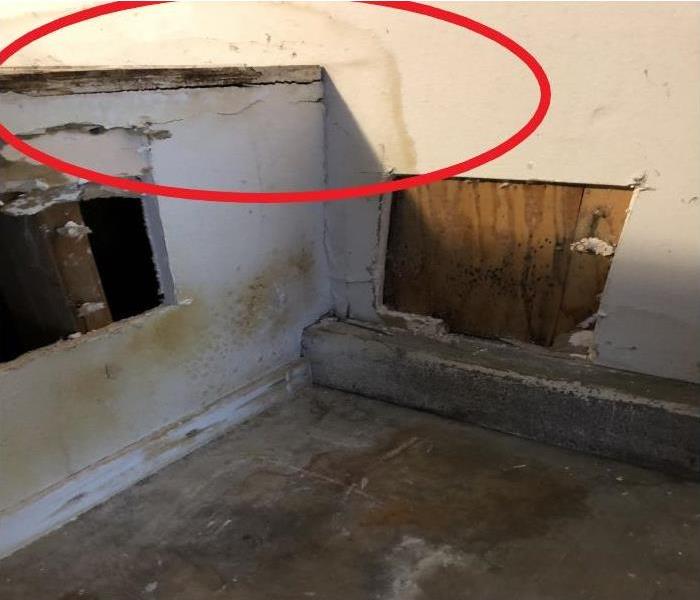 Drywall exposed to standing water can wick up the wall at a rate of one inch per hour for the first 24 hours!
Drywall exposed to standing water can wick up the wall at a rate of one inch per hour for the first 24 hours!
SERVPRO's Quick Response to Water Damage in Your Home can Often PREVENT Any Secondary Damage.
Did you know that drywall exposed to standing water can wick up the wall at a rate of one inch per hour for the first 24 hours? Extracting standing water immediately stops the wicking and can reduce your drying time by more than a day.
If water damage of any kind has occurred in your home, it is important to take action as soon as possible. When it comes to plaster and drywall becoming wet, some problems arise. Mold growth can begin, framing wood splits and swells, and the structural integrity of your home weakens. Even if you see just minor bubbling, spots, or peeling, you want to move fast, so the problem does not become much larger.
When you need water damage restoration services in your Riverside home, no wall is safe from damages that can occur if they got wet during the disaster. Drywall is at risk to weaken and even collapse. It also many times needs to be replaced, as it is not always repairable. The structure around drywall can also be affected in cases where the damage is severe.
SERVPRO, a professional water removal and restoration company, is always standing by to help when you need. In a situation that involves water, we understand that time is of the essence and arrive at your home quickly so we can assess the damages and begin cleanup right away.
Water ruins plaster as well. It is not resistant to dampness and therefore is easily affected. It is fortunately easy to remove and replace when needed. In areas of your home such as the bathroom, tile walls should be used whenever possible.
Immediate Water Removal Can Save Drywall in Your Widefield Home
With the fast spread of water loss incidents that occur in your Riverside home, it can be challenging to understand the full effects to your construction materials and exposed areas of the property. With advanced detection, extraction, and drying equipment available to our technicians, we have a team that can respond quickly to water emergencies and makes a difference.
To protect exposed materials and structural elements in your home in an emergency like this, you need water removal to begin immediately. Our 24/7 response to water loss incidents can provide the fast response you need to protect your home and your investment in the property. Drywall is often one of the most susceptible materials to both standing water and moisture damages, making it essential to get drying efforts started as promptly as possible to limit the necessary tear out to restore these areas of your home.
From the time that our professionals first arrive at your property, we address the standing water throughout the affected areas of the house. With effective equipment like our extractor trucks, trash pumps, portable submersible pumps, and even wet-vacs with extraction wands, we have a wide array of equipment to make short work of the pooling water. Once the excess water has gotten removed, we can work to identify the full spread of the damage and how it has affected elements like the drywall.
Wicking is a common effect with drywall in which the material begins to absorb moisture and allows it to spread much higher than its direct exposure line with the pooling water. To address this concern our SERVPRO professionals can mark off the moisture line at the height where the drywall returns to an unaffected state and cut off the damaged material beneath this point. Not only does this provide effective access for drying of wall cavities, but it makes reconstruction efforts to come more efficient and cost-effective than removing entire panels.
Protecting your drywall requires a fast response from skilled professionals like our SERVPRO of West Riverside City team. If you want to make water damage “Like it never even happened,” give our rapid response team a call today at (951) 351-8033.
Summer Fun Concerts in the Park Return to Riverside Starting July 7th!
7/5/2021 (Permalink)
 This FREE family-oriented event provides a fun and exciting experience for all ages to enjoy and includes live music!
This FREE family-oriented event provides a fun and exciting experience for all ages to enjoy and includes live music!
Looking forward to getting outdoors, being with your community and having a good time?
The City of Riverside Parks, Recreation, and Community Services Department (PRCSD) is bringing back the Summer Concerts Series just in time to cool down the summer heat!
This FREE family-oriented event provides a fun and exciting experience for all ages to enjoy and includes live music with some of the best local artists from Southern California. Participants are treated to an eclectic variety of excellent music with a different genre on display each Wednesday for the month of July.
In addition, the Summer Fun Concerts in the Park also offers a variety of food vendors and refreshments along with a beer garden. Participants may also purchase an event shirt or hat for $20. A t-shirt and hat combo will also be available for $35 and can be purchased at the event. All proceeds serve to generate scholarships for underserved communities. To add to the fun, the City of Riverside PRCSD Wellness Vehicle will be present, providing fun activities and a variety of PRCSD swag for participants.
Here is the summer concert schedule:
Fairmont Park
2601 Fairmont Blvd.
July 7- Steel Rod - Top 40/variety
July 14- Nueva Era- Latin variety/Rockabilly
July 21- Stone Soul- Motown
July 28- Suave the Band- Latin (Cumba, Merengue, Salsa, Chacha)
Are Fireworks Legal in Riverside?
6/30/2021 (Permalink)
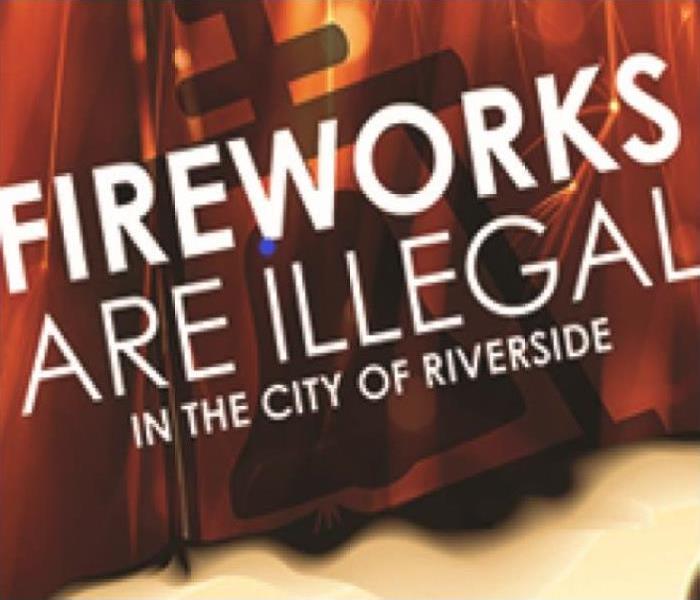 Fireworks cause injuries, spark fires that can endanger firefighters, creates stress for veterans with PTSD, and terrify animals.
Fireworks cause injuries, spark fires that can endanger firefighters, creates stress for veterans with PTSD, and terrify animals.
Every year, about 10,000 people are treated for injuries in hospital emergency departments due to the mishandling of live, misfired and waste consumer fireworks - CPSC 2019 Fireworks Annual Report.
In addition, fires resulting from fireworks cause over $100 million in direct property damage- NFPA. Many U.S. cities are seeing a surge in consumer fireworks usage by the public in 2020.
With the July 4th holiday fast approaching, the City of Riverside is reminding residents that all fireworks are illegal within the city limits, and anyone found using illegal fireworks is subject to a $1,000 fine.
Riverside has been working for several years to reduce the usage of fireworks in the city. Fireworks cause injuries in adults and children, spark fires that can endanger firefighters and the public, create stress for veterans with PTSD, and terrify many animals. Just last year, the City of Riverside confiscated 3,856 pounds of fireworks, wrote 145 citations for fireworks, and received nearly 900 fireworks-related calls.
The City continually promotes an anti-fireworks message in hopes that residents will refrain from purchasing fireworks when they become available in neighboring counties shortly before the holiday. Websites, billboards, electronic parking meters all display the “Fireworks Are Illegal” message, and city officials are monitoring websites for fireworks being offered for sale.
City officials have sent warning letters to people who have received citations and to addresses that were identified as fireworks sites by people who called the City’s 311 line. Calls to 311 regarding specific addresses where fireworks are being used can be made anonymously. RiversideCA.gov
In March 2021, approximately 20 miles from Riverside in the city of Ontario, a massive explosion from a large stash of fireworks took place. Two people and a dog were killed due to the explosion. It injured people and animals and damaged 80 homes.
What can we do to minimize fires and injuries from fireworks?
- The best way to stay safe from fireworks is to not use them. Instead, attend a public fireworks display put on by professionals.
- Fireworks are dangerous to people and pets. Using them puts your property at risk.
- Hand-held sparklers burn at 1,200 F. Remember, wood ignites at 356 F and burns at 575 F.
Riverside county Sheriff's department, City of Riverside, and Riverside county Fire Department all urge:
ALL fireworks, including sparklers, are illegal in Riverside County.
All fireworks are illegal because they cause serious injuries and very often, cause fires.
Those caught with illegal fireworks will be subject to fines, citation and/or arrest; including confiscation of all illegal fireworks. We urge you to leave the fireworks to the professionals!
Riverside Business Owners Can Prevent Fires in the Break Room
6/28/2021 (Permalink)
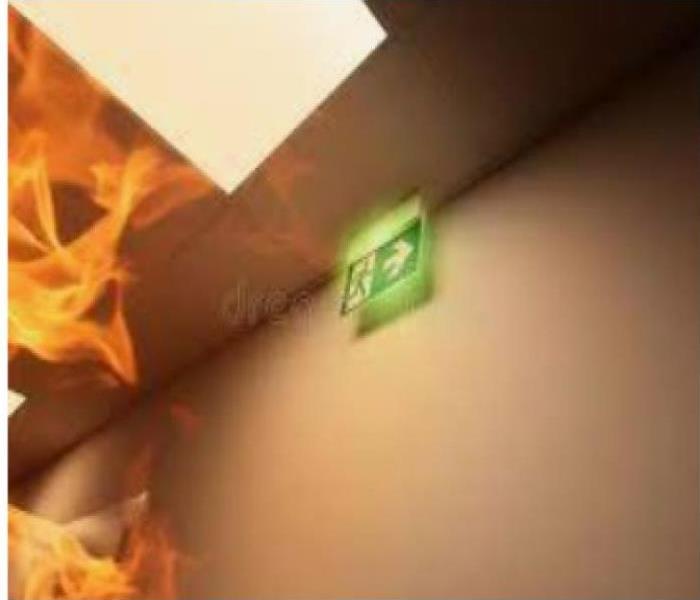 Take steps to avoid break room fires!
Take steps to avoid break room fires!
Keeping your employees happy and safe is an important aspect of owning a productive business.
Let's talk about the beloved breakroom. A lunchtime escape from the cramped office cubicle. A place to eat doughnuts without shame and to converse with coworkers, it's a temporary getaway for many office employees and can provide instant relief for the workday blues. To keep the breakroom enjoyable for everyone, it's extremely important to make sure it's safe. Making safety a high priority, you can prevent the unthinkable from happening.
A breakroom fire is one key area that can bring your business to a halt or even worse cause harm to employees. One way to prevent a small catastrophe grow into a large one is by having a fire extinguisher installed in the breakroom. It's a good way to prevent a microwave mishap. Faulty wires and carelessness can easily turn a lunch break into a lunch fire. Provide new employees with instructions on fire safety to keep everyone in the office informed. Check smoke alarms to make sure they are working properly, run a fire drill to ensure organization, and display fire safety information on the breakroom bulletin board to raise employee awareness.
To avoid break room fires, we recommend making the following suggestions:
- Only use commercial or industrial-grade appliances that are UL listed.
- Remove all hot plates, toaster ovens, toasters or any appliance that has an open flame. Place signs in the break room restricting their use.
- Plug all appliances directly into outlets that have the proper overcurrent protections (breakers, GFCI, etc.)
- Never plug appliances into extension cords.
- Provide all break rooms with smoke/heat detection devices that are monitored by a central station.
- Keep all appliances and outlets free from dirt and debris accumulation.
- Be sure there is a fully operational smoke detector in the break room. Checking the smoke alarm monthly to ensure it is operational may be the first step in proactively preventing an emergency
Do you have employees who smoke? Employees in California should be made aware of laws and should have an understanding on where they can smoke. NOLO advises, "Workplace smoking laws apply to workplaces with more than five employees In California, smoking areas must be in a non-work area. No employee may be required to enter that room as part of their job. The air must be exhausted directly outside with a fan and cannot recirculate to other areas of the building."
Here are some smoking safety tips:
- Set up deep, sturdy ashtrays with a wide, stable base that are difficult to tip over and set ashtrays on something sturdy and difficult to ignite, such as a table.
- Make sure cigarettes and ashes are out before throwing them away.
- Never toss hot cigarette butts or ashes in the trash.
- Chairs and sofas can catch fire fast and burn fast. Don't set ashtrays on them.
Visit our website for more information on commercial fire restoration . We also have blogs providing tips and best practices!
Remember, if disaster does strike, SERVPRO® of west Riverside City is Here to Help!® Give us a call 24/7 at 951-351-8033.
Smell Something Funny? It Might Be Water Damage in Your Riverside Home
6/23/2021 (Permalink)
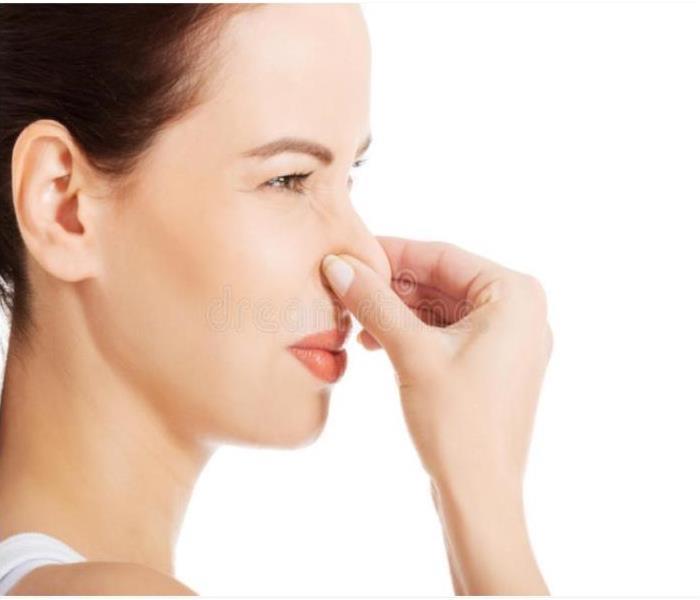 Most new homeowners are not water damage specialists, but the human nose is an excellent tool for sniffing out trouble.
Most new homeowners are not water damage specialists, but the human nose is an excellent tool for sniffing out trouble.
How To Spot Water Damage in Your Riverside Home
Do you know when to be worried about a funny smell? Most new homeowners are not water damage specialists, but the human nose is an excellent tool for sniffing out trouble. Your nose is not the only way to spot water damage in your new home. SERVPRO technicians are certified at Institute of Inspection Cleaning and Restoration Certification (IICRC) and can help handle any moisture problems you may discover after moving in.
The sooner you notice a problem, the sooner you can call us to help mitigate ongoing damages. With summer in full session in Riverside, some water damage will be easier to spot. When you notice a problem, a highly trained SERVPRO professional can assess the extent of your damages. We can use our specialized equipment to remedy the issue fast.
What should you keep an eye out for when cleaning your Riverside home? Start at the top. When looking for roof damages, obvious water stains aren't the only problem. Swollen insulation is usually an indication of water retention. Check your flashing (where the roof meets the walls) for cracks and look for missing shingles as well as more obvious signs like holes. Look at door frames and molding. Unusual stains or dark spots on the walls can mean trouble.
Inside, make sure you check your appliances after you move in to be certain they are not leaking where you cannot see easily behind them. Cracked hoses and loose connections can be tricky. Ripples, buckling, and changes in texture can tell you the flooring has a water problem. Remember to trust your nose. If it smells wrong, it probably is.
Outside water damages and mold are often caused by improper drainage. Check your spouts to see that they are clear and make sure you do not have water pooling around the foundation of your new home. At the first sign of damage, you can contact SERVPRO of West Riverside City.
No one wants to find water damages in their new home this spring. If you do, SERVPRO of West Riverside City is available at:
951-351-8033 7 days a week 24 hours a day.
We can make things “Like it never even happened,” so you can relax in your new house.
How To Restore Electronics After A Riverside Business Fire
6/21/2021 (Permalink)
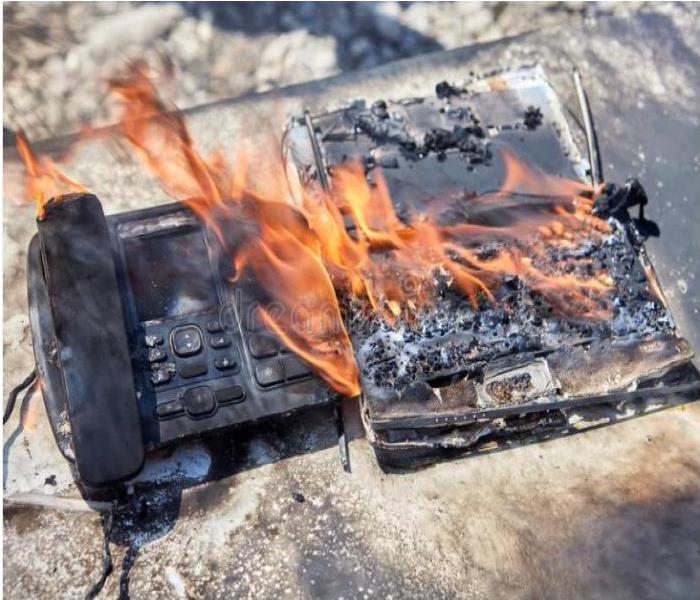 An electrical fire doesn’t have to be the end of your electronics. If you react quickly, most electronics not directly subjected to heat can be saved.
An electrical fire doesn’t have to be the end of your electronics. If you react quickly, most electronics not directly subjected to heat can be saved.
Having an electrical fire in your business is bad news. Damage to your electric wiring, appliances and electronics can be extremely difficult to repair. Soot and smoke damage have incredible penetration, and it only takes a minuscule amount in the wrong place in modern electronics to destroy an entire device.
Smoke Hates Electronics
Computers and complicated electronics have extremely dense circuit boards. The space between conductors is precisely calculated to be the least distance possible. Unfortunately, this means it takes very little to create a short circuit.
There are three main dangers to electronics from the smoke:
- A black, oily film
- Polarized smoke
- Acid in the soot
Smoke Eats Boards
Smoke from an electrical fire is a complicated substance and depends on the materials burned and the degree of heat. However, it always contains some soot and oil. If the material wasn’t well-combusted, the amount of soot and smoke increases enormously.
While the oil and soot can short out your circuit board, the acids in the smoke will start to dissolve the board itself. This can loosen connections and allow tracings to migrate slightly, causing spikes in impedances and loose connections that lead to computer failures.
Computer Cleanup Is Usually the Worst
Unlike most electronic devices, most computers have fans that actively draw in air from the room to cool the CPU and graphics processor. This means the smoke is being pulled in, and it makes computer cleanup extremely difficult.
Professional electronics restoration companies have special solvents that can often save a computer, but it should be removed from power before receiving smoke damage. If you can safely do so before evacuating, you or a manager should shut off the breakers. It makes it safer for the firefighters, too.
An electrical fire doesn’t have to be the end of your electronics. If you react quickly and hire the right experts, most electronics not directly subjected to heat can be saved. Either way, SERVPRO will return your business to “Like it never even happened.”
Are Your Pets Prepared for Riverside Disasters? June is National Pet Preparedness Month!
6/16/2021 (Permalink)
 Riverside can experience disasters from earthquakes, wildfires, flooding & winds. If you had to evacuate are you prepared with a plan for your pet?
Riverside can experience disasters from earthquakes, wildfires, flooding & winds. If you had to evacuate are you prepared with a plan for your pet?
June is National Pet Preparedness Month
In Riverside, CA we can experience disasters from earthquakes, wildfires, flooding, and excessive winds. If you had to evacuate are you prepared with a plan for your pet?
Ready.gov has provided these tips to help pet owners during a disaster.
Your pets are an important member of your family, so they need to be included in your family’s emergency plan. To prepare for the unexpected follow these tips with your pets in mind:
- Make a plan.
- Build an emergency kit.
- Stay informed.
Make a Plan
If you have a plan in place for you and your pets, you will likely encounter less difficulty, stress and worry when you need to make a decision during an emergency. If local officials ask you to evacuate, that means your pet should evacuate too. If you leave your pets behind, they may end up lost, injured or worse.
Things to include in your plan:
- Have an evacuation plan for your pet. Many public shelters and hotels do not allow pets inside. Know a safe place where you can take your pets before disasters and emergencies happen.
- Develop a buddy system. Plan with neighbors, friends or relatives to make sure that someone is available to care for or evacuate your pets if you are unable to do so.
- Have your pet microchipped. Make sure to keep your address and phone number up-to-date and include contact information for an emergency contact outside of your immediate area.
- Contact your local emergency management office, animal shelter or animal control office to get additional advice and information if you’re unsure how to care for your pet in case of an emergency.
Build a Kit for Your Pet
Just as you do with your family’s emergency supply kit, think first about the basics for survival, such as food and water. Have two kits, one larger kit if you are sheltering in place and one lightweight version for if you need to evacuate. Review your kits regularly to ensure that their contents, especially foods and medicines, are fresh.
Here are some items you may want to include in an emergency kit for your pet:
- Food. Keep several days’ supply of food in an airtight, waterproof container.
- Water. Store a water bowl and several days’ supply of water.
- Medicine. Keep an extra supply of the medicine your pet takes on a regular basis in a waterproof container.
- First aid kit. Talk to your veterinarian about what is most appropriate for your pet’s emergency medical needs.
- Collar with ID tag and a harness or leash. Include a backup leash, collar and ID tag. Have copies of your pet’s registration information and other relevant documents in a waterproof container and available electronically.
- Traveling bag, crate or sturdy carrier, ideally one for each pet.
- Grooming items. Pet shampoo, conditioner and other items, in case your pet needs some cleaning up.
- Sanitation needs. Include pet litter and litter box (if appropriate), newspapers, paper towels, plastic trash bags and household chlorine bleach to provide for your pet’s sanitation needs.
- A picture of you and your pet together. If you become separated from your pet during an emergency, a picture of you and your pet together will help you document ownership and allow others to assist you in identifying your pet.
- Familiar items. Put favorite toys, treats or bedding in your kit. Familiar items can help reduce stress for your pet.
In addition to the tips above:
- Ensure all animals have some form of identification.
- Evacuate animals earlier, whenever possible. Map out primary and secondary routes in advance.
- Make available vehicles and trailers needed for transporting and supporting each type of animal. Also make available experienced handlers and drivers.
- Ensure destinations have food, water, veterinary care and handling equipment.
- If evacuation is not possible, animal owners must decide whether to move large animals to a barn or turn them loose outside.
Stay Informed
Being prepared and staying informed of current conditions. Here are some ways you can stay informed:
- Pay attention to wireless emergency alerts for local alerts and warnings sent by state and local public safety officials.
- Listen to local officials when told to evacuate or shelter in place.
- Download the FEMA app and get weather alerts from the National Weather Service, for up to five different locations anywhere in the United States.
- Always bring pets indoors at the first sign or warning of a storm or disaster.
Many public shelters and hotels do not allow pets inside, so plan ahead.
- Know a safe place where you can take your pets before disasters and emergencies happen.
- Plan with neighbors, friends or relatives to make sure that someone is available to care for or evacuate your pets if you are unable to do so.
- Contact your local emergency management office, animal shelter, or animal control office if you’re unsure how to take care of your pet during an emergency.
- Have your pets microchipped in case they get lost.
- Check out BringFido for pet friendly hotels in Riverside
Excessive Heat Wave Warning in Riverside County- Tips from Ready.gov
6/14/2021 (Permalink)
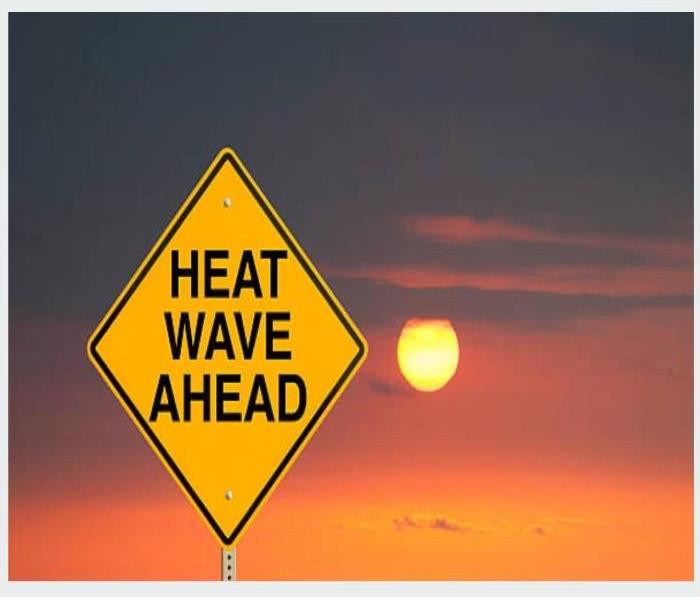 Riverside Residents should take precautions during a heat wave!
Riverside Residents should take precautions during a heat wave!
An excessive heat warning will be in effect in the Riverside metropolitan area and the Riverside County mountains starting at 10 a.m. Tuesday and lasting through 9 p.m. Saturday.
Temperatures in the Riverside area are expected to peak at 110 on Tuesday, then reach 109 on Wednesday, advised forecasters.
Ready.gov has outlined some tip to help keep safe from dehydration, heatstroke and keeping our families and pets safe.
Extreme heat is a period of high heat and humidity with temperatures above 90 degrees for at least two to three days. In extreme heat your body works extra hard to maintain a normal temperature, which can lead to death. In fact, extreme heat is responsible for the highest number of annual deaths among all weather-related hazards.
Remember:
- Extreme heat can occur quickly and without warning.
- Older adults, children and sick or overweight individuals are at greater risk from extreme heat.
- Humidity increases the feeling of heat as measured by a heat index.
IF YOU ARE UNDER AN EXTREME HEAT WARNING:
- Find air conditioning.
- Avoid strenuous activities.
- Wear light clothing.
- Check on family members and neighbors.
- Drink plenty of fluids.
- Watch for heat cramps, heat exhaustion and heat stroke.
- Never leave people or pets in a closed car.
HOW TO STAY SAFE WHEN EXTREME HEAT THREATENS
Prepare NOW
Find places in your community where you can go to get cool.
Try to keep your home cool:
- Do not rely on a fan as your primary cooling device.
- Cover windows with drapes or shades.
- Weather-strip doors and windows.
- Use window reflectors such as aluminum foil-covered cardboard to reflect heat back outside.
- Add insulation to keep the heat out.
- Use a powered attic ventilator, or attic fan, to regulate the heat level of a building’s attic by clearing hot air.
- Install window air conditioners and insulate around them.
- Learn to recognize the signs of heat illness. For more information visit: www.cdc.gov/disasters/extremeheat/warning.html
Be Safe DURING
Never leave a child, adult, or animal alone inside a vehicle on a warm day. Find places with air conditioning. Libraries, shopping malls, and community centers can be a cool place to beat the heat. Stay informed and check with local authorities about possible closures prior to going to cooling centers.
- If air conditioning is not available in your home:
- Contact Low Income Home Energy Assistance Program (LIHEAP) for help.
- Contact your local health department or locate an air-conditioned shelter in your area.
- Spend some time at a shopping mall or public library- even a few hours spent in air conditioning can help.
- Your community may set up emergency alternatives for cooling centers, such as using parked air-conditioned buses or movie theaters, as normal cooling centers may not have enough space for physical distancing. Pay attention to guidance from local officials to determine where the nearest cooling center is.
- Take cool showers or baths.
- Don’t rely solely on fans to keep you cool. While electric fans might provide some comfort, when temperatures are really hot, they won’t prevent heat-related illness.
- Use your stove and oven less to maintain a cooler temperature in your home.
- If you’re outside, find shade. Wear a hat wide enough to protect your face.
- Wear loose, lightweight, light-colored clothing.
- Drink plenty of fluids to stay hydrated. If you or someone you care for is on a special diet, ask a doctor what would be best.
- Do not use electric fans when the temperature outside is more than 95 degrees. You could increase the risk of heat-related illness. Fans create air flow and a false sense of comfort, but do not reduce body temperature.
- Avoid high-energy activities outdoors. Avoid working outdoors during the midday heat, if possible.
- Check yourself, family members, and neighbors for signs of heat-related illness
- Engage virtually with your community through video and phone calls. Know that it’s normal to feel anxious or stressed. Take care of your body and talk to someone if you are feeling upset.
Recognize and Respond
Know the signs of heat-related illnesses and ways to respond. At-risk populations for heat-related illness include older individuals and those with underlying health conditions. Know how to protect individuals especially at risk from extreme heat events.
If you are sick and need medical attention, contact your healthcare provider for advice and shelter in place, if you can. If you are experiencing a medical emergency, call 9-1-1.
HEAT CRAMPS
- Signs: Muscle pains or spasms in the stomach, arms or legs
- Actions: Go to a cooler location. Remove excess clothing. Take sips of cool sports drinks with salt and sugar. If you are sick and need medical attention, call your healthcare provider first. Follow your healthcare provider’s instructions about whether you should go to the hospital or cooler location yourself, as you may be putting others or yourself in greater risk for contracting COVID-19. If cramps last more than an hour, seek medical attention.
HEAT EXHAUSTION
- Signs: Heavy sweating, paleness, muscle cramps, tiredness, weakness, dizziness, headache, fainting, nausea, vomiting
- Actions: Go to an air-conditioned place and lie down. Loosen or remove clothing. Take a cool bath. Take sips of cool sports drinks with salt and sugar. Call your healthcare provider if symptoms get worse or last more than an hour.
HEAT STROKE
- Signs:
- Extremely high body temperature (above 103 degrees) taken orally
- Red, hot and dry skin with no sweat
- Rapid, strong pulse
- Dizziness, confusion or unconsciousness
- Actions: Call 9-1-1 or get the person to a hospital immediately. Cool down with whatever methods are available until medical help arrives.
Riverside County has identified cooling centers during this heatwave, click the link to find one near you.
https://www.capriverside.org/cool-centers
In the 92503 area code here are three centers you can go to during the heat of day:
- La Sierra Senior Center
- Arlanza Community Center Bryant Park
- Janet Goeske Center
City of Riverside Disaster Preparedness
5/31/2021 (Permalink)
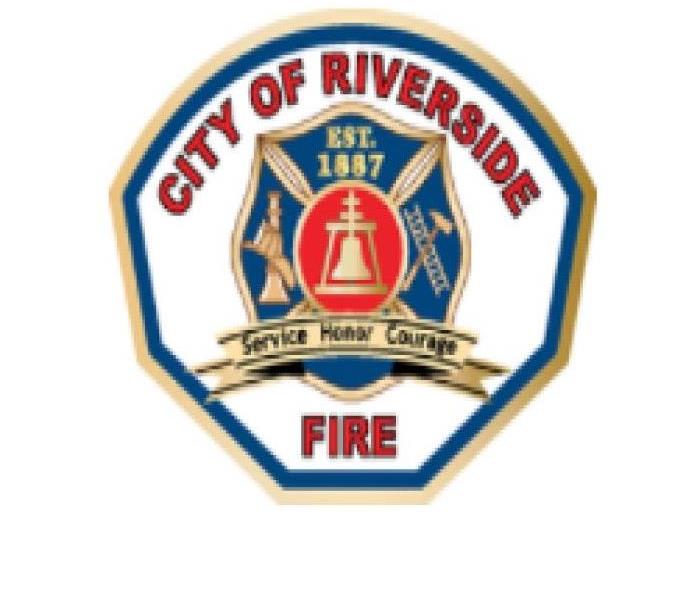 The City of Riverside is actively coordinating the City's response to disasters & assisting residents to prepare major events.
The City of Riverside is actively coordinating the City's response to disasters & assisting residents to prepare major events.
If you are a Riverside resident, we captured some important questions and links to understand how the City of Riverside is managing emergency disaster preparedness. See below for important pieces of information. Be prepared! Click links below for more information.
Emergency Management Disaster Preparedness
The City of Riverside's Emergency Management Office is actively coordinating the City's response to disasters as well as assisting residents to prepare for major events such as earthquakes, floods, hazardous material spills, plane crashes, train derailments, Africanized honey bees, and civil unrest.
Frequently Asked Questions
What is an "EOC?"
The Emergency Operation Center (EOC) is a secure facility where City department heads are able to work in the event of a large disaster. The facility provides centralization of City response to major events. The EOC allows for City departments to work closely together to make recovery more efficient for the community.
Does the City have a disaster plan?
Yes. The City is required by state and federal regulation to have a response and recovery plan. This plan covers everything from earthquakes and plane crashes to fires and flooding. This plan is maintained by the Emergency Manager and is continuously updated. A major update of the plan is done every five years. The newly revised plan is available to view at Riverside Public Library, Reference Section.
What is disaster preparedness?
Disaster preparedness is the means of preparing for a disaster before it happens. Some ways of preparing would be storage of food, water, and medicine in the event you had to be on your own for three days, planning escape routes, and setting up out of area contacts. These are just a few of the things you can do.
What types of disasters occur in the Riverside area?
Riverside is most vulnerable to floods. However, we can have earthquakes, draughts, fires, winds, Africanized honey bees, fire ants and situations such as civil unrest, terrorism and energy shortages.
Where are the nearest bomb and fallout shelters?
Bomb and fallout shelters were the direct result of a fear of nuclear war in the 1950's and 60's. With the decline of the Cold War the need for these shelters has disappeared. The City has developed extensive emergency plans and resources to ensure a coordinated response to any disaster, including a terrorist event. The best thing to do is listen to the radio or television for any information such as the location of any shelter - if established, or the need to 'shelter-in-place.
What do you mean by 'shelter-in-place'?
Shelter-in-place is intended to keep you safe while remaining indoors. For other natural disaster you may be directed by local officials to go to a community shelter for safety purposes. However, the intent of a 'shelter-in-place? means selecting a small, interior room, with no or few windows and taking refuge there.
An above ground location is preferable because some chemicals are heavier than air, and may seep into basements even if the windows are closed. Large storage closets, utility rooms, pantries, copy and conference rooms without exterior windows work well. Use duct tape and plastic sheeting (heavier than food wrap) to seal all cracks around the door and any vents into the room. There is no need to seal off your entire home or office with duct tape and plastic sheeting.
It is important to remember that instructions to 'shelter-in-place? mean shelter for a few hours, not days or weeks. There is little danger that the room in which you are taking shelter will run out of oxygen and you will suffocate. Keep listening to your radio or television until you are told all is safe.
Should I buy a gas mask?
Biological and radiological agents, which are airborne, are vapors, not gasses so there's no need for a gas mask. Vapors immediately begin to dissipate once they are released. When you leave an area, the risk of being affected by a vapor diminishes. Gas masks were developed for soldiers who have to remain in a specific area - that's the big difference. You can leave an area and always leave the risk. Chemical gasses need to be delivered in large quantities in order to kill or cause injuries. If you smell a vapor or gas, remember to stay calm. If you panic you have a tendency to breathe faster and you will breathe more of the biological, radiological or chemical agent. Listen to local radio and television broadcasts for information if an airborne attack occurs.
Should I start storing food, water, medical supplies, clothing, etc.?
It makes good sense to store food, water and medical supplies as well as duct tape and plastic sheeting. Natural disasters can occur at any time, and the City encourages you to do all you can to be prepared for all types of hazards. Why not be ready?
What is the City of Riverside doing about terrorist attacks?
The City is involved in a multi-jurisdictional group whose responsibilities are to develop terrorism emergency response plans and training. The Police Department continually assesses threats to determine if they are credible. The City has been very pro-active in its terrorist response planning.
For Further Information Call:
City of Riverside Office of Emergency Management - (951) 320-8100
Building Safety Month-Disaster Preparedness
5/26/2021 (Permalink)
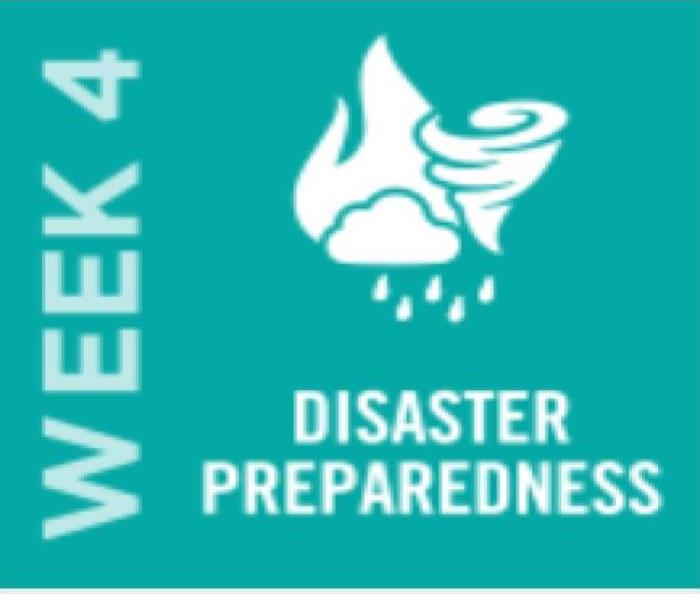 Natural disasters are increasing in severity and frequency. Advance planning supports a faster recovery in the aftermath of a disaster
Natural disasters are increasing in severity and frequency. Advance planning supports a faster recovery in the aftermath of a disaster
WEEK FOUR // May 24–31, 2021
Below are some resources the International Code Council has to help you prepare your family and protect your home from natural disasters.
Natural disasters are increasing in severity and frequency. Advance planning for devastating events like hurricanes, floods, snowstorms, tornadoes, wildfires and earthquakes helps individuals and communities increase the health and safety of their population during a disaster, protects the local tax base, ensures continuity of essential services and supports a faster recovery in the aftermath of a disaster.
Prepare Your Family
Here are a few tips to follow when preparing your family for any emergency.
- Determine your risk. Identifying and understanding possible
hazards and emergencies is the first step in preparing for natural disasters. - Consider incorporating a safe
room in building plans and improvements. A safe room is a hardened structure specifically designed
to meet FEMA criteria and provide near-absolute protection in extreme weather events, including tornadoes
and hurricanes. - Sign up for your community’s warning system. The Emergency Alert System and National Oceanic and Atmospheric
Administration Weather Radio also provide emergency alerts. - Develop a family disaster plan that
includes a list of food and water supplies needed for each member of your family and supplies for your pets.
Make copies of important documents like insurance policies, the deed to your home, and other personal
papers, important phone numbers and a home inventory. - Store important documents in a waterproof container and create password-protected digital copies.
- Review your evacuation route and emergency shelter locations
with your family. Options for evacuation would include staying with friends and relatives, seeking
commercial lodging or staying in a mass care facility operated by disaster relief groups in conjunction with
local authorities. - Taking shelter is critical in times of disaster. Sheltering in
place is appropriate when conditions require that you seek protection in your home, place of employment or
other location where you are when disaster strikes. - Review your plan regularly. If you make changes that affect the information in your disaster plan, update it
immediately. - Visit FEMA’s Prepareathon! to learn more about how to
prepare for earthquakes, floods, hurricanes, tornadoes, wildfires and winter storms. Get Involved to help prepare your family and community.
Protect Your Home
The power of natural disasters can be overwhelming. While you can't necessarily stop them from happening, there are steps you can take to increase your home's chance of survival, even in the face of the worst that Mother Nature can dish out. Protecting your home can range from taking simple measures like protecting windows or elevating appliances, to more complete building retrofit measures. See Additional Information and Resources below for links to hazard-specific guidance on protecting your home.
Several lines of insurance are available to cover financial damage from various hazards. To learn more about protecting your home financially through insurance, see FLASH’s Homeowner’s Insurance Guide to Natural Disasters.
Flood insurance can be the difference between recovering and being financially devastated. Just one inch of water in a home can cost more than $25,000 in damages. The average flood insurance claims payment to homeowners was about $90,000 from the Baton Rouge floods in 2016 and $65,000 for Superstorm Sandy that struck the Northeast in 2012.
FEMA's Individual Assistance Program, during times of federally-declared disasters, can provide financial assistance for home repairs, rental assistance, and other needs in the U.S., but the average payouts are much smaller, on the order of $6,000 to $8,000 per household — why risk it? For more information on flood insurance, visit floodsmart.gov.
Three Types of Fire Damage That Affect Homeowners in Riverside
5/24/2021 (Permalink)
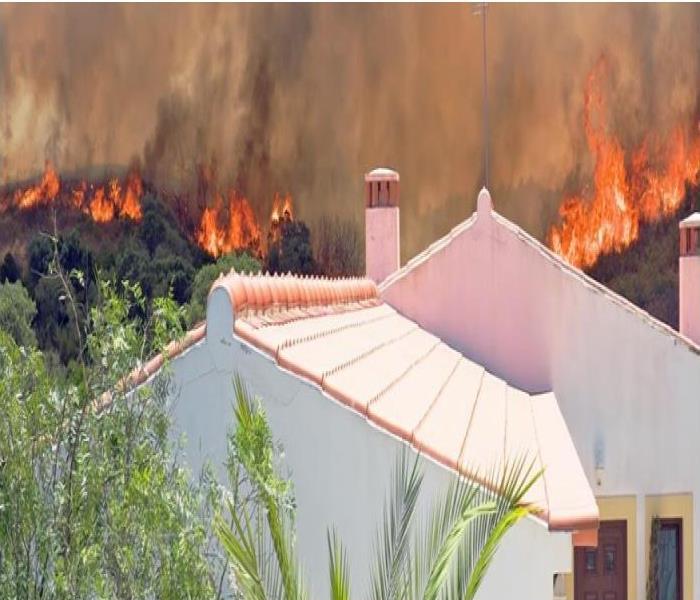 A fire is devastating, and when it occurs, an immediate response can prevent damage from spreading throughout your home.
A fire is devastating, and when it occurs, an immediate response can prevent damage from spreading throughout your home.
Things to Take Care of After a Fire Damages Your Riverside Property
A fire is devastating, and when it occurs, an immediate response can prevent damage from spreading throughout your home. After a fire loss, you should assess the extent of the damage in the structures and contents of your home. It is also essential to learn if your insurance firm can compensate you for all the relevant destruction.
Fire damage in your Riverside home can be of three types. All three kinds of destruction come with their issues, so it is crucial to understand what they are and how they can affect your property.
Flame damage
Various types of flame destruction can occur based on what caused the fire. For instance, an electrical fire can have a different effect on your house when compared to a fire caused by a naked flame like a match or candle. Improper restoration can cause unseen structural damage or hidden electrical problems. SERVPRO has expertise in restoring homes after any fire.
Smoke and soot damage
The destruction that soot causes is long-lasting and may hang around for weeks or months after extinguishing the fire. The smoke scent can linger on different structures in your house, including ceilings, walls, furniture, and flooring. Smoke turns into soot, and it may discolor surfaces in your home. Some smoke residues can cause some surfaces to corrode. Our technicians can wipe off light-colored painted surfaces, plastic surfaces, tops of furniture with finished surfaces, Formica countertops and fiberglass surfaces properly to eliminate residues. We can also use air scrubbers to remove the smoke scent from your home.
3rd party damage
A house fire brings about other vulnerabilities and problems. For instance, the water that firefighters used to extinguish the flames can get absorbed in the drywall, flooring, and carpeting. Our SERVPRO technicians can use infrared cameras to check for hidden moisture and then dry the affected areas. Firefighters often use dry chemicals like sodium bicarbonate, monoammonium phosphate, or potassium bicarbonate to extinguish fires. These can leave a corrosive powder on the affected areas. We can clean up the powder quickly to prevent further damage.
After a fire loss, SERVPRO of West Riverside City is ready to help you deal with it. We can work with you to restore your property to normal quickly. Call us today at (951) 351-8033.
Preparing Homes and Communities for the 2021 Wildfire Season
5/19/2021 (Permalink)
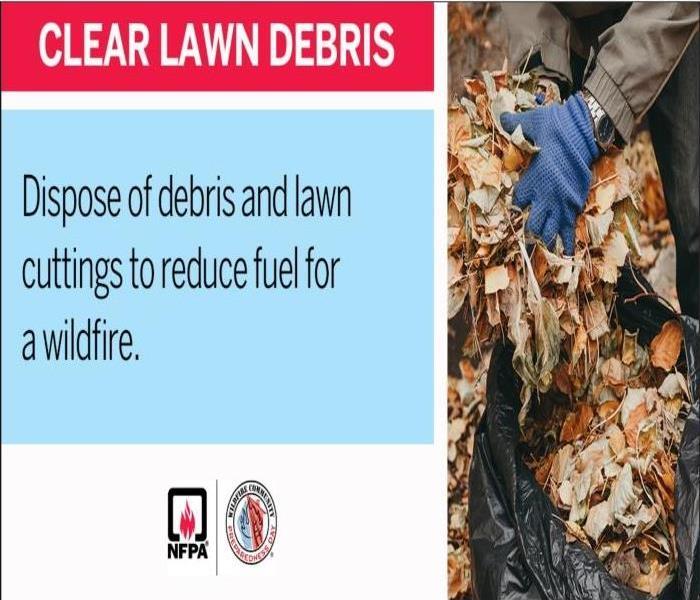 Tip from StateFarm and NFPA: Raking and removing pine needles and dry leaves within a minimum of 3 to 5 feet of a home’s foundation.
Tip from StateFarm and NFPA: Raking and removing pine needles and dry leaves within a minimum of 3 to 5 feet of a home’s foundation.
The National Fire Protection Association (NFPA) and State Farm are helping communities take steps toward safety with Last year, 58,950 wildfires burned over 10.2 million acres of land in the United States, resulting in loss of homes, business, and even lives.
Given that in-person gatherings are limited or on-hold in many places, this year’s Prep Day is focused on what residents can do on and around their home to help protect against the threat of wildfires.
Here are tips from StateFarm and NFPA.
To create defensible space and reduce your risk:
- Raking and removing pine needles and dry leaves within a minimum of 3 to 5 feet of a home’s foundation. As time permits, continue up to a 30-foot distance around the home. Dispose of collected debris in appropriate trash receptacles.
- Cleaning pine needles from roof and gutters and paying attention to maintaining the home ignition zone.
- Getting out your measuring tape and seeing how close wood piles are located to the home. If closer than 30 feet, they need to be relocated and moved at least 30’ away from structures.
- Sweeping porches and decks clearing them of leaves and pine needles. Raking under decks, porches, sheds and play structures.
- Removing items stored under decks and porches and relocating them to a storage shed, garage, or basement. Gasoline cans and portable propane tanks should never be stored indoors and should be located away from the home.
- Posting and sharing Facebook and Twitter messages with tips and best practices with others in your community. (See sample posts from NFPA here.)
State Farm also recommends policyholders:
- Review your insurance policy to make sure you’re covered in the event of a wildfire
- Create a home inventory to assist in the claims process
- Create a disaster preparedness plan that includes your pets and animals
For more resources and information about national Wildfire Community Preparedness Day including videos and tip sheets, visit www.wildfireprepday.org.
Protect Yourself Against Water Flooding in Your Riverside Home
5/18/2021 (Permalink)
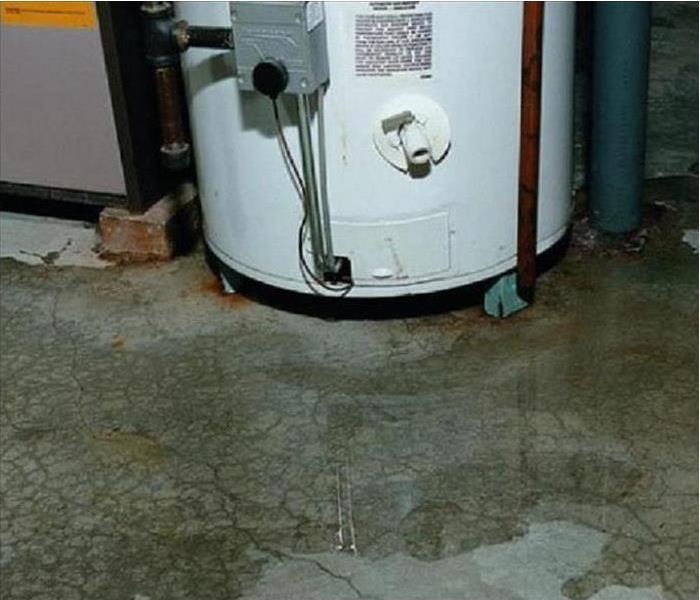 Check appliances such as washers, dishwashers, water heaters regularly and replace water lines when needed.
Check appliances such as washers, dishwashers, water heaters regularly and replace water lines when needed.
You can’t prevent every catastrophe that might come along, but we pulled together a few solid tips to protect yourself against water flooding in your home. Take a moment to check these out to minimize your flooding risk.
Clean your downspouts and gutters
With the many trees and windy conditions Riverside residents should add this task to their list. Make sure to clean out your gutters at least once every six months or more often if you have a lot of trees near your Riverside home. When water collects in the gutters it can cause damage to your roof and the gutters themselves. Check to ensure water is running off properly and draining away from your house. Downspouts that aren’t clean can cause damage to walls and even your foundation. At SERVPRO of Riverside City, we see this issue surprisingly often. Clean those gutters and spouts!
Switch off the mains
If you are going on vacation or you are going to be away for a length of time, switch the water off at the main. This will stop any dripping or other water issues while you are away. You wouldn’t want to come home to water rushing out your front door to greet you! Unfortunately, our parched ground often absorbs the water so at first you may not even know you have a leak but at some point, the ground becomes saturated and then you have a big mess on your hands! If you have a drip system or sprinkler system, it may make sense to ask a neighbor, house sitter or your landscaper to turn these on and off manually. There are some systems you can control from your phone to water your landscaping too!
Keep your garden in check
While we’re on the topic of landscaping, trees and shrubs can cause damage to your pipes from the roots wrapping around the pipes. Keep your garden maintained and avoid planting large plants near piping if at all possible.
Take care of those small leaks immediately
Found a little leak? It may seem like a harmless drip, but a small leak can become a big water damage problem if not dealt with as soon as possible. Even tiny drips can cause mildew and mold in your home and even lead to structural damage and dry rot over an extended period of time. If you fix the leaks as they occur, you have less likelihood of the small issue becoming a huge problem later. If you have a sudden spike in your water bill, make sure you investigate for underground water leaks as well.
Check the appliances
Most people think toilets are the cause of most home floods but don’t forget about your appliances! Monitor appliances for leaks and replace any cracked and brittle piping. Things like a dishwasher or washing machine can flood your house out quickly if the appliance is not maintained adequately.
Flood damage in our homes is something most of us experience at some point in our lives. It could be caused by something as simple as an overflowing bathtub or something more serious such as a burst pipe or sewerage pipe rupture.
Flood damages to your home can range from minor to severe and dealing with the issue can be overwhelming. While some water issues cannot be foreseen, there are a few things you can do to prevent flood damages to your home from factors you have some control over.
If you experience flooding in your home, immediately call the water damage experts!
Get the help you need from SERVPRO of West Riverside City
951-351-8033
Answered: Your Most Burning Questions About Fire Damage in Riverside
4/21/2021 (Permalink)
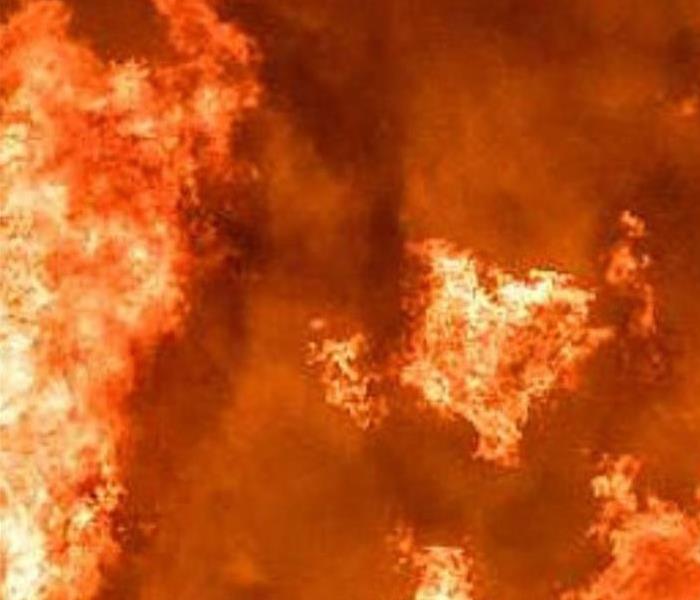 SERVPRO of West Riverside City has the proper training and tools to return a home to preloss condition.
SERVPRO of West Riverside City has the proper training and tools to return a home to preloss condition.
Odor Removal in Your Riverside Home
While there are many lingering effects after a fire loss incident in Riverside homes that property owners can overcome with elbow grease and the right focused cleaning efforts, there are other symptoms that ensure that returning a house to preloss condition is a significant challenge. Odor damages, for example, can spread far beyond an ignition source to affect multiple areas of a home, even rooms otherwise unaffected by the disaster. Reducing or eliminating the presence of these harsh scents often requires a higher grade of cleaning agent and units designed for deodorization in the restoration industry.
When overcoming fire damages in Riverside homes like lingering odors, SERVPRO professionals like ours must utilize multiple pieces of equipment. The best approach for professional deodorization gets determined by the severity of the condition, the affected materials, and the timeline to protect the rest of the household. While there are multiple units and approaches available to our professionals, the most commonly used by our team are:
Hydroxyl Generators These machines utilize both an onboard HEPA filtering system and produce free radicals to break down the molecular structure of foul odors on contact. These units are safe to use around people, pets, and softer materials.
Ozone Machines These units (and the larger chambers at SERVPRO facilities) produce a gas comprised of three oxygen atoms. These irregular compounds bond with odor molecules to neutralize them. This practice is not safe to use around humans and pets.
Thermal Foggers As you might expect from the name, thermal foggers generate heat which vaporizes a compound the fogger can use. In these applications, the fogging solution is a highly effective deodorization agent. This practice is ideal for open areas and softer materials.
Material Removal/CleaningCleaning can help to noticeably reduce the presence of harsh odors in a fire-damaged area of your home. It is always the last resort of our SERVPRO professionals to allow for material removal and later replacement, and this decision only gets made with areas too severely damaged to preserve.
While there are some aspects of fire damage that homeowners can address on their own when first responders leave the scene, symptoms like odors pose a much more challenging obstacle to overcome.
Let our SERVPRO of Riverside team help you make it “Like it never even happened.”
Give us a call at (951) 351-8033.
Does SERVPRO Work with Homeowners Insurance Company After a Fire?
4/21/2021 (Permalink)
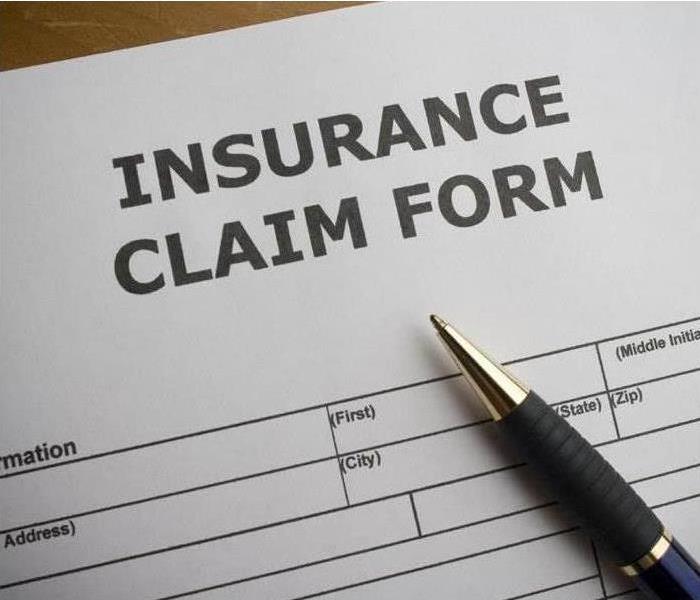 At SERVPRO, our services go beyond fire cleanup in Riverside. What we do is designed to assist all parties involved!
At SERVPRO, our services go beyond fire cleanup in Riverside. What we do is designed to assist all parties involved!
Riverside Homeowners Can Trust SERVPRO to Work Closely with Insurance Companies.
The leading cause of fire-related deaths, injuries, and property loss is residential fires. Most of these homes, thankfully, are covered by homeowner’s insurance. When it comes to assisting Riverside residents with fire claims, a professional restoration company is vital.
How Does SERVPRO Assist Both the Homeowner and the Insurance Company?
Whenever a fire has occurred, the insurance company works with the owners to decide the extent of the loss. This process involves the homeowner, insurance company, insurance adjuster, and the restoration company. In many cases, the insurance company requires a professional company to work with them to ensure that everything gets done professionally. At SERVPRO, our services go beyond fire cleanup in Riverside. What we do is designed to assist all parties involved and includes:
Minimal loss prevention - By providing immediate fire mitigation, more can be salvaged. Prompt action reduces secondary damage and property loss. Scoping information – The details we provide during the initial scope allow the insurance agent to review inspections and reports. He then can prioritize items on the work schedule. Assessing restoration needs – Our technicians help the insurance adjuster and owner decide what gets cleaned and what needs to be declared a loss. Working with adjusters – Our professional teams provide scoping, testing, and loss details that save the insurance adjuster time. Managing the restoration job –When our technicians handle the various aspects of restoration, the insurance company and homeowner do not need to waste time on minor, time-consuming tasks. Restore instead of replace – Our goal is always to restore instead of replacing whenever possible. This saves everyone time and money. Customer satisfaction – we know how a fire can impact your home. If possible, we restore your home to preloss condition.SERVPRO provides an invaluable service by working closely with residents and their insurance companies. As our company works closely with the adjuster, the stress is taken off the homeowner. The agent’s job goes smoother due to the detailed information we provide early in the process. When our Green Team provides fire cleanup services, we are doing more than cleaning – we are helping you get your life back on track.
Contact SERVPRO of West Riverside City at (951) 351-8033 for professional fire cleanup services.
We’re Faster To Any Size Disaster.
Why Should I Agree to a Pack-Out of My Riverside Home After a Fire?
3/31/2021 (Permalink)
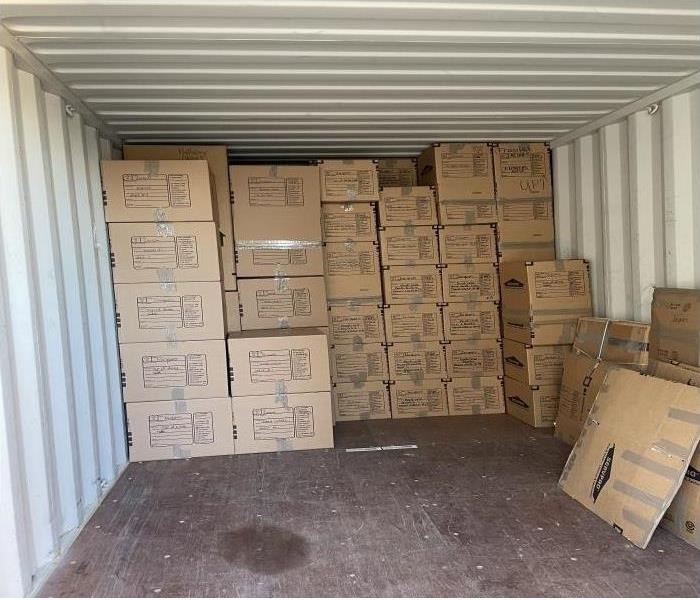 Removal of furniture and personal possessions allows our Technicians to focus on structural components and fixtures damaged by the fire.
Removal of furniture and personal possessions allows our Technicians to focus on structural components and fixtures damaged by the fire.
Professional Pack-Outs Managed by SERVPRO Significantly Improve the Outcomes for Fire Damaged Riverside Residences and the Contents of the Homes
The aftermath of an Riverside household fire is hectic at best and often devastating for you and your family. Understandably, you feel panicked and out of control. When the restoration company you choose suggests a pack-out of most or all of your furnishings, household goods, and personal possessions, you might feel unsure, unwilling to allow what feels like an even more intense disrupting of your life.
What Is the Point of a Pack-Out?
Choosing pursuit of a partial or complete pack-out of the movable property in your fire damaged Riverside home has positive outcomes for both the items moved and the spaces cleared in your dwelling.
How Does a Pack Out Benefit the Items Moved?
The articles packed up and transported away from the fire damaged spaces in Riverside avoid additional harm from firefighting water and soot deposit.Our home contents specialists assess the damage to each item and make recommendations based on our fire damage restoration resources, preventing you from the expense and emotional loss of discarding possessions we safely can bring back to function and appearance. Your possessions are safe and secure in a storage area after restoration. The system we use to track the items allows us to locate and return individual items as you need them.How Does a Pack Out Streamline Mitigation and Remediation Efforts in Your Home?
Removal of furniture and personal possessions allows our Water Damage Restoration Technicians (WRT) and Fire and Smoke Restoration Technicians (FSRT) to focus on structural components and fixtures damaged by the fire.Moving out water and soot damaged items reduces the moisture, residue, and odor load in your home, increasing the effectiveness of the interventions our on-site technicians employ to manage these issues. What Safeguards Are in Place to Account for Packed Out Articles?
Technicians use protective wrap on large pieces and sturdy boxes for loose, smaller articles. We encourage you to identify the things you might need returned as soon as possible after processing rather than when your home is ready to pack back, such as:
Particular types of clothingBooks and paperworkElectronicsTools and equipmentTreasured items, such as a child's favorite toy or blanketWhat Happens During Processing of Fire Damaged Contents?
Every item is considered individually as its needs can vary from other damaged articles. Our employees assess each piece of packed out property to determine:
Characteristics of its materials--solid, permeable, washable, dry cleanable, colorfastnessCondition--previous damage, soil levels, moisture levels, noticeable odorsTypes of soiling--oil-based, water-basedEvidence of mold, mildew, other microbial growthWe choose cleaning products and methods on an individualized basis, using our Institute of Inspection, Cleaning and Restoration Certification (IICRC) training and experience:
Technicians pre-test the efficacy of the selected product and method.If pre-testing indicates the approach chosen is successful, we proceed to clean, dry, disinfect, and deodorize the items.After processing, the items are packed and stored securely, awaiting the completion of on-site fire damage remediation at your home.Does SERVPRO Help with Insurance Claims?
Many insurance companies suggest working with a reliable and reputable fire damage restoration company, and you might select us because of a recommendation from your carrier. The professional assessment our employees complete and updates recorded outline whether chosen interventions succeed in returning contents to preloss condition. This information forms the basis for your claims' coverage. Our documentation supports your requests for restoration compensation or replacement if we cannot restore an item to previous functionality.
Who Takes Responsibility for Reuniting the Processed Contents with My Fire Damage Restored Home?
Our protocol includes a professional pack back of your property when your dwelling is ready. The same care used when we moved items to our production facility makes the move back respectful and comprehensive. We appreciate how stressful the aftermath of a household fire feels and make every effort to streamline the process for you and your family as you return to your restored abode.
The team at SERVPRO of West Riverside City is ready to muster all our resources to transform your home and its contents to "Like it never even happened." Call us at (951) 351-8033 to begin the partnership with our experts that returns normalcy to your life after fire damage.
What Can Be Submitted in the SERVPRO Emergency Response Profile System in Riverside
3/29/2021 (Permalink)
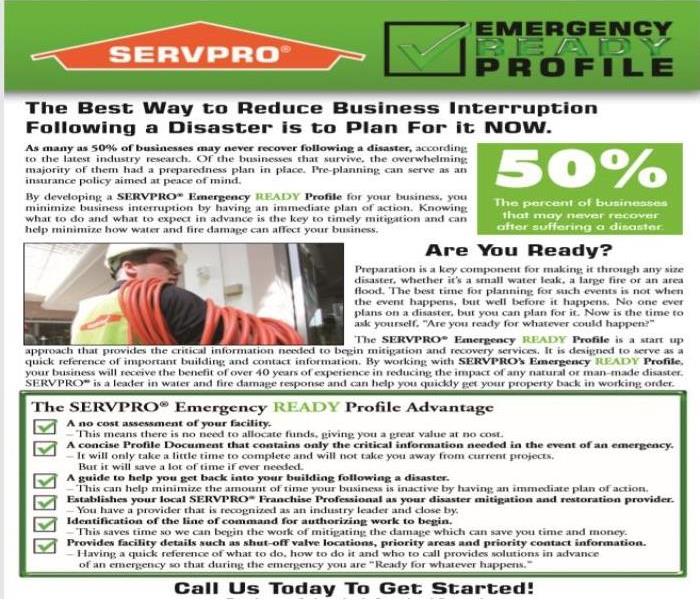 Contact SERVPRO of west Riverside City for more information on a FREE Emergency Response Profile.
951-351-8033
Contact SERVPRO of west Riverside City for more information on a FREE Emergency Response Profile.
951-351-8033
SERVPRO Allows You to Get Prepared with the ERP System
The SERVPRO ERP system allows business owners to maintain profiles for their businesses, with separate information and details for each location. This makes it easy for companies or landlords with multiple physical locations to watch out for to manage their properties in times of disaster, and get appropriate information to us quickly. There are many options available when you create an Emergency Ready Profile, and although none are mandatory, we allow you to submit everything from technical drawings to contact lists to legal documentation.
Building Plans and Technical Documents
Especially for Riverside commercial water damage in apartments and other tightly-packed businesses, submitting building plans, blueprints, and technical documentation greatly assist our technicians when they are on-site and beginning mitigation. SERVPRO asks that you submit anything that could be helpful to us, from floor plans to breaker locations and from wiring configurations to vent arrangements. There are innumerable documents that may or may not exist for each building, and the more we have access to, the better we can identify threats and the quicker we can work.
Legal Documentation and Insurance Files
Although some legal documents should stay private, the ERP system allows you to upload any relevant information to our servers to make white-collar operations smoother and get better response times from associated law and insurance firms. This is especially important for insurance work, as we work closely with insurance providers and adjusters, and preexisting documents for yours will invariably be helpful.
Contact Information and Local Services
By submitting lists of contacts and perhaps local associates, you are able to help us to be in better touch with all relevant parties in cleanup proceedings. Tenants and investors can be notified and updated on the situation, local contractors can be reached out to more quickly, and our renowned communications expertise can be fully put to use.
SERVPRO of Riverside has the fast response times, passionate customer service, and high-quality equipment necessary for perfect business restorations. Give us a call at (951) 351-8033 for our help or to learn more about our ERP system.
Limiting Loss For Veterinary Clinics in Riverside
3/24/2021 (Permalink)
 One way to protect your clinic is with a FREE Emergency Response Profile. Contact us 951-351-8033
One way to protect your clinic is with a FREE Emergency Response Profile. Contact us 951-351-8033
Our Trained SERVPRO Technicians Focus on Recovery and Not Just Replacement
Modern small animal clinics feature a growing array of electronic equipment to diagnose and treat their patients. As with other electricity-powered machines, veterinary medical tools have the potential to start fires through improperly wired connections or faulty or overloaded circuits. No matter the cause, SERVPRO restores your animal hospital after a fire.
One of the diagnostic devices catches fire, and commercial fire damage spreads through your Amherst veterinary clinic. Unfortunately for you and your patients, smoldering wiring ends office hours. Your staff stopped the fire quickly with a chemical extinguisher, but a thick and unpleasant smelling smoke moved throughout your facility, including surgical suites and recovery areas. Our highly-qualified technicians know how to clean up the fire residues completely and safely, and restore fresh ventilation so that your business of caring for animals continues.
The SERVPRO crew arrives and ensures the clinic HVAC system halts operation. Our experts inspect the ductwork and arrange for a thorough cleaning, removing as much soot as possible using brushes and powerful vacuums. Areas impossible to clean are sealed using professional products and techniques learned in Institute of Inspection, Cleaning, and Restoration Certification (IICRC) approved courses our workers attend.
Surfaces covered with smoky and chemical extinguisher residues receive treatment appropriate to the characteristics of the coating deposited by the fire. Our crews use a systematic approach, spraying and wiping away the debris or carefully employing abrasive methods when the soot is sticky and difficult to remove. We understand your exam and treatment rooms must be sanitized, and your boarding kennels, offices, and lobby spaces require a restoration to preloss condition.
SERVPRO deodorization experts use one or more strategies to eliminate smoky smells. Animals are sensitive to the disturbing aroma left after a fire, necessitating comprehensive deodorization. We recommend removal of the damaged equipment wiring as a first step and then use airborne deodorants. Thermal fogging, a procedure that requires a certified technician to complete, replicates the way the odors first pervaded and neutralizes them.
The medications and foods your office stocked before the fire are likely to be compromised by the smoke damage. We work with your insurer to make hard decisions about the supplies and treatments to be discarded. Our pledge is to have you back to caring for the community’s pet population swiftly.
SERVPRO of West Riverside City helps you sort out the challenges an equipment fire poses for your veterinary practice. Call us at (951) 351-8033 as soon as your clinic is cleared by local authorities for fire restoration works.
Can I Afford the Cost of a Restoration Company?
3/10/2021 (Permalink)
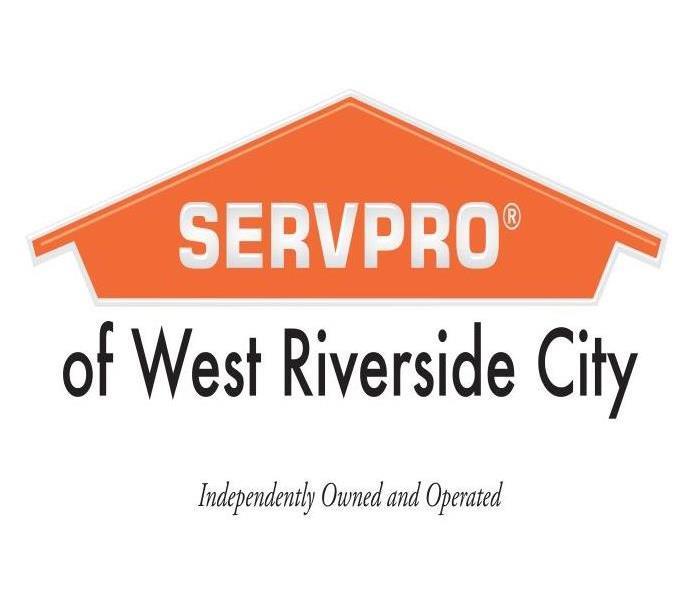 SERVPRO can help homeowners understand issues to make appropriate decisions for their situation.
SERVPRO can help homeowners understand issues to make appropriate decisions for their situation.
SERVPRO works with you and your Insurance company.
Once homeowners get over the initial shock of finding a water leak in their home, most begin to worry about the cost of restoration. How much are the restoration and repairs going to cost? Can their budget afford it? Can they cut any corners? Does their homeowner's insurance cover everything? These and other questions can quickly overwhelm people.
SERVPRO provides water damage services in Riverside, as well as restoration and repair and surrounding areas. We have been providing water damage services for many years. Our experience and technical certifications, combined with 24/7 availability and 4-hour response times, are aimed at mitigating the damage and controlling the total cost of recovery. There may be an additional cost and even health effects if homeowners do not take the proper steps to remove all moisture from their homes.
Making Informed Decisions
One of the first actions our crew chief takes upon arriving at your home is to complete an assessment of the damage. We make sure that the source of the water is under control, and we develop a plan to remove standing water, remove the moisture, and lower the humidity. If repairs are required, these can also be discussed with the homeowner and the insurance company adjuster. We prepare an estimate of the cost to complete all of this work.
Homeowners can quickly decide in conjunction with the insurance adjuster what action should be undertaken. Note that it is essential to act quickly to avoid long term damage to floors such as hardwood floors and also the growth of mold and mildew in your home. SERVPRO can deploy a team of people within hours of the initial leak to mitigate the damage.
Homeowners without insurance coverage must carefully decide what action to take. Delays or taking no action at all can lead to costly damage more significant than the initial cleanup and drying. Hardwood flooring can cup, crown, or crack, leading to total replacement. Cabinet structures may swell, become unsightly, and lose structural integrity. Worst of all, mold infestations may appear, leading to structural damage, health effects, and very unsightly looking conditions. All of these conditions can be much costlier to repair. SERVPRO can help homeowners understand these issues and make appropriate decisions for their situation.
Call SERVPRO of West Riverside City at (951) 351-8033 for 24/7 service. We proudly serve Riverside and surrounding areas. We're Faster To Any Size Disaster.
Spring Cleaning Tips for a Safe Work Environment
2/24/2021 (Permalink)
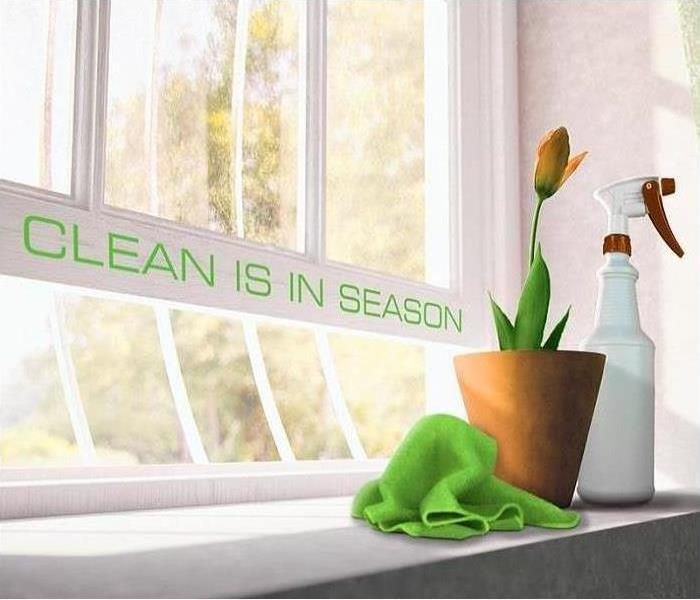 Spring cleaning isn't just for the home, ensure your workplace is cleaned and sanitize to help keep employees safe from COVID-19
Spring cleaning isn't just for the home, ensure your workplace is cleaned and sanitize to help keep employees safe from COVID-19
Many plan to clean their homes during the upcoming spring months. After being cooped up during the winter with heater running, limited outdoor ventilation, spring is the perfect time to clean. But it's more important than ever to take the annual tradition of thoroughly spring cleaning the home or workplace as seriously as possible. The following is an article I found to be very informative regarding workplace cleaning taking into account COVID-19 From Amtrust Financial :
Spring cleaning is an essential task to get the home tidy, organized and can even improve the health of the household by removing common asthma and allergy triggers that worsen this time of year. Employers should also take part in spring cleaning chores to not only eliminate dust and grime from the workplace, but also to create a safe, healthy environment that helps reduce employee illnesses and injuries.
The Importance of a Clean Workplace in the Time of COVID-19
Maintaining a clean workplace is essential to the health, wellness and safety of your employees. A tidy, clutter-free environment helps reduce injuries, boosts morale and productivity, and ensures employees are motivated to perform their duties more effectively. Additionally, sanitary offices, public spaces and restrooms help keep workers healthy, reducing the use of sick days taken and the loss of productivity that comes along with them.
The recent coronavirus, known as COVID-19, has had a major impact on people and businesses around the world since it was first detected in Wuhan, China at the end of December. As you start thinking about your spring cleaning checklist this year, there are a few extra precautions to take that can help keep workers safe and healthy – and help stop the spread of COVID-19. These include:
- Clean first, then disinfect. Cleaning removes dirt and germs from surfaces, while disinfecting uses chemicals to kill germs. Before applying those chemicals designed to disinfect, first wipe down surfaces using soap or a detergent.
- Properly disinfect surfaces. Once surfaces are thoroughly cleaned, disinfect using a diluted bleach solution, alcohol solution with at least 70% alcohol, or a common EPA-registered household disinfectant.
- Take extra care to clean regularly touched objects. In addition to wiping down surfaces like desks and bathroom countertops, make sure to disinfect items employees commonly touch throughout the day, like doorknobs, light switches, refrigerator doors, microwave doors, phones, chairs, etc.
It’s also a good idea to require staff to wash their hands thoroughly – and often. Additionally, now is the time to make sure your business continuity plan is updated to keep operations running smoothly following an unforeseen event that could potentially close your doors, such as COVID-19.
Spring Cleaning Tips for a Safe Work Environment
Hazards can be found in any type of commercial establishment, from office buildings and retail outlets to machine shops and five-star restaurants. As you welcome in the warmer spring weather, it’s the perfect time to take a look around your small business and identify the areas that could use some sprucing up, as well as identify the areas that could increase risk of injury for your employees. A few workplace cleaning tips to keep in mind this spring include:
Clear the clutter
A workspace littered with boxes, bags, equipment, piles of paper, etc. can easily heighten the risk of trips, slips and falls among employees or customers. It’s especially important to remove clutter from high traffic areas and stairs. As one of the most popular spring cleaning tasks is to get organized, do a thorough purge of any items cluttering up work areas, blocking exits or posing tripping hazards.
Remove any potential fire hazards
In addition to clutter increasing the risk for injury, it can also add to the risk for a fire. Stockpiles of papers and boxes on floors, desks, or file cabinets can pose a significant fire hazard, especially if they are located near sources of ignition. If any materials are considered to be flammable, they should be stored in designated areas.
Store items properly
As you’re working to clear clutter from your workplace, items that you’ll be keeping should be properly stored to avoid accidents or injuries. Heavy objects should be placed on waist-high shelves so they can be lifted with minimal bending or reaching. Boxes and other items should be stacked securely and maintained as low as possible to prevent things from falling or toppling over onto employees or customers.
Deep clean the floors
Throughout the year, you’re probably sweeping, vacuuming and/or mopping regularly as clean, dry floors are key in preventing slips and falls. However, during spring cleaning time consider getting any carpets, tile and other flooring professionally cleaned.
Additional Commercial Cleaning Tips for Employee Safety
Consider your cleaning chemicals
Part of any good spring cleaning project will often include use of soaps, detergents, disinfectants, waxes, polishes and various other types of cleaning chemicals. In most cases, these are relatively benign and non-hazardous, however, none of them are good for the eyes. Safety eyewear is a good idea when mixing and using these items, as is the use of gloves to protect potentially sensitive skin. Additionally, some ordinary cleaning compounds can produce toxic gasses or liquids when mixed, so it’s important to only mix chemicals as instructed on the labeling for the chemical. Never assume two chemicals will mix together safely.
Take caution when working at heights
A thorough cleaning often includes windows, stairwells, high atriums or other areas not reachable from the floor. Always try to use pole-mounted brushes, squeegees or other aids to minimize the need to climb. If climbing is absolutely necessary, be sure to utilize only step stools with a sturdy hand hold to help maintain balance. Falls from ladders are a leading cause of injury in both the home and workplace, so minimizing all climbing should be a top priority.
Check first aid supplies
The changing of the season is the perfect reminder to check the state of your company’s first aid kit. Find out what items need to be restocked and get them ordered immediately. A first aid kit is a must in order to fulfill standard safety requirements, and they’re also essential for promptly attending to any type of minor workplace accident or injury.
Schedule safety training
All workers should be properly trained in safety procedures and cleaning protocols at the start of their employment. However, periodic training can help keep these processes top of mind for the entire staff, ensuring that information is better retained over time.
Create a cleaning schedule
Once your workplace is all tidied up and thoroughly cleaned, keep it that way throughout the year! Post written rules for cleanliness, including what types of cleansers and tools should be used, and assign out various tasks to ensure all employees are adhering to the schedule. Regular walkthroughs to inspect the state of the work environment are also recommended.
Are you covered by your Insurance?
2/22/2021 (Permalink)
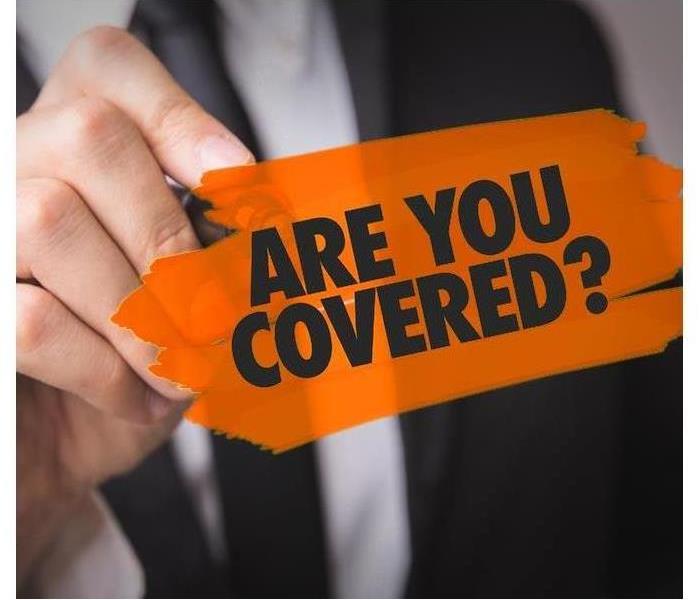 If disaster strikes SERVPRO can help by working with your Insurance agent or adjuster.
If disaster strikes SERVPRO can help by working with your Insurance agent or adjuster.
A question everyone should ask themselves, "Do I understand my homeowner’s insurance?"
This is a question everyone should ask themselves, Do I understand my homeowner’s insurance Policy?
SERVPRO of West Riverside City has witnessed many who have a misunderstanding of how insurance coverage works or what is covered. Protecting your home and valuables with coverage will give you more security if you have a good understanding. Many policies are different and insurance carriers also have different guidelines or stipulations that you should be aware of. After reviewing this article from Investopedia make an appointment with your insurance agent and have them go over your policy. You will feel more at ease if damage occurs to you home or you experience water or fire loss and you understand exactly what is covered.
Here are a few tips from Investopedia Homeowners Insurance Guide: A Beginners Overview-by Troy Segal:
- Homeowners insurance policies generally cover destruction and damage to a residence's interior and exterior, the loss or theft of possessions, and personal liability for harm to others.
- Three basic levels of coverage exist: actual cash value, replacement cost, and extended replacement cost/value.
- Policy rates are largely determined by the insurer's risk that you'll file a claim; they assess this risk based on past claim history associated with the home, the neighborhood, and the home's condition.
- In shopping for a policy, get quotes from at least five companies, and definitely check with any insurer you already work with—current clients often get better deals.
The article covers "What a Homeowner Policy Provides"
Some key takeaways:
- If you experience damage from fire, lightening, vandalism and other covered disasters you can be compensated for repairs or rebuild.
- If maintenance on your property is lacking it can impact coverage, such as roofing that may need to be replaced. If rain causes a leak due to this, it may not be covered. It is important to keep up the maintenance of your home and keep records of those updates.
- Most contents within the home would be covered if destroyed or damaged.
- It is advised that you check with your insurance agent regarding coverage for valuables such as jewelry. There may be a dollar limit and additional coverage may be needed.
The article also discusses the "Different Types of Homeowners Coverage":
There are essentially three levels of coverage.
Actual cash value
Actual cash value covers the cost of the house plus the value of your belongings after deducting depreciation (i.e., how much the items are currently worth, not how much you paid for them).
Replacement cost
Replacement value policies cover the actual cash value of your home and possessions without the deduction for depreciation, so you would be able to repair or rebuild your home up to the original value.
Guaranteed (or extended) replacement cost/value
The most comprehensive, this inflation-buffer policy pays for whatever it costs to repair or rebuild your home—even if it's more than your policy limit. Certain insurers offer an extended replacement, meaning it offers more coverage than you purchased, but there is a ceiling; typically, it is 20% to 25% higher than the limit.
It’s a good idea to compare coverage with different Insurance companies. If premiums seem cheaper with one company, it could mean some coverage may be lacking. It's important to compare prices and coverage!
Should you experience damage from water or fire, remember to contact SERVPRO of West Riverside City before submitting a claim. We can help determine from our free inspection whether the damage might be covered by your insurance and if it is worth the claim based on your deductible. We are here to help. We can make it, "Like it never even happened."
SERVPRO of West Riverside City
951-351-8033
Local Experts Are in Your Corner When You Need Home Restoration | SERVPRO of West Riverside City
2/17/2021 (Permalink)
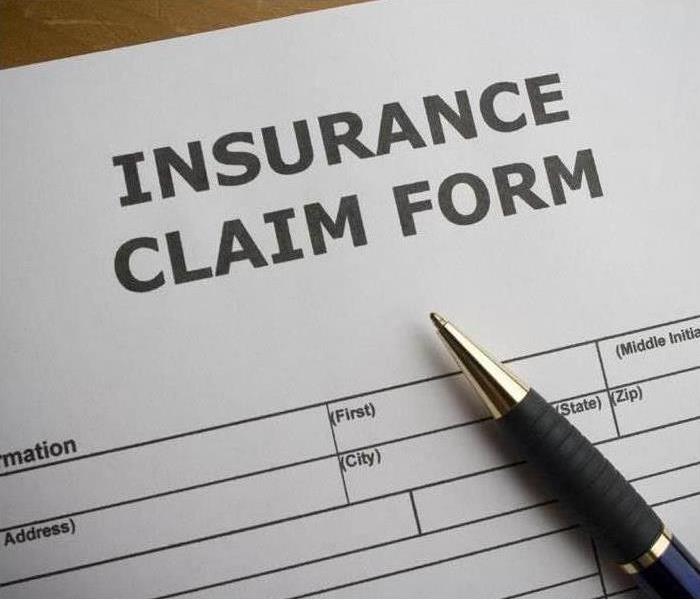 The sooner they can get the repair process started, the better the outcome is likely to be.
The sooner they can get the repair process started, the better the outcome is likely to be.
Every homeowner who files an insurance claim for home repair and restoration in 2021 will have one thing in common. What is it?
The sooner they can get the repair process started, the better the outcome is likely to be.
Homeowners' insurance claims vary widely in type and severity. Sometimes they’re from severe weather issues, like wind, hail and rain. They can also be caused by home accidents and appliance malfunctions.
The level of damage can vary, too. Sometimes homeowners need help repairing basement water damage or repairing mold damage. In other cases, the repairs and restoration work needed is more extensive.
Why Timing Matters
So, you may be wondering why starting early to repair damage to your home is so important.
Some types of home damage only grow worse over time. And the process progresses faster than you might expect.
For example, water damage can cause wood to warp within days. And the smoke, soot and water damage resulting from a fire worsen over hours and days. You can even notice the first signs of mold within a few hours. The longer these problems persist, the more difficult it is to remediate and repair them.
Move Fast When You Need Home Restoration
Your local SERVPRO team understands why it’s so important to get your home restoration process moving quickly. We’re always prepared to help you when an emergency arises.
You can reach out to our team at any time when you need home restoration and repairs. We’ll answer 24⁄7 to help you get the process started. You can trust us to be here when you need our help.
Beyond speed, there are plenty of other reasons, so many residents trust us to do their restoration work.
Our technicians are educated experts. Our technicians are passionate about providing the best services and work possible. That means they’re consistently going through training and earning certifications. They bring that knowledge to work on your home.
Our teams use proven, leading-edge technology. We’re connected with a nationally known and trusted brand. That means we have access to some of the best restoration technology available today.
We are a local business. We are members of the local community. That means when you call us, you’re calling friends and neighbors who are ready and prepared to help you when you reach out.
If your home is damaged due to fire, water or any other cause, you can always count on us for restoration assistance. We have teams who are available 24⁄7 in the event of an emergency. Contact us at any time to learn more about our restoration services and how we can help your family.
Have You Considered SERVPRO for Your Commercial Cleaning Services?
2/15/2021 (Permalink)
 Contact SERVPRO of West Riverside City for one time cleaning or as needed. 951-351-8033
Contact SERVPRO of West Riverside City for one time cleaning or as needed. 951-351-8033
SERVPRO franchise professionals offer cleaning services including the removal of biohazard contaminants. We have the specialized training and products to get your property back to business.
We are Here to Help® Get Your Business Back to Normal
SERVPRO is being called on by numerous businesses and community leaders to perform the necessary bioremediation services to clean, disinfect and sanitize their properties. All of our cleanup practices are in accordance with the guidelines provided by the CDC and local authorities. If you are interested in inquiring about our services we’re here to help – 24 hours a day, seven days a week, while life gets back to normal in the communities we all call home.
The CDC recommends usage of a labeled hospital-grade disinfectant with claims against similar pathogens to the coronavirus. Multiple products in the SERVPRO product line meet this standard and carry the EPA-registered emerging pathogens claims. While there is currently no product tested against this particular strain of the coronavirus, we are following all guidelines as provided by the CDC and local authorities.
SERVPRO can respond quickly and effectively to help minimize business interruption to your company.
SERVPRO franchise professionals are uniquely prepared during this unprecedented time to clean and disinfect your home or business according to the protocols set forth by the CDC. We have years of experience in dealing with biological contaminants, and we will go beyond the scope of work that regular janitorial staff perform on a daily basis.
The CDC encourages cleaning of high-touch surfaces such as counters, tabletops, doorknobs, light switches, bathroom fixtures, toilets, phones, keyboards, tablets, and tables at a minimum.i These same surfaces are mentioned in the CDC’s guidance for commercial spaces as well.ii
The CDC also recommends regular cleaning of the following areas/items:
- Kitchen/Food Areas
- Bathrooms
- Schools/Classrooms
- Offices
- Retail Spaces
- Water Fountains
- Shelving/Racks
- Sales Counters
- Carpets and Rugs
- Stair Handrails
- Elevators and Escalators
- Playground Equipment
- Fitness Equipment
SERVPRO professionals are trained to perform a proactive cleanup that involves facility or structure cleaning and disinfection. Cleanup procedures generally include cleaning of porous and non-porous surfaces, disinfecting of non-porous surfaces, cleaning and disinfecting of equipment, tools, and/or supplies used for cleanup process, and disposal of waste.
i https://www.cdc.gov/coronavirus/2019-ncov/community/disinfecting-building-facility.html
ii https://www.cdc.gov/coronavirus/2019-ncov/specific-groups/guidance-business-response.html
iii https://www.cdc.gov/coronavirus/2019-nCoV/summary.html
iv https://www.cdc.gov/coronavirus/2019-ncov/about/transmission.html
Keeping the Work Place Safe
Encourage your employees to...
- Stop shaking hands – use other noncontact methods of greeting
- Clean hands with sanitizer or wash their hands frequently
- Avoid touching their faces and cover coughs and sneezes
- Disinfect surfaces like doorknobs, tables, desks, and handrails regularly
- Increase ventilation by opening windows or adjusting air conditioning
Be Careful with Meetings and Travel
- Use videoconferencing for meetings when possible
- When not possible, hold meetings in open, well-ventilated spaces
- Consider adjusting or postponing large meetings or gatherings
- Assess the risks of business travel
Handle Food Carefully
- Limit sharing food with others
- Strengthen health screenings for cafeteria staff and their close contacts
- Ensure cafeteria staff and their close contacts practice strict hygiene
Stay Home if...
- They are feeling sick
- They have a sick family member in their home
About Coronavirus
The CDC is responding to an outbreak of a respiratory disease caused by a novel (new) coronavirus that was first detected in Wuhan City, Hubei Province, China and has spread to 60 locations internationally (as of this publication), including cases in the United States. The virus known as “coronavirus disease 2019” (abbreviated “COVID-19”)iii is thought to spread mainly from person-to-person or through respiratory droplets when an infected person coughs or sneezes. It may be possible that a person can get COVID-19 by touching a surface or object that has the virus on it and then touching their own mouth, nose, or possibly their eyes, but this is not thought to be the main way the virus spreads.iv
SERVPRO of West Riverside City is trained in adhering to the highest cleaning and sanitation standards.
5 Ways to Keep Safe During Lightning Storm
2/10/2021 (Permalink)
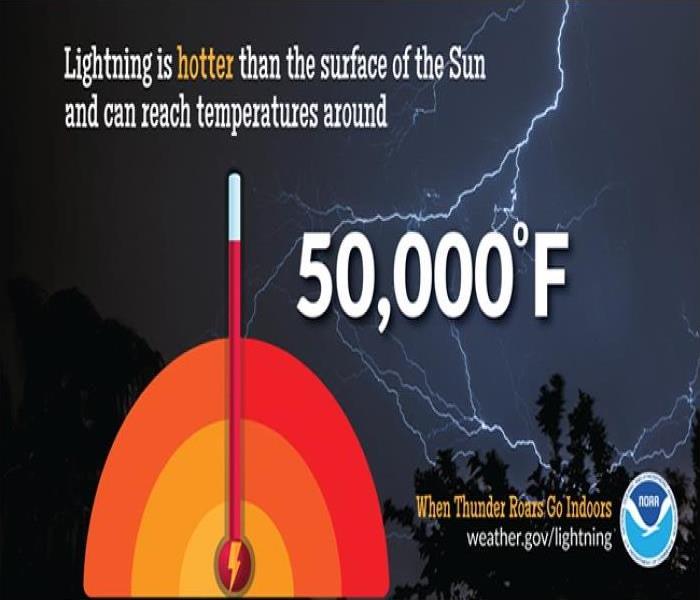 Lightning can be very dangerous, Call us if you have questions or are impacted by lightning or flooding. We're here to help!
Lightning can be very dangerous, Call us if you have questions or are impacted by lightning or flooding. We're here to help!
Each year in the United States, there are about 25 million cloud-to-ground lightning flashes and about 300 people struck by lightning. ¹?
Those are some sobering statistics you may want to keep in mind the next time you are trying to decide whether to play one more hole of golf or hike an extra mile when a potential storm may be brewing.
While summer is commonly known as the peak season for thunderstorms and lightning, such storms can strike any time and in almost any location year-round. The following guide and tips can help you and your loved ones stay safe and secure should you be caught in a lightning storm.
- How Should I Protect Myself?
It is important to understand that there is no safe place outside during a lightning storm. If thunderstorms are expected, you should stop any outdoor activities quickly — even if you are still mowing the lawn or enjoying a picnic. Many lightning casualties occur because people fail to seek shelter soon enough. Keep an eye on local weather conditions and have a plan if thunderstorms are expected. Your home’s best protection against a lightning strike is a lightning protection system. In order to find out more you can contact a certified lightning protection specialist for information.
- What if I am Outside During a Storm?
As soon as you hear thunder, stop all outdoor activities and get into a building or a hard-topped vehicle for safety. It may be tempting to get into a golf cart or a lean-to, but those will not provide adequate protection. If you absolutely cannot get to safety, try to stay away from open fields, hilltops, tall trees or other tall objects. Go to the lowest place possible, such as a ravine or valley, and squat in a baseball catcher’s position — with your heels touching, ears covered, and head between your knees. Minimize contact with the ground and do NOT lie flat. You should avoid water and anything metal, such as golf clubs or bicycles.
Exit the road or highway you are on and park in a safe location. Stay in the vehicle and turn on emergency flashers until the storm subsides. Avoid touching metal or other surfaces that can conduct electricity.
You may think that watching television or shopping on-line are good ways to pass the time during a storm, but your best bet is to unplug televisions, computers and any other high-value electronics well before the storm hits. Once the storm begins, do not touch any electrical equipment or cords, including corded phones. It is OK to use cellular or cordless phones during the storm. Be sure to stay away from windows and doors and do not go on porches. Also avoid taking baths or showers during storms. Water is a conductor of electricity so if a lightning strike hits your house during a storm, it may travel through water and shock you in the bath or shower.
- What if My House is Hit by Lightning?
If you think your home has been struck by lightning call 911 immediately and evacuate if you see fire or smoke. You may want to ask your local fire department to check for hot spots in your walls. If you use gas for heating and cooking, contact your gas company or a licensed contractor to conduct a leak test before re-entering your home. Gas system components have been known to sustain punctures as a result of direct or nearby lightning strikes.
Sources:
¹NOAA, http://www.weather.gov/lightning
Contact SERVPRO of West Riverside City
We can help when storms hit! Whether its damage from lightning, rain, wind, or flooding we have the knowledge and experience to help.
Call us 24/7
951-351-8033
Let Us Help You Worry Less When a Fire Strikes in your Riverside Business
2/8/2021 (Permalink)
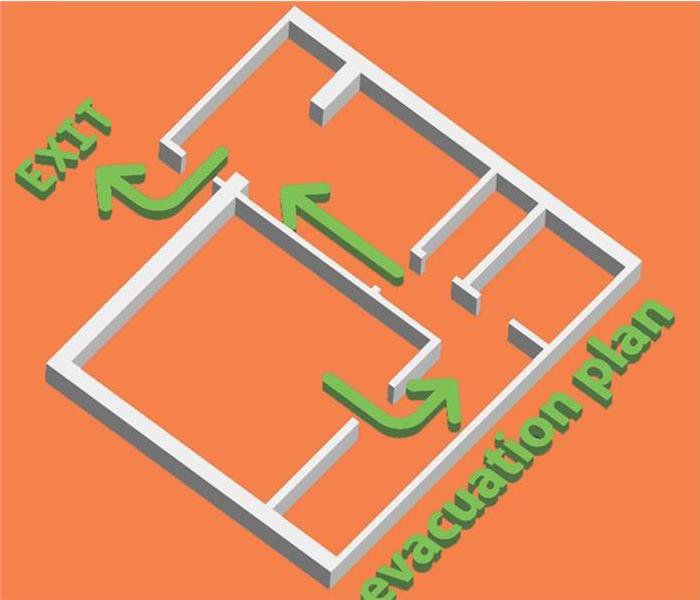 For the safety of your employees, establish escape routes within your map.
For the safety of your employees, establish escape routes within your map.
Worrying about the cleanup and restoration can be stressful, and many business owners are left with a feeling of helplessness and uncertainty.
SERVPRO Franchise Professionals know restoring peace of mind is just as important as restoring property.
This blogprovides information on the steps to take in an effort to prevent costly secondary damage to your property and possessions should a fire strike your home or business. It also reinforces the importance of being prepared and having a fire escape plan in place.
Your local SERVPRO’s Franchise Professionals want to be there in your time of need, helping you and your customers piece their lives back together.
Our goal is simple:
In an emergency situation, like a building fire, every second counts. How quickly you respond could depend on how prepared you are before the emergency. Emergency planning and training directly influence the outcome of an emergency situation. Facilities with well-prepared employees and well-developed plans are likely to incur less structural damage and fewer or less severe employee injuries.
Local Exits
During a fire, the highest priority it getting everyone out of the building, which means having an emergency escape plan. You should establish two escape routes that move people outside simply and efficiently. Then, you should highlight these routes on a clearly marked map. This map should be displayed as well as included in the written plan. Don't forget to designate a meeting spot outside of the building to gather everyone after evacuation; that way you can make sure everyone is accounted for and regroup. When choosing emergency exits, consider the following recommendations.
- Exits should be clearly marked as well
- Exit routes should be wide enough to accommodate the number/volume of evacuating person
- Exit routes should remain unobstructed and clear of debris at all times.
Assign Duties
A fire escape plan should also include which people are to be doing what during an emergency. Each unique situation may require different or specialized roles, like safety protocols specific to a lab. However, there are some basics that are almost always covered:
- someone in charge of communications; this includes being in charge of contact information
- section leaders who may be in charge of rounding people up to leave and keeping count
- someone designated to call 911 or coordinate with the authorities
- someone in charge of contacting and overseeing fire remediation services
Train Employees
If you want your plan to run smoothly, you should practice. Your employees need to be familiar with the plan to optimize safety. Make sure to simulate an emergency fire situation and use the evacuation routes at least twice per year. Include education about stopping, dropping and rolling- a technique used if your clothes are on fire. Additional fire safety tips include getting low to avoid inhaling smoke and testing door handles before grabbing them.
Emergency preparedness is essential for the safety of any workplace or commercial space. As a responsible business owner you should put together a fire escape plan as soon as possible, and keep it current as time rolls on.
If you are prepare drawings that show evacuation routes and exits, post them prominently for all employees to see. Once an escape plan is created, it should be practiced to help familiarize staff with emergency exit routes. It is important to talk to your local fire department, as local codes may require more frequent drills for various facilities.
Your local SERVPRO Franchise Professionals can help with emergency planning by establishing an Emergency READY Profile, (ERP), for your facility. For more information about the ERP or emergency planning, contact:
SERVPRO of West Riverside City
951-351-8033.
How To Properly Maintain Your Riverside Commercial Irrigation System
2/3/2021 (Permalink)
Basic Irrigation Maintenance
Having a properly maintained irrigation system is essential to the well-being of your commercial property. By relying on this technology to water your lawn and plants, you can save a significant amount of time while enhancing the appearance of your business’s exterior. To consistently keep your Riverside, property in top condition, it’s crucial to maintain your irrigation system properly. Here are some basic irrigation maintenance guidelines that can help you preserve the appearance of your commercial property.
Schedule Regular Inspections
To confirm that everything is in working order, be sure to schedule a regular checkup with your landscape company. During scheduled maintenance, your landscaper can inspect any of the following areas:
- Sprinkler heads
- Valves
- Nozzles
- Pipes
In addition to examining these parts, a professional may give your irrigation system a good cleaning to keep it in proper shape. Remember to schedule these inspections at least twice a year to ensure that there are no leaks or other issues that may lead to sprinkler flooding.
Use in Moderation
To ensure that your irrigation system is at its best, always use it in moderation. Save your sprinklers for dry days only and don’t let them run all day long. Instead, try to set your irrigation timers to go off in the early morning, preferably between 4 a.m. and 10 a.m. Not only can this irrigation maintenance strategy ensure that you don’t get your customers wet, but it also allows the water to reach down to your grass’s roots without being affected by intense sunshine or high winds.
Perform a Plant Audit
Be sure to give your plants the right amount of attention when running your sprinklers. Newer plants need more nourishment than older plants, so adjust your irrigation timers accordingly. This ensures that your plants aren’t overwatered and keeps sprinkler flooding at bay.
Maintaining your irrigation system is a crucial part of your job. However, if your sprinkler system causes any water damage despite your best irrigation maintenance efforts, be sure to call commercial building restoration services to bring your business back to normal.
Contact SERVPRO of West Riverside should you experience water damage from irrigation that has caused damage to your commercial building. We are experienced with commercial building and have years experience with water damage.
SERVPRO of West Riverside City
951-351-8033
What is Really Going on Behind Closed Doors
2/1/2021 (Permalink)
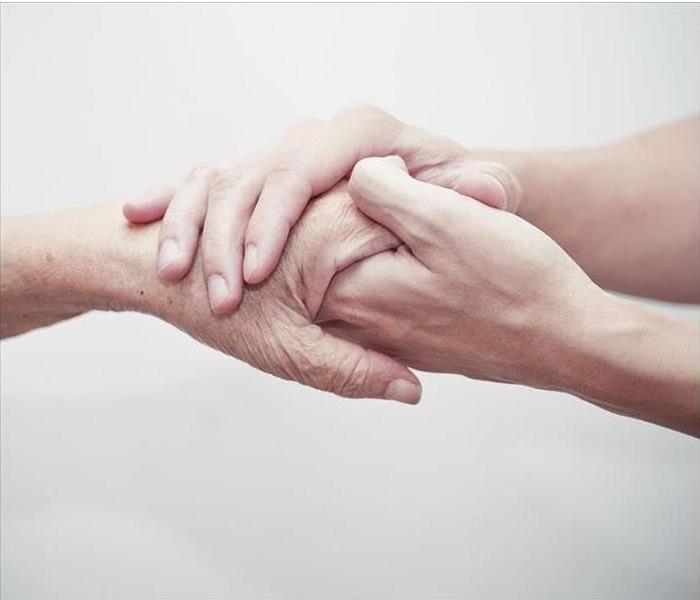 We are here to help for those sensitive situations.
We are here to help for those sensitive situations.
What do all the following have in common?
Crime Scene Clean Up, Meth Labs, Vandalism, Unattended Deaths, Flooding, Sewage, Smoke Damage, Mold, Hoarders, Infectious Disease Contamination, Bat Guano, Homeless Encampment Clean Up, Medical Waste, Industrial Accidents, Animal Feces, Suicide and Flooding
They are ALL Bio-hazards!!!
Unfortunately, bio-hazard claims tend to be very expensive. Most of us do not plan to handle a bio hazard situation. Whether you are a homeowner, insurance agent, property manager or real estate broker some of the issues you are apt to face include:
- Health & Safety of occupants/insured
- Cost to clean the bio-hazard
- Response times of cleaning company—longer response times increases damage and cost
- Selling or renting a property after a bio-hazard/stigmatized properties
- Stalling sales time
- Disclosure issues and liability
What can you do about it? Well, it is nearly impossible and quite unimaginable to plan for a bio-hazard situation, but here are some tips that may help:
Have a plan and a reliable company you can turn to in a time of crisis.
Know who to call?---I hear SERVPRO is very GOOD
- Faster response times will limit and/or reduce damages.
- Use certified and reputable vendors with bio-hazard experience and training in order to reduce liability and overall cost.
Remember to have compassion for the clients
- Keep in mind that clients are often traumatized by these incidents.
- Fast restoration response times go a long way towards helping clients move forward emotionally.
- Use professional vendors that are trained to treat clients with compassion.
Find out about the procedures and relative costs of a bio-hazard clean up
- Bio-hazards can be one of the most expensive claims, but if you have an idea of what your restoration vendor will be doing it will help you to understand the costs better and guard against bad vendor price gouging.
- Use vendors that have a scientific and approved protocol for addressing a bio-hazard
- Check out this link to The Insurance Journal to get an idea of what procedures are followed by professional bio-hazard restoration vendors.
Dealing with a biohazard can be very traumatic and at times confusing. SERVPRO is a specialized vendor that is trained and certified to deal with bio-hazard situations. If you have questions concerning bio-hazard issues, give us a call at 951-351-8033 and we will be happy to answer any of your questions.
SERVPRO of West Riverside City has the certification to handle BIOHazard, bloodborne pathogens, or infectious disease. We can handle all emergencies.
SERVPRO of West Riverside
951-351-8033
https://www.SERVPROwestriversidecity.com/trauma-crime-scene-cleanup
Do you Have a Septic Tank in your Riverside Home?
1/27/2021 (Permalink)
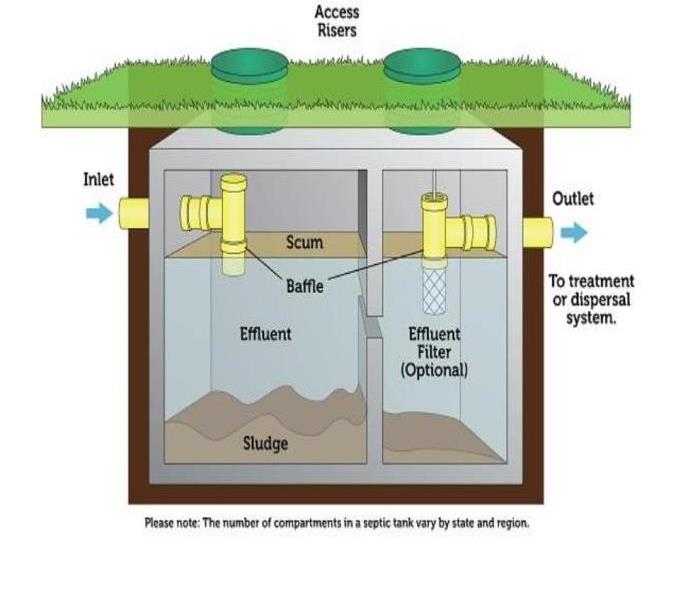 SERVPRO of Riverside City has the certification to handle sewage leak. We are here to help!
SERVPRO of Riverside City has the certification to handle sewage leak. We are here to help!
We don't run into too many septic system overflows in this part of Riverside, but if you happen to live or have a property in a rural area, for sure you have an idea about how septic tanks and the septic systems work.
One way you’ll know if it’s maintained properly is if you don’t smell anything unpleasant coming from it. Now, there are a number of crucial do’s and don’ts to live by to ensure that your septic tank will last for as long as possible and that your septic system works the way it should. Here they are.
DO use high-quality toilet tissue only.
When shopping for toiletries, pick a toilet tissue that’s been proven to break up easily when wet. This way, it won’t cause any trouble when it’s already in your septic tank.
DO keep trees away from the septic system.
There are trees which have roots that grow and extend aggressively. They should be kept far from the septic system to avoid any damage. You can plant grass instead in the drainfield area to prevent and minimize the instances of soil erosion.
DO divert rainwater away from the drainfield.
When the drainfield is soggy, it would have challenges in absorbing liquid wastes. To prevent this, landscaping and foundation drains should be planned and executed accurately. Consult a professional regarding this matter.
DO perform regular maintenance.
Make sure your septic tank is maintained every one to three years by a professional. Now, the frequency of having your septic tank pumped will depend on its size, the amount of solids that go into it, and the volume of wastewater. It’s best to consult a professional again to know how often you should have your septic tank maintenance done.
DON’T allow an excessive amount of water to be discharged into the septic system.
It will cause the system to back up and will also affect the biological balance within the septic tank.
DON’T dump grease down the drain.
Grease can build up in the septic tank and plug the sewer pipes. So be sure it doesn’t find its way on the drain by having a separate container for it.
Have you Experienced Septic Tank Issues? Here's what you should know
Watch out: sewage spills contain contaminants that can cause serious illness or disease. Disease causing agents in raw sewage include bacteria, fungi, parasites, and viruses and can cause serious illnesses including Hepatitis A.
If a building has been flooded by sewage or wastewater there may be unsafe electrical wiring, bacterial and pathogen hazards, mold hazards, even unsafe mechanical systems.
- Turn off electrical power in the area that has been flooded if there is any chance of electrical wires, extension cords, or electrical appliances or fixtures coming in contact with standing water or wet materials
- Vacate sewage-contaminated areas right away. Areas of sewage spill should not be occupied by people who are not wearing appropriate protective equipment as they are dangerous:
- Stop flushing toilets
- Turn off running water that is sending water into the drain system (clothes washer, sinks etc)
If the sewage or wastewater are being spread by water from a burst plumbing supply or hot water heating pipe, turn off the water to the building and if needed for safety or to stop further you may also need to turn off the (hot water or steam) heating system.
Items that have been soaked and are not salvageable may best be placed outdoors. By removing wet and contaminated materials from the building it may be easier to inspect, repair leaks, and clean the building itself.
Watch out: do not handle sewage-contaminated materials without proper personal safety protection: there are bacterial, pathogenic, respiratory and infection hazards.
- Act promptly.
- Watch out: The longer that sewage waters remain in a building or on its contents the greater the chance of spreading illness or disease and the greater the chance of causing a costly mold contamination problem in addition to the sewage problem. High indoor moisture caused by standing water can cause mold contamination to form on other building surfaces even if they were not directly wet by the sewage spill.
- Don't panic: while prompt action is needed as we just explained, don't be in such a rush that you do something dangerous. Also, if you sound terrified when calling a contractor for assistance the result may be the imposition of inappropriate or costly steps.
- Call a professional water damage restoration authority - For other than a trivial spill on a tiled bathroom floor you may need help from a professional water damage or restoration company.
- Notify your insurance company that there has been a sewage spill in the building
- Notify your municipal authority or sewer department if your home is connected to a public sewer
- Contact your local health department for advice if your home is connected to a private septic system
SERVPRO of Riverside City has the certification to handle sewage leak. We are here to help!
Chemical Drain Cleaners: Should They be Used on Your Riverside Home?
1/25/2021 (Permalink)
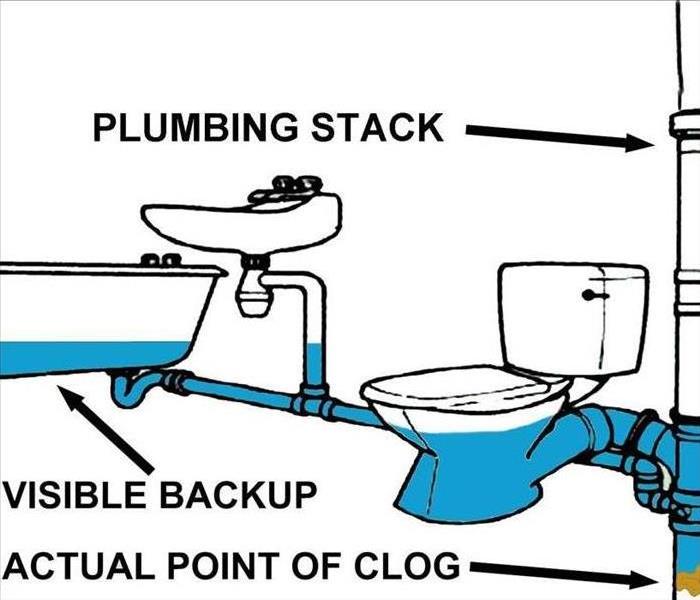 There are some drawback using chemical drain cleaners, be informed!
There are some drawback using chemical drain cleaners, be informed!
Are you pouring and flushing the wrong things down your pipes? Have you ever had water damage at your property because water was coming out of your toilets, bathtubs, or sinks?
Most water damage at times is caused due to the fact that a main line got clogged. If it's an indoor blockage, it could have occurred because of heavy materials or objects being flushed down into the drain. Blocked drains are often caused by sanitary products, paper towels or other hard to flush materials which can clog pipes and obstruct drains.
When you pour grease down the drain it sticks to the inside of your pipes and the pipes in the street. This can cause the entire pipe to become clogged over time. Other oil-based products are also dangerous to pour down your drain, such as... cooking oil, salad dressings, butter, mayonnaise, and fat.
Are Chemical Drain Cleaners the Best Option?
A clogged drain has frustrated residents of homes across Riverside City. The fast and easy solution is to pour a bottle of commercial drain cleaner down the problem drain to clear away the blockage. Do they work? Can they damage your home's pipes? Here are some facts and a few tips on alternatives:
Chemical Drain Cleaners
Widely-used and powerful, chemically-based cleaners (caustic, oxidizing, and acid types) can help open up a partially clogged drain. They work by generating heat to break down a clog until it can be flushed out. However, there are drawbacks to their use:
They often just move clogged material farther down a drain pipe, where it can re-accumulate or cause a sewage backup that requires professional sewage cleaning services.The chemical gel can settle and corrode pipes if it's unable to push through a completely blocked drain.If pipes are old or made of plastic, the cleaner's chemicals will warp and permanently damage them if used repeatedly.Chemical cleaners are toxic and harmful to people, pets and the environment.Alternatives to Chemical Drain Cleaners
There are safer ways to clear blocked drain pipes. Mechanical options include flexible drain snakes or augers. Available in manually-operated, hand-cranked, battery-operated and electric models, this device can successfully clear drains without resorting to calling in a professional.
Enzymatic drain cleaners use bacteria or enzymes to devour organic materials like the hair, soap and food waste that collect and clump in drains. Although this biological option requires more time to clear a clogged drain — typically 24 hours — it's non-toxic and environmentally safe.
There are many home remedies, including the use of clothes hangers, wet/dry household vacuums and various mixtures of natural ingredients like salt, baking soda, vinegar and boiling water. All are effective depending on the severity of the clog.
Whether in the kitchen or bathroom, there are a range of proven solutions to stubborn blocked drains. With mounting concerns about health and the environment, chemical drain cleaners should be the option of last resort.
Flood Insurance, what you should know living in Riverside County
1/20/2021 (Permalink)
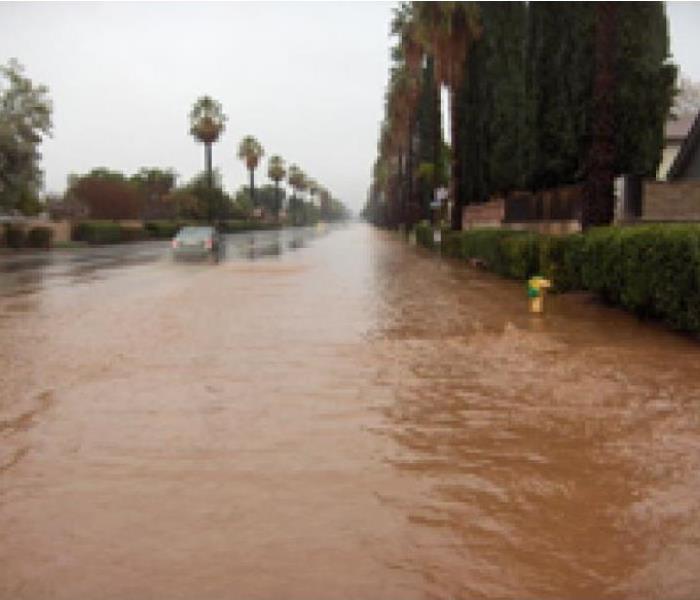 It may be necessary to purchase flood insurance policy to protect your investment from floods.
It may be necessary to purchase flood insurance policy to protect your investment from floods.
Many do not realize that flood damage is not typically covered by homeowners’ insurance policies, so it’s important to have an understanding.
We hope this information serves as a helpful resource.
It may be necessary to purchase flood insurance policy to protect your investment from floods. Just because you haven’t experienced a flood in the past, doesn’t mean you won’t in the future.
Here is some information from Riverside County Flood Control and Water Conservation District
National Flood Insurance Program
The National Flood Insurance Program, or NFIP for short, offers flood insurance, which can be purchased through the insurance agent who handles your homeowners’ insurance policy. Rates are set and do not differ from company to company or agent to agent. These rates depend on many factors, which include the date and type of construction of your home, along with your building’s level of risk.
What's included with building coverage:
- The insured building and its foundation
- The electrical and plumbing systems
- Central air conditioning equipment, furnaces and water heaters
- Refrigerators, cooking stoves and built-in appliances such as dishwaters
- Permanently installed carpeting over unfinished flooring
- Maximum coverage is $250,000
What's included with content coverage:
- Clothing, furniture and electronic equipment
- Curtains
- Portable and window air conditioners
- Portable microwaves and dishwashers
- Carpeting that is not already included in property coverage
- Clothing washers and dryers
- Maximum coverage is $100,000
What's not Covered:
- Damage caused by moisture, mildew or mold that could have been avoided by the property owner
- Currency, precious metals and valuable papers such as stock certificates
- Property and belongings outside of an insured building such as trees, plants, wells, septic systems, walks, decks, patios, fences, seawalls, hot tubs and swimming pools
- Living expenses such as temporary housing
- Financial losses caused by business interruption or loss of use of insured property
- Most self-propelled vehicles such as cars, including their parts
NFIP flood insurance policies are available to homeowners, renters, condo owners/renters, and commercial owners/renters.
How Do I Find Out if I’m in a Flood Zone?
The Federal Emergency Management Agency maintains official flood zone maps, which designate areas with the greatest risk of flooding. To find the designation for your home in Riverside County, go to FEMA’s Map Service Center and enter your address. Note: If you have a hard time loading the FEMA map, a more user-friendly version is available here.
FEMA’s flood maps display more than a dozen category codes, but they all fall into one of three main zones:
- High-Risk Zone
This is any area with a FEMA map code beginning with the letters A or V. It’s also referred to as the “100-year floodplain.” Each year, this zone has a 1% chance of experiencing a catastrophic flood. If you’re in a high-risk flood zone, flood insurance is usually required. Unfortunately, flood insurance is most costly for homes in high-risk zones.
- Moderate-to-Low-Risk Zone
This is an area with a FEMA map code beginning with B, C, or X. It is also referred to as the “500-year floodplain.” This zone has a 0.2% chance, each year, of a destructive flood event. Flood insurance is not mandatory in this zone, but it is still strongly encouraged. Flood insurance is considerably less expensive for this zone than for high-risk zones, especially when compared to the costs of storm damage cleanup after a devastating flood.
- Undetermined-Risk Zone
These areas may have a FEMA map code beginning with the letter D, or they may have no FEMA flood code. This doesn’t mean your home won’t flood. Heavy rainfall frequently causes flash flooding in all parts of the country.
There are many reasons you might want to know your property’s official flood zone designation: You may be considering selling your house, or maybe you’ve been thinking of buying flood insurance. In any case, understanding your risk level is key to protecting your home from flood damage.
Check out this link to look up your home or business
https://www.lsc.gov/flood-zone-lookup
For more information, contact your insurance agent
Visit FloodSmart or the National Flood Insurance Program (NFIP)
How to Prevent Work Related "Accidents" Due to Lack of Sleep
1/18/2021 (Permalink)
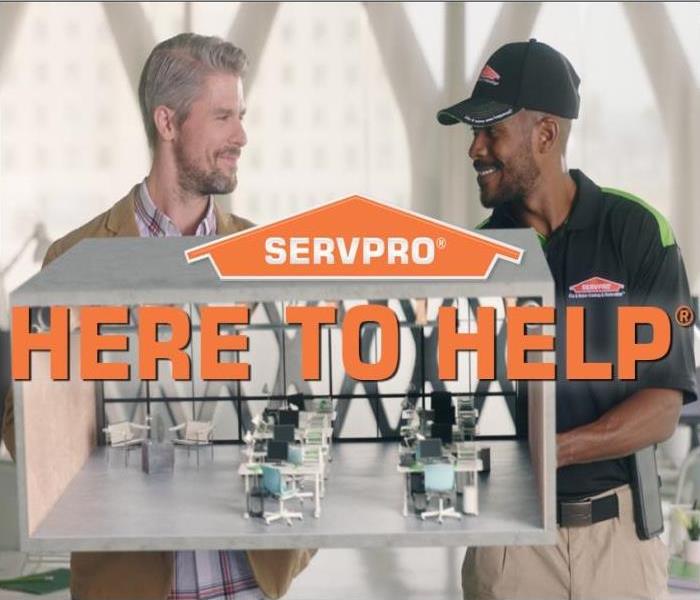 Should your business experience a loss, we are a phone call away. 951-351-8033
Should your business experience a loss, we are a phone call away. 951-351-8033
One thing most of us can relate to is being tired.
Our lives are busy and sometimes we feel like there are not enough hours in the day to get through our to-do lists. One thing I hope we can all learn to agree on is that being sleepy really is a hazard and sometimes can be quite dangerous in the workplace. Lack of sleep can lead to multiple consequences that may have a huge effect on us, our work, and our coworkers. Sleepiness can lead to:
- Accidents can happen no matter what, this is why they are called “accidents”. However, we put many precautions in place to help prevent accidents from happening. Getting enough sleep is a good way to do your part in preventing an accident.
- Memory Issues can cause many problems for you in the workplace. Being well-rested and at the top of your memory game will be appreciated by your coworkers and your customers. It’s quite normal to forget once in a while but if you are sleep deprived, your memory loss may very well be affecting your work.
- Difficulty with Thinking and Concentration this can also be an annoyance to you and your coworkers when you are all trying to do the best job you can do. When you are well-rested, you are more likely to do a better job.
- Mood Changes can be difficult for you, your coworkers, and can be detrimental to your customers. Being well-rested can limit your mood changes and keep you more consistent.
- Weakened Immunity definitely affects your workplace. When your immune system is weak, you are likely to get sick more often. This may keep you from work which puts more pressure on your coworkers to pick up the slack.
Having one, let alone several, of these side effects from lack of sleep can be dangerous in the workplace. Please be mindful of taking care of yourself by resting when your body and mind are tired. This not only protects you but could possibly prevent you from inadvertently making a bad decision or causing an accident that could affect someone else.
Accidents can also impact the business whether it be productivity or damage to the facility. Incidents can happen in the lunchroom causing property damage.
Should your business experience a loss, we are a phone call away.
SERVPRO of West Riverside City,
We can be reached 24/7 at 951-351-8033.
Check out our Website:
https://www.SERVPROwestriversidecity.com/
Why SERVPRO? We Strive to Minimize Interruption to Your Riverside Life
1/13/2021 (Permalink)
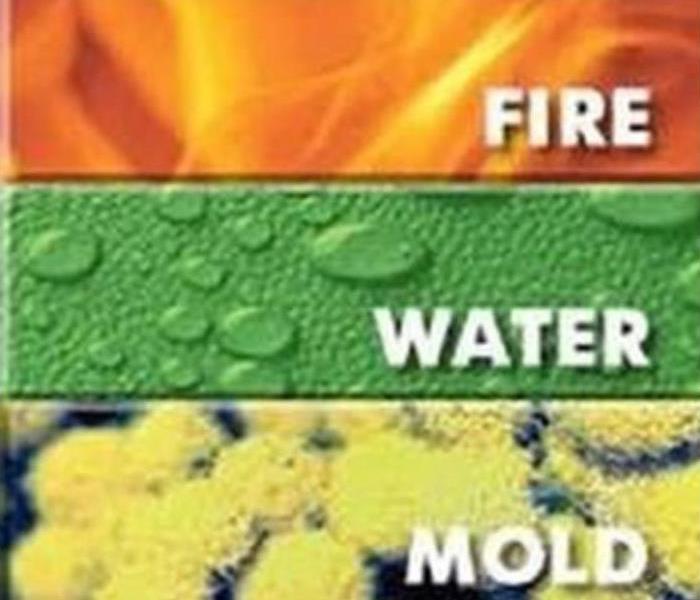 SERVPRO of West Riverside City has a solution for every kind of disaster that strikes and damages your home. Call (951) 351-8033
SERVPRO of West Riverside City has a solution for every kind of disaster that strikes and damages your home. Call (951) 351-8033
With a keen understanding of the challenges our Riverside, CA customers face after water, fire, mold, or storm damage, our team is committed to turning trauma and chaos around quickly and compassionately.
The ability to provide wrap-around mitigation, remediation, and rebuilding services minimizes the stress for our customers. You can engage just one highly-qualified contractor to take your home from devastated to “Like it never even happened,” using our Institute of Inspection, Cleaning and Restoration Certification (IICRC)-trained managers and technicians.
Water Damage
Regardless of the source, water damage in Riverside brings your day to day household agenda to a halt. Waiting even a day or two before starting mitigation and remediation efforts exposes the structural components inside your dwelling to progressively more severe damage. Postponing a professional assessment and follow-up recovery work also increases the risk of mold growth and damage, causing even more damage to the many organic surfaces in your house.
One call delivers an experienced and caring crew of SERVPRO IICRC-certified managers and technicians to your door. Our employees can handle any residential water damage scenario. From finding the water main shut off to opening the door for you and your family when you return to a fully remediated and rehabbed home, we have you covered. Our service vehicles carry all the equipment needed to commence and complete a water mitigation and remediation job. As our project manager and estimator assess the damage, they create a project plan. Then our Water Damage Restoration Technicians (WRT) are ready to start water removal tasks without further delay.
Throughout the project, we measure moisture levels and use thermal imaging to find any pockets of migrated water. At times we must use controlled demolition strategies such as flood cuts in drywall or weep holes in ceilings. The initial moisture data forms the baseline for drying goals we meet with a configuration of air movers, heaters, and dehumidifiers.
Fire Damage
The aftermath of fire damage in Riverside is almost too much for a homeowner to process. It is nearly impossible for someone unused to the destruction a blaze can inflict to know where to start the cleanup. Fire residues are also highly toxic, dangerous to handle without personal protective equipment (PPE), and challenging to clear away with ordinary household tools and products. We are uniquely qualified to help members of our community recover from the effects of a fire, no matter how it started or how extensive the damage.
Fire damage mitigation and remediation typically start with removal of the water and chemicals the fire department used to quell the flames. The multiple certifications SERVPRO employees hold from the IICRC are of great benefit to our customers, as our crews efficiently manage first the water and then the soot removal. The assessing crew chief puts together a thorough task agenda, and our Fire and Smoke Restoration Technicians (FSRT) match cleaning products and tools to the varying types of soot found throughout your home.
Lighter ash vacuums up well, and dry sponges remove traces on both horizontal and vertical surfaces. Thicker, sticky soot from slow-burning electrical cords or fabric and padding needs help from cleaners with surfactants and wetting agents to break up the coating. Agitation also loosens this type of soot, and cloths or damp sponges wipes it away. Protein-based deposits from the grease and food in a kitchen fire adheres tightly, thin but extremely malodorous. Abrasives and solvents might be needed to remove this common residue.
Mold Remediation
Finding mold damage in your Riverside home can be a stomach-churning moment for a homeowner. The media shares frightening information about household mold infestations, and you might be fearful that the mold could expose your family to the risk of health effects. We recommend you speak to your health care provider about any concerns you have concerning molds and health effects. We are ready to devise a plan to remediate any structural harm a microbial infestation caused.
When the SERVPRO mold remediation crew assesses the fungal growth in your home, we look not only for visible organisms but also consider whether the mold colony also extends behind walls and above ceilings. Mold spores need only water, a food source, and oxygen to thrive, not light.
Once we establish the spread of the mold, we contain the area. Using durable plastic sheeting to partition the affected space, we seal off the area employing the negative pressure of an air scrubbing machine. Mold scrapes and brushes off solid surfaces. We add a soda blasting option to clear mold from porous materials, scouring off the growth, and interfering with the continued growth of deeply embedded hyphae, the “roots” of mold.
We vacuum up debris and residues, bagging them with the moldy material for hazardous waste disposal. Final surface treatment with EPA-registered antimicrobials completes the job. The procedure we use, developed by the Environmental Protection Agency (EPA), eliminates current mold colonies. To inhibit the return of mold growth, you must manage the moisture in your home.
Storm Damage
Strong winds and flash floods can cause flood damage to Riverside home. Trees and utility poles crush roofs and destroy siding when winds knock them over. Fire damaged land, causes the supersaturated ground to loosen roots and also results in landslides. Breaches in your home’s exterior permit substantial quantities of water to invade, flooding several levels before pooling on your property.
Severe storm damage requires the help of SERVPRO’s disaster responders. Fast action is needed to secure your home with tarps and boards, preventing additional rain from entering. An experienced project manager assesses the scene and devises a plan to contain and remove the collected water. The fluid is designated as highly contaminated, often containing sewer backup and debris from overland flooding. Human and animal pathogens may be in the mix, and it is essential that we contain and dispose of the fluid containing them as required by local rules.
We use submersible pumps and high-efficiency wanded extractors to evacuate the flooding. Both types of equipment operate without the need for your electricity, using gas and generator-powered if needed to prevent delays. We use thermal scanners to locate trapped water and employ controlled demolition techniques like flood cuts for fluid release and to enhance structural drying. After the floodwater is gone, our technicians use EPA-registered antimicrobials to sanitize the affected area. The space is then dried thoroughly using air movers, heaters, and dehumidifiers.
SERVPRO of West Riverside City has a solution for every kind of disaster that strikes and damages your home. Call (951) 351-8033 for kind, compassionate, and highly skilled help.
Identify These Water Issues Inside Your Commercial Building
1/6/2021 (Permalink)
Check If You Have The Following Water Failures In Your Building
Water issues such as leaking pipes and clogged toilets can happen to any home in the Riverside, area. Unfortunately, these incidents also occur to rental units inside commercial property. These issues can escalate because there are multiple people using larger systems, which requires more inspections and maintenance. If you want to become a commercial property owner, expect to see the following water failures.
- Clogged Pipes
The pipes throughout your building are designed to move enormous amounts of wastewater and resist strong conditions. Unfortunately, they can still become overwhelmed and clogged. Hair, fat, soap and other contents that accumulate over time are the most likely culprits behind clogs or toilet backup. Mineral elements can also gradually build up over wet surfaces to create blockage. If the system is running underground, tree roots can seek the sewer water, eventually clogging up the pipes.
- Leaking System
Due to the extensive and complex nature of commercial property plumbing, leaking pipes, faucets and toilets are recurring problems. These systems can wear down and create vulnerable spots that leak. Even though the damage seems small, it can deteriorate into larger malfunctions and property damage. Leaks also signal greater plumbing issues that can be stopped early. Call a plumbing technician to fix the issue and an emergency remediation service to deal with the water damage.
- Damaged Plumbing
Besides untreated leaks, there are other causes of damaged and broken pipes. For example, the higher pressure inside the plumbing system during winter can result in a pipe break. Additionally, tree root growth, improper maintenance and excessive clogging can also result in breaks. If the pipes are too old, they can suffer from corrosion, making them fragile and vulnerable. Schedule proper maintenance and contact professionals if tenants detect leaks and other issues.
Commercial building owners deal with the same issues as those who own singular homes. Broken or leaking pipes, clogs and other issues appear on a larger scale, so it is important for you to get help immediately.
You can count on SERVPRO of West Riverside City. We can also help with a free Emergency Response Profile (ERP) to help identify where water shut-off valves are to minimize water damage. It’s a free APP that can include any type of information needed during a potential disaster. Call us for a free inspection and we can go over the ERP with you!
What is the SERVPRO ERP?
SERVPRO’s ERP is a system that helps businesses create a readiness profile for all of their locations to be prepared for any disaster. The ERP helps business owners create an Emergency READY Profile (ERP) for their facility, at no charge. The business owner works with SERVPRO to gather and document information that will become critical if a disaster strikes. It allows business owners to create customized, pre-organized profiles of their properties and locations so that in case of a disaster, we have access to any relevant documents and information immediately Once the ERP is created, business owners have access to their information 24/7 online and by using SERVPRO’s free smartphone app, creating a comprehensive emergency plan for the business. A comprehensive emergency plan contains critical information about the location of shut-off valves, fire suppression system controls, emergency contact numbers and more—information that can save emergency responders precious time and help contain damage and minimize injury.
The SERVPRO ERP Creates Faster Responses
With a profile in the ERP system, we can respond to your business emergency faster much quicker than if you had contacted us by phone. The system allows your call to be simplified to the press of a button, saving valuable time otherwise spent searching for phone numbers, relevant documents, and communicating the situation to us. Whether your emergency is water, fire or flooding, the ERP gets us out to your business faster, which can help minimize damage with faster reaction to the emergency.
Our ERP Priority Response
Some events, such as flash flooding, may hit many buildings and neighborhoods at once. This can cause resources to get tied up quickly, and we may have to delay our response to some inquiries. With the ERP system, you can avoid having to contact a representative and get your request in before others around you. The ERP app gives you priority response to any damage emergency you have. We’re dispatched faster to your location to start handling your issue right away.
More Effective Responses with Prior Knowledge
Having critical information such as breaker locations, water lines placement, floor plans, and inventories allow our trained technicians to do their work with unmatched efficiency. By giving us a wealth of information ahead of time, businesses help to ensure that any SERVPRO teams working on your business can better understand what they are working with and the job they are doing, without wasting precious time locations breaker boxes, lines, etc.
Multi-Location Management Damage Control
Many companies operate multiple locations, some of which may be damaged in an event while others remain unscathed or encounter different problems, depending on the situation. The SERVPRO ERP system allows businesses to create separate profiles for each business location, eliminating confusion and ensuring that more severely damaged locations are treated first.
Damage of any kind can impact a business. SERVPRO of West Riverside City is ready to respond to your company's needs 24/7. If water, storm, flood, or fire damage has impacted one or more of your locations, or if you would like to learn more about our ERP system, call us at
SERVPRO of West Riverside City
951-351-8033
Are You Ready for 2021?
12/28/2020 (Permalink)
 We are hopeful for 2021! Go over your 2021 goals, and more importantly, include being prepared for emergencies.
We are hopeful for 2021! Go over your 2021 goals, and more importantly, include being prepared for emergencies.
As a business owner, thinking forward to the coming year is critical to maintaining current goals and setting new objectives.
People often look at New Year’s resolutions as personal goals like losing weight, being more attentive to loved ones, or giving back to the community. While all of those resolutions are important, people fail to look at New Year’s resolutions as it relates to their own business. From treating your employees well to creating a solid company culture, being introspective this time of year should extend personal life and move into your business world. The most savvy business owners take time each year around the holidays to reflect on successes, analyze failures, and set new goals for the year to come.
December is often chaotic for businesses of all kinds. As such, it is imperative to be diligent in your efforts to shift focus to the year ahead. We suggest spending some time as many of your employees as possible in order to get feedback. In doing so, you will have a well-rounded idea of where to start your business resolutions brainstorming session. Consider the following as your write down your company’s New Year’s resolutions:
What is the industry as a whole doing differently that your company? Where do you see major trends going?How is your competition identifying opportunities in the marketplace? What can you adopt from competitors who are doing well?Who is an outstanding employee? How can you give them more responsibility moving forward?What are the overhead costs in your organization? Are there any ways to cut that number down?Does your office have a happy, positive mindset? Company culture is critical to productivity, is yours a constructive one?The new year also signifies a fresh start. With each new year, many people resolve to better themselves or some part of their life. This year, make a resolution to be READY. No one ever plans on a disaster, but now, you can prepare for it. The SERVPRO® Emergency READY Profile® (ERP) will help ensure you are “Ready for whatever happens.”
In the event of an emergency, the ERP can help minimize business interruption by having an immediate plan of action in place for your facility. The ERP is a comprehensive document containing critical information about your business, including emergency contacts, shut-off valve locations and priority areas. The ERP also establishes your local SERVPRO of West Riverside City Franchise Professional as your disaster mitigation and restoration provider, giving you access to over 45 years experience and a System more than 1,700 Franchises strong.
The ERP is a no-cost assessment; all it requires is a little time, making it a great value that could save you time and money in the future. By downloading the free SERVPRO® READY App, this information is stored electronically and can be accessed using your mobile device making help just a few clicks away. Preparation is the key to making it through any size disaster, whether it is a small water leak, a large fire or an area flood. Having a plan in place may help minimize the amount of time your business is inactive and get you back in the building following a disaster.
Don’t wait until disaster strikes.
Call your local Rep. Letty Mata at (951) 283-6573 to establish your Emergency READY Profile®, and be “Ready for whatever happens” in 2021.
Riverside Fire Safety with your Children
12/23/2020 (Permalink)
 Create an escape route by mapping out your home on paper. It’s important to know and understand all the possible points of escape.
Create an escape route by mapping out your home on paper. It’s important to know and understand all the possible points of escape.
Most schools teach children about fire safety but have you had the opportunity to discuss the ins and outs with your child about your own fire safety plan in your home?
It’s one of the most important discussions we should have and often do not have with our children. It’s actually a conversation that needs to be discussed multiple times, I would recommend once a month. It can be overwhelming and quite frankly a little scary for our children. If you have babies, it's important for you and your partner to have a plan for a child who is immobile. I have put together a few starter points to have with your family to help keep them safe in case of an emergency. Our goal here at SERVPRO is to help you in times of need. We want your family to be whole and happy.
Create an escape route by mapping out your home on paper. It’s important to know and understand all the possible points of escape.Have a plan to meet in a specific spot outside the home if your child needs to escape separately from you. If a neighbor or friend's home is close by, I recommend using their property. Again, be sure to use a meeting spot that is close without having to cross a street. Your child may be disoriented or confused from all the smoke and not able to cross a street safely.Outline the Stop Drop and Roll procedure. This is taught in schools but it’s important to reiterate this information in relation to your home.Review general Do’s and Don’ts of fire safety. This would include information like having them touch a doorknob to see if it is warm or hot, if so, they should seek escape through a window or know how to call 911. Be sure they are aware of their address and how to explain where their room is to someone from the outside, i.e., “my bedroom window is on the second floor on the west side of the house”. If your child is too small to be able to escape on their own, it’s a good idea to teach them to go to a certain corner of their room, tell them not to hide, and stay close to the floor. This will help if you or a firefighter find them easily to rescue them. Discuss the importance of smoke alarms and carbon monoxide alarms. Have your children help you test them. It’s important for your child to hear them and know what to expect. If your child has never heard the alarm, it’s difficult for them to comprehend what is happening if an emergency were to arise at night or when you may not be by their side.Reassure your child. Family support and emotional support are incredibly important. Having a regular meeting (once per month) will help your child gain confidence in what he or she may need to do to protect themselves. It is a scary situation but being well informed will help you all find safety. At the end of the day, SERVPRO of West Riverside City is Here to Help in any disaster. We are your fire and water restoration company. We will bring our decades of experience to you and your home and make it "Like it never even happened."
As always, if disaster strikes, SERVPRO of West Riverside City can be reached 24/7 at 951-351-8033.
Smoke Cleaning Services for Your Smoke Damaged Business
12/21/2020 (Permalink)
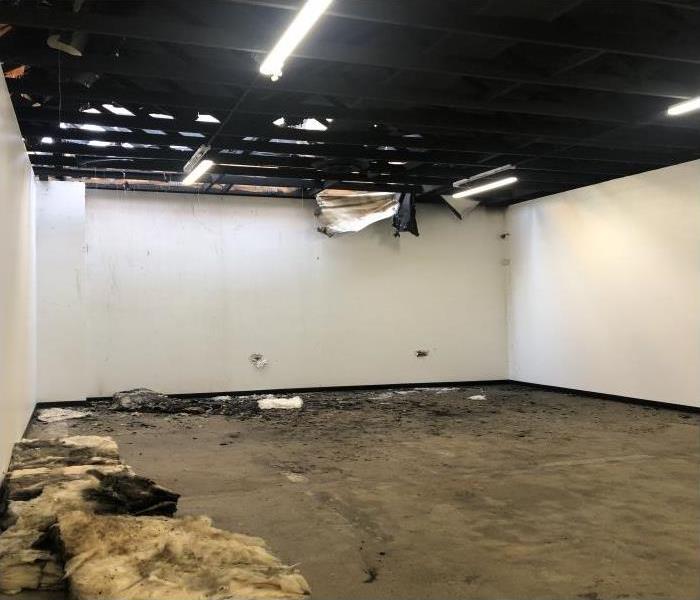 We received a call in Jurupa for smoke damage business caused by a nextdoor fire. We were able to make it, "Like it never even happened."
We received a call in Jurupa for smoke damage business caused by a nextdoor fire. We were able to make it, "Like it never even happened."
Smoke damage can affect your business long after a fire has been extinguished. A fire restoration company can provide smoke cleaning services to remove stains and odors from the following:
Several methods can accomplish this.
Air Scrubbers
These air filtration systems can remove smoke odor from the air by passing it through a high-tech filter that removes contaminated particles. Purified air returns to the original environment without traces of the odor-causing contaminants.
Ozone Generators
Ozone is oxygen that has three oxygen atoms instead of two. The third atom attaches itself to malodorous particles and neutralizes them. The other two atoms remain in the air as pure oxygen. Ozone generators work best in low-humidity environments where there is less hydrogen to hinder the attachment of the third oxygen atom. They also work quickly, allowing employees to re-enter a business within hours. Ozone treatment is an effective smoke cleaning option because it can effectively penetrate porous surfaces that are difficult to reach.
Hydroxyl Generators
After a fire, a hydroxyl generator can remove smoke odor in high humidity environments flooded by water used to extinguish the flames. One oxygen atom and one hydrogen atom change the molecular structure of the contaminants that produce odor. Hydroxyl generators can purify a wide range of objects, including artwork. They are slower than ozone generators to remove smoke odors. Still, they do not require room evacuation, making them an excellent choice for businesses that don't require relocation after a fire.
Thermal Foggers
After a fire, smoke cleaning objects like rugs and upholstery can be challenging. Thermal fogging is a reliable method of hazardous particle and odor removal. A deodorizer is heated to create a fog that can penetrate the most difficult-to-reach parts of a room and its contents.
A fire restoration company can recommend the appropriate method of smoke odor removal for your Riverside, CA, business.
With fire season still a danger, being prepared is a good first step. Keep our contact information handy. We can inspect for free and help remove any type of odor.
SERVPRO of West Riverside City
951-351-8033
Facebook
Instagram
Website
Do You Have an Odor You Can't Remove? We Can Help!
12/14/2020 (Permalink)
 Need help removing odors such as smoke? Call SERVPRO of West Riverside City!
Need help removing odors such as smoke? Call SERVPRO of West Riverside City!
SERVPRO of West Riverside City crew chief and technicians are trained for a variety of situations, including the control and removal of offensive odors.
By definition, an odor is a distinctive (and typically unpleasant) smell that can be picked up by people. SERVPRO technicians have a variety of methods to remove these odors, but they all typically begin with identifying the source of the odor. Some common examples of odor sources include:
-Property Damage (Fire or Water Damage, Mold Growth)
-Animals (Dander, Bodily Waste, Infestations)
-Trash and Waste (Rotting Food, Sewage)
Most people think there are special sprays that can help remove odors, but this is a myth. Sprays usually mask the odor temporarily, resulting in the unpleasant smell coming back after some time. This is why it’s important to identify the source of the odor and remove it before attempting deodorization with sprays or mists.
Once the source has been pinpointed and removed, SERVPRO of West Riverside City technicians have a variety of ways to eliminate remaining odors. We can use two different types of fog, Thermal Fog or ULV Fog, depending on the source of the odor and its strength. We can also use specialty fans and filtration equipment to clean the air.
One of our stronger methods of deodorization is the use of ozone, which is particularly useful against odors from smoke, pet odors, mildew and organic pollutants. Ozone is also called “activated oxygen” because chemically it is an added oxygen molecule (03), which makes it highly reactive with particles it comes into contact with. The extra oxygen atom attaches itself to the other molecules to create a new molecule, one that isn’t smelly, in a process called oxidation. Once the ozone is ventilated and dissipates, most odors are gone and there is only a neutral smell.
A word of caution – Ozone, and ozone generators, should be used and handled by trusted professionals like the technicians at SERVPRO of west Riverside City because there are some risks with the use of these products. There are certain materials that don’t do well when exposed to ozone, such as certain textiles, leather, rubber and certain plastics. Ozone has also been known to bleach materials like carpets and upholstery if the materials are wet when exposed to the ozone gas. Ozone can also be harmful to the human body if it is inhaled, potentially causing lung irritation, breathing problems and headaches.
The bottom line is if you are dealing with unpleasant odors or smells that are really a bother, call SERVPRO of West Riverside City and we can assess and handle the removal of those odors safely and efficiently.
Questions? Give us a call! (951) 351-8033
Santa Ana Winds, Why So Dangerous in Riverside?
12/7/2020 (Permalink)
 Call SERVPRO of West Riverside if you experience disasters from high winds due the Santa Ana's.
Call SERVPRO of West Riverside if you experience disasters from high winds due the Santa Ana's.
What are Santa Ana Winds? Why do the strong gusts of wind feel warm, and why do they cause fires?
Santa Ana Winds are something unique to Southern California. They can cause a great deal of damage. The fast, hot winds cause vegetation to dry out, increasing the danger of wildfire. Once the fires start, the winds fan the flames and hasten their spread. The winds create turbulence which exhibit substantial change in speed and/or direction with height.
Ready Riverside states:
Santa Ana Winds occur when air from a region of high pressure over the dry, desert region of the southwestern U.S. flows westward towards low pressure located off the California coast. This creates dry winds that flow east to west through the mountain passages in Southern California. These winds are most common during the cooler months of the year, occurring from September through May. Santa Ana winds typically feel warm (or even hot) because as the cool desert air moves down the side of the mountain, it is compressed, which causes the temperature of the air to rise. These strong winds can cause major property damage. They also increase wildfire risk because of the dryness of the winds and the speed at which they can spread a flame across the landscape.
Wildfires are a common hazard across California. When conditions are right, small fires can become raging firestorms in the blink of an eye. Being prepared can make all the difference to your safety.
California Fires are usually named by the dispatcher who takes the initial report and sometimes by the first responder at the scene, The Los Angeles Times reported. Dispatchers will name fires by finding a nearby landmark or feature, like a canyon, river or valley.
In Just recent weeks, we've experienced the Airport Fire which started near the Corona Municipal Airport. It was reported Tuesday night, on Dec 1, behind the airport at Prado Basin. It was less than 5 acres but red flag conditions, Santa Ana winds and low humidity kept it going. On Wednesday it spread to 50 acres and by Thursday had grown to 500 acres with 0% containment.
Also burning Thursday December 3rd was the Bond Fire in Orange County. This was initially started by a home fire that quickly turned into a wild fire due to the dry wind conditions. By end of day Thursday it grew quickly to 7,200 acres!
Here is some information from Riverside Ready regarding terms we should all be familiar with.
Know the Terms
- Fire Weather Watch – A Fire Weather Watch is issued in anticipation of Red Flag Warning conditions beyond the first 12-hour forecasting period. It is upgraded to a Red Flag Warning once conditions are 12 hours or less in the future, or the forecast changes and the watch is cancelled.
- Red Flag Warning – A Red Flag Warning means warm temperatures, very low humidity's, and stronger winds are expected to combine to produce an increased risk of fire danger.
- Extreme Red Flag Warning – An Extreme Red Flag Warning is issued when conditions are dangerous enough that enhanced wording is needed to convey the danger present. It is analogous to wording added to severe weather watches and warnings, including use of the phrase “This is a Particularly Dangerous Situation.”
- Evacuation Warning – An Evacuation Warning is issued by Public Safety officials to warn of the potential need for an evacuation due to wildfire. This term replaces the Voluntary Evacuation terminology. If you are under an evacuation warning, be ready to go at a moment’s notice, and consider evacuating early if you feel there is danger or need extra time to move to safety. Make sure you have multiple ways to receive alerts, including if power goes out. NOAA Weather Radios are a great tool, in addition to signing up for local Mass Notification alerts like RiversideAlert.
- Evacuation Order – An Evacuation Order replaced the Mandatory Evacuation terminology. This order indicates imminent danger to life and property, even if it is not readily apparent, and you should leave immediately if you are in this area. Remember, things are replaceable. You are not.
SERVPRO of West Riverside City is here to help with damage caused by high winds. Roofs can be impacted and when winds are strong enough, they can down trees. Most importantly, they cause wildfires. Please be safe as Santa Ana winds and Red Flag warnings run through sometimes May.
Follow our Social Media accounts for tips to avoid disasters:
Or call us at 951-351-9088
7 CHRISTMAS TREE SAFETY TIPS TO KEEP YOUR FAMILY SAFE
12/2/2020 (Permalink)
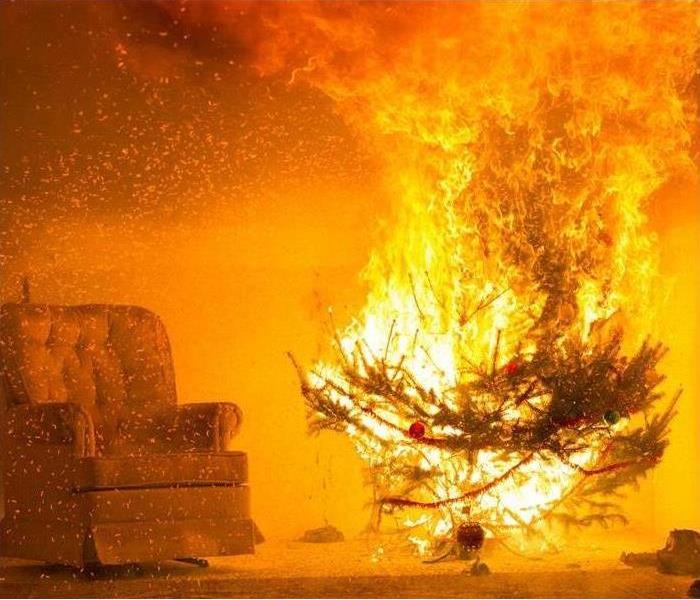 Avoid a dangerous situation with your Christmas tree by following 7 key steps!
Avoid a dangerous situation with your Christmas tree by following 7 key steps!
For a wonderful while, it’s the most beautiful decoration in your home it may be tall, short, slender or plump, the Christmas tree stands at the center of holiday celebrations. It also stands as a seasonal addition to the house that needs to be treated with special care.
As you make plans to bring home this year’s fir or spruce, are you checking your Christmas tree fire safety list?
We offer this guide for keeping your Christmas tree safe based on our years of experience as Riverside's most trusted fire cleanup company. We want you to celebrate the season with the security that comes from knowing your home is safe for the holidays.
According to the National Fire Prevention Association, Christmas tree fires cause property damage totaling more than $14 million annually. That figure can’t account for the heartbreak of a house fire over the holidays. These seven simple tips can keep your home and family safe while you all enjoy the Christmas tree’s bright lights and warm glow.
1. CHECK FOR FRESHNESS
Look for a tree with soft, green needles, and confirm its freshness by closing your hand over a bough and gently pulling down. If needles fall off at your touch, the tree is already beginning to dry out, and that can pose a fire hazard.
2. GIVE IT A STABLE STAND
Safely show off your Christmas tree in a sturdy, weighted stand with screw-in stabilizers that help anchor its weight. A large stand also holds plenty of water for keeping a thirsty tree fresh inside your home.
3. STAND IT AWAY FROM HEAT
Make sure the tree is standing at least 3 feet away from any heat source including space heaters, radiators and the family fireplace. High temperatures, flames and embers are serious fire hazards around a Christmas tree.
4. WATCH THE KIDS
A beautiful tree can tempt little hands with pretty ornaments and inspire rowdy playtime around its base. Talk to the kids about home fire safety. Explain that running around close to the tree can topple it and start a fire.
5. WATCH PETS TOO
The family dog and cat can create Christmas tree fire hazards too. Discourage dangerous chewing and tangling accidents by hanging tree light strands and decorations above your pets’ playful reach.
6. TURN EVERYTHING OFF
Always unplug tree lights before you leave the house or go to bed for the night. Turn off nearby space heaters, extinguish candles, and make sure embers are out in the fireplace.
7. GIVE IT AN HONORABLE GOODBYE
When a Christmas tree stops taking up water and starts dropping needles, it becomes more of a fire hazard with each passing day. Give the tree an honorable goodbye at one of the recycling centers across Riverside.
HOW TO KEEP A CHRISTMAS TREE FROM DRYING OUT
This part of Christmas tree fire safety deserves special attention because it keeps your tree fresher through the holidays, and that reduces the risk of a house fire. Good tree maintenance starts before you set it up in its stand.
- Saw 2 inches off the bottom of the tree stump, but don’t peel back lower bark or drill holes in the trunk. • If you can’t put the tree in its stand right away, prop it up in a large water bucket, and check it daily. • Monitor the tree’s water level every couple of hours on the first day. Afterwards, top it off every 24 hours.
CAN CHRISTMAS LIGHTS CAUSE A FIRE?
We’re often asked about decorations this time of year, so we finish up our Christmas fire safety guide with important pointers about lights on the tree.
- Always purchase Christmas tree lights that carry the Underwriters Laboratory UL Seal. • Inspect strands for frayed wires and broken sockets, and toss anything that looks damaged. • Don’t overload the tree with older incandescent lights or run too many strands from one extension cord. • Don’t connect incandescent and LED strands together, and keep them on separate extension cords.
WE’RE ALWAYS HERE FOR YOU
This year, gather the family around for a quick review of Christmas tree safety strategies. Make sure everybody understands how important it is to follow the guidelines.
All of us here at SERVPRO of West Riverside City send our warmest wishes to you and your family. It’s our honor to serve and be a part of this wonderful community, and we really value your support. Our teams are always here for you, with the best fire damage cleanup and fire restoration services available.
Do You Rent? Why You Should Have Renters Insurance
11/30/2020 (Permalink)
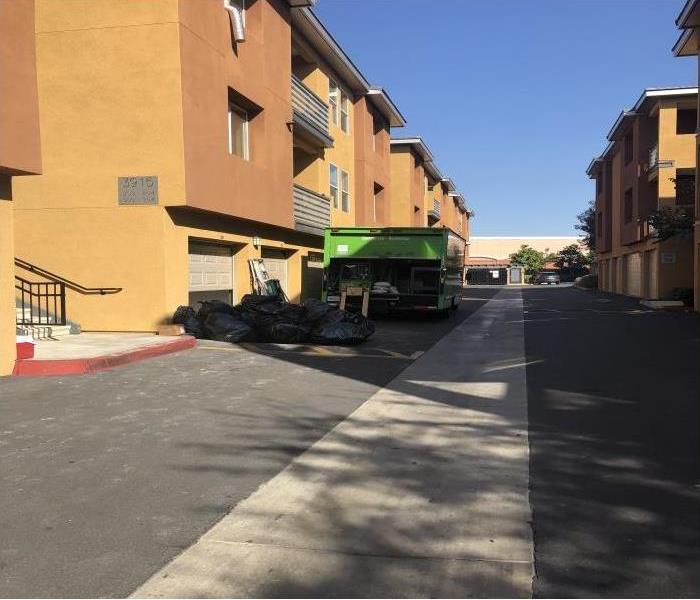 One fire caused smoke and soot damage within other rental units. Do you have renters insurance?
One fire caused smoke and soot damage within other rental units. Do you have renters insurance?
There is a misconception regarding damage caused by a fire in an apartment or home you rent.
Renting a single family home, apartment or condo may be the way that you personally choose your housing. There are many perks when it comes to renting. The biggest perk is that you are not typically responsible for the major incidents that may occur within those four walls like an electrical fire, busted water pipe, roof leak, or even when that 15 year old furnace decides it has served its purpose. While those are great perks, you still have the responsibility of your own personal property that may become damaged due to a number of issues that may arise while living in a home you personally do not own. Many renters mistakenly assume that their landlord's homeowner's policy will cover them if disaster strikes. I wasn’t knowledgeable in this regard, until I ended up on the restoration side of the disaster. Some may assume if the homeowner neglected issues like water pipes, electrical and even the roof, that their insurance would cover my personal property. How could I be responsible for something I had nothing to do with? Many also don't realize that the property's homeowner insurance only covers the actual property, not anything you own within the unit or home.
It is so important that renters look into and purchase renters insurance. I realized this when I was working an apartment complex fire. The flames were contained to the one apartment, but that wasn't the biggest issue. It was the smoke and soot that affected other units. The smoke and soot got into apartments on other floors. Here's the thing, one smoke particle is half the size of bacteria, 1/8 the size of a red blood cell neither one of those are visible to the naked eye. Smoke and soot will find little pathways to follow holes around plumbing, and also find its way to your second floor or cooler parts of the home. So essentially we had to pretest other apartment within that building. Many renters didn't understand why they were going to have to pay for the smoke and soot cleanup within their apartments when it was a single condo that was the source of the smoke and soot.
Unfortunately, that was the case for quite a few renters within that complex. The cleaning of smoke and soot can be very tedious and time consuming even for professionals like SERVPRO of West Riverside City. Our technicians are trained and certified to identify and remediate smoke and soot properly.
There are four types of soot:
- Dry smoke residue: Powdery, dry small and non-smearing particles resulting from fires that burn quickly at a high heat
- Wet Smoke residue: Smearing, sticky and strong-smelling particles caused by fires that smolder at low temperatures, resulting in smoke webs that may be challenging to remove.
- Fuel oil soot: Dispersed by puff backs from furnaces
- Protein Residue: Very strong-smelling, but practically invisible residue that can ruin the color of varnish or paint.
Renters insurance is typically covered for a small monthly premium, the average renter’s policy has a $20,000 - $25,000 worth of coverage for your contents. There are even rider policies (Which is coverage for things that may be worth more than the per-item limit on your renter’s insurance policy). The value of your personal contents can add up quickly. The most important aspect of renters insurance is deciding whether to purchase replacement value or actual cost value coverage. While renters insurance is important for smoke and soot, it also covers many other things.
- Fire, lighting
- Windstorm, hail
- Explosions
- Riots
- Damage by aircraft
- Damage by vehicle
- Damage from smoke
- Vandalism
- Theft
- Falling objects
- Weight of snow, ice, sleet
- Damage from steam- heating/water-heating appliances/systems
- Leakage or overflow from water or steam
- Freezing of plumbing, heating, air conditioning
- Short-circuit damage caused by electrical appliances.
Bottom line renters insurance is essential and relatively inexpensive so call you friendly insurance agent and have them go over coverage options. It will protect your property should loss occur within the home or apartment you rent. It is very inexpensive and well worth it!
Have you experienced a loss due to fire or water damage? Call SERVPRO of West Riverside City:
951-351=8033
We are always here to help!
How Can a Staging Area Help During Storm Damage Cleanup?
11/25/2020 (Permalink)
SERVPRO technicians streamline the restoration of Coram properties through the use of multiple applications.
Flood damage in a Riverside home can happen in many ways, and multiple areas of the structure can receive the effects. One common denominator during the restoration services is how SERVPRO techs handle the cleanup. They use a logical course of action that gets applied to fit the individual circumstances of the property that make each mitigation unique. The staging area for cleanup is one of those actions and usually has the following key elements:
- Situated near a water source in the home such as a bathroom or laundry room in case the need for mixing specialized products arises
- The floor gets covered with a heavy-duty drop cloth for cleanliness
- All of the tools needed for the restoration services get placed in an organized fashion so they can be found easily by the techs
Can Flood Damage Occur From a Backed Up Storm Drain?
When flood damage happens in a Riverside home that affects the drainage of a storm drain in a garage, the resulting mess can be ugly. When these large outtake pipes back up due to getting overwhelmed, there is very little individuals can do. These pipes do not just drop water in the home; they bring debris and usually a smelly, black sludge that coats everything it touches. It is not uncommon for the water to have receded by the time SERVPRO techs arrive on the scene, mostly the sludge is still present. This type of cleanup requires multiple application, including:
- Manual tools such as shovels to pick up the solids
- Portable pumps to assist in removing any remaining water
- Power scrubbers to remove stuck-on residues
Safety During Mitigation is Key
Until the water gets tested by the techs upon arrival, there is no way to know if any harmful elements are in the water in the home. If it receded quickly, those elements could be in porous materials such as sheetrock or through seepage, and be resident within the subfloor. SERVPRO techs generally advise homeowners to keep both residents of the property and pets out of the work area, mainly until the water gets tested. After testing to determine any hazards present, the techs treat the water with their professional biocides and antimicrobial agents. During the cleanup, they wear protective clothing and set up air scrubbers and often negative air chambers to keep airborne droplets either captured or flowing out and clean air from outside the home flowing in. In some cases, the techs may set up containment around the worksite to inhibit any cross-contamination.
The flooring of all types is the article in the home that needs the most assistance after this type of damage from water. Concrete is semi-porous. While it does absorb some moisture, the use of the drying equipment SERVPRO utilizes forces the embedded moisture to rise. Then the surface can get disinfected to sanitary levels for reuse. The techs have access to a vast selection and cleaning solutions. Several types developed explicitly for use on concrete to leave no efflorescence, the white powdery residue that occurs when salts and minerals in the concrete come to the surface.
The final step in the restoration of this type is odor control. While the use of the cleaning solutions goes a long way towards limiting the odor from the water. Other actions include:
- Removal of articles and building materials too damaged for restoration
- Use of odor control equipment such as hydroxyl generators and thermal fogging
- Scoping the property post-drying to ensure all areas show no residual moisture
Once the restoration services complete, the crew chief takes the homeowner through the property and goes over the actions taken, the items disposed of with permission, and any repairs that need to occur in the home. Once this walk-through completes, the property owner gets a written report that includes photographs of items with a detailed description of all restoration for the homeowner to use to file any insurance claims. Assisting individuals in expediting their reimbursement for the damage is another way that SERVPRO tries to make the bad situation in the home a little less stressful.
SERVPRO of West Riverside City at (951) 351-8033 cleans up and restores homes from any size flood damage. The certified technicians arrive quickly and work to make the water damage a thing of the past, "Like it never even happened."
Receiving an Emergency Alert to Evacuate Your Home, What Do You Take?
11/23/2020 (Permalink)
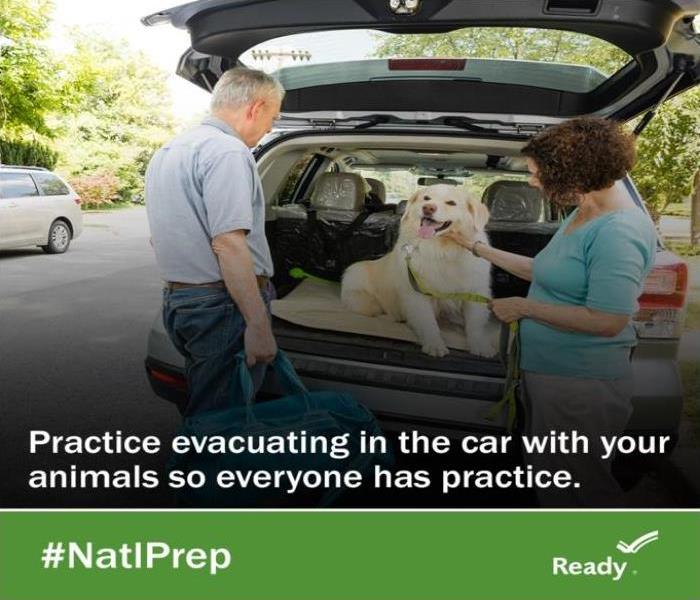 Grab the dog and put them into the car. If you plan to take your pets right before you leave, they might hide or struggle, slowing down your escape.
Grab the dog and put them into the car. If you plan to take your pets right before you leave, they might hide or struggle, slowing down your escape.
It's the end of October as I write this blog. My week started with an emergency alert on my device Monday late afternoon. It read, "Per San Bernardino County Sheriff Dept. - Fire in the Chino Hills State Park. Evacuation Warning in effect...
Potential threat to life and/or property…". Needless to say, my heart sank, and a bit of a rush and panic came over me. I gathered my thoughts and since I already had a to-go-bag packed, I felt a little bit at ease. My son and I had previously created an emergency evacuation plan of what to take, who to contact, and where to go. We used Ready.gov's printable card and had those already in our wallet containing important information. We reviewed our plan and confirmed what each of us were responsible for collecting. We kept everything ready to go by the front door, both cars ready to pull forward with full tank of gas! We went to bed feeling confident we were ready…until we received Emergency Evacuation Alert level 2. This one, received at 1am in the morning read, " Due to wildfire burning near LA, Orange, and San Bernardino County borders, an EVACUATION WARNING has been issued in the area south of Diamond Bar. Those in the area should Get Set for a potential evacuation by gathering loved ones supplies. Monitor local news, our social media channels and LA County.gov." I jumped up in a panic, made sure my son was aware of the alert and reviewed updates of the fire.
How did we know what to plan for or what to take? Ready.gov was the best tool. Below are the steps we took, and the plan we created based on our families needs.
Step 1: Put a plan together by discussing the questions below with your family, friends or household to start your emergency plan.
- How will I receive emergency alerts and warnings?
- What is my shelter plan?
- What is my evacuation route?
- What is my family/household communication plan?
- Do I need to update my emergency preparedness kit?
- Check with the Centers for Disease Control (CDC) and update my emergency plans due to Coronavirus.
- Get masks (for everyone over 2 years old), disinfectants, and check my sheltering plan.
Step 2: Consider specific needs in your household.
As you prepare your plan tailor your plans and supplies to your specific daily living needs and responsibilities. Discuss your needs and responsibilities and how people in the network can assist each other with communication, care of children, business, pets or specific needs like operating medical equipment. Create your own personal network for specific areas where you need assistance. Keep in mind some these factors when developing your plan:
- Different ages of members within your household
- Responsibilities for assisting others
- Locations frequented
- Dietary needs
- Medical needs including prescriptions and equipment
- Disabilities or access and functional needs including devices and equipment
- Languages spoken
- Cultural and religious considerations
- Pets or service animals
- Households with school-aged children
Step 3: Fill out a Family Emergency Plan
Download and fill out a family emergency plan or use it as a guide to create your own.
Step 4: Practice your plan with your family/household
Associated Content
This was also great article that I followed to some degree:
From these experiences, I’ve learned:
If you don’t have a mental list already thought out, in an emergency you may forget what’s important and grab stuff that’s not useful or is easily replaced.
The more you mentally rehearse the actions you’d take in a crisis, the more likely you’ll follow your plan in an actual emergency.
My emergency list begins with:
- Grab the dog and put them into the car. (If you plan to take your pets right before you leave, they might hide or struggle, slowing down your escape. If you’re not leaving soon, keep them in the bathroom nearest the door.)
- My purse. (It’s big and can hold a lot of stuff.)
- My laptop. (Fits in my purse.)
- My to-go bag containing clothes and toiletries. (I always keep one packed and ready.)
I have included more on my list, these were the first five items.
Every time there’s a fire in California, practice running through a scenario where you have to grab what’s on your list and race out the door.
You can also make a physical list — on paper or a digital one on your phone or tablet for easy access and mobility. Make a copy for each member of the family, designating which items they are in charge of.
PREPARE FOR AN EMERGENCY BEFORE THERE’S A CRISIS
In California, we’re supposed to have earthquake supplies on hand in case our state experiences “the big one.” I also started keeping an emergency stash in the trunk of my car. If you open my trunk, you’ll find:
Copies of important paperwork.
Pet food, dog leash, other pet supplies,
A pair of tennis shoes and sweats, as well as a change of clothing and shoes for work.
Basic toiletries.
First Aid Kit.
Flashlight.
Radio.
Snacks and water.
Blanket, towel, and small pillow.
A roll of toilet paper.
Extra laptop charger. (An extra phone charger stays in my purse.)
It’s important to keep visual documentation of your home and valuables for insurance purposes. Video your whole house and also open drawers and closets. Keep this record updated. Make sure you store a copy on a cloud service and multiple memory cards/external drives.
WHEN IN EVACUATION LEVEL TWO, DON’T DELAY PREPARING
At the second level of an evacuation request, there’s a good probability of the need to evacuate. Level three is an evacuation request — be ready to leave at a moment’s notice. Level four is immediate evacuation.
Load the car or cars and position them in the driveway headed out. Make sure the gas tank is full. If you never have to leave, then all you’ll have to do is unload the car and unpack. Yes, it’s a tedious job. But better than having to grab and go.
Stay informed through media about the progress of the fire and where to find safe evacuation routes. Watch for emergency personnel who may come by your home or be at certain checkpoints to give instructions regarding the evacuation.
Consider leaving at evacuation level two to avoid congested roads.
THINK OF PACKING IN TWO BATCHES
The first batch will cover the time you’ll stay at a shelter/hotel/with friends and relatives. The second batch is to pack as if you won’t have a home to return to.
BATCH ONE
Addresses staying in shelters. See her article for details. You can adapt the information to staying in hotels or with friends/family.)
BATCH TWO — PACKING AS IF YOU WON’T RETURN
Take important stuff you can’t live without, treasure, or will need.
Computers. (If you have a desktop, store information on a cloud or download what you need on flash drives.)
Valuables.
Jewelry.
Special photos.
Sentimental items.
Clothes for longer term, such as for work or winter coats.
Bring additional paperwork:
Legal documents — birth certificates, passport, social security cards, will, vehicle registration and ownership papers, marriage/divorce papers.
Financial records — bank account information, credit and debit cards, government benefits, retirement and investment account statements, tax returns, year-to-date receipts if you itemize expenses on your tax returns.
I encourage all households to sit together and create a plan. Check out Ready.gov and the referenced article. These are great tools to help you prepare your loved ones and ensure you have necessities and valuables in the event of an emergency.
Be safe California residents!!
SERVPRO of West Riverside City uses State of the Art Equipment for Water Damages
11/18/2020 (Permalink)
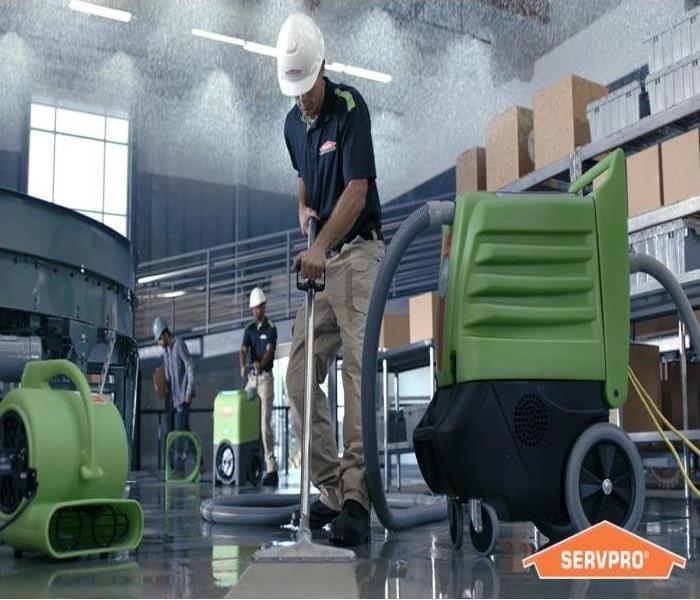 SERVPRO of West Riverside City understands that to continue to be the leader in restoration we need to use cutting edge technology.
SERVPRO of West Riverside City understands that to continue to be the leader in restoration we need to use cutting edge technology.
SERVPRO of West Riverside City understands that to continue to be the leader in restoration we need to use cutting edge technology. That's why we've made it a point to add new equipment to our inventory regularly. We want to provide excellent work to our customers and to do that we need the right equipment.
Here are a few pieces of equipment we use regularly for resolving water damage
Detection Equipment
Scoping damage involves our trained team members locating the areas affected by water and determining the extent to which the structure and contents have absorbed moisture. Our trained team member’s use:
- Moisture Sensors – These are us to detect moisture in carpets, baseboards and walls.
- Moisture Meters – These are used to determine the actual moisture content of various materials. The moisture tester provides accurate moisture readings that enable our SERVPRO® of Sumner County team member to monitor the drying process.
- Thermo-hygrometers – These measure both temperature and relative humidity. In capturing these two readings our trained team members calculate specific humidity, dew point and vapor pressure.
Extraction Equipment
The most effective method of removing moisture from a structure is extraction. This is why it is crucial to respond quickly to a water damage and to provide emergency mitigation services. When the water is extracted quickly, the environment can usually be dried much faster.
- Extractors – These are used in cleaning carpets and upholstery and in removing water from floors following a water damage. Extractors can either be truck-mounted or portable, allowing for greater access inside structures.
Air Moving Equipment
Air movers are used in water damage restoration to enhance evaporation at the surface level, thereby reducing drying time. As airflow at the surface level increases, the moisture in the air increases. This moisture is then eliminated via the use of dehumidification equipment.
Dehumidification Equipment
By extracting water vapor from the air, dehumidifiers lower the relative humidity, which in turn increases the rate of evaporation. In a water damaged, structure, dehumidifiers pull in the moist, humid air and then discharge dry, warm air. The dry air acts like a sponge, absorbing moisture from wet materials. SERVPRO® of Sumner County uses two types of dehumidifiers:
- Refrigerant Dehumidifiers – These work similarly to an air conditioner.
- Desiccant Dehumidifiers – The use chemicals, called desiccants, which readily absorb moisture from the air.
Need immediate help? Please call SERVPRO of West Riverside City 951-351-8033. We are available 24 hours a day, 7 days a week. We can handle your emergency.
Follow us on Social Media for additional tips
Facebook
Instagram
Twitter
Inland Empire Death Scene Clean-Up: A Tough Subject
11/16/2020 (Permalink)
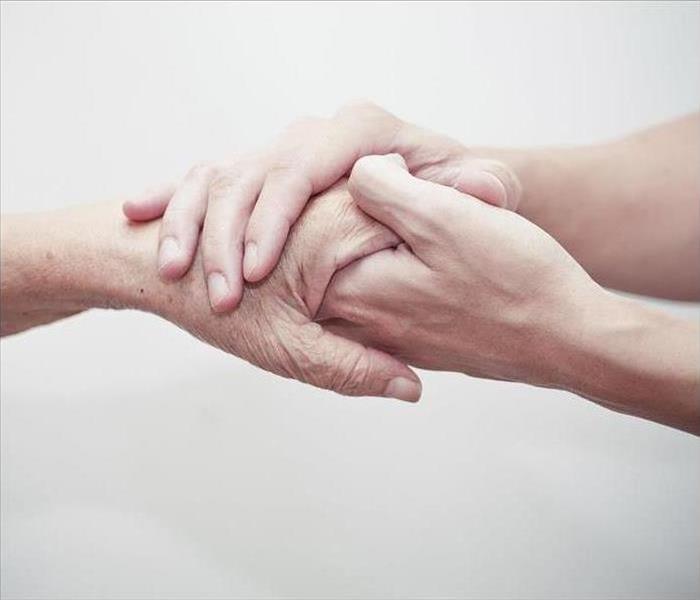 Families are impacted with the death of a loved one and sometimes don’t know where to turn when that death happens in a home.
Families are impacted with the death of a loved one and sometimes don’t know where to turn when that death happens in a home.
I debated writing this blog for quite some time. But this week we received a call from a Property Management company, and it hit me that even though it’s not the easiest topic to discuss, it is worth the discussion. Families are impacted with the death of a loved one and sometimes don’t know where to turn when that death happens in a home.
The clean-up that is needed after an unattended death is not easy to write about and is definitely not something a sales or marketing person wants to talk about. I have never personally experienced a suicide of anyone close to me and I can't imagine the anguish a family goes through as they process that death is debilitating. The clean-up afterward can obviously prove too traumatic for a family to perform. The same can be said when an elderly loved one dies alone. Body decomposition, though natural, is very hazardous to anyone in and or around the area.
Cleaning up can be emotionally challenging, not to mention dangerous if blood and/or other bodily fluids are involved. Our team at SERVPRO of West Riverside City will treat the family and their loved one’s property with the greatest empathy. Our goal after a death is to remove the burden of cleaning up by those family members left behind.
Many times, our own team is impacted with strong feelings or reactions to the death, despite having no acquaintance with the victim. Our team has the training and experience to stay focused on the unique nature of their cleaning task. They are cleaning and restoring the site of the traumatic event. They are preforming an invaluable service to the customer. Our hope, is that our clean-up process will help the customer recover in a small way from the aftermath of the loss of life.
Many people don’t realize that insurance policies often offer coverage for crime scene and trauma cleaning, so it’s crucial to check with the insurance policy adjuster to determine if coverage is offered.
All these are reasons why I feel it’s important to write this blog. Helping a family in their time of need by responding 24 hours a day, 365 days a year to help them restore their lives is of the utmost importance to us.
While we hope that you never have to experience a death that needs Biohazard Clean-up, we do want to let you know that there are experts out there who will help if ever the need arises.
Need help? (951) 351-8033
Why Reach out to SERVPRO?
Exposure to biological and chemical contaminants can pose serious health consequences. A failure to properly remove such substances can contribute to unhealthy and dangerous environments. SERVPRO of West Riverside City is trained to safely clean and remove biohazardous substances and dispose of them properly in accordance with OSHA and health regulations.
Equipped with the necessary safety apparatus and cleaning products, SERVPRO Franchise Professionals are here to help transform any unsafe environments back into clean, safe homes and offices.
Please refer to our Biohazard Emergency Tips - Until Help Arrives Guide and follow these tips to protect yourself and your property.
The decontamination of a home or business due to trauma, sewage backups, chemical spills, hoarding, or other biohazards can be both dangerous and emotional. Specialized training and experience is key when choosing a cleanup company to resolve these circumstances.
Certified: SERVPRO Cleaned
The COVID-19 pandemic has changed what it means to be clean. SERVPRO has developed the Certified: SERVPRO Cleaned program, a specialized cleaning program that goes well beyond janitorial or carpet cleaning, providing a proactive viral pathogen cleaning service. Learn more about the Certified: SERVPRO Cleaned program to safeguard your customers and employees.
The SERVPRO Franchise Professionals provide cleanup and recovery services for many biohazard situations. These include the following:
- Suicide/death accidents
- Homicide cleanups
- Blood cleanup
- Accident cleanup
- Hoarding scenes
- Animal waste/remains
- Chemical spills
- Tear gas cleanup
- Meth lab cleanup
Fall or Winter Weather Can Have an Effect During the Holidays- Take Caution!
11/11/2020 (Permalink)
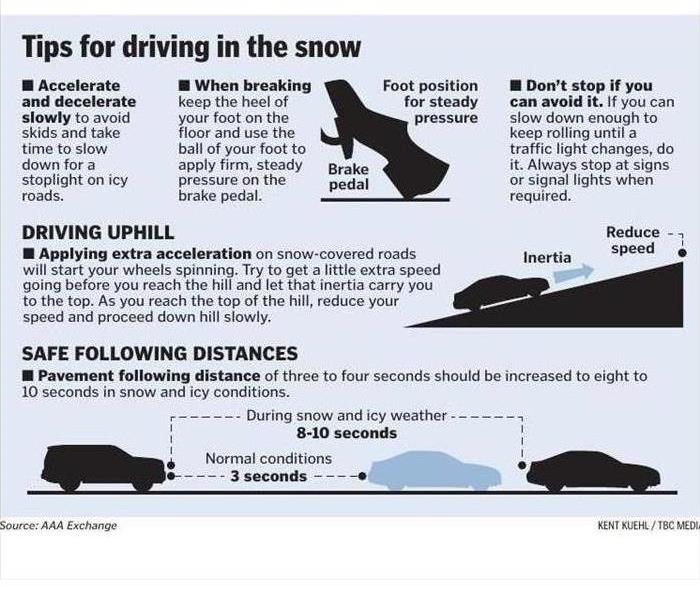 If you and your family plan to hit the road this year, check out Travel Tips from AAA to avoid motor vehicle mishaps. Be safe!
If you and your family plan to hit the road this year, check out Travel Tips from AAA to avoid motor vehicle mishaps. Be safe!
Beware of Fall and Winter Storms!
Fall and winter storms are right around the corner. The effect of these storms can be good or bad. As much as we love the sound of thunder, the jolt of lightning going through the sky and the smell of rain, there are bad things that can come along with it. Power outages are often a risk associated with storms. It’s good to know what to do in case you lose power, because you never know how long it could be out. It could be out for a matter of seconds, or for several hours. Here are some tips on what how to be prepared, and what to do during a power outage.
Keep flashlights available around your house. Avoid using candles when possible.Keep the opening of freezers and refrigerators to a minimum. When kept closed, refrigerators can stay cool up to 4hours, and freezers can stay frozen up to 48 hours. If need be, you can put ice in a cooler to keep your food cold.Watch out for carbon monoxide poisoning. If you are running a generator, it should be used outside and at least 20 feet away from a window or door. Never use a gas stovetop, oven, camp stove, or charcoal grill to heat your home.If it’s cold in your home, add more layers of clothes and blankets. Don’t use the oven or a grill as a heating source. If it becomes too cold, try to make arrangements to go to another location where heat is available.Turn off and disconnect any appliances and electronics. The power may surge or spike when it is restored, and that may cause damage to the items.If a storm occurs, the safety of you and your family is of the utmost importance.
What if your traveling across the country?
Whether you're going down the road this holiday season, or across the country, traveling in fall or winter weather can be a tricky task. AAA provided some simple solutions to avoiding a motor vehicle mishap.
- Accelerate and decelerate slowly
- avoid skids and take time to slow down for a stoplight on icy roads.
- Properly position feet on pedals
- keep the heel of your foot on the floor and use the ball of your foot to apply firm, steady pressure on the brake pedal.
- Don't stop if you can avoid it
- if you can, slow down enough to keep rolling until a traffic light changes. Always stop at stop signs or signal lights when required.
- applying extra acceleration on snow-covered roads can cause your wheels to spin. Try to obtain extra speed before reaching the hill and let inertia carry you to the top. As you reach the top, reduce speed and proceed downhill slowly.
- normal driving conditions suggest a 3-4 second car spacing. When driving in snow or icy conditions increase that to 8-10 seconds. Doing so allows you time to stop and avoid collisions should you need to.
Please be safe, weather can be unpredictable these days and prepared families can enjoy a safe holiday season.
What to expect when your call SERVPRO of West Riverside City?
We Answer the phone ready to help!
Call Today - (951) 351-8033
We understand that when you call us, you may be feeling confused, stressed, and vulnerable. You need an expert to guide you through this crisis. SERVPRO of West Riverside City has the specific water damage training and experience to help you through this tough time. We specialize in water damage restoration—in fact, it's the cornerstone of our business.
What to Expect
When you call, we will ask several questions regarding your water damage emergency. These questions will help us determine what equipment and resources to bring, including how many trained SERVPRO Professionals may be needed.
Our SERVPRO Representative will ask several questions:
Your name and contact informationYour insurance information (if applicable)The street address of the water-damaged home or businessWhen did the flooding or water damage occur?What caused the water damage (if known)?Is there electricity available (on-site)?About SERVPRO of SERVPRO of West Riverside City
SERVPRO of West Riverside City specializes in the cleanup and restoration of residential and commercial property after a fire, smoke or water damage event. Our staff is highly trained in property damage restoration. From initial and ongoing training at SERVPRO corporate training facility to regular IICRC-industry certification, rest assured our staff is equipped with the knowledge to restore your property.
Meet Our Crew
Don't hesitate to contact us, we are here to help!
Holiday Cooking Fire Safety Tips for Riverside Residents
11/9/2020 (Permalink)
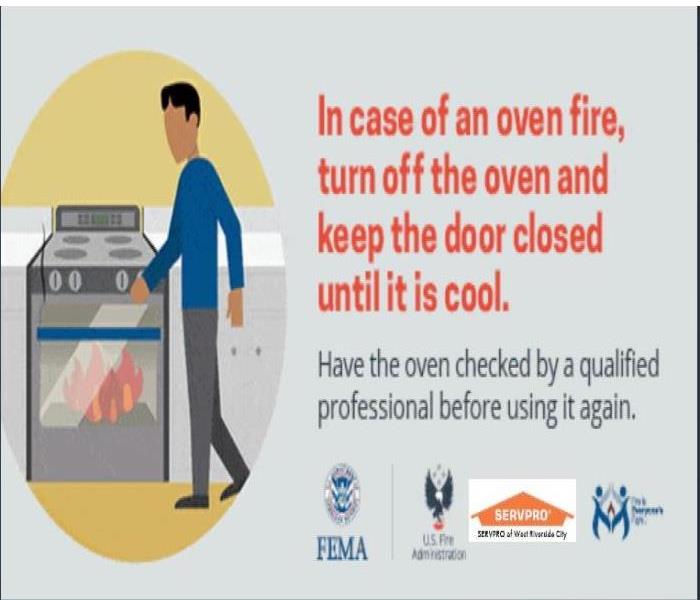 If an oven fire occurs, turn off the heat and keep the door closed.
If an oven fire occurs, turn off the heat and keep the door closed.
November is known for making a turkey feast, where family you haven’t seen in a while, gather and eat.
Although it’s a joyous and happy time, Thanksgiving is one of the worst days of the year for home fires. According to the National Fire Protection Association (USFA), the number of cooking fires on Thanksgiving day is three times as high than any other day of the year.
Stovetops and Ovens
Sometimes cooks can be distracted by their guests, cooking fires can easily be prevented by following a few simple precautions:
Remove food and grease buildup from burners, stovetop, and oven. Always start cooking with a clean stove and oven.Always stay in the kitchen while you’re cooking, don’t get distracted by trying to entertain your guests.Stay inside while cooking a turkey, set a timer, and check on it often.Keep a flame-resistant oven mitt, potholder, or lid nearby to smother any flames.Keep children away from the stove. It is recommended to use the back burners.If an oven fire occurs, turn off the heat and keep the door closed.Turkey Fryers
Never use a turkey fryer on a covered patio, garage, or indoors because it’s a fire hazard risk. Fryers can easily tip over, spilling scalding, hot oil onto anyone nearby, leading to fires, burns, or other serious injuries. Never overfill the oil in a fryer, many turkey fires happen while the oil is being heated. Here are some safety tips for using a turkey fryer:
Always read and follow the manufacturers guidelines.Completely thaw the turkey.Neve leave the fryer unattended.The oil will remain dangerously hot for hours, so keep children and pets away from the fryer.Only use the oil that is recommended. Different types of oil have different ignition temperatures.Allow two feet of space between the liquid propane tank and the fryer burner.Use well-insulated potholders or oven mitts, wear safety goggles to protect eyes from oil splatter.If oil starts smoking, immediately turn off the gas supply.Keep a fire extinguisher nearby.Never use water to extinguish a fire.Each year, from 2016 to 2018, fire departments in the United States responded to an estimated average of
189,300 cooking fires in residential buildings.
These fires caused an estimated:
170 Deaths
3,300 Injuries
$443 million in property loss
Cooking was, by far, the leading cause of all residential building fires and injuries.
Remember these safety tips so you and your family can have a safe and wonderful time together.
SERVPRO of West Riverside City is always ready for any emergency.
Keep our number handy:
951-351-8033
Steps to prevent Candle Fires in your Riverside Home
11/4/2020 (Permalink)
 Think about using flameless candles in your home. They look and smell like real candles.
Think about using flameless candles in your home. They look and smell like real candles.
There is something calming about candles especially during the holiday season. They look pretty and enhance the ambiance in a room, they give off a fragrant smell that can be so luring, but they can also be the cause to a house fire.
December has been noted as the peak month of candle fires. According to the National Fire Protection Association, 3 out of every 5 candle fires started when they were placed near something that can burn, such as furniture, bedding, or decorations.
From 2014-2018, U.S. fire departments responded to an estimated 7,610 home structure fires that were started by candles per year. These fires caused an annual average of 81 deaths, 677 injuries and $278 million in direct property damage. NFPA Home Candle Fires Report
Review the tips below from NFPA to prevent house fires this holiday season:
DO pay attention to proximity. It’s important to make sure that you’re not burning a candle on or near anything that could catch fire. Keep candles at least 12 inches away from furniture, drapes, bedding, carpets, books, or any other flammable objects. Place burning candles at least 3 inches apart from one another so they don’t melt one another or burn improperly.
DON’T leave burning candles unattended. Try to restrict people and candles to one room in the house so the location of family members can always be accounted for and you can keep an eye on open flames. Extinguish all candles before going to bed or leaving a room.
DO place candles on a fire-resistant surface. Place a handle in its holder on a stable, nonflammable surface, such as a metal cookie sheet, frying pan or ceramic plate.
DON’T light a candle if you smell gas. If you smell gas inside or outside your home, immediately put out all open flames, shut off your gas supply, leave the area, get to a safe place, and call 911.
DO use pillar or container candles. Broader-based candles are a suitable option for power outages, as these are less likely to be accidentally knocked over. When possible, candles should be enclosed within glass hurricane holders or globes.
DON’T use candles as a search guide or night light. Avoid walking around with a candle. Dark rooms can increase the chance of tripping or brushing against a flammable item. Use a flashlight instead.
DO keep candles out of reach of children and pets. Place candles up high to avoid the risk of pets, children, or adults accidentally bumping candles over in the dark.
DO Light candles carefully. Keep your hair and any loose clothing away from the flame
DON'T let the candle burn all the way to the bottom; put it out before it gets too close to the container or holder
DON'T light a candle if oxygen is used in the home. Oxygen canisters should be kept at least five to 10 feet away from any open flame, which can be anything from a fire in a fireplace to a gas or a candle.
DO use a flashlight or battery-operated lighting instead of a candle during a power outage.
Candles and Kids
Think about using flameless candles in your home. They look and smell like real candles.
- Never leave a child alone in a room with a burning candle.
- Keep matches and lighters up high and out of children’s reach, in a locked cabinet.
Although candles can add to the décor in the room, however, they can also add danger. Remember candles are an open flame which means they can easily ignite. Create an environment that is safe for you during this holiday season, use alternatives to prevent any candle fires in homes like using flameless candles.
Here are some additional tips to prevent fires during the holiday season from Ready.Gov:
- Only use decorations that are flame-retardant or not flammable.
- Check holiday lights each year for frayed wires or excessive wear.
- Don’t link more than three strands of holiday lights.
- Never leave a burning candle unattended. Consider using battery-operated flameless candles.
- Keep your live Christmas tree away from heat sources and room exits.
- Water your live Christmas tree daily to keep it from becoming dry.
As always, remember SERVPRO of West Riverside City is here to help!
Follow us on Social Media for additional tips:
Facebook
Instagram
Twitter
Water Damage Inspection at City Landmark Home of Rosie Bonds
11/2/2020 (Permalink)
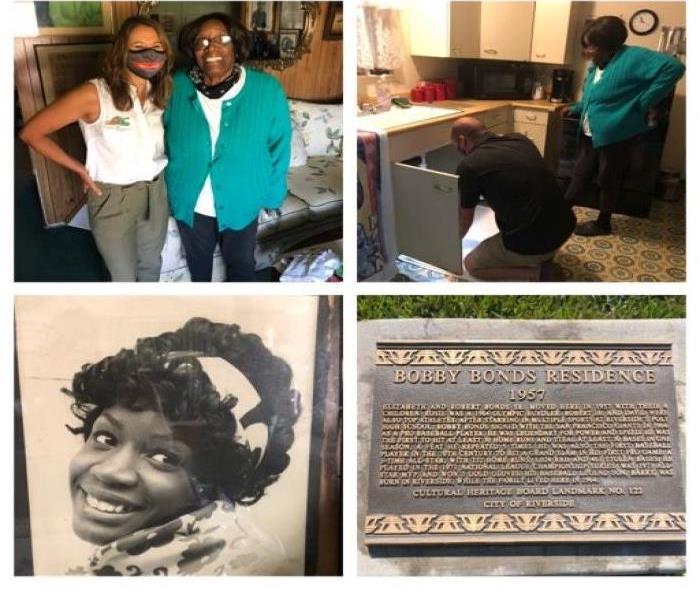 Photo of technician inspecting underneath sink, Marketer Letty with Rosie Bonds, High school photo of Rosie Bonds, Front yard landmark.
Photo of technician inspecting underneath sink, Marketer Letty with Rosie Bonds, High school photo of Rosie Bonds, Front yard landmark.
SERVPRO of West Riverside had the pleasure of meeting Rosie Bonds former Olympic hurdler.
We received a call from her agent My Tran of Farmers Insurance in Riverside of water damage asking if we could help Rosie out by inspecting the damage.
We sat down and chatted with Rosie about her family home in Riverside and the "hurdles" she's endured during her life. Rosie was raised in Riverside, California. Rosie's father worked on the homes built in the neighborhood of her family home in 1956, and purchased it in 1957. She referred to it as, "a middle class house back in 1956, but it's small now… and although it is old, it's made very well." With 4 children and 2 adults in a 3 bedroom home they managed as a family. She compared homes back then to nowadays, "where rooms are large and homes are larger than life". Everything in the house from furniture to flooring is original, her mother didn't want any changes made and also emphasized they could never sell the house. I was sitting on a sofa that had been with the family since the 1940s and very well taken care of. She has plans to update some things, but everything costs money.
Outside, you see an ordinary humble home with a chain link fence and a green lawn. The house was declared a city landmark in 2009. You can read the inscription on the stone in the front yard, reading, "Bobby Bonds Residence 1957- Elizabeth and Robert Bonds Sr. moved here in 1957 with their 4 children. Rosie, was a 1964 Olympic Hurdler. Robert Jr. and David were also top athletes. After starring in multiple sports at Riverside's Poly High School, Bobby Bonds signed with the San Francisco Giants in 1964. As a pro baseball player, he was legendary for power and speed. He was the first to hit at least 30 home runs and steal at least 30 bases in one season, a feat he repeated 5 times. He was also the first baseball player in the 20th century to hit a grand slam in his first pro game. A three time All-Star, with 332 home runs, 1024 RBIs and 461 stolen bases, he played in the 1971 National League Championship Series, was 1973 All-Star MVP and won 3 Gold Gloves. His baseball legend son, Barry, was born in Riverside, while the family lived here in 1964. Cultural Heritage Board Landmark No. 122 City of Riverside." Rosie is proud of their family home and says, "We've had some beautiful days here, beautiful days."
Rosie who was once an Olympic hurdler, set several national records in the hurdles; won the national outdoor hurdle championship (1963, 1964), and competed internationally, represented the U.S. in the Tokyo Olympics (1964). After retiring from athletics, she started a career in nursing. She became a licensed vocational nurse working in the Bay area and traveled back and forth to Riverside to care for her mom. In 2002 she was disabled in a car accident that left her without a job and without a home; she remained homeless living out of shelters and her car for several months. Her injuries from the car accident left her destitute. Rosie has a great outlook on life, she has overcome many struggles. In speaking with her she still has so much to offer. She runs Bobby Bonds day for kids in the area (although due to COVID it was canceled this year), she delivers food to those in need and she speaks openly about life's hurdles. Truly a pleasure speaking with Rosie Bonds!
10/28 community Halloween safety in Riverside County per CDC Guidelines
10/28/2020 (Permalink)
Many traditional Halloween activities can be high-risk for spreading viruses.
There are several safer, alternative ways to participate in Halloween. If you may have COVID-19 or you may have been exposed to someone with COVID-19, you should not participate in in-person Halloween festivities and should not give out candy to trick-or-treaters.
Lower Risk Activities
These lower risk activities can be safe alternatives:
Carving or decorating pumpkins with members of your household and displaying themCarving or decorating pumpkins outside, at a safe distance, with neighbors or friendsDecorating your house, apartment, or living spaceDoing a Halloween scavenger hunt where children are given lists of Halloween-themed things to look for while they walk outdoors from house to house admiring Halloween decorations at a distanceHaving a virtual Halloween costume contestHaving a Halloween movie night with people you live withHaving a scavenger hunt-style trick-or-treat search with your household members in or around your home rather than going house to houseModerate risk activities
Participating in one-way trick-or-treating where individually wrapped goodie bags are lined up for families to grab and go while continuing to social distance (such as at the end of a driveway or at the edge of a yard)If you are preparing goodie bags, wash your hands with soap and water for at least 20 second before and after preparing the bags.Having a small group, outdoor, open-air costume parade where people are distanced more than 6 feet apartAttending a costume party held outdoors where protective masks are used and people can remain more than 6 feet apartA costume mask (such as for Halloween) is not a substitute for a cloth mask. A costume mask should not be used unless it is made of two or more layers of breathable fabric that covers the mouth and nose and doesn’t leave gaps around the face.Do not wear a costume mask over a protective cloth mask because it can be dangerous if the costume mask makes it hard to breathe. Instead, consider using a Halloween-themed cloth mask.Going to an open-air, one-way, walk-through haunted forest where appropriate mask use is enforced, and people can remain more than 6 feet apartIf screaming will likely occur, greater distancing is advised. The greater the distance, the lower the risk of spreading a respiratory virus.Visiting pumpkin patches or orchards where people use hand sanitizer before touching pumpkins or picking apples, wearing masks is encouraged or enforced, and people are able to maintain social distancingHaving an outdoor Halloween movie night with local family friends with people spaced at least 6 feet apartIf screaming will likely occur, greater distancing is advised. The greater the distance, the lower the risk of spreading a respiratory virus.Lower your risk by following CDC’s recommendations on hosting gatherings or cook-outs.Avoid these higher risk activities to help prevent the spread of the virus that causes COVID-19:
Participating in traditional trick-or-treating where treats are handed to children who go door to doorHaving trunk-or-treat where treats are handed out from trunks of cars lined up in large parking lotsAttending crowded costume parties held indoorsGoing to an indoor haunted house where people may be crowded together and screamingGoing on hayrides or tractor rides with people who are not in your householdUsing alcohol or drugs, which can cloud judgment and increase risky behaviorsTraveling to a rural fall festival that is not in your community if you live in an area with community spread of COVID-19
What Is Considered Smoke Damage? A Simple List of the 5 Pesky Types
10/27/2020 (Permalink)
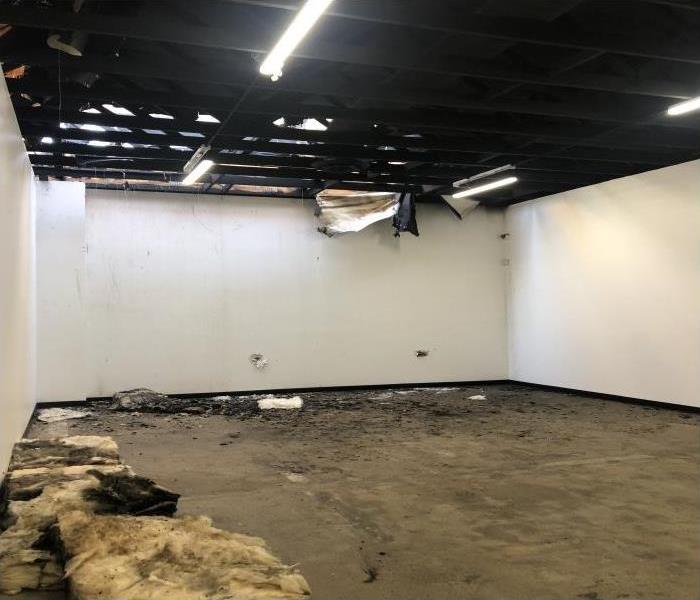 Riverside commercial building sustained smoke damage from a next door fire. SERVPRO of West Riverside was there to help!
Riverside commercial building sustained smoke damage from a next door fire. SERVPRO of West Riverside was there to help!
SERVPRO smoke damage repair specialists help homeowners identify what to include in their fire damage claim
Cleaning smoke damage is an extensive process. Depending on the size of the fire damage, cleanup can take days to months to perform. Worst-case scenarios require removing and replacing damaged drywall to make it “Like it never even happened.”
If your home has recently suffered from a fire loss, you may wonder what is considered smoke damage for insurance purposes.
Insurance companies have a strict set of protocols and documentation they require to qualify for coverage. This article will go into detail about the different types so you can know what to expect!
Smoke damage inspections.
After a fire occurs in your home, the first step is to contact a certified fire damage restoration professional, like SERVPRO. The following inspection will gauge the extent of the smoke damage.
During this inspection, the fire damage professional will determine which type of smoke damage has affected your home. There can be different types within different areas, depending on the nature of the fire damage.
SERVPRO bases our cleaning procedures based on the information identified during the soot and smoke damage testing.
The 5 types of smoke damage
Five types of smoke damage can affect your walls and ceilings after a home fire–SERVPRO smoke damage repair crews offer services to clean the following type of residues:
- Wet smoke residues. Wet smoke residues result from smoldering fires with low heat. This type has residues that are incredibly sticky, smeary, and possess pungent odors. This type of residue is the most common type of smoke damage that occurs in Dayton home fires.
- Dry smoke residues. Dry smoke residues come from scorching fires. This type of smoke residue is often dry, powdery, and small.
- Protein residues. Protein residues are notorious for discoloring the paint and wallpaper on your walls. Protein residues leave an extremely pungent odor. During the SERVPRO smoke damage cleaning, the professional will install an air purifier to deal with the resultant smell from this type of smoke.
- Fuel oil soot. The best example of fuel oil soot is a furnace puff back. This type of smoke damage takes the form of thick black smoke filled with particles–these particles are the soot.
- Smoke webs. Smoke webs are residues from plastics and other synthetic materials. They form long chains of ionized smoke particles that stick to the walls and ceilings of your home.
Before starting the smoke damage cleanup and restoration process, the homeowner must stop the soot from spreading through the centralized air system. To complete this crucial step, shut off the air conditioning or heating and open all doors and windows to allow fresh air to enter. This action ensures that smoke and soot particles aren’t throughout the rest of the house.
Smoke damage cleanup tips.
The smoke damage cleaning process begins after the inspection and initial assessment. A trained professional will dust and vacuum any loose soot and smoke particles that have been created by the house fire.
Next, the professional will use a dry-cleaning sponge (chemical sponge) for any walls and other hard surfaces. The chemicals within the sponge remove the smoke and soot stains.
Water and any other liquid chemicals will spread the soot, making the affected area more extensive and, therefore, the cleanup more difficult. For this reason, we never use water or any soot cleaner before using the specialized sponge.
Smoke damage cleaning products.
The smoke damage repair process begins with an inspection by fire damage restoration professionals. During this, they will evaluate the type of smoke your particular fire created, what kind of damage is present, and the materials damaged during the event.
The smoke damage type will determine what kind of cleaning products are required. Our arsenal contains industrial-grade products to clean every type of smoke damage–from the basic to the most severe.
Rain Season is Coming up for Riverside County, Are You Prepared?
10/19/2020 (Permalink)
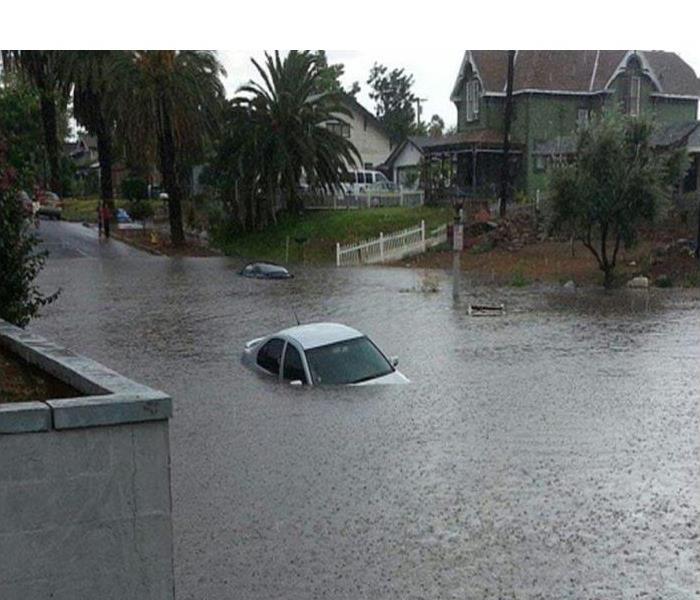 Although we don't get mass amounts of rain to cause this type of flooding in Riverside, we do get flash floods that can cause damage.
Although we don't get mass amounts of rain to cause this type of flooding in Riverside, we do get flash floods that can cause damage.
The chance of wet days in Riverside varies throughout the year. The wetter season lasts 4.2 months, from November 25 to April 1, with a greater than 10% chance of a given day being a wet day.
Though the rain itself usually doesn’t cause structural damage, any water that leaks into a home through gaps in the roof or walls can lead to messes that can be costly to clean up. This water can also lead to damage to walls, ceilings, and floors; as well as mold and mildew problems throughout a home. Also, too much rainwater in a short period of time can overload gutters, causing the rain to fall onto the ground where it can damage the foundation over time. (And of course, rain tends to cause flooding, which has its own problems.)
Clean out roof gutters and downspouts. Clogged gutters allow water to back up onto your roof, increasing the chance of water intrusion into your home or business.Remove loose debris from your yard. Debris, such as fallen tree limbs or unsecured lawn furniture can become dangerous during heavier winds. These items can cause structural damage, such as broken windows, which can lead to water intrusion in your home.Know Your Zone. Determine your flood zoning and prepare appropriately. If you live in a flood prone zone, preparing sandbags may be necessary to help protect your structure.You may be asking yourself when you should replace your roof. Maybe you live or work in an older building, and you know it will become necessary at some point. Perhaps you have seen some water stains in your attic or you have just gone through a season of really heavy weather and some shingles have disappeared. Today we are going to share some things to think about as you decide when you should replace your roof.
Even though it is sunny out and the skies are blue, fall is here along with the rainy season just around the corner. If you have not already been thinking about preparing your home for the rain ahead, now is the perfect time. A simple roof cleaning and maintenance checkup can go a long way to prevent disaster from striking this winter.
A skilled roofing technician can catch things as simple as a loose shingle, or as unexpected as an exterior mortar repair around your chimney. Finding these areas of need now, before the rain exposes the problem and causes more damage, can save you money and potential repairs later down the road.
Think of it this way, do you winterize your boat or RV in preparation for the season? Your roof is no different.
A good seasonal checkup should include the following:
- Broom clean roof surfaces
- Probe all welded seams to ensure proper seam condition (Low slope systems)
- Inspect and renew any caulking, cut edge sealant, etc.
- Access exterior condition of penetrations such as skylights and chimney
- Provide brief photo report to client upon completion of service
- Provide any recommended repairs, if any.
If your home or business experiences a water damage loss, know that SERVPRO of West Riverside City is Here to Help. Our experienced team offers emergency water damage response, 24 hours a day, 7 days a week, allowing us to arrive quickly to begin mitigating the damages.
For more information about our services, call 951-351-8033
How Can Riverside Businesses and Residents Participate in National ShakeOut Day?
10/14/2020 (Permalink)
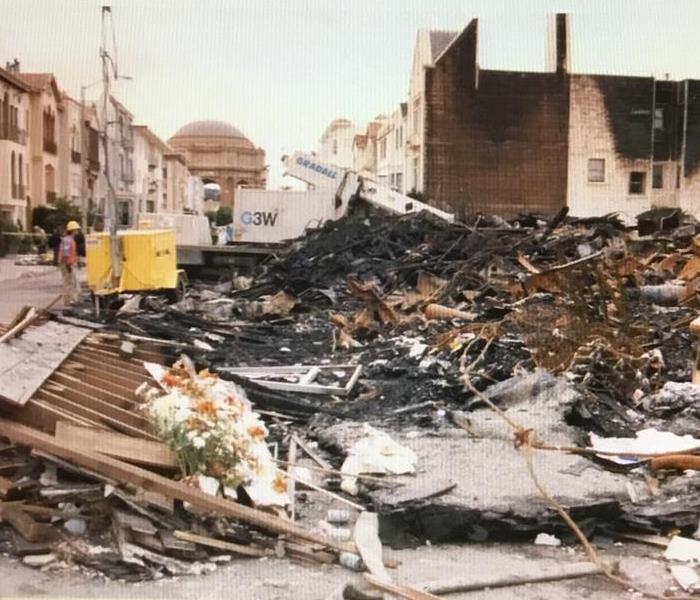 Earthquakes can strike at anytime without warning. Does your family know what to do when they are home? Away from home?
Earthquakes can strike at anytime without warning. Does your family know what to do when they are home? Away from home?
While COVID-19 has brought many uncertainties and challenges, one thing's for sure: ShakeOut is still happening this year!
What and when is ShakeOut? How do I / we participate? Here is information from ShakeOut.org
At a minimum, ShakeOut is a one-minute earthquake drill - you decide when, how, and where you want do it, and with whom.
This annual date was selected back in 2009, when most schools agreed this was the best time. In 2020, International ShakeOut Day is October 15. Everyone, everywhere should know how to protect themselves during an earthquake! Thus, anyone can participate - ShakeOut is for everyone.
You or your organization, however, may hold your ShakeOut drill on another day of the year that you find most convenient. This means that wherever you are at the date and time you designate—at home, at work, at school, anywhere—at the very least you should practice Drop, Cover, and Hold On as if there were a major earthquake occurring at that very moment, and stay in this position for one minute (or more, as you see fit).
You can always do much more for your ShakeOut, such as a response or tabletop exercise, communications test, or activity in which you secure items that could fall or fly in a real earthquake. Learn more: ShakeOut.org/howtoparticipate.
The main goal of the ShakeOut is to get the world prepared for earthquakes, so use the ShakeOut as an opportunity to learn what to do before, during, and after an earthquake.
Everyone, everywhere should participate, from an individual in their home (or even car!) to a school and even a major corporate office. Talk to your friends, family, and co-workers about the ShakeOut and encourage their participation.
Register for free at ShakeOut.org/register to be counted and listed in your community, get email updates, and have the peace of mind knowing you can deal with any earthquake in our future.
How do I protect myself in an earthquake? I have heard about Drop, Cover, and Hold On, but what happened to the "Doorframe" or "Triangle of Life" theory? Why shouldn't I run outside?
The safest thing to do during an earthquake is "Drop, Cover, and Hold On," as described at EarthquakeCountry.org/step5. This special report describes how the "Triangle of Life" is promoted with greatly exaggerated or wrong information, and is potentially very dangerous. Running outside or getting into a doorway is not recommended as objects that are falling and flying can injure you , even cause you to trip and fall, as you move and are upright.
Do you have audio or video to help guide our ShakeOut drill?
Yes! Please see ShakeOut.org/drill/broadcast for versions you can download in English and Spanish (audio and video).
How do I register for ShakeOut? Why should I?
Register for free at ShakeOut.org/register to be counted and listed in your community, get email updates, and have the peace of mind knowing you can deal with any earthquake in our future.
As always, you can hold your #ShakeOut drill when and where you want. You can choose another date or several dates, and include people in multiple locations (home, work, or school), perhaps through video conferencing.
It's actually a good idea to practice earthquake safety in different situations each year.
Watch this video to prepare kids:
https://youtu.be/xFVmFNQ2ves
Riverside Business- 5 Steps to Minimize Mold Risk During and After a Prolonged Shutdown
10/12/2020 (Permalink)
Mold will grow on building materials where there is moisture, produced from leaks or condensation from roofs, windows, or pipes, or from a flood.
Mold can grow on a variety of surfaces, such as ceiling tiles, wallpaper, insulation, drywall, carpet, and fabric. People with asthma and other respiratory conditions and those with mold allergy or weakened immune systems should avoid buildings suspected or confirmed to have mold contamination. Ensure that your building does not have mold after a prolonged shutdown to maintain a safe working environment for returning occupants. Here are 5 steps from CDC.gov:
5 steps to minimize mold risk during and after a prolonged shutdown
- Maintain indoor humidity as low as possible, not exceeding 50%, as measured with a humidity meter. Building managers may consider continuous monitoring of indoor humidity using a digital hygrometer, ideally more than once daily, to minimize the need to access the building.
- After a prolonged shutdown and before occupants return, buildings should be assessed for mold and excess moisture.
- Building inspections by trained industrial hygienists can recognize dampness or mold by sight or odor, without the need for sampling and laboratory analysis. NIOSH offers tools and instructions to assess dampness and mold in schools and general buildings. These tools can be used by building maintenance staff as well as industrial hygienists.
- If dampness or mold is detected, address the source of water entry first. Clean-up and remediation should then be conducted before the building is reoccupied. Plan the remediation before beginning work. Resources for remediation of buildings and homes with mold are provided by NIOSH, the, the EPA, and CDC .
- After an assessment has confirmed that mold and moisture are not detected (Step 2a), OR after remediation has been completed (Step 2b), a building HVAC system that has not been active during a prolonged shutdown should be operated for at least 48 to 72 hours (known as a “flush out” period) before occupants return.
- During this period, open outdoor air dampers to the maximum setting that still allows desired indoor air temperatures.
- If an odor is detected that suggests mold growth (such as a musty smell) after the “flush out” period, look for mold that may not have been identified earlier. If mold is found, conduct remediation as described in Step 2b.
- Continue the “flush out” process until no odors are apparent.
- The condition of HVAC filters used during the “flush out” period should be carefully assessed prior to building occupancy and replaced with new or clean filters as necessary.
- After a building is reopened and occupied, routine (e.g., weekly) checks of the HVAC system are recommended to ensure operating efficiency.
- During HVAC checks, inspect and replace filters as indicated or needed.
- The frequency of HVAC system checks can be gradually reduced (e.g., monthly, quarterly), depending on the operational and maintenance specifications for the HVAC system.
- Maintain indoor temperature and relative humidity within ranges recommended.
- If no routine HVAC operation and maintenance program is in place for the building, one should be developed and implemented. At a minimum, consider including the following:
- Inspection and maintenance of HVAC components
- Calibration of HVAC system controls
- HVAC testing and balancing
Give SERVPRO of West Riverside City a call to inspect your facility if you smell mildew or see signs of mold growth.
National Fire Prevention Week- Helpful Tips for Riverside Residents
10/5/2020 (Permalink)
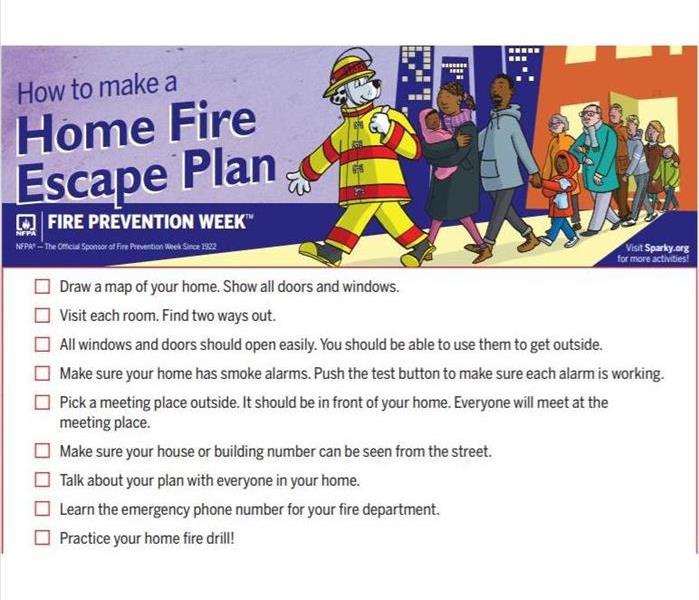 A home fire escape plan is a great first step in recognizing National Fire Prevention Week!
A home fire escape plan is a great first step in recognizing National Fire Prevention Week!
This year’s FPW campaign, “Serve Up Fire Safety in the Kitchen!TM” works to educate everyone about the simple but important actions they can take to keep themselves, and those around them, safe in the kitchen.
These timely tips are from NFPA. With Riverside going into fire season which runs from September through December, these general safety tips will help protect you, your family and your home!
Smoke Alarms
• Smoke alarms detect and alert people to a fire in the early stages. Smoke alarms can mean the difference between life and death in a fire.
• Working smoke alarms cut the risk of dying in a home fire in half.
• Install smoke alarms in every sleeping room, outside each separate
sleeping area, and on every level of the home, including the basement.
• Test smoke alarms at least once a month using the test button.
• Make sure everyone in the home understands the sound of the smoke alarm and knows how to respond.
Home Fire Escape Planning and Practice
Home fire escape planning should include the following:
• Drawing a map of each level of the home, showing all doors and windows
• Going to each room and pointing to the two ways out
• Making sure someone will help children, older adults, and people with disabilities wake up and get out
• Teaching children how to escape on their own in case you cannot help them
• Establishing a meeting place outside and away from the home where everyone can meet after exiting
• Having properly installed and maintained smoke alarms
• Pushing the smoke alarm button to start the drill
• Practicing what to do in case there is smoke: Get low and go. Get out fast.
• Practicing using different ways out and closing doors behind you as you leave
• Never going back for people, pets, or things
• Going to your outdoor meeting place
• Calling 9-1-1 or the local emergency number from a cell phone or a neighbor’s phone
Heating
• Heating equipment is one of the leading causes of home fires during the winter months.
• Space heaters are the type of equipment most often involved in home heating equipment fires.
• All heaters need space. Keep anything that can burn at least 3 feet (1 meter) away from heating equipment.
• Have a 3-foot (1-metre) “kid-free zone” around open fires and space heaters.
• Purchase and use only portable space heaters listed by a qualified testing laboratory.
• Have a qualified professional install heating equipment.
• Maintain heating equipment and chimneys by having them cleaned and inspected by a qualified professional at least once a year.
Look for more tips on our social media platforms.
Instagram
Facebook
Twitter
SERVPRO of West Riverside City has the knowledge and experience to address damage caused by fire, smoke, or water.
We're here to help!
951-351-8033
Fire Prevention Week- A little Cooking…a Little History
10/3/2020 (Permalink)
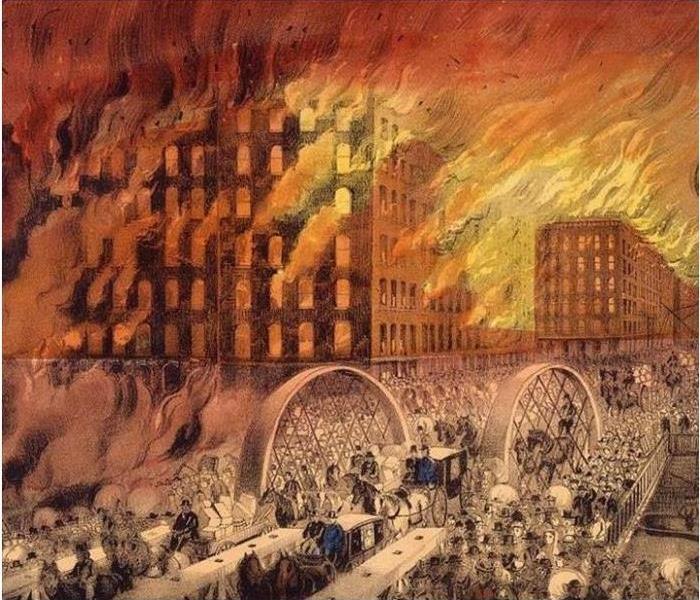 Fire Prevention Week is observed each year during the week of October 9th in commemoration of the Great Chicago Fire
Fire Prevention Week is observed each year during the week of October 9th in commemoration of the Great Chicago Fire
The cooking and baking season is just around the corner. In order to avoid a ruined holiday, follow the advice below!
Families gather to celebrate the holidays by preparing a delicious feast, but if you don’t practice safe cooking habits, your holiday could become hazardous very quickly. According to the National Fire Protection Association, cooking fires are the number one cause of home fires and home injuries.
The leading cause of fires in the kitchen is unattended cooking.
Did you know?
Cooking is the #1 cause of home fires and home fire injuries. Unattended cooking is the leading cause of fires in the kitchen. Follow these tips from NFPA
Recipe for safety
Before you serve a meal, it’s essential to serve up fire safety in the kitchen. There’s nothing like spending time in the kitchen cooking a delicious meal for family and friends or an appetizing treat for yourself. But do you know the important steps to take long before anyone takes the first bite?
Cooking
• Cooking is the leading cause of home fires and home fire injuries. Thanksgiving is the leading day for fires involving cooking equipment.
• The leading cause of fires in the kitchen is unattended cooking.
• Stay in the kitchen when you are frying, boiling, grilling, or broiling food.
• If you are simmering, baking, or roasting food, check it regularly and stay in the home.
• Always keep a lid nearby when cooking. If a small grease fire starts, slide the lid over the pan and turn off the burner. Leave the pan covered until it’s cool.
• Keep anything that can catch fire away from your stovetop.
• Loose clothing can hang down onto stove burners and catch fire. Wear short, close-fitting, or tightly rolled sleeves when cooking.
• Have a “kid-free zone” of at least 3 feet around the stove and areas where hot food or drink is prepared or carried.
Importance of fire prevention
In a fire, mere seconds can mean the difference between a safe escape and a tragedy. Fire safety education isn’t just for school children. Teenagers, adults, and the elderly are also at risk in fires, making it important for every member of the community to take some time every October during Fire Prevention Week™ to make sure they understand how to stay safe in case of a fire.
On this site, you’ll find loads of educational resources to make sure that every person knows what to do in case of a fire. We have everything from apps to videos to printables and much more, to make sure you have the resources you need to keep your family, your community, and your city safe.
About Fire Prevention Week
Since 1922, the NFPA has sponsored the public observance of Fire Prevention Week. In 1925, President Calvin Coolidge proclaimed Fire Prevention Week a national observance, making it the longest-running public health observance in our country. During Fire Prevention Week, children, adults, and teachers learn how to stay safe in case of a fire. Firefighters provide lifesaving public education in an effort to drastically decrease casualties caused by fires. Fire Prevention is a dedicated way to try to improve conditions and make efforts to correct an issue before it turns into a problem.
Fire Prevention Week is observed each year during the week of October 9th in commemoration of the Great Chicago Fire, which began on October 8, 1871, and caused devastating damage. This horrific conflagration killed more than 250 people, left 100,000 homeless, destroyed more than 17,400 structures, and burned more than 2,000 acres of land.
Click for more on Great Chicago Fire
This fire, according to President Calvin Coolidge, could of been prevented if the conditions of the building were better. Please use this month of October to try and help your home or business from fires.
National Preparedness month- Landslides & Debris Flow in Burned Areas
9/30/2020 (Permalink)
With the recent fires and new burn areas, there is a threat of landslides and debris flow during the upcoming rainy season in Riverside County.
Here are some tips from Ready.gov:
Landslides occur in all U.S. states and territories and can be caused by many factors including earthquakes, storms, fire and human modification of land. The most deadly landslides are the ones that occur quickly, often with little notice.
In a landslide, masses of rock, earth or debris move down a slope. Debris and mud flows are rivers of rock, earth and other debris saturated with water. They develop during intense rainfall, runoff, or rapid snowmelt, changing the earth into a flowing river of mud or “slurry.” They can flow rapidly, striking with little or no warning at avalanche speeds (faster than a person can run). They also can travel many miles from their source, growing in size as they pick up trees, boulders, cars and other materials. Debris flows don’t always stay in stream channels and they can flow sideways as well as downhill.
When a wildfire burns a slope, it increases the chance of debris flows for several years. Although some landslides require lengthy rain and saturated slopes, a debris flow can start on a dry slope after only a few minutes of intense rain. “Intense” rain means a burst of rain at a fast rate, about half an inch in an hour. With debris flows, the rate matters more than total rainfall.
How to protect yourself or your property depends on the type of landslide. Land-use zoning, professional inspections, and proper design can reduce many landslide problems but evacuation is often the only way to protect lives from a debris flow or other fast-moving landslide. Never ignore an evacuation order.
Before a Landslide
The following are things you can do to protect yourself, your family and your property from the effects of a landslide or debris flow:
- To begin preparing, you should build an emergency kit and make a family communications plan.
- Connect with your local emergency services, heed evacuation warnings.
- Leave if you have been told to evacuate or you feel it is unsafe to remain in your home. Text SHELTER + your ZIP code to 43362 (4FEMA) to find the nearest shelter in your area (example: shelter 12345).
- Prepare for landslides by following proper land-use procedures - avoid building near steep slopes, close to mountain edges, near drainage ways or along natural erosion valleys.
- Become familiar with the land around you. Learn whether landslides have occurred in your area by contacting local officials. However, don’t assume that what happened last time will happen next time. Debris flows can start in places they’ve never been and return to slopes where they’ve already been.
- Get an assessment of your property by a qualified geotechnical professional.
- Consult a professional for advice on appropriate preventative measures for your home or business, such as flexible pipe fittings, which can better resist breakage.
- Protect your property based on of recommendations from the ‘qualified geotechnical professional’ and/or local city/county guidance on protection from debris flow and flooding. You can't stop or change the path of a debris flow. However, you may be able to protect your property from floodwaters or mud by use of sandbags, retaining walls or k-rails (Jersey barriers).
- In mud and debris flow areas, consider building channels or deflection walls to try to direct the flow around buildings. Be aware, however, that when a flow is big enough, it goes where it pleases. Also, if you divert a flow and it flows on a neighbor's property, you may be liable for damages.
- If you are at risk from a landslide talk to your insurance agent. Debris flow may be covered by flood insurance policies from the National Flood Insurance Program (NFIP).
Recognize Warning Signs
Watch for debris flows and other fast moving landslides that pose threats to life:
- If you are near a wildfire burn area, sign up for emergency alerts and pay attention to weather forecasts for the burn area. The weather in the burn area could be very different from where you are.
- Listen and watch for rushing water, mud, unusual sounds.
- Unusual sounds, such as trees cracking or boulders knocking together, might indicate moving debris.
- A faint rumbling sound that increases in volume is noticeable as the landslide nears.
- Fences, retaining walls, utility poles, k-rails, boulders, or trees move.
- Huge boulders in the landscape can be signs of past debris flows.
Watch for slow-moving landslides that pose threats to property:
- Changes occur in your landscape such as patterns of storm-water drainage on slopes (especially the places where runoff water converges) land movement, small slides, flows, or progressively leaning trees.
- Doors or windows stick or jam for the first time.
- New cracks appear in plaster, tile, brick, or foundations.
- Outside walls, walks, or stairs begin pulling away from the building.
- Slowly developing, widening cracks appear on the ground or on paved areas such as streets or driveways.
- Underground utility lines break.
- Bulging ground appears at the base of a slope.
- Water breaks through the ground surface in new locations.
- Fences, retaining walls, utility poles, or trees tilt or move.
- The ground slopes downward in one direction and may begin shifting in that direction under your feet.
During a Landslide
- Listen to local news stations on a battery-powered radio for warnings.
- Heed all warnings and evacuation notices.
- During a storm that could cause a landslide, stay alert and awake. Many deaths from landslides occur while people are sleeping.
- Be aware that by the time you are sure a debris flow is coming, that will be too late to get away safely. Never cross a road with water or mud flowing. Never cross a bridge if you see a flow approaching. It can grow faster and larger too quickly for you to escape.
- If you do get stuck in the path of a landslide move uphill as quickly as possible.
- Avoid river valleys and low-lying areas during times of danger.
- If you are near a stream or channel, be alert for any sudden increase or decrease in water flow or water that changes from clear to muddy. These can be signs that a landslide is coming.
After a Landslide
- Stay away from the slide area. There may be danger of additional slides.
- Listen to local radio or television stations for the latest emergency information.
- Watch for flooding. Floods sometimes follow landslides and debris flows because they may both be started by the same conditions.
- Check for injured and trapped persons near the slide, without entering the direct slide area. Direct rescuers to their locations.
- Report broken utility lines and damaged roadways and railways to appropriate authorities. Reporting potential hazards will get the utilities turned off as quickly as possible, preventing further hazard and injury.
- Allow trained professionals to check the building foundation, chimney, and surrounding land for damage.
- Replant damaged ground as soon as possible since erosion caused by loss of ground cover can lead to flash flooding and additional landslides in the near future.
- Seek advice from a geotechnical expert for evaluating landslide hazards or designing corrective techniques to reduce landslide risk. A professional will be able to advise you of the best ways to prevent or reduce landslide risk, without creating further hazard.
Tip Sheets
If you live in a burn area, follow the guidance from READY.Gov, keep SERVPRO's number handy and be sure to follow evacuation orders.
SERVPRO of West Riverside City
951-351-8033
Follow us on Instagram and Facebook for tips and updates.
Check out our blogs throughout the month of Sept for more information on how to prepare for disasters, especially those prone in the Riverside area. Make a plan, and talk to your kids to keep your family safe.
National Preparedness Month- Pets and Animals
9/28/2020 (Permalink)
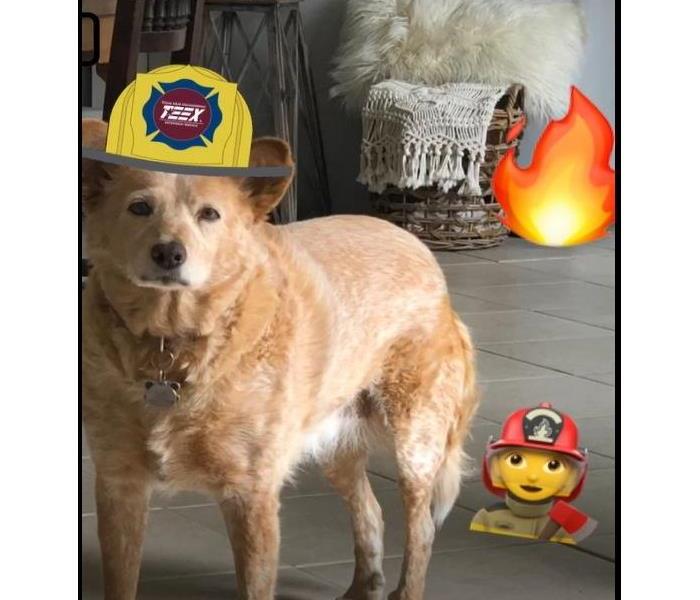 SERVPRO has prepared Ellie our Cattle dog for any emergency!
SERVPRO has prepared Ellie our Cattle dog for any emergency!
With the threat of fires and earthquakes in the Riverside area its important not to forget our pets. Some families have to leave their pets behind because of how quickly many need to evacuate. This information from Ready.gov will help you prepare your pets.
Get Informed
- Know what disasters could affect your area, which could call for an evacuation and when to shelter in place.
- Keep a NOAA Weather Radio tuned to your local emergency station and monitor TV, radio and follow mobile alert and mobile warnings about severe weather in your area.
- Download the FEMA app and get weather alerts from the National Weather Service for up to five different locations anywhere in the United States.
Make a Plan
Remember, during a disaster what’s good for you is good for your pet, so get them ready today.
If you leave your pets behind, they may be lost, injured or worse. Never leave a pet chained outdoors. Plan options include:
- Create a buddy system in case you’re not home. Ask a trusted neighbor to check on your animals.
- Identify shelters. For public health reasons, many emergency shelters cannot accept pets.
- Locate boarding facilities or animal hospitals near your evacuation shelter.
- Consider an out-of-town friend or relative.
- Locate a veterinarian or animal hospital in the area where you may be seeking temporary shelter in case your pet needs medical care. Add the contact information to your emergency kit.
- Have your pet microchipped and make sure that you not only keep your address and phone number up-to-date, but that you also include contact info for an emergency contact outside of your immediate area.
- Call your local emergency management office, animal shelter or animal control office to get advice and information.
- If you are unable to return to your home right away, you may need to board your pet. Find out where pet boarding facilities are located.
- Most boarding kennels, veterinarians and animal shelters will need your pet's medical records to make sure all vaccinations are current.
- If you have no alternative but to leave your pet at home, there are some precautions you must take, but remember that leaving your pet at home alone can place your animal in great danger!
Tips for Large Animals
If you have large animals such as horses, cattle, sheep, goats or pigs on your property, be sure to prepare before a disaster.
- Ensure all animals have some form of identification.
- Evacuate animals whenever possible. Map out primary and secondary routes in advance.
- Make available vehicles and trailers needed for transporting and supporting each type of animal. Also make available experienced handlers and drivers.
- Ensure destinations have food, water, veterinary care and handling equipment.
- If evacuation is not possible, animal owners must decide whether to move large animals to shelter or turn them outside.
Take extra time to observe livestock, looking for early signs of disease and injury. Severe cold-weather injuries or death primarily occur in the very young or in animals that are already debilitated.
Animals suffering from frostbite don’t exhibit pain. It may be up to two weeks before the injury becomes evident as the damaged tissue starts to slough away. At that point, the injury should be treated as an open wound and a veterinarian should be consulted.
Make sure your livestock has the following to help prevent cold-weather problems:
- Plenty of dry bedding to insulate vulnerable udders, genitals and legs from the frozen ground and frigid winds.
- Windbreaks to keep animals safe from frigid conditions.
- Plenty of food and water.
Build a Kit
Include basic survival items and items to keep your pet happy and comfortable. Start with this list or download Preparing Makes Sense for Pet Owners-Emergency Preparedness Pet Kit List (PDF) to find out exactly what items your pet needs to be Ready.
Your kit should include:
- Food (at least a three day supply in an airtight, waterproof container)
- Water (at least three days of water specifically for your pets)
- Medicines
- Medical records, proof of vaccinations, registration and adoption documents (talk to your veterinarian about microchipping)
- First aid kit (cotton bandage rolls, bandage tape and scissors, antibiotic ointment, flea and tick prevention, latex gloves, isopropyl alcohol, saline solution and a pet first aid reference book)
- Collar or harness with ID tag, rabies tag and a leash
- Crate or pet carrier (a sturdy, safe crate or carrier large enough for your pet to stand, turn around and lie down)
- Sanitation needs (litter box and litter, newspapers, paper towels, plastic trash bags and household chlorine bleach)
- A picture of you and your pet together to prove ownership (add species, breed, age, sex, color and distinguishing characteristics)
- Familiar items (treats, toys and bedding can help reduce stress for your pet)
SERVPRO of West Riverside City urges pet owners to plan for your pets. Include them in your evacuation plan and know where to go and where pets can be taken.
SERVPRO has prepared Ellie our Cattle dog for any emergency!
National Preparedness Month- Week 4: Teach Youth About Preparedness- Wildfires
9/23/2020 (Permalink)
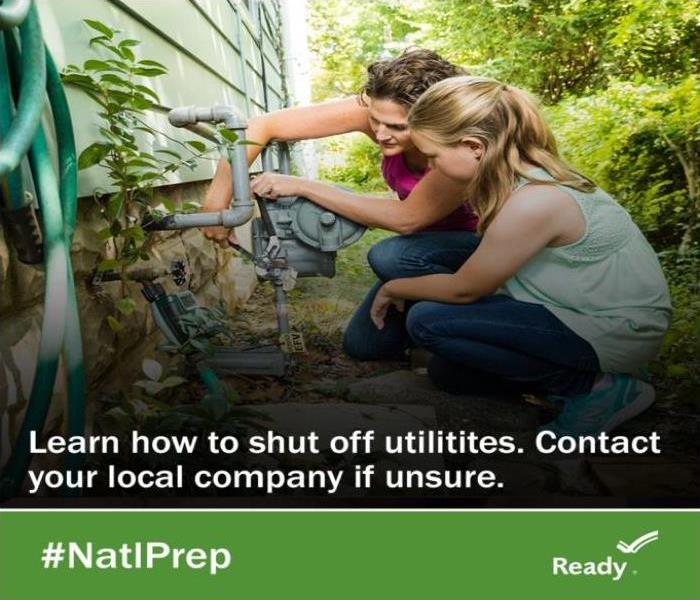 Talk to your family about shut off valves and where they are located.
Talk to your family about shut off valves and where they are located.
Each year Riverside county is faced with wildfires.
How can you ensure your kids are informed on what to do if a wildfire hits your Riverside area. What if your kids are not with you when this happens? Ready.gov can help you and your family plan for such disasters. Here are some tips.
A wildfire is a fire that burns out of control in a natural area, like a forest, grassland, or prairie. Wildfires can start from natural causes, such as lightening, but they are usually caused by humans, such as campers or hikers who did not put out their campfire properly. Wildfires spread quickly, burning brush, trees, and homes in its path. They can also affect natural resources (such as soil, animals, forests), destroy homes, and put people’s lives in danger.
Words to know!
Evacuation
Leaving an area that has been declared unsafe.
Evacuation Notice
An evacuation notice tells you that a fire is nearby, and it is important—or mandatory—to leave the area.
Fire Extinguisher
A fire protection device that sprays foam and is used to help put out small fires.
Fire Weather Watch
A notice that dangerous fire weather conditions are possible over the next 12 to 72 hours.
Red Flag Warning
Also called a Fire Weather Warning, it is a warning for when fire danger exists because of weather patterns.
Smoke Alarms
Sensors attached to the ceiling that sound an alarm when they sense smoke.
Am I at Risk?
Wildfires can happen anywhere, anytime. The chance of wildfires happening is higher when there is little or no rainfall. This makes bushes, grass and trees dry and easier to burn. High winds can spread wildfires. Your community may have a designated wildfire season when the risk is particularly high.
What Can I do?
Before
- Build an emergency kit.
- Make a family communications plan.
- Know your evacuation route.
- Make sure your family has smoke alarms on every level of your home, especially in bedrooms. Ask your parents to check them every month and to change the batteries every year.
- If you don’t have a smoke alarm, check with your local fire department about getting a free one.
- Help your parents to rake the lawn and get rid of leaves and twigs. These can catch fire if a wildfire is near your home. Never play with matches. You could accidentally start a fire.
During
- Listen to emergency officials
- Follow local emergency officials’ orders. If they say to evacuate, do so immediately.
- If you see a wildfire, call 911. You may be the first person to have spotted it!
- If trapped, call 9-1-1.
- An adult might ask you to wear a mask. Keep this on- it will help keep dangerous particles from smoke and ash out of the air you breathe.
After
- Call 9-1-1 and seek help immediately if you or someone you are with has been burned. Cool and cover burns to reduce the chance of further injury or infection.
- If you are at home, keep a “fire watch.” That means, look for smoke or sparks throughout the house. If you see anything, tell a grown-up immediately!
- If you have evacuated, do not go home until safety officials say it’s okay. Stay away from downed or dangling power lines. They could electrocute you.
- Avoid walking on hot/burning surfaces. After a fire, the ground may contain heat pockets or hidden embers. Stay away. They could burn you or spark another fire.
- If you have animals, watch them closely and keep them under your control. Note that hidden embers and hot spots could burn their paws or hooves.
- Do not use water from the faucet unless emergency officials say it’s okay.
- Burned areas should be monitored for at least 12 hours to make sure the fire is out and danger has past.
- Do not attempt to remove heavy debris by yourself. Wear protective clothing, including a long-sleeved shirt, long pants, work gloves and sturdy, thick-soled shoes during clean up. These will protect you from further injury from broken glass, exposed nails or other objects.
- Throw away food exposed to heat, smoke, or soot. When in doubt throw it out.
- Use text or social media to communicate with your family and friends.
Watch a Video
Did you know?
The three elements needed to create and keep a fire burning are heat, fuel, and oxygen, also known as the fire triangle.
Incident Meteorologists (IMETs) are a group of around 70 specially-trained weather experts with the National Weather Service. They work closely with wildfire responders at wildfire sites to monitor, analyze, and report fire and weather conditions. Their forecasts help firefighters plan operations when dealing with the unpredictable nature of fire. This helps keep emergency responders safe.
Please use the link to watch a couple of videos with your kids to help them understand further the threat of a wildfire and what they can do.
FEMA Prepare for Kids
Disaster Dodgers
Wildfires can cause a lot of damage to your home. Let SERVPRO help you, keep our information handy. We are an emergency service company. We know how to address damage due to fire, smoke, soot or water.
SERVPRO of West Riverside City
951-351-8033
We are available 24/7, we are always here to help!
National Preparedness Month- Week 4: Teach Youth About Preparedness- Earthquakes.
9/22/2020 (Permalink)
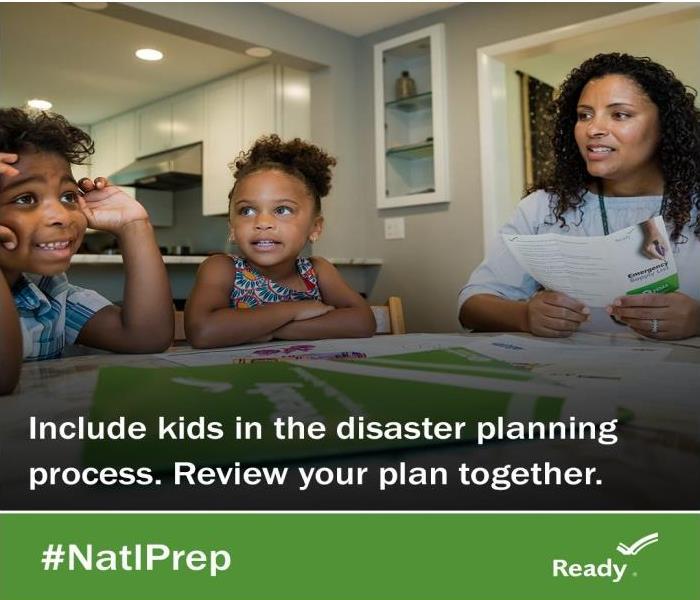 Prepare now, keep your family safe.
Prepare now, keep your family safe.
Talk to your kids about preparing for emergencies and what to do in case you are separated. Reassure them by providing information about how they can get involved.
In Riverside County, disasters can hit any time. Two that have impacted the area recently are Earthquakes and Wildfires. With the recent 3.3 earthquake in Lake Elsinore and 4.5 earthquake in South El Monte (that was felt all the way to Beaumont), it's important to be prepared for these events. In light of National Preparedness Month. We will address how to prepare your kids for earthquakes. Next blog will discuss how to prepare you kids for wildfires.
An earthquake is the sudden, quick shaking of the earth. It is caused by rock breaking and moving under the ground. Additional earthquakes, known as aftershocks, can occur for hours, days, or even months after an earthquake. These are usually smaller than the first earthquake. However, they could cause more damage to structures weakened by the first earthquake.
Earthquakes can also cause tsunamis. Tsunamis are a series of waves caused by a large and sudden disturbance of the sea.
Aftershock
Another earthquake that happens after the first earthquake. These are usually smaller than the first earthquake.
Epicenter
The center of an earthquake. Vibrations are sent from the epicenter in many directions.
Fault Lines
Cracks in the rocks below the earth’s surface.
Seismic Activity
This is another word for earthquakes, along with tremors, quakes, and shakers.
Seismograph
A machine that measures an earthquake.
All 50 states and 5 U.S. territories are at some risk for earthquakes. Earthquakes can happen at any time of the year and occur without warning. Scientists are working on a way to detect when an earthquake may happen.
Before
- Build an emergency kit.
- Make a family communications plan.
- Know the safe spots in every room—under a sturdy table or against an inside wall.
- Secure household items.
- Ask your family to hold earthquake drills—drop, cover, and hold on!
During
- If you are inside: DROP to the ground. COVER yourself under a sturdy table or other heavy furniture. If there is nothing to get under, cover your head and neck with your arms and crouch near an inside wall. HOLD ON until the shaking stops.
- If you are using a wheelchair or a walker with a seat: LOCK your wheels. COVER your head and neck with your arms, a pillow, a book, or whatever is available. HOLD ON and maintain your position with your head and neck covered until the shaking stops.
- If you are in bed, stay there and cover your head and neck with a pillow.
- STAY AWAY from windows, glass, lighting fixtures, or furniture that could fall, like bookcases.
- STAY INSIDE! Do not use elevators!
- If you are outside: Stay there. Move away from buildings, streetlights, and wires until the shaking stops. Be very careful before re-entering your home or other buildings. Be sure a parent or adult is with you.
After
- Expect aftershocks. They are usually not as strong but can cause damage.
- Do not enter a damaged building.
- Open cabinets carefully. Objects might have moved and could fall on you.
- Wear long pants, long sleeves, and shoes to protect your skin from getting scratched by broken objects.
- Text, don’t talk. Unless there’s a life-threatening situation, send a text so that you don’t tie up phone lines needed by emergency workers. Plus, texting may work even if cell service is down.
Watch this video with your kids
Ready.gov Earthquake Preparedness Video
Earthquakes are prone to causing other disasters such as water or fire disasters. Keep our number handy:
SERVPRO of West Riverside City
951-351-8033
We are here for you 24/7
We are trained to handle emergency disasters. We have the tools, gear and experience needed to handle water or fire damage.
How to Prepare Your Riverside Home for an Earthquake
9/17/2020 (Permalink)
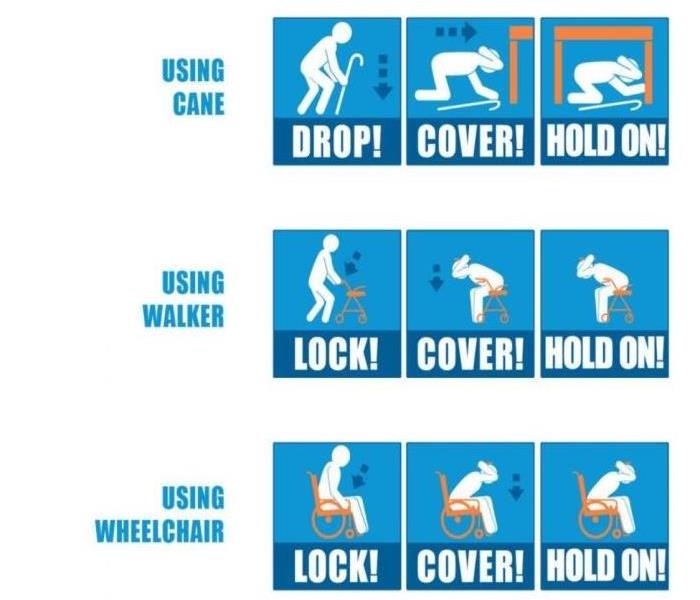 Stay Safe During an Earthquake: Drop, Cover, and Hold On
Stay Safe During an Earthquake: Drop, Cover, and Hold On
A new study suggests that the Ridgecrest quakes have increased the chances of another big one occurring, this time in southern California. A big enough quake along the Garlock—magnitude 7.5 or bigger, by the researchers' calculations—could spark a quake along the San Andreas that travels southward toward Los Angeles. From National Geographic.
Take action now, before an earthquake hits.
• Secure items that might fall and cause injuries (e.g., bookshelves, mirrors, light fixtures).
• Practice how to Drop, Cover, and Hold On by participating in a ShakeOut earthquake drill (www.ShakeOut.org).
• Store critical supplies and documents.
• Plan how you will communicate with family members.
To prevent potential injuries, take the time to secure your space. Secure items that might fall, fly, or slide in an earthquake (see www.earthquakecountry.org/step1). Imagine if the room was picked up and shaken up and down and side to side and then determine what items would be thrown around. Periodically review the locations where you spend time—your home, workplace, or school—to look for potential hazards and secure them.
DO A HAZARD HUNT FOR POTENTIAL HAZARDS AND THINGS THAT MIGHT FALL
1. Cabinet doors can fly open allowing contents to crash to the floor; secure them with latches.
2. Objects such as framed photos, books, lamps, and other items that you keep on shelves and tables can become flying hazards. Secure them with hooks, adhesives, or earthquake putty to keep them in place. Move heavy or breakable items to lower shelves.
3. Mirrors, pictures frames, and other hanging items should be secured to the wall with closed hooks or earthquake putty. Do not hang heavy objects over beds, sofas, or any place you may be seated.
4. Electronics such as computers, televisions, and microwave ovens are heavy and expensive to replace. Secure them with flexible nylon straps.
5. Bookcases, filing cabinets, china cabinets, and other tall furniture should be anchored to wall studs, (not drywall), or masonry. Use flexible straps that allow them to sway without falling to the floor.
6. Secure your water heater, refrigerator, and other major appliances with the appropriate straps screwed into the wall studs or masonry to help keep them from falling over and rupturing gas or electric connections. Gas appliances should have flexible connectors to absorb the shaking while reducing the risk of fire.
ASSEMBLING EMERGENCY SUPPLIES Take the time now to collect the emergency supplies you would need if the power was out, water supplies were cut off, and grocery stores were not open. You can build your supplies over time by adding a few items as your budget permits. Basic emergency supplies should include the following, most of which you probably already have in your home.
WATER – Ensure you have at least 1 gallon of water per person per day for at least 3 days. (Store a longer than 3-day supply of water, if possible). An average person needs to drink about 3/4 of a gallon of fluid daily. Individual needs vary depending on age, gender, health, level of activity, food choices, and climate. You may also need stored water for food preparation.
FOOD – Store at least a 3-day supply of non-perishable food for members of your household, including pets. Consider special dietary needs (e.g., infant formula). Include a non-electric can opener for canned food.
FLASHLIGHT, RADIO, and CELL PHONE CHARGER – You will need to be able to charge these items without electricity. Your flashlight and radio should be either hand-cranked or battery-powered, and stored with extra batteries. Your cell phone charger should be hand-crank, solar, or able to be charged from a car outlet.
MEDICAL – Include first aid kit, prescription and non-prescription/over-the-counter medications, and medical supplies.
SANITATION – Pack supplies for sanitation, such as hand sanitizer, towelettes, paper products, and plastic bags, for use when water resources are limited.
ASSISTIVE TECHNOLOGY – Include battery backup power for power-dependent mobility devices, oxygen, and other assistive technology needs.
CLOTHING AND BLANKETS – Ensure you have clothing with long sleeves and long pants, thick-soled shoes, and work gloves to protect yourself after the earthquake, and a sleeping bag or warm blanket for each person, if you live in a cold-weather climate.
WHISTLE – Include a whistle to signal for help.
CASH – Store cash in case ATMs are not functioning after the earthquake.
FIRE EXTINGUISHER – Earthquakes can cause fires to break out; have a fire extinguisher so you can put out any small fires. Use a fire extinguisher only if you are physically capable.
Consider storing supplies in several locations if possible. This means having basic supplies of food and water in locations, including your workplace, your vehicle, and, if possible, other places you and members of your household regularly spend time (e.g., house of worship, community center, and school). It is important to consider the unique needs of your family, including access and functional needs, and the needs of children and pets. You may need to include: extra water; special food, such as infant formula or pet food; and supplies or equipment, such as diapers, glasses, or medical equipment. Download Emergency Supply Checklist at www.ready.gov/build-a-kit.
DEVELOP A COMMUNICATIONS PLAN Your family may not be together when an earthquake hits, so it is important to know how you will contact one another and how you will get back together in case of an emergency. Landline and cellular phone systems are often overwhelmed following a disaster, so you may need to use text messaging or social media to communicate with family and friends. Keep important numbers written down in your wallet in case you cannot access the contact list in your phone. For more information, including a sample household communications plan, visit www.ready.gov/make-a-plan.
Check with your insurance agent regarding coverage for earthquakes. Most likely your normal homeowners policy will not cover damage from earthquake. It might cover if the earthquake caused a fire, then damage from the fire would be covered.
Should you experience damage from an earthquake, SERVPRO can inspect for FREE. Keep us in mind for those unexpected disasters, and be prepared.
SERVPRO of West Riverside City
951-351-8033
"We are Faster to Any Size Disaster"
National Preparedness Week 3: Prepare for Disasters in Riverside City
9/14/2020 (Permalink)
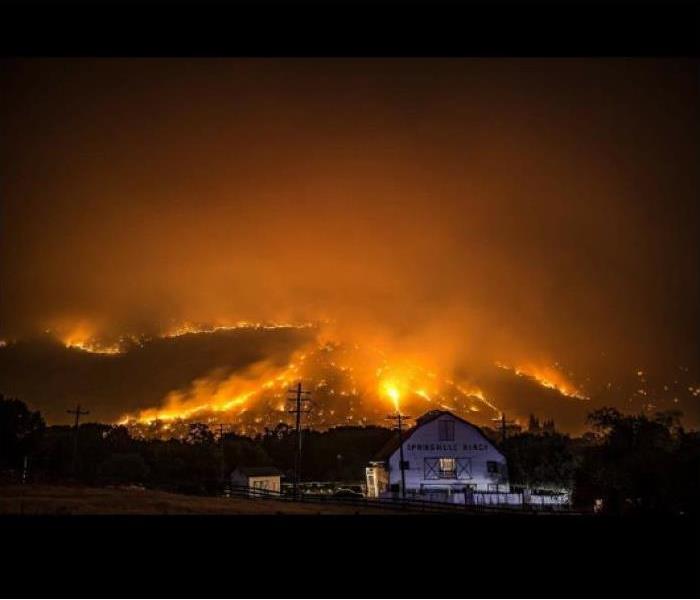 In 2019, 87% of wildfires were caused by humans.
In 2019, 87% of wildfires were caused by humans.
With fires taking place all over California, being prepared hits close to home especially for residents in Azusa, Yucaipa and those near Sequoia National Forest.
The information from Ready.gov helps limit the impacts that disasters have on you and your family. Know the risk of disasters in your area and check your insurance coverage. Learn how to make your home stronger in the face of fires, earthquakes, heat waves and other common hazards and act fast if you receive a local warning or alert.
In this blog we will discuss how to prepare for wildfires and extreme heat. Look for our next blog covering being prepared for earthquakes.
Wildfires
Wildfires can ruin homes and cause injuries or death to people and animals. A wildfire is an unplanned fire that burns in a natural area such as a forest, grassland, or prairie. Wildfires can:
- Often be caused by humans or lightning.
- Cause flooding or disrupt transportation, gas, power, and communications.
- Happen anywhere, anytime. Risk increases with in periods of little rain and high winds.
- Cost the Federal Government billions of dollars each year.
IF YOU ARE UNDER A WILDFIRE WARNING, GET TO SAFETY RIGHT AWAY
- Leave if told to do so.
- If trapped, call 9-1-1.
- Listen for emergency information and alerts.
- Use N95 masks to keep particles out of the air you breathe.
HOW TO STAY SAFE WHEN A WILDFIRE THREATENS
Prepare NOW
Sign up for your community’s warning system. The Emergency Alert System (EAS) and National Oceanic and Atmospheric Administration (NOAA) Weather Radio also provide emergency alerts. Sign up for email updates about coronavirus from the Centers for Disease Control and Prevention (CDC). Check AirNow.gov for information about your local air quality.
- Know your community’s evacuation routes and find several ways to leave the area. Drive the evacuation routes while following the latest guidelines from the Centers for Disease Control and Prevention (CDC) and your state and local authorities to prevent the spread of COVID-19. Have a plan for pets and livestock. Remember that some shelters do not accept pets.
- Prepare for long-term social distancing by gathering emergency supplies. Include cleaning supplies, non-perishable foods, first aid supplies, and water. Consider gathering soap, hand sanitizer that contains at least 60 percent alcohol, household cleaning supplies, and masks to help slow the spread of COVID-19. Set aside supplies in case you must evacuate to your safe location. After a wildfire, you may not have access to these supplies for days or even weeks. Don’t forget the needs of pets. Keep in mind each person’s specific needs, including medication. Obtain extra batteries and charging devices for phones and other critical equipment. Being prepared allows you to address smaller medical issues at home, alleviating the burden on urgent care centers and hospitals.
- Being prepared allows you to avoid unnecessary excursions and to address minor medical issues at home, alleviating the burden on urgent care centers and hospitals.
- Remember that not everyone can afford to respond by stocking up on necessities. For those who can afford it, making essential purchases and slowly building up supplies in advance will allow for longer time periods between shopping trips. This helps to protect those who are unable to procure essentials in advance of the pandemic and must shop more frequently. In addition, consider avoiding WIC-approved products so that those who rely on these products can access them.
- If you already have one at home, set aside a respirator, like an N95 respirator, to keep smoke particles out of the air you breathe. Respirators are not meant to fit children. Due to COVID-19, it may be difficult to find respirators. While cloth face coverings, surgical masks, and dust masks provide protection from exposure to COVID-19, they will not protect you from smoke inhalation. To ensure that healthcare workers have access to N95 respirators, it is best to limit your exposure to smoke rather than buy respirators.
- Designate a room that can be closed off from outside air. Close all doors and windows. Set up a portable air cleaner to keep indoor pollution levels low when smoky conditions exist.
- Keep important documents in a fireproof, safe place. Create password-protected digital copies.
- Use fire-resistant materials to build, renovate, or make repairs.
- Find an outdoor water source with a hose that can reach any area of your property.
- Create a fire-resistant zone that is free of leaves, debris, or flammable materials for at least 30 feet from your home.
- Review insurance coverage to make sure it is enough to replace your property.
- Pay attention to air quality alerts.
Extreme Heat
Extreme heat is a period of high heat and humidity with temperatures above 90 degrees for at least two to three days. In extreme heat your body works extra hard to maintain a normal temperature, which can lead to death. In fact, extreme heat is responsible for the highest number of annual deaths among all weather-related hazards.
Remember:
- Extreme heat can occur quickly and without warning.
- Older adults, children and sick or overweight individuals are at greater risk from extreme heat.
- Humidity increases the feeling of heat as measured by a heat index.
IF YOU ARE UNDER AN EXTREME HEAT WARNING:
- Find air conditioning.
- Avoid strenuous activities.
- Wear light clothing.
- Check on family members and neighbors.
- Drink plenty of fluids.
- Watch for heat cramps, heat exhaustion and heat stroke.
- Never leave people or pets in a closed car.
HOW TO STAY SAFE WHEN EXTREME HEAT THREATENS
Prepare NOW
Find places in your community where you can go to get cool while following the latest guidelines from CDC about social distancing to reduce the spread of COVID-19.
Try to keep your home cool:
- Do not rely on a fan as your primary cooling device.
- Cover windows with drapes or shades.
- Weather-strip doors and windows.
- Use window reflectors such as aluminum foil-covered cardboard to reflect heat back outside.
- Add insulation to keep the heat out.
- Use a powered attic ventilator, or attic fan, to regulate the heat level of a building’s attic by clearing hot air.
- Install window air conditioners and insulate around them.
- Learn to recognize the signs of heat illness. For more information visit: www.cdc.gov/disasters/extremeheat/warning.html
If you are directly impacted by fire, or even smoke damage we have years of experience on remediating damage. We can help, and we offer FREE inspections! Call us 951-351-8033
What to do when smoke and ash invade your Riverside home.
9/9/2020 (Permalink)
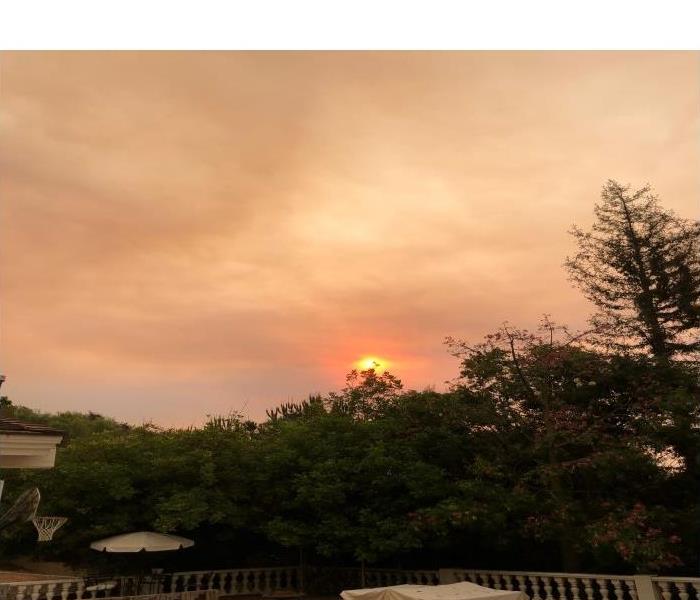 In the wake of a fire that has covered homes with smoke and ash, it’s important to begin cleanup as soon as possible.
In the wake of a fire that has covered homes with smoke and ash, it’s important to begin cleanup as soon as possible.
SERVPRO of West Riverside, CA is an IICRC firm. The Institute of Inspection, Cleaning and Restoration Certification (IICRC) creates the standards for the restoration industry and provides training and certification to restoration companies. IICRC Certified Firms have the right to display the IICRC Certified Logo.
IICRC has many tips and suggestions for consumers. Please consider the following information from the IICRC regarding fire and smoke restoration:
In the wake of a fire that has covered homes with smoke and ash, it’s important to begin clean up as soon as possible in order to prevent permanent damage or discoloration from soot residue. The IICRC provides the following tips for fire victims facing clean up:
- Safety is most important. Wear an N-95 ANSI-approved dust mask (like a
painter’s mask) and work gloves during cleanup.
- Ventilate the home. Place a box fan in an open window to draw
smoke-odor laden air and char out of the building.
- Replace ventilation filters as soon as possible, then run the ventilation system to filter-out smoke-related particles.
- Clean the exterior of the building of fire-damaged debris, smoke and char particles. Exterior cleaning includes washing off the building, sidewalks, driveways and decks with detergent and fresh water scrubbing followed by rinsing.
- Clean the interior by dry HEPA (High Efficiency Particulate Air), vacuuming the ceiling, upper and lower walls and then flooring. In some situations, detergent wet cleaning must be applied to remove a smoke film which impacts and absorbs onto surfaces.
Vacuum contents and upholstery. Make sure your house or building vacuum is HEPA rated, otherwise, you risk blowing smoke and soot into the air.
- Draperies, clothing and machine-washable items such as towels
may be dry cleaned or laundered.
- Unless the upholstery manufacturer says otherwise, use a mild alkaline cleaner to neutralize acid in smoke, soot, char and ash.
- Most exterior walls (brick, stone, wood, paint, siding) and eaves can be cleaned by spraying with a detergent, agitating soot with a soft-bristled brush, pressure washing from bottom to top, then rinse from top to bottom.
- When smoke and soot damage and residue is moderate or heavy, or you cannot complete smoke and soot odor removal on your own, consider hiring a professional who is certified in fire and smoke damage restoration to cleanup and restore your home or business and belongings.
- Check with your insurance provider to determine if smoke damage from outdoor sources is covered under your policy. Insurance companies can often provide a list of credible restoration companies from which property owners can choose.
- If the fire has warped or distorted the structure, consult a general contractor who can also be found in the IICRC list of approved restorers.
Reduce smoke exposure outdoors
- Take it easier during smoky times to reduce how much smoke you inhale. If it looks or smells smoky outside, avoid strenuous activities such as mowing the lawn or going for a run.
- Know your air quality. Smoke levels can change a lot during the day, so wait until air quality is better before you are active outdoors. Check your state or local air quality agency’s website or airnow.gov for air quality forecasts and current air quality conditions. On AirNow, you can also sign up to get email notifications, download an air quality app, or check current fire conditions. In addition, some communities have visual range programs where you can assess smoke conditions by how far you can see.
- Have enough food and medication on hand to last several days so you don’t have to go out for supplies. If you must go out, avoid the smokiest times of day.
- Reduce smoke in your vehicle by closing the windows and vents and running the air conditioner in recirculate mode. Slow down when you drive in smoky conditions.
- Do not rely on dust masks or bandanas for protection from smoke. If you must be out in smoky conditions, an N95 respirator can protect you, if it fits snugly to your face and is worn properly.
- Have a plan to evacuate. Know how you will get alerts and health warnings, including air quality reports and public service announcements (PSAs). Public advisories can provide important information such as changing smoke conditions and evacuation notices. Know your evacuation routes, organize your important items ahead of time, and know where to go in case you have to evacuate.
Professional restoration technicians know that damage increases and restoration costs escalate the longer neutralization, corrosion control and cleaning is delayed. When homeowners prolong the restoration of their home, they extend the effects brought on by the smoke exposure.
When hiring a fire and smoke removal professional in your area, make sure that the technician is a certified Fire and Smoke Restoration Technician (FSRT) to ensure they are educated on the latest techniques for proper remediation. In some cases, a mold remediator may also be necessary as the volume of water used to combat fires can result in an abundance of standing water within a property, leading to mold growth.
For more details, visit https://cdn.ymaws.com/www.IICRC.org/resource/resmgr/docs/112018_cawildfiredoc.pdf
Need a professional? Call SERVPRO of West Riverside City 951-351-8033 today. We are here to help 24/7.
You can follow us on Facebook: https://www.facebook.com/westriverside/
National Preparedness Month- Week 2: Build A Kit
9/7/2020 (Permalink)
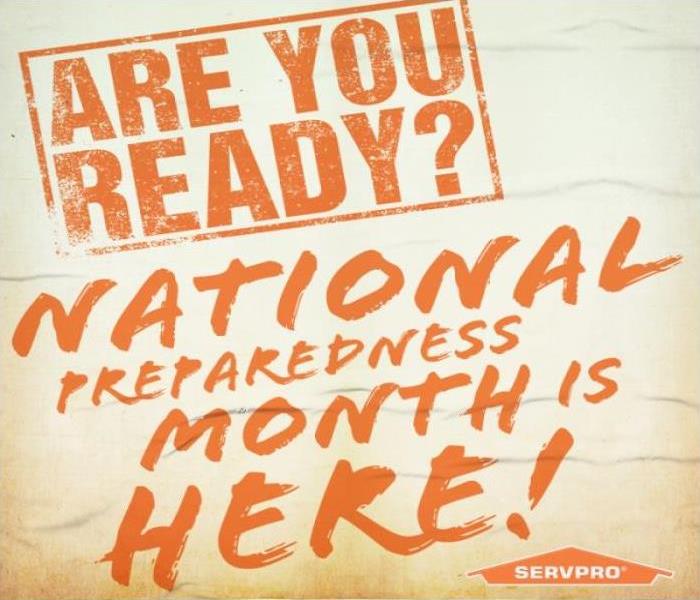 After an emergency, you may need to survive on your own for several days. Are you prepared?
After an emergency, you may need to survive on your own for several days. Are you prepared?
In California, we are affected by wild fires and earthquakes. However, any other natural disaster can hit at any time. Week 2 of National Preparedness Month is building a kit. Do you have the essential items for you and your family should you lose power? Or if all stores are closed?
Gather supplies that will last for several days after a disaster for everyone living in your home. Don’t forget to consider the unique needs each person or pet may have in case you have to evacuate quickly. Update your kits and supplies based on recommendations by the Centers for Disease Control.
Here are some tips on building a kit from Ready.gov:
After an emergency, you may need to survive on your own for several days. Being prepared means having your own food, water and other supplies to last for several days. A disaster supplies kit is a collection of basic items your household may need in the event of an emergency.
Make sure your emergency kit is stocked with the items on the checklist below. Most of the items are inexpensive and easy to find and any one of them could save your life. Headed to the store? Download a printable version to take with you. Once you take a look at the basic items consider what unique needs your family might have, such as supplies for pets or seniors.
Basic Disaster Supplies Kit
To assemble your kit store items in airtight plastic bags and put your entire disaster supplies kit in one or two easy-to-carry containers such as plastic bins or a duffel bag.
A basic emergency supply kit could include the following recommended items:
- Water (one gallon per person per day for at least three days, for drinking and sanitation)
- Food (at least a three-day supply of non-perishable food)
- Battery-powered or hand crank radio and a NOAA Weather Radio with tone alert
- Flashlight
- First aid kit
- Extra batteries
- Whistle (to signal for help)
- Dust mask (to help filter contaminated air)
- Plastic sheeting and duct tape (to shelter in place)
- Moist towelettes, garbage bags and plastic ties (for personal sanitation)
- Wrench or pliers (to turn off utilities)
- Manual can opener (for food)
- Local maps
- Cell phone with chargers and a backup battery
- Download the Recommended Supplies List (PDF)
Additional Emergency Supplies
Since Spring of 2020, the CDC has recommended people include additional items in their kits to help prevent the spread of coronavirus or other viruses and the flu.
Consider adding the following items to your emergency supply kit based on your individual needs:
- Cloth face coverings (for everyone ages 2 and above), soap, hand sanitizer, disinfecting wipes to disinfect surfaces
- Prescription medications
- Non-prescription medications such as pain relievers, anti-diarrhea medication, antacids or laxatives
- Prescription eyeglasses and contact lens solution
- Infant formula, bottles, diapers, wipes and diaper rash cream
- Pet food and extra water for your pet
- Cash or traveler's checks
- Important family documents such as copies of insurance policies, identification and bank account records saved electronically or in a waterproof, portable container
- Sleeping bag or warm blanket for each person
- Complete change of clothing appropriate for your climate and sturdy shoes
- Fire extinguisher
- Matches in a waterproof container
- Feminine supplies and personal hygiene items
- Mess kits, paper cups, plates, paper towels and plastic utensils
- Paper and pencil
- Books, games, puzzles or other activities for children
Maintaining Your Kit
After assembling your kit remember to maintain it so it’s ready when needed:
- Keep canned food in a cool, dry place.
- Store boxed food in tightly closed plastic or metal containers.
- Replace expired items as needed.
- Re-think your needs every year and update your kit as your family’s needs change.
Kit Storage Locations
Since you do not know where you will be when an emergency occurs, prepare supplies for home, work and cars.
- Home: Keep this kit in a designated place and have it ready in case you have to leave your home quickly. Make sure all family members know where the kit is kept.
- Work: Be prepared to shelter at work for at least 24 hours. Your work kit should include food, water and other necessities like medicines, as well as comfortable walking shoes, stored in a “grab and go” case.
- Car: In case you are stranded, keep a kit of emergency supplies in your car.
Whether it's a flood, earthquake, fire, or extreme weather, we must work together as a team to help ensure our family, businesses, places of worship, and neighborhoods are prepared. Contact SERVPRO of West Riverside City to find out how we can help make it “Like it never even happened,” in your life.
SERVPRO of West Riverside City 951-351-8033
We are here to help during those devastating circumstances.
September is National Preparedness Month, Riverside Residents Are You Prepared?
9/2/2020 (Permalink)
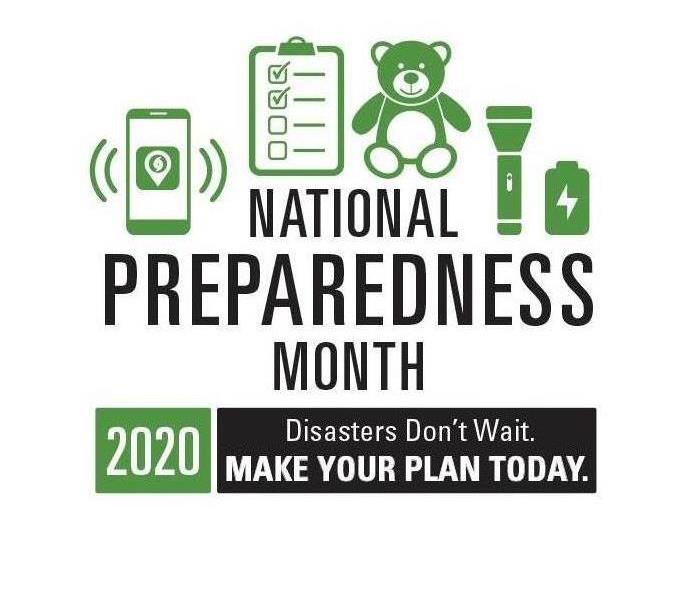 SERVPRO's Emergency Preparedness Plan can help you because, "Disasters Don't Wait. Make Your Plan Today."
SERVPRO's Emergency Preparedness Plan can help you because, "Disasters Don't Wait. Make Your Plan Today."
National Preparedness Month is recognized every September to promote community disaster planning, with the theme for 2020 being “Disasters Don’t Wait. Make Your Plan Today.”
With August behind us, we are still seeing an extremely active fire season we are also faced with extra preparations and precautions due to COVID-19... preparing yourself, your loved ones, and your property for a disaster situation is of the utmost importance. Ready.gov offers weekly National Preparedness Month themes to help organize your preparations:
Week 1 (September 1st-5th): Make a Plan
Determine lines of communication, designated meeting places in case of separation, and responsibilities for each member of your household. Depending on the needs of your family, you may require additional planning steps.
Week 2 (September 6th-12th): Build a Kit
Gather supplies for each member of your family. You kit may include food, clean water, medications, pet foods, communication devices, and batteries. Keep your kit as compact as possible, and in an easily accessible location, in case evacuation becomes necessary.
Week 3 (September 13th-19th): Prepare for Disaster
In the Panhandle of Florida, one of the most common disasters you may face is a hurricane. To prepare for such an event, be sure to follow local and national news as it pertains to hurricane tracking, check your insurance coverage, and make sure your disaster preparedness kit is built. If a storm is forecasted to hit in your area, follow the direction of local officials concerning shelter and evacuation orders.
Week 4 (September 20th-26th): Teach Youth About Preparedness
Make sure children’s needs are included in your preparations. Include their items in your disaster kit, talk with them about protocols and procedures in the event of a disaster situation, and answer any questions they may have.
As a leader in clean up and restoration, SERVPRO of West Riverside is Here to Help in the event your property is damaged by a fire, or sustains damage as a result of an earthquake or any other disaster situation. Serving the inland empire, our team is “Faster to Any Size Disaster!” To learn more about our services, call 951-351-8033.
For more information about National Preparedness Month, visit
https://www.ready.gov/september
Rain Rain Go Away, Beware of Flooding in Riverside!
8/31/2020 (Permalink)
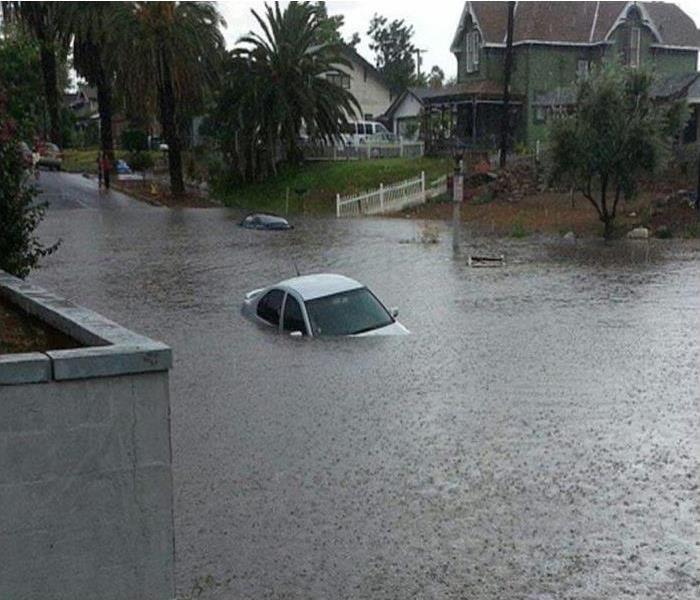 Two feet of rushing water can sweep away most vehicles — including SUVs and pick-ups.
Two feet of rushing water can sweep away most vehicles — including SUVs and pick-ups.
It is important to remember that floods caused by rain can occur anywhere, with floodwaters rising gradually or flash floods striking suddenly. Water's powerful force can easily overtake vehicles and people.
Safety tips for driving in heavy rain:
- If you must drive in the rain, drive slowly and steadily. Pull over and stop if it is raining so hard that you cannot see.
- DO NOT DRIVE THROUGH FLOODWATERS!
- Six inches of water will reach the bottom of most passenger cars, causing loss of control or possible stalling.
- One foot of water will float most vehicles.
- Two feet of rushing water can sweep away most vehicles — including SUVs and pick-ups.
- Stay away from water that electrical or power lines have fallen into; electric current passes through water easily.
- Stay off your cell phone unless you must report severe injuries or call for help.
Safety tips for walking or cycling on urban trails:
- Move to higher ground and never go into a culvert! If you are on a streamside trail during a rainstorm use the alternate trail up to street level to avoid underpasses and culverts.
- NEVER take shelter in a culvert, under a bridge, or in an enclosed space, especially in low elevations . Always go to higher ground out of the flow of water.
- Do not walk or bike through moving water. Six inches of moving water can cause a person to fall.
- If lightning is present, do not stand under or near an isolated tree or group of trees.
- Never allow children to play around drainage ditches or viaducts, storm drains or flooded areas.
Localized street flooding:
- In underpasses and some areas that are geographical low-points, water cannot be expected to disappear down the storm inlets instantly; the pace and volume of the rainfall may be too quick and too great to immediately drain off. It takes time for the system to accommodate the rainfall.
- If you know that your street tends to flood because it is located in a low point, be sure to move your vehicles to higher ground whenever rain is forecast.
Hazards in Your Riverside Home After Flooding
When water enters your home from a structural breach or through natural flooding scenarios, it can be a hazardous situation for your riverside residence. Knowing these risks and what to do about them can be enough to protect those that matter most and help to protect some of your belongings and possessions in the earliest stages of flood losses as well.
Many of the hazards that can exist after flood damage in Riverside homes are universal to any disaster, whether natural flooding or roof/property damage is to blame for the intruding water. Our SERVPRO professionals are often not the first individuals in a damaged home after a flood loss situation, so understanding these hazards before entering the property can keep you safe until our qualified technicians arrive to begin mitigation work.
One of the most pressing concerns for those inspecting the damage to their house is oversaturated materials like ceiling assemblies. Sagging materials are often a strong indication of overweight drywall and insulation that can collapse and injure those underneath it. Wall systems are also at risk for becoming oversaturated beyond the capabilities of drywall screws in studs. These are the areas where our team can perform controlled demolition to help with the drying process and protect other materials nearby.
When standing water reaches outlets near the floor of your home, or electrically charged equipment still powered on, it can cause the pooling water in the area to become electrified. Unless you can be confident that no hazard exists, such as the power getting severed to the structure, do not enter standing water.
Natural flooding presents a real risk of contamination to materials, contents, and occupants. We have disinfection products and cleaning practices that remove these bacterial threats from structural framework remaining installed before full-scale build back begins.
We understand the urgency that you feel when your home gets flooded, but keeping yourself and your family safe should be your priority. Our SERVPRO of West Riverside City team is standing by whenever you need us to help.
Be Prepared for a Commercial Loss in Your Riverside Workplace
8/26/2020 (Permalink)
If you have water or fire damage in your property right now, call us at 951-351-8033 RIGHT NOW. Don’t wait to mitigate - the longer damage sits unattended, the more likely it will develop secondary damage.
If you or someone you know works in a large commercial building, you may benefit from preparing a workplace emergency preparedness kit! SERVPRO of West Riverside City is passionate about preparedness, and as we operate out of a large commercial space, we know how beneficial a kit could be in the event of an emergency.
As you’re building a kit, whether it’s generally applicable and stored in a shared office space, or specific to you and kept at your desk - it’s important to choose the right storage material and to keep your kit updated. Using airtight, water-proof bags and containers to store a kit could keep your supplies in working condition. Additionally, consider transportable containers, such as a backpack.
Whether general or specific, consider the following items to include in your kit:
A large flashlight and extra batteries.A first aid kit.Surgical masks or dust masks.Water purification tablets.Prepackaged foods. Emergency survival food ration bars are ideal for storage and consumption.Mylar emergency blankets.Bottled water - plan for one gallon of water per person per day for at least three days, for both drinking and sanitation.An emergency whistle attached to a lanyard.Maps of your local area.Duct tape.Work gloves.Hand warmers.Hand sanitizer and moist towelettes.Plastic garbage bags.Non-prescription medications such as pain relievers.Contact lens solution.Matches.It’s important to pack supplies for three to seven days. If your commercial workplace ever experiences a large loss, or a disaster, while you are at work, know that making a kit like this could help keep you and your coworkers safe.
If your property experiences a Large Loss in the future, you can always count on SERVPRO of West Riverside City to assist in restoring your property. We roll in after disaster ready to dry, clean, and restore – but there is always a few things that need to be handled before we can start our work. This would include emergency response from your utility companies or plumber, or even emergency services from the Fire Department.
Being time sensitive after a Large Loss is crucial. Even if we can’t start restoration work immediately, make sure to call SERVPRO as soon as possible. Doing this will ensure that our project manager is able to communicate with you throughout the process of the emergency response, and is prepared to respond to your property for mitigation and restoration as soon as we are able. Don’t wait to call – if you know your property needs mitigation or restoration work.
Safety comes first, but when it’s time to restore - call SERVPRO of West Riverside City at 951-351-8033.
National Senior Citizen Day August 21st!
8/18/2020 (Permalink)
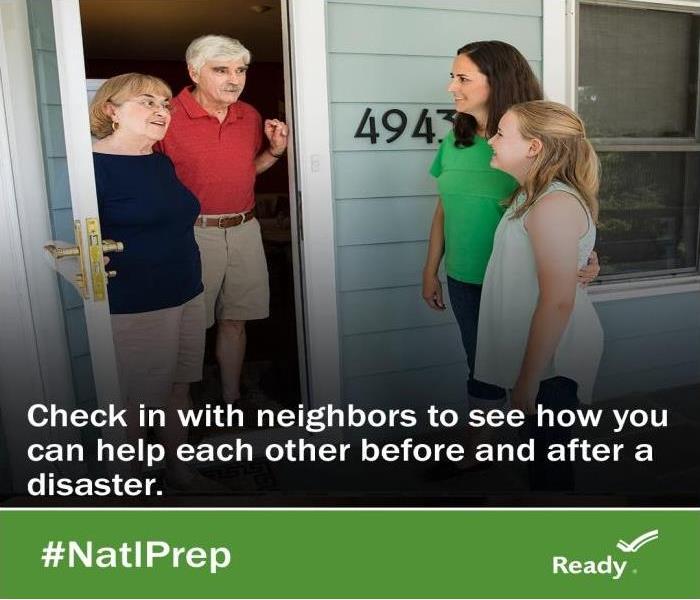 Spend time with the senior citizens you know. Let them know they are appreciated and loved.
Spend time with the senior citizens you know. Let them know they are appreciated and loved.
On August 21st, National Senior Citizens Day recognizes the achievements of the more mature representatives of our nation.
The day provides an opportunity to show our appreciation for their dedication, accomplishments, and services they give throughout their lives.
One way to show we care about our seniors is to ensure they are prepared for an emergency resulting from a storm or natural disaster. Here are 3 ways READY.GOV recommends for our seniors:
- Get a kit.
The first step is to consider how an emergency might affect their individual needs. A plan to make it on their own, for at least three days. It’s possible that they will not have access to a medical facility or even a drugstore. It is crucial that they and their family think about what kinds of resources they use on a daily basis and what they might do if those resources are limited or not available.
Basic Supplies: Think first about the basics for survival – food, water, clean air and any life sustaining items they require. Consider two kits. In one kit put everything they will need to stay where t hey are and make it on their own for a period of time. The other kit should be a lightweight, smaller version they can take with them if they have to leave their home.
Recommended basic emergency supplies include:
- Water, one gallon of water per person per day for at least three days, for drinking and sanitation
- Food, at least a three-day supply of non-perishable food and a can opener if kit contains canned food
- Battery-powered or hand crank radio and a NOAA Weather Radio with tone alert and extra batteries for both
- Flashlight and extra batteries w First aid kit
- Whistle to signal for help
- Dust mask to help filter contaminated air and plastic sheeting and duct tape to shelter-in-place
- Moist towelettes, garbage bags and plastic ties for personal sanitation
- Wrench or pliers to turn off utilities
- Local maps
- Pet food, extra water and supplies for your pet or service animal
- Make a Plan for What they Will Do in an Emergency
For every aspect of their daily routine, plan an alternative procedure. Make a plan and write it down. Keep a copy of their plan in their emergency supply kits and a list of important information and contacts in their wallet. Share their plan with family, friends, care providers and others in their personal support network.
- Create a Personal Support Network
- Develop a Family Communications Plan
- Deciding to Stay or Go
- Consider Your Pets
- Staying Put
- Evacuation
- Fire Safety
- Contact Your Local Emergency Information Management Office
- Be Informed Some of the Things They Can Do
To prepare for the unexpected, such as assembling an emergency supply kit and making an emergency plan are the same regardless of the type of emergency. However, it’s important to stay informed about what might happen and know what types of emergencies are likely to affect their region. For more information about specific types of emergencies, visit www.ready.gov or call 1-800-BE-READY. Be prepared to adapt this information to their personal circumstances and make every effort to follow instructions received from authorities on the scene. With these simple preparations, they can be ready for the unexpected. Prepare For Emergencies Now. Information For Older Americans. www.ready.gov
Their wealth of knowledge, skill, and experience offer so much. They deserve the respect and dignity their achievements earn them. Supporting our senior citizen to live their lives to the fullest and as independently as possible.
HOW TO OBSERVE #SeniorCitizensDay
- Spend time with the senior citizens you know. Let them know they are appreciated and loved.
- Volunteer at a retirement home. Share your smile with those who may not otherwise get a visitor today.
- If you are a senior citizen, check for special discounts and promotions that may be offered at stores and restaurants in your area.
#SeniorCitizensDay
Part II-National Non Profit Day August 17th: Project Boon
8/17/2020 (Permalink)
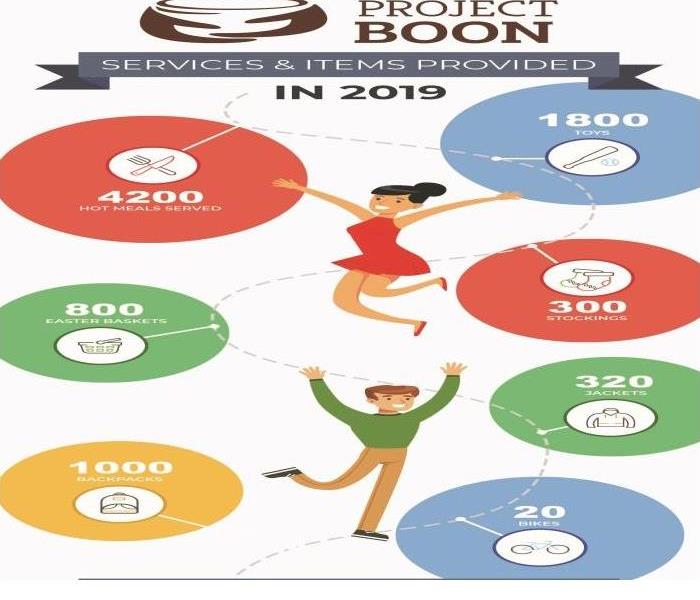 Project Boon operates events that bring together those in need, those willing to help, and the resources that make a difference.
Project Boon operates events that bring together those in need, those willing to help, and the resources that make a difference.
Project Boon amplifies the power of community through events that bring together committed individuals, organizations, and the underserved.
Their name, boon, means the general good created by meaningful, accessible action. It comes out of a simple idea: that we’re all connected, and we all have the ability to help one another.
About Project Boon
Project Boon, a 501(c)(3) nonprofit organization, is based in Rancho Cucamonga, California. As found on their website, They act as the organizing force behind a host of events every year, and while assisting the underserved is one of their primary achievements, they are also proud to:
- Show people the power they have to change the lives of others and how to use this knowledge.
- Offer a meaningful experience to the beneficiaries, participants, donors, and sponsors of events and create a lasting sense of community following these events.
- Engage professionals, executives, and companies, demonstrating the human impact of their business contributions.
Why Project Boon?
Project Boon operates events that bring together those in need, those willing to help, and the resources that make a difference.
When we were children, the neighborhood pulled together when a family down the street faced tough times. Our community made an immediate impact, and we knew the human connection.
Now, our mission is to help people connect with and rediscover the community to which we all belong—next door or a world away—by supporting our neighbors in need.
Board Member Matt Frechette
I wanted to highlight Matt Frechette who is one of the board members of Project Boon. He is one of the many members who help support and run the initiative of Project Boon. Matthew Frechette is the Executive Vice President & co-founder of MyTPG and the founder of Be Intentional Inc. He loves to help protect and grow small businesses and individuals who want to live a life of abundance. He does this by having fun, making a difference, and being intentional. He helps protect businesses from the state, the IRS, and themselves and helps promote individuals. Matthew believes culture is very important in the workplace, community, and home. He has supported multiple charities and been a part of many charity boards. He sees Project Boon as an organization of leaders intentionally having fun and making a difference.
Back Pack Event & Grocery Distribution
Project Boon recently hosted a Back Pack Event and Grocery Distribution in July.
They teamed up with The Hitch Burger Grill, Hillside Community Church, Firm Media, and OmniTrans to host a drive-thru back-to-school backpack event and grocery distribution for underserved families in Rancho Cucamonga and the surrounding areas. The event was held at The Hitch Burger Grill, in Rancho Cucamonga on July 26. Each family had the opportunity to receive fresh groceries, and school children were provided with backpacks filled with school supplies.
The event was on a first-come, first-serve, and they asked that attendees not line up early. Each family could receive one bag of groceries, and each child was given one filled backpack, with a maximum of two per car.
Project Boon received support for the effort by accepting donations of school supplies that could be dropped off at specific locations. Some of the items donated included:
- Backpacks for young boys and girls and older teens
- Pencils, pens, markers
- Pencil boxes
- Paper & notebooks
- Rulers
- Glue
- Binders & folders
One Business, Propel Chiropractic was able to contribute 90 filled backpacks to families in need!
Project Boon was able to accomplish this successful event with the help of many supporters. Because of the generosity of the community, they distributed backpacks to 600+ students and provided groceries to 300+ families. Cars lined up for miles, and they were able to serve everyone who joined. Check out their social media post within Facebook.
please visit the Project Boon website at www.projectboon.org for more information on how to donate or get involved in future events.
SERVPRO of West Riverside City encourages all to look to support a non-profit organization. We highlighted two with Clear the Shelters and Project Boon, but there are many nonprofit organizations. Through nonprofits, awareness, research, and aid reach the people who need it most. Nonprofits also produce tremendous benefits to their surrounding communities and the broader world. Take some time to learn more about nonprofits. Understanding that the funding for these organizations often satisfies more than the mission statement will help us see the benefits of supporting nonprofit organizations.
Top 5 things Riverside Residents Need to Have on Hand to Prepare for a Storm
8/13/2020 (Permalink)
Living in Riverside we get the occasional storm that will knock out power for a period of time, especially during high winds.
These 5 thing will come in handy in a time of a storm that cause power loss.
- Canned goods and a manual can opener
Now everyone knows in a natural disaster that canned fruits, vegetables and even things like canned beans are a great food supply. They will last a long time and offer you the nutrients you need.
However, opening a can without a can opener can be difficult and sometimes not possible. Make sure to add a can opener to your set so in a time of disaster you have access to canned goods.
Here are some additional items to have :
- Crackers
- Trail mix and other nuts (for those without allergies)
- Protein/Breakfast Bars
- Canned tuna, salmon, etc.
- Canned Soup
- Dried Fruit
- Ensure/ Non-refrigerated individual cartons of organic milk
- Batteries (big and small)
One of the most important things you’re going to need in the event of a storm is power and if you don’t have a generator, you’re going to be relying on batteries to get you through the day.
Not only are they going to be powering the flashlights you’re using to see at night, but they’re going to be powering other things as well that you’ll have to remember. For example, don’t forget to stock up on your hearing aid batteries if that’s one of the things you use.
The most important thing, and everybody pretty much knows this, is you want to have drinking water on hand but what everybody doesn’t really know is how much do you need?
The American Red Cross recommends that you have one gallon, per person, per day in the event of a natural disaster. So that means a family of four, over five days is going to need 20 gallons of water.
Your water could be out longer than 3 days, or fresh water could become You can also buy water purification tablets or a filtering system at a camping store or online.
When the power is out, credit cards and ATMs are a no-go so cash is a must have. Always keep a handy amount ready to go in case the storm fallout lasts longer than you anticipated and you need to get more supplies or fill up your gas tank.
If your home or business ends up sustaining damage from inclement weather, call SERVPRO of West Riverside City as soon as possible - we can help you get your property restored to preloss condition. Don’t wait to mitigate - call us as soon as you see storm damage on your property: 951-351-8033.
Part I Non Profit National Day- Clear the Shelters
8/12/2020 (Permalink)
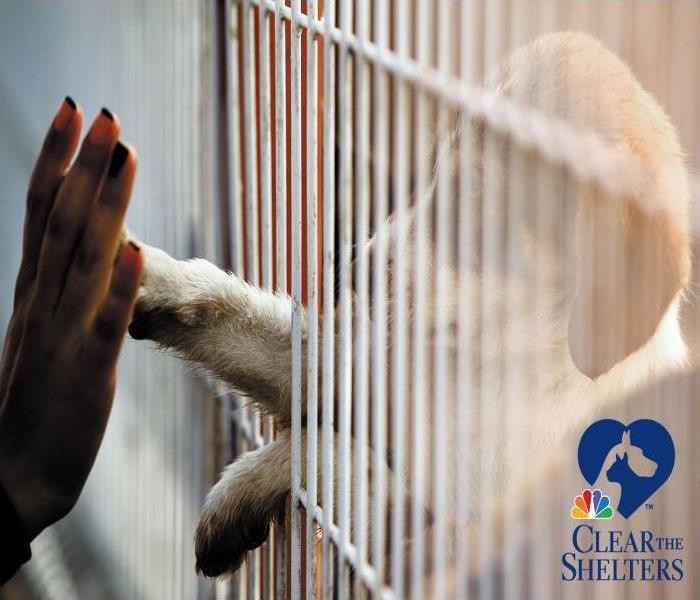 Visit the links within the article to locate a shelter dog that might fit your family! Let's Clear the Shelters Riverside!
Visit the links within the article to locate a shelter dog that might fit your family! Let's Clear the Shelters Riverside!
We observe Aug. 17 as National Nonprofit Day to acknowledge the positive impact that nonprofit organizations have on our local communities and around the world.
NonProfitPro gives 5 ways you can do this, here are two ways:
- Give Voice to Your Cause: Use the hashtag #nationalnonprofitday on your social media channels to be seen and create awareness for your organization among those who may not know about your cause, its goals and why it’s important to get involved.
- Thank Your Volunteers: To commemorate this special day of recognition, thank your volunteers for their support and call those who are regularly active and advocating on their behalf.
SERVPRO of West Riverside would like to highlight two non-profit organizations that Riverside Residents can participate within our own community. We will cover Part 1 today and Part 2 on August 17th
Part I -Animal Rescues
SERVPRO of West Riverside city is a huge supporter of dogs. Especially those in need of loving homes. Our shelters here in Riverside are full and many families are looking for fur babies and don't realize shelters are a great place to find that special pup. During current conditions with COVID-19, dogs can provide companionship and help relieve stress and anxiety.
Clear the Shelters
NBC4 and Telemundo 52 announced the return of their successful Clear The Shelters™ pet adoption drive from August 1-31, 2020. The virtual campaign will raise awareness about the importance of pet adoptions while practicing safe social distancing measures and feature online platforms to make it easy for people to adopt during the COVID-19 pandemic.
About Clear the Shelters
NBC and Telemundo owned stations are teaming up with hundreds of shelters across the country to host Clear the Shelters, a nationwide pet adoption drive in August 2020 that helps find loving homes for animals in need. More than 411,000 pets have found their forever homes since 2015.
You can check out local Riverside Shelters by clicking on this link:
Clear the Shelters
How to help Riverside County Animal Services
Riverside County Animal Services is joining forces again with NBC and Telemundo for the annual Clear the Shelters campaign. The Information is from their website:
Riverside County will be offering pets at a $20 adoption fee during the month of August at its two participating shelters in Jurupa Valley and Thousand Palms.
Due to the coronavirus pandemic, adoptions are still being handled by appointment only and pet meet-and-greet opportunities will be handled virtually when possible. The number to call for appointments is 951-358-7387. Visit www.rcdas.org, look through the available pets, make a note of the animal ID number, and give us a call at 951-358-7387 to schedule an adoption appointment.
This year’s Clear the Shelters for Riverside County Animal Services will not include a one-day mega event with hundreds of adopters, also due to COVID-19 and social distancing guidance from federal, state and local officials.
“It will be a much different Clear the Shelters for us and many others,” Animal Services Director Julie Bank said. “However, we appreciate NBC and Telemundo and the corporate sponsors for continuing in this mission to saving shelter pets.”
In the five years since Riverside County Animal Services has participated, thousands of pets were saved from its shelters and found homes with loving families. More than 410,000 pets found homes during the international campaign’s history.
“We’re living in a different world right now,” Bank said. “It’s a stressful time. We know, of course, animals provide us with great comfort. We believe the human-animal bonds are growing that much stronger during all the lockdowns and work-from-home periods."
For those that are unable to adopt, or already have a full house of pets, there is still a way to participate. NBC and Telemundo are teaming with GreaterGood.org, which has a website established to allow anyone to donate to shelters and rescue groups.
Locals can donate directly through Riverside County Animal Services’ website; here’s a link:
https://licensepet.com/wl3/don/rvsdwd/468
Mary S Roberts Pet Adoption
Cards for a Cause
When you purchase a box of cards through our Cards for a Cause fundraiser, you not only spread joy by letting friends and family know you are thinking of them with hand-written cards, but you are also helping the Mary S. Roberts Pet Adoption Center with our mission and allowing us to help many more homeless dogs and cats in our community.Each box of 30 greeting cards costs $31.50 (including tax). Holiday Card box includes 50 cards for $31.50.
- $13 from the cost of each box will directly benefit the Mary S. Roberts Pet Adoption Center.
- A purchase of one box of cards will cover the cost of microchipping two pets, helping them return home.
- A purchase of two boxes of cards covers the cost of rabies and other deadly disease prevention for one pet.
- And, a purchase of three boxes will spay or neuter one pet, helping to reduce pet overpopulation.
- Watch this video to see the cards in each box: https://youtu.be/yBRJi1bhnu8.
- Click here to see the Holiday Card box, which includes 50 cards for the same $31.50 price: https://youtu.be/MREG2XcfBBE.
- The fundraiser will close on August 15 at 11:59pm (PST).
- Free pick-up of your greeting cards will be available at Mary S. Roberts Pet Adoption Center upon arrival of our bulk order by approximately September 1.
- Alternately, priority mail shipping may be added to your card order for $12 per box. Cards will ship from the Mary S. Roberts Pet Adoption Center approximately 2 weeks after fundraiser closes, and tracking numbers will be provided at that time.
Don't have a need for cards right now? You may choose to make a donation below instead.
Make a Donation
Dates Cards are Available-
Cards are not being offered at this time, but check her website for other ways to donate.
- From Monday, 03 August 2020 12:00 AM to Saturday, 15 August 2020 12:03 AM
How SERVPRO Riverside City Removes Water from Different Types of Flooring
8/10/2020 (Permalink)
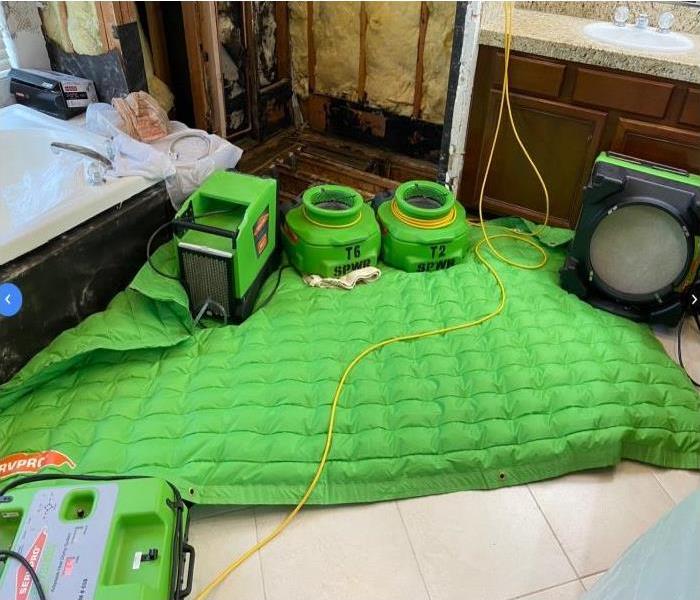 We dried the floor with the boost target drying system and dying mats. It provides controlled, targeted heat to the surface. We saved the floors!
We dried the floor with the boost target drying system and dying mats. It provides controlled, targeted heat to the surface. We saved the floors!
SERVPRO has the Knowledge for Flooring Restoration After Riverside Water Loss Events
Your home has many different flooring types, and our SERVPRO professionals have different tools and equipment that can help to restore these after water losses. Many materials compose the construction of your home's flooring, walls, and ceiling systems. Different strategies are necessary to remove water and moisture from these structural elements because so many materials make up your home. Our team of professionals has extensive training and experience to provide the ideal approach for whatever wet surface we encounter.
Recognizing what tools are best for actions like water removal in your homes gets determined during the initial evaluation and damage assessment. Scoping the job is a process where our project manager and crew chief work with the customer to identify preloss conditions and pre-existing conditions so that we can return the property to its original state as efficiently and cost-effectively as possible.
Can You Remove Water from Carpeting?
In areas like your living room and bedrooms, carpeting is one of the typical flooring types encountered in area homes. When migrating water reaches the fibers of carpeted floors, this moisture can get quickly absorbed. It is critical to remove water from carpeting as soon as possible so that moisture does not penetrate the padding and, eventually, the subflooring material. When reconstruction is necessary, the cost of recovery amplifies. Some of the water removal tools and practices for carpeted floors include:
Carpet Wands – Wands are fierce attachments for wet vacuums and extractors that can pull water from the surface layer and the padding of carpeted floors. These tools are wise choices when the padding is getting replaced. Weighted Extractors – Stand on and ride on extraction tools can force the surface layer of carpeting and the padding together against the subflooring. This action forces moisture to the surface for an onboard vacuum to remove. Floating Practices – By placing a centrifugal air mover between the top and padding layers of carpeted floors, we can dry both of these materials simultaneously in a floating process. This style is risky as it could cause de-lamination from the primary and secondary backing of the carpet. Is Wood Flooring Salvageable After Water Damage?
The composition of wood surfaces, especially flooring, makes it a sensitive material to standing surface water. Absorption can happen quickly, which can be disastrous if the water does not get removed quickly. Within as little as 48 hours, saturation can reach the point where it begins to warp and distort wood planks, leaving no option but removal and replacement. Some of the approaches for drying wood floors include:
Air moversDrying Mat SystemTenting Does Standing Water Damage Tile?
Many homeowners believe that tile flooring is impenetrable, even to standing water. While it is far more difficult for water to breach even the grout joints between floor tile, a small opening or breach in this water-tight seal can allow penetration to the mortar bed and subflooring material. The water beneath tiling can be destructive and hard to detect initially. Our SERVPRO team can address potential concerns with a simple three-step formula for removing water:
Extraction – We cannot determine the damage that standing water has done in areas like the kitchen or bathroom until we have removed it. There are multiple extractors, but often wet vacuums and electric submersible pumps are the common implements. Surface Moisture Meter – With pooling water addressed, our technicians can work to determine the damage to tile flooring and other exposed materials. Finding moisture pockets often falls to a surface moisture meter device or probing tool to identify if damp areas exist beneath the top layer. Drying Mats – If pockets of moisture get detected with thermal imagery and surface meters, we can lay drying mats to slowly draw moisture from the mortar bed and subflooring materials to preserve and protect these areas. While you might not be able to avoid water loss incidents, you can choose the team that oversees your property's restoration and recovery. No matter what materials become affected by water exposure, our SERVPRO of West Riverside City team can help.
Contact us today at (951) 351-8033.
Visit our website for Water Damage information.
How is SERVPRO of Riverside assisting in the fight against COVID-19?
8/5/2020 (Permalink)
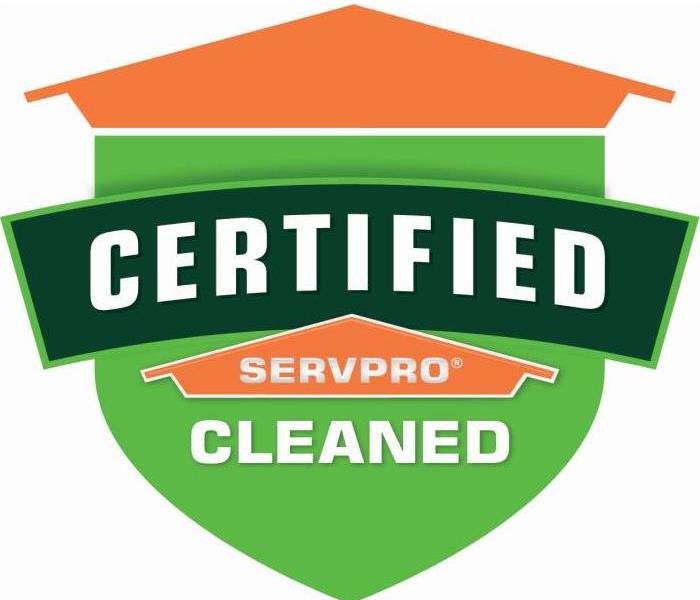 When you see the Certified: SERVPRO Cleaned shield, you can walk in with confidence.
When you see the Certified: SERVPRO Cleaned shield, you can walk in with confidence.
COVID-19. It is on everyone's mind daily and the height of most people's concerns.
How is SERVPRO assisting in the fight against this virus? SERVPRO of Riverside is providing proactive cleaning services to customers that want to take measures to protect themselves, their families, and their employees in this fight against Coronavirus. This is not the first time that SERVPRO has taken to the front lines in a pandemic. We have encountered everything from the common cold to the swine flu, and now Coronavirus. Our highly trained professionals have been fighting pandemics for years and adhere to all CDC Guidelines when doing it. We are a firm believer in helping the members of our community stay healthy and ahead of the curve when it comes to health hazards.
Proactive cleaning takes many forms, all of which should be performed by a trained professional. We have many cleaning products including sterilizing and disinfecting solutions that we use to combat airborne and direct contact diseases. Some are fogged into buildings and others are sprayed directing onto surfaces and wiped off. Dwell time is the duration a product is allowed to sit on a surface in order to perform its function. We always allow for proper dwell time and cleanup of all solutions in order to provide maximum effectiveness in sterilization and disinfecting of buildings.
The CDC recommends usage of a labeled hospital-grade disinfectant with claims against similar pathogens to the coronavirus. Multiple products in the SERVPRO product line carry the EPA-approved emerging pathogens claims. While there is currently no product tested against this particular strain of the coronavirus, we are following all guidelines as provided by the CDC and local authorities. So how does it work? It’s grounded in our unique 3 C’s:
- Consult: Not all businesses are the same, so we’ll tailor a bespoke cleaning program based on the unique needs of each facility.
- Clean: Based on the agreed plan, an expert deep clean is initiated using our proprietary EPA-Approved Hospital-Grade cleaning solutions and always adhering to the leading level of cleaning and decontamination standards set by the CDC.
- Certify: You’ll know a business is Certified: SERVPRO Cleaned by the shield posted on their front window. Along with digital emblems and other collateral, this beacon represents their commitment to the comfort and security of their employees, customers and community.
So when you see the Certified: SERVPRO Cleaned shield, you can walk in with confidence. Because you’ll know the #1 choice in cleanup and restoration was there.
If you or anyone you know is interested in proactive cleaning for their home or business, please contact us and we will be happy to assess your needs and provide you with some peace of mind during these trying times.
Are you interested in our Commercial Services, or are you a consumer who wants to learn more?
Riverside Schools…Back to School or Virtual Classes, Protecting Our Kids and Students against COVID-19
8/3/2020 (Permalink)
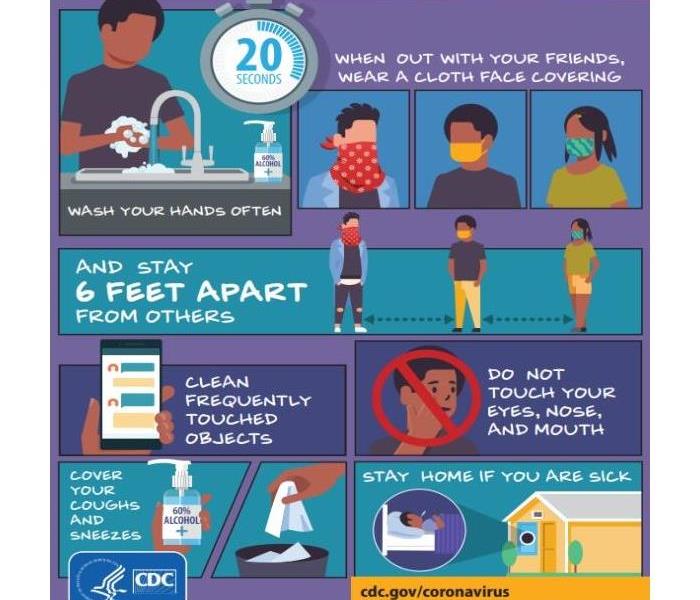 Young ones can practice these steps to avoid the spread of COVID-19. Call SERVPRO for a free estimate on our Certified: SERVPRO Cleaned.
Young ones can practice these steps to avoid the spread of COVID-19. Call SERVPRO for a free estimate on our Certified: SERVPRO Cleaned.
August is back to school month for Riverside Students. However, due to COVID-19, there is still uncertainty when students will actually return to normal school classrooms.
A note from Riverside Unified School District states, "As we prepare to welcome you back to the 2020-21 school year, we are diligently working on every aspect of the RUSD school experience from health and safety to the program choices for students and staff. This is a very challenging time as community health circumstances are changing daily".
For now, it looks like classes will continue virtually at home. But, what can parents do to plan and prepare for closed schools? Why the concern of sending them back to classroom environment? How can we keep our homes safe and sanitized for our kids?
Parents can help protect their family from COVID-19 by practicing and promoting everyday healthy habits. The CDC provides guidance. Use this checklist to plan and take action.
PLAN AND PREPARE
Practice and reinforce good prevention habits with your family
- Avoid close contact with people who are sick.
- Cover your cough or sneeze with a tissue, then throw the tissue in the trash.
- Wash hands often with soap and water for at least 20 seconds, especially after going to the bathroom; before eating; and after blowing your nose, coughing, or sneezing. If soap and water are not readily available, use a hand sanitizer that contains at least 60% alcohol.
Keep your child at home if sick with any illness
If your child is sick, keep them at home and contact your healthcare provider. Talk with teachers about classroom assignments and activities they can do from home to keep up with their schoolwork.
Be prepared if your child’s school or child care facility is temporarily dismissed
Talk with your employer about sick leave and telework options in case you need to stay home with your child. Consider planning for alternate child care arrangements.
IF YOUR SCHOOL/CHILD CARE PROGRAM IS DISMISSED
Keep track of school dismissal updates
Read or watch local media sources that report school dismissals or stay in touch with your school.
- Talk to your school about options for digital and distance learning
- Discourage children and teens from gathering in other public places while school is dismissed to help slow the spread of COVID-19 in the community
- Seek guidance from your school administrator to determine when students and staff should return to schools
Duration of school dismissals will be made on a case-by-case basis based on the most up-to-date information about COVID-19 and the specific situation in your community. Students and staff should be prepared for durations that could last several days. Administrators should work with their local health authorities to determine duration of dismissals.
THE CONCERN OF SENDING KIDS BACK TO SCHOOL
The more people a student or staff member interacts with, and the longer that interaction, the higher the risk of COVID-19 spread. The risk of COVID-19 spread increases in school settings as follows:
- Lowest Risk: Students and teachers engage in virtual-only classes, activities, and events.
- More Risk: Small, in-person classes, activities, and events. Groups of students stay together and with the same teacher throughout/across school days and groups do not mix. Students remain at least 6 feet apart and do not share objects (e.g., hybrid virtual and in-person class structures, or staggered/rotated scheduling to accommodate smaller class sizes).
- Highest Risk: Full sized, in-person classes, activities, and events. Students are not spaced apart, share classroom materials or supplies, and mix between classes and activities.
COVID-19 is mostly spread by respiratory droplets released when people talk, cough, or sneeze. It is thought that the virus may spread to hands from a contaminated surface and then to the nose or mouth, causing infection. Therefore, personal prevention practices (such as handwashing, staying home when sick) and environmental cleaning and disinfection are important principles that are covered in this document. Fortunately, there are a number of actions school administrators can take to help lower the risk of COVID-19 exposure and spread during school sessions and activities.
KEEPING A CLEAN AND SANITIZED ENVIRONMENT AT HOME
The CDC recommends the following for cleaning and sanitizing
This guidance is intended for anyone, whether you own a business, run a school, or want to ensure the cleanliness and safety of your home. Reopening America requires all of us to move forward together by practicing social distancing and other daily habits to reduce our risk of exposure to the virus that causes COVID-19.
- Normal routine cleaning with soap and water will decrease how much of the virus is on surfaces and objects, which reduces the risk of exposure.
- Disinfection using EPA-approved disinfectants against COVID-19 can also help reduce the risk. Frequent disinfection of surfaces and objects touched by multiple people is important.
- When EPA-approved disinfectants are not available, alternative disinfectants can be used (for example, 1/3 cup of bleach added to 1 gallon of water, or 70% alcohol solutions). Do not mix bleach or other cleaning and disinfection products together--this can cause fumes that may be very dangerous to breathe in. Keep all disinfectants out of the reach of children.
Some surfaces only need to be cleaned with soap and water. For example, surfaces and objects that are not frequently touched should be cleaned and do not require additional disinfection. Additionally, disinfectants should typically not be applied on items used by children, especially any items that children might put in their mouths. Many disinfectants are toxic when swallowed. In a household setting, cleaning toys and other items used by children with soap and water is usually sufficient. Find more information on cleaning and disinfection toys and other surfaces in the childcare program setting at CDC’s Guidance for Childcare Programs that Remain Open.
SERVPRO of West Riverside City is also a resource for cleaning and sanitizing your home, childcare facility or schools. We use EPA Hospital grade products that are safe for children. We can tailor the cleaning and disinfecting to your needs. Ask for our Certified: SERVPRO Cleaned service.
We are here to help. Call us for a free estimate: 951-351-8033
SERVPRO of West Riverside City Spotlights our Very Own Ellie on National Mutt Day!
7/29/2020 (Permalink)
 SERVPRO of West Riverside loves Ellie and her owner is happy she rescued a mix breed. She brought joy to their lives!
SERVPRO of West Riverside loves Ellie and her owner is happy she rescued a mix breed. She brought joy to their lives!
Unlike most of our doggy days, National Mutt Day, on July 31, focuses on the mixed breed dogs who sometimes get overlooked. This holiday inspires people to learn more about adopting one.
Dogs are special and there are many national holidays to prove it.
National Mutt Day also brings attention to the many great mixed breed dogs in need of homes. In fact, they benefit from the spotlight so much that we celebrate mixed breed dogs not just once, but twice a year! On both July 31 and December 2, join us in celebrating all the mutts and mixed breed dogs that make our lives so great.
In 2010 we rescued our Ellie from the IVHS in Pomona. It was December, the dog we went to pick up had been given to another person. My son, Josh, was devastated! Josh was in middle school, and I felt he was now old enough to help care for a dog. As he sobbed at the shelter for "Kelly" the 2yr old German Shepherd mix, he originally wanted, we attempted to console him. Staff members tried to find other dogs that he might like. One shelter employee thought maybe the puppies might do the trick. There was one puppy in a cage all by herself. A sign posted outside the cage read "aggressive", but how could a sweet little pup be aggressive?
We asked about this puppy, and asked if Josh could hold her. They opened the crate and handed over this precious, reddish and white speckled pup who looked like a little lion…. he instantly fell in love. She was listed as a Cattle dog mix. So I asked about the aggressive behavior noted on the cage. They said she was in a kennel with other puppies but she was biting them, so they separated her. I asked if she could be trained to address this behavior, their response was, "all dogs can be trained out of their bad behavior". This was enough to make me want her even more.
We took Ellie home in December after she was fixed, I was a little worried that she was too young, but they would not release her to us without this happening. We brought home this 10 week old puppy and named her Ellie. Here we were with an aggressive dog, who did not liked to be cuddled, she barked…a lot, and if you know cattle dogs, they are very high energy dogs that need a job to address that energy. Once all her shots were up to date, we enrolled her in obedience training at "It's a Dog's World" in Chino. They provided training in a park like setting, a more natural environment for a dog. They had us purchase a Gentle Leader Harness, which is an amazing way to leash your dog. After the course, we continued with socialization with other dogs and people.
As she matured, she grew into this beautiful unusual reddish color with white spots and speckles. She was no longer aggressive, and she allowed us to hug her, but only for a few minutes! We love her more than anything and we were so happy we spent the time and energy to get her to this amazing loyal creature.
If you are not sure about rescuing a dog especially not knowing the type of temperament they have, I hope this story motivates you. If you spend the time and work with them, I do believe you can train a dog out of any bad habits! You may need help from an obedience class, and it will be a lot of work, but nothing is better than the satisfaction of rescuing a dog in need of a loving home!
How to Observe National Mutt Day
- Adopt a mixed breed dog
There are lots of great dogs out there who lack a home just because they don't have the right pedigree. But you can do your part to change all that. Getting any dog is a big responsibility, but a mixed breed will likely be healthier, happier, better behaved — and live longer than a purebred of the same age.
- Donate to your local shelter
Not in the position to adopt a mutt? You can still help out your local shelter with a donation. Your money goes to things like food, toys and medicine. Every dollar counts, so you can really make a difference in the lives of all the dogs at the shelter.
- Volunteer to help out
If donations aren't your style, you can always volunteer. Shelters need volunteers to befriend the dogs, play with them and take them for walks. A few hours of your time can make a big difference in their happiness and happy dogs stand a better chance of getting adopted.
Visit your local shelter to see available adoptable dogs, or ones who need rescuing. Here are a few:
Riverside County of Animal Services
Pet Harbor
Mary S. Roberts Pet Adoption
Inland Valley Humane Society
Camping with Your Family this Summer? Here are Some Fire Pit Safety Tips
7/27/2020 (Permalink)
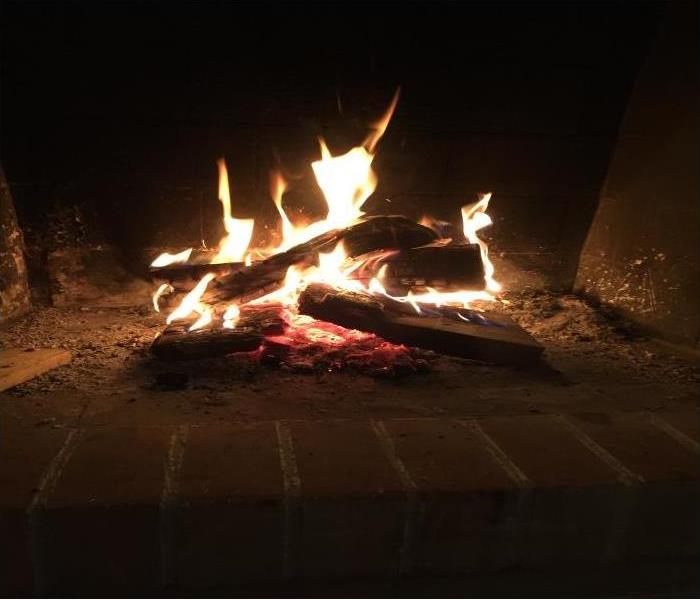 With the increasing popularity of fire pits, knowing how to use them safely has become even more important.
With the increasing popularity of fire pits, knowing how to use them safely has become even more important.
This time of year, Americans look forward to gathering around a fire pit or campfire with family, especially with travel restrictions currently in place.
But what can be an enjoyable evening can turn into a fire tragedy if you’re not careful. In this article, we address how to safely enjoy your fire pit or campfire.
With the increasing popularity of fire pits, knowing how to use them safely has become even more important. Follow this advice when setting up and using a fire pit.
- Keep flammable material and fluids, such as gasoline, diesel fuel, kerosene and charcoal lighter fluid, away from the fire pit while in use.
- Never use flammable fluids such as gasoline, alcohol, diesel fuel, kerosene and charcoal lighter fluid to light or relight fires.
- Exercise the same precautions you would with an open fire.
- Don’t wear loose fitting or flammable clothing such as nylon.
- Keep a three-foot safety zone around the fire pit. Do not allow children to use the fire pit. Keep children and pets away.
- Don’t burn trash, leaves, paper, cardboard or plywood. Avoid using soft wood such as pine or cedar that can pop and throw sparks. Seasoned hardwood is best.
- Don’t overload the fire pit. Before starting the fire, make sure that the lid will still close to extinguish the fire in an emergency.
- Check the wind direction before you light the fire.
- Keep a fire extinguisher, garden hose or bucket of water nearby.
Campfire Safety
Follow these tips to stay safe around your campfire.
- Don’t build a fire in hazardous, dry conditions or if the campground, area or event rules prohibit campfires.
- Use an existing fire ring if available.
- Choose a site that is at least fifteen feet away from tent walls, shrubs, trees or other flammable objects. The site should not have low-hanging branches overhead.
- Keep a three-foot safety zone around the campfire.
- Keep a bucket of water near your campfire.
When you’re ready to put out your fire, follow these guidelines:
- Allow the wood to burn completely to ash, if possible.
- Pour lots of water on the fire; drown all embers, not just the red ones. Pour until hissing sounds stop.
- Stir the campfire ashes and embers with a shovel. Make sure everything is wet and cold to the touch.
- Scrape the sticks and logs to remove any embers.
- If you do not have water, use dirt. Mix dirt or sand with the embers and stir until all material is cool. Do not simply bury the fire, as the fire can smolder and catch roots on fire that will eventually get to the surface and start a wildfire.
If you’ve suffered fire damage to your home or business, call SERVPRO of West Riverside City today at 951.351.8033
We’re Here for You
The team at SERVPRO of West Riverside City has specialized training and experience in fire restoration services, natural disaster and storm damage cleanup, water damage remediation and chemical cleanup. Call SERVPRO of West Riverside City (951.351.8033) any time.
How Riverside Businesses Can be Proactive and Not Reactive in the Event of a Disaster
7/22/2020 (Permalink)
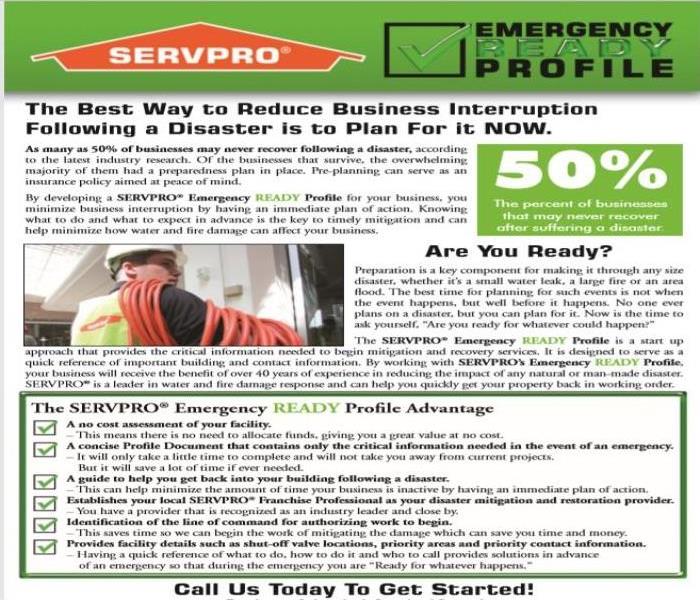 Emergency Ready Plan is a no cost assessment of your property, great value at no cost! Call us 951-351-8033
Emergency Ready Plan is a no cost assessment of your property, great value at no cost! Call us 951-351-8033
For a business owner, a worst-case disaster scenario involving fire or water damage can seem unthinkable until it suddenly becomes reality.
In the aftermath of a disaster, a quick response time by a disaster recovery company such as SERVPRO of West Riverside City, can help minimize property damage.
Owners need to have a quick and convenient emergency disaster plan that connects them with vendors, necessary contacts, and pertinent information when disaster strikes. The SERVPRO Emergency Ready Plan (ERP) is a respected industry tool during a disaster event. An ERP is so valuable , that in the midst of the confusion and panic that often surround a disaster, an owner or manager can be provided a sense of calm and clarity in reaching out for expert help.
Our June edition of Restoration Newsline helps us with 4 key areas to remember when building an emergency plan.
1. Identify your facility's greatest threats in order to assess the overall severity of the event.
During the discovery mode, what are your greatest threats (i.e. fires, tornadoes, floods, etc.)? Look at your locations. Do you have any that would be in a "tornado alley," at risk for hurricane damage, or subject to deep freezing temperatures? Try to think outside the box, without becoming a doomsday prepper!
2. Document all vital information and establish clear communication activities.
An ERP needs to contain critical property information that can help speed up response time after a disaster occurs. Consider including any documented prior loss history, and identify and label utility shut off locations, and prioritize your key contacts. Prior loss history can provide first responders and restoration vendors with historical information on your facility's condition. Proper utility identification will allow for quicker response times for emergency shut off, requests and key contact information is vital to starting the recovery process, allowing you to quickly contact key personnel and answer priority questions.
3. Practice! Practice! Practice! There is no "textbook" event, so expect the unexpected.
You should conduct practice sessions to make sure everyone is clear on the process. Always have clear evacuation routes in your ERP, and set a distribution chain for your key contacts and various locations.
4. Keep it updated, and have all necessary information communicated with your insurance company and emergency restoration vendors.
The best way for the recovery to begin is remaining proactive by always keeping your ERP updated. Your SERVPRO representative can help you keep your ERP up-to-date. People will come and go, updates will be made to the facility, and utilities can change. This should be a dynamic document that changes as your business does. If you don't keep it updated, you'll be several steps behind when disaster strikes.
Are you interested in a free demonstration of how the Emergency Response Plan works? It's a free service that can be maintained by you or your SERVPRO Representative. It will not take too much of your time. It will contain as much information as you would like it to. If you would like more information, visit our website.
Contact us at SERVPRO of West Riverside City.
We are a phone call away 951-351-8033
What can Cause Plumbing Issues on your Riverside Property? Here are 8!
7/20/2020 (Permalink)
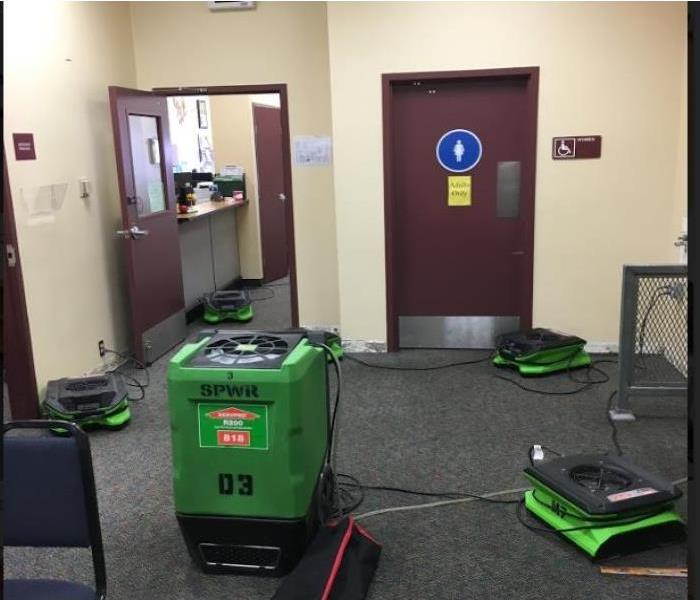 A water fountain leaked and flooded this room at a school. SERVPRO of West Riverside extracted the water and complete the drying process.
A water fountain leaked and flooded this room at a school. SERVPRO of West Riverside extracted the water and complete the drying process.
Plumbing - the home maintenance that nobody wants to do or ever think about until there is a real problem.
It’s not your fault; we’re all guilty. The only way to really understand why you should keep up on it is to educate yourself on all of the worst case scenarios and what causes them. We’ve compiled a list of some of the biggest plumbing issues and we hope it will make you see exactly why you need to stay vigilant.
Corroded PipesAs materials like iron and galvanized steel age, they begin to fall apart. Pipes that are out of sight and out of mind are usually the ones that are affected by these issues. The older the pipes, the closer you are to dealing with corrosion issues.Tree RootsNature is an unpredictable source of plumbing issues. Trees fall into this category, especially when it comes to plumbing. They are unpredictable due to the fact that they are underground. Tree roots can warp and break pipes causing leaks and/or sewage backups. There are ways to fix this (remove the tree or use a chemical root killer).City Sewer CollapseOld sewer pipes made of materials such as asbestos and concrete can collapse over time. When this happens, sewage will flow along the path of least resistance, including up through a home/business’s drain(s); such as sanitary sewer line. Damage like this is the responsibility of the city/other jurisdiction.Pipe BurstPipes burst or leak for any number of reasons. Most pipes are hidden within walls or between floors. Because of this, when a leak occurs, water may come down from a first-floor ceiling beneath a bathroom or down the top of a wall beneath the leak.Major pipe leaksThese are fairly common. Watch for these warning signsdiscolored stains on the walls or ceilinghigher water billslower water pressureodd behavior from the water heaterIf leaks escape your attention, the danger of flooding is likely. Know where the water main shut-off valve is located.Slab LeaksThese are insidious leaks that are hard to spot because they occur down in the stone foundation of a home. These leaks are a waste of water and can cause serious damage to a building’s foundation if not fixed.Loss of Freshwater - Broken Water MainNever ignore signs of a broken water main. This includes unexplained dampness on the lawn or drop in water pressure.Blocked/Damaged Sewer LineThis type of damage can be caused by materials coming from the building blocking the pipes or from the aforementioned tree roots. Sewage backups can cause a serious health risk for anyone in the building.These eight types of damage can cause moderate to severe damage to homes and businesses. Depending on the type of water that comes into the house or the type of pipes that you’re dealing with, it could be damaging to the health of the people in the building. The best way to avoid plumbing issues and the damage that comes with it is to keep an eye on it and make sure to keep up on maintenance. So stay alert and keep the plumbing damage to a minimum!
If you do experience damage from plumbing issues, you can always contact us for your cleaning and restoration needs at:
951-351-8033
Contact us
SERVPRO of West Riverside City offers FREE home or business inspections.
We practice safe social distancing and our technicians are required to wear masks and gloves. Your health and safety is of greatest importance.
How Can Riverside Residents Support National Pet Fire Safety Day-July 15, 2020
7/15/2020 (Permalink)
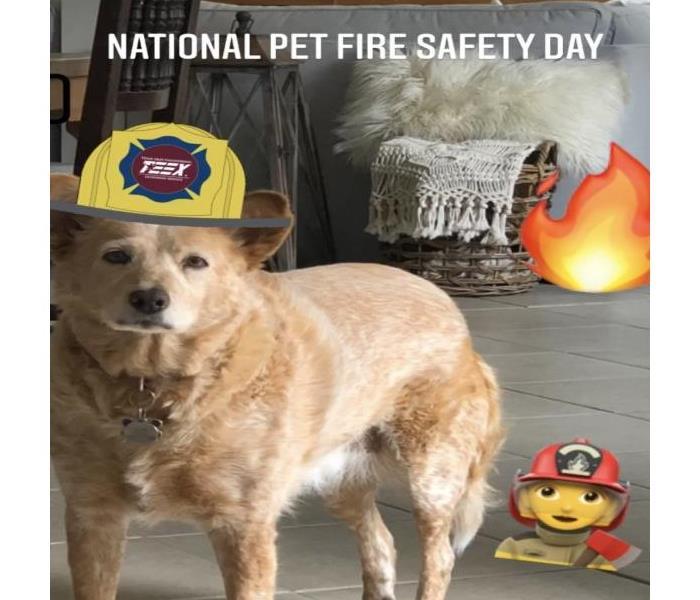 At SERVPRO West Riverside City, we have taken all precautions to keep Ellie, our cattle dog safe in the event of a fire or emergency.
At SERVPRO West Riverside City, we have taken all precautions to keep Ellie, our cattle dog safe in the event of a fire or emergency.
National Pet Fire Safety Day takes place every year on July 15, and it’s a day to learn how to keep your pet safe in a fire.
For many Riverside residents, pets are our most precious asset so it makes sense that we observe a day to keeping them safe during one of the scariest things we can imagine. It was started by the American Kennel Club and ADT Security in 2009 to help pet owners learn safety measures to protect their beloved pets and homes from fire, and it’s a great opportunity to learn how to keep your fur baby safe.
Preventing a Fire
Open flame exposure is one of the most common ways that your pet may accidentally start a fire in your home.
- Never having unsupervised candles
- Fires in your fireplace should also be monitored
- Having flameless candles and an enclosed fireplace instead
- Puppies love chewing and may chew on loose wire
- Secure loose wires and ensure they are out of reach from your pets
- Never put a glass bowl on a wooden porch as the sun’s rays can heat the bowl, causing a fire on your wooden deck
- Try using a ceramic water bowl or stainless-steel dishes instead.
Preparing for a Fire
The number one step in preparing your pet and family for a fire is to talk with your family to determine an emergency plan than includes your pet.
- Practice this plan with the whole family
- Make sure everyone knows whose job it is to grab your pet and whose it is to grab your emergency supplies
- Items to pack in your pets emergency bag: food, medication, water, a photo of your pet, leashes and carriers, and medical records
- Make sure you know where he or she likes to hide and how to get him or her out of that hiding spot quickly
- Put a decal or sticker in your home’s front window indicating the number and type of pets you have to cut down on the time firefighters spend searching for your pet.
- In case your pet escapes during the course of a fire, make sure that the contact information on their collar and microchip is up to date.
- install smoke detectors connected to emergency response services so that even if you pet is home alone, should a fire occur, help can still be signaled and dispatched.
During a Fire
As part of your emergency response plan, make sure to grab your pet’s leash or carrier as you grab your pet and escape the building.
- Outside your home will be chaotic, and your pet may try to escape to a safer area, so it is important to keep them nearby and secure.
- If it takes too long to locate or secure your pets, as much as you may not want to, leave, open the door, and call for them once you are outside and at a safe distance from the fire.
- You should never delay escape or endanger yourself or your family to rescue your family pet.
- Once responders get there, immediately inform them your pet is still inside so they can continue looking for your pet.
You can obtain a free window cling by going to www.adt.com/pets or at AKC Responsible Dog Ownership Days events. Details are available at www.akc.org.
At SERVPRO West Riverside City, we have taken all precautions to keep Ellie, our cattle dog safe in the event of a fire or emergency. We are now in peak fire season. These tips will help save the lives of our pets.
What can Riverside Residents do During Drought Conditions
7/13/2020 (Permalink)
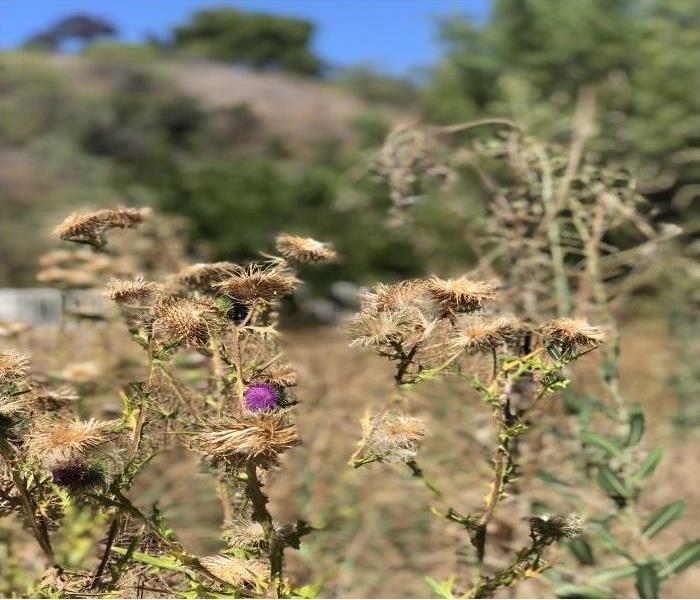 Southern California is known for limited rainfall causing drought conditions. In Riverside County, the dry conditions are cause for concern.
Southern California is known for limited rainfall causing drought conditions. In Riverside County, the dry conditions are cause for concern.
Nearly every part of the U.S. experiences periods of reduced rainfall.
Planning in advance for a drought can protect us in dry years. Southern California is especially known for limited rainfall causing drought conditions. In areas such as Riverside County, the dry conditions and warmer summer weather are also a cause for concern. Concerns range from threats of fire, watering your yard, and limiting water usage.
The best way to prepare for a drought is to conserve water. Make conserving water a part of your daily life. Ready.gov gives these great tips!
Indoor Water Conservation Tips Before a Drought
GENERAL
- Never pour water down the drain when there may be another use for it. For example, use it to water your indoor plants or garden.
- Fix dripping faucets by replacing washers. One drop per second wastes 2,700 gallons of water a year.
- Check all plumbing for leaks and have any leaks repaired by a plumber.
- Retrofit all household faucets by installing aerators with flow restrictors.
- Install an instant hot water heater on your sink.
- Insulate your water pipes to reduce heat loss and prevent them from breaking.
- Install a water-softening system only when the minerals in the water would damage your pipes. Turn the softener off while on vacation.
- Choose appliances that are more energy and water efficient.
BATHROOM
- Consider purchasing a low-volume toilet that uses less than half the water of older models. Note: In many areas, low-volume units are required by law.
- Install a toilet displacement device to cut down on the amount of water needed to flush. Place a one-gallon plastic jug of water into the tank to displace toilet flow. Make sure it does not interfere with the operating parts.
- Replace your shower-head with an ultra-low-flow version.
KITCHEN
- Instead of using the garbage disposal, throw food in the garbage or start a compost pile to dispose it.
Outdoor Water Conservation Tips Before a Drought
GENERAL
- Check your well pump periodically. If the automatic pump turns on and off while water is not being used, you have a leak.
- Plant native and/or drought-tolerant grasses, ground covers, shrubs and trees. Once established, your plants won't need as much watering. Group plants together based on similar water needs.
- Don't buy water toys that require a constant stream of water.
- Don't install ornamental water features (such as fountains) unless they use re-circulated water.
- Consider rainwater harvesting where practical.
- Contact your local water provider for information and assistance.
LAWN CARE
- Position sprinklers so water lands on the lawn and shrubs and not on paved areas.
- Repair sprinklers that spray a fine mist.
- Check sprinkler systems and timing devices regularly to be sure they operate properly.
- Raise the lawn mower blade to at least three inches or to its highest level. A higher cut encourages grass roots to grow deeper and holds soil moisture.
- Plant drought-resistant lawn seed. Reduce or eliminate lawn areas that are not used frequently.
- Don't over-fertilize your lawn. Applying fertilizer increases the need for water. Apply fertilizers that contain slow-release, water-insoluble forms of nitrogen.
- Choose a water-efficient irrigation system such as drip irrigation for your trees, shrubs and flowers.
- Turn irrigation down in fall and off in winter. Water manually in winter only if needed.
- Use mulch around trees and plants to retain moisture in the soil. Mulch also helps control weeds that compete with plants for water.
- Invest in a weather-based irrigation controller—or a smart controller. These devices will automatically adjust the watering time and frequency based on soil moisture, rain, wind, and evaporation and transpiration rates. Check with your local water agency to see if there is a rebate available for the purchase of a smart controller.
POOL
- Install a new water-saving pool filter. A single back flushing with a traditional filter uses 180 to 250 gallons of water.
- Cover pools and spas to reduce water evaporation.
SERVPRO of West Riverside City is available for any questions. Ready.gov is a source we use to help guide our neighbors through various situations. We especially use their storm, fire season, and flooding tips and much more. We can assist when you do sustain damage from these causes. Call us for a free inspection-951-351-8033
Riverside Summer Fire Safety Tips When using your Grill
7/8/2020 (Permalink)
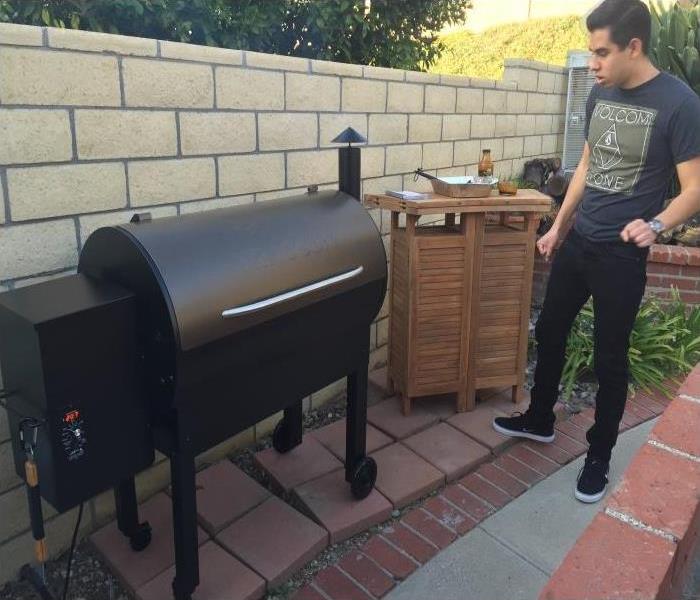 Our choice of grill is a smoker, nothing beats the taste of smoked flavored ribs. Practice safe grilling Riverside!
Our choice of grill is a smoker, nothing beats the taste of smoked flavored ribs. Practice safe grilling Riverside!
Summer is the time of the year for outdoor activities, but it also carries increased risk of fires started by outdoor cooking, fire pits and campfires.
This article will give Riverside residents important safety guidelines for grilling food outdoors.
NFPA provides the following statistics:
- July is the peak month for grill fires (18%), including both structure, outdoor or unclassified fires, followed by June (15%), May (13%) and August (12%).
- The grill had not been cleaned in more than one-quarter (29%) of the home grill structure fires.
- The leading area of origin for structure fires involving grills was an exterior balcony or open porch, and 44 percent of the property damage from grill structure fires resulted from fires that started there.
- Five of every six grills involved in home fires were fueled by gas (84 percent), while 12 percent used charcoal or another solid fuel.
- Gas grills were involved in an average of 8,900 home fires per year. Leaks or breaks were primarily a problem with gas grills.
- Charcoal or other solid-fueled grills were involved in 1,300 home fires per year.
General Grill Safety
- Only use propane and charcoal grills outdoors. This will minimize the risk of fire and exposure to toxic gases and potential asphyxiation.
- Position the grill several feet away from house siding and deck railings. Don’t locate it under eaves and overhanging branches.
- Place the grill a safe distance from lawn games, play areas and foot traffic. Keep children and pets from the grill area by creating a three-foot safety zone around the grill.
- Use long-handled barbecue tools. Wear short sleeves or roll them up when cooking on the grill.
- Periodically clean out the grease or fat that has built up in trays below the grill.
- Keep a bucket of water near your grill.
Charcoal Grills
- At the start of grilling season, make sure your grill is clean and free of ash and grease.
- Purchase the appropriate starter fluid and store it out of reach of children and away from heat sources. Never use any flammable or combustible liquid other than charcoal starter fluid.
- Never add charcoal starter fluid after coals or kindling have been ignited.
Propane Gas Grills
- Follow the manufacturer’s instructions on how to set up the grill and maintain it.
- At the start of grilling season, check the burners for clogs, make sure all hoses and connections are secure, and restock the propane if needed.
- Check the propane cylinder hose for leaks before using it for the first time each year. A soap and water solution applied to the hose will bubble up to reveal escaping propane. If you detect a leak, turn off the tank and grill. If you can stop the leak, don’t use the grill until you have it serviced by a professional. If the leak won’t stop, call the fire department.
- If you smell gas while cooking, get away from the grill and call the fire department. Do not attempt to move the grill.
- Use only propane cylinders manufactured after April 2002 with overfill protection devices (OPD).
- Never store propane cylinders in buildings or garages.
If you’ve suffered fire damage to your home or business, call SERVPRO of West Riverside City today at 951.351.8033
We’re Here for You
The team at SERVPRO of West Riverside City has specialized training and experience in fire restoration services, natural disaster and storm damage cleanup, water damage remediation and chemical cleanup. Call SERVPRO of West Riverside City (951.351.8033) any time.
How Can Riverside Families Celebrate July 4th, 2020 with COVID-19 Orders Still in Place
7/1/2020 (Permalink)
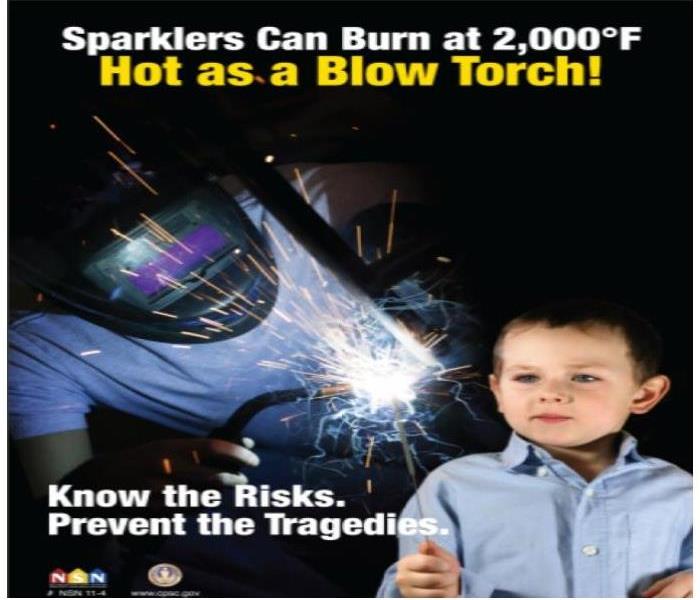 Did you know?
Sparklers burn at 1200 Fahrenheit? That is hot enough to cause third degree burns and start a fire with just about anything.
Did you know?
Sparklers burn at 1200 Fahrenheit? That is hot enough to cause third degree burns and start a fire with just about anything.
Summer is traditionally known for fireworks, barbeques, and picnics with loved ones.
Fireworks are beautiful to see and enjoy while being outside on a summer night, but it can also be dangerous. This year can pose a change due COVID-19 and the CDC guidance regarding social distancing. Many cities may not hold their annual fire work show. Riverside typically hosts a show at Mt. Rubidoux or La Sierra parks, however, reports indicate that Riverside will not host the show. This is because of a need to reduce costs to balance the city budget and also to avoid large crowds during the COVID-19 pandemic.
This may tempt many households to purchase fireworks and have their own 4th of July celebration. There are many reasons they are illegal in Riverside. Riverside County has very diverse terrain. The vegetation is very dry where fireworks can easily start a brush fire. More fires are reported on July 4th than any other day of the year, according to the National Fire Protection Association. Fireworks started an estimated 19,500 fires in 2018, including 1,900 structure fires, 500 vehicle fires, and 17,100 outside and other fires. In 2018, U.S. hospital emergency rooms treated an estimated 9,100 people for fireworks related injuries; half of those injuries were to the extremities and 34% were to the eye or other parts of the head. Children younger than 15 years of age accounted for more than one-third (36%) of the estimated 2018 injuries. These injury estimates were obtained or derived from the U.S. Consumer Product Safety Commission’s 2018 Fireworks Annual Report by Yongling Tu and Jason Ng.
Did you know?
That sparklers burn at 1200 Fahrenheit? That is hot enough to cause third degree burns and start a fire with just about anything.
What Can Families do July 4th 2020?
Since many annual Independence Day events are canceled in 2020 because of the COVID-19 pandemic, what can families do to observe this holiday? Here are 18 4th of July activities for families from CountryLiving.com.
18 4th of July Activities to Keep the Family Entertained All Day
- Throw a Family-friendly Fourth U-Pick Party
- Go Camping in Your Backyard
- Watch a Patriotic Movie Outside
- Plan a Soda Float Social
- Take a Family Bike Ride
- Play Patriotic Games
- Dine Al Fresco
- Create 4th of July Cocktails
- Make an Unforgettable Dinner
- Throw a Family Pool Party
- Go for a Family Picnic
- Spark Up the Sparklers (Not recommended in Riverside City)
- Bake a Red, White, and Blue Treat
- Stage a Hot Dog Eating Contest
- Play a Little Baseball
- Make DIY Decorations Together
- Eat Barbecue with Family
- Enjoy S'mores Around a Campfire
ALL fireworks, including sparklers, are illegal in Riverside County. All fireworks are illegal because they cause serious injuries and very often, cause fires. Riverside County has very diverse terrain. The vegetation is very dry where fireworks can easily start a brush fire. Individuals who cause fires by using illegal fireworks will be held responsible for all suppression costs. These costs can run into the millions of dollars.
Since Studies show that there is more property damage on the Fourth of July than any other day of the year it is a good idea to check with your home owner’s insurance company regarding your coverage relating to fireworks. If you are involved in illegal fireworks you may not be covered. This could be a costly celebration!
If something happens to go wrong, and you experience fire damage, call SERVPRO of West Riverside City at 951-351-8033
When your Riverside home or business suffers fire damage, it can be especially devastating. In addition to the fire and smoke damage, your property may have substantial water damage from firefighting efforts. You may feel stressed and confused after such a disaster, and you’ll need a caring expert to guide you through this crisis. SERVPRO of West Riverside City has the specialized fire and water damage equipment and expertise to help you through this tough time. We promise to treat your family with empathy and respect and your property with care.
Is Your Riverside Water Bill Too High?
6/29/2020 (Permalink)
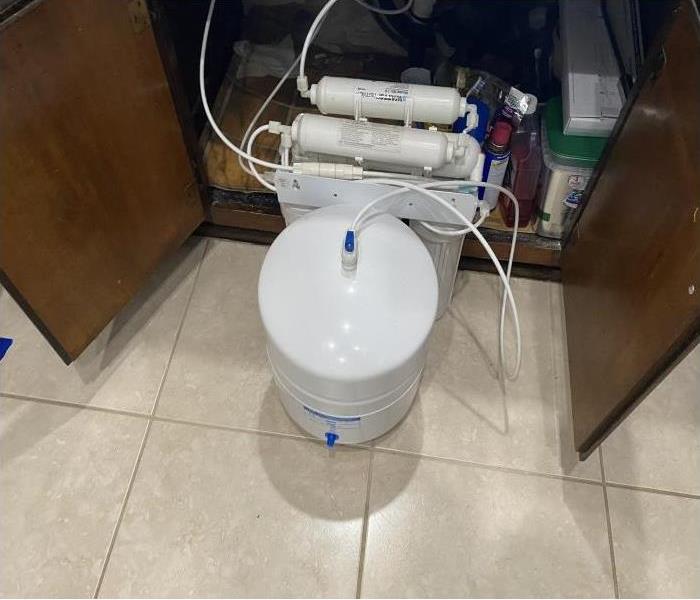 This water filtration system was leaking water causing damage to the kitchen and dining room, SERVPRO of West Riverside was there to help!
This water filtration system was leaking water causing damage to the kitchen and dining room, SERVPRO of West Riverside was there to help!
It can be normal for your water bill to fluctuate from month to month - you may be watering your lawn more in the Spring or Summer, or doing extra laundry if you have guests visiting.
As long as you know why your water bill is higher, there shouldn't be any cause for alarm. However, sometimes you may notice an unexpected large increase…and that could be a sign of water a water leak causing damage.
To help you prevent severe water damage to your property, here are 4 common kinds of leaks to look out for that may be causing your water bill to be too high:
Leaking Faucets
A leaky faucet may just release a few drops of water, but if you wind up with a severe leak you could be wasting as much as 20 gallons of water every day. That’s why it’s important to check each faucet to make sure there are no visible signs of a leak.
One way to check is by placing an empty cup underneath the faucet and making sure no water collects. You’ll also want to take a look at the piping in the cabinets underneath the sink, and don’t forget to check your outside hoses and water sources as well!
Leaking Pipes
Plumbing leaks can sometimes be difficult to detect as many of your pipes may be hidden behind walls or above the ceiling. Still, you can check all the visible fittings and fixtures for any signs of damage or leaking.
As for your hidden pipes, you can pay attention to the ceiling and walls themselves. If you notice any signs of discoloration, deterioration, or mold, that can be a clue to the source of the problem.
Leaking Toilets
A continuously running toilet can waste as much as 200 gallons of water every day and cause your water bill to soar.
One easy way to check if you have a leak is to dispense a few drops of food dye into the tank of your toilet. If you see the color start to come into the bowl, that’s a sign of a potentially bad leak.
Purification Systems / Water Softeners
If you use a water softener or purification system, that could be the cause of your bill increase. These systems tend to produce more waste water than other plumbing systems.
If you water bill is suddenly high, you want to make sure that these systems are working correctly and not producing excessive water waste.
Here at SERVPRO of West Riverside City, we are available 24/7 and can be at your home quickly to help you if you do have water damage. Our local team is made up of the best advanced technicians with the training and equipment needed to handle any size disaster.
Water Damage? Respiratory Issues? Kitchen Appliance Maintenance Tips That Can Help!
6/25/2020 (Permalink)
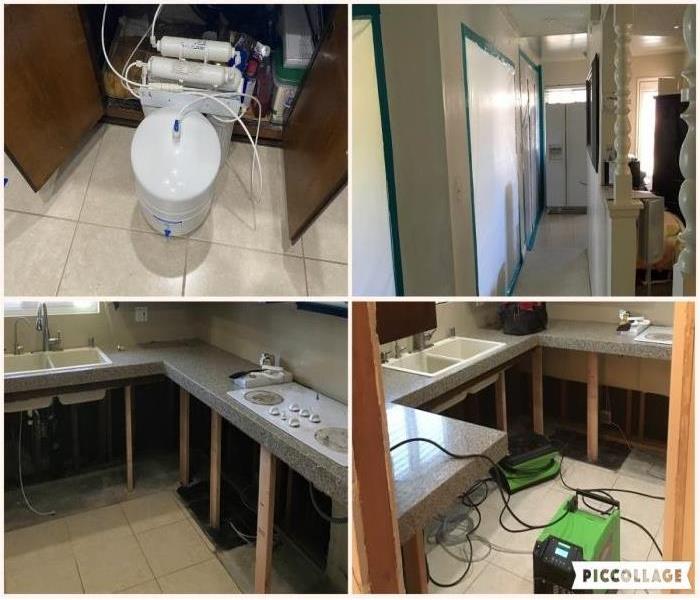 Riverside homeowner was very happy and his mind was put at ease, when we took all precautions for his son with respiratory issues.
Riverside homeowner was very happy and his mind was put at ease, when we took all precautions for his son with respiratory issues.
SERVPRO of West Riverside City assisted with a leak from water filtration system where the kitchen cabinets and dining room were affected.
The young son of the homeowner had serious respiratory issues and the homeowner was very concerned about the water damage and the demo. To put the homeowner at ease, we contained off the work area, used air scrubbers and a HEPA vacuum. The HEPA filter will capture small particles such as mold, bacteria, asbestos, lead, dust and many other airborne contaminants. Air scrubbers will continuously clean the air and provide a clean, healthy and productive environment. HEPA (High-Efficiency Particulate Air) vacuums differ from conventional vacuums in that they contain filters that are capable of trapping extremely small, micron-sized particles. A true HEPA filter can trap 99.97 percent of all airborne particles larger than 0.3 microns. Finally, we cleaned all affected surfaces. The homeowner was very happy and his mind was put at ease.
What can you do to prevent such damage?
Some of the home floods commonly occur in the kitchen due to its many water outlets. For most homes, the kitchen commonly incorporates multiple appliances that connect to a water supply line. It is important to understand that water damages that occur in the kitchen may possibly spread past the kitchen and create larger damages throughout one's home. Keep your home prepared by periodically checking the appliances to help reduce water damage incidents from occurring.
However, a few common items that may lead to a kitchen flood are as follows:
Dishwasher
Over time, the water supply line in a dishwasher may degrade. This can lead to water leaking into enclosed areas under the appliance and rupture entirely. Check this line twice a year by removing the kick plate at the front of the dishwasher and use a flashlight to inspect the space and surrounding areas. If the area is wet with no explanation, this should be taken as a red flag. The dishwasher water supply line shut off should be located under the kitchen sink; turn it off and call a plumber.
Under Sink System
Underneath the sink, you may find a water filtration system. As time passes, the lines can degrade and rupture. A crack in the line can lead to flooding and potentially much worse. Check the sink twice a year to avoid any costly damages.
Leaking Sinks
If your kitchen or bathroom sink is leaking, you can find yourself dealing with water and possibly mold damage. The problem is, sometimes it is hard to know why it’s leaking and where it’s leaking from. So we wanted to go over a list of common causes of sink leaks so if you ever find yourself dealing with one you can go down this list and hopefully be able to either fix the problem yourself or better articulate the problem to a plumber/repairman.
- Drain Leak: Leaks can come from a thinly sealed drain or from a drain that is old and worn. It is possible to identify and fix this situation on your own by tightening the nuts located at the point where the pipes meet. However, if you feel uncomfortable doing it yourself, you can reach out to a plumber to check it.
- Faucet Leak: This type of leak is easier to identify. Water puddling at the top of the sink when the faucet is turned on or water collecting under the sink can be big indicators. This is a problem generally caused by failing washers or worn-out gaskets, and possibly a faucet that needs to be completely replaced. Either way, you can generally take care of these problems on your own and should only need to call a plumber if you are uncomfortable attempting to do it on your own.
- Leaks from the Rim Around The Sink: Simply put, this leak comes from an unsealed section between the sink and countertop. This can be fixed by re-caulking or tightening whatever connects the sink to the counter.
- Loose Water Supply Connection: This leak is generally constant and is out of sight and fairly hard to identify. Usually caused by corrosion or a bad gasket in the connector. Tightening the connection or replacing the gasket can be the solution to the problem.
- Clogged P-Trap: The P-section is a curved section of a pipe which prevents foul smells from seeping through the drains. If it gets clogged, it can prevent proper draining causing leaks. It’s possible you’ll just need to unclog it, but it might need to be replaced, which is definitely the job for a plumber.
- Damaged O-Rings: This is what prevents leaks in the area where the faucet is being held in place. So if there is an issue with the O-ring, you could have quite the mess on your hands. Luckily this is something you should be able to just replace on your own.
- Worn-Out Washers: This is one of the most common leak causes. Constant friction wears them out, and replacing them is something you can do on your own if you want to.
- Corroded Valve Seat: Corrosion can be prevented with regular cleaning, but if the valve seat gets corroded to a certain point you would be better off contacting a plumber to let you know if it needs to be replaced or not.
Refrigerator
Moving the refrigerator may be tricky sometimes. It's important to be cautious about its placement. Moving the refrigerator too close to the wall may kink or break the water supply line. However, having the refrigerator too far out may cause potential over-stress on the line and potentially cause the line to rupture. Keep in mind, the plastic water supply line degrades over time and can crack or break. To prevent water damages from potentially happening, it is advisable to remove the plastic line and replace it with a copper or stainless-steel line that has better durability.
Being prepared can help prevent a disastrous situation. By regularly checking on these appliances, you will help avoid any catastrophic damages. SERVPRO of West Riverside City is faster to any sized disaster, and we are here to help 24/7/365 to make it "Like it never even happened."
The New and Improved Payroll Protection Program
6/22/2020 (Permalink)
 Meet Shaila Chamberlain, a local Riverside CPA. She is very knowledgeable with small businesses!
Meet Shaila Chamberlain, a local Riverside CPA. She is very knowledgeable with small businesses!
Shaila Chamberlain is a local Riverside CPA. If you are a business professional, you want to know that your accountant has the expertise required to get the job done.
Shaila is part of Executive TEAM Referral, which SERVPRO of West Riverside is also a member of. She has a bachelor’s in accounting from Texas Tech University and a master’s in business administration from Pepperdine University. She has been working with small businesses for over 25 years and understand the unique challenges you face.
We wanted to spotlight Shaila and her newsletter. In a newsletter sent on June, 4, she discussed the topic, "The New and Improved Payroll Protection Program". The information was very informative, and she gave SERVPRO the okay to share it in our blog. In the same newsletter she highlighted SERVPRO of West Riverside City and our Certified: SERVPRO Cleaned service. Take a look:
Payroll Protection Program News (and a little personal commentary thrown in for good measure) – Many small businesses have taken on PPP loans – those SBA loans that were issued in a hurry over the last couple of months that were intended to ease the financial pain of government-mandated COVID-19 restrictions.
The hook of the PPP, was that businesses could receive 2.5 times their average 2019 payroll in the form of an SBA loan, and would have that loan forgiven if they spent at least 75% of the money on payroll and no more than 25% on rent and a few other small expenses during an 8 week period beginning one day after the loan was received. Like any major undertaking that is ill-conceived and poorly managed, it should come as no surprise that many business owners are finding the stipulations of the loan quite problematic.
For starters, the loans were issued based on 2.5 times an average monthly payroll. For our math-challenged friends in Congress, 2.5 times a monthly average payroll equates to about 10 weeks of payroll – Hard to spend 10 weeks of payroll in 8 weeks without some kind of “tweaking” along the way. Hence, the 25% that currently may go towards rent and utilities This is helpful for some businesses with high rent, low employee costs, but not all.
Secondly and more importantly, the loans are intended to keep people working. But this is at odds with near nation-wide orders to close businesses and shelter in place. How do you keep employees working, when business is closed?
Shut down, shelter-in-place and by the way, pay your employees at least as much as they made last year.
And just to keep things interesting, give said employees a big, fat bonus of $600 per week to take unemployment instead, requiring business owners to compete with the state and federal government to see how much we can pay people not to work. But I digress…
Read more
Certified: SERVPRO Cleaned
Can We Ever Be Clean Enough?
The good news -- business is slowly coming back! The bad news -- Covid-19 is still out there.
Getting back to business relies on getting customers back through your doors. And that only happens if customers feel safe and secure in your space.
Are you ready to help your customers and employees feel safe and communicate that you've chosen a higher standard of clean?
My friends at SERVPRO of West Riverside City are offering a defensive cleaning program that goes beyond janitorial - A proactive viral pathogen cleaning.
They will not only customize a cleaning plan to your specifications, they provide window emblems and signage to show your customers that you care about their health and safety. Click now to find out more.
Stay healthy. Stay safe. Stay positive.
The content herein is for informational purposes and does not constitute legal, financial or tax advice.
If you would like more information or to be added to her email distribution for her informative newsletters, feel free to reach out to her:
Shaila Chamberlain, CPA, CMA, MBA
Phone: 951.768.2969
Email: shaila@schamberlaincpa.com
Web: www.schamberlaincpa.com
Riverside Elementary Schools Faces Major Water Damage from a Water Fountain
6/17/2020 (Permalink)
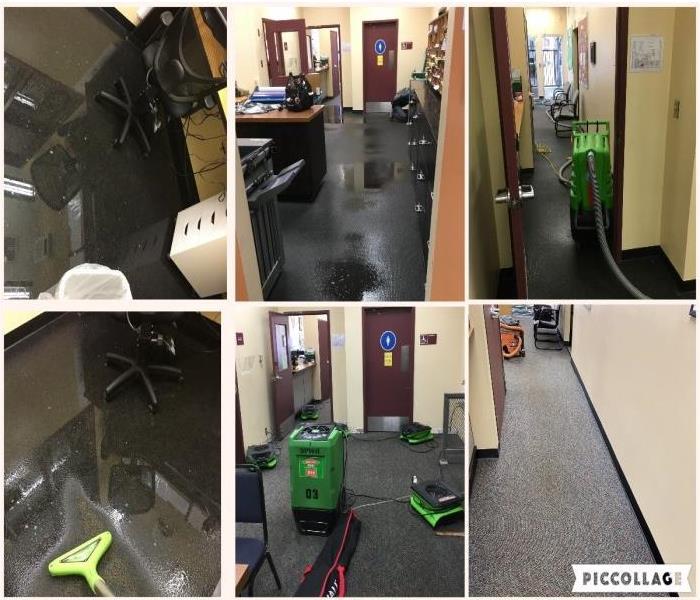 Water damage can quickly lead to a mold infestation and prevent kids from going to school. Contact SERVPRO for remediation.
Water damage can quickly lead to a mold infestation and prevent kids from going to school. Contact SERVPRO for remediation.
Education is something that Riverside residents take seriously, and that is why when a disaster threatens one of our local schools, it is critical to get this situation resolved immediately.
Water damage in a Riverside School is often among the situations that get overlooked by overseers as minuscule or non-threatening. Unfortunately, this is not the case. An inadequately or improperly cleaned and restored water damage incident can lead to many severe effects for the building and also those that use it.
One of the first concerns is the penetration into flooring and wall materials like drywall, wood, and linoleum. In just a brief period these materials can become oversaturated and deform, break loose and fail. This hazard can affect both faculty and students and persist gradually after the water was presumably cleaned up with conventional approaches.
Another pressing concern for school officials should be persistent dampness and moisture. These conditions could lead to hazardous secondary effects like mold growth which could affect those occupying the building. Our SERVPRO team utilizes moisture detection equipment to ensure that our efforts have successfully removed all of the water from the affected areas, not just the areas that can be readily seen.
One of our local elementary schools experienced water damage from a drinking fountain. SERVPRO was called to mitigate the damage. The water ran into several classrooms, hallways and an office area. Our first step was to extracted the water. This step removes the majority of the water from the property. By performing a thorough water extraction, SERVPRO of West Riverside Professionals help reduce the drying time and help to prevent mold and secondary water damage. Once the excess water has been removed, the floors and walls may appear dry, but a quick inspection will reveal they are wet to the touch. Nearly all building materials, like wood, drywall, and flooring materials, are porous and therefore retain water. This retained water can cause the materials to break down, warp, or cause mold damage. We found it necessary to remove the baseboards, drill ventilation holes for drying, and then reset the baseboards.
The next step is drying and dehumidifying. We will use room measurements, temperature, and relative humidity to determine the optimal number of air movers and dehumidifiers to dry your property. We will carefully monitor the progress using moisture meters until the materials return to acceptable drying goals.
- Industrial-grade dehumidifiers help prevent secondary water damage like swelling and warping of floors, walls, and furniture.
- High-speed air movers create airflow across walls, carpets, pads, and furniture, which accelerates the evaporation of moisture.
Our SERVPRO professionals are available 24/7 to help with water damage emergencies faced by any of our Riverside schools. This commitment ensures that your institution is getting highly trained restoration specialists with industry-leading equipment to overcome any level of water damage incident that you face.
SERVPRO completed the job and made it, "Like it never even happened."
When you are responsible for the upkeep and maintenance of an entire school, there are often hundreds or even thousands of people to consider with every decision. Trust in the experience and rapid response of our SERVPRO of West Riverside City water restoration team to help you through every step of restoring the building. Give us a call today at (951) 351-8033.
SERVPRO of West Riverside Has the Right Tools For the Job
6/15/2020 (Permalink)
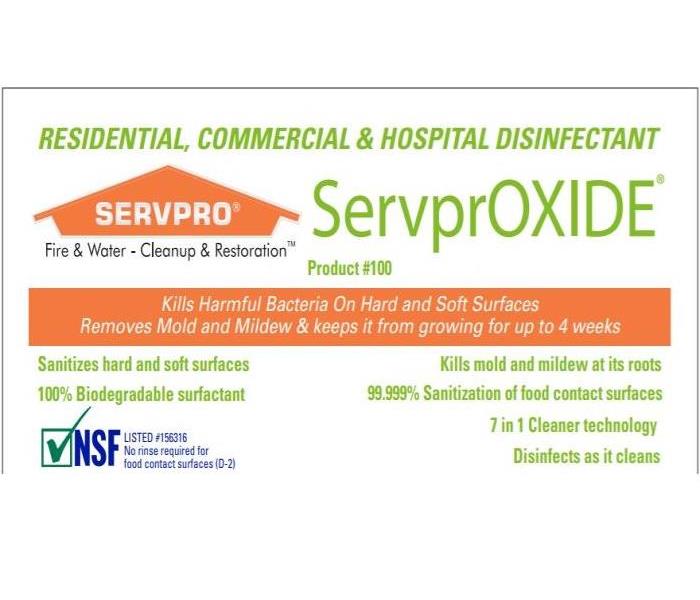 SERVPROxide Sanitizes hard and soft surfaces and disinfects as it cleans!
SERVPROxide Sanitizes hard and soft surfaces and disinfects as it cleans!
Construction workers and skilled trade workers know that having the right tools for the job is crucial to getting the job done right the first time safely and effectively.
Could you imagine a carpenter trying to build a house without a hammer or a saw? How about a mechanic repairing a vehicle without wrenches? The same logic can be applied to restoration technicians. Without the proper tools and equipment restoring a home or business to preloss condition is near impossible.
SERVPRO of West Riverside City utilizes some of the latest and greatest tools and equipment on the market. Equipping our technicians with the right tools and equipment is only part of SERVPRO’s winning formula. Training and experience also play a major role in the success of a restoration project. This is why our technicians and drying specialists are some of the most well trained, certified, and most importantly experienced professionals around. In our industry disaster can strike at a moment's notice. Having enough and the right type of equipment on hand is key to a fast response time, and when you’re dealing with water or fire damage, a speedy response can be the difference in a small water cleanup and a major restoration project.
SERVPRO is known nationwide for being the industry leader in the residential and commercial restoration industry, but did you know SERVPRO of West Riverside City also offers residential and commercial cleanings as well? That’s right the same company that you have trusted for years to mitigate and restore your home or business after a water or fire loss, also offers deep cleaning and proactive cleanings for homes and businesses.
What is a deep cleaning?
When SERVPRO of West Riverside City is called out to a home or business for deep cleaning services, our customer usually has experienced an event that calls for a more comprehensive cleaning than a maid service or janitorial staff can provide. There could be biological factors or environmental restrictions like hazardous materials or other types of contaminants present that require specialized equipment and training to clean. After a fire SERVPRO technicians will use specialized dry-chem sponges to heavily clean and remove smoke and soot damage from walls and ceilings. HVAC systems can be deep cleaned using SERVPRO’s specialized duct cleaning systems that will remove built up dust and debris from customer's ductwork. Carpets can be cleaned, sanitized, and restored using SERVPRO’s proprietary professional cleaning and restoration products and equipment during a deep cleaning. Deep cleaning services are far more in depth and substantially more thorough than your typical cleaning service.
What is a proactive cleaning?
Proactive cleanings are great for homes and businesses that want to minimize their exposure to viruses and bacteria. Proactive cleaning procedures consist of cleaning and disinfecting the structure of the facility along with high traffic areas and surfaces. High traffic areas are areas that many people pass through or congregate in like a conference room or lobby. High traffic surfaces are surfaces that people often come in contact with like handrails, door knobs, or water fountains. Both high traffic areas and surfaces are havens for bacteria, viruses and other microorganisms. With SERVPRO’s proactive cleaning service home and business owners can minimize their exposure to these types of threats.
Foggers, Sprayers, Misters, and Ozone Generators
Foggers, sprayer and misters are all trade names for different types of cleaning equipment utilized to distribute professional grade cleaning and restoration products. Foggers create thick fog that can be used in any number of applications like coating, sealing, and sanitizing building materials. Sprayers are also very versatile pieces of equipment that can be used to evenly coat building materials with cleaning and sanitizing products during the restoration and/or cleaning process. Misters can be very similar to sprayers but differ themselves by dispensing cleaning and sanitizing products at a far smaller particle size. This creates a fine mist that is capable of covering hard to reach or inaccessible nooks and crannies of a building’s structure. Ozone Generators are different from foggers, sprayers, and misters because they are typically used to clean and disinfect air instead of surfaces. You will find ozone generators in hotels, casinos, and other commercial buildings where large numbers of people congregate.
Electric and Pump Sprayers - Pump sprayers are not all that different from the lawn sprayers you could find at Home Depot or Lowes, and are great for spraying cleaning solutions on carpet or treating a large area with antimicrobial products to prevent mold growth. Electric sprayers utilize an electric pump instead of a manual pumping system in traditional pump sprayers. This allows electric sprayers to produce a more consistent spray pattern or rate of dispersion and allow them to cover large areas very quickly.
Macro mist ULV Mister - Ultra-low volume (ULV) misters or macro misters compress liquid cleaning and sanitizing products like SERVPROXIDE or Benefect through a specially designed nozzle which produces a fine cold mist or aerosol. These types of misters produce extremely small droplets ranging in size from 1-150 micrometers and have a wide variety of restoration applications including disinfecting surfaces along with mold and odor control. Typically air tight containment is set up around the area to be treated, where technicians, donning personal protective equipment (PPE) like respirators, gloves, eye protection, and Tyvek suits, liberally mists the entire area to encapsulate unwanted odors and/or sanitize surfaces.
Thermal Fogger - Thermal foggers are very similar to mister in that they produce very fine aerosolized particles. They differ from them in the way they produce fog and the size of the particles they produce. Thermal foggers produce particles one micrometer or smaller and utilize heat to vaporize fogging solutions. When thermal fogging an area, air tight containment is erected around the area to be treated. Then a technician wearing the aforementioned PPE will liberally fog the entire area to sanitize surfaces and/or encapsulate unwanted odors.
Ozone Generator - Ozone generators do exactly what the name infers, they create ozone. Ozone is created by splitting oxygen into two solitary atoms. Each oxygen atom then attaches itself to a whole oxygen molecule to create an ozone molecule. Splitting of these molecules can be accomplished in two ways, Corona discharge which uses electrical discharge to split atoms and ultraviolet (UV) radiation which uses UV light to split oxygen molecules. On a molecular level ozone is very unstable meaning that its molecular bonds break down very easily and quickly (typically about 20 minutes). When ozone molecules come in contact with odors and/or bacterial molecules they bond with them, then break down destroying the odor and/or bacterials.
Have You Considered What Areas to Clean in your Riverside Store Before Reopening?
6/10/2020 (Permalink)
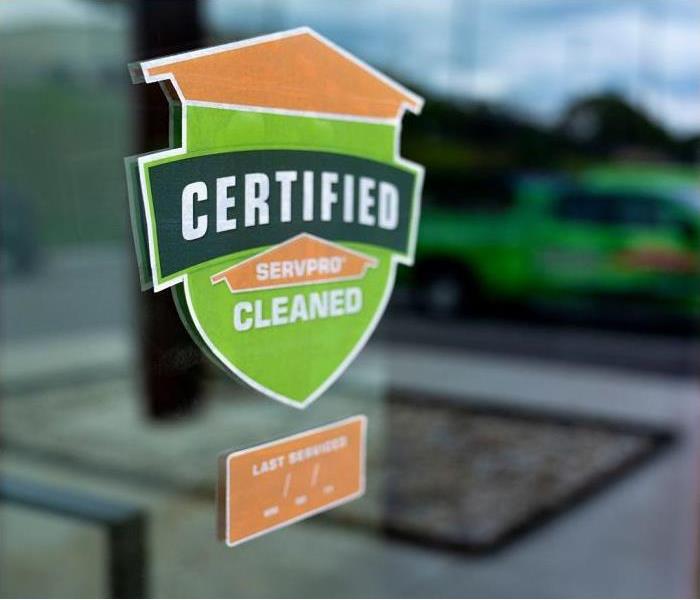 Call SERVPRO for a higher standard of clean!
951-351-8033
Call SERVPRO for a higher standard of clean!
951-351-8033
As business and stores begin opening their doors, more shoppers will be visiting stores, this means more hands touching things.
By giving more attention to germ-prone areas, store workers play a significant role in preventing the spread of viruses.
How do you properly clean sections of a grocery or retail store? Read our store checklist below!
Store Cleaning Checklist
- Shopping carts: As carts are used throughout the day, constantly wipe down the touch areas of the cart (especially the handles) with disinfectant cleaner. Treat hand baskets the same way. Nightly power washing serves as a proactive measure to sanitize and prepare the carts for use the next day.
- Checkout aisles: Cashiers (and with the assistance of baggers) should frequently clean the checkout area. The conveyor belt, rails on each side of the belt, customer counter, and the bagging area should be wiped down at pace with the number of customers passing through.
- Credit Card Machines: Keep credit card reading machines clean. Cash and plastic cards are known for harboring germs.
- Restrooms: Public restrooms in a store probably already receive several cleanings per day, but with a recent emphasis on public health, it’s wise to increase the frequency of cleaning. Customer and employee restrooms should be sanitized throughout the day: floors, doors, stall walls/doors, all handles (including paper towel and soap dispensers), sinks, counters, baby changing sections, etc. Once the store is empty for the day, a more comprehensive cleaning should be done from top to bottom. Sanitize everything.
- Floors: Floors are high-traffic areas, and grocery store floors get even more foot traffic now that restaurant traffic is prohibited beyond carry-out. For more efficient and thorough floor sanitization, consider using an industrial auto-scrubber.
- Walk-in freezers and refrigerators: Because freezers and refrigeration units house more prepared food these days, it’s a best practice to keep them clean for food safety. Give extra attention to these areas where products are handled by customers. These areas should be routinely cleaned. At the time that works best for your store schedule, remove the items from the refrigerator or freezer and clean the surfaces with no-touch products. This mitigates contamination.
Be aware of places where hands leave behind germs and coughs/sneezes may leave behind pathogens.
Why Choose Certified: SERVPRO Cleaned?
If you are need a deep and professional clean, trust your certified SERVPRO cleanup and restoration experts. Our team is trained to perform a proactive cleanup that involves facility or structure cleaning and disinfection. Cleanup procedures generally include cleaning of porous and non-porous surfaces, disinfecting of non-porous surfaces, cleaning and disinfecting of equipment, tools, and/or supplies used for cleanup process, and disposal of waste.
Why Choose SERVPRO Disinfectants
The CDC recommends usage of a labeled hospital-grade disinfectant with claims against similar pathogens to the coronavirus. Multiple products in the SERVPRO product line carry the EPA-approved emerging pathogens claims. While there is currently no product tested against this particular strain of the coronavirus, we are following all guidelines as provided by the CDC and local authorities.
Our proprietary disinfectant, SERVPROXIDE™ currently has dozens of EPA-approved claims including Feline coronavirus, Canine coronavirus, Staphylococcus (MRSA), E. coli, Salmonella, Rotavirus, Swine flu (H1N1) and more. Porous materials like carpet, rugs, upholstered items, and draperies that are not water sensitive can also be wet cleaned using SERVPROXIDE™.
Trust your certified SERVPRO cleanup and sanitization experts and give us a call today!
As always, we are here to help! Our team is available 24/7 to proactively clean businesses.
Visit our website SERVPRO of West Riverside City for more information on our Certified: SERVPRO Cleaned service.
Or Call us at 951-351-8033.
SERVPRO of West Riverside City Helps a local Manufacturing Company with Disinfecting
6/8/2020 (Permalink)
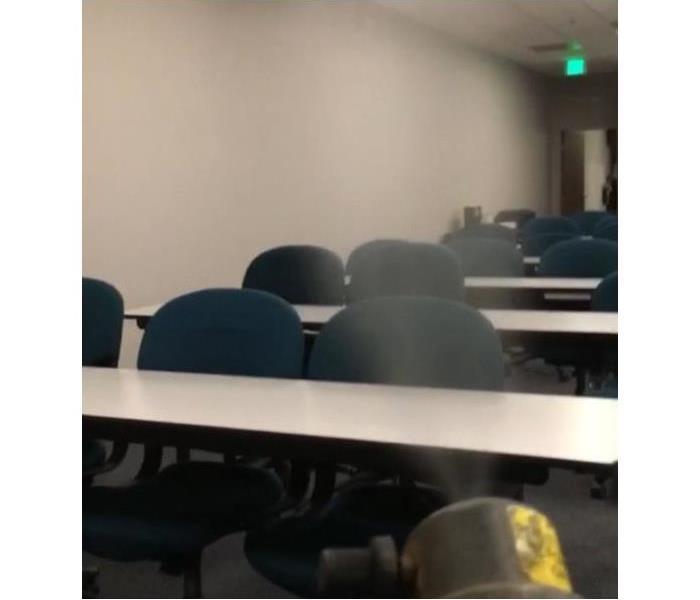 SERVPRO of West Riverside disinfected and sanitized this local manufacturing facility.
SERVPRO of West Riverside disinfected and sanitized this local manufacturing facility.
When you receive a call that a local manufacturing company is requiring to have their facility disinfected, SERVPRO of West Riverside was there to help.
We were ask by Wayne Tallman from HRM Janitorial company if we handled disinfecting and sanitizing. Due to Covid-19 a company he regularly maintained was requiring disinfecting and sanitizing in addition to their regular cleaning and maintenance.
Beyond the cleaning performed by a janitorial company, business owners and companies must understand that persons infected with the SARS-CoV-2 virus and/or COVID-19 that enter their property will potentially infect others and deposit the virus on surfaces.
According to the CDC, the virus is thought to spread mainly from person-to-person. This could be between people who are in close contact with one another (within about 6 feet) or through respiratory droplets produced when an infected person coughs or sneezes. These droplets can land in the mouths or noses of people who are nearby or possibly be inhaled into the lungs. It may be possible that a person can get COVID-19 by touching a surface or object that has the virus on it and then touching their own mouth, nose, or possibly their eyes, but this is not thought to be the main way the virus spreads.
The CDC has set up a web page entitled Preventing COVID-19 Spread in Communities which addresses homes, childcare and K-12 schools, colleges and universities, work environments, healthcare settings, and large community events and mass gatherings.
For business purposes, the CDC recommends routine environmental cleaning. This should include routinely cleaning all frequently touched surfaces in the workplace, such as workstations, countertops, and doorknobs; and provide disposable wipes so that commonly used surfaces (for example, doorknobs, keyboards, remote controls, desks) can be wiped down by employees before each use. For structures that utilize an internal or external janitorial crews, it is recommended that they follow proper cleaning protocols established by the CDC.
This is where SERVPRO of West Riverside City stepped in. Fortunately for us, their regular janitorial maintenance company, HRM, is an amazing company and the facility was immaculate. This is the first step that must be completed before disinfecting and sanitizing. SERVPRO of West Riverside City came in and followed through with the following processes.
Why Choose SERVPRO
When it comes to sanitization services, adapting advanced equipment is essential. During the time of a viral outbreak, it becomes critical. All around the world, Cleanup and Restoration companies are providing disinfecting sanitizing services, and SERVPRO is no stranger to these efforts. We always go out of our way to stay up to date with technology. Here at SERVPRO, "We utilize the most advanced equipment for cleaning." We have been in the biohazardous removal business for many years.
How does a ULV (Ultra Low Volume) Fogger help SERVPRO of West Riverside City sanitize and disinfect?
- Sanitization: A ULV fogger disperses water or solvent-based cleaners as a vapor in the air. ULV foggers make disinfection services go a little faster and make it easier to do regular cleaning maintenance at a quicker pace. "Our certified team knows how to protect your building."
- Effectiveness: ULV foggers can mist the disinfectant to as small as 20 microns in size to get into hard to reach areas. We use SERVPROXIDE disinfectant, a hospital grade disinfectant with the EPA's lowest toxicity rating. It is suitable for fogging/misting applications (not all disinfectants are!).
- Equipment: "Safety is important to us." Our techs can wear the proper equipment while using the ULV fogger, ensuring the job is done correctly and safely. Vapor-based equipment should always be used with protective masks and suits, to protect the respiratory system.
- Technique: Advanced equipment is essential, but training is also important. Our technicians have the knowledge and experience to help you sanitize your workplace. We can give you tips, explain our process, and make sure to come back regularly to help minimize germs and pathogens inside of your building.
We were able to assist this manufacturing facility accommodating their request to complete this during non business hours. We followed up for further disinfecting and sanitizing at their request. If you have specific needs we can work with you. We can complete a one time cleaning or continual cleaning.
If you feel your business or facility may need cleanup and disinfection services, don't wait. Get in touch with SERVPRO of West Riverside City 951-351-8033. We can handle small offices up to large manufacturing facilities. Call us for more information or visit our website SERVPRO of West Riverside.
Riverside Restaurant Owners, SERVPRO is here to HELP Reopen your Business!
6/3/2020 (Permalink)
 Reach out to SERVPRO of West Riverside City if you have any questions regarding the steps necessary to reopen your restaurant.
Reach out to SERVPRO of West Riverside City if you have any questions regarding the steps necessary to reopen your restaurant.
As Riverside begins to reopen, your restaurant will be able to open for dine-in service. It will not go back to the way it was before COVID-19 right off the bat, but it is important to take precautions to protect you, your staff, and your customers to get back to normal. Here are some tips from the National Restaurant Association to help prepare you for reopening:
- Understand the rules and limitations. Not all states will be following the same limitations, follow up on Restaurants Act to find California's reopening rules.
- Follow established guidelines for reopening safely. Ensure you are following protocols for safe food handling, cleaning, and sanitizing. Implement employee health and hygiene as well as social distancing.
- Deep clean and sanitize your restaurant. Hire a specialty service to deep clean every surface in your restaurant such as SERVPRO. We are uniquely prepared during this unprecedented time to clean and disinfect your restaurant according to the protocols set forth by the CDC. We have years of experience in dealing with biological contaminants, and we will go beyond the scope of work that regular janitorial staff perform on a daily basis.
- Do not forget to sanitize the drive-thru station and all equipment if you have one. You can check out the CDC guidance and cleaning for more information.
- Rethink the dining room. Space out tables and chairs, even your bar stools. Look into putting barriers between booths.
- Get the word out. Communicate your plans so customers know you are taking proactive measures to provide a safe environment to dine in.
- Update your websites and social media platforms
- Have a sign outside your restaurant or in your window.
- Email blast your customers.
- Implement a “We’re back!” campaign.
We are also happy to announce a new service!!
We are proud to launch Certified: SERVPRO Cleaned—a cleaning and disinfecting program that SERVPRO offers to commercial locations to address the current COVID-19 pandemic. This is a level of clean that goes way beyond janitorial or carpet cleaning. This is proactive viral pathogen cleaning. When businesses chose SERVPRO, your employees, customers, and community can rest assured that you’ve selected a “higher standard of clean”—Certified: SERVPRO Cleaned.
Protect your staff and customers with a thorough deep clean from SERVPRO. Our team has been called on by numerous businesses and community leaders to perform the necessary bioremediation services to clean, disinfect and sanitize their properties. We will even provide you with signage to hang in your window for your customers to see. Restaurant workers are serving our friends and families. Allow us to help protect what matters most.
Visit our website for more information or call us at 951-351-8033. We are available for questions.
We Can Clean and Disinfect Your Riverside Gym
6/1/2020 (Permalink)
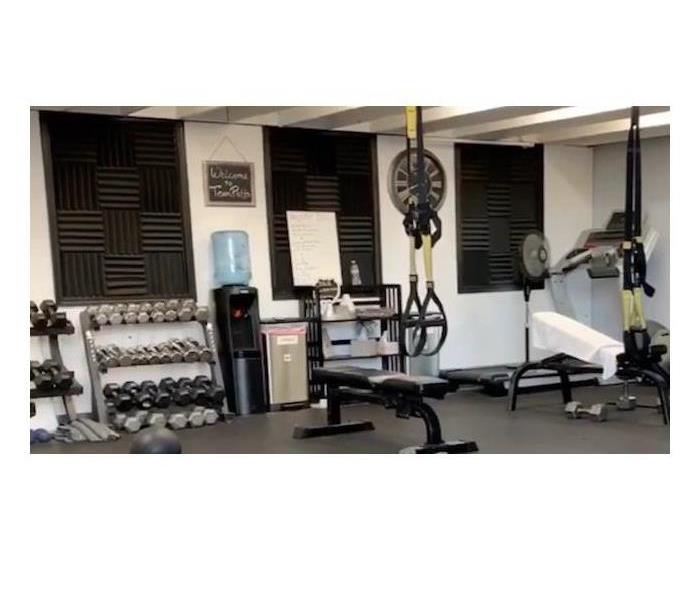 Free weights, weight machines, and exercise mats are all handled by so many people all loaded with germs that can lead to viruses. Let SERVPRO Help!
Free weights, weight machines, and exercise mats are all handled by so many people all loaded with germs that can lead to viruses. Let SERVPRO Help!
As gyms and workout facilities start to open back up, gym-goers will be eager to get back into their workout routine.
Before letting your members back into your doors, make sure that your gym is prepared for post-pandemic response to protect your staff and members.
According to the CDC, the virus is thought to spread mainly from person-to-person. This could be between people who are in close contact with one another (within about 6 feet) or through respiratory droplets produced when an infected person coughs or sneezes. These droplets can land in the mouths or noses of people who are nearby or possibly be inhaled into the lungs. It may be possible that a person can get COVID-19 by touching a surface or object that has the virus on it and then touching their own mouth, nose, or possibly their eyes, but this is not thought to be the main way the virus spreads.
Gyms are hotbeds of germ activity because of people being so close together and constantly using the same equipment. By implementing enhanced disinfection guidelines in your gym, you can help minimize the spread of germs.
Germ Hot Spots:
- Free weights
- Weight machines
- Exercise balls
- Exercise mats
- Cardio machines
Free weights, weight machines, exercise balls, and exercise mats are all handled by so many people that the equipment is loaded with germs that can lead to viruses like COVID-19 among other illnesses. As gym-goers start to use this equipment, they could be holding or lying on a slew of germs. According to a survey of over 1,000 gym-goers, 31.1% admitted they do not wipe down equipment after use.
Wiping down equipment is not a new gym policy by any means, but to help your members keep peace of mind, read and enforce the tips below:
- Provide hand sanitizer (at least 60% of alcohol) throughout the facility and require members to sanitize hands
- At facility entrance, or before beginning fitness activities.
- After using each piece of equipment.
- Upon completing their fitness routine and leaving.
- Provide disinfecting wipes for members to wipe down equipment surfaces that are in direct contact with skin after each use. Surfaces include:
- Hand grips on cardio equipment (treadmills, bicycles, ellipticals, stair-steppers).
- Hands grips on dumbbells, weight bars, and other strength-training systems.
- Pads/cushioned components (fitness mats, bike seats, lifting benches)
- Fitness balls, rope handles and other fitness equipment.
- Any U.S. Environmental Protection Agency EPA-registered antimicrobial wipes are appropriate for performing individual wipe-down between uses.
- Consider Benefect Botanical Disinfectant Wipes
- Perform a thorough cleaning and disinfection of all skin-contact surfaces of equipment at the end of the day using an EPA-registered disinfectant.
- Currently there are no disinfectants that have been tested specifically for this particular emerging viral pathogen. The CDC recommends usage of a labeled Hospital Grade disinfectant with claims against viruses similar to SARS-CoV-2.
Reopen with a Professional Deep Clean
Now, more than ever, it is important to provide a safe, clean environment for your staff and members. Bring them peace of mind by having your gym sanitized and disinfected by SERVPRO. Our cleanup procedures generally include cleaning of porous and non-porous surfaces, disinfecting of non-porous surfaces, cleaning and disinfecting of equipment, tools, and/or supplies used for cleanup process, and disposal of waste.
SERVPROXIDE™, SERVPRO’s proprietary disinfectant, is a hospital-grade disinfectant that has demonstrated effectiveness against viruses similar to COVID-19 on hard, non-porous surfaces. As mentioned before, there are no disinfectants that have been tested specifically for this particular emerging viral pathogen. However, per the CDC, this product can be used against COVID-19. Porous materials like carpet, rugs, upholstered items, and draperies that are not water sensitive can also be wet cleaned using SERVPROXIDE™.
If you are interested in inquiring about our services we’re here to help – 24 hours a day, seven days a week, please do not hesitate to call us 951-351-8033.
Can you Clean Porous Materials as you do Non-porous Surfaces?
5/27/2020 (Permalink)
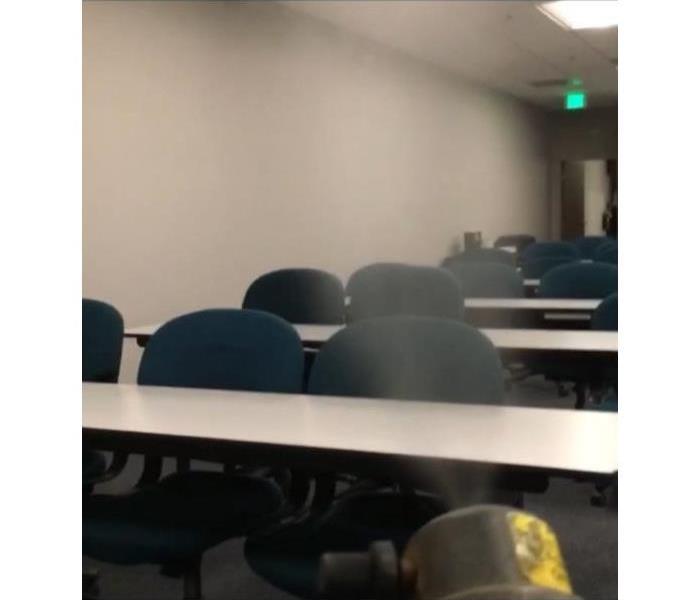 Here we use we used a ULV fogger that can mist the disinfectant to as small as 20 microns in size to get into hard to reach areas.
Here we use we used a ULV fogger that can mist the disinfectant to as small as 20 microns in size to get into hard to reach areas.
The CDC describes cleaning as removing germs, dirt, and impurities from surfaces or objects.
The CDC describes cleaning as removing germs, dirt, and impurities from surfaces or objects. Cleaning works by using a detergent and water to physically remove germs from surfaces. This process does not necessarily kill germs, but by removing them, it lowers their numbers and the risk of spreading infection.
Some materials cannot be cleaned with detergent and water without being damaged. For this reason, paper and paper products are not able to be cleaned and/or disinfected. Cleaning methods typically used on water sensitive materials such as vacuuming or dry sponging would not be capable of removing enough soil and residue to be effective.
Porous materials like carpet, area rugs, upholstered items, and draperies that are not water sensitive, can be wet cleaned using a Hot Water Extraction or Deluxe Preconditioner and Rinse method. Carpets can also be sanitized with SERVPROXIDE™ (product #100) following label directions, if needed.
Non-porous materials like hard surface floors, cabinets, countertops, doorknobs, and plumbing fixtures can be wet cleaned using a variety of SERVPRO hard surface cleaners (general purpose cleaners) and cleaning methods.
Disinfecting of Non-porous Surfaces
The CDC describes disinfecting as killing germs on surfaces or objects. Disinfecting works by using chemicals to kill germs on surfaces or objects. This process does not necessarily clean dirty surfaces or remove germs, but by killing germs on a surface after cleaning, it can further lower the risk of spreading infection.
Not all surfaces can be disinfected. Because of the porosity of some materials, disinfection is not possible. This includes carpet, area rugs, upholstered items, and draperies.
Non-porous materials like hard surface floors, cabinets, countertops, doorknobs, and plumbing fixtures can be disinfected using a variety of disinfectants within the SERVPRO product line.
Currently there are no disinfectants that have been tested specifically for this particular emerging viral pathogen. The CDC recommends usage of a labeled Hospital Grade disinfectant with claims against viruses similar to SARS-CoV-2.
SERVPROXIDE™ (product #100) is a hospital-grade disinfectant that has demonstrated effectiveness against viruses similar to SARS-CoV-2 on hard, non-porous surfaces. Per the CDC, this product can be used against SARS-CoV-2 when used in accordance with the directions for use against Norovirus Feline Calicivirus and Canine Parvovirus, Strain Cornell-780916, ATCC VR2016 on hard, non-porous surfaces. In addition, SERVPROXIDE™ currently has EPA-approved claims for Feline coronavirus (Strain WSU 79-1683, ATCC VR 989) and Canine coronavirus (Strain 1-71, ATCC VR-809). As with all emerging-type pathogens, proper PPE use is of the utmost importance.
SERVPROXIDE™ should be used in accordance with label directions.
These disinfectants are normally applied using a spray bottle, pump-up sprayer, electric sprayer, or ULV Mister and must dwell on the surface for 10 minutes. Once again, follow label directions for the specific disinfectant being used.
The CDC encourages the use of disinfecting wipes on electronic items that are touched often, such as phones and computers. Pay close attention to the directions for using disinfecting wipes. It may be necessary to use more than one wipe to keep the surface wet for the stated length of contact time. Make sure that the electronics can withstand the use of liquids for cleaning and disinfecting. Consider Benefect Botanical Disinfectant Wipes for this purpose.
For more information about our Proactive Cleaning Services, call us at 951-351-8033!
Certified: SERVPRO Cleaned – a defensive cleaning program
5/25/2020 (Permalink)
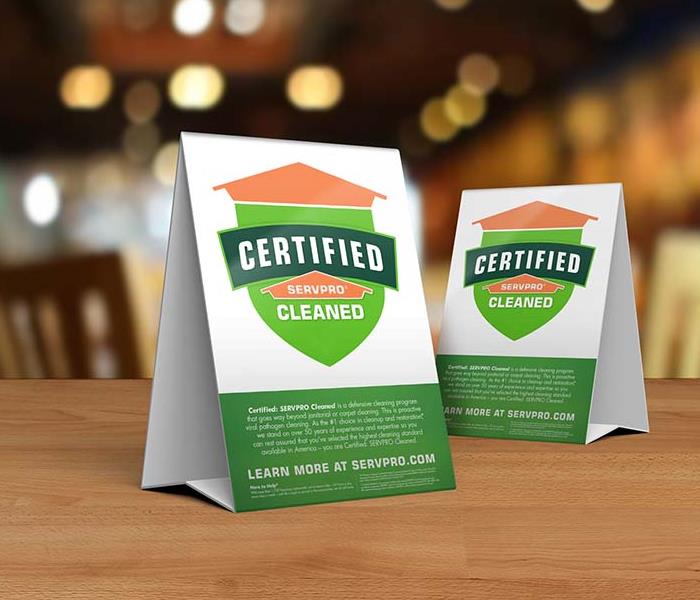 Our defensive cleaning program gives your business a way forward by providing your employees and customers ongoing safety and assuredness.
Our defensive cleaning program gives your business a way forward by providing your employees and customers ongoing safety and assuredness.
Let us help you get back to business
As our communities re-open, we’re all moving back toward a new kind of normal. The expectations of visitors, customers, and employees who come into our establishments have evolved, and staying safe and well is a top concern. The global COVID-19 pandemic has changed what it means to be clean, and we’ve developed a program to help your business meet the new higher standard of clean that is now expected.
Certified: SERVPRO Cleaned is a defensive cleaning program we’re offering to businesses and commercial locations to address the current COVID-19 pandemic. This proactive viral pathogen cleaning program goes well beyond janitorial or carpet cleaning. By choosing Certified: SERVPRO Cleaned, you, your employees, your customers, and your community can rest assured that you’ve selected a higher cleaning standard – you are Certified: SERVPRO Cleaned.
Extensive training and specialized products
As the #1 choice in cleanup and restoration*, we stand on more than 50 years of experience and expertise to help your business become Certified: SERVPRO Cleaned. Beyond fire & water, SERVPRO professionals are trained and experienced in biohazard decontamination and chemical spills – always adhering to the cleaning and decontamination standards set by the Centers for Disease Control and Prevention and local authorities.
From formulating and creating our proprietary cleaning products, like SERVPROXIDE, at our headquarters in Gallatin, TN, to taking the utmost care while disinfecting, we will ensure you and your business are set up to inspire consumer confidence as the economy continues to reopen.
3 C’s – Consult, Clean, and Certify
When the stakes are this high, you want a partner who has developed an industry leading, proprietary training program, cleaning solutions, and remediation processes over decades. We’ve cleaned up some of the most challenging biohazards imaginable. Certified: SERVPRO Cleaned reflects our unique experiences and capabilities. The program is grounded with our unique 3 C’s: Consult, Clean, and Certify.
- Consult – Every business is different, which is why you’ll be assigned a Cleaning Protocol Consultant who understands your business and will create a cleaning program to meet your specific needs. This program will be developed based on your business type, size of space, amount of high frequency touchpoints, foot traffic and congestion points.
- Clean – Based on your specific business needs, your location will undergo a thorough, deep clean, using exclusive cleaning products, according to protocols set forth by the CDC. Our employees have years of experience, and we will go beyond the scope of work that regular janitorial staff perform. Cleanup procedures generally include cleaning of porous and non-porous surfaces, disinfecting of non-porous surfaces, cleaning and disinfecting of equipment, tools, and/or supplies used for cleanup process, and disposal of hazardous materials. In the event of a suspected or confirmed COVID-19 event, we will be there cleaning within 24 hours to ensure you get back to business as quickly as possible.
- Certify - Once your business location has been Certified: SERVPRO Cleaned, you will gain access to proprietary signage, digital emblems, and other collateral that communicates that you’ve selected a higher standard of clean available to help protect your employees and customers. And because we add the day, month, and year to that proprietary stamp of clean, your guests will know that not only did you choose Certified: SERVPRO Cleaned, but that your location is being cleaned regularly at this standard.
Call today for a Certified: SERVPRO Cleaned consultation
We’re Here to Help – 24 hours a day, seven days a week – until life is back to normal in the communities we all call home.
Call SERVPRO of West Riverside City today at 951-351-8033 for your Certified: SERVPRO Cleaned consultation.
* #1 Choice in cleanup & restoration based Commercial Attitude & Usage Tracking study. Polling 816 commercial business decision makers on first choice for future needs related to cleanup & restoration work. Study conducted by C&R Research: October 2019
Certified: SERVPRO Cleaned means professionally trained SERVPRO franchises perform the requested cleaning, sanitizing and disinfection services according to proprietary SERVPRO protocols and recognized industry and CDC standards with EPA approved cleaning products to deliver a SERVPRO certified cleaning experience. Each SERVPRO franchise is independently owned and operated.
Riverside can Trust SERVPRO to Help Disinfect Schools and Universities
5/20/2020 (Permalink)
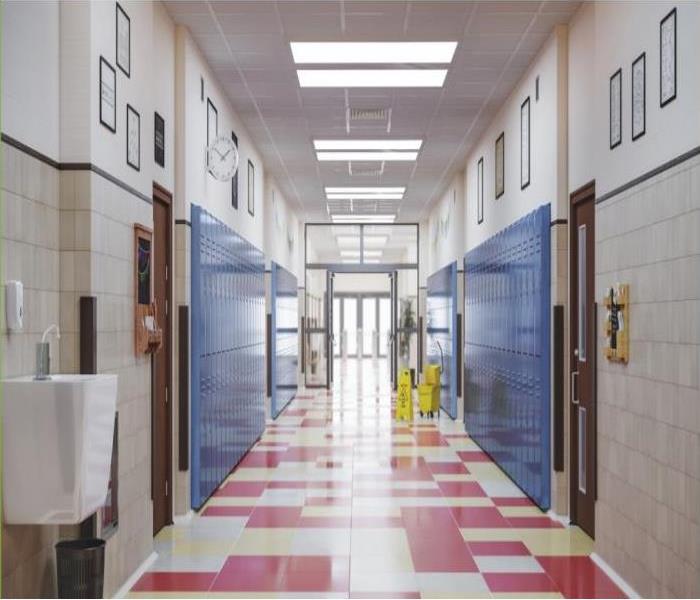 You can count on SERVPRO of West Riverside to Clean and Sanitize Riverside Schools and Universities! Call us 951-351-8033
You can count on SERVPRO of West Riverside to Clean and Sanitize Riverside Schools and Universities! Call us 951-351-8033
COVID-19 has taken the world by surprise and it is still unknown how much longer the pandemic will last.
Riverside has been hit by the coronavirus and has made many residents frightened and worried about their safety.
Those in charge of public spaces everywhere are responding to the pandemic threat by canceling events, recommending “social distancing,” and reminding people of best practices in hygiene.
In March, Riverside schools and universities closed as a precautionary measure. It is unknown what impact there will be, but there are things we can do to be proactive before opening schools and universities back up/The World Health Organization released an advisory for schools that remain open to:
Inform students on how to protect themselves.Promote best practices with hygiene like handwashing.Cleaning & disinfecting school facilities (especially water & sanitation).Increasing airflow and ventilation.When it comes to preventing the spread of this virus, it is up to us as a community to do the best we can to remain informed and act with thoughtful consideration.
Students and their parents trust administrators to address public health issues and we are here to offer our school cleaning services to help you put together an action plan that includes decontamination.
Cleanliness is how to best be proactive and we are here to help. We are prepared to clean and disinfect your school or university, according to protocols set forth by the Centers for Disease Control and Prevention. We have years of experience in dealing with biological contaminants, and we will go beyond the scope of work that regular janitorial staff perform on a daily basis.
SERVPRO Response to COVID-19
Bring them peace of mind to your students and their families by having your school or university sanitized and disinfected by SERVPRO. Our cleanup procedures generally include cleaning of porous and non-porous surfaces, disinfecting of non-porous surfaces, cleaning and disinfecting of equipment, tools, and/or supplies used for cleanup process, and disposal of waste.
The CDC recommends usage of a labeled hospital-grade disinfectant with claims against similar pathogens to the coronavirus. Multiple products in the SERVPRO product line carry the EPA-approved emerging pathogens claims. While there is currently no product tested against this particular strain of the coronavirus, we are following all guidelines as provided by the CDC and local authorities.
Trust your certified SERVPRO cleanup and sanitization experts and give us a call today!
SERVPRO of West Riverside City 951-351-8033
Protect Your Riverside Childcare Workers and the Children they Care For
5/18/2020 (Permalink)
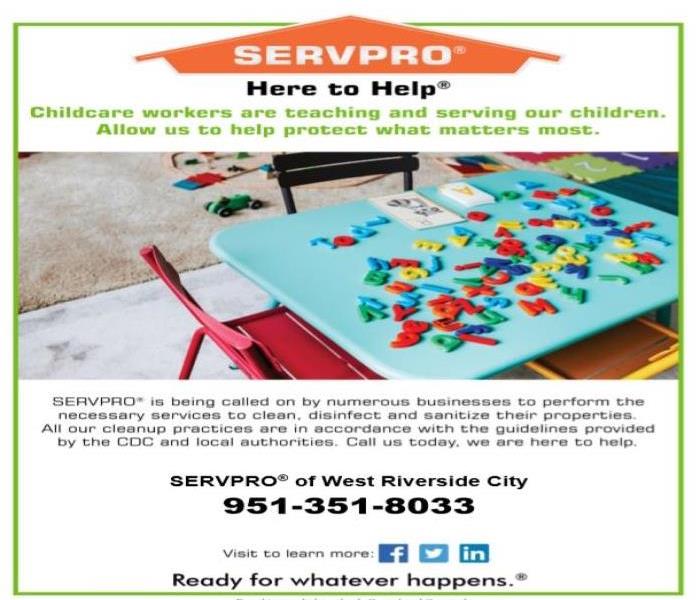 Here to help childcare workers and children attending daycares, we can clean and sanitize your facility!
Here to help childcare workers and children attending daycares, we can clean and sanitize your facility!
As we prepare to slowly start opening businesses, we all want to make sure that buildings are cleaned and sanitized, especially those with our little ones in it.
When returning to work, no parent should have to stress about their children being safe while at a childcare program such as daycare. It is imperative to ensure that all high-touch surfaces and areas are cleaned and disinfected before children come in.
Areas that should be cleaned include:
-Offices
-Playrooms
-Cribs
-Bedding
-Bathrooms
-Common play areas
High-touch surfaces include:
-Doorknobs
-Counters
-Changing tables
-Toys
-Light switches
-Faucet handles
-Toilets
-Tablets
-Keyboards
-Crib railings
Remember to always clean from the least contaminated areas (light switches, doorknobs) to the most contaminated areas (faucet, toilet, handle).
Daycare Health Strategies:
Daycare staff and parents can promote a healthy environment for children to follow. These healthy learning and play measures include:
-Encourage hand washing with real soap for at least 20 seconds.
-Put hand sanitizer in numerous stations around the facility for daycare workers and older children.
-Provide disinfectant wipes for workers to wipe down items and surfaces such as toys, tables, chairs, learning stations, inside recreational areas, outside playground equipment, and other frequently touched items or surfaces.
-Workers may wear disposable gloves when needed and appropriate.
-Remind parents and workers of daycare sickness policy.
-Coordinate with the facility cleaning team regarding special measures to be taken during flu and cold season or during periods of a significant increase in sickness.
These measures are very simple and can help keep childcare programs happy and healthy. For more information about childcare precautions, visit the CDC.
Need a Professional Deep Clean?
It is never too late to have SERVPRO come into your daycare for disinfecting services. Our team is available 24/7 and is ready to help. Using advanced cleaning technologies, tools, and techniques, we clean to the most thorough standard. For worried parents and staff, you can encourage peace of mind by having a professional deep clean. We are here in your community and here to help. For more information about our cleaning services, call 951-351-8033.
How Can SERVPRO Help Senior Living Facilities in Riverside City
5/13/2020 (Permalink)
 Assisted living workers are serving and caring for our families. Allow us to help protect what matters most.
Assisted living workers are serving and caring for our families. Allow us to help protect what matters most.
With our most vulnerable citizens at risk, SERVPRO and Disaster Recovery Teams have been mobilizing cleaning crews to assisted living and senior nursing homes throughout the state.
Recently, a new strain of the coronavirus, COVID-19, has been in news outlets all over the world. What exactly is COVID-19? Coronavirus disease 2019 (COVID-19) is an infectious disease caused by the severe acute respiratory syndrome coronavirus 2 (SARS-CoV-2).
The disease has spread across the world since 2019, resulting in the 2019–20 coronavirus pandemic. A pandemic is an outbreak of a disease that is found over a wide geographic area and affects a substantial segment of the population.
The Centers for Disease Control (CDC) reports that older adults and people with severe underlying chronic medical conditions like heart or lung disease or diabetes are at a high risk of developing more serious complications from COVID-19.
SERVPRO of West Riverside City recommends that everyone protect themselves and others by following the advice of the CDC. The CDC urges people to immediately incorporate the following practices into their daily lives.
Wash hands often with soap and water or use hand sanitizer.Avoid touching the eyes, nose, and mouth with hands that are unwashed.Avoid close contact with people who are ill.Obtain medical assistance if one becomes sick. Stay home to avoid infecting others.Cover the mouth and nose with a tissue when coughing or sneezing. If a tissue is not available, use the inside of the elbow.Wear a facemask.Clean AND disinfect frequently touched surfaces, at least one or more times daily.Typically, nursing homes and assisted-living centers take very proactive measures to prevent the outbreak and spread of infectious diseases such as the flu. Nursing homes all over the United States have been put on lockdown to keep COVID-19 out of the nursing home environment. Elderly patients who have contracted the virus have been put in quarantine or taken to the hospital. Workers are on high alert during this national state of emergency.
When is it time to call in a professional cleaning service to clean, disinfect, and sanitize a nursing home or assisted living facility?
Seek advice and assistance from a highly trained, well-informed, and experienced cleaning expert to answer this question. The most vulnerable are the elderly who have underlying ailments that compromise their immune system and their respiratory system. A competent cleaning professional can provide prevention strategies for a care facility, as well as a business, daycare, or residence.
People recognize SERVPRO as the industry frontrunner for water damage restoration, fire damage restoration, and disaster recovery. The SERVPRO team also specializes in commercial and residential cleaning at a level that exceeds other cleaning services. Their enhanced cleaning goes beyond the general practices of the janitorial staff. Using advanced cleaning tools, technologies, and techniques, the SERVPRO professionals clean to the deepest level. They follow CDC guidelines and use only safe, hospital-grade cleaning solutions that eliminate germs.
When SERVPRO comes into a facility for a deep clean to address germs and infection, they offer services that include disinfecting all floors and flat surfaces. To remove dust and mites that can cause or worsen a reaction, they clean air ducts, the HVAC system, and blinds. COVID-19 causes inflammation throughout the lungs, so removing dust and other particles that exacerbate inflammation creates a safer environment. Also, SERVPRO can clean drapes, upholstery, and carpet where dust, dirt, and germs hide.
When there has been repeated sickness in a home, sometimes a professional deep-clean response is needed. Removing pathogens (COVID-19) and allergens (dust) might be just what is needed.
When a SERVPRO team leaves a facility, the client can rest assured that their business, home, school, or church is clean, disinfected, and sanitary. SERVPRO professionals have received advanced training in restorations, cleanups, and cleaning maintenance. They are the pros who know how to serve.
SERVPRO of West Riverside City can help with following facilities.
Types of Facilities:
HospitalsAssisted Living CentersOutpatient Surgical CentersElectronics and Machine RestorationHospice FacilitiesSenior Living FacilitiesMedical Office BuildingsOur professionals are available 24-7/365 to help remediate any damage, regardless of the cause, scale of the loss, or the size of your facility.
We are here to help! Call us at 951-351-8033.
What Precautions is SERVPRO of West Riverside Taking
5/12/2020 (Permalink)
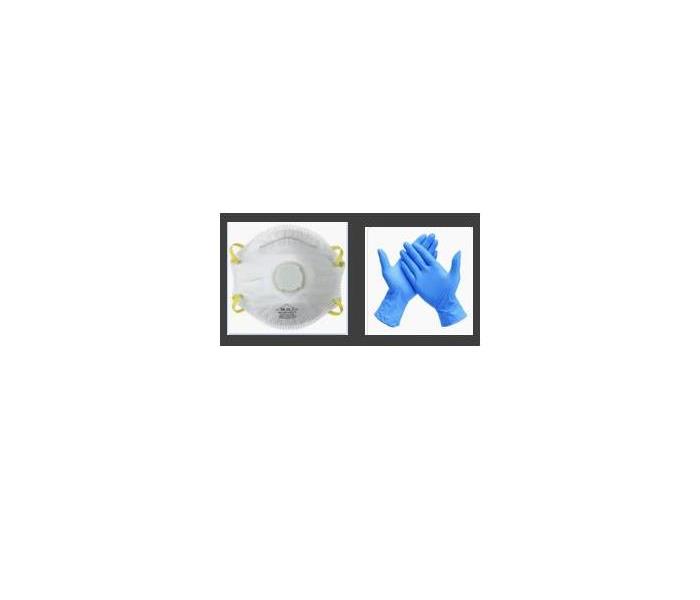 To protect our employees and our customers, we are required to wear appropriate personal protective equipment.
To protect our employees and our customers, we are required to wear appropriate personal protective equipment.
During this pandemic many are already feeling the effects of stress, and throw in the added stress of water damage from rainfall leaks is highly distressing.
Niki of Kulture Konnect contacted us regarding water damage due to extended rain, to inspect the damage of both her home and business properties. A concern of hers was allowing service people into her home while having two kids in the home with the stay at home order. We assured Niki that we would take all necessary precautions.
What precautions is SERVPRO taking due to COVID-19?
In these times of stress and uncertainty, the threat of COVID-19 has many insureds unwilling to allow service providers into their home or business. The number one priority at SERVPRO is safety. All SERVPRO processes, procedures, and cleaning products adhere to and follow applicable CDC, EPA, and industry guidelines.
To protect our customers and our employees, SERVPRO franchises, which are independently owned and operated, are required to wear PPE (Personal Protective Equipment) when entering a customer’s home to provide services. This protocol is relevant for services on ALL types of losses: water, fire, smoke, contents, cleanup, etc.
To protect our employees and our customers, we are required to wear (at minimum) the following PPE when entering a customer’s home, regardless of what service we are providing:
- Respiratory protection
- Gloves
- Goggles
As an additional safety precaution, all equipment used is cleaned and decontaminated after EVERY job to help assure the equipment coming into your customer’s home is contaminant-free.
When it comes to disinfection and sanitization, SERVPRO of West Riverside cleanup practices follow applicable CDC guidelines and use EPA-approved products. We are here to help protect you and your family – 24 hours a day, seven days a week – until life is back to normal in the communities we all call home.
SERVPRO = Peace of Mind
During these unprecedented times, SERVPRO of West Riverside City remains open and we are actively on the front lines responding to emergency service needs in addition the needs of our customers.
We have years of experience in biological hazards. We understand our customer’s concerns and have standard operating procedures in place to protect both our customers and our employees
Our procedures and products all adhere to CDC and EPA Guidelines.
Now, more than ever we are Here to Help! Trust your certified SERVPRO cleanup and sanitization experts. Health and safety are key during these pandemic times.
Call us 951-351-8033
Heavy Rains in March caused Water Damage in nearby Riverside City
5/11/2020 (Permalink)
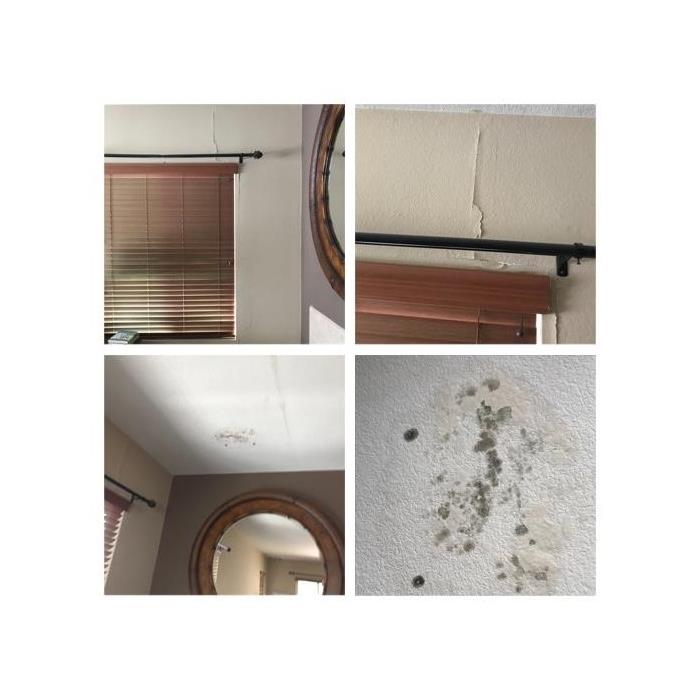 This was the damage that resulted from a water leak from rain last month.
This was the damage that resulted from a water leak from rain last month.
Rainfall and colder than usual weather going into March, is not something Californians are used to.
Californians experienced wetter than normal conditions into March that led us into our Stay-at-Home order. Many experienced water leaks and flooding due to this rainfall. One home owner, and business owner of Kulture Konnect, felt the effects at her place of business and also at her home.
Niki's work location began with a leak and turned into a stream of water coming through her office ceiling panels. SERVPRO of West Riverside City, inspected the leak and provided guidance. As for her home, we were able to inspect using photos, then performed an onsite inspection. Why address water damage right away?
The initial dangers of a roof leak are damage to the attic area. If there is no attic, or the size of the leak is really big, it will damage the interior ceiling. Affected ceiling paint will darken and ceiling plaster may bubble and expand. The leaking water will also damage paint and plaster on nearby walls. You can also expect damage on ceiling-mounted lights and fans.
Did you know that secondary damage can occur after water damage in your home or commercial building? If water damage is not properly treated, the perfect environment is created for mold spores to grow in your home and to contaminate the air that is breathed.
After water leaks, a home or business can develop mold from the moisture. Black mold is the most common type resulting from chronic water intrusion. Toxic black mold growth is rare, but even non-toxic, black mold attacks wood framing, ceiling tiles, walls and floor coverings. Mold is difficult to get rid of, and can be costly.
A roof leak repair should take the highest priority on your list of home maintenance issues.
It is crucial that the source of the leak is fixed to make sure that it does not happen again.
It may be hard to identify but this is one of the most important steps of restoration.
Roofing leaks can develop for a variety of reasons: improper roof installation, wind or storm damage, and lack of maintenance. Keep in mind that most roofs are only meant to last 20 to 30 years so it could simply be time to replace your roof.
SERVPRO of West Riverside City strives to prevent secondary damage every time we remediate water damage. Building material and flooring are dried and treated to prevent mold and other allergens/contaminates using specialized equipment and cleaning products.
In Niki's home SERVPRO of West Riverside City contained the area to begin the drying process. We use scientific drying methods to draw remaining water and moisture from your property with air movers and dehumidifiers. Then we clean and sanitize. Water damage also affects your belongings, like furniture, clothing, and personal items. SERVPRO of West Riverside can clean restorable items using a number of specialized cleaning techniques. We also sanitize with antimicrobial treatments and remove odors using industrial air scrubbers and fogging equipment.
Our SERVPRO of West Riverside City team can work directly with your insurance provider to make the claim process simple. We achieve that by recording essential details and communicating with the insurance adjuster throughout the process. We also understand the importance of letting our customers know everything about the procedures we use during the restoration process.
When your residential or commercial property experiences a water damage incident, call SERVPRO of West Riverside City to know your options. We offer emergency cleaning and restoration services at any time of the day or night, call (951) 351-8033 to work with our experienced technicians.
If you would like more information on how SERVPRO can help you, visit our website, we're available for your emergency needs 24 hours a day 7 days a week, including holidays! We are local to Riverside and ready to help.
About Kulture Konnect
If you would like to learn more about Kulture Konnect and how they can help your business, visit their website or their Facebook page. They are amazing and offer Full design service, Websites, Social Media Management!
"Kulture Konnect can serve as your design and marketing department taking care of all – or complementing your internal – graphic design and marketing efforts. We are confident that our expertise in graphic design services like branding, print, website design and development, blogging, email marketing, SEO, content marketing, social media marketing, infographic design, e-book design and more will allow us to provide you with a complete and positive experience. Less"
If you're re-opening your business and need some assistance, don't hesitate to reach out to them!
Are You Feeling the Effects of Dry Hands?
5/6/2020 (Permalink)
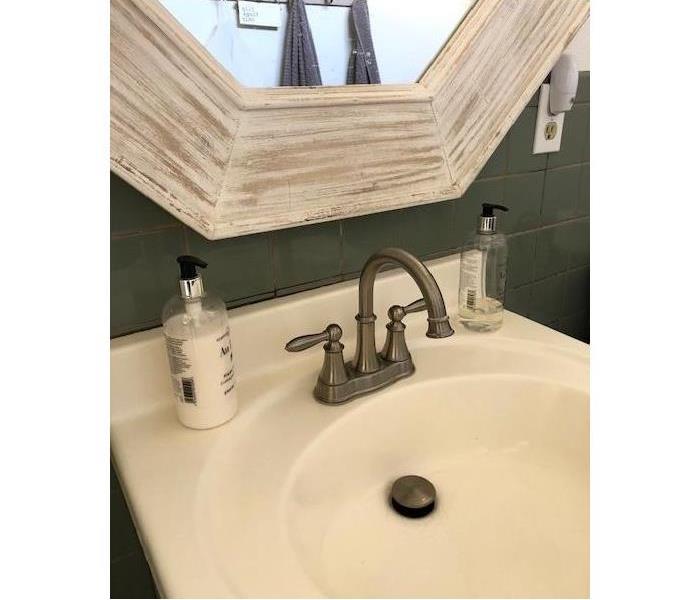 Along with hand soap keep hand lotion, or better yet, hand cream at every sink to prevent dry hands.
Along with hand soap keep hand lotion, or better yet, hand cream at every sink to prevent dry hands.
We hear of many complaining of dry cracked hands as a result of measures we need to take. We are urged to follow the direction from CDC and health officials who have emphasized that regular hand washing is imperative to helping curb the spread of COVID-19.
In this blog we will discuss the follow: When do I need to wash my hands? Tips from AAD on how to reduce risk of dry, chapped hands. And what types of hand soaps and hand moisturizers should we look for?
When do I need to wash my hands?
Handwashing throughout the day is important, but even more important during an outbreak. Always remember to wash your hands in these situations:
After returning from a public outing (grocery store, work, school, concert, sporting activity, hospital, nursing home, etc.).
Before leaving the bathroom — both at home and in public bathrooms.
After shaking hands during flu season and virus outbreaks.
Before, during, and after preparing food, especially raw food.
Before eating food.
Before and after caring for someone at home who is sick with symptoms of vomiting or diarrhea.
Before and after treating a cut or wound.
After changing diapers or cleaning up a child who has used the toilet.
After blowing your nose, coughing, or sneezing.
After touching an animal, animal feed, or animal waste.
After handling pet food or pet treats.
After touching garbage.
After putting on your shoes.
After using public computers, touching public tables and countertops, cash and coins, other people’s phones, etc.
Tips From AAD
Don’t let dry cracked skin stop you from washing your hands regularly or from washing them at least 20 seconds. We found tips from American Academy of Dermatology Association (AAD).
We naturally have oils and wax on the outer layer of our skin which shields and guards our skin. This maintains natural moisture. With the increase of washing our hands with hand soap and the use of alcohol based sanitizers, this causes a break down of this barrier causing dry, cracked hands.
To reduce your risk of dry, cracked skin from handwashing, follow these tips from board-certified dermatologists:
- Use lukewarm water
Not hot water, for at least 20 seconds, patting your hands dry with a towel.
- Moisturize immediately after washing your hands.
- Pat your hands dry, then rub a pea-sized amount of moisturizer over your hands.
- Use moisturizers with mineral oil or petrolatum.
- Look for ointments and creams — the ones you squeeze out of a tube — as these are more effective than products you pump out of a bottle.
- Choose fragrance- and dye-free moisturizers.
- These are less irritating for your skin.
- When soap and water aren’t available, use hand sanitizer.
- The CDC recommends using hand sanitizer with at least 60% alcohol. Since these can be drying, apply moisturizer after your hands dry.
- Continue washing your hands, even if they feel dry.
- Washing your hands can remove harmful bacteria and viruses.
Don’t believe everything you hear or see online. Using moisturizer after washing your hands does NOT negate your hand washing efforts, and there is NO evidence that using hand sanitizer makes you more vulnerable to infections or viruses.
What Types of hand soaps and hand creams should we look for? uclahealth.org helps us with some tips:
How should we wash our hands to avoid skin dryness?
Apply enough mild, fragrance-free soap to remove dirt, but avoid using so much that it creates a thick lather—this washes away natural oils. Wash with warm, not hot water, for at least 20 seconds, patting your hands dry with a towel. Once your hands are dry, apply a moisturizer immediately. Keep small travel sizes of creams in purse, gym bag, and at your work desk to make sure it is within reach.
Are there any ingredients people should avoid when their skin is chapped?
Products that contain fragrance can be irritating to chapped, sensitive skin. Creams and ointments are better than lotions. Hand sanitizers with too much alcohol can be drying to chapped skin. You can try a hand sanitizer with a moisturizing base, just know that it will not be as effective in killing viruses.
Are there common misconceptions about what to look for in hand creams?
Use hand ointment or cream instead of a lotion as these are more effective. Petrolatum (Vaseline) is still the most effective moisturizer out there.
Are there other treatments besides hands creams that people should consider?
At nighttime before going to bed, apply thick moisturizer and then cover with cotton gloves to increase absorption. Beauty product junkies can consider a moisturizing mask for hands. These glove-like masks are applied for 20 minutes, then washed off. Consider a humidifier at night—raising the humidity level in a room can help dry skin.
Again, health and safety are key during these pandemic times. Keep these tips in mind since this will likely be the "new norm" of regularly keeping our hands clean, and for minimum 20 seconds. I use petroleum jelly every night and first thing in the morning. I can see a difference taking these steps. Please be safe!
SERVPRO's Use of Personal Protective Equipment
5/4/2020 (Permalink)
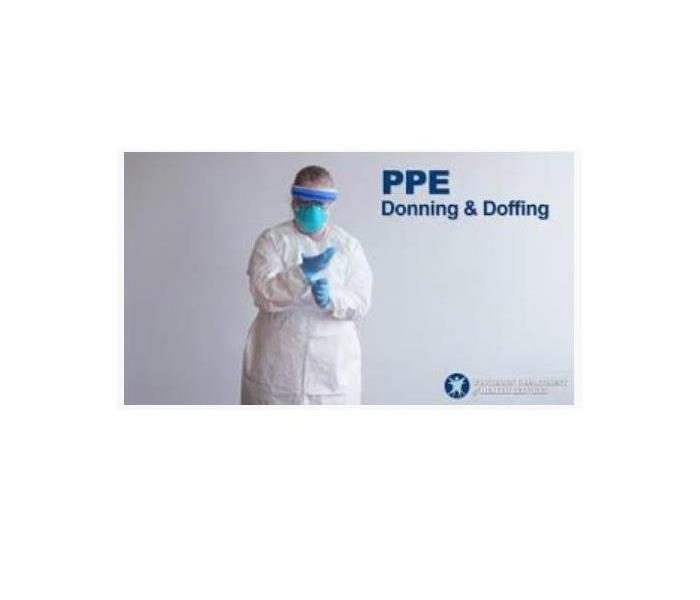 Appropriate use of PPE keeps SERVPRO Technicians safe when performing Sanitizing and Cleaning.
Appropriate use of PPE keeps SERVPRO Technicians safe when performing Sanitizing and Cleaning.
In our line of work, SERVPRO® technicians come into contact with hazards that could cause injury and must use special personal protective equipment or PPE. Some examples of these hazards could be environments with dust, fumes, smoke or some that pose a biological or chemical threat if exposed and viruses. All technicians are trained in identifying when PPE is necessary on a jobsite, what and how to wear each item. It is also extremely important to understand the limitations of the personal protective equipment, useful life and proper disposal procedures.
On a CAT 3 site, you would see the following PPE on a SERVPRO® of West Riverside City technician:
Goggles: to protect technician’s eyes from hazardous materialsRespirator: to protect technician’s lungs from airborne contaminantsSuit/gloves: one-time use, disposable protective wear used to protect the technician’s skin from coming into contact with hazardous materialsCDC outlines how to DON and DOFF Personal Protective Equipment (PPE)
How to Put On (Don) PPE Gear
More than one donning method may be acceptable. Training and practice using your healthcare facility’s procedure is critical. Below is one example of donning.
Identify and gather the proper PPE to don. Ensure choice of gown size is correct (based on training).Perform hand hygiene using hand sanitizer.Put on isolation gown. Tie all of the ties on the gown. Assistance may be needed by other healthcare personnel.Put on NIOSH-approved N95 filtering facepiece respirator or higher (use a facemask if a respirator is not available). If the respirator has a nosepiece, it should be fitted to the nose with both hands, not bent or tented. Do not pinch the nosepiece with one hand. Respirator/facemask should be extended under chin. Both your mouth and nose should be protected. Do not wear respirator/facemask under your chin or store in scrubs pocket between patients.*Respirator: Respirator straps should be placed on crown of head (top strap) and base of neck (bottom strap). Perform a user seal check each time you put on the respirator.Facemask: Mask ties should be secured on crown of head (top tie) and base of neck (bottom tie). If mask has loops, hook them appropriately around your ears.Put on face shield or goggles. Face shields provide full face coverage. Goggles also provide excellent protection for eyes, but fogging is common.Perform hand hygiene before putting on gloves. Gloves should cover the cuff (wrist) of gown.Healthcare personnel may now enter patient room.How to Take Off (Doff) PPE Gear
More than one doffing method may be acceptable. Training and practice using your healthcare facility’s procedure is critical. Below is one example of doffing.
Remove gloves. Ensure glove removal does not cause additional contamination of hands. Gloves can be removed using more than one technique (e.g., glove-in-glove or bird beak).Remove gown. Untie all ties (or unsnap all buttons). Some gown ties can be broken rather than untied. Do so in gentle manner, avoiding a forceful movement. Reach up to the shoulders and carefully pull gown down and away from the body. Rolling the gown down is an acceptable approach. Dispose in trash receptacle. *Healthcare personnel may now exit patient room.Perform hand hygiene.Remove face shield or goggles. Carefully remove face shield or goggles by grabbing the strap and pulling upwards and away from head. Do not touch the front of face shield or goggles.Remove and discard respirator (or facemask if used instead of respirator). Do not touch the front of the respirator or facemask.*Respirator: Remove the bottom strap by touching only the strap and bring it carefully over the head. Grasp the top strap and bring it carefully over the head, and then pull the respirator away from the face without touching the front of the respirator.Facemask: Carefully untie (or unhook from the ears) and pull away from face without touching the front.Perform hand hygiene after removing the respirator/facemask and before putting it on again if your workplace is practicing reuse.** Facilities implementing reuse or extended use of PPE will need to adjust their donning and doffing procedures to accommodate those practices.
Tips for School Age Children while Riverside Schools Remain Closed
4/29/2020 (Permalink)
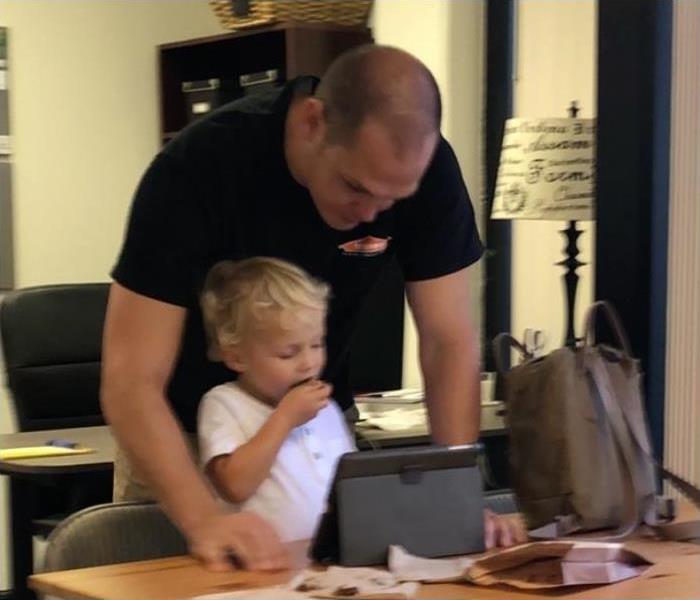 Take a deep breath. Know that we are all in this together. And together we will get through it.
Take a deep breath. Know that we are all in this together. And together we will get through it.
Having school aged children at home during the stay-at-home order can be challenging! But there are some things we can do to help keep children focused on online or virtual school and activities to keep them busy.
Keeping a routine is key
Healthy Children.org recommends the first step: Take a deep breath. Know that we are all in this together. And together we will get through it.
They also recommend to keep a routine. Children thrive with a routine. Daily expectations will keep them on track and focused. Create a daily schedule that can be placed on the refrigerator where they can see it each day. Be sure to include breaks from tele-work or schoolwork to relax and connect with each other. Here are some ideas to help you create a daily schedule:
- Wake up, get dressed and have breakfast at the normal time.
- Decide where everyone can do their work most effectively and without distractions.
- List the times for learning, exercise and breaks.
- For younger children, 20 minutes of class assignments followed by 10 minutes of physical activity might work well.
- Older children and teens may be able to focus on assignments for longer stretches, taking breaks between subjects.
- Include your hours as well, so your children know when the work day is done.
- Schedule time for nutritious lunches and snacks. Many schools are providing take-home school meal packages for students who need them.
- Don't forget afternoon breaks as well!
- Have dinner together as a family and discuss the day.
- Enjoy more family time in the evenings, playing, reading, watching a movie or exercising together.
- Stick with normal bedtime routines as much as possible during the week to make sure everyone gets enough sleep.
CDC recommends keeping children active:
Make physical activity intentional. If you don’t plan it, it probably won’t get done. Dedicate one-hour blocks of time for exercise each morning and afternoon, with ‘free exercise’ outside after ‘school’. For older children and teens, many coaches have been sending home training ideas. Be intentional about this and include it on their daily schedules.
- Encourage your child to play outdoors—it’s great for physical and mental health. Take a walk with your child or go on a bike ride.
- Use indoor activity breaks (like stretch breaks or dance breaks) throughout the day to help your child stay healthy and focused.
- Create Your Own Workout-Create your own “high intensity” workout with your family. Each person chooses their favorite moves, such as lunges, jumping jacks, squats, or even hops. Using a timer, do each workout move for 20 seconds, then take a 10-second break. Do four sets of each move, then take a 30 second break. This “interval training” is fun, fast-paced and really gets hearts pumping!
- Offer a challenge—i.e., challenge your kids to do a certain activity XX number of times, or challenge them to do X in XX number of minutes, with a reward for achieving this.
- Have a dance party
- Start planning your summer garden!
- Create an obstacle course with toys and games from your garage.
- If they play instruments, have them learn new songs.
CDC recommends helping your child stay socially connected
- Reach out to friends and family via phone or video chats.
- Write cards or letters to family members they may not be able to visit.
- Families can connect with Jackbox TV, for great family games.
Players play using their phones, tablets, or even computers as controllers – making it the perfect easy-in entertainment piece for your next game night or party. It can be displayed using Zoom to play with others outside their home.
- Create a scavenger hunt. This can be done several ways. Have neighbors place certain items on their windows for kids to find. You can easily create one in your back yard. It can also be played on Zoom, where a list of items will be called out. Kids have 2 minutes to locate the item in their home… the person with the most items collected from the list is the winner!
- Make dinner as a family; find recipes and tips for cooking with children safely on the Cooking with Kids webpage.
Parents can be creative and be flexible. You have to find a balance that works for your family. The goal should be to stay sane and stay safe.
Understanding Water Damage To Your Riverside Home
4/29/2020 (Permalink)
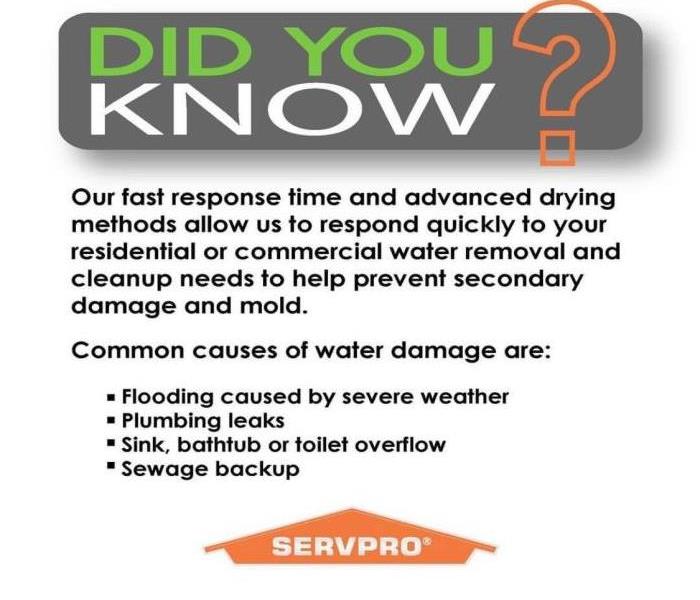 Call SERVPRO of West Riverside City can help with your emergency water damage loss. We are open!
Call SERVPRO of West Riverside City can help with your emergency water damage loss. We are open!
Water Damage: Your Quick Reference Guide
If you're like the majority of Americans, your home is your most valuable possession. As such, you want to do all that you can to protect it against man-made hazards and natural disasters. One of the most severe threats to the structural integrity and safety of your home is water damage. By learning more about what causes water damage in Riverside and how to correct it, you can keep your residential property in great condition:
What Causes Water Damage?
As water damage experts know, there are several factors that can lead to water damage. One of them includes natural disasters like floods and storms. Riverside water damage can also transpire as a result of household factors like cracks in the roof, overflowing washing machines, leaky dishwashers, and broken pipes.
The Effects Of Water Damage
Unfortunately, water damage can have a profoundly negative impact on your property. For example, the water can corrode your home's foundation, baseboards, and drywall. It can also ruin your electronics, appliances, upholstery, and furniture.
According to Insurance Business America, “The number of water damage claims resulting from leaks has surged”.
Water Damage Categories
Generally, water damage is classified into three groups. They include:
Category 1- Category 1 is referred to as clean water. This type of water damage poses no significant harm to you or members of your household. Category 1 water typically results from broken appliances and overflowing sinks.
Category 2- Category 2 water is referred to as grey water. This type results from broken sump pumps and toilets. This water can be contaminated with bacteria and is thus a threat to the safety of you and your loved ones.
Category 3- Category 3 water is water from the sewer. It is contaminated and can have an adverse impact on your health.
Preventing Water Damage
There are several strategies you can implement to prevent water damage from transpiring on your property. Some of them include:
- Elevating appliances
- Tightening faucets
- Shutting off supply valves
Even when you implement strategies to prevent water damage, excess water can erupt on your property at any moment. To ensure that your home is safeguarded against damage from standing water, call the professionals of SERVPRO of West Riverside City.
Our IICRC-certified technicians will provide you with the detail-oriented, client-centered care that keeps you calm throughout the remediation process and leaves you satisfied with the results.
Locally Owned Company with National Resources
As a locally owned and operated business, SERVPRO of West Riverside City is strategically located to respond quickly to your flood and water emergency event. When water damage occurs in Riverside, we have the resources and personnel to help. 951-351-8033
Bring Out That Grill...Safely, While We're Home
4/27/2020 (Permalink)
 Would like more information on hiring a team experienced in Smoke & Fire Damage Restoration? Call SERVPRO of West Riverside City Today 951-351-8033
Would like more information on hiring a team experienced in Smoke & Fire Damage Restoration? Call SERVPRO of West Riverside City Today 951-351-8033
Take advantage of being "safer at home" and bring out those grills! The weather is getting nicer, so being outdoors can be a great stress reliever.
To make sure you have a safe grilling season, we will provide a list of safety precautions, such as how to check your gas lines before you start grilling and where to place your grill. Grilling is supposed to be fun and relaxing. Don't let one grilling mistake ruin your spring!
Before you use your grill:
Check the major connection points between the gas (propane) tank hose and the regulator and cylinder, and where the hose connects to the burners. Tighten if loose.
- Check the gas (propane) tank hose for potential gas leaks. To do that:
- Apply a light soap and water solution to the hose using a brush or spray bottle.
- Turn the propane tank on. If there is a gas leak, the propane will release bubbles around the hose (big enough to see).
- If there are no bubbles, your grill is safe to use.
- If there are bubbles, turn off the tank and check connections If the leaks continue, then have your grill serviced by a professional before using it again.
- If the leak doesn’t stop, call the fire department immediately.
When the grill is on:
- As you are cooking, if you smell gas, turn off the gas tank and burners.
- If the leak stops immediately, get the grill serviced by a professional before using it again.
- If the smell continues, move away from the grill and call the fire department immediately. Do not move the grill.
Charcoal grills
- There are several ways to get the charcoal ready to use. Charcoal chimney starters allow you to start the charcoal using newspaper as a fuel.
- If you use a starter fluid, use only charcoal starter fluid. Never add charcoal fluid or any other flammable liquids to the fire once it starts burning.
- Keep charcoal fluid out of the reach of children and away from heat sources.
- There are also electric charcoal starters, which do not use an open flame. Be sure to use an extension cord rated for outdoor use.
- When you are finished grilling, let the coals completely cool before disposing in a metal container.
By following these steps this will help you have a safe and happy grilling season.
10 Things Never to Do When You Grill
Play it safe and check out these 10 things you should never …
- Never Leave the Grill Unattended
Never walk away from a lighted grill, because the open flames present a fire hazard. Also, for safety's sake, always have a fire extinguisher on hand.
Avoid using metal-bristle brushes to clean your grill grates; the bristles can break off and become lodged in your food. Instead, rely on a wad of aluminum foil, dish scrubbers, or clean damp rags to wipe your grill—preferably while the grates are still warm.
Make sure you have enough propane (or charcoal) to finish cooking your food before you start. Keep a spare full propane tank or bag of charcoal on hand, just in case.
Avoid using lighter fluid or lighter-fluid-infused charcoal briquettes, because the chemicals can impart a nasty flavor to your food. That’s also why you should never use gasoline, kerosene, or oil to start your grill!
Avoid food contamination both on and off the grill by following safe handling procedures: wash your hands, keep the food in the refrigerator until you’re ready to grill, and don't prepare raw meats and vegetables on the same surface. To be sure meats are sufficiently cooked, use a grill-safe thermometer to check that they've reached the proper internal temperature (165 degrees Fahrenheit for poultry, 160 degrees Fahrenheit for ground meat, and 145 degrees Fahrenheit for steaks or roasts).
Don't wear loose clothing, scarves, or dangling jewelry while grilling; these items can potentially catch fire in open flames. If you have long hair, tie it back or tuck it under a hat to avoid singeing your lovely locks.
As tempting and mouthwatering as that just-cooked steak may appear, don’t cut into it immediately, or you'll end up with a dryer, tougher piece of meat. Rest your meat for a few minutes to give the internal juices time to redistribute through the muscle fibers. You'll be rewarded with juicy goodness in every bite.
Be careful not to overcook your meat. Not only does burned barbecue taste unappealing, but it also forms dangerous carcinogenic compounds, known as heterocyclic amines (HCAs), which have been linked to increased risks of pancreatic, colorectal, and prostate cancer.
Never stand directly over a smoky grill, and avoid inhaling the fumes. Grill smoke contains carbon monoxide as well as substances called polycyclic aromatic hydrocarbons (PAHs), which have been linked to increased risk of certain cancers—especially lung cancer.
Grilling under the influence of alcohol can be a recipe for disaster. Wait to pop open a cold one until the grilling and food preparation is complete, then help yourself to a recreational beverage while your meat is resting.
HAPPY GRILLING!!!
If you would like more information on hiring a team experienced in Smoke and Fire Damage Restoration Call SERVPRO of West Riverside City Today at (951) 351-8033
Keeping Your Riverside Workplace Safe and Healthy
4/22/2020 (Permalink)
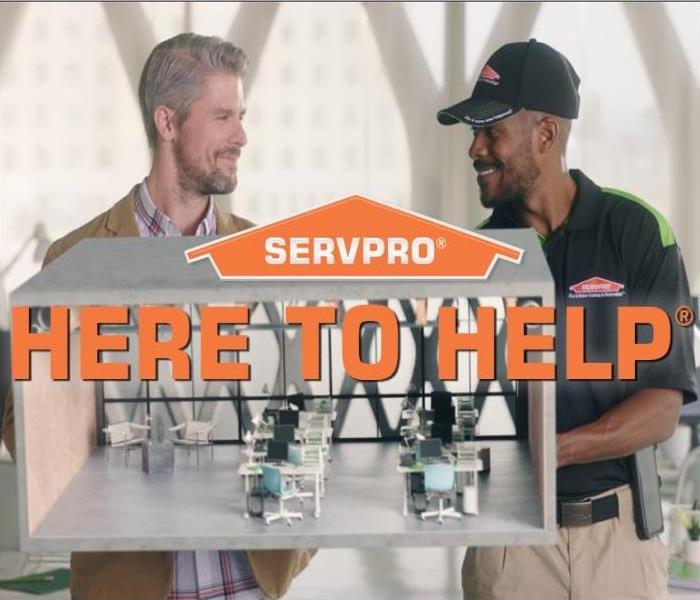 You can count on SERVPRO of West Riverside to follow CDC guidelines when cleaning your property!
You can count on SERVPRO of West Riverside to follow CDC guidelines when cleaning your property!
Workplace Specific Health Strategies
What can employers do to promote a healthy work environment to minimize infectious diseases?
A simple and efficient path to promote workplace health includes the following items:
- Encourage hand washing with real soap for at least 20 seconds.
- Put hand sanitizer in numerous stations around the office or facility.
- Provide disinfectant wipes for employees to wipe down surfaces such as keyboards, mouse, desk, chair, pens, stylus, pencils, touch screens, etc.
- Allow employees to wear disposable gloves.
- Remind employees of the company's sick policy. Sharing virus or Influenza with workspace mates or the production crew could be very costly to all involved parties.
- Coordinate with the facility cleaning team regarding special measures to be taken during flu season or during periods of significant employee sickness.
These measures are very basic yet they go a long way to keep the workplace healthy and happy.
When is the right time to call in a professional cleaning service to clean, disinfect, and sanitize the workplace?
Seeking consultation and assistance from a highly trained, well-informed, and experienced cleaning professional to address workplace health and hygiene is both proactive and pre-emptive. Losing multiple teams or crew members to an outbreak of an infectious disease for a week or two could crush production efficiencies. An office or sales force outbreak could slow or halt sales generation and depress a revenue cycle. The cost of an absentee employee is so much more than paid sick leave.
Qualified cleaning professional like SERVPRO of West Riverside City can provide prevention strategies for a business as well as for a school, daycare or church. People recognize SERVPRO as the industry leader for water and fire damage restoration and disaster recovery. SERVPRO of West Riverside City team also specializes in commercial cleaning at a level that exceeds other cleaning services. Using advanced restoration and cleaning equipment, SERVPRO experts clean to the deepest level.
For a deep clean that can address germs and infection in an office workspace or industrial environment, the team at SERVPRO of West Riverside City offers a comprehensive solution that includes disinfecting all floors and flat surfaces. They can also address the more heavy-duty situations out on the plant floor and in the canteen, showers, and restrooms.
SERVPRO of West Riverside City can make any business look, smell, feeling fresh and clean at the same time making it a sanitary and safe environment. Most people only think of a flooded house, a sewage spill, fire damage, or disaster recovery when they think of SERVPRO. But the professionals at SERVPRO of West Riverside City have been providing deep clean and regular maintenance for businesses, schools, daycares, churches, and homes for decades.
Call SERVPRO of West Riverside City today to schedule your cleaning (951) 351-8033.
Everything That Storm Damage Cleanup Entails for your Riverside Home
4/20/2020 (Permalink)
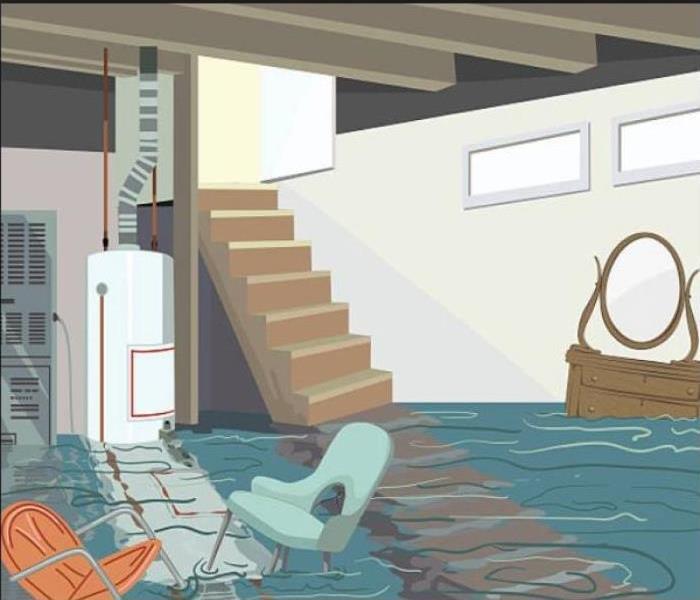 If your Riverside home has faced water damage from a storm, we are here to help. Give us a call and we can provide free inspection.
If your Riverside home has faced water damage from a storm, we are here to help. Give us a call and we can provide free inspection.
After your Riverside neighborhood has been hit by inclement weather, now, to call SERVPRO of West Riverside City professionals to make everything look like new again.
However, do you really understand the steps that will take place? Here’s a quick breakdown of everything that a storm damage cleanup job may entail, from start to finish.
1) An Inspection of the Damage
The first thing that the storm damage cleanup professional at SERVPRO of West Riverside City will do is complete an assessment of damage. They’ll walk through your house and make a note of everything that the storm had affected. Any puddles of water, soaked carpeting, holes in the walls, and more will be thoroughly documented and photographed. The storm damage cleanup team at SERVPRO of West Riverside City will provide you with a punch list of everything that needs to be done. We will also work with your home insurance company to help mitigate the situation. This assessment will contain costs, scope of work description and a timeline.
2) Removing Any Existing Water
After the storm damage cleanup company has received written permission to begin the restoration process Riverside, they will remove all content from the affected area and start the extraction of water that’s in your home. They’ll use special equipment soak up puddles that a simple set of towels cannot handle and ensure that every bit of standing water in your home is removed. They will go through every step necessary to complete this task, including blotting your carpeting and taking care of any sodden curtains. Know that any content damaged Riverside can also be service by SERVPRO.
3) Running a Dehumidifier and Drying Everything Out
Next, the storm damage cleanup crew will set up dehumidifiers for the drying process. They are necessary. The lack of puddles of standing water doesn’t mean that the job is over. Your floorboards, walls, carpeting, ceilings and everything else that received water damage could still be moist. That dampness, when left alone, will lead to mold. It’s SERVPRO of West Riverside City's duty to make sure that this mold doesn’t have a chance to set in, so they’ll go through the additional steps to completely dry every surface.
4) Sanitizing the Space
Once everything is dry, our team will start cleaning and sanitizing. This ensures that things like mold won’t be able to set up shop, so to speak. The storm damage cleanup crew will SERVPRO patented cleaning solutions to kill off any potential germs or irritants lurking in your formerly waterlogged home. This can only be done once all of the water has been removed, and those carpets and walls are now dry.
5) Performing Restoration Services
Finally, the last of the restoration services are completed. This consists of the storm damage cleanup crew going through and repairing holes in the walls and ceiling, replacing broken windows, and even repainting walls, if necessary. They will do everything required in order to make your home look just like it did before the storm – only cleaner. In addition, the best companies take the time to ensure that you’re pleased with the results.
Call SERVPRO of West Riverside City today, if your home has experienced any water damage – large or small! 951-351-8033
Twelve Things You Can Do to Prepare for Spring
4/15/2020 (Permalink)
 Ready to prepare your Riverside home for Spring? These steps can help prevent future issues!
Ready to prepare your Riverside home for Spring? These steps can help prevent future issues!
Done with Winter? Are your Ready to Prep for Spring?
Here are 12 things you can do to prepare your Riverside home.
Clean your rain gutters.
Wind, animals, and gravity bring sticks, leaves, and other organic matter into your rain gutters, and chances are yours have accumulated their share of detritus over the winter. That's bad news for your home: When downspouts are clogged, rainwater can spill out of your gutters and around the perimeter of your house, putting it at risk for leaks and flooding. Get ready for spring showers by removing the mess from your gutters to ensure that the water will flow freely. Change filters.
To maintain optimal air quality in your home, it’s a good idea to replace your HVAC system's air filter seasonally as well as the filter in your kitchen range hood. While you're at it, consider changing the filters in your water purification system. Depending on your water, you might not need to change these as often as your HVAC filters, but it's not a bad idea to check them now. So, go ahead and welcome spring with new filters all around to keep your home clean and fresh, and your appliances in good working order. Need help ? See what SERVPRO of West Riverside City can do to help with our Air Duct and HVAC Cleaning Services.Check vents.
It’s a good time to check any vents along the foundation or in the attic. Look for missing or damaged screens, debris, signs of insect or rodent infestation, or other issues, and correct them before they have a chance to become bigger problems later in the season.Service the Lawn Mower.
Get your lawn mower ready for the season with a tune-up. If you didn’t do it in the fall, now’s the time to drain and replace oil, sharpen the blades, remove caked-on grass and mud, and lubricate moving parts.Prep the gas grill.
After a long winter spent cooped up indoors, you're probably eager for a sunny day and a burger hot off the grill. Get your outdoor cooking station ready for spring by scraping away any rust spots that developed over the winter, cleaning the grill inside and out, and checking the fuel tank hose for damage.Clean Backyard Furniture
As the weather warms up, outdoor entertaining may be just around the corner. Prepare for warmer days ahead by thoroughly hosing down all backyard furniture—chairs, tables, and lounge chairs—wiping away cobwebs, and bringing outdoor chair cushions out of winter storage.Pamper the Lawn
Once the danger of frost has passed and your grass starts to come out of winter dormancy, it’s time to jump-start your spring lawn-care routine. Address winter damage to your turf by seeding bare patches—although if you do reseed at this time of year, you should avoid spring applications of chemical weed or crabgrass treatments, which can harm new grass. Then get a head start on weed prevention by manually removing broad-leaf weeds before they have a chance to multiply. For cool-season grasses, spread a light application of fertilizer in early spring; for warm-season grasses, fertilization can wait until late spring or early summer.Groom Shrubs and Trees
Winter storms can be hard on your landscaping, resulting in broken tree limbs, ragged shrubs, and a garden full of organic debris. Get your yard ready for spring by removing broken or damaged branches, pruning summer-blooming trees and shrubs like butterfly bush and crepe myrtle, and raking up fallen leaves. For information on our Storm Damage services, click here.Check the Roof
Take advantage of the sun’s return to check your roof for cracked or missing shingles or tiles, and examine flashing around vents and the chimney for damage. While you’re at it, have the chimney cleaned and inspected by a professional.Plant Bulbs
Spring is the ideal time to plant summer-blooming flowers, which include beauties like dahlias and gladioli. Go ahead and get them into the ground as soon as the danger of frost has passed.Clean Windows
Winter storms and rain can leave your windows streaked and dirty. Improve your view of mellower weather and let more sun into the house by cleaning windows, both inside and out. Storm Damage ? Click here.Test Alarms
Let the change of season be your reminder to test all smoke alarms and carbon monoxide detectors for proper functioning. Change batteries if necessary. Alarms can malfunction as they age, so if yours are older than seven years, consider replacing them.Happy Spring, Riverside! In need of SERVPRO of West Riverside City services? Questions? Visit our website or call us at - 951-351-8033
Stay Healthy: 6 Tips for Avoiding Cold and Flu
4/13/2020 (Permalink)
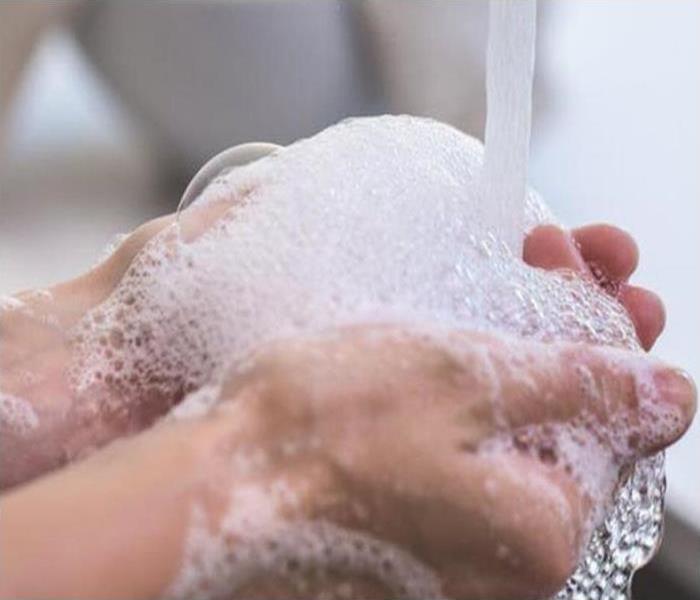 To completely get rid of viruses from your skin, you need to scrub hard for 20 seconds or more.
To completely get rid of viruses from your skin, you need to scrub hard for 20 seconds or more.
People who are exposed to cold and flu germs every day.
Doctors, flight attendants, teachers -- know a thing or two about how to stay healthy when everyone around them is sick. Their suggestions can help you, too.
Get a flu shot. It's the No. 1 thing you can do to prevent the flu.
Wash your hands -- a lot. No matter what line of work you’re in, if you come in contact with people who are contagious, you have to wash your hands over and over, says Alan Pocinki, MD. Pocinki practices internal medicine at the George Washington University Hospital in Washington, DC.
“Wash your hands as much as you can stand, and then some more -- especially after wrapping up a visit with someone who’s sick,” Pocinki says.
It sounds so simple, but soap and water are the constant companions of doctors and nurses. To completely get rid of viruses from your skin, you need to scrub hard for 20 seconds or more. A good way to time yourself is to sing "Happy Birthday" twice while scrubbing the backs of your hands, between your fingers, and under your nails. It doesn't matter if the water's hot or cold -- the very act of scrubbing will physically remove the germs.
Use alcohol-based hand sanitizer. If you can’t get to soap and water, sanitizer can kill cold and flu germs.
Avoid getting close to people who are sick. For example, don't shake hands.
“Doctors tend to be very cautious about hand shaking,” says Terri Remy, MD, medical director of Medical Associates at Beauregard in Alexandria, VA. “Just explain, ‘To keep transmission of colds and flu down, I’m not shaking hands. But hello! Nice to meet you!’ They understand.”
Keep your surroundings clean. Arlington, VA, massage therapist Amanda Long asks clients to stay home if they feel bad. But to be safe, she sanitizes doorknobs and light switches between sessions. It's a practice she swears by.
“My hyper-vigilance has paid off,” Long says. “I was sick more often when I worked in an office, where people pawed into shared candy dishes and generally just mingled in a crowded space without much attention to germs. Now that I don't have sick days, I don't get paid if I don't work. And I know my job is to heal, not pass on a cold or the flu.”
Beth Geoghegan, a paramedic in South Florida, says she starts her day by cleaning her work space with virus-and-germ-killing soaps.
“It may sound like overkill, but it’s not -- it’s awareness,” she says. “It’s a matter of looking at your environment and thinking, 'What could be contaminated?' All it takes is a tiny droplet. What could have a droplet on it? And I know someone was in my ambulance for 12 hours before I got there -- both patients and other paramedics. It may already look clean, but it might not be.”
It’s also a matter of context. When Geoghegan gets home from a shift where nothing much happened, she launches into her normal activities. If it’s been a day filled with sick patients, she follows a different routine.
“If I saw 10 patients today, and eight had flu symptoms, I’m likely to take my uniform off the minute I get home, put it in the wash, and get right in the shower. Because you just never know,” she says.
Keep up a healthy lifestyle. It's important to look after your own health, says Ardis Dee Hoven, MD, an internal medicine and infectious disease specialist in Lexington, KY.
“Do all the things we all should be doing on a daily basis anyway,” Hoven says. “Get adequate rest -- which people underestimate -- get good nutrition, don’t smoke, and keep your allergies controlled, because if they’re out of control, then your upper respiratory tree is already inflamed, which sets it up to more easily acquire a virus.”
How Maintaining your Home can effect your Insurance Coverage
4/8/2020 (Permalink)
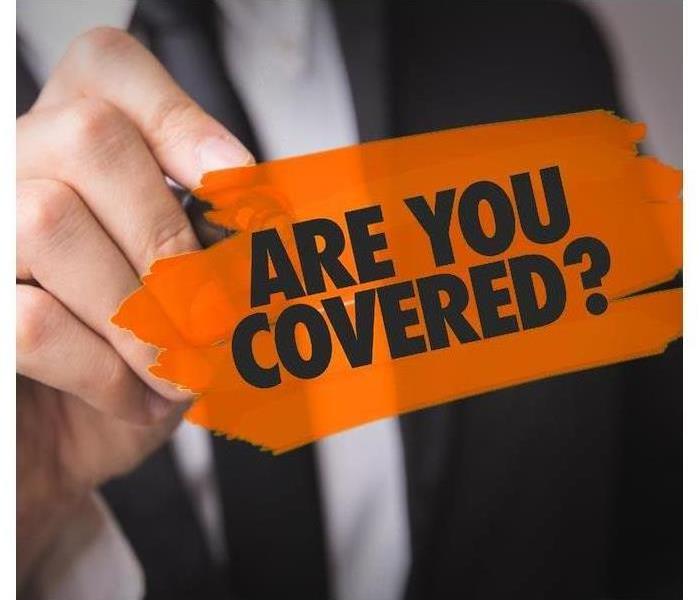 In general, an insurance company is not going to cover claims involving normal wear and tear.
In general, an insurance company is not going to cover claims involving normal wear and tear.
For some folks, insurance is a double-edged sword. They know they need insurance in case there’s a disaster, but they certainly don’t want to be faced with a disaster despite the “investment” in insurance. But, the fact of the matter is it’s a necessity and every homeowner should have it. It is a good thing.
Generally speaking, a covered insurance claim is designed to “make you whole”. In other words, it gets your home to the pre-damage condition. In insurance-speak, this is called indemnity. The problem that arises here is claims can result in higher premiums or possible policy cancellations. There are some situations in which an insurance company may question the validity of a claim:
The costs of repairs or replacement do not exceed the policy deductible.The damage and claim fall underneath the exclusions section of the policy.The damage and claim could’ve been prevented. It’s possible the last point gave you pause. Surely, a natural disaster isn’t preventable. However, let’s say a natural disaster causes damage to a roof that’s in obvious disrepair. This may end up a denied claim. For this reason, we’ve decided to share some preventative measures and fixes that are more cost-effective to handle yourself versus using home insurance.
Take Care of Your Roof
Remember when we mentioned the hypothetical roof problem?
If maintained properly, roofs should last about 25 to 30 years. The first inspection should occur 10 years after installation with additional inspections happening every 3 to 5 years.
As far as what you can do on your end, try to look over your roof at least twice a year. Check for damaged or missing shingles. Also, make sure to clean any gutter guards and downspouts so water can flow easily from the roof.
When it comes to a roof, you typically have a good idea of when to use homeowners insurance. For example, if your roof is in great condition and damage is caused by a what your insurance policy considers a covered peril (i.e. fire, wind, hail, etc.), there’s a decent chance a claim is in order. On the other hand, if the damage is due to wear and tear or poor maintenance, a claim denial may be on the way.
Prevent Water Leaks
At SERVPRO of West Riverside City, we have extensive experience in dealing with water damage. It’s one of the most common house problems out there. Luckily, there are several relatively easy tasks you can take on yourself to prevent a water and insurance mess:
Properly caulk and seal showers and tubs.Inspect pipes for leaks and cracks (have pipes repaired or replaced if needed).In colder temperatures, insulate your pipes.If you use a sump pump, test it every year.Install sewer backwater valves in your drainpipes.It’s worth noting that sewage backup, as well as the replacement and repair of sewer lines, tend to be excluded by insurance companies. But, some companies give the option to add specific endorsements that extend coverage to certain sewer issues.
Maintain Your Water Heater
Here’s the deal, water heater repairs and replacements are not usually covered by insurance. It’s also safe to say that if damage results from an old or malfunctioning water heater, your policy is not going to cover it. You have to stay on top of maintenance and replace equipment when necessary.
Depending on the manufacturer’s recommendations, test your pressure-relief valve and flush the tank on a regular basis. If you hear the unit making loud or strange noises or you see rust-colored water leaking out, there’s probably an issue. Also, if the water heater is around 10 years old, it may be time for a new unit.
Protect Your Foundation
Many insurance policies exclude problems caused by cracks in the foundation which means proper care is key. Ensure the soil around your house slopes away from the foundation (6 inches over a distance of 10 feet). Additionally, safeguard your foundation from excess water by pointing sprinkler systems away from the home.
If you start to notice signs of water in your basement (musty smell or water stains), apply water sealant to the walls and floors. Also, be on the lookout for evidence of mold. If it exists, it may be in your best interest to hire a mold remediation specialist. Mold is a pathogen that can be harmful to your health, so it’s better to be safe than sorry!
Care For Your Appliances and HVAC
In general, an insurance company is not going to cover claims involving the malfunction or the normal wear and tear of HVAC units and appliances. If there are issues, you usually have to either troubleshoot it on your own or hire a technician to make repairs. If your appliances shock you, it may be indicative of an electrical issue. Unless you are an electrician, it’s a smart idea to hire a professional to inspect.
While it’s true there’s not a one-size-fits-all care manual for all appliances and HVAC units, there is one task that’s consistently recommended by all manufacturers: On a regular basis, check for damaged hoses and replace them immediately. With an HVAC unit, don’t forget to replace all the hoses every five years.
Connect With A Professional To Handle Repairs And Inspections
As you’re probably well aware of, insurance companies vary in what they do and don’t cover. It is good to seek advice from an insurance agent or consultant to get a definite answer as to when to use homeowners insurance.
That being said, there is a chance your policy may cover various services offered by fire and water damage restoration companies. While wholly contingent upon the provisions of your policy, there could be coverage for services like biohazard cleanup, mold remediation, and fire and water damage inspection, cleanup, and restoration. It might also provide cover for reconstruction services as well.
How do we know all this? At SERVPRO of West Riverside City, we’ve helped tons of customers navigate insurance claims related to our services. We accept all insurance and work with companies to ensure the claims process and paperwork go as smoothly as possible.
If you’re in the Dallas area and looking for certified professionals who handle fire and water cleanup, look no further! Connect with SERVPRO of West Riverside City today!
JMW Insurance Solutions Provides this Quick Tip
Home Insurance Vs Home Maintenance
Hey Marty Johnson here with JMW Insurance Solutions with a quick tip here for home insurance. Home insurance is designed for catastrophic losses, it's not a home warranty program so you must do your due diligence for normal wear and tear. You need to inspect your house. Check your roof and make sure that the normal wear and tear is being taken care of so when you file a home insurance claim they can't say it's normal wear and tear. I know, we pay our home insurance premium and then we get denied. I get it. keep a repair log for your home. Note the date, time and what you checked. A home insurance repair log of preventive maintenance goes a long way. Have a great day, be kind.
JMW Insurance Solutions Blog
Sewage Cleanup: Why It’s Important to Clean Your System
4/6/2020 (Permalink)
 If you need sewage cleanup services in Riverside, SERVPRO of West Riverside City can help. Contact us today!
If you need sewage cleanup services in Riverside, SERVPRO of West Riverside City can help. Contact us today!
Before the invention of indoor and outdoor plumbing systems, millions of people died from contaminated water and bacterial infections. Luckily, today, these diseases have been mostly eradicated. Plumbing systems work silently in the background to keep us safe, and our homes and communities clean. But what happens when sewage systems back up and sewage cleanup becomes a code red on your to-do list?
Sewage is a bio-hazard and considered a Category 3 Blackwater, posing significant risks to your health. When sewage systems go awry, it must be dealt with efficiently, safely, and fast. Sewage cleanup is a labor-intensive and dangerous job. Homeowners should not attempt to clean up sewage unless it’s a tiny spill. Call a plumber and sewage cleanup specialist as soon as possible if you’re having problems with your system. Here’s what you need to know about caring for your sewage system so that you can prevent costly repairs in the future.
Why is it Important to Clean Your Sewage System Regularly?
For homeowners, plumbing and septic systems are easy to overlook. These critical systems hardly give us any trouble, and it’s easy to forget about them while they work in the background, on autopilot, and silently. Most people don’t even think about their septic system unless something goes wrong. But a malfunctioning septic system can be an absolute nightmare to deal with. Sewage problems are not only costly to fix; they are a hazard to one’s health and property. While your septic system is working below ground to keep you and your home clean and safe, problems could be forming beneath the surface. Regular maintenance can prevent septic issues.
Clean the Drains to Maintain Sewage System Integrity
A clogged pipe is the most common problem that your septic system will face if it’s not maintained correctly. As the months and years pass, debris will build up along the sides of the pipes. If water is taking way too long to drain, it could be indicating either a clogged pipe or a sewer system backup.
A professional should clean and inspect the property’s drains at least every two years. Why, you ask? Well, checking the drains at this interval ensures that any small problems are caught before they become big problems. A clogged drain that goes left unnoticed can cause significant damage to your home if it’s not fixed. Some signs of impending drain trouble include:
Strange noises coming from the drains (such as gurgling or knocking sounds)Sink and shower drains that take too long to workAppliances like dish and clothes washers taking too long to drainWhile it’s a good idea to have a professional inspect the drains every two years, drains can become clogged in between these inspections. Homeowners can take steps to prevent drain issues in the meantime:
Never rinse greasy, oily, or corrosive substances down the drainsDo not flush solid objects down the toilet (paper towels, wipes, etc.)Use natural cleaners to remove minor drain clogsEven wipes that say “flushable” should never be flushed down the toilet. Creating a drain cleaner of baking soda and white vinegar can clear and clean the drains in-between plumbing inspections.
Clean the System to Prevent Bacterial Contamination
If the sewage system gets backed up with clogged pipes and slow drains, bacteria has a perfect pathway into your home. Even if the pipes are only partially blocked, this gives pathogens the ideal environment to grow and multiply. Germs will gather within not just the shower and sink drains, but also in the appliances where you wash your dishes and clothes. In some cases, bacteria can leach out of the sewage system and contaminate the groundwater on your property.
Worst case scenario? The sewage system will completely back up. Wastewater will make its way into your home, contaminating your floors and carpets. If this happens, you’ll need to evacuate the home until a sewage cleanup and restoration specialist and a plumber can fix the damage and decontaminate your house. Sewage backups can destroy a basement or a bathroom.
Clean the Sewage System and Prevent Damaged Drains
A clogged drain will make the plumbing systems corrode much more quickly than usual. With regular septic maintenance, you can extend the life of the pipes. Clogs will corrode the pipes rapidly, causing leaks that may go unnoticed for months. Fixing a leaking pipe takes time and money, and you may end up needing to replace flooring or drywall on top of it.
Another primary source of sewage system issues is pipe damage from tree roots. Tree roots will search for water, breaking through the pipes in search of moisture and nutrients. By regularly inspecting and cleaning your sewer system, you’ll be able to spot these issues before they become major headaches and hits to your wallet.
What do you do if you need sewage cleanup services?
Sewage spills can cause significant damage to your property and pose a health risk to you and your family. You’ll need to contact a sewage cleanup professional in Riverside immediately if your septic system fails. The longer the contaminated water is left to pool in the home, the higher the risk of severe water damage and disease.
How can a professional sewage cleanup specialist help?
Professional sewage cleaners have the skills, knowledge, and equipment to safely and appropriately remove unsafe blackwater from septic failures. They will clean and sanitize the home while decontaminating your property. If the home has water damage issues, a professional can perform necessary water damage restoration throughout the property as needed. In some cases, mold may form and pose another hazard on top of the sewage backup. Professional sewage cleaners can also remove mold and prevent future mold growth, keeping the air you breathe inside the home safe and clean.
If you need sewage cleanup services in Riverside, SERVPRO of West Riverside City can help. Contact us today to restore your home to its original condition.
How can SERVPRO of West Riverside City Help you as Many Remain Isolated?
4/1/2020 (Permalink)
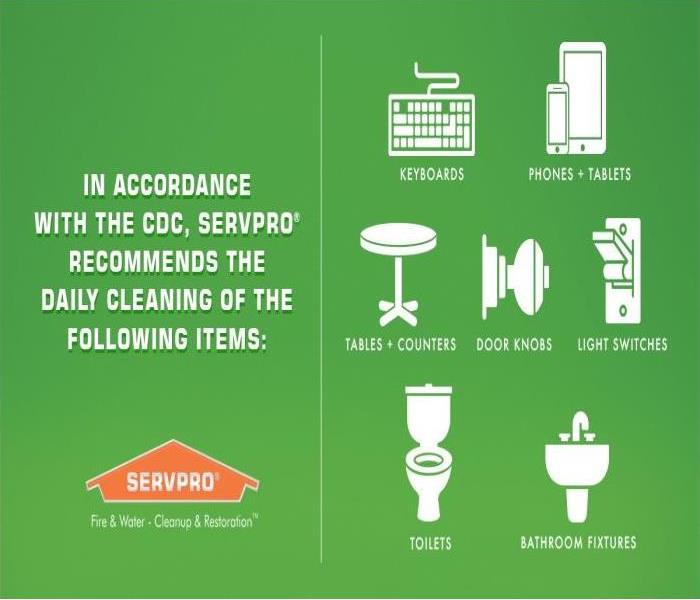 CDC recommends the daily cleaning of: Keyboards, phones/tablets, tables/counters. door knobs, light switches, toilets, & bathroom fixtures.
CDC recommends the daily cleaning of: Keyboards, phones/tablets, tables/counters. door knobs, light switches, toilets, & bathroom fixtures.
We are Cleaning Specialists!
The SERVPRO franchise network plays a vital role in protecting public health and safety. As the current COVID-19 crisis unfolds, orders have been promulgated to shelter in place and limit movements. All of these orders have recognized the vital importance of service providers necessary to maintain the safety, sanitation, and essential operation of critical infrastructure, residences, and businesses. According to the U.S. Department of Homeland Security Guidance on the Essential Critical Infrastructure Workforce dated March 19, 2020, the SERVPRO professional service providers are designated as “essential critical infrastructure workers” under the following provisions:
• Workers such as plumbers, electricians, exterminators, and other services providers who provide services that are necessary to maintain the safety, sanitation, and essential operation of residences;
• Workers to ensure continuity of building functions;
• Workers who support hazardous materials response and cleanup; and
• Workers supporting the operation and maintenance of facilities.
As providers of essential services, the SERVPRO franchise network is prepared to address the most pressing disaster restoration, cleanup, and disinfection issues facing our customers, whether it involves emergency mitigation and recovery, or cleaning and disinfecting homes, schools, healthcare and quarantine facilities, public institutions, and businesses.
SERVPRO is Here to Help during this time of need
This is a reminder to our customers in Riverside and surrounding counties that we are specialists in cleaning services, and we adhere to the highest cleaning and sanitation standards.
Specialized Training
We are prepared to clean and disinfect your home or business, according to protocols set forth by the Centers for Disease Control and Prevention. We have years of experience in dealing with biological contaminants, and we will go beyond the scope of work that regular janitorial staff perform on a daily basis.
The CDC encourages cleaning of high-touch surfaces such as counters, tabletops, doorknobs, light switches, bathroom fixtures, toilets, phones, keyboards, tablets and tables. Other spaces mentioned in the CDC’s guidance for commercial spaces include:
- Kitchen/Food Areas
- Bathrooms
- Schools/Classrooms
- Offices
- Retail Spaces
- Water Fountains
- Shelving/Racks
- Sales Counters
- Carpets and Rugs
- Stair Handrails
- Elevator Cars
- Playground Equipment
- Fitness Equipment
Specialized Products
The CDC recommends usage of a labeled hospital-grade disinfectant with claims against similar pathogens to the coronavirus. Multiple products in the SERVPRO product line carry the EPA-approved emerging pathogens claims. While there is currently no product tested against this particular strain of the coronavirus, we are following all guidelines as provided by the CDC and local authorities.
We are Here to Assist First Responders
Our service is free to First Responders! We have protocols in place and we are here to assist them in any way we can. We are offering to disinfect ambulances and firetrucks as well as anything else.
If you have questions or concerns regarding our Proactive Cleaning, don't hesitate to call us. We can address your concerns.
If your home or business needs deep cleaning services, call the experts today – SERVPRO of West Riverside City 951-351-8033.
Commercial Restoration Company in Riverside City
3/30/2020 (Permalink)
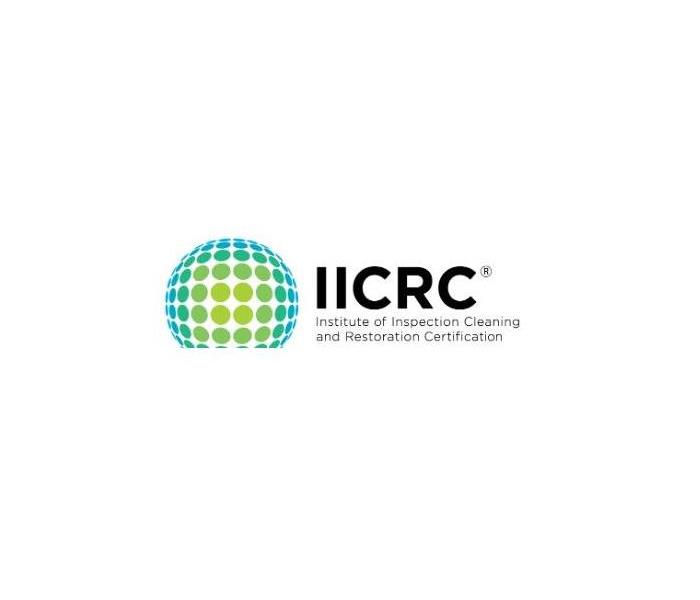 Our staff is trained in property damage restoration. From initial and ongoing training at SERVPRO Corporate Training Facility to IICRC certification.
Our staff is trained in property damage restoration. From initial and ongoing training at SERVPRO Corporate Training Facility to IICRC certification.
Damages to your business from water, fire, smoke or mold can mean lost revenue and potentially, lost customers. As many as 50% of businesses close down following a disaster, according to the latest research. To minimize business interruptions and downtime when disaster strikes, will require the assistance of a professional company who knows what to do and is "Ready for whatever happens."
When you are searching for such a restoration company, know that SERVPRO is a national brand that you can trust to get the job done right the first time.
Call SERVPRO of West Riverside City at (951) 351-8033 for your commercial building needs.
Follow us and stay connected on facebook
Who needs additional stress in an emergency situation? It’s normal for the business owner to be anxious and confused during the initial aftermath of a disaster. Companies you may never have heard of show up immediately to take advantage of the crisis.
SERVPRO of West Riverside City is the right restoration company to lessen the stress, help you make sound, calculated decisions that insure that your facility is mitigated properly. SERVPRO will stay there with you every step of the way and make calls to your agent and adjuster while you are there to gather and convey the necessary information.
SERVPRO of West Riverside City has the answers to most pertinent questions you need to know:
- Are we licensed?
- Do we hold IICRC certifications?
- Do we guarantee our work?
- What type of equipment will we be using in your building?
- Who manages the crew on-site?
- How and when is payment due?
- Do we have liability insurance?
Here are the answers to those questions:
SERVPRO is licensed, IICRC certified and we guarantee the work done on your property. We use SERVPRO branded equipment, all jobs are managed by a crew leader and we carry the appropriate insurance coverage. When it comes to payment we work directly with your insurance company. If you are a self pay, we give you the estimate upfront and keep you informed when the project will be completed and when payment is due.
Visit our website for more information regarding our training and certification.
IICRC Training and Certification
The Institute of Inspection Cleaning and Restoration Certification (IICRC) certifies and sets the standards for the cleaning and restoration industries. Our Professionals study IICRC standards and best practices in water restoration, fire restoration, mold remediation, carpet and upholstery cleaning, and other cleaning and restoration courses.
Cleaning your Riverside Home for Spring, What you Might have Missed
3/25/2020 (Permalink)
Spring is just around the corner. Traditionally, people feel the need to deep-clean their homes once they feel the warm air arrive and can open their windows to welcome the new season. There are many areas in your home that you will want to clean once you begin tackling this spring-time chore. Here are a few tips to help you get started that you may not have considered.
Wash Your Curtains and Drapes
When you start your spring cleaning, one of the first things you should do is clean your window coverings. This includes blinds, shutters, curtains or drapes. This should be done early on in the process as dirt and dust from the coverings can fall to the floor below, so you don't want to clean your floor before the drapes.
Test Your Smoke Detectors
Another step that should be included in spring cleaning is testing your smoke detectors. Most detectors have a test button on them that allows you to ensure they are working. If they don't work, you probably just need to replace the batteries.
Replace Water and Air Filters
As part of your spring-cleaning checklist, be sure to replace water filters and air filters. Filters catch debris from water and air. When they get full, they cannot filter as effectively as they should. The filters should be routinely replaced to ensure that they can work efficiently.
Clean Your Dryer Vent
Your dryer vent can easily become filled with lint and debris. Clean the dryer vent to help improve drying time and energy efficiency and also to prevent a fire. The vent inside your dryer should be cleaned with each load, but in the spring, you should check your exterior vent as well, making sure there is nothing accumulating in the tubing from the dryer to the outside.
Clean Your Grill
Once it begins to get warmer, people start thinking about cooking and eating outside. Now is the perfect time inspect your grill, refill your tanks if it is a gas grill, and clean all the cooking surfaces so it is ready to use when you want to make delicious meals.
Check Your Windows and Doors For Leaks
As you spring clean, take the time to check your windows and doors for leaks or air drafts. If you feel outdoor air seeping in, the seals may need to be replaced.
Check Your Plumbing for Leaks
Lastly, take the time to check your plumbing for leaks. Look for leaks under your sinks and for leaking faucets. If you notice any leaks, call in a plumber to make the needed repairs.
Are you looking to get your home clean for spring but lack the time to do it all yourself? Here at SERVPRO of West Riverside City, we can help you with some of your cleaning needs. We offer many services including fire and water clean-up services, mold remediation, and routine house cleaning, including duct cleaning and carpet cleaning. Give us a call at 951-351-8033 so we can get started today.
How to Prevent Wind Damage to Your Riverside Property
3/23/2020 (Permalink)
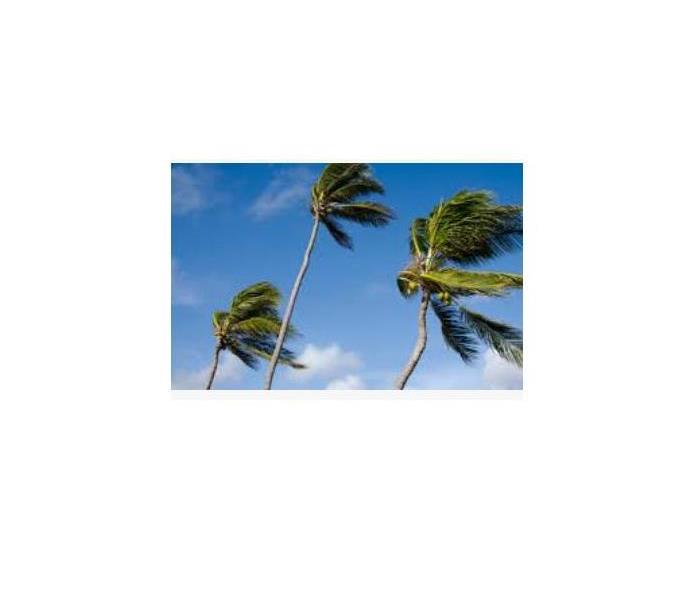 Riverside is known for strong winds, don't hesitate to contact SERVPRO of West Riverside City. We offer free inspections!
Riverside is known for strong winds, don't hesitate to contact SERVPRO of West Riverside City. We offer free inspections!
There are many areas of the United States that have experienced heavy winds and storms this season and the strong powerful winds can cause significant damage to your home. Wind damage can cause a range of destruction to your property from broken windows and fallen tree branches to more severe damage to the roof, garage, or car. It can happen to your home directly from the strong wind or indirectly from the wind blowing debris into your house.
Wind Damage from Different Types of Storms
Thunderstorms are the most common source of wind and storm damage but winds from hurricanes or tornadoes are stronger and can cause more severe damage. It can produce many types of damaging weather such as lightning, hail, tornadoes, straight-line winds, flooding and more. Thunderstorms are responsible for over half of all wind damage cases in the U.S. but the storm damage repair may be more costly for hurricane or tornado wind damage. Billions of dollars are spent on wind damage repair and storm damage restoration each year; understanding the nature of wind damage can help you limit the amount of damage to your property and save on restoration and repair costs.
It is important to know when a storm is approaching your area and what type of storm it is so you know the potential and level of damage to expect. These wind damage facts will help you better understand the potential for wind damage and how to prevent it. Here are some steps you can take to minimize the risk of damage to your home when severe weather strikes.
Preventing Wind and Storm Damage
Most wind damage is caused by flying debris either from plants or other structures and objects that are not secured. If a storm is approaching your area, make sure any potential debris around your home such as patio furniture, toys, garbage cans, and other objects are either secured or brought inside. Your doors and windows should also be secured to help minimize the potential storm damage to the home.
Roof damage can be reduced during the construction phase when the roof deck and the shingles or membrane is applied over the decking. A well-designed roofing system will firmly anchor the trusses and decking to the walls and foundation to keep the entire roof from lifting off the building in a strong wind. Roofing material must be properly fastened to the deck. Weakly connected shingles will lift easily from the deck.
Siding damage can be reduced at the construction phase as well. Properly fastened siding is less likely to lift off a structure in strong wind. Building codes will likely direct the minimum standards for connections. You, your architect, or your contractor may decide to exceed these minimums for a stronger and more storm resistant structure.
Falling trees and tree limbs are another significant type of damage to structures in a windstorm. Tree maintenance to remove dead limbs or identify and remove weakened trees will reduce the likelihood of the structure being damaged.
Mitigating Damage after a Storm
Close any openings made in the structure by the wind. Roof openings and broken windows are the most common problem. Keep a roll of plastic sheeting that can be quickly cut to size and nailed over the opening.
Keep your personal safety in mind and attempt such a closure yourself only if it can be done with little or no risk. Your insurance policy will likely cover the cost of emergency close up. Contact your agent or claims center to report the damage and seek advice on how to proceed.
Falling trees and tree limbs can open a structure with sudden violence. A tree on a structure is a very serious personal and structural safety issue. A tree may look as if it will not shift position. But it can shift and cause serious injury to the unwary. A fallen tree may also mask other very serious safety issues, such as downed electrical wires. The wires may still be live and the tree itself energized. Contact your agent or claims center to report the damage and seek advice on how to proceed.
If your home or business sustains wind damage during a storm, it is important to contact a storm damage restoration professional as soon as the storm is over to help limit and repair the damage. SERVPRO of West Riverside City can respond immediately to storm and flooding conditions. Our quick response will help prevent secondary damage and help reduce restoration costs.
Visit our website for more information regarding our services and why it is important to select a qualified services to assist with your damaged property. It is for your safety and that of your family. We make it our goal to help our neighbors!
Have Storm or Flood Damage?
Call Us Today (951) 351-8033
The Truth About Mold in your Riverside Commercial Property
3/16/2020 (Permalink)
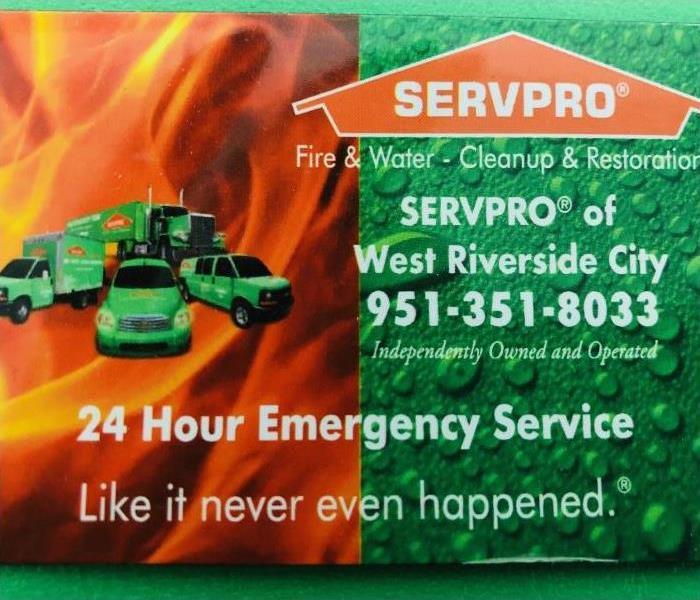 Let SERVPRO of West Riverside City handle the mold issues in your commercial building! Call us 951-351-8033
Let SERVPRO of West Riverside City handle the mold issues in your commercial building! Call us 951-351-8033
Many people equate mold with gross, fuzzy, green stuff found on old and expired food.
While this is very common; it is certainly not the only type of mold that may cause health effects for anyone encountering it. Mold can grow almost anywhere and on any surface where there is moisture and oxygen present.
Unfortunately, the interior of your commercial building is no exception. Mold can come fast and furious with little to no warning signs and may pose an array of health effects.
At the end of the day mold and human contact simply doesn’t mix and by following a few simple steps you can lower the risk of your building being at risk of a mold infestation.
- Stay Attentive – Mold is often not visible to the human eye. It is best to have a plan in place to regularly inspect your building. Places that contain high moisture levels are at the greatest risk. Musty smells, mold marks on carpeting, and fuzzy wall-stains are all signs that mold may be present and certainly worth noting when inspecting.
- Plumbing – Plumbing issues are at the root of almost all mold scenarios. Things like roof leaks, pipe leaks, unsealed windows and door frames should be repaired by professionals immediately.
- Moisture Levels – Mold loves moisture. It is best to have dehumidifiers and fans at all places necessary to reduce these moisture levels and cut out what mold needs most to grow!
- Ventilation Systems – HVAC systems are the hardest parts of a building to keep mold-free. This is also one of the most important parts to keep mold-free because this is how air is spread throughout a building. If these vents contain moldy air, moldy air will surely be ventilated throughout, causing many more problems then what was originally there.
- Call a Professional – If you suspect mold but can’t seem to pinpoint the source or are not sure how to remediate it, we highly suggest you contact a professional to inspect your commercial building. These professionals should have certain IICRC certifications and should take care of the issue right away. SERVPRO will have your business back to operating as healthy as before!
The highly trained mold remediation specialists at SERVPRO of West Riverside City pride themselves on responding FAST to stop the spread of any commercial mold and prevent any further damage. Using the latest mold remediation equipment and practices we are fully equipped to take on any problem your business may have.
Click to learn more about Mold Remediation and Restoration.
We are Cleaning Experts
3/16/2020 (Permalink)
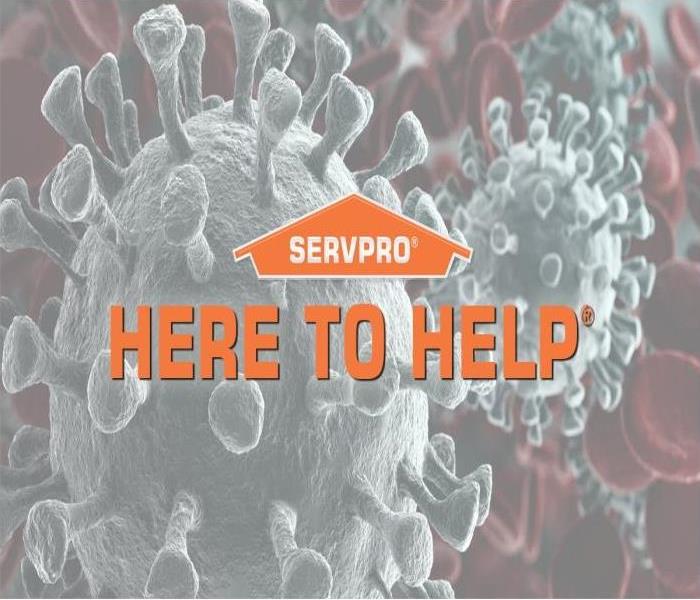 Call us 951-351-8033. We hope all Riverside residence remain safe, follow guidelines as expressed by City & Gov organizations!
Call us 951-351-8033. We hope all Riverside residence remain safe, follow guidelines as expressed by City & Gov organizations!
SERVPRO of West Riverside City is Here to Help during this time of need.
During this unprecedented time caused by the global pandemic of coronavirus, this is a reminder to our customers that we are specialists in cleaning services, and we adhere to the highest cleaning and sanitation standards.
Specialized Training
We are prepared to clean and disinfect your home or business, according to protocols set forth by the Centers for Disease Control and Prevention. We have years of experience in dealing with biological contaminants, and we will go beyond the scope of work that regular janitorial staff perform on a daily basis.
The CDC encourages cleaning of high-touch surfaces such as counters, tabletops, doorknobs, light switches, bathroom fixtures, toilets, phones, keyboards, tablets and tables. Other spaces mentioned in the CDC’s guidance for commercial spaces include:
- Kitchen/Food Areas
- Bathrooms
- Schools/Classrooms
- Offices
- Retail Spaces
- Water Fountains
- Shelving/Racks
- Sales Counters
- Carpets and Rugs
- Stair Handrails
- Elevator Cars
- Playground Equipment
- Fitness Equipment
Specialized Products
The CDC recommends usage of a labeled hospital-grade disinfectant with claims against similar pathogens to the coronavirus. Multiple products in the SERVPRO product line carry the EPA-approved emerging pathogens claims. While there is currently no product tested against this particular strain of the coronavirus, we are following all guidelines as provided by the CDC and local authorities.
Call Today for a Proactive Cleaning
If your home or business needs deep cleaning services, call the experts today – SERVPRO of West Riverside City, 951-351-8033
Is Spring the Best Time to Clean Your Riverside Home?
3/11/2020 (Permalink)
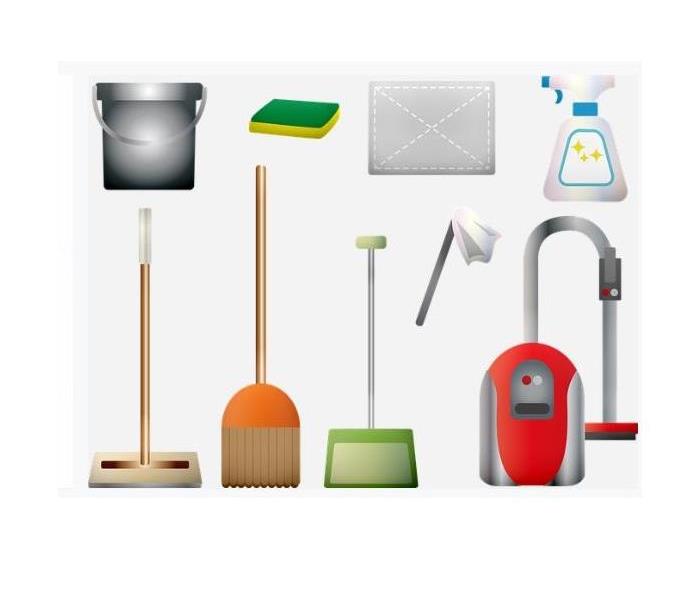 Call SERVPRO of West Riverside City for your Spring Cleaning needs. We can handle the deep cleaning for you! 951-351-8033
Call SERVPRO of West Riverside City for your Spring Cleaning needs. We can handle the deep cleaning for you! 951-351-8033
Spring seems to be the perfect time of year for deep cleaning your home due to the change in seasons. The weather is perfect for opening windows and letting the fresh air flow through your home.
The truth of the matter is that spring cleaning could be the most boring task or could be the easiest. It all depends on how you arrange tasks and the actions you take every day in order to have a clean and a cozy home. Every Riverside new home or older home has its own unique characteristics and needs. There are a few basics that anyone can fall back on when it comes to spring cleaning.
Kitchens, bathrooms, bedrooms, living areas, washing, replacing, dusting, sorting…not sure where to start? Don’t feel overwhelmed, here are a few handy tips that can be used as a checklist to make your spring cleaning easier. We also recommend you have all cleaning products beforehand so you won’t be tempted to put it off.
Kitchen
We recommend you start by cleaning something that needs to be shined, this task will be more appealing as you will see the results immediately.
- Clean inside and outside of the refrigerator. Take the opportunity to throw out expired food products since you will be emptying the shelves to clean them.
- Clean stove and oven and wipe down microwave.
- Wipe down shelves in cupboards and inside drawers.
- Clean garbage disposal blades by grinding ice and freshen it with baking soda and/or citrus rinds.
- Clean or replace your range hood filters.
- Sweep and mop floors with a nice clean fragrance…You're done!
Bathrooms
This task could be one you would rather leave for last, but think of entering a fresh, clean bathroom.
- Wipe down shower and tub and re-caulk if your caulking has cracks or is moldy.
- Clean toilet, counter tops, and mirrors.
- Sweep and mop the floor.
- Wipe down shelves in cupboards and inside drawers.
- Clean/wash bath mats, shower curtain, rugs, etc.
Bedrooms
In case you have many bedrooms you can take one per day.
- Wash all bedding including your mattress cover
- Wash pillows (or replace if needed it)
- Rotate and flip mattress
- Organize and clean out closet (take the opportunity to collect clothing you no longer wear. Place them in a bag and keep it somewhere you'll remember to take to a donation center).
Living Areas
These areas (living room, family room, loft, game room, dining room) are the most used, so we recommend you leave these for last so you can clean and organize them properly.
- Vacuum/sweep and mop floor.
- Polish furniture.
- Dust electronics/media centers other.
- Organize DVDs, remote controls, magazines, etc.
- Clean sofas and pillows.
Throughout the House
This task can be done one per day and depending on the amount of work needed.
- Dust furniture surfaces and ceiling fans.
- Vacuum, wash or dry clean all carpets, rugs, and draperies.
- Wipe down walls, baseboards, and light switches.
- Wash windows (inside and out) and windowsills.
- Wipe down blinds.
- Change air filters.
- Apply a light coat of wax to wood cabinets and furniture.
Seasonal Maintenance:
The following tasks are more for maintenance but essential. Completing these tasks will reflect a well maintained home and will contribute to the safety of your family.
- Test all smoke detectors (this should be done monthly).
- Check caulking and weather stripping around windows and doors, inside and out.
- Check for cracks on the exterior of your home and seal them up with proper caulking.
- Clean sliding door track and apply silicone lubricant if necessary.
- Oil moving parts of garage door.
- Visually inspect roof for broken shingles and clean rain gutters.
- Check your attic for evidence of roof leaks, and ensure your attic soffit vents are not blocked with insulation.
- Pressure wash soffits, walkways, and roofing to rid of mildew.
Contact us SERVPRO for your cleaning needs. SERVPRO has the expertise to provide deep cleaning service, more than your basic house cleaning. Our residential cleaning services will ease the burden of the constant maintenance cleaning of your home, but will also create a safe, clean, and comfortable living environment for you and your family.
You know SERVPRO as a leader in Fire and Water Cleanup and Restoration, our staff is equipped with the knowledge to restore your property. If you would like to schedule service for your home or business, please call today! SERVPRO of West Riverside City specializes in the cleanup and restoration of residential and commercial property after a fire, smoke, or water damage.
Don’t wait, be ready to enjoy your fresh, clean home by organizing the activities during the coming months with this useful checklist or by contacting us, don’t rush for spring or summer time we are here to give you a hand!
Homeowner’s and Renter’s Guide to Mold Cleanup After Disasters
3/4/2020 (Permalink)
Cleaning up after a flood can pose health risks. You and your family should wait to re-enter your home until professionals tell you it is safe, with no structural, electrical or other hazards.
Before you start cleanup activities, contact your insurance company and take pictures of the home and your belongings. Remember – drying your home and removing water-damaged items is your most important step for preventing mold damage.
Is There a Problem?
Was your home flooded? If so, and you were not able to dry your home (including furniture and other items) within 24-48 hours, you should assume you have mold growth. You need to completely dry everything, clean up the mold, and make sure you don’t still have a moisture problem.
You may see or smell mold on clothing, drywall, furniture, cardboard boxes, or books, but it may also be hidden under or behind items like carpet, cushions, or walls.
Mold Basics:
Flood water may have carried sewage or chemicals into your home. This could expose you or your family to viruses, bacteria, disease carriers (such as mosquitoes), and parasites, as well as mold. To learn more about cleaning and disinfection go to: www.cdc.gov/healthywater/emergency/flood/standing.html.
You can protect yourself and your family from mold exposure by following these steps.
Before You Enter Any Moldy Site:
Protect yourself and loved ones against hazards. People with breathing problems like asthma or who have weakened immune systems should stay away from moldy sites. Children should not take part in disaster cleanup work. Check for loose power lines or gas leaks. Make sure the electricity and gas are turned off. Look for sagging ceilings or floors or other structural problems. Watch out for wet, muddy, or slippery floors.Protect your mouth and nose against breathing in mold: wear at least an N-95 respirator. If you plan to spend a lot of time removing moldy belongings or doing work like ripping out moldy drywall, wear a half-face or full-face respirator. Basic information on using it is in OSHA’s general respiratory protection guidance. Protect your skin. Wear protective gloves (non-latex, vinyl, nitrile, or rubber). Do not touch mold or moldy items with bare hands.Protect your eyes. Wear goggles that provide complete eye protection. Choose goggles designed to keep out dust and small particles. Safety glasses or goggles that have open vent holes will not protect you against dust and small particles.After You Leave a Mold Site:
Protect yourself and loved ones. Shower and change your clothes. This will help you avoid carrying mold and other hazards back to your current living quarters.Should I Do This Myself?
This job may be too difficult or dangerous for you. It may be best to get help from experienced and qualified professionals if you can. Hire a mold inspection or remediation professional affiliated with or certified by the National Environmental Health Association (NEHA), the American Industrial Hygiene Association (AIHA), the Institute of Inspection, Cleaning and Restoration Certification (IICRC), or American Council for Accredited Certification (ACAC) to inspect, repair, and restore the damaged parts of your home. Your state also may regulate mold remediation.
Sampling for mold is not usually recommended. Understanding the results can be difficult, and no matter what kind of mold is in your home, you need to clean it up and fix the moisture problem.
If I Must Do This Myself, How Can I Do It Safely?
Follow these steps:
Put on the personal protective equipment described above to protect your eyes, nose, mouth, and skin.Remove standing water and wet materials. Use a wet vacuum to remove water from floors, carpets, and hard surfaces. Dry your home and everything in it as quickly as you can – within 24 to 48 hours if you can.Open all doors and windows when you are working and leave as many open as is safe when you leave.Open inside doors, especially closets and interior rooms, to let air flow to all areas. Take doors off their hinges if you need to.Open kitchen cabinets and bathroom vanity doors; remove drawers, wipe them clean, and stack them to dry.Open the attic access to let air flow to the attic. Before you open the attic door, make sure nothing will fall on you.When electricity is safe to use, use fans and dehumidifiers to remove moisture. Do not use fans if mold has already started to grow, because the fans may spread the mold.Clean with water and a detergent. Remove all mold you can see. Dry right away.If you use cleaning products, do not mix cleaning products together. DO NOT mix bleach and ammonia because it can create toxic vapors.Painting or caulking over mold will not prevent mold from growing. Fix the water problem completely and clean up all the mold before you paint or caulk.Throw away items that can’t be cleaned and dried. Throw away anything that was wet with flood water and can’t be cleaned and dried completely within 24 to 48 hours. If you have precious items that you want to preserve, follow these guidelines from the Smithsonian Institute: www.si.edu/mci/english/learn_more/taking_care/mnm.htmlExternal.
Safe Wildfire Smoke Damage & Ash Cleanup in Riverside City
3/2/2020 (Permalink)
It’s important for consumers to be aware of the many dangerous health effects caused by returning to smoke-salvageable and smoke-damaged buildings.
It’s imperative that fire and smoke odor cleanup be performed correctly and safely to stave off any ill health effects and permanent property damage.
Follow These Steps from our friends at IICRC:
To help home and business owners returning to fire and smoke damaged properties, the IICRC offers the following tips:
- Safety is most important. Wear an N-95 ANSI-approved dust mask (like a painter’s mask) and work gloves during cleanup.
- Ventilate the home. Place a box fan in an open window to draw smoke-odor laden air and char out of the building.
- Replace ventilation filters as soon as possible, then run the ventilation system to filter-out smoke-related particles.
- Clean the exterior of the building of fire-damaged debris, smoke and char particles. Exterior cleaning includes washing off the building, sidewalks, driveways and decks with detergent and fresh water scrubbing followed by rinsing.
- Clean the interior by dry HEPA (High Efficiency Particulate Air), vacuuming the ceiling, upper and lower walls and then flooring. In some situations, detergent wet cleaning must be applied to remove a smoke film which impacts and absorbs onto surfaces.
- Vacuum contents and upholstery. Make sure your house or building vacuum is HEPA rated, otherwise, you risk blowing smoke and soot into the air. Draperies, clothing and machine-washable items such as towels may be dry cleaned or laundered.
- Unless the upholstery manufacturer says otherwise, use a mild alkaline cleaner to neutralize acid in smoke, soot, char and ash.
- When smoke and soot damage and residue is moderate or heavy, or you cannot complete smoke and soot odor removal on your own, consider hiring a professional who is certified in fire and smoke damage restoration to cleanup and restore your home or business and belongings. To find a trained and certified professional in your area, visit the IICRC website at www.IICRC.org and select “Locate a Certified Pro.”
- Check with your insurance provider to determine if smoke damage from outdoor sources is covered under your policy. Insurance companies can often provide a list of credible restoration companies from which property owners can choose.
- If the fire has warped or distorted the structure, consult a general contractor who can also be found in the IICRC list of approved restorers.
When hiring a fire and smoke removal professional in your area, make sure that the technician is a certified Fire and Smoke Restoration Technician (FSRT) to ensure they are educated on the latest techniques for proper remediation. In some cases, a mold remediator may also be necessary as the volume of water used to combat fires can result in an abundance of standing water within a property, leading to mold growth.
To find certified restorers in your area or to confirm the certification of any company that has contacted you, call the IICRC at 1-844-464-4272 or visit www.IICRC.org and select “Locate a Certified Pro.”
Preparing Your Riverside Home to Transition from Winter to Spring
2/26/2020 (Permalink)
 Is your Riverside property prepared for spring? Call us at 951-351-8033!
Is your Riverside property prepared for spring? Call us at 951-351-8033!
There’s the feeling of spring in the air in West Riverside City.
There are birds in the yard, and in Southern California wild flowers have made their appearance. Spring is just around the corner! And we know you are ready for it. Is your home? Here are a few things to think about when it comes to the transition from cold winter weather to the warmth and sunshine of spring.
First on your list should be your gutters. They can be full of dead leaves, small branches, and even dirt from the rough weather. Get those gutters cleaned out right away so the spring showers don’t cause mold problems and water damage to interior walls, because that can be a big issue. Make sure the downspouts are directing water the right way, as well. Tough West Riverside winter weather could have caused them to change position.
How’s your roof faring? Keep an eye on it to see if any leaks have started due to storm damage over the past few weeks and months. Take a look at any vents to see if vegetation or mold has take hold, obstructing air flow.
The filters in your HVAC unit likely need to be changed, and you will want to clean out ducts, vents, and the system itself. Duct work can be hard to check, so you may need to contact West Riverside professionals to come out and help.
Your windows have taken a beating, so you will want to inspect them for storm and water damage. Cracks, damaged weather stripping, improper fit; all these issues can cause problems down the road. Now is a great time to get them professionally cleaned and let that warmth and sunshine in!
You can check your hoses and sprinkler systems at this time and replace anything damaged by all the storms and the water from rain. Fertilize the lawn and garden!
While you are inspecting your home, if you notice any severe storm damage, take pictures for insurance purposes, in case you need to file a claim.
And don’t forget to call us here at SERVPRO of West Riverside City for all your repairs and clean-up needs! We specialize in water and storm damage, fire damage, and mold prevention. You can contact us by phone at (951) 351 8033, or visit us on our website: SERVPRO West Riverside City
Filing a Water Damage Claim for your Riverside Home in 5 Easy Steps
2/24/2020 (Permalink)
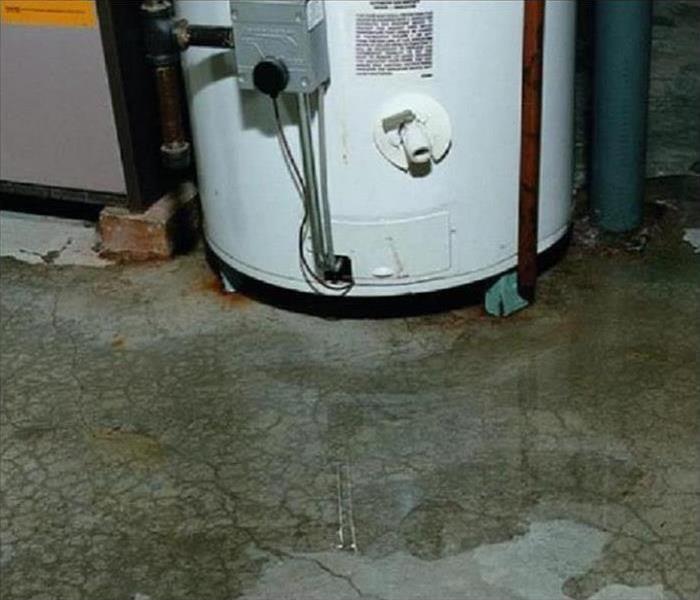 Leaking water heaters that are not caught immediately always create problems for the homeowners. Call us right away so we can begin restoration.
Leaking water heaters that are not caught immediately always create problems for the homeowners. Call us right away so we can begin restoration.
There are unique aspects to every type of insurance claim.
When dealing with water damage, there is an urgent need to dry out your home before mold becomes a problem. Follow these steps to get the claims process moving as soon as possible:
1. Notify the Insurance Company
Once the flow of water from the pipe burst stops, contact your insurer. Do this immediately, even if it is 2 a.m. on Sunday. Leave a voice mail if nobody answers. Explain your problem and ask the agent about your coverage. Ask for instructions, then write them down and confirm that you understand them. Request the preferred vendor list so that you can select water damage recovery experts in the Riverside area.
2. Follow the Agent’s Instructions
Instructions may involve filling out an insurance claim and preparing for a visit by the adjuster. It is essential to complete these tasks as quickly as possible. If the agent authorized you to contact a cleanup company, do so quickly. Cleanup needs to start as soon as possible.
3. Take Photographs of the Flood Damage
Now is the time to take photos to show what was affected. The adjuster needs to see the original damage. A smartphone is a terrific tool for documenting any issues.
4. Begin the Recovery Process. Make sure that the damaged area is safe to enter. It may be necessary to turn off the power. Next, you should proceed to remove everything you plan to keep. Store undamaged items in a dry area. Send the damaged items out for restoration.
5. Give the Adjuster a Tour of the Damage
Provide the adjuster with your pictures and the information requested by the agent. If all the information is available, this should go smoothly.
Once your insurance claim approval is complete and the local water damage recovery experts are on the job, your home will be on the fast track to restoration.
The first 24 hours following a water loss is the most important in
preventing secondary or permanent damage. Within four hours of loss notification, a SERVPRO West Riverside will be on-site to help ensure a water damage is handled by completing the following steps.
Inspection
SERVPRO of West Riverside will inspect affected areas to determine the extent of water damage
and will review the inspection with you to answer any questions before beginning any work.
Emergency Services
SERVPRO of West Riverside will take steps to help protect your home or business, as well as personal belongings and other contents, from further damage by extracting the excess water and preparing the area for drying. They will explain the needed emergency services to you step-by-step.
Monitoring
To help ensure your home or business and belongings are dried to appropriate industry standards, a SERVPRO West Riverside will monitor the drying process. The updates will be consistently communicated to you.
Restoration Services
SERVPRO of West Riverside will repair structural materials, reinstall carpets, and clean affected areas of your property and belongings. A final walkthrough of the job site will be conducted with you to help ensure the property was returned to preloss condition.
Emergency Water Damage Tips
Shut off the water source if possible or contact a qualified party to stop the water source. Turn off circuit breakers for wet areas of the building when access to the power distribution panel is safe from electrical shock. Remove as much excess water as possible by mopping and blotting. Place aluminum foil or wood blocks of furniture legs and wet carpeting. Move any paintings, art objects, computers, documents, and other sensitive valuables to a dry place. Don’t enter affected areas if electrical outlets, switches, circuit breakers, or electrical equipment are exposed to water. Always avoid electrical shock hazards. Don’t use your household vacuum cleaner to remove water; this could cause electrical shock or damage to the vacuum cleaner.
Don’t turn on ceiling fixtures if the ceiling is wet or enters rooms where ceilings are sagging from retained water.
For more information on
recovering from water damage,
contact your local SERVPRO
West Riverside City 951-351-8033.
Staying Safe When Chemical Agents are Used for Commercial Property Water Restoration
2/19/2020 (Permalink)
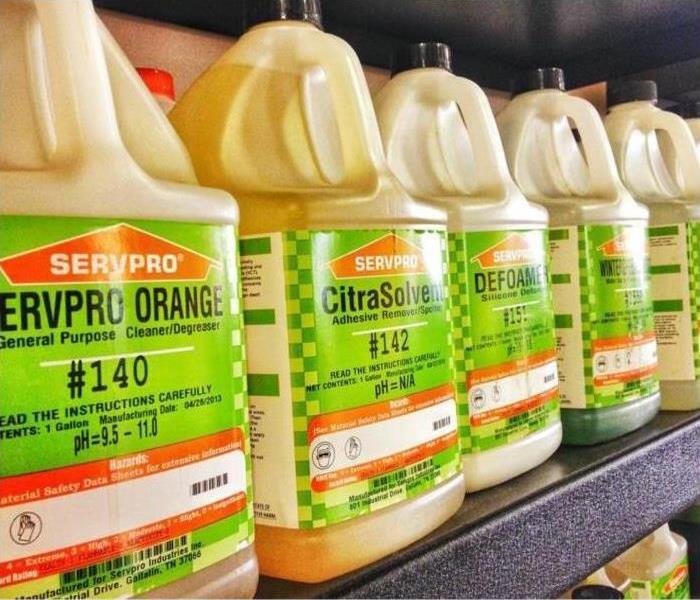 If our technicians do plan to introduce any kind of chemical element to the restoration process, you will be fully informed.
If our technicians do plan to introduce any kind of chemical element to the restoration process, you will be fully informed.
Chemical Agents and Commercial Water Removal
The consequences of water damage can be huge, particularly for small businesses. Ultimately, every day that you can’t operate represents lost profits. This is why a fast and efficient restoration service is essential. At SERVPRO, we have a broad range of techniques that we can use to dry, clean, and repair your property quickly. In some instances, this does involve the use of strong chemicals.
They might be cleaning products, chemical agents, or water treatments. If our technicians do plan to introduce any kind of chemical element to the restoration process, you will be fully informed. Do be aware, however, that your employees will not be allowed to access the affected area during this time. Commercial water removal in Riverside is a complex process, and it requires your full cooperation.
This simple guide to the most commonly used restoration chemicals will give you some information so that you can keep your workers safe.
Antimicrobial Agents
This describes any chemical that is used to prevent the spread of microorganisms in water or on moist, damp materials. We will use these agents if we believe that black or gray liquid has entered the building, as it can be toxic.
Disinfectants
Our disinfectant products are not too dissimilar from the ones that your cleaners may use, but they are substantially stronger. They are able to kill 99% of all the organisms that they encounter, and they leave surfaces close to sterile. We may use formaldehyde, alcohol, or chlorine based products.
Sanitizers
The job of a sanitizer is to lower the number of microbes to a level that has been considered safe for ‘public use.’ Usually, sanitizing chemicals are combined with other cleaning agents, because they are not powerful enough to eradicate all organisms on their own. If bacteria remains and only sanitizer is used, there is a chance of it returning and we won’t take it.
Sterilant
Sterilant is very effective because it eradicates fungi spores as well. This prevents the spread of mold in areas that have been affected by water damage. The downside to these chemicals is that they can’t be applied to every surface. Some materials will become damaged if brought into contact with sterilant, so we’re very careful about how we use them.
Cooperation And Collaboration Will Keep You Safe
We’ll keep you in the loop at all times and explain what is happening throughout the restoration process. In exchange, we expect you to listen to our recommendations and vacate areas containing strong chemicals when advised. This is for your safety. You must inform all employees as to which spaces they can and cannot use during the repairs.
Don’t forget that SERVPRO of West Riverside City is a local business. We are based in your area, so you can access our services at any time. We have access to state of the art drying equipment, and we can restore severely damaged items. Call us 24/7 at (951)351-8033.
Riverside Area's Premier Option for Professional Water Removal Services
2/17/2020 (Permalink)
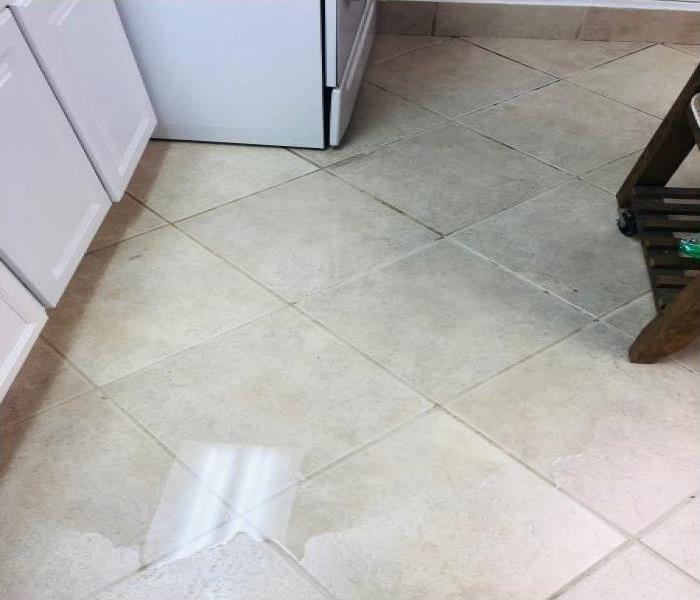 Is this something your seeing after heavy rains? Call SERVPRO of West Riverside City 951-351-8033.
Is this something your seeing after heavy rains? Call SERVPRO of West Riverside City 951-351-8033.
Take No Chances, Call in SERVPRO for Water Damage Cleanup and Restoration
Having a flood of any type occur on your property can leave behind overwhelming amounts of damage. Everything in your home that comes into contact with water requires special handling that you may need help with for cleanup.
Water removal services are key to restoring your Riverside area property after leaks or flooding; they often help eliminate a variety of secondary damages that develop over time. You might not understand it, but ignoring it is totally out of the question. Do yourself a favor, locate a qualified restoration company to help get things under control.
Small floods with less than 2-inches of water in any location of your home often have a pretty basic solution. SERVPRO technicians enter your home, assess the damages, and explain their services. If their tests show that the water does not contain contaminants of any kind, they bring in a variety of portable extraction equipment and remove water from your home safely. More or less a straight forward job that may or may not lead to repairs, painting, or general construction work in your home. Drying out all wetted materials is crucial to controlling any need for replacement.
Large area floods often bring dirt and muck along for the ride, leaving large amounts of unknown waste throughout your home. These types of flooding incidents may not allow such an easy, simple solution. SERVPRO technicians run into more contaminants, biohazards, and safety issues with this kind of flood. Safe and secure services with specifically trained personnel accomplish the task. However, once they have taken care of the contamination, the restoration continues just like any smaller job would.
The amount and type of water exposure you experience in your home have a severe impact on the results you receive. However, SERVPRO technicians have years of experience performing water removal services, obtain IICRC industry certifications, and have access to the equipment and resources necessary to handle any size job that occurs on your property.
SERVPRO Technicians are on Call to Remediate Water Damage on Your Property
While having water damage in your home is bad enough, the effects of water damage on your living environment should be more concerning. Several types of microorganisms spread throughout your home over time. Given the right conditions, these organisms pose a severe health concern, especially after making their way into your ventilation system, carpeting, and the indoor living environment.
Locating a company, like SERVPRO, in your area can give you access to air duct, carpet cleaning, and water damage services that make handling areas of vital importance easier. It is important to keep your living environment free of contaminants, ensuring that everyone in your family enjoys the best indoor environment quality possible.
Waterproofing is serious business, providing you with a way to keep the structure of your home intact while also maintaining a healthy living environment. SERVPRO can help you perform waterproofing services on your home and be there to provide you with emergency plumbing, water extraction, carpet cleaning, and a way to locate hidden moisture in your home.
SERVPRO makes every effort to provide 24-hour emergency services to all customers. With an array of advanced equipment, expertise, and other resources available, there is not much they cannot do. For those specialty items like electronics, we have contacts within the industry to provide you with restoration services that exceed your expectations.
With the sheer amount of situations involving water damage and natural disasters on the rise, water related cases soar throughout the area. It is becoming more and more meaningful for homeowners to locate a quality restoration company near them to reduce problems involved in water incidents.
We want to be the partner in home protection that you can count on to help during an emergency, someone you trust to protect the environment that you and your family call home. Our technicians care about your situation and provide you with the attention you deserve.
SERVPRO of West Riverside City can respond to your call for help, anytime, day or night. With 24-hour emergency services and expertly trained technicians, you could not receive a more qualified solution. (951)-351-8033. We stand ready, willing, and able to help!
If an Appliance Leaks in Your Riverside Home You Need to Call Our Experts
2/12/2020 (Permalink)
 Call SERVPRO of West Riverside City for effective and rapid water removal services at (951) 351-8033.
Call SERVPRO of West Riverside City for effective and rapid water removal services at (951) 351-8033.
Get Quick Water Removal Services For Your Riverside Residence After An Appliance Leak.
Coming home to find that your living area is soaked with water from a leaking appliance like a washing machine, water heater, or air conditioner is irritating. Such leaks can ruin your house and its contents. Water can damage porous materials like carpets, insulation, and wood by warping or shrinking them. When a leak happens, you need to find its source and stop it.
You also need to remove the water and fix the damage in an expedited manner to prevent further destruction to your hardwood floors, walls, carpets, and other items. With water intrusion, the best way to minimize damage is to hire professionals who provide water removal services in Riverside. The minute you notice that there is water in areas it should not be, you can contact SERVPRO franchise professionals to help you with the cleanup process. Our Water Damage Restoration Technicians (WRT) can remove the water quickly and dry the affected areas thoroughly.
There are different categories of water damage, and we classify them according to severity. The severity varies from clean to gray to black. A big concern with appliance leaks is that the soaps and detergents you use daily contain chemicals that can diminish the quality of your flooring if they sit too long on it or if you do not clean them up properly. Clean water becomes gray water and gray water turns into black water the longer it remains on a surface.
If the leak was significant and water spread to different rooms of the house, our crew can use powerful pumps to extract the water. Our extractors have three major components: a heater, pump, and vacuum. These three components remain in use when cleaning carpeting and upholstery. It's also crucial to identify all the moisture and remove it. Our SERVPRO crews have advanced moisture detection tools that can identify water pockets.
Our experts can use dehumidifiers and air movers to remove the moisture that could be on the floors, walls, ceilings of your house effectively to prevent wood rot and stifle the possibility of mold infestation. Our intention in every water removal job is to return a house to the condition it was in before the leak.
Prompt Water Cleanup In Your Riverside Home Can Prevent Further Structural Damage
You can feel the effect of water damage in your home within minutes when the water loss incident is caused by malfunctioning appliances, or an overflowing sink. The damage to the structure of the building or your belongings can be significant and needs prompt attention.
Water can wreak more havoc the longer it goes without proper cleanup. The remediation specialists at SERVPRO understand a good deal of water damage situations and provide effective water cleanup services for Riverside homes. Time is a critical element in preventing permanent water damage to homes and their contents.
If water pools on wooden flooring for an extended period, it can warp, cup, or buckle. Our technicians can dry your hardwood floors to prevent buckling, warping, or cupping from becoming permanent. Drying hardwood floors soon prevents secondary damage. Our crews position air movers to apply airflow underneath and on top of wood flooring. We use moisture meters to check the moisture content of the wood floors. If the moisture content is below 16%, we increase air temperature to expedite the evaporation process. If the floor finish delays evaporation, we can remove it or use a pin roller to perforate it so that moisture can escape.
If water has pooled on your carpeted floor, our SERVPRO crew can use water damage mitigation and drying systems that can dry the carpet and pad without having to remove the pad. We call this method in-place drying, and it involves extracting water from the carpet thoroughly and using air movers and dehumidifiers than usual. In-place drying is only suitable if a carpet has not been exposed to water for over 72 hours. It offers the benefit of minimal disruption and less damage to the carpet since it is unnecessary to reinstall the carpet or cut seams.
If the walls of your home are wet, we can dry them using the appropriate technique. Materials that impede evaporation of moisture from walls can slow down the drying process. Our technicians can remove such materials to speed up the process.
At the initial sign of damage in your Riverside home, you can call SERVPRO of West Riverside at (951) 351-8033 for cleanup and restoration services. We’re Faster to Any Size Disaster.
Handling Water Removal from Ceiling or Attic in Your Riverside Home Due to Rain
2/10/2020 (Permalink)
Water loss can affect any section of your Riverside home.
While most spills leave water primarily on the floor of your main rooms, some cases might touch unusual spaces such as the ceiling or attics. These mostly happen when there is a leak in a supply line, or the roof is damaged allowing rainwater into the structure. Such situations are harder to deal with, so it is better to work with a professional water restoration team.
If your home has an attic or ceiling, look for obvious leaking signs or any water spotting. Survey the rest of the home to be sure you don’t have a problem.
Hopefully, you have already cleared out your gutters. If not, either get up on the roof yourself to remove the leaves that can cause a build-up leading to water finding its way into your home – or hire someone to do it. This is a common cause for leaks – during heavy rain, the water has to go somewhere, and its beyond frustrating, let alone expensive, when it gets into your house.
While you’re on the roof, if its shingled, inspect all of it to ensure none of the shingles have blown off. Given the recent wind storms we had, that’s always a possibility. If you have a chimney, make sure there are no gaps, and seal them as soon as possible if you find one.
Don’t forget to make sure your patio drains aren’t clogged from leaves. This time of year, a lot of trees are losing their leaves. With all of the wind and rain, it’s possible the drain could get clogged.
Oh, and hopefully you also turned off your sprinklers if they are on a timer. There are few things more wasteful than having your sprinklers operating when in the midst of a rain storm. California still faces a drought, no matter how much rain fell.
Efficient water removal from your West Riverside home is possible when you understand the extent of the problem. A leak in the ceiling might spill over to the rest of the house or remain confined in the ceiling with the only visible signs being bubbling and sagging sections. You can take some steps to mitigate the problem before professional restorers arrive. Look for the main water line and shut it off. You should also try to catch the dripping water by placing buckets directly under the leaks or using towels to soak it up from the floors.
Water removal from the ceiling requires considerable expertise for thoroughness and to minimize the amount of demolition needed. Having the right equipment also helps, especially during the drying phase to extract all the moisture. Our SERVPRO team includes IICRC certified WRT, Water Restoration Technicians, and ASD, Applied Structural Drying Specialists. We punch weep-holes to release water from the ceiling and minimize the weight on the panels without necessitating major demolition.
In case the leak is caught in time before the water permeates deeply into the panels and joists in the ceiling, it is possible to avoid demolition. However, this makes the drying process more difficult. Our SERVPRO technicians combine the use of advanced equipment and advanced skills. For example, we can make dehumidification more effective by covering the wet ceiling with a plastic barrier and venting it into a dehumidifier. We bring a wide range of moisture control equipment to the loss sites, including:
Dehumidifiers
Water damage restoration dehumidifiers are key tools for drying and restoring your environment after water damage caused by leaky plumbing or a flood. Heavy duty and rugged, these dehumidifiers quickly and efficiently extract water, dry flooring and walls, and curb harmful mold growth.
Air Movers
Air movers are designed for water removal after flooding. The powerful airflow they create is able to move air rapidly around the affected space, allowing moisture to be evaporated from under carpets and sub-flooring, behind walls, upholstery, and more.
Moisture Meters
This tool searches for the presence of moisture in various building materials including drywall, wood, siding, tile, insulation, and carpeting.
To deal with water damage effectively, call SERVPRO of West Riverside City to help. You can reach us at (951) 351-8033 any time. We’re Faster To Any Size Disaster.
Four Questions Riverside Residents have asked Regarding Water Damage Restoration
1/29/2020 (Permalink)
SERVPRO of West Riverside city has assisted Riverside County residents with almost every type of water damage situation imaginable. As professionals in the water damage restoration industry, we field questions about the recovering from water damages. Below are a few of the questions that we are asked.
Q: Should I clean up water damage myself?
As a business, you may expect us to say no. The honest answer is that it depends on the situation. If the water damage that your home or business has incurred is minimal, it may be easy to handle the job yourself. Nevertheless, one consideration to keep in mind is how to determine the depth of the water damage. If there is water leakage behind a wall or above a ceiling, the amount of damage that you see could be limited. Water between walls or above the ceiling can lead to massive amounts of mold damage.
Keep in mind, we do free service call inspections, so our Project Managers or Crew Chief are more than happy to tell you whether or not this is something they think you can handle on your own.
Q: How long does the drying process take?
Naturally, all homeowners wonder when their house will be back to its normal self, and the answer usually depends on the extent of the damage.
Dry out times vary to a number of conditions. For instance, the amount of humidity in the air has a great effect on how fast an area can dry. As a rule of thumb, a normal-sized residence takes about 2 to 3 days to dry completely when it has sustained substantial water damage.
Further processes include:
- Water Mitigation and Extraction
First, the company needs to curtail the effects of the flood water and moisture. This involves bringing in a heavy-duty extracting machine to remove the standing water. Next, the team has to prevent mold from growing. It only takes one day for mold to start growing. Finally, the professionals need to dry out the room using dehumidifiers and powerful drying systems. It generally takes about three days to do all this. The team needs to ensure the room is free of water damage before continuing on to the tear out stage.
The IICRC further separates water intrusion into four classifications:
- Class 1: Where a minimal amount of water has flowed onto materials that are predominately low porosity. This class of water damage requires limited mitigation and little moisture is left after the bulk of the water is removed, leaving a minimal amount of evaporation needed to finish drying. Examples would be a burst hot water tank on a sealed concrete floor or an overflowed toilet on a tile floor.
- Class 2: Where there is a significant amount of water discharged and the exposed materials are medium to high porosity. There is a greater absorption of water into the materials and the water damage process is lengthened by the volume of water that needs to be removed and a lengthened drying time. Examples would be a ruptured pressurized water line inside a gypsum board wall, or a wooden floor joist system.
- Class 3: Where a large amount of water, regardless of its category, is absorbed by highly porous materials, resulting in the highest rate of evaporation necessary to affect the water damage restoration process. Examples are a storm-forced leak, which floods a building’s interior and soaks carpeted areas, or broken water mains filling an underground parking area.
- Class 4: Where water intrudes and is trapped by building materials and assemblies, which makes the restoration process difficult, time-consuming and expensive. Affected areas are highly porous or tightly confined and require special methods and equipment, longer drying time or substantial vapor pressure differentials. Examples would be storm water flooding of wooden, plaster, masonry or concrete enclosures or a severe sewage backup that permeates floor and wall systems.
- Reconstruction
The amount of time it takes to reconstruct a room ultimately depends on how much the water affected. Professionals typically need to remove the drywall because it often absorbs moisture. Any insulation behind the wall usually also needs to be removed in case the water has compromised that. If the flooding occurred in a room with carpeting, then all of it must be taken out and replaced with something else. Depending on exactly how much damage occurred, it can take anywhere between a few days and a couple weeks to complete the work.
Q: Do I need to leave my home during water damage restoration?
If your residence has sustained a lot of water damage, the first concern you should have is your safety. When major repairs are taking place, the indoor air quality suffers greatly. Breathing in water-damaged (and often activated mold spores) air is unhealthy. When we are commissioned to handle major repairs it is extremely likely that we’ll recommend for the client to evacuate the home.
Q: Do I have to use the Restoration company my insurance company recommends?
Absolutely not. As a homeowner (or business owner) you can and should use the restoration company of your choice.
Do I have to use SERVPRO? Nope, you don't have to! But you should. SERVPRO is an industry-leader when it comes to water damage cleanup. We are backed by a fantastic team, excellent training, and we have all divisions in-house to help you handle your job from start to finish so you aren't dealing with various contractors.
Do you have additional questions? Give us a call today!
SERVPRO of West Riverside City
(951) 351-8033
Explosive Growth of Manufacturing and Distribution in the Inland Empire Is Main Topic for Perfect Vision Expo Jan. 30
1/27/2020 (Permalink)
 Come join SERVPRO of West Riverside at IE-Perfect Vision with Manufacturers, wholesalers, & distribution centers for enlightening information!!
Come join SERVPRO of West Riverside at IE-Perfect Vision with Manufacturers, wholesalers, & distribution centers for enlightening information!!
Come join SERVPRO of West Riverside City with other manufacturers, distributors, logistic companies, and importers at reRubber's huge conference facility in San Bernardino. The action starts at 10:30 with speakers, exhibitors, and networking.
You can’t help but notice the change in the Inland Empire anytime your drive down the 60, the 215, the 10 or the 91. Huge distribution center buildings popping up like the poppies after a great rain. Semi-trucks lined up bumper to bumper filled with products moving to and from the docks, the trains, the manufacturers, and the DC’s.
There’s another change that isn’t quite as visible, but the combination of tech advancements currently underway will revolutionize life worldwide. And the IE is right at the center of these monumental shifts in how we make things, move things, and buy things: Artificial intelligence, robotics, 3D printing, the internet of things, solar energy, electric vehicles, big data and more.
The Perfect Vision 2020 Expo Is coming on January 30, at reRubber, LLC , 215 N Del Rosa Dr., San Bernardino 92408
The purpose of the Expo is to bring together manufacturers, distributors, importers, DC’s and their suppliers of goods and services to get clarity on how these new technologies can help everyone in the IE grow sales and profits in the next decade. Details and tickets can be found at https://PerfectVision-IE.com
Three highly regarded experts in their fields will keynote the expo.
Shekhar Chandrashekhar - Smart Manufacturing Practice Lead at CMTC
Shekhar Chandrashekhar is a leader, strategist, and innovator with a history of driving improvements that streamline operations, drive growth and increase profitability on a global scale. His advanced training in engineering management provides him with the ability to transform organizations, influence company and product positioning and drive a laser focus on priorities that support the company’s vision, goals, and positioning.
As Smart Manufacturing Practice Lead at CMTC, Shekhar partners with a network of innovation institutes and industry 4.0 solution providers to assist manufacturers in digital transformation. He has vast expertise in IIOT, Agile, and data and information management.
Jeffrey Amberg - Wealth Manager at Painter, Smith, and Amberg
Jeff will speak on the subject of “An Economic Update: Current Narrative for 2020 and Beyond”
- Can the current economic expansion last
- Trade, Manufacturing, Energy and their impact on our future
- Emerging technology trends that manufacturers should watch
As a wealth manager at Painter, Smith and Amberg for the past 21 years Jeffrey has provided comprehensive financial advice and portfolio management, individually designed for his clients. His goal is to empower his clients to focus on what is most important in their lives - Faith, Family, Finances and Freedom.
Carlos Garcia - CEO/CTO and founder, F.Y.I. Technologies, Inc.
We live in a world where data is critical, and yet data is exposed to theft, destruction, or even piracy. Carlos will provide specific approaches for “Safeguarding Data in a High-Tech World.”
The expo will run from 10:30 to 4:30 on January 30. Lunch is included, and is produced by E-TEAM Referral Network, a B2B networking organization.
SERVPRO of West Riverside City will be there!
Do you know what to do when the "Big One" hits? We will be providing information on what to do in case we are hit with a large earthquake. Are you prepared for an earthquake at your place of business? Or what to do during an earthquake?
Visit our booth! We will provide tips and also share information on our Emergency Response Program which is a free service to help your business prepared for any natural disaster.
Details and tickets can be found at https://PerfectVision-IE.com
Check Before You Burn in Riverside County
1/20/2020 (Permalink)
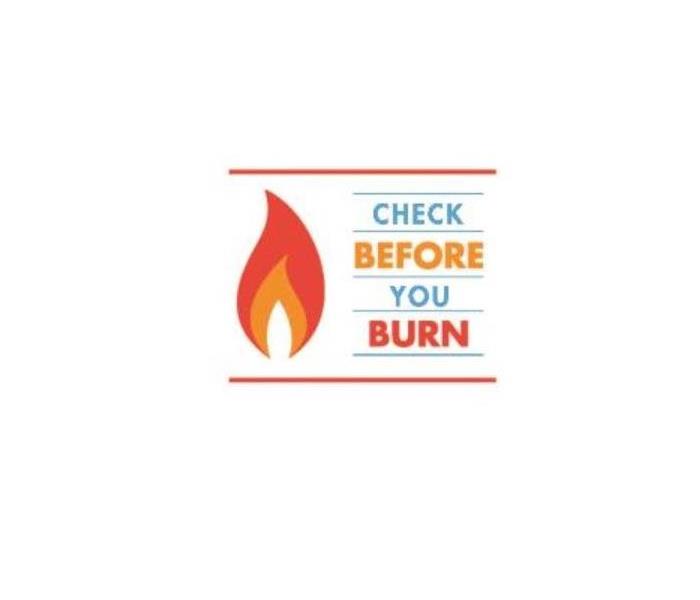 The Check Before You Burn" initiative was created to reduce pollution and protect public health from the harmful emissions of wood burning.
The Check Before You Burn" initiative was created to reduce pollution and protect public health from the harmful emissions of wood burning.
During late fall and early winter, the South Coast Air Quality Management District (South Coast AQMD) asks residents to participate in its "Check Before You Burn" program by not burning wood in fireplaces when unhealthful air quality is forecast. Under the program -- intended to help improve wintertime air quality --South Coast AQMD may issue mandatory no-burn alerts from November 1 through the end of February.
No-burn alerts are issued for 24-hour periods for residential wood-burning fireplaces, backyard fire pits and wood stoves when emissions and stagnant weather conditions raise fine particulate pollution to unhealthy levels. Alerts are typically issued for the entire South Coast Air Basin, which encompasses all of Orange County and the non-desert portions of Los Angeles, Riverside and San Bernardino counties.
Why do we need "Check Before You Burn"
The Check Before You Burn" initiative was created to reduce pollution and protect public health from the harmful emissions of wood burning. Despite steady progress toward improved air quality, Southern California still has the worst pollution in the country.
Reduce Pollution Caused by Wood Burning
Since November 1, 2011, wood burning in the South Coast Air Basin has been prohibited every year from November 1 through the end of February when no-burn alerts are issued due to forecasts of unhealthy levels
There are plenty of wood-burning alternatives and resources to help you switch to cleaner-burning gas log sets.
Reduce Health Risks Caused by Wood Burning
Pollution from wood smoke contains very small particles. These particles are the width of a human hair! Because it’s so small, these particles can lodge deep in the lungs and cause a variety of respiratory health problems.
Long-term exposure can lead to reduced lung function and chronic bronchitis. In some cases, prolonged exposure to this harmful substance may even lead to premature death. Short-term exposure can make existing respiratory conditions such as asthma or lung disease worse. It may also increase the risk of respiratory infections, and those with heart disease could even be at risk for heart attacks or arrhythmia. Young children and the elderly are especially vulnerable to the effects.
How to Reduce Air Pollution from Wood Burning
A wood-burning fireplace can cause pollution and be harmful to your lungs. But with some small changes, you can make a big difference. Here are some tips to help reduce pollution from your wood-burning fireplace:
- Choose not to burn when air quality is already poor. Check the South Coast AQMD Air Quality Index in your local newspaper or visit www.aqmd.gov to monitor when the air quality is poor to avoid burning wood on these days. Pay close attention during wood-burning season - November to February - to ensure you are not burning wood when a mandatory no-burn alert has been issued for your area. Save energy and reduce pollution during these months by wearing a sweater on chilly nights.
- Reduce your need for fuel. Make your home more energy-efficient by installing ceiling insulation, and by weather stripping or caulking windows and doors. Close off unused rooms if you don’t have central heating.
- Have your chimney professionally cleaned. Keep your chimney swept and ash area clean to improve air flow and reduce emissions. Chimneys should be professionally cleaned periodically to prevent creosote buildup and reduce the potential for chimney fires. Store wood outdoors, off the ground and with the top covered.
- If you do burn wood, start fires with softwood kindling such as pine or fir. Always burn “seasoned” or dry wood. These woods are generally low in density, ignite easily, burn fast and hot and will heat the firebox and flue quickly. Hardwoods such as oak can take longer to ignite, but they burn slower and produce less smoke. Remember to use smaller fires in mild weather.
- Never burn garbage and other materials. It can cause toxic smoke that can be extremely harmful to you and your neighbors.
- Watch chimney for smoke. Properly burning fires should give off only a wisp of white steam. The darker and thicker the smoke, the more pollution the fire emits, and the more fuel it wastes.
- Beware of overnight heating. Do not leave open fires unattended or let them burn overnight. This can lead to a back draft of smoke in your home, causing hazardous indoor air pollution. Build a small, hot fire and let it burn out completely, closing the damper when finished.
- For heating, switch to a cleaner wood-burning alternative. An EPA-certified wood stove emits up to 70 percent less particulate emissions and uses 30 percent less fuel.
- Replace your wood-burning fireplace with a natural-gas insert. The particle pollution from one wood stove is equivalent to that emitted by 3,000 gas furnaces producing the same amount of heat per unit.
- Remember... If you can smell smoke, you are breathing smoke!
How do I know if a no-burn alert has been issued?
Residents can obtain no-burn alert information by:
- Signing up for South Coast AQMD Air Alerts sent via e-mail;
- Using South Coast AQMD’s interactive residential no-burn alert map by entering an address or ZIP code in the search area; or
- Calling 866-966-3293 for Check Before You Burn information.
Information from our friends at South Coast AQMD
Our first responders are amazing hard-working men and women and they do their very best to provide awareness and prevention. First responders work hard to prepare everyday citizens to make our emergencies a little more manageable.
Consider SERVPRO as your second first responder. We do our best to provide awareness and prevention to all who meet us. We don’t want you to have a disaster or damage. No one wants their lives, or homes to be turned upside down. That is why we do our best to provide you with the knowledge and tools to prevent them.
Be sure to thank a first responder today and let them know how much their hard work is appreciated. Don't forget to mind "Check Before You Burn" regulations for the safety of you, your neighbors, and our first responders.
10 Crucial Things To Know Before You Start Driving In The Rain
1/15/2020 (Permalink)
 In Riverside County we experience flash floods frequently, this information is vital in keeping ourselves and passengers safe.
In Riverside County we experience flash floods frequently, this information is vital in keeping ourselves and passengers safe.
In Riverside County we experience flash floods frequently, this information is vital in keeping ourselves and passengers safe.
Driving in rain, whether a sprinkle or a heavy downpour, can be one of the most difficult driving situations a driver encounters. Rainy conditions are directly associated with higher accident rates. No matter what part of the country you live in, it is almost certain that you will be required to drive your vehicle in the rain at some point. Knowing how wet roads and reduced visibility affects the way your vehicle handles will help you drive safely in rainy conditions.
Nearly half (46%) of all weather-related car accidents — more than 700,000 a year — are due to rain.1 As we may experience more soggy weather, it's imperative that all drivers are schooled on how they can safely maneuver their vehicle and avoid weather-related auto accidents, which often cause car insurance rates to rise- Mercury Insurance
Here are 10 tips for driving in the rain:
Step 1. Exercise caution. Engine oil and grease build-up on roads and highways over time, and when combined with precipitation, you’ve got the equivalent of an automotive Slip ‘N Slide.
Step 2. Slow down. Wet pavement causes tires to lose traction and vehicles become more difficult to handle.
Step 3. Use headlights. Always use headlights in the rain – even if it’s just a sprinkle. Headlights help you see and be seen in wet weather.
Step 4. Keep your windshield wipers in tip-top shape. Summer can wreak havoc on your blades, so get them checked before fall’s showers arrive.
Step 5. Defog your windows. Precipitation can cause your windshield to quickly fog up, so use the front and rear defrosters to maximize visibility.
Step 6. Avoid pooling water. By splashing through puddles you can impair your vision and other drivers’. Additionally, standing water often shields potholes and debris from view and it can reduce the effectiveness of your vehicle’s brakes.
Step 7. If your car begins to hydroplane, do not brake or turn the wheel abruptly as this may cause your vehicle to go into a skid or spin. Take your foot off the gas and keep the wheel straight until your car reclaims traction.
Step 8. Increase your following distance. Slick roads, wet brakes and reduced visibility can lead to collisions. Give other vehicles plenty of room and brake early with reduced force.
Step 9. Don’t use cruise control. It can cause your car to accelerate when hydroplaning and reduces driver attentiveness.
Step 10. Drive in the tracks of the car in front of you. This allows the vehicle ahead to displace any standing water that’s on the road.
By employing these safe driving techniques you can keep yourself and your passengers safe during fall and winter drizzles and downpours. Rainy roads can be dangerous, but if we all slow down and use extra caution, rainy days might actually be a little brighter.
Indicators Your Riverside Home May Have Hidden Water Damage
1/13/2020 (Permalink)
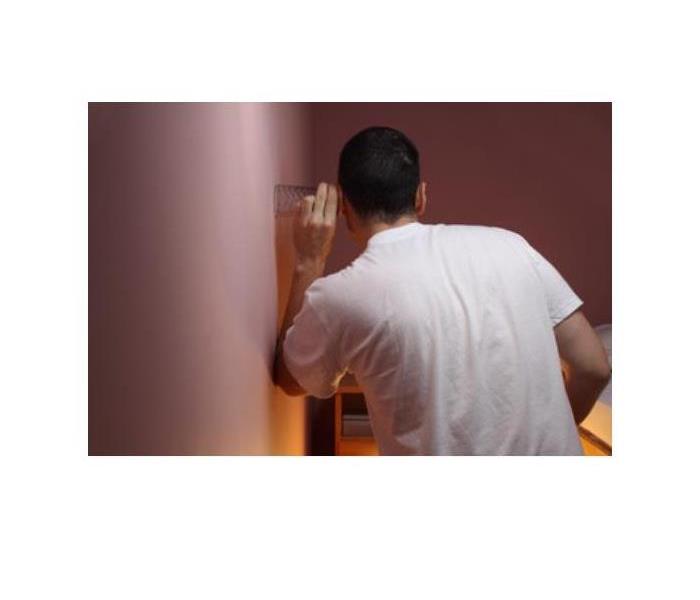 If you are hearing sounds of dripping water, rushing water, it seems that your home might have already become a victim of water damage
If you are hearing sounds of dripping water, rushing water, it seems that your home might have already become a victim of water damage
When most people hear the phrase Water Damage, they think of water heater issues, overflowing sinks, and water leaking through the ceiling.
And while those are disastrous examples of what a water damage event can look like, sometimes a less dramatic situation can cause quite a scene.
Detecting water damage can be a difficult task as often water damage losses don’t become evident right away. In fact, most of them exist over a prolonged period before being identified and restored. By that time, the underlying problem causing the water damage becomes really severe and managing it becomes extremely difficult. For avoiding any such situation and ensuring that you contact the water restoration company before the problem turns bigger, you must get acquainted with the preliminary warning signs. The section below would introduce you to the most common indicators of water damage.
Sound- If you think that all the signs of water damage are meant to be seen, you are wrong. There are some signs that can be heard. If you are hearing sounds of dripping water, rushing water, or creaking floorboards, it seems that your home might have already become a victim of water damage. It’s true that such sounds might also occur in spite of having a healthy plumbing system; however, still, you must get your home checked for water damage if you hear the sounds constantly.
Smell- You must also keep your nose alert for detecting moisture or water damage in your home. Dampness boasts a distinct odor; it might resemble the pungent smell we usually associate with mold. So, when checking your home for water damage, you should look for smell besides other obvious indicators.
Puddles- If there’s a leak in your home’s plumbing system or if something in the system is dripping, you might soon see pools of water develop along the problematic area. Whenever you find any unusual puddle, do monitor it and find out whether it returns after being cleaned up. A puddle that comes back even after being cleaned up might be a sign of a seepage or leak.
Mold- Mold typically occurs only when there’s water damage. You might not need to hire a water damage restoration service provider if condensation in the bathroom has resulted in mold formation. However, you will have to treat mold as a sign of excessive moisture formation in certain parts of your house and do the needful for getting those affected areas dried as quickly as possible. Getting rid of mold is also necessary for health reasons; that’s because exposure to mold might make you and your family members suffer from allergy, headaches, and nausea.
Coolness- Are you finding it hard to heat up your home? If yes, treat the problem as a sign of dampness in your walls. Accumulated moisture will tend to draw out heat of the walls so that it can get evaporated. This makes the walls and the entire home much colder.
Discoloration- Here, it must be noted that discoloration can occur due to a number of reasons; so, it’s important to make sure that the discoloration in your home is actually a result of water damage. If the discoloration has been caused by water “streaks” running down along an end of your house, it’s definitely a sign of water damage. In most cases, those streaks occur due to an overfull gutter.
If you notice any of these or other signs of a potential water loss contact a plumber to determine and repair the source of the loss, and if you are having trouble locating a plumber we can make a referral. After the cause of water loss has been fixed contact SERVPRO of West Riverside City for restoration and repair of your damaged property.
Notice Standing Water? 3 Surprising Threats to Be Aware Of
1/8/2020 (Permalink)
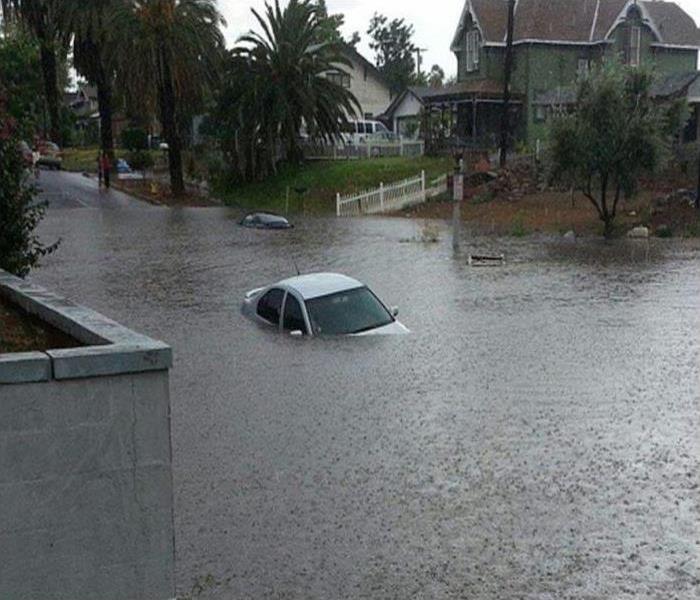 A car is stranded in Riverside after heavy rain caused flooding on Sunday, Sept. 7, 2014. (Picture Credit : ABC7 viewer Matt Willhite).
A car is stranded in Riverside after heavy rain caused flooding on Sunday, Sept. 7, 2014. (Picture Credit : ABC7 viewer Matt Willhite).
3 Surprising Threats Associated With Standing Floodwaters
A flood can be one of the most devastating natural disasters you will experience during your lifetime. Floodwaters have the potential to completely devastate any area they pass through. At their worst, floods can lift homes off their foundations and crash through walls. Even a small flood can cause damage to your home by saturating your flooring and wall materials with water.
All homeowners need to be aware of the dangers that floodwaters pose so that they can take action to protect themselves in the aftermath of a flood. Standing floodwaters come with a variety of damages and threats. Learn about three surprising threats you should be mindful of as you assess the damage to your home following a flood.
ElectrocutionOne of the deadliest risks associated with floodwaters is electrocution. Water is a powerful electrical conductor. When floodwaters come into contact with any electrical outlets or wires inside your home, the water has the potential to become electrically charged.
If you step into a pool of this standing floodwater or any exposed part of your body comes into contact with the water, the electrical charge stored in the water could pass through your body and cause serious harm.
Utility companies will typically shut down the electrical grid in any areas affected by a flood, but you should never assume that there is no electrical power to your home. Only a restoration professional with advanced training should enter your home to verify that the power is off at the breaker box and no electricity is circulating through your home.
After a flood or other natural disaster you need to be careful to avoid electrical hazards both in your home and elsewhere.
Shut off electrical power and natural gas or propane tanks in your home to avoid fire, electrocution, or explosions.NEVER touch a fallen power line. Call the power company to report fallen power lines. Avoid contact with overhead power lines during cleanup and other activities.Do not drive through standing water if downed power lines are in the water.If you believe someone has been electrocuted, call or have someone else call 911 or emergency medical help.Explosions If your home is equipped with any appliances that rely on natural gas as a power source, the risk of explosion is present after a flood. Floodwaters can dislodge the pipes that feed natural gas into your home. This creates gas leaks that can trap a buildup of gas inside your residence.
The smallest spark could cause the gas to explode, causing further damage to your home and putting the life of anyone inside the residence at risk. Experienced restoration professionals can detect gas leaks before they begin working to clean up the mess left behind by a flood.
You can take the necessary precautions to address the gas leak, allowing you to maximize your safety after floodwaters recede. Never enter your flooded home if the possibility of a gas leak is present.
DiseaseAnother serious risk associated with floodwaters is disease. The transmission of many communicable diseases can be facilitated by standing floodwaters. Some of these diseases include cholera, typhoid fever, malaria, and West Nile virus.
The water that floods your home during a natural disaster can also become contaminated with raw sewage. Bacteria and other pathogens thrive in the standing water, which makes your flooded home a serious health hazard.
Exposure to contaminated flood water can cause:
Wound infectionsSkin rashGastrointestinal illnessTetanusLeptospirosis (not common)Because of these potential diseases, it's important that you don't come into contact with floodwaters without the proper safety gear. A company that specializes in restoring residential properties following a flood will have the experience and products needed to eliminate the threat of flood-related disease from your home.
A restoration specialist can use powerful chemicals that will disinfect and sanitize all of the surfaces within your home once the flood water has been removed. These same chemicals can also prevent mold growth in your home.
Floods are inherently dangerous, but the dangers don't stop once the active flooding subsides. Standing flood water in your home can increase the risk of electrocution, explosions, and disease transmission following a flood.
Contact SERVPRO of West Riverside City to handle your restoration needs after a flood so that you can avoid any associated dangers created by standing floodwaters.
Winter Weather in Riverside Brings Cold Temperatures, Do Your Pets Get Cold?
1/1/2020 (Permalink)
 SERVPRO of West Riverside loves our furry friends. Keep them warm during the cold wet winter months. Mascot Ellie wears a scarf and hat to keep warm.
SERVPRO of West Riverside loves our furry friends. Keep them warm during the cold wet winter months. Mascot Ellie wears a scarf and hat to keep warm.
You're probably already aware of the risks posed by warm weather and leaving pets in hot cars, but did you know that cold weather also poses serious threats to your pets' health?
Here are some tips to keep your pets safe during cold weather:
Winter wellness: Has your pet had his/her preventive care exam (wellness exam) yet? Cold weather may worsen some medical conditions such as arthritis. Your pet should be examined by a veterinarian at least once a year, and it's as good a time as any to get him/her checked out to make sure (s)he is ready and as healthy as possible for cold weather.
Know the limits: Just like people, pets' cold tolerance can vary from pet to pet based on their coat, body fat stores, activity level, and health. Be aware of your pet's tolerance for cold weather, and adjust accordingly. You will probably need to shorten your dog's walks in very cold weather to protect you both from weather-associated health risks. Arthritic and elderly pets may have more difficulty walking on snow and ice and may be more prone to slipping and falling. Long-haired or thick-coated dogs tend to be more cold-tolerant, but are still at risk in cold weather. Short-haired pets feel the cold faster because they have less protection, and short-legged pets may become cold faster because their bellies and bodies are more likely to come into contact with snow-covered ground. Pets with diabetes, heart disease, kidney disease, or hormonal imbalances (such as Cushing's disease) may have a harder time regulating their body temperature, and may be more susceptible to problems from temperature extremes. The same goes for very young and very old pets. If you need help determining your pet's temperature limits, consult your veterinarian.
Provide choices: Just like you, pets prefer comfortable sleeping places and may change their location based on their need for more or less warmth. Give them some safe options to allow them to vary their sleeping place to adjust to their needs.
Stay inside. Cats and dogs should be kept inside during cold weather. It's a common belief that dogs and cats are resistant than people to cold weather because of their fur, but it's untrue. Like people, cats and dogs are susceptible to frostbite and hypothermia and should be kept inside. Longer-haired and thick-coated dog breeds, such as huskies and other dogs bred for colder climates, are more tolerant of cold weather; but no pet should be left outside for long periods of time in below-freezing weather.
Make some noise: A warm vehicle engine can be an appealing heat source for outdoor and feral cats, but it's deadly. Check underneath your car, bang on the hood, and honk the horn before starting the engine to encourage feline hitchhikers to abandon their roost under the hood.
Check the paws: Check your dog's paws frequently for signs of cold-weather injury or damage, such as cracked paw pads or bleeding. During a walk, a sudden lameness may be due to an injury or may be due to ice accumulation between his/her toes. You may be able to reduce the chance of iceball accumulation by clipping the hair between your dog's toes.
Play dress-up: If your dog has a short coat or seems bothered by the cold weather, consider a sweater or dog coat. Have several on hand, so you can use a dry sweater or coat each time your dog goes outside. Wet sweaters or coats can actually make your dog colder. Some pet owners also use booties to protect their dog's feet; if you choose to use them, make sure they fit properly.
Wipe down: During walks, your dog's feet, legs and belly may pick up deicers, antifreeze, or other chemicals that could be toxic. When you get back inside, wipe down (or wash) your pet's feet, legs and belly to remove these chemicals and reduce the risk that your dog will be poisoned after (s)he licks them off of his/her feet or fur. Consider using pet-safe deicers on your property to protect your pets and the others in your neighborhood.
Collar and chip: Many pets become lost in winter because snow and ice can hide recognizable scents that might normally help your pet find his/her way back home. Make sure your pet has a well-fitting collar with up-to-date identification and contact information. A microchip is a more permanent means of identification, but it's critical that you keep the registration up to date.
Stay home: Hot cars are a known threat to pets, but cold cars also pose significant risk to your pet's health. You're already familiar with how a car can rapidly cool down in cold weather; it becomes like a refrigerator, and can rapidly chill your pet. Pets that are young, old, ill, or thin are particularly susceptible to cold environments and should never be left in cold cars. Limit car travel to only that which is necessary, and don't leave your pet unattended in the vehicle.
Prevent poisoning: Clean up any antifreeze spills quickly, as even small amounts of antifreeze can be deadly. Make sure your pets don't have access to medication bottles, household chemicals, potentially toxic foods such as onions, xylitol (a sugar substitute) and chocolate.
Protect family: Odds are your pet will be spending more time inside during the winter, so it's a good time to make sure your house is properly pet-proofed. Use space heaters with caution around pets, because they can burn or they can be knocked over, potentially starting a fire. Check your furnace before the cold weather sets in to make sure it's working efficiently, and install carbon monoxide detectors to keep your entire family safe from harm. If you have a pet bird, make sure its cage is away from drafts.
Avoid ice: When walking your dog, stay away from frozen ponds, lakes and other water. You don't know if the ice will support your dog's weight, and if your dog breaks through the ice it could be deadly. And if this happens and you instinctively try to save your dog, both of your lives could be in jeopardy.
Provide shelter: We don't recommend keeping any pet outside for long periods of time, but if you are unable to keep your dog inside during cold weather, provide him/her with a warm, solid shelter against wind. Make sure that they have unlimited access to fresh, non-frozen water (by changing the water frequently or using a pet-safe, heated water bowl). The floor of the shelter should be off of the ground (to minimize heat loss into the ground) and the bedding should be thick, dry and changed regularly to provide a warm, dry environment. The door to the shelter should be positioned away from prevailing winds. Space heaters and heat lamps should be avoided because of the risk of burns or fire. Heated pet mats should also be used with caution because they are still capable of causing burns.
Recognize problems: If your pet is whining, shivering, seems anxious, slows down or stops moving, seems weak, or starts looking for warm places to burrow, get them back inside quickly because they are showing signs of hypothermia. Frostbite is harder to detect, and may not be fully recognized until a few days after the damage is done. If you suspect your pet has hypothermia or frostbite, consult your veterinarian immediately.
Be prepared: Cold weather also brings the risks of severe winter weather, blizzards and power outages. Prepare a disaster/emergency kit, and include your pet in your plans. Have enough food, water and medicine (including any prescription medications as well as heartworm and flea/tick preventives) on hand to get through at least 5 days.
Feed well: Keep your pet at a healthy weight throughout the winter. Some pet owners feel that a little extra weight gives their pet some extra protection from cold, but the health risks associated with that extra weight don't make it worth doing. Watch your pet's body condition and keep them in the healthy range. Outdoor pets will require more calories in the winter to generate enough body heat and energy to keep them warm – talk to your veterinarian about your pet's nutritional needs during cold weather.
Cold weather safety for livestock
Companion animals aren't the only animals in need of protection during the winter months. Livestock, including horses, have their own unique considerations and needs when the weather gets colder.
Recognize the importance of early veterinary care: Schedule a veterinary exam early in the season to address any concerns before the harshest conditions arrive. This is a good time to discuss vaccinations, nutritional supplementation, deworming, and other parasite treatment needs. Veterinary attention is especially important for animals that are pregnant, and very young or very old animals may require special attention.
Provide appropriate shelter from the elements: Livestock can generally tolerate cold temperatures, but wind, rain, or snow will require a greater expenditure of calories. With that in mind, be sure they have a way to get out of the elements, especially the wind. Blankets can help protect horses, but a structural shelter with proper ventilation and dry bedding is the best method of protection. If you do blanket your horses, be sure to check underneath often for signs of injury, infection, or malnutrition.
Keep ice to a minimum to prevent injury, and remember to keep driveways clear so veterinarians and farriers can access your animals. Prevent mud management issues in the winter with proper preparation, whether that's through use of material like gravel, sand, or woodchips, or through other methods.
Consider the amount and quality of feed: Besides taking shelter, livestock keep warm by expending energy, which means they need to consume enough calories to heat themselves. Consider talking with your veterinarian to develop a feed plan that meets your animals' nutritional needs. This may mean increasing the amount of feed available to your animals, and/or increasing the quality of feed. Very young, very old, or sick animals will typically have additional nutritional needs during the winter compared to healthy, middle-aged animals.
Ensure access to water: It is crucial that your herd has access to fresh and unfrozen water. Tank heaters or heated buckets can help keep water at a temperature your animals are more comfortable drinking. Livestock will not consume adequate amounts of water if it is near freezing, and consuming enough water is important to your animals' health and well-being in winter months.
Fire and Water Damage in Riverside Hotels
12/25/2019 (Permalink)
Cleaning and restoring your hotel, resort, convention center, or other hospitality business following a fire or water damage event can be a daunting prospect. Luckily, the experts at SERVPRO are here to help. We'll work with your management and staff to make sure any inconvenience to your guests is minimized as we isolate and fully restore the damaged areas.
Fire and Water Damage
Ruined flooring is perhaps the most obvious result of a water damage event. Water can destroy tile, vinyl, and wood flooring. It can also compromise the wooden sub-flooring beneath carpeting. Ceilings may also be affected as water leaking from one floor finds its way to the one beneath. Often times walls (or the bottom portions of them at least) will need to be replaced also, as they're made of porous materials that absorb water.
Soot, smoke damage, and water damage can destroy furniture, artwork, and other hotel property. Customer and client property may be damaged also, adding to your already considerable financial burden.
As costly as a fire or water damage event can be, the costs of not having the cleanup done correctly can be far greater. Improper or incomplete cleaning and restoration can lead to the growth of off-putting and potentially dangerous mold. Mold growth affects air-quality and is malodorous. Few things will damage the carefully maintained reputation of your resort, hotel or convention center quite so quickly as this toxic invader.
Why SERVPRO of West Riverside City ?
At SERVPRO of West Riverside City, we understand that response time is critical when dealing with a fire or water damage event. A fast response can limit damage and potentially reduce costs. We stand ready twenty-four hours a day, seven days a week to serve Inland Empires hotels.
No job is too big or too small for SERVPRO. We scale our response teams and equipment to best suit any given situation and, should the need arise we'll mobilize one of our Commercial Large Loss teams.
Whether you run a hotel, resort, school, or convention center, SERVPRO knows that you'll need to continue operating as cleanup and restoration are performed. We'll coordinate with your management to allow for normal operations to continue around the safely isolated cleanup area.
There is no way to predict when a disaster can strike your business, but there are ways to be prepared for it when it does happen. Why is it important to be prepared? Well, a disaster occurring in your business has the potential to bring your operation to a screeching halt, which means your business could lose more money than it would if you had a plan in place to get things up and running again quickly. Some disasters can lead to a long road to recovery that is not only for commercial restoration but also being able to offer services, help your clients and customers, and start bringing money back in.
SERVPRO of West Riverside City knows just how important a running business is to its owners and is able to establish a plan for your business called an ERP, or Emergency READY Profile.
A no-cost assessment of your facility. This means there is no need to allocate funds, giving you a great value at no cost.A Profile Document containing only the crucial information you will need in case of an emergency. It doesn’t take very long to complete, but it will save you a lot of time (and from one more headache) if you ever need it.A guide to help you get back into your building following a disaster. By having an immediate plan of action, you can help minimize downtime. Establishes SERVPRO of Winter Park as your emergency mitigation and restoration provider. You have a provider that is recognized as an industry leader and is located right here for Winter Park and the surrounding area.Identifies the line of command for authorizing work to begin. This saves time so that we can begin the work of mitigating the damage immediately, which can save you both time and money.Provides important facility details such as priority contact information, priority areas, and shut-off valves. Having a quick reference of what to do, how to do it, and who to call provides solutions in advance of an emergency so that during the emergency you are “Ready for whatever happens.”SERVPRO of West Riverside City provides a host of other restoration services too. In SERVPRO's fifty-years experience, we've become experts in dealing with mold removal, vandalism cleanup, document recovery, and even the isolation and cleanup of biohazards.
Are you ready to set up an Emergency READY Profile for your business or have more questions on what the process is like? Give SERVPRO of West Riverside City a call today at (951) 351-8033.
If you've experienced a fire, or water damage event, visit our website to learn exactly how our many services may be applied to the quick and efficient restoration of your establishment. Or even better, call SERVPRO now at 951-351-8033.
How to Prevent Christmas Tree Fires in your Riverside Home
12/23/2019 (Permalink)
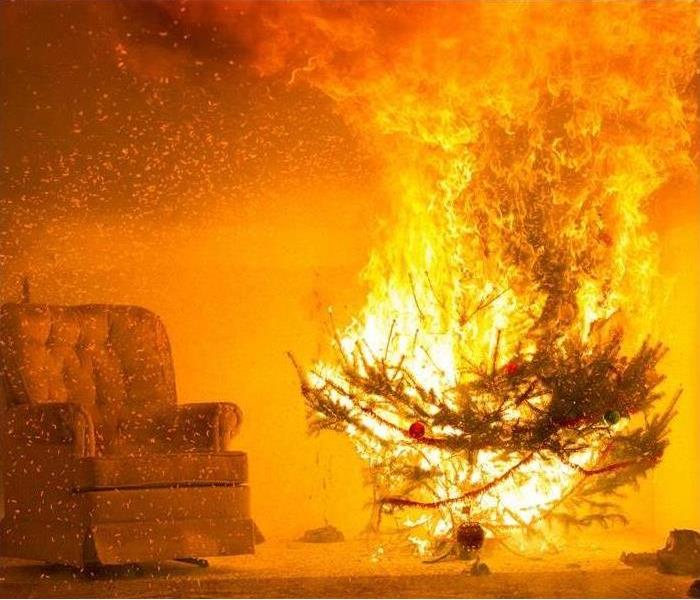 Christmas Trees can start a huge fire that can completely damage your Riverside home. Check out our safety guidelines.
Christmas Trees can start a huge fire that can completely damage your Riverside home. Check out our safety guidelines.
When showcasing a live tree in your home, the combination of tree dryness, electrical malfunction with lights and poorly located heating sources can make for a deadly combination.
Christmas trees account for hundreds of fires each year. Typically, shorts in electrical lights or open flames from candles, lighters or matches start tree fires.
Here are some tips from National Fire Protection Association
Picking the tree
- Choose a tree with fresh, green needles that do not fall off when touched.
Placing the tree
- Before placing the tree in the stand, cut 2” from the base of the trunk.
- Make sure the tree is at least three feet away from any heat source, like fireplaces, radiators, candles, heat vents or lights.
- Make sure the tree is not blocking an exit.
- Add water to the tree stand. Be sure to add water daily.
Lighting the tree
- Use lights that have the label of a recognized testing laboratory. Some lights are only for indoor or outdoor use.
- Replace any string of lights with worn or broken cords or loose bulb connections. Read manufacturer’s instructions for number of light strands to connect.
- Never use lit candles to decorate the tree.
- Always turn off Christmas tree lights before leaving home or going to bed.
Facts
- More than one of every four home Christmas tree fires is caused by electrical problems.
- Although Christmas tree fires are not common, when they do occur, they are more likely to be serious.
- A heat source too close to the tree causes one in every four of the fires.
Pets
When you have the joy of pets, there are precautions that need to be taken to keep them safe. Make sure the tree can not be toppled over by the mischief pet pawing at the delicate ornaments that look ever so tasteful. Loop twine or fishing line around the trunk and tie to a screw in the wall. If there are cords on the floor they can be duct taped down to keep your pets from chewing on them. Keep the needles cleaned up off the floor to keep your pets from licking them and possibly ingesting insecticides or flame retardants.
After Christmas
Get rid of the tree after Christmas or when it is dry. Dried-out trees are a fire danger and should not be left in the home or garage, or placed outside against the home.
- Check with your local community to find a recycling program.
- Bring outdoor electrical lights inside after the holidays to prevent hazards and make them last longer.
SERVPRO of West Riverside team wants to ensure that everyone has a safety in mind. In the unlikely event that a fire were to occur, know that the SERVPRO team in Riverside is ready to assist 24/7 by calling 951-351-8033.
8 Signs that Can Predict a Falling Tree in Riverside City
12/18/2019 (Permalink)
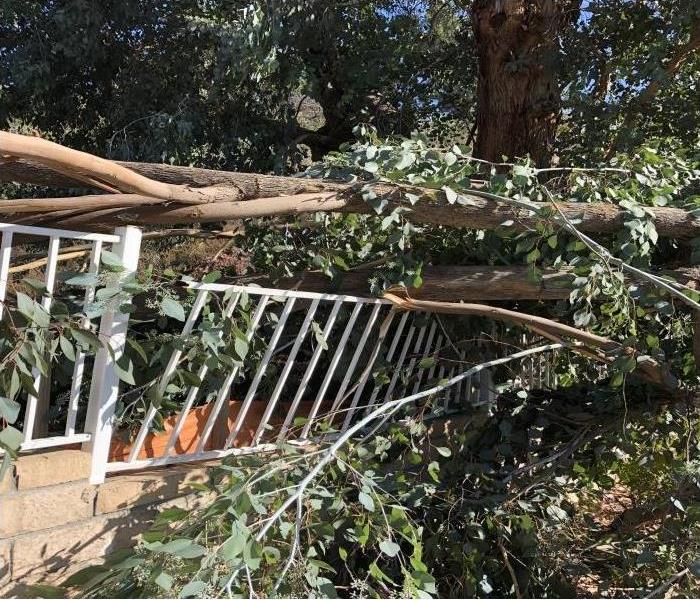 This oversized tree branch broke off the main tree trunk due to not being maintained.
This oversized tree branch broke off the main tree trunk due to not being maintained.
Trees can be the perfect accent to the appearance of your home or property. However, they are also one of the most common sources of roof damage, especially during storms. With storm season among us in Central Florida it is important that homeowners and property managers alike are able to recognize some of the signs of trees that are more likely to fall.
1. Leaning to One Side
A slight lean of your tree should not be a huge concern since most trees do not grow perfectly straight. However, be wary of trees that lean uncomfortably in one direction, especially if in the direction of your roof. Leaning trees that are very close to the point of falling sometimes have exposed roots near the base and cracked soil on the opposite side of the lean. In some cases, the cause of the lean can be a weight distribution issue that can be balanced by pruning branches.
2. Multiple Trunks
If you have a tree with U-shaped multiple trunks, be sure to inspect for deep cracks and other signs of weakness. Mature trees are most at risk for splitting down the middle during heavy rains and stormy weather. To prevent the tree’s splitting, consider hiring a certified arborist who can attach cables between trunks and braces to strengthen their bonds.
The best offense is a good defense when it comes to protecting your roof from falling trees. Take the time to inspect trees on your property and mark ones that match some of the above warning signs. Don’t be afraid to remove unstable trees, though you should call an arborist before attempting to fell the tree yourself.
3. A Hole in the Trunk
A cavity can form in the trunk of a tree when the tree prunes itself by dropping a branch. That can lead to decay inside the tree. This doesn’t always mean danger, though, according to the United States Department of Agriculture Forest Service. If there’s enough sound wood around the cavity, the tree probably won’t fall.
4. Missing Bark or Deep Cracks
An area where tree bark is missing, gashed or indented is called a “canker”. A canker can make a tree more likely to break at that spot, even if the wood looks OK, according to the International Association of Certified Home Inspectors (InterNACHI). Deep cracks in the bark are a bad sign, too.
5. Dead or Falling Branches
When trees start dropping bits of branches or entire branches, it’s a clue that something’s wrong. The tree tries to make itself smaller so there is not as much to feed. Dead branches are a major danger and can come crashing down even on a calm day, according to the USDA Forest Service
6. Losing Leaves from the Outside In
When a tree loses leaves in this pattern often it means something is wrong with the root zone. The root zone is where the tree gets nutrients and water — and it’s what holds the tree up. Without a healthy root system, a tree can fall more easily.
7. Rotten Roots
Root rot can be hard to spot. Look for mushrooms growing around the base of a tree. Fungi growing on the trunk can be another clue that the tree is rotting inside.
8. Tight Branch Growth
When branches grow close together in a V-shape, it’s a bad sign. A strong union will be U-shaped. Elm, maple, oak, yellow poplar and willow trees tend to break at weak forks. When the wind blows, these trees can fall apart. This problem is easiest to spot in winter after the leaves have fallen off.
Risks After Roof Damage From Fallen Trees
The roof is a protector of your home. So, make sure your trees are ready to withstand the stormy weather. A damaged roof may make it easier for your property’s interior to sustain additional damage from water and in many cases mold growth. If you have sustained roof damage, make sure to call a professional roofer to repair the damage. Also, should the roof be damaged during a storm, SERVPRO of west Riverside City is available 24/7 at 951-351-8033 to extract water and dry your property to prevent further damage.
How Riverside Residents Can Avoid Claim Denials for Water Damage
12/16/2019 (Permalink)
Asking your insurance adjuster if you're more likely to be approved or denied when they're on-site is an opportunity to get answers to concerns.
Home insurance claims stemming from water damage are among the most frequent of insurance claims around. We will cover water damage types, what damage is covered and what claims are typically made by homeowners. We will also cover why home insurance companies deny certain claims and how to avoid these denials.
Types of Water Damage
There are many kinds of water damage. Different homeowner’s insurance policies will cover different types of damages and situations. Some of the more common sorts of water damage that will show up on a policy as either covered or excluded from coverage include:
• Water damage caused by heavy storms
• Flood damage
• Water backup or sewer backup
• Accidental or sudden discharge
• Overflow
Home Insurance Claims for Water Damage
Homeowners usually want to know what sorts of water damage will be covered by their policies. Common types of water damage inquiries are for leaks, such as from leaky roofs, toilets or pipes around the house that distribute water. Coverage for water damages will be determined by the damage’s origin, the policy that the homeowner signed up for and if the claimed damage is both sudden and accidental or if the damage was gradual.
Gradual Damage
Gradual damage is water damage deemed to occur slowly over a long period of time. Some forms of gradual damage will be hard to spot until it is too late, such as when the damage is occurring within the interior walls of a home. Though these sorts of issues can lead to structural damage down the road, most of these damage claims would be denied since they didn’t occur both accidentally and suddenly.
Homeowners frequently make claims ultimately caused by gradual damage such as the following:
• Leaky pipes, plumbing, and faucets damaging walls, floors, and ceilings.
• Watering seeping in from foundation weaknesses or from holes around the home’s exterior.
• Worn down tiles, flashing or other roofing materials that are allowing water to enter the home.
• Damage due to corroded, moldy or rotting materials.
• Electrical wiring that has become worn and less effective.
• Sub-standard home repairs or non-repairs.
Though not always, insurance companies may cover the “resulting damage” of issues or parts that originally wouldn’t have been covered by the present policy.
If a homeowner wants to know the finer details of what is covered and not covered in their policies, then it’s best to consult the insurance company or their insurance broker or advisor. They can go over the exclusions and details of a homeowner’s insurance policy for complete coverage details.
Reasons that Claims can be Denied
Homeowners insurance claims can be denied for a variety of reasons. Gradual damage, coverage lapses or miscommunications are just a few reasons for claim denials. No matter the reason, the homeowner should request a complete explanation of why the claim is not being granted. This includes an elaboration of which part of the wording within the policy doesn’t apply to what the homeowner is seeking compensation for.
Keep in mind that many people represent the home insurance organization during the claims process, so it’s a good idea to determine from whom the denial is coming from. Was it the contractor, an insurance agent or a claims adjuster? Each person has a different role within the organization, opening different paths for reviewing or negotiating through the process.
One reason for the claim being denied was that it was for an issue that the homeowner had to specifically request or endorse beforehand. It’s one of the homeowner’s rights to know what conditions were covered on their policies for present and future reference, including the optional endorsements and features.
How to Avoid Claim Denials
• Keep records of home repairs, including the names of the professionals hired for the home’s maintenance.
• Maintain an accurate account of the homeowner’s responsibilities and of the policies and exclusions of the insurance coverage package.
• Implement periodic home maintenance, at least every spring and fall to mitigate and prevent damage.
• Select the best insurance package for the specific needs of the home and look into extra features that can provide added value.
Why Mold Protocol and Post-Remediation Testing is Recommended for your Riverside Home
12/16/2019 (Permalink)
Mold Remediation Protocol
Mold Remediation protocol accurately assesses the proper treatment and removal of mold in areas of a building that have been affected by mold. Mold lab results can be combined with the findings of the professional mold inspection and an intimate understanding of the property’s layout. Using all of this knowledge and data, the remediation professionals can devise a plan that is tailored to the specific mold problems impacting a client’s property. Adhering to the protocol’s instructions ensures that the company performing the remediation can complete the process safely and promptly. Among other things, the protocol can specify when carpets, furniture, and other items that have been impacted by mold can still be cleaned and when it’s time for these materials to be removed.
Steps of the Protocol
The following are the steps required during the protocol process.
Interview
The property’s present conditions are surveyed and discussed with a person who is authorized to handle the property’s affairs.
Site Assessment
The areas that were affected are given a physical site assessment. The site assessment accomplishes several functions: the site assessment visually inspects the damage(s), gathers temperature and relative humidity (RH) readings, takes air samples and direct samples for mold (if necessary), and collects room dimensions to draft the required floor and room drawings to specify the location(s) of concern.
Air Sampling
Non-viable spore trap air sampling is designed to get an approximation of the concentration of airborne microbial (fungal) spores. The most commonly used entrance of the property is used to collect at least one outside sample. After the outside sample is taken, air samples are gathered in the property’s areas of concern. If elevated airborne spore concentration levels are detected, this may mean that there is one or more indoor microbial reservoir(s). It may also mean that the microbial remediation plan must include either the cleaning of the HVAC system(s) or of personal effects within the building.
Direct Sampling
Direct sampling is used to pinpoint the type and relative concentration of the microbial spores that have affected tested materials. The direct sampling results are also used as source contamination reference material during the air sampling process.
California State Guidelines
At present, California has no state regulations about mold inspection, assessment, or remediation. Any business is subject to local requirements, such as for a business license. A company performing building construction or improvement valued at $500 or more (labor and materials costs) must have a state contractors’ license.
Benefits of a Protocol
A protocol ensure that mold contaminations are properly assessed to facilitate the remediation process. It protects property owners from having to pay for additional remediation fees. It also provides a safe and healthy environment for visitors, residents, remediation companies, and property owners.
Why Post-Remediation Testing is Recommended
Mold is not always visible and is capable of hiding away quietly inside of walls and deep under foundations eating away at the crucial structures of your home. It is also very common that complications related to the health of those who come into contact with mold are reported. Mold remediation, the treatment and/or removal of mold, can be costly but not nearly as costly as a failure to address the issue. The longer mold goes unnoticed and unmitigated, the further it can spread and more damage it can cause. If you discover a potential mold problem, you should absolutely have it tested and addressed. However, remediation efforts should always be followed up with a post-remediation mold test.
Why Do I Need the Post-Remediation Test?
A post-remediation test is sometimes referred to as a clearance test. It is essentially the same test that was conducted to find mold in the first place, only this time there should be no high concentrations of mold spores in the samples taken. If the air samples show the number of spores have been reduced to normal levels or below, the problem has been addressed correctly.
If proper protocols are not followed, however, mold will continue to grow without you being aware of it. A post-remediation clearance test is the only true way to determine if your remediation was successful. Ordering the test allows you to either have the peace of mind of knowing your home is mold-free or have the remediation company revisit the remediation to achieve the necessary results.
SERVPRO of West Riverside City
Our franchise performs the remediation portion of the mold process and has certified professional mold technicians. If you believe you have a mold issue and are seeking the help of a highly trained professional, give us a call today at (951) 351-8033.
I keep Experiencing Mold Regrowth in my Riverside Home
12/11/2019 (Permalink)
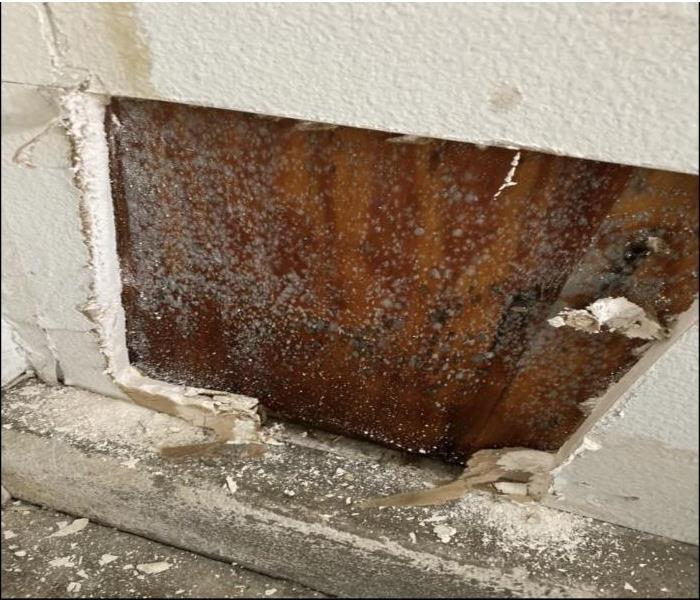 After a water heater leak, mold was found underneath drywall on the shear wall.
After a water heater leak, mold was found underneath drywall on the shear wall.
8 Reasons Mold Can Keep Coming Back
Mold is stubborn. It can spread throughout a property very quickly and even cause a variety of health issues for individuals who occupy the same space. Mold is extremely persistent and has been known to return even after it has been cleaned. Many homeowners and business managers make the choice to handle mold issues themselves and try using ordinary cleaning methods that just are not effective when dealing with this type of problem.
What is Mold Exactly?
Mold is commonly mistaken for and treated as a stain or dirt, however, mold is actually a living organism that grows, especially in damp places. Mold spreads by releasing microscopic spores into the air. In fact, mold spores are naturally in the air all around us. It is actually impossible to completely remove mold spores from the air. Understanding why mold can keep coming back can help ensure that you make the right decisions towards removing it if it becomes your problem to handle. Here are some reasons that mold can return in a property:
1. Neglecting Water Damage
Water damage can occur in numerous ways in properties including roof leaks, overflowing toilets, leaky pipes, faulty dishwashers, etc. Disasters happen. However, making sure that water is cleaned up and any moisture is removed from affected materials quickly can prevent further damage. Water damage that has been neglected or gone unnoticed can lead to mold growth in as quick as 48 hours.
2. Cleaning Porous Materials
DIY cleaning methods can sometimes be effective if the surface being cleaned is non-porous. Most cleaning methods will not work for porous materials, such as wood and drywall, because the mold will avoid the cleaning agent by retreating deeper into the material, only to resurface again later. Cleaning portions of the mold is ineffective if the nucleus is not destroyed. Affected materials should be carefully removed, discarded, and replaced to ensure the mold does not return.
3. Painting Over Mold
It is not uncommon to find that a previous mold problem was simply painted over to hide the temporarily hide the issue from new tenants or homeowners. The mold usually does not take long to eat through the paint and reappear. Not to mention, hiding the mold does nothing to solve the issue of damage spreading behind the wall.
4. Excess Moisture and Ignoring Source
Since mold thrives in damp areas, the first step to removing it is to reduce the moisture levels in a home. Disregarding the source of the mold issue only means that the problem may occur again. Call a professional to fix leaky pipes, broken air conditioning units, roof damage, etc. and use a dehumidifier to get the moisture out of the air. Similarly, it is important that all damp fabric is allowed to completely dry. Hang up towels so that they can fully dry. Kitchens, basements, and bathrooms are common places for mold.
5. Indoor Humidity
Mold is extremely common in Florida due to high humidity levels that allow mold to thrive. Making sure your air conditioning is running correctly and constantly can help prevent high humidity in your property making it more difficult for mold to grow. Indoor humidity that exceeds 60% can become a source for mold all on its own. Also, make sure that every room has proper ventilation so that any excess moisture in the air does not become stagnant and cause an ideal environment for mold to grow in.
6. Generic Cleaning Products
Generic or all-around cleaners will not work on mold. Bleach does not work for all species of mold. It can be effective on certain species of mold but inefficient for others sometimes making the situation worse. Make sure to experiment with natural alternatives and invest in mold-specific cleaners. Be generous as you spray and do not wipe it right away. The cleaner needs to work its magic and kill the living mold at its nucleus. The most effective method is to test for mold and receive a treatment protocol from a licensed mold assessor.
7. Keeping Affected Items
Some items may be permanently affected by mold. If an old couch has a lot of mold on it, you may have to get rid of it instead of trying to save it. Similarly, glass is easy to clean whereas wood is harder and will most likely have to removed and replaced. Wash clothing and discard any items deeply affected by the mold. This can minimize the risk of the mold spreading back to the structural components of your home. To be on the safe side, it is best to hire a professional remediation company with experience in salvaging materials affected by mold.
8. Not Consulting Professionals
If you have dealt with major water damage to your home, it is wise to try and get ahead of mold issues by consulting professionals. Experts know where mold is likely to fester, and they can use the best equipment and techniques to properly remediate the issue. You may not have the expertise to do everything yourself. They know why mold may be returning, and they have the tools to get rid of it for good. Investing in professionals' services protects your home, furniture and family's health. Proper air quality testing by an environmental hygienist can provide accurate insights into the type of mold you have, its source, areas affected, and how to remove it for your specific instance.
Mold is persistent and can grow very quickly. If you have tried to remove it and it returns, know that this is normal. Oftentimes, homeowners can make a mold situation worse, which makes the remediation more costly. For the best results, call in professionals to keep mold from returning. The quicker you act, the better.
SERVPRO is a leader in Fire and Water Cleanup and Restoration, but our professional mold remediation service can also make it "Like it never even happened."
Preventing Mold in Commercial Properties in Riverside City
12/9/2019 (Permalink)
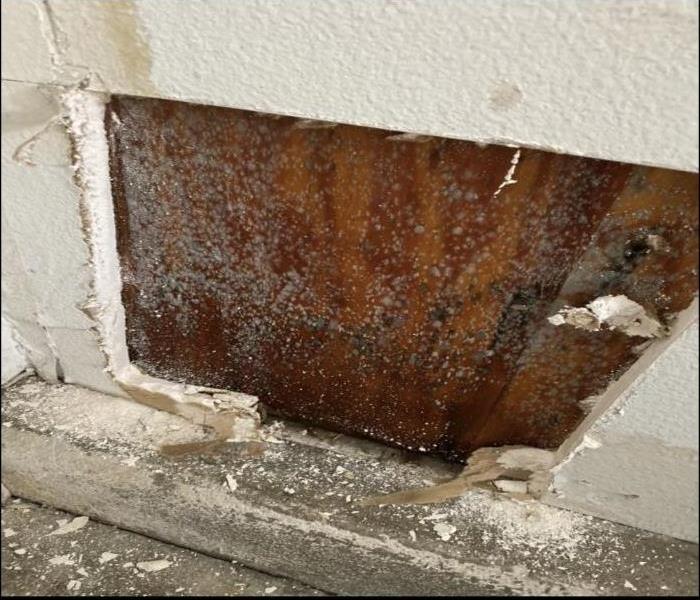 A water leak caused drywall damage. Mold was found behind the drywall. SERVPRO was here to help!
A water leak caused drywall damage. Mold was found behind the drywall. SERVPRO was here to help!
Mold growth in your commercial property can lead to structural damage to the property itself and health concerns for those exposed to it. There are many factors that can lead to mold growth as well as steps that can be taken as preventative measures. This article will cover both to keep you, the business manager or owner, better informed and prepared to handle a mold situation.
How Mold Can Spread in Commercial Properties
Mold thrives in damp, dark places. So you can find mold just about anywhere that moisture lingers in the air. Mold spores can cling to and grow on a variety of building surfaces including stone, brick, wood, drywall, and metal.
Here are three factors that contribute to the formation and spreading of commercial mold.
1. Moisture Due to Humid Conditions
When outside temperatures fall during the fall and winter seasons, mold often begins to form indoors where the air is warmer and more humid.
You can sometimes see condensation forming on the interior of glass windows and skylights. If this moisture drips down the walls and manages to penetrate into seams and cracks in the walls, it is very likely that mold will begin to grow.
2. Water Leaks From Roof and Plumbing
One of the biggest causes of mold infestations is leaks in the roof or leaky pipes in the walls. These leaks often go undetected for months or even years, allowing massive colonies of mold to fill the spaces in attics and inside walls and ceilings.
This water damage combined with mold can cause tens of thousands of dollars in damage, and it often will require entire facilities to be shut down for mold restoration and remodeling.
3. Condensation forming in an HVAC system
Other troublesome spots where mold forms in commercial buildings are the heating, ventilation, and cooling (HVAC) system. Due to the heating and cooling of the metal ducts and vents, condensation often forms on these surfaces that are hidden away from view. These dark, damp places become a breeding ground for various types of mold.
And the worst part is that the ventilation system then blows mold spores throughout the entire building. Those spores can lie dormant for a very long time. But once they come in contact with moisture, they can begin to grow and spread.
How to Prevent the Spread of Mold in Commercial Properties
Preventing the spread of mold should be a high priority for commercial property managers. Whenever mold or water leaks are discovered, swift action must be taken to prevent further growth and damage. Here are three strategies that need to be implemented consistently.
1. Inspect Moisture-Prone Areas Regularly
As noted above, the HVAC system needs to be routinely inspected for mold and moisture, particularly the evaporator coils and drain pans and pipes. Surfaces should be inspected, cleaned and disinfected once a year or more if necessary.
Roof tiles should also receive a professional inspection annually, and attic spaces should be checked for water damage too.
All kitchen and bath areas should be checked, including in the backs of cabinets and vanities, as mold thrives in dark spaces. And again, all surfaces should be cleaned regularly.
2. Clean and Disinfect All Surfaces Frequently
Routine cleaning cannot be emphasized enough. Not only should areas when mold and moisture are spotted be cleaned thoroughly, but all floors, walls and counter spaces should be disinfected regularly to kill spores that lie dormant.
3. Use Dehumidifiers to Reduce Moisture in the Air
Lastly, some commercial buildings that have routinely humid conditions might benefit from the use of dehumidifiers placed throughout the building or in conjunction with the HVAC system. These remove excess moisture from the air and make it difficult for mold spores to grow.
Fighting commercial mold can be a challenge for business owners and commercial property managers, but by knowing what to look for - and by engaging in consistent and thorough cleaning practices - mold can be kept in check to provide a safe environment for everyone.
What about Preventing Mold in your Maintenance Closet?
Lack of Air Circulation
Closets, in general, are a very common hiding place for mold. This is due to the fact that there is usually an absence of ventilation in closets. When you open a closet and then close it shut moist air can easily become trapped within. The moisture will usually lead to condensation on the wall without the chance of evaporation. This provides an excellent environment for mold to thrive in.
How to Prevent
The simplest task you can perform is to routinely check the walls in the closet for condensation. This can help you notice a moisture issue before it becomes a mold issue. However, the best way to prevent the problem is to create an avenue for air to circulate in and out of the closet. Installing air vents on the upper and lower areas of the closet door can help ensure better airflow and prevent moisture from being trapped
Leaking Water Heater
Many times, utility closets will share a space with a water heater. If the equipment has not been maintained, it is common for a leak to occur.
How to Prevent
Be sure to run routine checks on your water heater to make sure it is working efficiently for you and not causing a water damage situation in your closet which could lead to mold growth
Mop Buckets and Cleaning Supplies
Maintenance closets are usually deemed the perfect place for hiding mops, buckets, used towels, and other cleaning supplies. However, these items can lend to the moisture that gets trapped in your closet and leads to mold. This is especially true, for mop bucket spills!
How to Prevent
If possible, keep the items mentioned above away from your storage closet. If you must store them there, make sure that mop buckets are emptied and wiped dry. Mops should be squeezed of excess moisture and towels should only be returned to the closet if dry.
Floor Clutter
Clutter along the floor of your maintenance closet is the perfect opportunity to hide spills, moisture, and mold growth from your line of sight.
How to Prevent
Try to keep clutter to a minimum and put loose items on shelves in your maintenance closet. This makes it much easier to identify moisture on your closet floor or even cleaning after water damage that may have seeped into the closet.
Roof Tarps: Preventing Further Storm Damage to Your Riverside Home
12/5/2019 (Permalink)
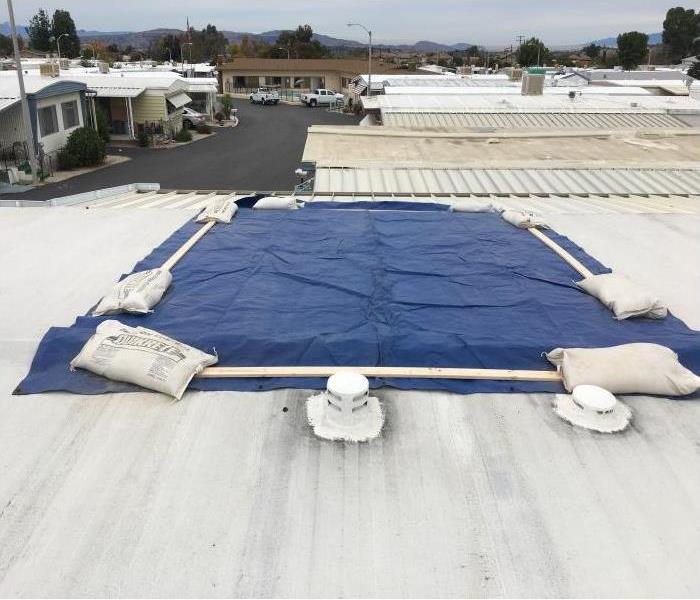 This Yucaipa home experienced water leaking in the living room from the rain. We used a tarp to prevent further damage with upcoming rain.
This Yucaipa home experienced water leaking in the living room from the rain. We used a tarp to prevent further damage with upcoming rain.
With the crazy winds and weather we have been experiencing, it is possible your home or business may be damaged by the elements. Roof damage can be caused by heavy rains, winds or falling debris.
To reduce the possibility of even more damage, some may use a roof tarp, offering a quick solution and a gap of time until better weather permits a safe inspection and repair.
It seems like a good, and cheap, way to quickly cover the holes in the roof, stop the water leak, and prevent rodents from entering the home or business through those holes, although we do not recommend this as a permanent solution to the problem.
It will wear out over time.It is only a temporary fix, and can cause more problems as time passes.If the roof has water damage, mold could be growing in the affected areas.Wind can move the tarp, leaving spaces uncovered and the roof will leak again.If not installed properly, it could hold pools of standing water, aka, mosquitoes.The tarp can increase the heat inside your home or business. Heat and moisture trapped under the tarp may cause mold and other damage inside your property.Before you climb up to fix a tarp yourself, consider the following safety information:
Never get onto your roof during a lightning storm.Steep roofing surfaces require specialized harness systems.Falls from the roof account for 30 percent of construction accidents and up to 75 percent of fatalities.Did you know SERVPRO of West Riverside City can help you with your damaged roof? SERVPRO of West Riverside City does more than just fire, water and mold restoration and clean-up. Our crew is well trained for storms; including installing a tarp on your roof! Our team has been trained on how to safely tarp a roof.
The first step technicians take is inspecting the extent of the damage. You may also want to take photographs of the wind damage to the roof. The records from the technicians and your camera should be shared with the insurance company as evidence for y our claim. If possible, provide some pictures of the condition of your home before the storm.
Removing Storm Debris
If there are tree branches or other storm debris on top of your home, storm restoration technicians clean up the mess. They may also trim up any trees or bushes that pose further risk.
Setting Up Tarps To Cover Holes
Technicians work quickly to cover roof damage, such as holes, with tarps, plywood, and hardware. They'll lay out the tarp to provide a wide barrier that keeps moisture out of cracks and holes. The plywood is often used to secure the tarp, so further wind damage can be avoided.
Preparing a Restoration Plan
Once further storm damage is prevented, technicians create a plan for repairing the damage to your roof. In addition to carrying out the necessary permanent repairs, the home remediation experts may help you prepare a plan for preventing future wind damage.
Prepare Today
Many Riverside, homeowners are concerned when heavy storms hit their neighborhoods. You don't have to worry when you have taken steps to prevent roof damage. Don't wait until a storm hits to get professional advice on preparing your roof. Find the information you need and ease your concerns today.
If your home or business' roof gets damaged during a storm give our office a call 951-351-8033. We are available 24/7 for calls and services. We will have a technician sent out to save the day as quickly as possible to your location!
We service all of Inland Empire and surrounding counties. Call us, we're here to help!!
SERVPRO Of West Riverside is "Always Here To Help" If You Experience Water Heater Overflow, Even During the Holiday!
12/2/2019 (Permalink)
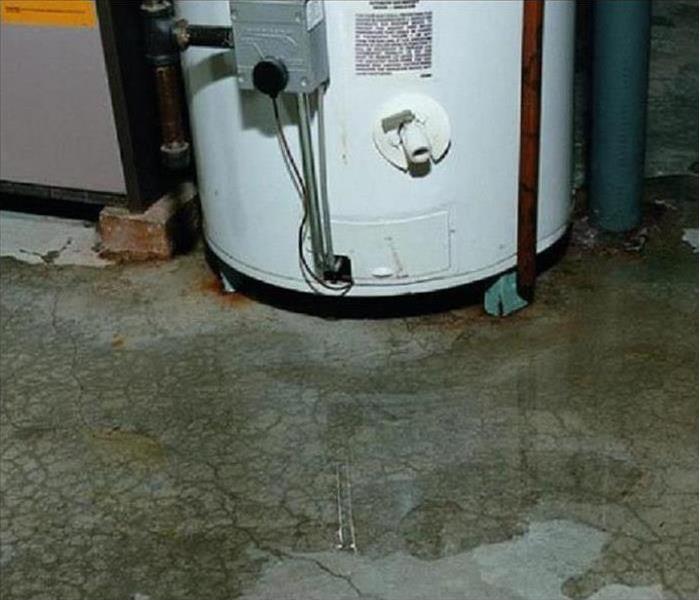 SERVPRO of West Riverside has helped many home owners with water damage leaks due to water heater issues. Call us were available 24/7!
SERVPRO of West Riverside has helped many home owners with water damage leaks due to water heater issues. Call us were available 24/7!
Water Heater Overflow Cleanup
One of the most prevalent causes of indoor flooding is water heater overflows. These water heaters are usually located in, attics, garages, or a utility room closet; places people don't go very often. So, if a burst or leak happens, the homeowner or tenant likely would not find the problem until after a significant water intrusion has already occurred. If this were to happen to you, you'll want to stay calm, shut off the heater and water, and contact the SERVPRO of West Riverside professionals for help.
SERVPRO of West Riverside has the professionals who are equipped to handle a water heater overflow. They have the knowledge, tools, and experience to deal with the situation safely and effectively whether it's your home or workplace that is in jeopardy.
How Do Water Heater Overflows Happen?
Water heater related floods usually occur due to a worn out seal or gasket, or from a leak in an older tank that rusted through. Sometimes a tank can actually explode or burst in a violent and dangerous manner. This could cause serious harm to anyone who is in the immediate vicinity of the water heater at the time of the explosion. Leaks are more common than bursts and have the potential to flood large portions of a home or garage if the leaking is undetected for days on end.
A malfunctioning thermostat is usually the cause of a water heater burst. These thermostats are used to measure the temperature inside the tank to turn the heating elements off and on so that a preset desired temperature range can be maintained. In the event of a broken thermostat, the heating system inside the tank could stay on indefinitely and cause the water to boil. This boiling water turns into steam and builds up internal pressure inside the tank. This internal pressure will build up and eventually reach a point where the tank cannot hold it, which will result in a burst or even explosion.
When such a burst occurs, steam and boiling water rush out of the tank, while cold water from the intake line flows into the tank. Normally, the line will shut itself off, preventing water entry when the tank if full. However, in this situation, the burst tank is never full because of the continual leaking, and the water from the main line flows through indefinitely. Water is entering the tank only to leak back out and flood the area around and below the water heater. The only upside to this scenario is that someone will likely hear the loud burst and investigate and discover the problem before too much damage has occurred and remediation can be started.
A leak, on the other hand, operates quietly and floods your home, garage, or workplace a little at a time. Usually, it will happen when one of your heating tank's fittings becomes damaged or corroded. This can provide a gap that allows water to escape. This flooding is not violent like a burst or explosion, but it can still be extremely destructive to property and sometimes dangerous to humans or pets. Regular maintenance and inspections of your water heater will increase awareness of possible problems. A professional can replace the anode, flush the corrosion from your tank, as well as check all valves and gaskets for problems or warning signs.
What are the Hazards of Water Heater Overflows?
With the added elements of high temperature and late detection, the number of threats with water heater flooding exceeds that of normal flooding. Here are some things to look out for in the event of a water heater overflow:
Hot water burns – The initial burst of water from a heater is scalding hot, so be sure not to rush in, especially if you see steam. Use protective clothing before attempting anything. Ideally, call SERVPRO of West Riverside to do the job for you. (951) 351-8033Potential fire starter – Flooding doesn’t just create an electrical hazard, it can also short-circuit your electrical system and create sparks. Faulty electrical wiring is one of the most common causes of fire.Water damage – When the water spills beyond the immediate surroundings of the heater and gets into your living and work spaces, the threat of water damage arises. Water can ruin carpets, damage wood, corrode metals and toast expensive appliances and machinery.Mold growth – Mold spores can activate in places where there’s sufficient moisture and organic matter to sustain them. If your property was flooded by an overflowing heater, there’s a good chance that mold growth can follow suit. While seemingly harmless at first glance, mold can irritate our noses and skin when its spores are inhaled. Under certain conditions, mold colonies can turn black and toxic. The poison they produce has been linked to neurological disorders and even cancer.Contact SERVPRO of West Riverside now at (951) 351-8033
A water heater overflow is an emergency that should be addressed rapidly and decisively. The longer you wait the worse it can get and attempting to repair the water heater and clean up the water yourself could be dangerous and risky. Contact an experienced professional through SERVPRO of West Riverside today for a quick and easy resolution to your problem. "We're Always Here to Help" 24 hours a day, seven days a week, all year long.
Riverside, Are you Traveling for the Holidays? Here are Some Tips
11/27/2019 (Permalink)
With the holidays in full effect, it’s important to note safe travel practices before heading out on the road this year. Below you’ll find ways to help ensure a safe departure this holiday season - Read on to learn more!
If you are traveling during the holiday season, don’t let the stress of the hustle and bustle get you down. Realize ahead of time that there are millions of others that are also traveling and take steps to help cope with the situations that may arise due to the busy holiday traveling season. Travelchannel.com has provided the following tips to help you survive and calmly get to your destination.
HOLIDAY TRAVEL TIPS
- Do Your Research: Plan alternative routes when traffic gets overwhelming. Maybe there is a more scenic route that might take a little longer but has less traffic. When flying, be sure to check the airline’s restrictions ahead of time. Know the fees for carry-on luggage and checked bags.
- Stay Connected: Load your smartphone with all the latest travel apps before leaving home. There are apps to provide updates on flights, airport lines, cheapest gas, cleanest bathrooms, etc. You name it and there’s probably an app for that!
- Pack Light: If possible, avoid checking bags at the airport altogether.
- Pack Earplugs: The best way to escape stressful surroundings is to escape to a quiet place. Pack earplugs to turn down the crying babies, loud music, or loud talker sitting in the next aisle!
- Pack Snacks & Drinks: It’s more difficult to remain calm and make good decisions when you are hungry and your belly is growling. Always have snacks handy for when the need arises.
- Ship the Gifts or Give Gift Cards: For lighter travel, ship your gifts ahead of time or give gift cards.
- Travel on Off-Peak Days: The day before the holiday is always the most highly traveled. Try traveling on the actual holiday to avoid crowds and traffic.
- Travel Early or Late in the Day: Flights that leave early in the day are on-time more often. And avoid heavier traffic on the highways by traveling by car through the night.
Busy holiday travel is much easier to cope with if it is expected and planned for accordingly. While the hectic crowds and stress may not be completely avoided, one can definitely overcome the challenges by considering these tips when planning travel.
Driving long distance to visit family?
With the holidays in full effect, it’s important to note safe travel practices before heading out on the road this year. Below you’ll find ways to help ensure a safe departure this holiday season - Read on to learn more!
Prepare your Vehicle for Long DistanceCheck your wipers and fluids. Have your radiator and cooling system serviced. Simple maintenance can prevent many of the problems that strand motorists on the side of the road.
Plan AheadBefore you get on a highway, know your exit by name and number, and watch the signs as you near the off-ramp. Drivers making unexpected lane changes to exit often cause accidents.
Do not cut in front of large trucksRemember that trucks are heavier and take longer to make a complete stop, so avoid cutting quickly in front of them.
Beware of truck blind spotsWhen sharing the road with large trucks, be aware of their blind spots. If you can't see the truck driver in his or her mirrors, then the truck driver can't see you.
Check your emergency kit. Contents should include a battery-powered radio, flashlight, blanket, jumper cables, fire extinguisher, first aid kit, bottled water, non-perishable foods, maps, tire-repair kit and flares.Keep your eyes on the road Distracted driving is a major cause of traffic accidents. Even just two seconds of distraction time doubles the chances of an accident. Use your cell phone when stopped and never text while driving.
Leave early and avoid risks Leave early so you won't be anxious about arriving late and to accommodate delays. Road conditions may change due to inclement weather or traffic congestion.
Avoid extreme weather conditionsIce, hail and snow make roads difficult to travel. Try to avoid driving through extreme weather conditions, and travel during daylight.
Remove ice and snow from your vehicleClear snow from your windows and roof to ensure that you have maximum visibility and are not creating a hazard for the vehicle behind you. Don't allow ice and snow to create additional blind spots on your vehicle.
Beware of the vehicle in front of youLeave extra room between you and the vehicle in front so you can avoid snow and ice blowing onto your windshield or maneuver around patches of ice.
Slow downWith the extra highway congestion due to holiday travel, speeding becomes even more dangerous. Allow plenty of space cushion and reduce your speed.
Buckle upSafety belts reduce the risk of fatal injury by 45 percent and are a simple way to increase your safety on the road.
*Information courtesy of the American Trucking Associations
Will you be Frying a Turkey or Roasting one in your Riverside Home?
11/25/2019 (Permalink)
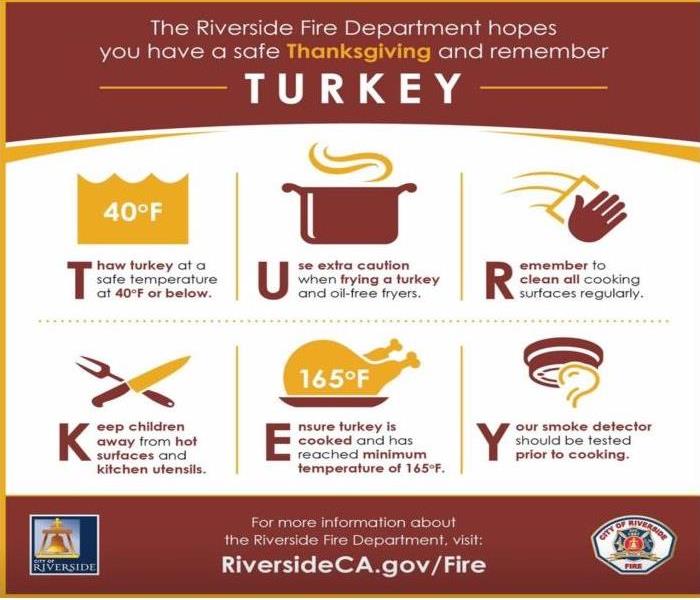 6 Tips from our Riverside Fire Department
6 Tips from our Riverside Fire Department
Riverside families will come together this holiday season. Avoid tragic fires with these cooking tips.
Many families come together over the Holidays for their favorite turkey dinner. It's also a time where family members may want to join in the food preparation so fire safety is important. With the speed of deep-frying a turkey, the irresistible flavor, and juiciness that results, turkey frying has become a Thanksgiving tradition for some. But turkey fryers have the potential to cause fire and serious injury, which is why organizations like Underwriters Laboratories and the National Fire Protection Association advises against using them. If you plan to deep-fry your holiday bird, be sure you know how to safely use the fryer, and take these precautions to protect yourself, your guests and your home.
Many first-timers fill the fryer with too much oil or attempt to fry a turkey that isn't entirely thawed. Both mistakes can cause serious fires. U.S. fire departments respond to more than 1,000 fires each year in which a deep-fryer is involved.
Tips to help prevent deep fried turkey accidents
- Keep outdoor fryers off decks, out of garages and a safe distance away from trees and other structures.
- Make sure the turkey is thawed and dry before cooking. Ice or water that mixes into the hot oil can cause flare-ups.
- Watch the weather. Never operate a fryer outdoors in the rain.
- Place the fryer on a level surface and avoid moving it once it's in use.
- Leave 2 feet between the tank and the burner when using a propane-powered fryer.
- Follow the manufacturer's instructions to avoid overfilling. Oil can ignite when it makes contact with the burner.
- Choose a smaller turkey for frying. A bird that's 8 to 10 pounds is best; pass on turkeys over 12 pounds.
- Never leave fryers unattended.
- Purchase a fryer with temperature controls and watch the oil temperature carefully. Cooking oil that is heated beyond its smoke point can catch fire. If you notice the oil is smoking, turn the fryer off.
- Turn off the burner before lowering the turkey into the oil. Once the turkey is submerged, turn the burner on.
- Wear goggles to shield your eyes, use oven mitts to protect your hands and arms and keep an "ABC" or grease-rated fire extinguisher close by. Do not to use water or a garden hose on a fire related to Turkey Fryers.
- Skip the stuffing when frying turkey and avoid water-based marinades.
- Keep children and pets away from the fryer at all times.
- Once finished, carefully remove the pot from the burner, place it on a level surface and cover to let the oil cool overnight before disposing.
- Opt for an oil-less fryer. This uses infrared heat, rather than oil, to cook the turkey.
If you are cooking in the kitchen
BE PROACTIVE
- Test the batteries in your smoke alarms. Press the test button on your units to make sure they work.
- Prevent fires by making sure your oven and stovetop are clean and free of grease and dust.
BE ATTENTIVE IN THE KITCHEN
In 2015, U.S. fire departments responded to an estimated 1,760 home cooking fires on Thanksgiving. Unattended cooking was by far the leading contributing factor in cooking fires and fire deaths, and cooking equipment was involved in nearly half (48 percent) of all reported home fires. Says ohsonline.com
- Stay in the kitchen when cooking on the stovetop and keep an eye on the food.
- Stay in the home when cooking your turkey as well, and check on it often.
- If you must step away from your cooking, set a kitchen timer so you don’t get distracted by guests.
- Keep children at least three feet away from the stove, oven, hot food and liquids. Steam or splash from vegetables, gravy, or coffee could cause serious burns.
- Keep items that can catch fire, such as oven mitts, wooden utensils, and towels, away from the cooking area.
- Make sure the floor is clear of tripping hazards such as children, toys, bags, or pets that could cause you to fall.
- Keep knives out of the reach of children.
- Turn pot and pan handles inward and away from the front or edge of the stove. If handles are turned outward, they could be jostled or knocked off the stove and spill, causing burns.
- Keep electric cords from appliances such as electric knives or mixers from dangling off the counter in reach of a child.
Should something occur and a fire breaks out SERVPRO of West Riverside City will be on hand. We are ready to help, we are available during holidays. Call us so we can take the stress off your shoulders in order to get your home back, "Like it never even happened."
SERVPRO West Riverside City
951-351-8033
Fire Damage in the Home You Rent in Riverside: Will Your Renter’s Insurance Cover You?
11/20/2019 (Permalink)
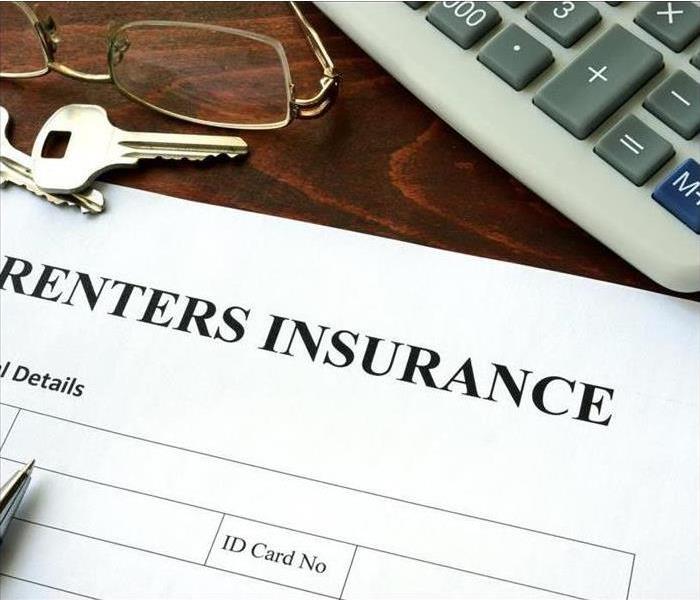 Knowing about the five major coverage areas is a good starting place. Work with your insurance agent, do your research.
Knowing about the five major coverage areas is a good starting place. Work with your insurance agent, do your research.
Experiencing a fire in your Riverside, CA, residence can be unsettling and stressful. Understanding how your renters insurance policy will cover you can provide some peace of mind during a challenging time.
The Big Picture of Fire Coverage
Renters are covered for fire damage, but policies can vary greatly. Knowing a bit about the five major coverage areas is a good starting place.
Personal Property – This coverage allows you to be reimbursed for your personal property loss from a fire.
Liability – This benefit allows payment to others if another person sustains loss or injury as a result of your home fire.
Loss of Use – This coverage reimburses you for expenses you incur if you need to live outside your home while fire restoration proceeds.
Mandatory Evacuations – This applies if you incur living expenses or loss due to a mandatory evacuation of your home.
Natural Peril – If your fire started because of an extreme weather event or natural disaster, this provision requires your policy to cover your damages.
There are a few specific renters insurance provisions that are worthy of consideration as they may vary between policies.
Renter's Policy and Coverage Variables
As with any insurance product, it is prudent to weigh all of the factors when evaluating your current policy or a new one. Comparing coverage limits and deductibles is a good place to start. Your policy will generally cover the professional fire restoration process, but one variable that can make a big difference is the personal property reimbursement provision. Replacement value coverage is far superior as it pays for the cost of replacing your items, not just their current value. It is a good idea to confirm that fire damage will be covered even if it is secondary to an event such as an earthquake. Finally, it’s important to understand whether there are exclusions or exceptions as to the cause of the fire.
If you are preemptively investigating fire insurance for renters, this information may help you shop for the best coverage. If you’ve experienced a fire in your residence, understanding your renters insurance may help relieve your financial concerns and make an unsettling situation less stressful.
There are many renters out there that don’t understand renters insurance, or they don’t think that they need it. Here are 5 myths and facts about renter’s insurance. According to State Farm:
MYTH: The landlord’s insurance covers your possessions. Don’t count on it. Most landlords’ insurance covers only the building and damages due to negligence. Coverage for some of the most common causes of property damage and loss, such as theft, vandalism, and fire, is entirely up to you. Without renter’s insurance, you may have to bear the financial burden of a loss on your own.MYTH: Renters insurance is expensive. In this case, the numbers speak for themselves. According to the IIABA, the average renter’s policy costs just $12 a month for up to $30,000 in personal property coverage. That’s solid coverage for less than the cost of a couple cups of coffee a week.Still concerned about price? Your insurer will work with you to find the combination of coverage and cost that suits your needs. You might even qualify for a discount by taking some simple home safety precautions or purchasing another policy, such as auto insurance, with the same insurer.MYTH: You don’t need insurance if your stuff isn’t expensive. Most renters’ belongings cost more than they think. In fact the average person has over $20,000 worth of belongings that are probably not covered by a landlord’s policy.Think that number is too high? Take a moment to add up the approximate cost of your computer, television, stereo, furniture, jewelry, and clothing. If a fire gutted your apartment tomorrow, would you have the cash to replace it all?MYTH: Renters insurance covers only your possessions. In fact, renters insurance covers much more than just your personal property. The average policy also includes up to $100,000 in liability coverage. That means in the event of a covered loss, your insurer will help cover the costs if you’re held responsible for injuring another person or damaging another person’s property, including our landlord’s. Moreover, this coverage applies whether the incident occurred within your residence or elsewhere.MYTH: Renter’s insurance is hard to get. The internet makes getting renter’s insurance easier than ever. You can research providers, compare quotes, and even find an agent online. Or, just as easily, you can place a quick call to an insurance representative. Answer a few questions and you’re likely to get a rate quote almost immediately.
Tips for Choosing the Right Biohazard Cleanup Service in Riverside City
11/18/2019 (Permalink)
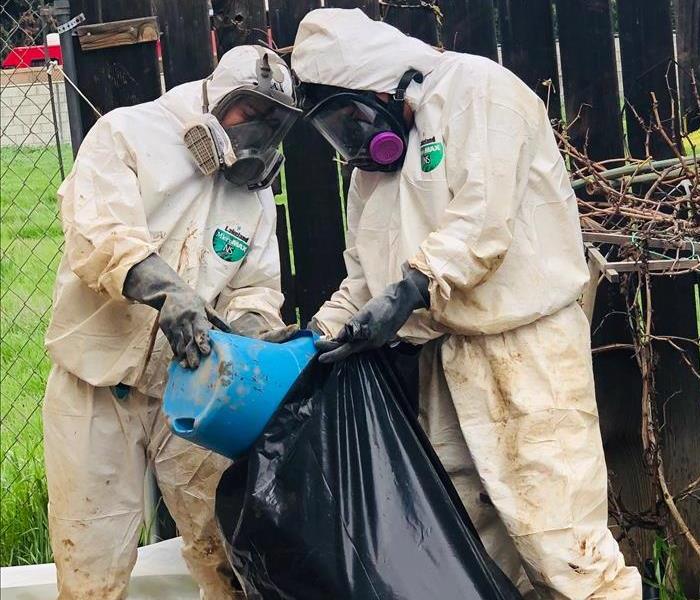 In addition to proper training and experience, a person involved in biohazard remediation must have proper personal protective gear or PPE.
In addition to proper training and experience, a person involved in biohazard remediation must have proper personal protective gear or PPE.
If you’ve found yourself in a position in which you require the services of a biohazard cleaning company, ensure that you hire the best biohazard remediation service for the job.
Questions you should ask
- How long have you been in business
- What type of insurance does your company maintain
- Are your registered with the State of California
- How does the company respect privacy
- What are your hours of availability
Always Choose Trained Professionals
- Because it’s traumatic: No one should have to deal with the personal impact of cleaning up after the traumatic loss of a loved one. A professional SERVPRO can get a situation cleaned up quickly, compassionately and discreetly.
- Because it’s safer: Federal regulations classify all human and animal remains, including blood, urine, feces, vomit and bodily fluids, as biohazards. This is because they have the potential of carrying life-threatening pathogens such as Hepatitis B and C, AIDS, HIV, MRSA, Tuberculosis and many more. The safe cleanup and removal of bio-hazardous materials involves extensive analysis and detailed work, and the use of state-of-the-art cleaning and odor removal technologies.
Need Biohazard Cleanup? Call Us Today – 951-351-8033
Licensed Bonded & Insured
- It is important to use licensed professionals because they conduct safe cleanup, removal and disposal of bio-hazardous waste. Additional considerations include being registered and compliant with OSHA and FEMA, federal agencies that oversee disasters and workplace safety. Cleanup crews will be coming into your home or the home of your loved one, so be sure the professional you choose is bonded and insured.
Approved Vendors for Most Major Insurance Companies
- In most cases, insurance will cover much or all of the cost of traumatic even cleanup. You can minimize or eliminate your out-of-pocket expenses by working with licensed and bonded professionals such as SERVPRO of West Riverside City who will deal directly with insurance companies, saving you one more headache in this already difficult process.
We provide cleanup and recovery services for many biohazard situations. These include the following:
- Suicide/death accidents
- Homicide cleanups
- Blood cleanup
- Accident cleanup
- Hoarding scenes
- Animal waste/remains
- Chemical spills
- Tear gas cleanup
- Meth lab cleanup
FAQ
Q: Can I just use my regular cleaning or janitorial service for biohazard cleanup of blood or bodily fluids?
A: Not unless your regular cleaning or janitorial service has been properly trained and equipped to handle biohazard cleanup and waste such as blood or bodily fluids, and has a legal place to dispose of the recovered biohazardous waste.
Q: Who pays for bio-recovery services?
A: In many cases home, business or auto insurance will pay for bio-recovery services. Ultimately the property owner may be responsible for cost of the service.
Q: Can I have an employee of my business clean the scene?
A: Federal Regulation 29cfr1910.1030 states that no employee can be placed in a position to be exposed to biohazard cleanup of blood spills without first:
- Receiving Blood Borne Pathogen (bbp) training.
- Having a written BBP exposure control plan.
- Having been provided personal protective equipment.
- Having been offered Hepatitis B vaccine and exposure evaluation and follow-up.
- Being provided with a method to remove and properly store the bio-hazardous waste in properly marked containers for disposal at an approved site.
Universal Precautions and Protective Attire in California
Following the OSHA Blood Pathogens Standard, the state of California has delineated the universal precautions, and associated protective attire, that must be utilized when workers are exposed to blood, other bodily fluids, and other biological materials. This includes workers in the healthcare as well as the biohazard remediation industries.
Essential protective attire mandated by the state of California, following OSHA protocols, includes:
- Disposable gloves
- Protective gowns or uniforms (there is a preference, although no mandatory requirement, that this type of protective gear be disposable)
- Protective eyewear and masks or face shields
For more information please visit:
The other OSHA requirements for blood cleanup include:
- Immediately limit access to the area contaminated by blood, bodily fluids, or potentially hazardous biological materials.
- Cleanup blood, fluids, and materials as quickly and thoroughly as possible.
- Dispose of the collected blood (and other materials) together with the items used to cleanup these biomaterials in a proper biohazard receptacle.
- Sanitize all items that came into contact with blood, fluids, or biological materials.
- If sanitation is impossible, any contaminated items need to be removed and properly disposed of.
- Although not a specific OSHA requirement, deodorization is another step taken when it comes to comprehensive remediation of a traumatic scene or other situation in which blood or other biomaterials are present.
- Properly dispose of all protective gear utilized in the blood cleanup process.
- Safely and properly transport all items designated for disposal to a licensed biological material and hazardous waste disposal provider.
Summary
The OSHA requirements for cleaning up biohazardous waste are designed to fulfill the underlying mission of the agency. The mission of OSHA, since its creation, is “to assure safe and healthful working conditions for working men and women by setting and enforcing standards and by providing training, outreach, education, and assistance.” Thus, the agency maintains resources of different types that are designed to ensure that a business with workers exposed to biohazardous waste is able to develop suitable safety protocols. See
Storm Chasing Companies, Should Riverside Residents Trust Them?
11/13/2019 (Permalink)
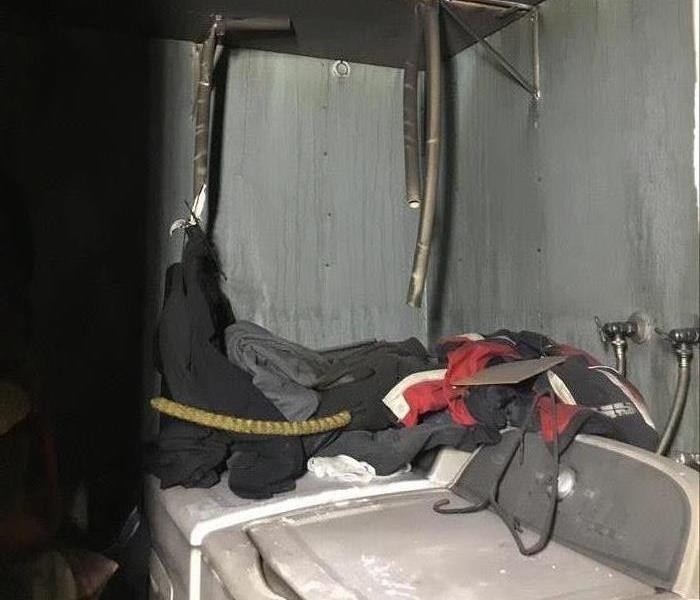 This home caught fire in Riverside, be prepared with phone numbers. Inform your insurance agent & Call SERVPRO of West Riverside City 951-351-8033
This home caught fire in Riverside, be prepared with phone numbers. Inform your insurance agent & Call SERVPRO of West Riverside City 951-351-8033
Don't be scammed by storm chasers.
Contractor duo trolled neighborhoods after storms, offering to fix damaged homes. The duo stole more than $770,000 in down payments from storm-traumatized homeowners — without fixing the homes. Many victims were elderly. These storm chasers have a new roof: They received up to 20 years in prison. This story ended in justice but all too often home and business owners are taken advantage of by less than reputable people.
You can keep scammers away. Protect your family, bank account and yourself from crooks: Stay alert, ask questions and go slow and pay attention to details.
Contact your insurance agent don’t trust that the contractor will file the claim for you. No one should be filing a claim on your insurance but you. This is a good time to talk with your agent about if you should even file a claim or not. You may need additional information like estimates from a reputable company.
After a damage to your car or home...Take photos of the damage and passengers. You can prevent fake injury and damage claims.
Contact your state insurance department or National Insurance Crime Bureau (1-800-835-6422) to report a scam. You can also report a scam with the BBB
Check with your insurance company about policy coverage and specific filing requirements. Save all receipts, if temporary roofing repairs are necessary. Know what your deductible is and know when to file a claim.
Although you may be anxious to get things back to normal, avoid letting your emotions get the better of you. Don't be pressured into making an immediate decision with a long-term impact. Be proactive in selecting a business and not reactive to sales solicitations. It is common for storm chasers to call and knock on your door.
For major repairs, take time to shop around and get 3-4 estimates based on the same specifications and materials. Check out references that are at least one year old, verify with your local government to find out whether or not businesses are required to be licensed/registered to do work in your area, and check with your local building inspector to see if a building permit is required.
Be wary of door-to-door workers who claim to have leftover materials from a job “down the street” or who do not have a permanent place of business. If salespeople go door-to-door, check to see if your community requires them to have solicitation permits.
Be leery if a worker shows up on your doorstep to announce that your home is unsafe. If you are concerned about possible structural damage in your home, have an engineer, architect or building official inspect it. While most roofing contractors abide by the law, be careful allowing someone you do not know inspect your roof. An unethical contractor may actually create damage to get work. This goes for Mold Remediation also. Contact an independent environmental specialist to perform an air quality test. Or ask if they do the test themselves or do they have a third party perform the test. If the mold inspection company does the testing or the roofer does the inspection what do you think the odds of them finding work for themselves to perform are?
Require a written contract agreement with anyone you hire. Be sure their name, address, license number, if applicable, and phone number are included in the contract. Read and understand the contract in its entirety, and don’t sign a blank contract. A copy of the signed contract is to be given to you at time of signature. What certifications does the company have?
Storm damages change based on your location. We here in the California area experience wildfires and strong winds. But in other areas they experience tornadoes or hurricanes. It's still important to be informed on the various kinds of storms that could occur in your area. Be prepared on who to contact. Have numbers handy on your phone. Inform your insurance agent and Call a trusted company, call SERVPRO of West Riverside City 951-351-8033
Mold Prevention that Work for Your Riverside Home
11/11/2019 (Permalink)
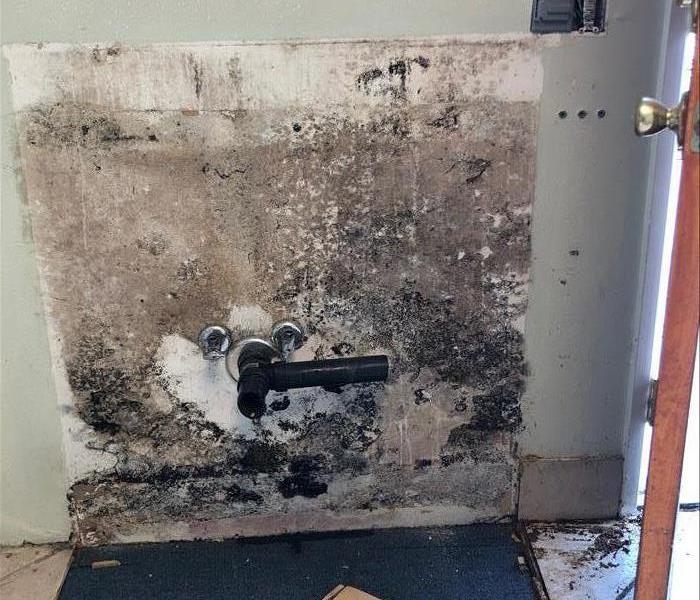 SERVPRO of West Riverside City specializes in mold cleanup and restoration, Our crews are highly trained restoration professionals.
SERVPRO of West Riverside City specializes in mold cleanup and restoration, Our crews are highly trained restoration professionals.
Although there are a variety of challenges that residential and commercial property owners can experience, the presence of mold is particularly problematic.
This is the case for many reasons, including the fact that mold can cause health problems and decrease the structural integrity of one’s property. There are ways to prevent the growth of mold, but your best course of action is hiring a professional mold remediation company. Try implementing some or all of the following six mold prevention tips:
Invest In A Dehumidification System.One of the best ways to prevent the growth and proliferation of mold is to invest in an air conditioner that features a dehumidification system. These systems are effective in removing moisture from your property. Once the moisture is removed, the mold is deprived of one of the vital nutrients that help it grow.
Be Cautious When Turning The AC Off.Make sure that you are cautious when you turn off your air conditioner. In climates that are humid, a long-standing period of inactivity can enable humidity levels to become dangerously high. If the humidity level becomes extremely high, it creates the moist environment necessary for mold to grow and thrive.
Use Insulation.Another strategy you can use to prevent mold is the use of insulation. By installing insulation as well as vapor barriers, you can prevent condensation from accumulating on objects like plumbing fixtures, beams, and water pipes.
Avoid Standing Water.Stagnant water can become a breeding area for mold. Since this is the case, make sure that you keep your tubs, showers, sinks and all other wet regions of your property free of standing water.
Review Your Applications.Another strategy for mold prevention is application review. Make sure that all of your construction, design, and architectural applications are effective in preventing water from coming in contact with the interior of your property and goods. Specific regions of concern include poorly designed balconies, pitched roofs, improperly installed flashing, doors, windows, thin stucco, and vapor barriers.
Maintain Structure Regularly.One final way to help prevent mold growth is to ensure that the integrity of your building envelope is maintained. You can achieve this objective by investing in regular roof flashing, caulking, sealing, and inspections of the exterior.
Conclusion
Mold can be a severe problem for residential and commercial property owners to handle. However, using the prevention tips and tricks outlined above can help you keep your property mold-free. In the event that mold growth does transpire, call a professional restoration company. They have extensive experience in the mold remediation field and can assist with your mold restoration needs.
If you suspect Mold
If you see visible mold, do not disturb it. You can inadvertently spread the mold infestation throughout your home. When mold is disturbed, the mold can release microscopic mold spores which become airborne and can circulate inside your home.
What to Do:
· Stay out of affected areas.
· Turn off the HVAC system and fans.
· Contact SERVPRO of West Riverside City for mold remediation services.
What Not to Do:
· Don’t touch or disturb the mold.
· Don’t blow air across any surfaces with visible or suspected mold growth.
· Don’t attempt to dry the area yourself.
· Don’t spray bleach or other disinfectants on the mold.
About Our Mold Remediation Services
SERVPRO of West Riverside City specializes in mold cleanup and restoration, in fact, it’s a cornerstone of our business. Our crews are highly trained restoration professionals that use specialized equipment and techniques to properly remediate your mold problem quickly and safely.
If You See Signs of Mold, Call Us Today – SERVPRO of West Riverside City 951-351-8033
Riverside Landlord Versus Tenant Flood Responsibilities
11/6/2019 (Permalink)
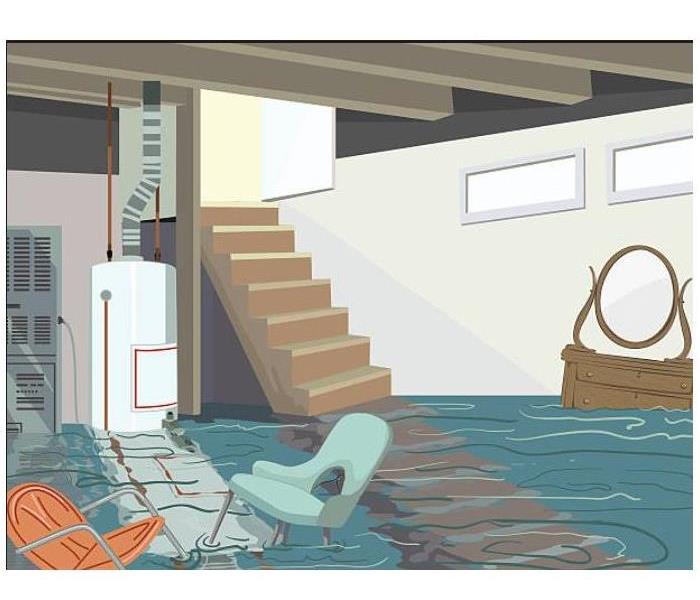 Flooding can be stressful and confusing. Once you and your family are safe, it is time to think about repairing and restoring your home or business.
Flooding can be stressful and confusing. Once you and your family are safe, it is time to think about repairing and restoring your home or business.
Flooding can be stressful and confusing. Once you and your family are safe, it is time to think about repairing and restoring your home or business.
Homeowners, business owners and renters alike now have to navigate the waters of insurance coverage. For homeowners, the process is likely clear. For landlords and tenants, however, it may be a bit more complicated. What does commercial property insurance cover? What does renter’s insurance cover?
Landlord Responsibilities
The first step as a landlord is to know your insurance coverage. Flood insurance is not typically part of general property insurance. Talk to your agent about your specific policy. Landlords are responsible for the following in the case of a flood:
• Whether insurance covers flooding or not, you as the property owner are still responsible for returning the dwelling to a safe, livable situation for your tenants. This must be done in a reasonably timely manner, so contact a water restoration specialist as soon as possible to avoid secondary damage from occurring.
• Damages to the building are covered by the landlord, including all appliances that were not purchased and installed by the tenants. Flooring, drywall, electrical and other structures are under the property owner’s purview as well.
Tenant Responsibilities
The landlord is not responsible for all damage, so as the tenant it is important to obtain renter’s insurance and know what is covered. As with landlords, flood coverage is not typically included in basic insurance, so talk to your agent about the details. Tenants should know the following information:
- As a renter, your personal belongings are covered under your insurance.
- Relocation, if the apartment or dwelling is unlivable, is usually covered by your insurance and rent does not need to be paid during that time. You may choose to discontinue the lease if the damage is severe.
Whether you are the landlord or tenant, obtain the appropriate insurance coverage. Understand what your property or renter’s insurance covers, and what your responsibilities are in the case of a flood in Riverside.
What's Next
You went downstairs to switch over your laundry and realize your laundry room is flooded and you need to call SERVPRO of West Riverside City, what are they going to ask?
Callers Name/Customer Name - Who will be responsible for decision and billing. Property Address Customer Phone Number Insurance Company, Claim Number, Deductible amount, insurance adjuster(if assigned yet) - Some of these items may not be known right away but are very important to ensure the insurance is able to be communicated with during the process. What, where, when - What broke, a pipe, toilet overfilled, storm related? What areas of the home is damaged, how big of an area, what kind of flooring? When did it happen?Has the source been corrected or stopped? Before services can be effective by SERVPRO you may need to have a plumber correct or stop the leak.If you call us day or night, you'll speak to a local representative to help guide you threw the next steps.
Now that we got the question completed, were scheduling services to begin and load up the vans.
Storm or Flood Damage? Call Us Today 951-351-8033
SERVPRO West Riverside City specializes in the cleanup and restoration of residential and commercial property after a fire, smoke, or water damage event. Our staff is highly trained in property damage restoration. From initial and ongoing training at SERVPROs corporate training facility, to regular IICRC-industry certification, you can rest assured our staff is equipped with the knowledge to restore your property.
Why Do We Have Red flag fire danger in Riverside?
11/4/2019 (Permalink)
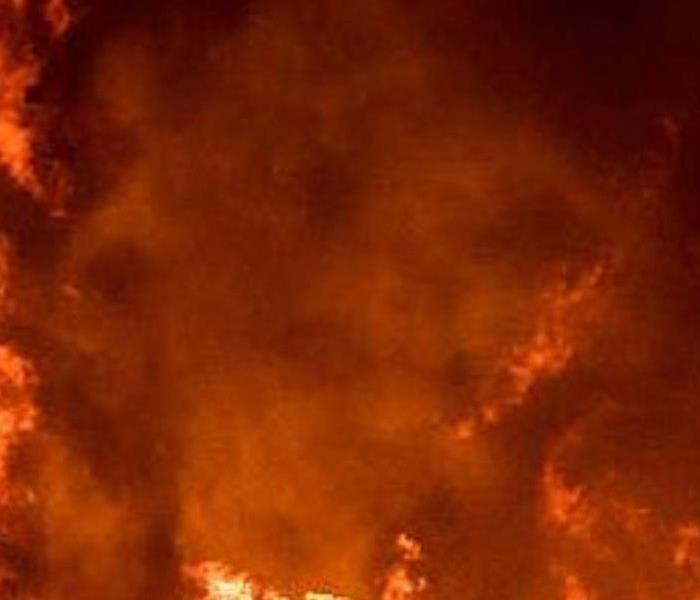 In less than 30 seconds, a small flame can turn into a major fire. Protect yourself and your family by preparing in advance.
In less than 30 seconds, a small flame can turn into a major fire. Protect yourself and your family by preparing in advance.
Fire is FAST!
In less than 30 seconds, a small flame can turn into a major fire. There is little time to escape. It only takes minutes for thick black smoke to fill your home.
Santa Anas are dry, warm (often hot) winds that blow westward through Southern California toward the coast. They're usually seasonal, and typically occur between October and March and peak in December. They originate when high pressure systems form over the high-elevation deserts of the Great Basin between the Sierra Nevada's and the Rocky Mountains. Air from the system flows clockwise, so winds on the southern side of the system push west towards the Pacific Ocean.
The winds pass over the mountains between coastal California and the inland deserts. As they flow downslope, the air gets compressed and rises in temperature at a rate of almost 29 degrees per mile of descent. While air's temperature rises, its relative humidity drops, commonly to less than 20 percent and sometimes to even less than 10 percent. The winds also increase dramatically in speed when they're forced through narrow mountain passes and canyons.
By the time the winds hit the coastal areas, they're very dry, warm, and moving fast. This is what makes them problematic. They dry out vegetation, making it better fuel for a fire—and once a fire starts, the winds fan the flames and help spread them. From Mentalfloss.com.
The California of Forestry & Fire Protections says, " A Red Flag Warning is issued for weather events which may result in extreme fire behavior that will occur within 24 hours. A Fire Weather Watch is issued when weather conditions could exist in the next 12-72 hours. A Red Flag Warning is the highest alert. During these times extreme caution is urged by all residents, because a simple spark can cause a major wildfire. A Fire Weather Watch is one level below a warning, but fire danger is still high."
According to the National Fire Protection Association:
- Seventy-one percent of households have a fire escape plan, but only 47% of those have practiced it.
- One-third believe they have at least six minutes before a fire in their home becomes life-threatening.
- Only 8% said their first thought was to get out when they heard the smoke alarm.
It's clear from this survey that many in our community probably don't understand the life-threatening risks from heat and toxic smoke produced in a modern home fire. Fire departments need to re-enforce these messages about the characteristics of fire: Fire is FAST. Fire is DARK. Fire is HOT. Fire is DEADLY!
Thirty years ago, people had 17 minutes to escape a home fire: now they have about two minutes. New construction practices and materials, as well as the furniture inside, cause fires to burn faster. Another hazard found in many homes is synthetic materials such as rubber, plastic or foam. When those materials burn, they can cause cyanide poisoning. Most people who die in a fire die from smoke inhalation, not burns.
Fire is FAST!
In less than 30 seconds, a small flame can turn into a major fire.
Fire is HOT! If you inhale the super-hot air in a home fire, it will scorch your lungs. Heat is more threatening than flames. Room temperature can rise to 600 degrees F at eye level.
Fire is dark! If you wake up to a fire you may be blinded disoriented and unable to find your way around your home. Fire isn't bright. But quickly produces black smoke and complete darkness.
Fire is DEADLY! The odorless, colorless fumes from a home fire can lull you into a deep sleep. You may not wake up in time to escape. Smoke and toxic gases kill more people than flames do.
Plan it
The first step is working with your household to develop a plan for home. IAFC’s Ready, Set, Go! Program’s "Your Personal Wildland Fire Action Guide" provides handy checklists that will walk you through creating a family disaster plan, building emergency kits, identifying where to get wildfire updates from, and knowing when to evacuate.
Homeowners can reduce their risk of loss to wildfire this time of year by making simple and low-cost improvements to their home and landscape. Some of these activities are typical fall home maintenance projects, such as:
Removing dead branches from trees and shrubbery (fall is a great time of year to prune bushes and trees, reducing the ability for fire to move up from shrubs into trees);Removing leaves from gutters and roofs;Removing weeds (that are drying out) from around the home especially within the first 5 feet of the home; andMaking sure vents are screened and cleared of debrisBeing prepared is the key. Riverside is not out of danger. We still have potential winds through March. If you would like to read about more tips, check out our website under SERVPRO Blogs
Pet Fire Safety Protecting Your Riverside Pets from Potential Danger
10/30/2019 (Permalink)
 SERVPRO of West Riverside mascot Ellie is happy to know her owner has prepared an emergency plan in the event of a fire.
SERVPRO of West Riverside mascot Ellie is happy to know her owner has prepared an emergency plan in the event of a fire.
Emergencies can happen at any moment and can come in a myriad of ways. While we may never be able to fully prevent such events from happening, we can prepare ourselves and our pets for when they do.
The American Red Cross put together important tips concerning fire safety in your home. Use this list to ensure that you and your furry friends are prepared should a fire break out.
Home fires are the most common disaster that the American Red Cross responds to – and also the most preventable.
The best way to protect your pets from the effects of a fire is to include them in your family plan. This includes having their own disaster supplies kit as well as arranging in advance for a safe place for them to stay if you need to leave your home.When you practice your escape plan, practice taking your pets with you. Train them to come to you when you call.In the event of a disaster, if you must evacuate, the most important thing you can do to protect your pets is to evacuate them, too. But remember: never delay escape or endanger yourself or family to rescue a family pet.Prevent Your Pets from Starting Fires
The National Fire Protection Association estimates that nearly 1,000 home fires each year are accidentally started by the homeowners' pets. The American Kennel Club and ADT Security Services have joined forces to provide the following tips:
Extinguish Open Flames - Pets are generally curious and will investigate cooking appliances, candles, or even a fire in your fireplace. Ensure your pet is not left unattended around an open flame and make sure to thoroughly extinguish any open flame before leaving your home.Remove Stove Knobs - Be sure to remove stove knobs or protect them with covers before leaving the house - a stove or cooktop is the number one piece of equipment involved in your pet starting a fire.Invest in Flameless Candles - These candles contain a light bulb rather than an open flame, and take the danger out of your pet knocking over a candle. Cats are notorious for starting fires when their tails turn over lit candles.Secure Young Pets - keep them confined away from potential fire-starting hazards when you are away from home such as in crates or behind baby gates in secure areas.Help Firefighters Help Your Pets
Keep pets near entrances when away from home. Keep collars on pets and leashes at the ready in case firefighters need to rescue your pet. When leaving pets home alone, keep them in areas or rooms near entrances where firefighters can easily find them.Affix a pet alert window cling and write down the number of pets inside your house and attach the static cling to a front window. This critical information saves rescuers time when locating your pets. Make sure to keep the number of pets listed on them updated.Pets become a part of our families, and we need to remember that we need to have plans in place for them too when it comes to safely evacuating a home in case of a fire. And remember, if you are victim of a house fire, SERVPRO® of West Riverside City can help #LikeItNeverEvenHappened.
Riverside, How to Protect yourselves from IDENTITY THEFT AND INTERNET SCAMS
10/28/2019 (Permalink)
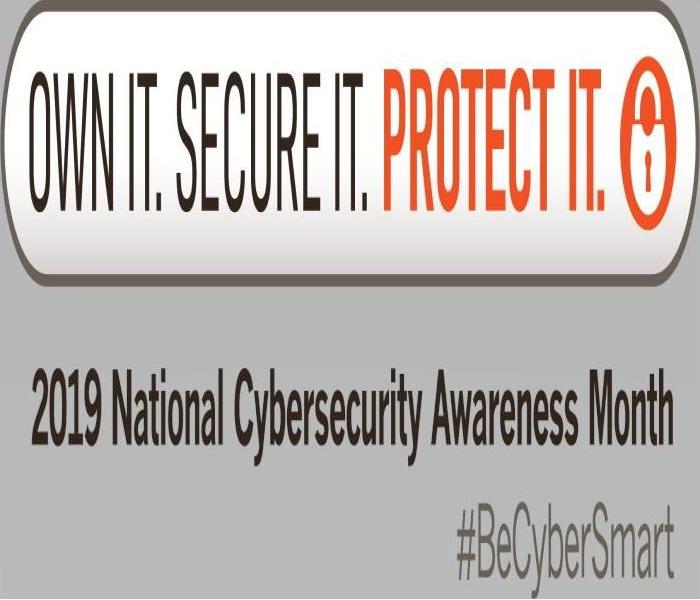 As technology continues to evolve, cybercriminals will use techniques to exploit technology to steal your identity, personal information, & money.
As technology continues to evolve, cybercriminals will use techniques to exploit technology to steal your identity, personal information, & money.
Today’s technology allows us to connect around the world, to bank and shop online, and to control our televisions, homes, and cars from our smartphones.
With this added convenience comes an increased risk of identity theft and Internet scams. #BeCyberSmart on the Internet—at home, at school, at work, on mobile devices, and on the go.
DID YOU KNOW?
- The total number of data breaches reported in 2018 decreased 23% from the total number of breaches reported in 2017, but the reported number of consumer records containing sensitive personally identifiable information (PII) exposed increased 126%. Identity Theft Resource Center, “2018 End-of-Year Data Breach Report”, 2018
- Credit card fraud tops the list of identity theft reports in 2018. The Federal Trade Commission (FTC) received more than 167,000 reports from people who said their information was misused on an existing account or to open a new credit card account. Federal Trade Commission, “Consumer Sentinel Network Data Book 2018”, 2019.
- Consumers reported $905 million in total fraud losses in 2017, a 21.6% increase over 2016. Experian, “Identify Theft Statistics”, 2019.
COMMON INTERNET SCAMS
As technology continues to evolve, cybercriminals will use more sophisticated techniques to exploit technology to steal your identity, personal information, and money. To protect yourself from online threats, you must know what to look for. According to the FTC, these are the top three kinds of threats reported in 2018:
- Identity theft is the illegal acquisition and use of someone else’s personal information to obtain money or credit. Signs of identity theft include bills for products or services you did not purchase, suspicious charges on your credit cards, or new accounts opened in your name that you did not authorize.
- Imposter scams occur when you receive an email or call from a person claiming to be a government official, family member, or friend requesting personal or financial information. For example, an imposter may contact you from the Social Security Administration informing you that your Social Security number (SSN) has been suspended, in hopes you will reveal your SSN or pay to have it reactivated.
- Debt Collection scams occur when criminals attempt to collect on a fraudulent debt. Signs the “debt collector” may be a scammer are requests to be paid by wire transfers or credit cards. In 2018 there was a spike in requests for gift cards and reloadable cards as well.
SIMPLE TIPS TO PROTECT IT.
- Double your login protection. Enable multi-factor authentication (MFA) to ensure that the only person who has access to your account is you. Use it for email, banking, social media, and any other service that requires logging in. If MFA is an option, enable it by using a trusted mobile device, such as your smartphone, an authenticator app, or a secure token—a small physical device that can hook onto your key ring. Read the Multi-Factor Authentication (MFA) How-to-Guide for more information.
- Shake up your password protocol. According to NIST guidance, you should consider using the longest password or passphrase permissible. Get creative and customize your standard password for different sites, which can prevent cyber criminals from gaining access to these accounts and protect you in the event of a breach. Use password managers to generate and remember different, complex passwords for each of your accounts. Read the Creating a Password Tip Sheet for more information.
- Be up to date. Keep your software updated to the latest version available. Maintain your security settings to keeping your information safe by turning on automatic updates so you don’t have to think about it, and set your security software to run regular scans.
PROTECT YOURSELF FROM ONLINE FRAUD
Stay Protected While Connected: The bottom line is that whenever you’re online, you’re vulnerable. If devices on your network are compromised for any reason, or if hackers break through an encrypted firewall, someone could be eavesdropping on you—even in your own home on encrypted Wi-Fi.
- Practice safe web surfing wherever you are by checking for the “green lock” or padlock icon in your browser bar—this signifies a secure connection. • When you find yourself out in the great “wild Wi-Fi West,” avoid free Internet access with no encryption. • If you do use an unsecured public access point, practice good Internet hygiene by avoiding sensitive activities (e.g., banking) that require passwords or credit cards. Your personal hotspot is often a safer alternative to free Wi-Fi. • Don’t reveal personally identifiable information such as your bank account number, SSN, or date of birth to unknown sources. • Type website URLs directly into the address bar instead of clicking on links or cutting and pasting from the email.
RESOURCES AVAILABLE TO YOU
If you discover that you have become a victim of cybercrime, immediately notify authorities to file a complaint. Keep and record all evidence of the incident and its suspected source. The list below outlines the government organizations that you can file a complaint with if you are a victim of cybercrime.
- FTC.gov: The FTC’s free, one-stop resource, www.IdentityTheft.gov can help you report and recover from identity theft. Report fraud to the FTC at ftc.gov/OnGuardOnline or www.ftc.gov/complaint
- US-CERT.gov: Report computer or network vulnerabilities to US-CERT via the hotline: 1-888-282-0870 or www.us-cert.gov. Forward phishing emails or websites to US-CERT at phishing- report@us-cert.gov.
- IC3.gov: If you are a victim of online crime, file a complaint with the Internet Crime Complaint Center (IC3) at http://www.IC3.gov.
- SSA.gov: If you believe someone is using your SSN, contact the Social Security Administration’s fraud hotline at 1-800-269-0271.
Checking your Riverside home after a fire, Taking the Appropriate Steps to Stay Safe
10/23/2019 (Permalink)
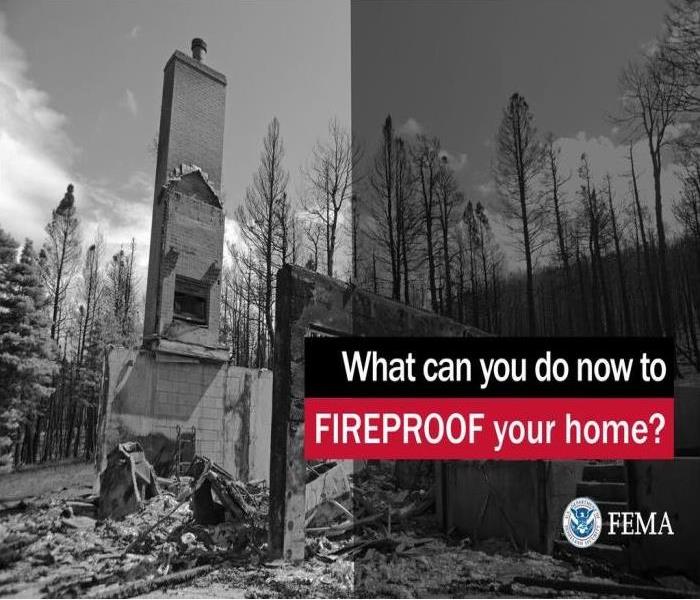 If your experience a fire, SERVPRO of West Riverside City can help relieve stress. We can work with your insurance agent to determine the next steps.
If your experience a fire, SERVPRO of West Riverside City can help relieve stress. We can work with your insurance agent to determine the next steps.
It's scary to think of experiencing a home fire. Being prepared will help you get through this stressful process. It can happen to anyone at any time. The key is knowing what to do in advance should you experience a home fire. Here are some important tips from our friends at American Red Cross.
Do not cut or walk past colored tape that was placed over doors or windows to mark damaged areas unless local authorities advise that it is safe to do so. If a building inspector has placed a color-coded sign on the home, do not enter it until you get more information, advice and instructions about what the sign means and whether it is safe to enter your home.
If you have children, leave them with a relative or friend while you conduct your first inspection of your home after the fire. The site may be unsafe for children, and seeing the damage firsthand may upset them and cause long-term effects, including nightmares.
Check for Structural Damage
Check the outside of your home before you enter. Look for loose power lines, broken or damaged gas lines, foundation cracks, missing support beams or other damage. Damage on the outside can indicate a serious problem inside. Ask a building inspector or contractor to check the structure before you enter.If the door is jammed, don’t force it open – it may be providing support to the rest of your home. Find another way to get inside.Damaged locks should be taken apart and wiped with oil. If locks can’t be removed, squirt machine oil through a bolt opening or keyhole, and work the knob to distribute the oil. Hinges should also be thoroughly cleaned and oiled.Sniff for gas. If you detect natural or propane gas, or hear a hissing noise, leave the property immediately and get well away from it. Call the fire department after you reach safety.If you have a propane tank system, turn off all valves and contact a propane supplier to check the system out before you use it again.Check for smoke and embers throughout the home, including the attic.Beware of animals, such as rodents, snakes, spiders and insects, that may have entered your home. As you inspect your home, tap loudly and often on the floor with a stick to give notice that you are there.Damaged objects, such as furniture or stairs, may be unstable. Be very cautious when moving near them. Avoid holding, pushing or leaning against damaged building parts.Is your ceiling sagging? That means it got wet – which makes it heavy and dangerous. It will have to be replaced, so you can try to knock it down. Be careful: wear eye protection and a hard hat, use a long stick, and stand well away from the damaged area. Poke holes in the ceiling starting from the outside of the bulge to let any water drain out slowly. Striking the center of the damaged area may cause the whole ceiling to collapse.Is the floor sagging? It could collapse under your weight, so don’t walk there! Small sections that are sagging can be bridged by thick plywood panels or thick, strong boards that extend at least 8–12 inches on each side of the sagging area.If the weather is dry, open windows and doors to ventilate and dry your home.If power is out, use a flashlight. Do not use any open flame, including candles, to inspect for damage or serve as alternate lighting.Disconnect and check all appliances for water damage before using them.Make temporary repairs such as covering holes, bracing walls, and removing debris. Save all receipts.Take photographs of the damage. You may need these to substantiate insurance claims later.Checking Utilities and Major Systems
Telephones
Check each telephone to see if it is still on the hook. Hang up any phones that aren’t. Wait a few minutes, and then pick up one phone to listen for a dial tone to know whether you have working telephone service.If you don’t have a dial tone, try unplugging all the phones. Plug in one at a time and listen for dial tone. This will help you determine if the phone itself is broken or the service is completely out. If it is, contact the telephone company to report the problem and request repair.Electrical, Plumbing and Heating Systems
If you see sparks, broken or frayed wires, or if you smell hot insulation, turn off the electricity at the main fuse box or circuit breaker.If there is a pool of water on the floor between you and the fuse box or circuit breaker panel, use a dry wooden stick to try to reach to turn off the main fuse or breaker, but do not step or stand in water to do that. If you cannot reach the fuse box or breaker panel, call a qualified electrician for assistance.Inspect the panel box for any breakers that may have tripped. A tripped breaker may indicate damaged wiring inside your home. Do not turn them on. Call an electrician.Use a flashlight to inspect fuses. Replace broken fuses with exactly the same amperage rating and never use an object such as a coin or strip of metal to bypass the protection that fuses provide.If you suspect sewage lines are damaged, avoid using sinks, showers or toilets and call a plumber.If water pipes are damaged, turn off the water at the main valve. Call a plumber for assistance.If you have a heating oil tank system, turn off all valves and contact a professional specializing in maintenance of such equipment before using it again.Checking Household Items
- Normal household items, such as cleaning products, can cause toxic fumes and other hazards if they mix. See our household chemical safety tips.
- Spilled chemicals that don’t pose a health risk must still be carefully cleaned up. Wear rubber gloves and discard spilled chemicals and rags used for cleaning according to the advice of local authorities.
- Throw away food, beverages and medicine exposed to heat, smoke or soot. Food that was in the freezer can be used if it still has ice crystals on it. If not, discard it.
Make Sure to:
Stay out of any building that has water around it.Keep away from loose or dangling power lines. Report them immediately to the power company.Contact your insurance agent. Do not discard damaged goods until an inventory has been taken. Save receipts for money spent relating to fire loss. Your insurance agent may provide immediate help with living expenses until you are able to return home and may offer assistance for repairs.
National Cybersecurity Awareness month-Riverside are you Aware?
10/21/2019 (Permalink)
 There are many ways to protect ourselves from cyber attacks. Internet of Things and Online Privacy are two areas we can focus on.
There are many ways to protect ourselves from cyber attacks. Internet of Things and Online Privacy are two areas we can focus on.
Cybersecurity is the practice of protecting systems, networks, and programs from digital attacks. These cyber attacks are usually aimed at accessing, changing, or destroying sensitive information; extorting money from users; or interrupting normal business processes.
Implementing effective cybersecurity measures is particularly challenging today because there are more devices than people, and attackers are becoming more innovative.
With the help from our friends at Homeland Security, SERVPRO of West Riverside City hopes our Riverside neighbors find these tips regarding Internet of Things and Online Privacy helpful.
INTERNET OF THINGS
Internet of Things (IoT) or smart devices refers to any object or device that is connected to the Internet. This rapidly expanding set of “things,” which can send and receive data, includes cars, appliances, smart watches, lighting, home assistants, home security, and more. #BeCyberSmart to connect with confidence and protect your interconnected world.
WHY SHOULD WE CARE?
• Cars, appliances, wearables, lighting, healthcare, and home security all contain sensing devices that can talk to another machine and trigger other actions. Examples include devices that direct your car to an open spot in a parking lot; mechanisms that control energy use in your home; and tools that track eating, sleeping, and exercise habits.
• New Internet-connected devices provide a level of convenience in our lives, but they require that we share more information than ever.
• The security of this information, and the security of these devices, is not always guaranteed. Once your device connects to the Internet, you and your device could potentially be vulnerable to all sorts of risks. • With more connected “things” entering our homes and our workplaces each day, it is important that everyone knows how to secure their digital lives.
SIMPLE TIPS TO OWN IT.
• Shake up your password protocol. Change your device’s factory security settings from the default password. This is one of the most important steps to take in the protection of IoT devices. According to NIST guidance, you should consider using the longest password or passphrase permissible. Get creative and create a unique password for your IoT devices. Read the Creating a Password Tip Sheet for more information.
• Keep tabs on your apps. Many connected appliances, toys, and devices are supported by a mobile application. Your mobile device could be filled with apps running in the background or using default permissions you never realized you approved— gathering your personal information without your knowledge while also putting your identity and privacy at risk. Check your app permissions and learn to just say “no” to privilege requests that don’t make sense. Only download apps from trusted vendors and sources.
• Secure your network. Properly secure the wireless network you use to connect Internet-enabled devices. Consider placing these devices on a separate and dedicated network. For more information on how you can secure your network, view the National Security Agency’s Cybersecurity Information page.
• If you connect, you must protect. Whether it’s your computer, smartphone, game device, or other network devices, the best defense is to stay on top of things by updating to the latest security software, web browser, and operating systems. If you have the option to enable automatic updates to defend against the latest risks, turn it on.
ONLINE PRIVACY
The Internet touches almost all aspects of our daily lives. We are able to shop, bank, connect with family and friends, and handle our medical records all online. These activities require you to provide personally identifiable information (PII) such as your name, date of birth, account numbers, passwords, and location information. #BeCyberSmart when sharing personal information online to reduce the risk of becoming a cyber crimes victim.
DID YOU KNOW?
• 64% of U.S. adults have noticed or been notified of a major data breach affecting their sensitive accounts or personal data. Smith, Aaron. “Americans and Cybersecurity.” Pew Research Center: Internet, Science & Tech. April 27, 2017.
• Roughly half of Americans (49%) feel that their personal information is less secure than it was five years ago. Ibid.
• 58% of Americans age 50 and older are more likely to feel that their personal information has become less safe in recent years: 58% of Americans in this age group express this opinion. Ibid.
• 69% of consumers believe companies are vulnerable to hacks and cyberattacks. PricewaterhouseCoopers. “Consumer Intelligence Series: Protect.me.” PwC. 2017.
SIMPLE TIPS TO OWN IT.
• Double your login protection. Enable multi-factor authentication (MFA) to ensure that the only person who has access to your account is you. Use it for email, banking, social media, and any other service that requires logging in. If MFA is an option, enable it by using a trusted mobile device, such as your smartphone, an authenticator app, or a secure token—a small physical device that can hook onto your key ring. Read the Multi-Factor Authentication (MFA) How-to-Guide for more information.
• Shake up your password protocol. According to NIST guidance, you should consider using the longest password or passphrase permissible. Get creative and customize your standard password for different sites, which can prevent cyber criminals from gaining access to these accounts and protect you in the event of a breach. Use password managers to generate and remember different, complex passwords for each of your accounts. Read the Creating a Password Tip Sheet for more information.
• Be up to date. Keep your software updated to the latest version available. Maintain your security settings to keeping your information safe by turning on automatic updates so you don’t have to think about it, and set your security software to run regular scans.
• If you connect, you must protect. Whether it’s your computer, smartphone, game device, or other network devices, the best defense against viruses and malware is to update to the latest security software, web browser, and operating systems. Sign up for automatic updates, if you can, and protect your devices with anti-virus software. Read the Phishing Tip Sheet for more information.
• Play hard to get with strangers. Cyber criminals use phishing tactics, hoping to fool their victims. If you’re unsure who an email is from—even if the details appear accurate— or if the email looks “phishy,” do not respond and do not click on any links or attachments found in that email. When available use the “junk” or “block” option to no longer receive messages from a particular sender.
• Never click and tell. Limit what information you post on social media—from personal addresses to where you like to grab coffee. What many people don’t realize is that these seemingly random details are all that criminals need to know to target you, your loved ones, and your physical belongings—online and in the real world. Keep Social Security numbers, account numbers, and passwords private, as well as specific information about yourself, such as your full name, address, birthday, and even vacation plans. Disable location services that allow anyone to see where you are—and where you aren’t—at any given time. Read the Social Media Cybersecurity Tip Sheet for more information.
• Keep tabs on your apps. Most connected appliances, toys, and devices are supported by a mobile application. Your mobile device could be filled with suspicious apps running in the background or using default permissions you never realized you approved—gathering your personal information without your knowledge while also putting your identity and privacy at risk. Check your app permissions and use the “rule of least privilege” to delete what you don’t need or no longer use. Learn to just say “no” to privilege requests that don’t make sense. Only download apps from trusted vendors and sources.
• Stay protected while connected. Before you connect to any public wireless hotspot—such as at an airport, hotel, or café—be sure to confirm the name of the network and exact login procedures with appropriate staff to ensure that the network is legitimate. If you do use an unsecured public access point, practice good Internet hygiene by avoiding sensitive activities (e.g., banking) that require passwords or credit cards. Your personal hotspot is often a safer alternative to free Wi-Fi. Only use sites that begin with “https://” when online shopping or banking.
Six Things Riverside Homeowners Should Do After a Home Fire
10/16/2019 (Permalink)
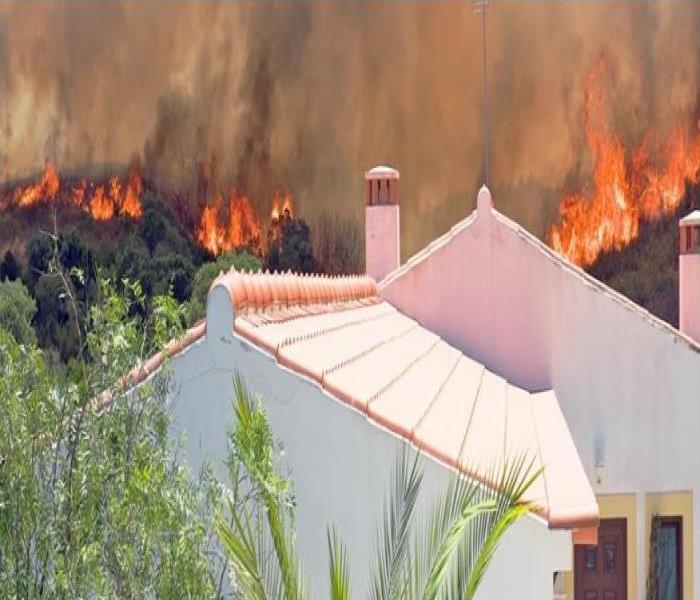 Wildfires can ruin homes and cause injuries or death to people and animals. Learn what to do after a home fire.
Wildfires can ruin homes and cause injuries or death to people and animals. Learn what to do after a home fire.
Wildfires can ruin homes and cause injuries or death to people and animals.
A wildfire is an unplanned fire that burns in a natural area such as a forest, grassland, or prairie. Wildfires can:
Often be caused by humans or lightning.Cause flooding or disrupt transportation, gas, power, and communications.Happen anywhere, anytime. Risk increases with in periods of little rain and high winds.Cost the Federal Government billions of dollars each year.IF YOU ARE UNDER A WILDFIRE WARNING, GET TO SAFETY RIGHT AWAY
Leave if told to do so.If trapped, call 9-1-1.Listen for emergency information and alerts.Use N95 masks to keep particles out of the air you breathe.Here are the six things you should do after a home fire:
1. Call your insurance agent immediately. You will be getting calls at all hours of the day from public adjusters and contractors who will try to offer you a deal on putting your house back together. These calls can create a lot of stress and confusion. I suggest you speak to no one but your agent to discuss your options at this point in the process.
2. Ask about restoration companies that can help with cleaning up soot, boarding up windows, and other construction. Immediately after a fire, especially if it is a minor one, you’ll need to clean up any soot or water damage. It is important to hire a reputable service to deal with these issues. Ask your agent or insurance adjuster to recommend a few different companies. They deal with these situations more often than you do and likely know of some businesses that fit your needs. Many of these restoration companies have connections to good contractors, engineers, and architects, as well. SERVPRO of West Riverside City is here to help.
3. Separate damaged property from undamaged property. The insurance company will need a detailed inventory list from you after they inspect the loss. Separating your damaged property from your undamaged property will make it easier for you to make a list of your damaged items. This list needs to include the date you purchased each item, the brand name, the price you paid, and the serial number, model, or description of each item. If the item was a gift, be sure to indicate that as well.
It’s a good idea to submit your receipts with this inventory list. If the receipts were destroyed in the fire, or you didn’t keep any receipts, request copies of prior bank statements. This can make obtaining duplicate receipts easier. Keep in mind that photos of any damaged items are always helpful if receipts are not available.
4. Save undamaged property from further destruction. Any items that are not damaged should be put in a safe place, even if it means putting them in storage. Insurance adjusters are typically fair when it comes to adding additional costs for storage.
5. Cooperate fully with the insurance company’s investigation. When a fire claim is reported to an insurance company, it is given top priority. Usually the adjusters come out to see the loss within 24 to 48 hours. To help settle your claim in a timely manner and to your satisfaction, be sure you are available and on time for all meetings, that you return calls promptly, that any requested paperwork is completed as quickly as possible, and that you contact the company or your agent immediately with any questions.
6. Find somewhere to stay if you can’t live in your home. Most homeowner’s policies include “Loss of Use or Loss of Rents” coverage, which will pay for the food, clothing, and shelter that you and your family may need for a specified period of time. Keep in mind that your policy will pay for “like kind and quality” living arrangements. You may want to save the Ritz for a special occasion and instead stay in a more reasonably priced hotel.
What to do before disaster strikes
• Review your homeowner’s policy to be sure you have replacement cost coverage, loss of use coverage, and adequate dwelling coverage. The last thing you want to hear after a fire is that you were underinsured.
• Save all your receipts and put them in a metal fireproof box or in a storage facility off the premises, such as a safety deposit box. Better yet, scan the receipts and save them to a computer file. Taking a video of your entire home and the possessions within it is the next best thing to receipts. This will show the insurance company what sort of lifestyle you had prior to the claim.
• Be sure to have smoke detectors in every room of your home to ensure that everyone gets out of the house or apartment safely in the event of a fire. Have exit ladders and fire extinguishers handy, and know how to use them.
• Discuss escape strategies and plans with your family prior to a fire, and consider a fire drill to help ensure everyone’s safety.
Riverside Residents-SOCIAL MEDIA CYBERSECURITY AWARENESS
10/14/2019 (Permalink)
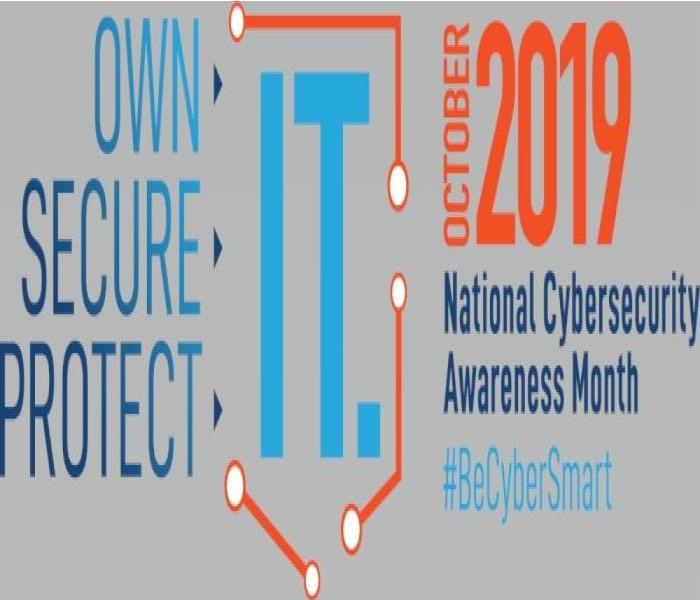 How can you be proactive to stay safe online and, “Own IT. Secure IT. Protect IT.”? #BeCyberSmart and take these steps to connect with confidence.
How can you be proactive to stay safe online and, “Own IT. Secure IT. Protect IT.”? #BeCyberSmart and take these steps to connect with confidence.
Now more than ever, consumers spend increasing amounts of time on the Internet. With every social media account you sign up for, every picture you post, and status you update, you are sharing information about yourself with the world. How can you be proactive to stay safe online and, “Own IT. Secure IT. Protect IT.”?
#BeCyberSmart and take these simple steps to connect with confidence and safely navigate the social media world.
DID YOU KNOW?
- 3.48 billion people worldwide now use social media worldwide. That’s an increase of 9% from 2018. Put another way: 45% of the total world population are using social networks.
From: Kemp, Simon. “Digital 2019: Global Digital Overview.” DataReportal. January 30, 2019. https://datareportal.com/reports/digital-2019
- Digital consumers spend nearly 2.5 hours on social networks and social messaging every day. Gwi.
“Latest 2019 Social Media User Trends Report.” GlobalWebIndex. 2019. https://www.globalwebindex.com/reports/social.
- 69% of U.S. adults use at least one social media site (New) berry, Christina. “130 Social Media Statistics That Matter to Marketers in 2019.”
Hootsuite Social Media Management. March 13, 2019. and the average American has 7.1 social media accounts.(Ibid.)
https://blog.hootsuite.com/social-media-statisticsfor-social-media-managers/.
SIMPLE TIPS TO OWN IT.
- Remember, there is no ‘Delete’ button on the Internet. Share with care, because even if you delete a post or picture from your profile seconds after posting it, chances are someone still saw it.
- Update your privacy settings. Set the privacy and security settings to your comfort level for information sharing. Disable geotagging, which allows anyone to see where you are—and where you aren’t—at any given time.
- Connect only with people you trust. While some social networks might seem safer for connecting because of the limited personal information shared through them, keep your connections to people you know and trust.
- Never click and tell. Limit what information you post on social media—from personal addresses to where you like to grab coffee. What many people don’t realize is that these seemingly random details are all that criminals need to know to target you, your loved ones, and your physical belongings—online and in the real world. Keep Social Security numbers, account numbers, and passwords private, as well as specific information about yourself, such as your full name, address, birthday, and even vacation plans. Disable location services that allow anyone to see where you are—and where you aren’t—at any given time. Read the Social Media Cybersecurity Tip Sheet for more information.
- Speak up if you’re uncomfortable. If a friend posts something about you that makes you uncomfortable or you think is inappropriate, let him or her know. Likewise, stay open-minded if a friend approaches you because something you’ve posted makes him or her uncomfortable. People have different tolerances for how much the world knows about them, and it is important to respect those differences. Don’t hesitate to report any instance of cyberbullying you see.
- Report suspicious or harassing activity. Work with your social media platform to report and possibly block harassing users. Report an incident if you’ve been a victim of cybercrime. Local and national authorities are ready to assist you.
SERVPRO of West Riverside City encourages our neighbors in Riverside to review more information regarding Cybersercurity on NICCS.
NFPA Announces "Not Every Hero Wears a Cape. Plan Your Escape!" as the theme for Fire Prevention Week
10/9/2019 (Permalink)
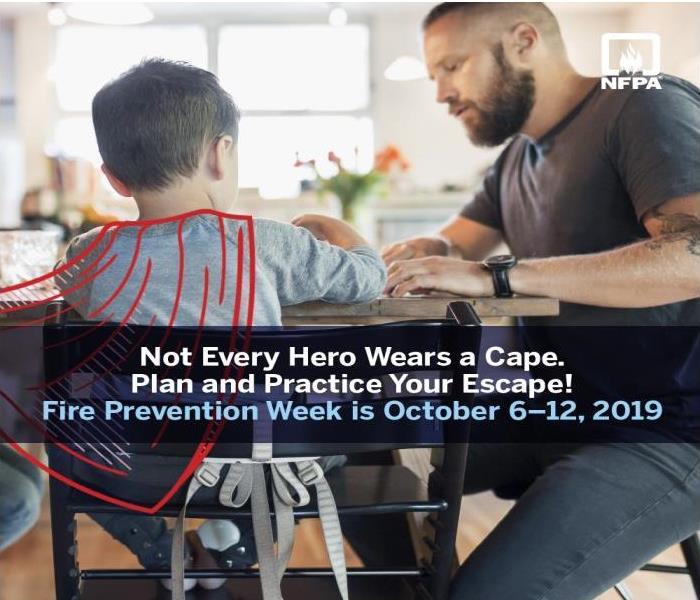 The most important aspect of fire prevention lies in awareness. Youngsters should be educated in smoke and fire safety.
The most important aspect of fire prevention lies in awareness. Youngsters should be educated in smoke and fire safety.
This year’s campaign recognizes the everyday people who motivate their households to develop and practice a home fire escape plan; these seemingly basic behaviors can have life-saving impact.
“Not Every Hero Wears a Cape. Plan and Practice Your Escape!” focuses on what a home escape plan entails and the value of practicing it. These messages are more important than ever, particularly because today’s homes burn faster than ever. Synthetic fibers used in modern home furnishings, along with the fact that newer homes tend to be built with more open spaces and unprotected lightweight construction, are contributing factors to the increased burn rate.
A home escape plan includes working smoke alarms on every level of the home, in every bedroom, and near all sleeping areas. It also includes two ways out of every room, usually a door and a window, with a clear path to an outside meeting place (like a tree, light pole or mailbox) that’s a safe distance from the home. Home escape plans should be practiced twice a year by all members of the household.
Home Fire Escape Planning and Practice Home fire escape planning and drills are an essential part of fire safety. A home fire escape plan needs to be developed and practiced before a fire strikes.
Home fire escape planning should include the following:
• Drawing a map of each level of the home, showing all doors and windows
• Going to each room and pointing to the two ways out
• Making sure someone will help children, older adults, and people with disabilities wake up and get out
• Teaching children how to escape on their own in case you cannot help them
• Establishing a meeting place outside and away from the home where everyone can meet after exiting
• Having properly installed and maintained smoke alarms
• Home fire escape practice should include the following:
• Pushing the smoke alarm button to start the drill
• Practicing what to do in case there is smoke: Get low and go. Get out fast.
• Practicing using different ways out and closing doors behind you as you leave
• Never going back for people, pets, or things
• Going to your outdoor meeting place
• Calling 9-1-1 or the local emergency number from a cell phone or a neighbor’s phone
Smoke Alarms
• Smoke alarms detect and alert people to a fire in the early stages. Smoke alarms can mean the difference between life and death in a fire.
• Working smoke alarms cut the risk of dying in a home fire in half.
• Install smoke alarms in every sleeping room, outside each separate sleeping area, and on every level of the home, including the basement. • Test smoke alarms at least once a month using the test button.
• Make sure everyone in the home understands the sound of the smoke alarm and knows how to respond.
If a wildfire is threatening your home:
• Create a plan for evacuation that includes alternate routes out of the danger area.
• Have prepacked kits with essentials such as medicine, family records, credit cards, a change of clothing, and food and water.
• Create a family communication plan that designates an out-of-area friend or relative as a point of contact to act as a single source of communication.
• Prepare a plan for the care of pets and other animals.
• Sign up for wildfire alerts.
• Take steps to protect family, friends, or neighbors who have disabilities.
• Stay aware of local fire conditions. When told to evacuate, go promptly. If you feel unsafe, do not wait for an evacuation order—leave immediately.
A special note must be made about the elderly. The U.S. Fire Administration has found that seniors, while making up only 14 percent of the population as a whole, account for 38 percent of all fire-related fatalities. If you have an aged person living in your residence, see to it that he or she has eyeglasses, hearing aids and other necessary devices within arm’s reach while sleeping. Move all bulky furniture that could interfere with an escape from the building. And never leave heated blankets or other electronic equipment on for so long that it could catch fire.
About Fire Prevention Week
NFPA has been the official sponsor of Fire Prevention Week since 1922. According to the National Archives and Records Administration's Library Information Center, Fire Prevention Week is the longest running public health and safety observance on record. The President of the United States has signed a proclamation declaring a national observance during that week every year since 1925. Visit www.firepreventionweek.org for more safety information.
For more information about Fire Prevention Week and “Not Every Hero Wears a Cape. Plan and Practice Your Escape!,”along with a wealth of resources to help promote the campaign locally, visit fpw.org.
National Cybersecurity Awareness Month 2019
10/7/2019 (Permalink)
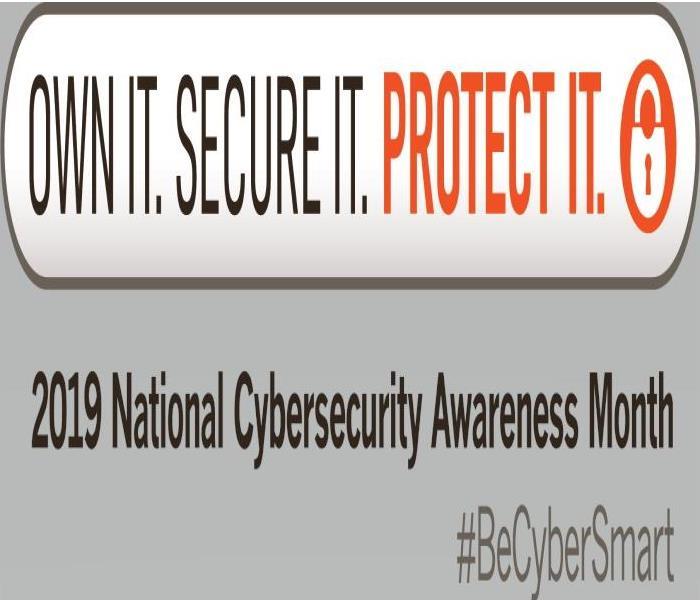 When you’re traveling— whether domestic or international—it is always important to practice safe online behavior and take proactive steps to secure In
When you’re traveling— whether domestic or international—it is always important to practice safe online behavior and take proactive steps to secure In
Held every October, National Cybersecurity Awareness Month (NCSAM) is a collaborative effort between government and industry to raise awareness about the importance of cybersecurity and to ensure that all Americans have the resources they need to be safer and more secure online.
NCSAM 2019 will emphasize personal accountability and stress the importance of taking proactive steps to enhance cybersecurity at home and in the workplace. This year’s overarching message – Own IT. Secure IT. Protect IT. – will focus on key areas including citizen privacy, consumer devices, and e-commerce security.
CYBERSECURITY WHILE TRAVELING
In a world where we are constantly connected, cybersecurity cannot be limited to the home or office. When you’re traveling— whether domestic or international—it is always important to practice safe online behavior and take proactive steps to secure Internet-enabled devices. The more we travel, the more we are at risk for cyberattacks. #BeCyberSmart and use these tips to connect with confidence while on the go.
SIMPLE TIPS TO OWN IT.
Before You Go
• If you connect, you must protect. Whether it’s your computer, smartphone, game device, or other network devices, the best defense against viruses and malware is to update to the latest security software, web browser, and operating systems. Sign up for automatic updates, if you can, and protect your devices with anti-virus software. Read the Phishing Tip Sheet for more information.
• Back up your information. Back up your contacts, financial data, photos, videos, and other mobile device data to another device or cloud service in case your device is compromised and you have to reset it to factory settings.
• Be up to date. Keep your software updated to the latest version available. Maintain your security settings to keeping your information safe by turning on automatic updates so you don’t have to think about it, and set your security software to run regular scans.
• Keep it locked. Lock your device when you are not using it. Even if you only step away for a few minutes, that is enough time for someone to steal or misuse your information. Set your devices to lock after a short time and use strong PINs and passwords. Read the Creating a Password Tip Sheet for more information.
• Double your login protection. Enable multi-factor authentication (MFA) to ensure that the only person who has access to your account is you. Use it for email, banking, social media, and any other service that requires logging in. If MFA is an option, enable it by using a trusted mobile device, such as your smartphone, an authenticator app, or a secure token—a small physical device that can hook onto your key ring. Read the Multi-Factor Authentication (MFA) How-to-Guide for more information.
During Your Trip
• Stop auto connecting. Some devices will automatically seek and connect to available wireless networks or Bluetooth devices. This instant connection opens the door for cyber criminals to remotely access your devices. Disable these features so that you actively choose when to connect to a safe network.
• Stay protected while connected. Before you connect to any public wireless hotspot—such as at an airport, hotel, or café—be sure to confirm the name of the network and exact login procedures with appropriate staff to ensure that the network is legitimate. If you do use an unsecured public access point, practice good Internet hygiene by avoiding sensitive activities (e.g., banking) that require passwords or credit cards. Your personal hotspot is often a safer alternative to free Wi-Fi. Only use sites that begin with “https://” when online shopping or banking.
• Play hard to get with strangers. Cyber criminals use phishing tactics, hoping to fool their victims. If you’re unsure who an email is from—even if the details appear accurate—or if the email looks “phishy,” do not respond and do not click on any links or attachments found in that email. When available use the “junk” or “block” option to no longer receive messages from a particular sender. Read the Phishing Tip Sheet for more information.
• Never click and tell. Limit what information you post on social media—from personal addresses to where you like to grab coffee. What many people don’t realize is that these seemingly random details are all that criminals need to know to target you, your loved ones, and your physical belongings—online and in the real world. Keep Social Security numbers, account numbers, and passwords private, as well as specific information about yourself, such as your full name, address, birthday, and even vacation plans. Disable location services that allow anyone to see where you are—and where you aren’t— at any given time. Read the Social Media Cybersecurity Tip Sheet for more information.
• Guard your mobile device. To prevent theft and unauthorized access or loss of sensitive information, never leave your equipment—including any USB or external storage devices—unattended in a public place. Keep your devices secured in taxis, at airports, on airplanes, and in your hotel room.
National Preparedness Month Week 3: Teach Your Youth to Prepare for Disasters such as Wildfires, Earthquakes of Flooding Sept 15-21
9/18/2019 (Permalink)
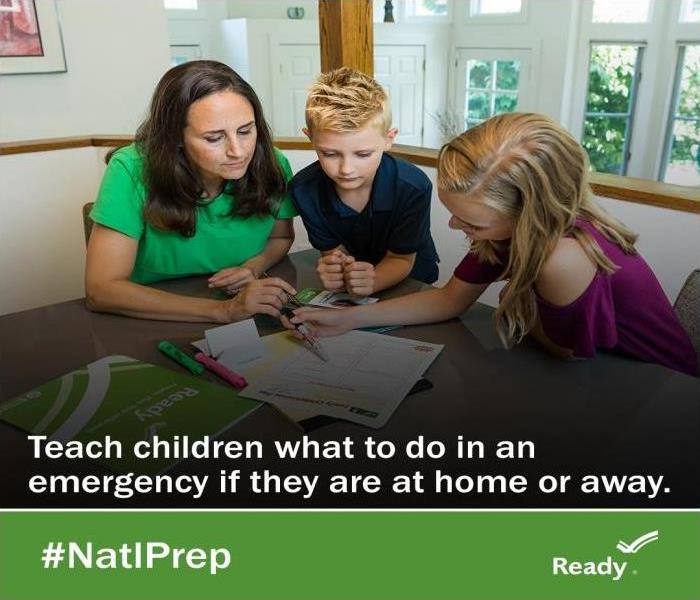 Help children know what to do before, during and after a flood, wildfire or earthquake. This will help Riverside children "Be Prepared not Scared."
Help children know what to do before, during and after a flood, wildfire or earthquake. This will help Riverside children "Be Prepared not Scared."
In recent years, devastating earthquakes, floods and wildfires have highlighted the need to prepare for natural disaster.
However, according to the Federal Emergency Management Agency (FEMA), half of Americans have not discussed or developed a family emergency plan. View the tips below from our friends at FEMA. Understand the disasters that could hit our Riverside area.
Earthquakes
Earthquakes are the shaking, rolling or sudden shock of the earth’s surface. Earthquakes happen along cracks (called fault lines) in the earth's surface. Earthquakes can be felt over large areas, although they usually last less than one minute. Earthquakes cannot be predicted — although scientists are working on it! All 50 states and 5 U.S. territories are at some risk for earthquakes. Earthquakes can happen at any time of the year.
What to do before, during and after an Earthquake
Before
- Build an emergency kit.
- Make a family communications plan.
- Know the safe spots in every room – under a sturdy table or against an inside wall.
- Ask your family to hold earthquake drills – drop, cover, and hold on!
During
If inside:
- DROP to the ground.
- Take COVER under a sturdy table or other heavy furniture. If there is nothing to get under, cover your face and head with your arms and crouch near an inside wall.
- HOLD ON until the shaking stops.
- STAY AWAY from windows, glass, lighting fixtures, or furniture that could fall – like bookcases.
- STAY INSIDE!
- Do not use elevators!
If outside:
- Stay there.
- Move away from buildings, streetlights, and wires.
- Stay out in the open until the shaking stops. Buildings could collapse and hurt you.
If trapped under debris:
- Cover your mouth with your shirt.
- Do not scream – you could breathe in dust.
- Tap on a pipe or wall so rescuers can find you.
After
- Expect aftershocks. They are usually not as strong but can cause damage.
- Open cabinets carefully. Objects that have moved could fall on you.
- Wear long pants, long sleeves and shoes to protect your skin from getting scratched by broken objects.
- Text, don’t talk. Unless there’s a life-threatening situation, if you have a cell phone, send a text so that you don’t tie up phone lines needed by emergency workers. Plus, texting may work even if cell service is down.
Words to know
Another word for earthquakes, along with tremors, quakes and shakes
Cracks in the rocks below the earth’s surface
A smaller earthquake that follows the main shock or previous earthquake
The center, or focus, of an earthquake, from which seismic waves are sent spherically in many directions
A machine that measures an earthquake
WildFires
Each year more than 2,500 people die and 12,600 are injured in home fires in the United States. But unlike other disasters, home fires can be prevented! It’s important to know this: Fire is fast! There is no time to gather anything or make a phone call. In just two minutes, a fire could kill you. In five minutes, a house could be swallowed in flames. Fire is hot! Heat and smoke could be even more dangerous than the flames. Breathing in really hot air could burn your lungs, and fire produces poisonous gases that can make you sleepy and unable to escape. Fire is dark! It can be hard to find your way out of your house in a fire. Fire is deadly! Fire uses up oxygen you need to breathe and produces smoke and poisonous gases that kill.
Every single person in The United States, no matter where they live, or what kind of home they live in is at risk of a home fire.
Before
- Create a fire escape plan and practice it twice a year.
- Have smoke alarms in every bedroom and every floor of the house.
- Remind your parents to test the smoke alarms in your house every month.
- Find two ways to get out of each room. A window might be a second way if the door is blocked by fire or smoke.
- Practice feeling your way out of the house in the dark or with your eyes closed.
- Sleep with your door closed. It helps prevent fires from spreading quickly.
During
- Get low and go! Crawl under smoke to an exit. Heavy smoke and deadly gases collect along the ceiling.
- If you hear a smoke alarm, get out fast! You may only have a few seconds to escape.
- If smoke is blocking the door, use your second way out of the room or house.
- Feel the doorknob and door before opening it. If either is hot, leave the door closed and use the second way out.
- If you see smoke coming around the door, use the second way out.
- If you do open a door, open it slowly and be ready to shut it quick if there’s smoke.
- Don’t hide from firefighters! They may look scary with all of their equipment, but they are there to help you.
- Tell firefighters if there are any pets trapped in the house. Don’t try to get them yourself!
- If your clothes catch on fire, stop-drop-roll! Stop, drop to the ground, and cover your face with your hands. Then roll over and over or back and forth until the fire is out.
After
- Don’t go back into any building unless a firefighter or your parents say it is safe
Floods
Flooding happens during heavy rains, when rivers overflow, when ocean waves come onshore, when snow melts too fast, or when dams or levees break. This is the most common natural-weather event. Flooding may be only a few inches of water, or it may cover a house to the rooftop. Floods that happen very quickly are called flash floods.
Floods can occur in every single U.S. state. Some floods develop slowly, and some can build in just a few minutes. People who live in low-lying areas – near water or behind a levee or dam – are at even greater risk.
Did you know? Flooding can change familiar places, like walkways, roads and fields. Avoid walking through water. It might be deeper than you think!
Before
- Build an emergency kit.
- Make a family communications plan.
- Tell an adult if you hear a flood warning on the TV or radio.
During
- Listen to authorities and safety officials.
- If there is any possibility of a flash flood, move immediately to higher ground.
- Help your family move important items to an upper floor.
- Do not walk through moving water. Even 6” of water can make you fall.
After
- Stay away from flood water. It could be contaminated, meaning contain dangerous substances.
- Stay away from moving water. It can knock you off your feet.
- Stay out of the way of emergency workers so they can do their job easily.
Words to know
- Flood Watch -A message that flooding is possible and to listen to local radio or TV news and weather for more information. You may receive an alert on a cell phone.
- Flood Warning- A message that flooding will occur soon, if it hasn’t already, and to move to higher ground or evacuate immediately
- Flash Flood- A flood that can happen within minutes or hours of heavy rainfall, a dam or levee failure, or city drains overflowing
- Levee/Dam -A manmade structure to contain or prevent water from moving past a certain point
Riverside it prone to earthquakes, flooding and wildfires. Teach your kids about these natural disasters so they understand the damage they could cause and what they should do before, during and after a natural disaster. Be Prepared Not Scared. Be ready. Contact SERVPRO of West Riverside City, we are "Faster to Any Disaster".
National Preparedness Month Week 3: Teach Your Youth to Prepare for Disasters Sept 15-21
9/16/2019 (Permalink)
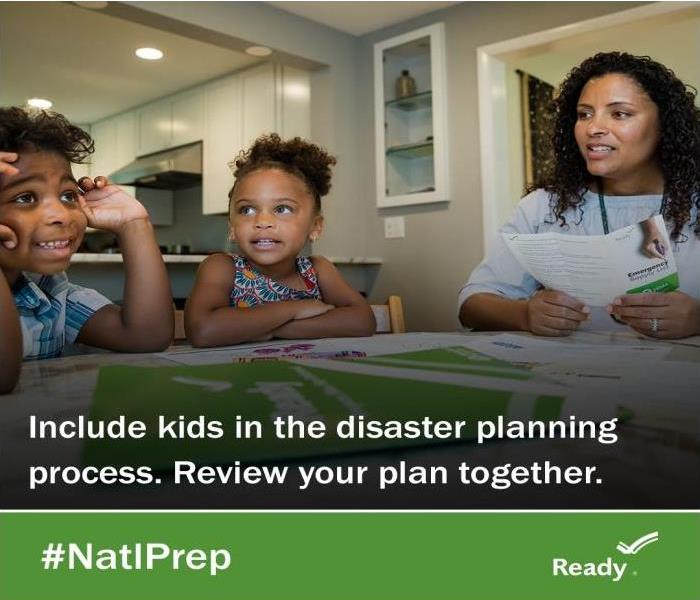 It's important to teach kids about disasters preparedness. Make it fun, have them help put together an emergency kit. "Be Prepared Not Scared".
It's important to teach kids about disasters preparedness. Make it fun, have them help put together an emergency kit. "Be Prepared Not Scared".
The phrase "The better you're prepared, the less you're scared" goes for kids as well as adults.
When talking to kids about disasters, it is important to teach them about disasters, without scaring them. It's a balancing act between the facts and potential impacts of a disaster and empowering them with actions they can take to be safe. Being open about what you are doing as a family to prepare before disasters happens is comforting. When possible, involve kids in activities like putting together the disaster supplies kit.
The best thing you can do for younger children is to create a safe environment around them. You can't really teach an infant or toddler about Drop Cover and Hold in an earthquake, but you can reduce the likelihood they will get hurt from falling book shelves, pictures and other furnishings around them. For more information on reducing earthquake hazards in your home visit our Prepare your Home page
As kids get older
For most kids, you can start introducing safety actions at about 4-years-old. Don't overwhelm them with too much information at once. Teach one safety action such as Drop, Cover and Hold, and follow up with actually doing it so they can demonstrate they understand. Practice with them until you are satisfied they know what to do. As kids get older, you can talk about how a disaster is something that could hurt people or cause damage. Explain that nature sometimes provides "too much of a good thing" -- fire, rain, and wind. Explain how important it is to make a Family Disaster Plan. Teach children:
How to call for helpWhen to call each emergency numberTo call the family contact if separatedTo keep personal identification information in their possession at all timesLet them help with testing smoke detectors or building the family kit. You can get them their own backpack and have them assemble a kit for themselves. When you involve your kids in getting your family ready, you are insuring they understand the family plan and are building life skills that will come in handy as they grow up!Be Prepared, Build a Kit
Being prepared for an emergency isn't just about staying safe during a disaster. It's about how to stay comfortable, clean, fed, and healthy afterwards – when a storm or disaster may have knocked out electricity.
If you lost power, how would you eat? The refrigerator can’t keep foods cold. The microwave can’t warm things up. You might not get clean water out of your faucets. How would you find out whether it was safe to play outside? Not from the TV or computer!
That’s why it’s important for families to work together to build an emergency kit before an emergency strikes. There should be enough food, water, clothing, and supplies to last for at least three days.
Here are some items you and your family will need:
Non-perishable food (such as dried fruit or peanut butter)First aid kitExtra batteriesMatches in a waterproof containerToothbrush, toothpaste, soapPaper plates, plastic cups and utensils, paper towelsWater – at least a gallon per person, per dayBattery-powered or hand-cranked radioSleeping bag or warm blanket for each personFlashlightsWhistle to signal for helpCan opener (manual)Local mapsPet suppliesBaby supplies (formula, diapers)Additional Emergency Supplies
Consider adding the following items to your emergency supply kit based on your individual needs:
Prescription medicationsNon-prescription medications such as pain relievers, anti-diarrhea medication, antacids or laxativesGlasses and contact lense solutionInfant formula, bottles, diapers, wipes, diaper rash creamPet food and extra water for your petCash or traveler's checksImportant family documents such as copies of insurance policies, identification and bank account records saved electronically or in a waterproof, portable containerSleeping bag or warm blanket for each personComplete change of clothing appropriate for your climate and sturdy shoesHousehold chlorine bleach and medicine dropper to disinfect waterFire extinguisherMatches in a waterproof containerFeminine supplies and personal hygiene itemsMess kits, paper cups, plates, paper towels and plastic utensilsPaper and pencilBooks, games, puzzles or other activities for childrenMaintaining Your Kit
After assembling your kit remember to maintain it so it’s ready when needed:
Keep canned food in a cool, dry placeStore boxed food in tightly closed plastic or metal containersReplace expired items as neededRe-think your needs every year and update your kit as your family’s needs change.Kit Storage Locations
Since you do not know where you will be when an emergency occurs, prepare supplies for home, work and vehicles.
Home: Keep this kit in a designated place and have it ready in case you have to leave your home quickly. Make sure all family members know where the kit is kept.Work: Be prepared to shelter at work for at least 24 hours. Your work kit should include food, water and other necessities like medicines, as well as comfortable walking shoes, stored in a “grab and go” case.Vehicle: In case you are stranded, keep a kit of emergency supplies in your car. SERVPRO of West Riverside city is local and available 24/7, keep our information in your emergency contact list. We are here to help!
National Preparedness Month -Week 2: Make a Plan- Life Saving Safety Skills, Sept 8-14
9/11/2019 (Permalink)
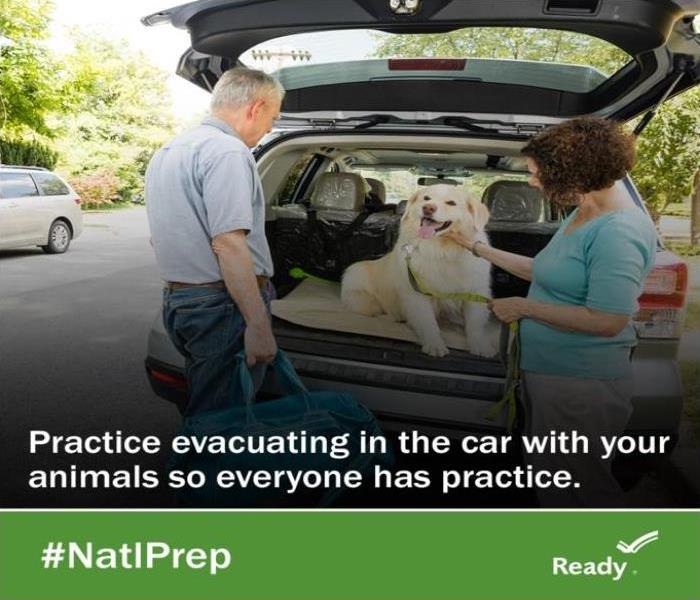 Remember, during a disaster what’s good for you is good for your pet, get them ready today. If you leave your pets behind, they may be lost/injured.
Remember, during a disaster what’s good for you is good for your pet, get them ready today. If you leave your pets behind, they may be lost/injured.
National Preparedness Month is recognized each September to promote family and community disaster and emergency planning now and throughout the year. The 2019 theme is "Prepared, Not Scared."
Today, we have the ability to predict with more accuracy than ever dangerous tornadoes, hurricanes, winter storms, and floods. We know the areas that are prone to earthquakes and areas that are susceptible to wildfires, and we can tell hours in advance whether a tsunami will hit our shores.
However, in spite of all the capabilities for advance warnings, we are still not quite up to speed at preparing for these disasters. Many really believe that it can’t happen to us.
Some simple, quick preparations could make the difference between life and death for your family. Here are several steps you can take to be ready for a disaster from our friends at Ready.gov.
What You Should Know About Life Saving Skills
- Know basic preparedness skills to protect your family and home.
- Eliminate common electrical and fire hazards around your house and property.
- Install smoke, carbon monoxide, and natural gas alarms and test them monthly.
- Teach children what to do when they hear smoke, carbon monoxide, and natural gas alarms.
- Place natural gas detectors on every level of your home and test them monthly.
- Know how to turn off utilities like natural gas in your home.
- Talk to your landlord or building manager about evacuation routes and fire safety.
- Develop and practice a family communication plan and discuss it with your family.
- Have emergency supplies in place at home, at work, and in the car.
- Pay attention to alerts and warnings.
- Know two ways out of your home in the event of a fire and practice evacuation plans.
- Set some money aside from your income in case of an emergency.
Safety Skills
Learn First Aid & CPR
Take a first aid and CPR class. Local American Red Cross chapters can provide information about this type of training. Official certification by the American Red Cross provides, under the “good Samaritan” law, protection for those giving first aid.
Get more information about the supplies in a first aid kit.
Learn to Use a Fire Extinguisher
Make sure you have one or more up-to-date fire extinguisher and be sure everyone knows where they are kept and how to use them. You should have, at a minimum, an ABC type.
The U.S. Fire Administration recommends that only those trained in the proper use and maintenance of fire extinguishers consider using them when appropriate. Contact your local fire department for information on training in your area. Get more information about preparedness for a fire emergency.
Know how to shut-off Utilities
Natural Gas
Natural gas leaks and explosions are responsible for a significant number of fires following disasters. It is vital that all household members know how to shut off natural gas.
Because there are different gas shut-off procedures for different gas meter configurations, it is important to contact your local gas company for any guidance on preparations and response regarding gas appliances and gas service to your home.
When you learn the proper shut-off procedure for your meter, share the information with everyone in your household. Be sure not to actually turn off the gas when practicing the proper gas shut-off procedures.
- If you smell gas or hear a blowing or hissing noise, open a window and get everyone out quickly. Turn off the gas, using the outside main valve, if you can, and call the gas company from a neighbor’s home.
- Caution: If you turn off the gas for any reason, a qualified professional must turn it back on. NEVER attempt to turn the gas back on yourself.
Water
Water quickly becomes a precious resource following many disasters. It is vital that all household members learn how to shut off the water at the main house valve.
- Before an emergency happens, locate the shut-off valve for the water line that enters your house and label this valve with a tag for easy identification. Make sure all household members know where it is located.
- Make sure this valve can be completely shut off. Your valve may be rusted open or it may only partially close. If so, replace it.
- Cracked lines may pollute the water supply to your house. It is wise to shut off your water until you hear from authorities that it is safe for drinking.
The effects of gravity may drain the water in your hot water heater and toilet tanks unless you trap it in your house by shutting off the main house valve. (This is not the street valve in the cement box at the curb – the street valve is extremely difficult to turn and requires a special tool.)
Electricity
Electrical sparks have the potential of igniting natural gas if it is leaking. It is wise to teach all responsible household members where and how to shut off the electricity.
- Locate you electrical circuit box. For your safety, always shut off all the individual circuits before shutting off the main circuit.
Evacuation
Plan to Evacuate
A wide variety of emergencies may cause an evacuation. In some instances you may have a day or two to prepare, while other situations might call for an immediate evacuation. Planning ahead is vital to ensuring that you can evacuate quickly and safely, no matter what the circumstances.
Before an Evacuation
- Learn the types of disasters that are likely in your community and the local emergency, evacuation, and shelter plans for each specific disaster.
- Plan how you will leave and where you will go if you are advised to evacuate.
- Identify several places you could go in an emergency such as a friend’s home in another town or a motel. Choose destinations in different directions so that you have options during an emergency.
- If needed, identify a place to stay that will accept pets. Most public shelters allow only service animals.
- Be familiar with alternate routes and other means of transportation out of your area.
- Always follow the instructions of local officials and remember that your evacuation route may be on foot depending on the type of disaster.
- Develop a family/household communication and re-unification plan so that you can maintain contact and take the best actions for each of you and re-unite if you are separated.
- Assemble supplies that are ready for evacuation, both a “go-bag” you can carry when you evacuate on foot or public transportation and supplies for traveling by longer distances if you have a personal vehicle.
- If you have a car:
- Keep a full tank of gas in it if an evacuation seems likely. Keep a half tank of gas in it at all times in case of an unexpected need to evacuate. Gas stations may be closed during emergencies and unable to pump gas during power outages. Plan to take one car per family to reduce congestion and delay.
- Make sure you have a portable emergency kit in the car.
- If you do not have a car, plan how you will leave if needed. Make arrangements with family, friends or your local government.
During an Evacuation
- A list of open shelters can be found during an active disaster in your local area by downloading the FEMA app
- Listen to a battery-powered radio and follow local evacuation instructions.
- Take your emergency supply kit.
- Leave early enough to avoid being trapped by severe weather.
- Take your pets with you, but understand that only service animals may be permitted in public shelters. Plan how you will care for your pets in an emergency now.
- If time allows:
- Call or email the out-of-state contact in your family communications plan. Tell them where you are going.
- Secure your home by closing and locking doors and windows.
- Unplug electrical equipment such as radios, televisions and small appliances. Leave freezers and refrigerators plugged in unless there is a risk of flooding. If there is damage to your home and you are instructed to do so, shut off water, gas and electricity before leaving.
- Leave a note telling others when you left and where you are going.
- Wear sturdy shoes and clothing that provides some protection such as long pants, long-sleeved shirts and a hat.
- Check with neighbors who may need a ride.
- Follow recommended evacuation routes. Do not take shortcuts; they may be blocked.
- Be alert for road hazards such as washed-out roads or bridges and downed power lines. Do not drive into flooded areas.
After an Evacuation
If you evacuated for the storm, check with local officials both where you’re staying and back home before you travel.
- Residents returning to disaster-affected areas after significant events should expect and prepare for disruptions to daily activities, and remember that returning home before storm debris is cleared is dangerous.
- Let friends and family know before you leave and when you arrive.
- Charge devices and consider getting back-up batteries in case power-outages continue.
- Fill up your gas tank and consider downloading a fuel app to check for outages along your route.
- Bring supplies such as water and non-perishable food for the car ride.
- Avoid downed power or utility lines; they may be live with deadly voltage.
- Stay away and report them immediately to your power or utility company.
- Only use generators away from your home and NEVER run a generator inside a home or garage, or connect it to your home's electrical system.
SERVPRO of West Riverside City encourages our neighbors to take steps to plan for a disaster, "Be Prepared not Scared" should a natural disaster take place in our Riverside City. Add our contact information to your emergency list. We can help ease the stress should you face a loss due to a disaster. We can make it "Like it never even happened."
SERVPRO of West Riverside City
Contact number: 951-351-8033
Website: https://www.SERVPROwestriversidecity.com/
Google: https://SERVPRO-west-riverside.business.site
Yelp: https://www.yelp.com/biz/SERVPRO-of-west-riverside-city-riverside-4
National Preparedness Month -Week 2: Make a Plan to Prepare for Disasters Sept 8-14
9/9/2019 (Permalink)
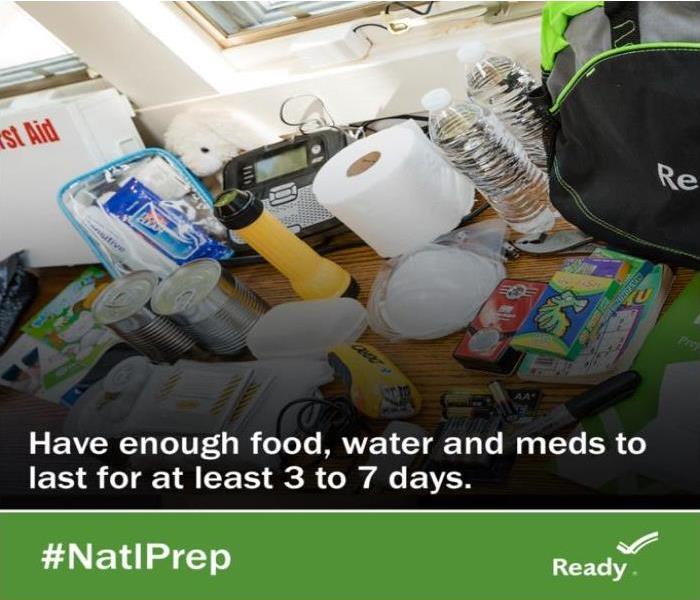 An emergency food storage of canned and nonperishable items, as well as bottled drinking water are essential. Plan ahead!
An emergency food storage of canned and nonperishable items, as well as bottled drinking water are essential. Plan ahead!
The only certain thing about disasters is that nothing is certain about disasters.
Natural or manmade, a disaster can happen at any time, and your family may not be together when they strike. Having a plan in place can help your family reconnect with one another and maximize their safety. But you have to plan to make a plan, and Ready.gov has the steps that you need to do this.
Step 1: Answer these questions
- How will we receive emergency alerts and warnings?
- What is our shelter plan?
- What is our evacuation route?
- What is our family communication plan?
The discussions that these questions will lead to can build the foundation of your family’s disaster strategy. What emergency alerts are available?
Wireless Emergency Alerts (WEA) are alerts sent at the right time to help keep you safe during an emergency. With WEA, warnings can be sent to your mobile device when you may be in harm's way, without the need to download an app or subscribe to a service. These messages are sent by authorized government alerting authorities through your mobile carrier. What types of alerts will you receive?
- Extreme weather, and other threatening emergencies in your area
- AMBER Alerts
- Presidential Alerts during a national emergency
Emergency Alert System (EAS) EAS is a national public warning system that requires broadcasters, satellite digital audio service and direct broadcast satellite providers, cable television systems, and wireless cable systems to provide the President with a communications capability to address the American people within 10 minutes during a national emergency.
EAS may also be used by state and local authorities, in cooperation with the broadcast community, to deliver important emergency information, such as weather information, imminent threats, AMBER alerts, and local incident information targeted to specific areas.
NOAA Weather Radio is an automated 24-hour network of VHF FM weather radio stations in the United States that broadcast weather information directly from a nearby National Weather Service office. NWR broadcasts official warnings, watches, forecasts and other hazard information 24 hours a day, 7 days a week. It also broadcasts alerts of non-weather emergencies such as national security, natural, environmental, and public safety through the Emergency Alert System.
Step 2: Know the needs of your household
Your family’s daily living needs can dictate parts of your plan. Do you have pets or service animals? Do any family members require special medication or medical equipment? Etc.
- Different ages of members within your household
- Responsibilities for assisting others
- Locations frequented
- Dietary needs
- Medical needs including prescriptions and equipment
- Disabilities or access and functional needs including devices and equipment
- Languages spoken
- Cultural and religious considerations
- Pets or service animals
- Households with school-aged children
Developing an easy-to-remember plan is also important. After all, an emergency plan is not effective if it isn't remembered. This is especially true for families with older adults or children to consider. Keep your emergency plan as simple as possible and use places that are very familiar and hard to forget.
Preparing for extended periods of emergency is also important. Natural disasters may knock out power, pollute drinking water, and make it difficult for first responders to reach you. Best prepare to be in it for the long haul. An emergency food storage of canned and nonperishable items, as well as bottled drinking water are essential, especially for families living in areas with an increased likelihood of natural disasters, including hurricanes, tornadoes, earthquakes, wildfires, and snow emergencies.
Step 3: Fill out a Family Emergency Plan and Practice
You have worked hard with your family to create a plan, but it is paramount to have the plan written down and that all of the family members are comfortable with it. There are examples of Family Emergency Plans on Ready.gov website. And make sure to schedule family practices regularly, this will make sure that every member of the family knows the plan or you can find and overcome obstacles that may cause problems.
Naturally, disasters will be stressful and difficult to endure. However, planning ahead of time will help you stay calmer and allow you to think and act properly during any catastrophe.
You may not be able to keep disasters from happening, but you can control how you prepare for them. Get that family meeting scheduled today.
SERVPRO of West Riverside City is here for your emergency needs when it comes to fire, water, or smoke damage due to a natural disaster. We are available 24 hours a day, 7 days a week. Add our contact information to your emergency list. We are faster to any disaster. You can expect an immediate response time, day or night.
Call us at 951-351-8033 or visit our website SERVPRO storm-flooding-restoration we are here to help.
National Preparedness Month- Week 1: Save Early for Disaster Costs Sept 1-7
9/4/2019 (Permalink)
Natural disasters, which occur across all parts of the United States, result in severe damage to natural and built environments, have long-term economic impacts and often lead to loss of life.
In 2017, more than 25 million Americans were affected by natural disasters, most notably hurricanes in the southeast, and wildfires in the west. It was also the most expensive year on record for natural disasters, with $306.2 billion in damage and 362 deaths.
From NCSL.Org
Ready.gov has joined FEMA during National Preparedness Month to provide strategies to help us prepare for and bounce back from unexpected events.
Americans at all income levels have experienced the challenges of rebuilding their lives after a disaster or other emergency. In these stressful circumstances, having access to personal financial, insurance, medical, and other records is crucial for starting the process of recovery quickly and efficiently. Taking the time now to collect and secure these critical records will give you peace of mind and, in the event of an emergency, will ensure that you have the documentation needed to start the recovery process without delay.
- Gather financial and critical personal, household, and medical information.
- Consider saving money in an emergency savings account that could be used in any crisis. Keep a small amount of cash at home in a safe place. It is important to have small bills on hand because ATM’s and credit cards may not work during a disaster when you need to purchase necessary supplies, fuel or food.
- Obtain property (homeowners or renters), health, and life insurance if you do not have them. Review existing policies for the amount and extent of coverage to ensure that what you have in place is what is required for you and your family for all possible hazards. Homeowners insurance does not typically cover flooding, so you may need to purchase flood insurance from the National Flood Insurance Program.
- Scroll down for more helpful financial preparedness tips and download the Emergency Financial First Aid Kit (EFFAK) to get started planning today.
For Organizations
Encourage people throughout your organization to be financially prepared. Here are some ideas to promote financial preparedness in your organization:
- Hold a brown bag meeting or
- Make a presentation at an existing staff meeting using the Emergency Preparedness Financial First Aid Kit PowerPoint and use the Safeguarding Your Valuables Facilitator Guide to support your discussion.
- Include financial preparedness information in the staff monthly newsletter.
At Home
Using the EFFAK as a guide, or by downloading a secure mobile app on your phone, store important documents either in a safety deposit box, an external drive, on the cloud to make it easy to access during a disaster.
Having your financial and medical records and important contact information will be crucial to help you start the recovery process quickly. Take time now to safeguard these critical documents.
Household Identification
- Photo ID to prove identity of household members
- Birth certificate to maintain or re-establish contact with family members
- Social security card to apply for FEMA disaster assistance
- Military service
- Pet ID tags
Financial and Legal Documentation
- Housing Payments to identify financial records and obligations
- Insurance policies to re-establish financial accounts
- Sources of income to maintain payments and credit
- Tax statements to provide contact information for financial and legal providers & apply for FEMA disaster assistance
Medical Information
- Physician information to provide doctors with health information if medical care is needed
- Copies of health insurance information to ensure existing care continues uninterrupted
- Immunization records
- Medications
Insurance Information
Having insurance for your home or business property is the best way to ensure you will have the necessary financial resources to help you repair, rebuild, or replace whatever is damaged. Document and insure your property now.
Household Contact information
- Banking Institutions
- Insurance agent
- Health professionals
- Service providers
- Place of worship
Get your benefits electronically
A disaster can disrupt mail service for days or weeks. If you depend on Social Security or other regular benefits, switching to electronic payments is a simple, significant way to protect yourself financially before disaster strikes. It also eliminates the risk of stolen checks. The U.S. Department of the Treasury recommends two safer ways to get federal benefits:
- Direct deposit to a checking or savings account. Federal benefit recipients can sign up by calling (800) 333-1795 or sign up online
- The Direct Express® prepaid debit card is designed as a safe and easy alternative to paper
From ready.gov/financial-preparedness
SERVPRO of West Riverside City encourages our neighbors to take steps to be financially prepared should a major earthquake, wildfire, flooding or other natural disaster occur in our area. Add our contact information to your emergency list. We can help ease the stress should you face a loss due to a disaster. We can make it "Like it never even happened."
SERVPRO Proudly Supports National Suicide Prevention Awareness Month
8/28/2019 (Permalink)
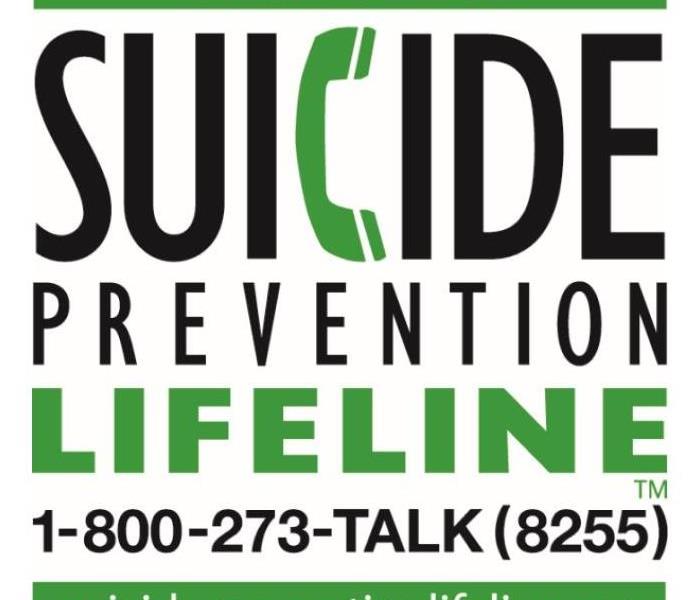 September is National Suicide Prevention Awareness Month. You can help by sharing information and offering resources to those affected by suicide.
September is National Suicide Prevention Awareness Month. You can help by sharing information and offering resources to those affected by suicide.
Suicide is a tragedy that can affect any individual, whether as a person struggling with suicidal idealization and thoughts or as one of a circle of family, friends, and community members who want to help.
Many resources are available year-round for both victims and their circles, but September is the month we refocus on the supports in our community. Suicide prevention is only effective if the information is made available and shared throughout the Riverside area, and we are reminded each September to do our part to make this happen.
Now is the time for all members of the community to come together to share information and offer resources to those affected by suicide. Connecting potential victims with treatment options and supporting survivors with the personal and practical services needed to begin the healing process are crucial components of a caring and effective response to these painful and traumatic events.
Victims and families deal with a broad array of issues in a suicide. Extending a hand to neighbors, friends, family, business partners, and others is the least our community can do to help. When the community comes together in an effort to conquer this challenging set of circumstances it gives cause for hope to those who are directly affected. We are honored to be part of a multifaceted team extending a hand to our neighbors experiencing this type of loss.
SERVPRO of West Riverside City offers compassionate and professional services if you are in need of assistance after a suicide-related tragedy. Our office staff, managers, and technicians are prompt, discreet, and sensitive as we help at this difficult time. Crew members assigned to your home or business train thoroughly in all aspects of trauma scene abatement, providing thorough cleanup always with the utmost respect for you, your family, and others impacted by the crisis.
Aug 26 National Dog Day, How Can Riverside Residents Help
8/26/2019 (Permalink)
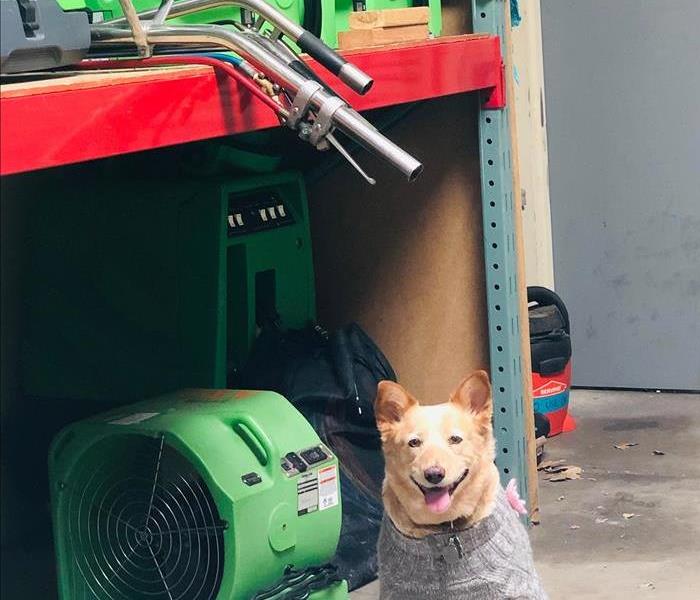 We Rescued Ellie when she was 9 weeks old, she was found roaming the streets by herself. Rescues are some of the best pets!!!
We Rescued Ellie when she was 9 weeks old, she was found roaming the streets by herself. Rescues are some of the best pets!!!
About National Dog Day, from our friends at NationalDogDay.com
National Dog Day has two goals: to honor dogs, and to rescue dogs from homelessness and abuse. It's an opportunity for us to recognize and appreciate the value and importance of dogs in our lives.
This day is intended to honor dogs for all that they do for us. In addition to giving love and companionship, dogs help us out in countless ways:
- They are watchdogs for our safety.
- They lead the blind.
- Dogs aid in search and rescue,
- They seek out bombs and drugs.
The second goal of National Dog Day is to rescue dogs in need. On occasion, dogs need us to save them from homelessness and abuse. The goal of the National Dog Day foundation is to rescue 10,000 dogs a year. Lend a hand to help a dog in need today, or any day.
Check out our local shelter in Riverside:
https://www.rcdas.org/
ADOPTION FEES
Dogs
Fees
0-15 Days
$105
16-30 Days
$55
31 Days and Over
$20
Senior Adoption Rates
50% Off
Active Duty and Veteran Adoption Rates
Free
Department of Animal Services Mission, Vision and Values
Mission
Working together to improve Riverside County for people and animals
Vision
Promoting an environment of responsible pet ownership through progressive animal welfare initiatives, community outreach, and humane education in a culture of compassion, creativity, and integrity.
Core Values
We believe the character of our organization is best reflected in the strong dedication of each of us to strive to meet the highest standards of performance and compassion on behalf of the animals and people we serve.
As stewards of those who cannot speak for themselves, we recognize society has entrusted us with a great responsibility. Our community's expectations and trust give us the courage to perform our duties with transparency, honor, empathy and compassion.
We meet this vision by our shared commitment to:
- Demonstrating respect, sensitivity and understanding toward all people and animals.
- Improving Riverside County through education, humane sheltering, responsible pet placement, progressive law enforcement, and reduction of pet overpopulation.
- Using adoption, education, and veterinary medical programs as an alternative to euthanasia.
- Seeking lifetime homes for the pets we place.
- Providing the tools, environment, and information to foster a safe and healthy workplace with an emphasis on teamwork.
- Collaborating to improve Riverside County for its people and animals.
National Dog Day celebrates all dogs, mixed breed and pure. Their mission is to help galvanize the public to recognize the number of dogs that need to be rescued each year and acknowledges family dogs and dogs that work selflessly each day to save lives, keep us safe and bring comfort.
Dogs are amazing, courageous, sensitive and sentient beings that deserve compassion and respect. Please consider bringing what was once considered "unwanted love", into your heart and home on National Dog Day!"
To see the dogs up for adoption at the Riverside Shelter click the link below:
https://www.rcdas.org/petharbor/secured_PetHarbAdoptSearch.html
NationalDogDay.com lists 20 ways to celebrate:
- Adopt a dog from your local shelter
- Have a safety check of your home to be sure it's safe for your dog and others
- Donate blankets, food and toys to animal welfare organization
- Organize a peaceful demonstration in front of your community pet store that sells puppies
- Write your congressman and ask that he/she support the ban on puppy mills and gas chambers in your state
- Sent a dog related gift to a friend or family member
- Have a National Dog Day party and invite your friends and their dogs
- Spend the day taking photos of your dog and then enter their photo contest
- Buy an official National Dog Day Tee and sport it proudly
- Assist and ill or elderly neighbor by walking their dog
- Have a portrait painted of your dog to suspend the fleeting magic of dogdom
- Buy your dog a fun new dog toy…or two…or five
- Give your dog some fun exercise by taking him/her to a doggy play resort
- Brush your dog to eliminate excess fur
- Give your dog a massage or holistic spa treatment
- Teach your dog a new trick
- Buy your dog a fashionable collar or leash
- Hire a professional pet photographer for a fun photo shoot
- Take your dog to the beach
- Say "Because Dogs" all day , every time someone says hello
SERVPRO of West Riverside City is a strong believer in rescuing dogs from our local shelters rather than shopping for one elsewhere. Our Mascot Ellie, a Cattle dog mix, was rescued from Inland Valley Humane Society. She has been a loyal, happy dog that we have owned for 8 years. She was found roaming the streets at just 8 weeks on her own. We fell in love with her when we first met her and new she would be a great addition to our family. She loves coming to work and is on her best behavior when in the office.
August means Back to School for kids!
8/21/2019 (Permalink)
August is here and that means it's time to head back to school!
Running a public or private Riverside school leaves you with many plates to balance, not the least of which is the upkeep and maintenance of the facilities to provide a safe and functional learning space for students. Disasters and water loss incidents can occur with little warning, but many of these situations can spread more quickly than custodial staff can manage, leading to either inadequate cleaning of the mess that has occurred or new areas becoming unnecessarily damaged from spreading water that your janitorial crew cannot prevent.
Educational institutions can depend on their local technicians at SERVPRO of West Riverside City for fast, thorough service in the event of fire, water or mold damage. With 24-hour emergency response, SERVPRO Franchise Professionals provide mitigation, cleanup and restoration services to reduce recovery costs and to help ensure minimal interruption to your curriculum. SERVPRO of West Riverside City also provides expert cleaning for emergencies or special needs exceeding routine janitorial capabilities, including stain removal, upholstery and drapery dry cleaning, indoor air quality and vandalism cleanup. Our Franchise Professionals are trained to clean and sanitize building materials, surfaces and contents following restoration industry standards, using professional cleaning products and EPA registered cleaners and disinfectants.
Types of Facilities:
Early Childhood - Preschool and Nursery SchoolsPrimary - Elementary and Middle SchoolsSecondary - High school and AcademiesHigher Education - College and UniversitiesAthletics - Gymnasium, Sports Complex and StadiumsWhen our professionals arrive at your school, we can get to work on inspecting the damage to determine the best approach to remove the moisture and restore the effects. In some situations, extraction might be a necessary inclusion to the restoration process.
Drying is critical to prevent the spread of the damage to new areas and to protect the structural integrity of saturated materials. Throughout this drying process with dehumidifiers and our air movers, we can monitor our progress with the use of moisture detection equipment and thermal imagery cameras. These tools can identify moisture pockets that require attention and focused efforts. This technology can help us to maximize our drying efforts to provide the most efficient and effective approach to eliminating the moisture and dampness from a recent water loss incident.
To restore and reopen our Riverside schools, SERVPRO technicians start by spraying down the standing water and every surface that might have been affected with a strong, anti-bacterial agent. Spraying reduces the risk to property and protects both our restoration teams and school workers. After the chemical has time to take effect, our teams begin removing the water using pumps and extraction wands. Together, these devices can draw out nearly all standing water from a facility.
As we finish removing the water, other technicians begin wiping down everything the water covered or touched. In classrooms and other common areas, this means cleaning desks and chairs with the same agents and examining furniture for signs of damage. Depending on the severity, our teams may recommend disposal if restoration is not cost-effective.
For cafeterias and kitchens, cleaning is even more important. Although we do not disassemble ovens or freezer units, we do wipe down every visible surface and crawl under appliances when possible to ensure everything is ready to support the student population once more.
Our goal after a loss at SERVPRO is to help every school and other commercial facilities reopen to support our local population. If you need our services, call us today at (951) 351-8003 to schedule a visit and start the restoration process. We are here for you.
Feel free to ask about our vandalism and bio-hazard cleanup services!
Back-to-School Tips for our Riverside Residents
8/15/2019 (Permalink)
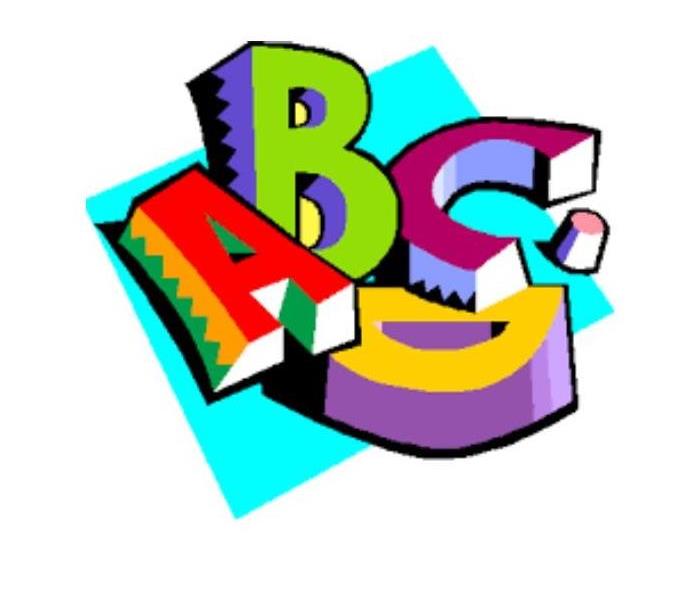 School is back in session, there things that parents can do for themselves and their kids to ensure a smooth transition into the school year!
School is back in session, there things that parents can do for themselves and their kids to ensure a smooth transition into the school year!
With a well-rounded summer vacation ending, parents spend a lot of time getting their kids ready for school. New school supplies, haircuts, and special end-of-summer outings all play into the back-to-school routine. There are some other things that parents can do for themselves and their kids to ensure a smooth transition into the school year, too. Take a look below at few ways to get this year off to a great start in your house.
Set up a bedtime and wake-up routine in advance. If possible, it’s best to establish bedtimes and wake-up times two weeks in advance of the start of school. By the time the first school bell rings, kids will already be on the right sleeping schedule and it will be one less worry for your family.
Get to know new teachers. There will be open houses, orientations, and other meet-and-greet options at the beginning of the school year, but none will give you the chance to spend some quality time getting to know your kids’ teachers. Try to find a few minutes before or after school to connect one-on-one with the teachers. At the very least, send an introductory email that includes how you can help during the school year, however big or small.
Plan healthy lunches and snacks. The better you plan out the meals in your home, the healthier choices you will make for your kids. When you pack protein-rich snacks and lunches, balanced with fruits, vegetables, and other wholesome items, you ensure that your children will have the energy and brainpower to make it through their school days.
Organize clothing. Of course you will need to donate or otherwise get rid of the clothing that your kids have outgrown, but you should also take the time to carefully organize what is left. From there, decide what items you may need more of before school begins.
Set up a staging area. Find a central spot to store everything related to school, including backpacks, upcoming outfits, and a dry erase calendar with family schedules. Try to keep this area free of clutter and other non-school items so that you can find what you need, when you need it—and quickly. Have the kids help you stock it with school-related items and keep it clean and functional. Find some inspiration here.
Update medical records. Most schools will let you know if your shot records are out of date, but why not go beyond that? Make sure teachers and administrators have a complete list of any medical concerns regarding your kids, including allergies. You will also want to be sure that all emergency contacts are up to date.
Talk to your kids about bullying. Research shows that one in three kids experience bullying at some point in their school career—and in the increasingly digital world, the consequences can be extreme. Make sure your kids understand the right way to treat their peers, and when to speak up if they see someone else being bullied. Also make sure they know when to come to you if they feel they are being bullied.
Ask your kids about their concerns. The start of school is exciting, but can also bring some anxiety—especially when it comes to the unknown. Take a few minutes to ask your kids what they are most looking forward to during the school year, and what things may be worrying them. By giving them a forum to express their concerns, you can help them work through any worries in advance of school starting and clear up any issues that could lead to a bumpy start to the year.
by SPARK
SERVPRO of West Riverside City also wants to remind Riverside residents that Safety Awareness is always important. Now, the kids may be plugging in flat irons and forget to turn them off. Some may be back onto the morning coffee, and leave the coffee pot powered on all day when they leave the house. Additionally, you may want to consider pulling out the cell phone charger from the wall when you are not charging the cell phone. Did you ever happen to feel how hot it gets plugged into the wall when it is not charging a cell phone? Also, please check smoke detector batteries, and have at least one extra set of batteries in the home--ready to go, so there is no "down time" without batteries in the smoke detector. Please have a family plan for emergency exit, and consider a minimum of two exits. Have all persons in the household agree to a designated meeting spot outside the home in advance.
Have a wonderful school year and don’t hesitate to contact SERVPRO of West Riverside if you need our help. You can reach us at 951-351-8033.
Why Your Riverside Business Should Have an ERP
8/12/2019 (Permalink)
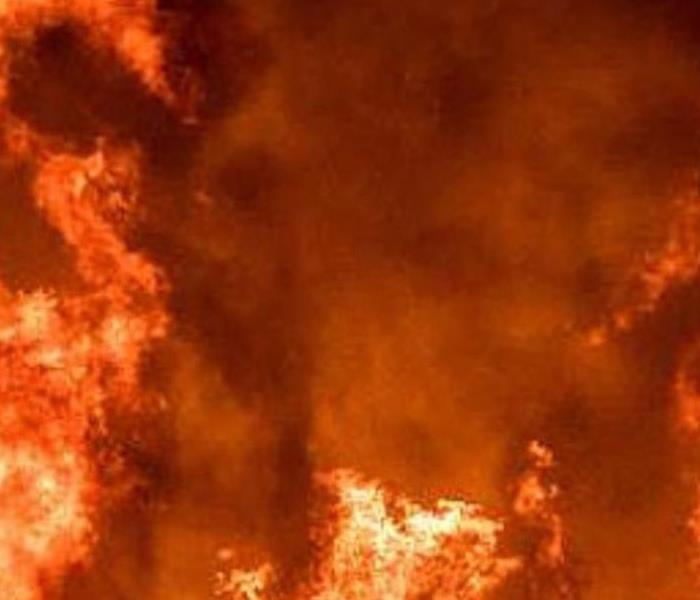 SERVPRO can expertly help you devise an effective Emergency Readiness Plan for your business in the West Riverside area.
SERVPRO can expertly help you devise an effective Emergency Readiness Plan for your business in the West Riverside area.
Benjamin Franklin wisely said, “By failing to prepare, you are preparing to fail.” It’s advice that can easily apply to a business. Water damage, fire damage, storm damage and other disasters can ravage corporations. A staggering 50 percent of these companies are too crippled to reopen. So how are the other 50 percent able to rebound? They have a readiness plan.
An ERP (Emergency Readiness Plan) is a method of planning for emergencies long before they occur. It’s a carefully devised, well-rehearsed strategy that guides you and your employees to take decisive action during a catastrophe. Here are some things to consider while putting your ERP into place:
PONDER THE WORST CASE SCENARIOS
Encourage your employees to formulate as many disaster scenarios as they can. One of the worst fires occurred in November 2018 with the Woolsey Fire and Camp Fire. Studying such tragedies can help you more effectively plot possible situations.
DETERMINE PROTECTIVE ACTIONS
It is necessary to create an ERP that protects anyone in the building. The Department of Homeland Security refers to this as “Protective Actions for Life Safety,” including:
- Fire Drills -- Rehearsals for action during a fire.
- Sheltering -- Sheltering staff during a natural disaster.
- Sheltering in Place -- Sheltering staff during a man-made emergency.
- Lockdown -- Eluding an active shooter.
LEARN HOW TO STABILIZE THE INCIDENT
Stabilizing an incident means preventing further damage on the scene. This can be accomplished by training your employees in various rescue procedures including:
- First Aid and CPR
- Proper Use of Fire Extinguishers
TRAIN AN EVACUATION TEAM
Without guidance during an evacuation, people may blindly panic. Consider adding an evacuation team to your ERP:
- Assign employees to guide evacuees out of the building.
- Appoint helpers to assist persons with disabilities.
- If an exit is blocked by a hazard such as a collapsed ceiling, make sure the evacuation team is trained to redirect employees to an alternate exit.
SERVPRO of West Riverside City, is a fast, reliable, proactive provider of emergency cleaning and restoration services for fire and water damage. SERVPRO can expertly help you devise an effective Emergency Readiness Plan for your business in the West Riverside area.
The SERVPRO Ready Plan information will give you the security of emergency preparedness. The information can be downloaded into the Ready Plan app to instantly share with SERVPRO, so that the damage can be intercepted. We’ll make it “like it never happened.”
Here is some good information from our friends at Ready.Gov
Prepare NOW
Sign up for your community’s warning system. The Emergency Alert System (EAS) and National Oceanic and Atmospheric Administration (NOAA) Weather Radio also provide emergency alerts.Know your community’s evacuation plans and find several ways to leave the area. Drive the evacuation routes and find shelter locations. Have a plan for pets and livestock.Gather emergency supplies, including N95 respirator masks that filter out particles in the air you breathe. Keep in mind each person’s specific needs, including and updated asthma action plan and medication. Don’t forget the needs of pets.Designate a room that can be closed off from outside air. Close all doors and windows. Set up a portable air cleaner to keep indoor pollution levels low when smoky conditions exist.Keep important documents in a fireproof, safe place. Create password-protected digital copies.Use fire-resistant materials to build, renovate, or make repairs.Find an outdoor water source with a hose that can reach any area of your property.Create a fire-resistant zone that is free of leaves, debris, or flammable materials for at least 30 feet from your home.Review insurance coverage to make sure it is enough to replace your property.Pay attention to air quality alerts.Survive DURING
Evacuate immediately if authorities tell you to do so.If trapped, then call 911 and give your location, but be aware that emergency response could be delayed or impossible. Turn on lights to help rescuers find you.Listen to EAS, NOAA Weather Radio, or local alerting systems for current emergency information and instructions.Use an N95 masks to keep harmful particles out of the air you breathe.If you are not ordered to evacuate but smoky conditions exist, stay inside in a safe location or go to a community building where smoke levels are lower.Be Safe AFTER
Listen to authorities to find out when it is safe to return, and whether water is safe to drink.Avoid hot ash, charred trees, smoldering debris, and live embers. The ground may contain heat pockets that can burn you or spark another fire. Consider the danger to pets and livestock.Send text messages or use social media to reach out to family and friends. Phone systems are often busy following a disaster. Make calls only in emergencies.Wear a NIOSH certified-respirator dust mask and wet debris down to minimize breathing dust particles.Document property damage with photographs. Conduct an inventory and contact your insurance company for assistance.Wildfires dramatically change landscape and ground conditions, which can lead to increased risk of flooding due to heavy rains, flash flooding and mudflows. Flood risk remains significantly higher until vegetation is restored—up to 5 years after a wildfire. Consider purchasing flood insurance to protect the life you've built and to assure financial protection from future flooding.
ABC's of SERVPRO of West Riverside and the Restoration Industry
8/7/2019 (Permalink)
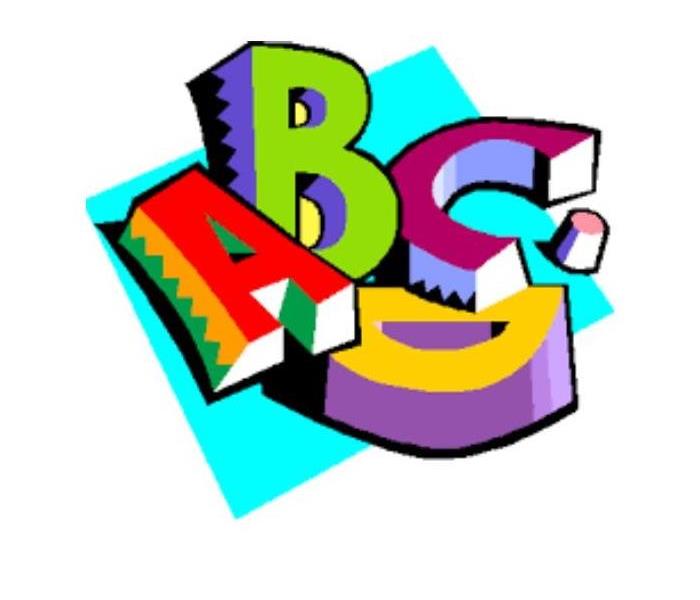 How many of these facts did you already know?
How many of these facts did you already know?
August has arrived and with August comes back-to-school time! In the spirit of the back-to-school season, we thought this would be a great time to present the ABC’s of SERVPRO and the restoration industry! Why leave the learning just for the kids?! How many of these facts did you already know?
A - Air: SERVPRO of West Riverside City inspects heating, ventilation and air conditioning units (HVAC). Keeping them clean can extend the life of the equipment. This can in turn save you money and give you cleaner air to breathe.
B – Biohazard: Exposure to biological and chemical contaminants can pose serious health consequences. A failure to properly remove such substances can contribute to unhealthy and dangerous environments. SERVPRO of West Riverside City is trained to safely remove biohazards and dispose of them properly in accordance with OSHA and health regulations.
C - Commercial Services: Cleaning and restoring commercial properties require a unique blend of training, experience, and equipment. SERVPRO of West Riverside City has the resources and expertise to give you excellent results while minimizing the disruption to your clients.
D - Disaster Recovery: The SERVPRO Disaster Recovery Team can provide help whether you're dealing with a wild fire, wind damage or flood. The SERVPRO System has a network of strategically positioned storm teams on standby should a disaster strike near you.
E – Equipment: In the event of water damage, expert knowledge and state of the art equipment are paramount for effective drying and restoration. Trained SERVPRO of West Riverside City professionals use exceptional equipment and expertise to first create an environment favorable for drying and then to extract and eliminate moisture from the structure.
F - Fire Damage: SERVPRO of West Riverside City has the specialized fire and water damage cleanup and restoration training and experience to quickly restore your home to pre-fire condition. We also have specific training and equipment for odor removal and deep cleaning of upholstery and carpet.
G – Guidelines: As one of the nation's leading providers of restoration services, SERVPRO has developed the most extensive performance guidelines in the industry. These guidelines assure you receive the best restoration service in the industry.
H - Highly Trained: In addition to training at the regional level, SERVPRO developed the National Training Center to teach restoration and mitigation skills to Franchise Owners, employees, and insurance industry employees.
I - Insurance Services: SERVPRO strives to maximize the satisfaction of insurance companies and customers by developing and managing business-to-business relationships within the insurance industry.
J – Job: No job is too large for SERVPRO to handle. Our elite large-loss specialists are pre-qualified and strategically positioned throughout the United States to handle any size disaster.
K – Knowledge: SERVPRO professionals are equipped with the knowledge to restore your property. SERVPRO Franchise Professionals are highly trained in property damage restoration, from initial and ongoing training at SERVPRO’s Corporate Training Facility to regular IICRC industry certification.
L – Local: SERVPRO of West Riverside City is a locally owned and operated business. We live and work in this community too, so we are close by and ready to respond immediately when you need cleaning or restoration services.
M – Mold: Any home or commercial property can quickly become infested with mold if a source of water is present. And mold can spread throughout a property in as little as 48 hours. If mold is found, we have the training, equipment, and expertise to remediate your mold infestation.
N - National Network: SERVPRO of West Riverside City is part of a national network of over 1,650 Franchises, which allows us to respond quicker with more resources.
O - Odor Removal: As experts in deodorization, SERVPRO of West Riverside City Professionals are trained to identify and eliminate offensive odors.
P - Property Restoration: Restoring property is the first priority of SERVPRO of West Riverside City. Customers appreciate the immediate response and should know that everything is being done to limit the damage.
Q - Quick Response: In many cleaning and restoration situations, immediate action is needed. SERVPRO of West Riverside City provides emergency cleaning and restoration services 24 hours a day, 7 days a week—including all holidays.
R - Restore First: SERVPRO of West Riverside City Professionals clean and restore property using specialized equipment and cleaning techniques. Their “restore first” mentality reduces interruption and gets customers back to their life.
S - Storm Damage: Storms occur with little warning and can be devastating. Regardless of the type of storm, SERVPRO Franchise Professionals can handle any size disaster. During catastrophic storms and major events, our Disaster Recovery Team can respond quickly with additional resources.
T – Trusted: SERVPRO is a Trusted Leader in the industry with over 1,650 Franchises.
U - Upholstery Cleaning: Upholstery and carpet materials vary dramatically. The SERVPRO System offers a number of cleaning options to match any type of upholstery or carpet.
V – Vandalism: SERVPRO of West Riverside City will act quickly to remove vandalism and graffiti from home and commercial spaces. In addition to removing spray-painted graffiti from exterior walls, we can also clean driveways, walkways, asphalt, metals, wood, glass, plastic, and masonry.
W – Water Removal: Professionals at SERVPRO of West Riverside City are water removal and cleanup specialists and are ready to help when flooding or water leaks cause water damage. Crews quickly dry the property using state-of-the-art water removal equipment and advanced drying techniques, documenting the drying process to make sure the property is dry and the job is done right.
X – eXtraction: Water extraction removes the majority of the water from the home or property. By performing a thorough water extraction, SERVPRO Franchise Professionals help reduce the drying time which helps to prevent mold and secondary water damage.
Y - Your Peace of Mind: The goal of SERVPRO of West Riverside City is to restore both the customer’s property and their peace of mind through timely mitigation.
Z – oZone: SERVPRO of West Riverside City uses commercial grade ozone machines to eliminate odors in spaces. Ozone machines efficiently and effectively break down organic matter, killing the odor at its source.
Understanding Homeowners Insurance for your Riverside Home
8/5/2019 (Permalink)
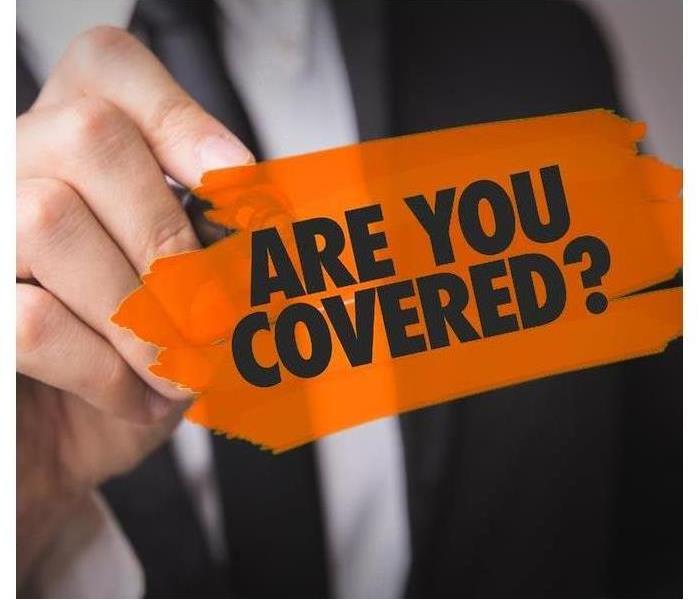 Make an appointment with with your agent yearly to ensure you have the proper coverage.
Make an appointment with with your agent yearly to ensure you have the proper coverage.
First-time homeowners are faced with many realities of being “an adult,” and one of the things that comes with owning a new home is making sure you have proper insurance. But not all insurances are the same.
Just because you have insurance on your home doesn’t mean you’re protected from everything that could happen. In fact, often with homeowner policies, there are some very common occurrences that might not be covered.
Homeowners insurance differs from state to state, so to avoid making costly assumptions, it’s important to understand what’s included with your policy.
Here in Riverside we see so many of our customers who do not understand their homeowner's policy. Here is a quick guide to how your policy may be explained.
As a homeowner, one of the most important aspects of your home isn’t something you use daily. And it isn’t something flashy you show off to friends. It’s your homeowner's insurance policy, and it protects you in more ways than you may think, helping you rebuild your home or repair damage that results from a covered loss.
But, that’s not all. It can also help cover the costs of a lawsuit, help you pay for somewhere else to live when your home is uninhabitable and much more.
Home insurance is typically very comprehensive, but all policies have exclusions and coverage limits. It’s vital to know what those are so you know what’s covered and what’s not. Fire damage? Typically covered. Flood damage? Typically not.
With this guide, you can begin to understand what a typical home insurance policy covers. Just keep in mind that coverage varies from carrier to carrier, region to region and even policy to policy. Only your individual home policy can tell you the coverage you have and that which you don’t. For an even better understanding of your home policy coverage, review it with your local independent agent.
What Home Insurance Covers The typical homeowner's insurance policy has six types of coverage. They are commonly known as:
- Coverage A: Dwelling, for damage to your house that occurs due to covered losses, such as a fire. Following a covered loss, dwelling coverage helps you repair or rebuild your home, including the structures, such as a garage or a deck, attached to it.
- Coverage B: Other Structures, for damage to other buildings or structures on your property that result from a covered loss, such as a tornado. This may include a detached garage, a barn or a fence.
- Coverage C: Personal Property, for damage to or loss, including theft, of your personal belongings and possessions, such as jewelry, furniture, guns, and other valuables. If you experience a covered loss, this coverage will help you replace items up to the defined dollar limit in your policy. In certain instances, your belongings may be worth more than the typical home insurance policy covers. In this case, you may be able to purchase additional coverage through a process known as “scheduling valuables.” To help expedite a personal property claim, it helps to keep an updated home inventory of your belongings.
- Coverage D: Additional Living Expenses, for costs incurred, up to your set policy limit, due to “loss of use” of your home, meaning your home has been damaged to the extent that you cannot live in it and you need to live elsewhere. This coverage helps you handle the costs of your temporary housing and related expenses.
- Coverage E: Personal Liability, for damage to other people’s property for which you are responsible. This coverage may also help you handle legal costs and liability judgments resulting from a lawsuit, up to the defined dollar amounts outlined in your policy.
- Coverage F: Medical Payments to Others, for bodily injuries to other people, such as a houseguest, that occur in your home or on your property. Like personal liability coverage, this coverage helps with the costs of a lawsuit or legal decision, up to your defined policy limits.
Remember that, despite having all of these different types of coverage, you’re only covered up to the dollar amounts that you select and only for covered losses, as outlined in your policy. Typically, you can change these policy limits at any time if you’d like to purchase more coverage. This is a good idea if, for example, you’ve recently added on to your home, acquired some pricey personal belongings or made other updates to your property. If needed, you can also reduce your coverage, though always ensure you are adequately protected.
What Home Insurance Doesn’t Cover
It’s just as important to know what your homeowner's insurance doesn’t cover as it is to know what your home policy does cover. For starters, your policy does not cover any damage or repairs costing less than your deductible. It also does not cover any costs that exceed the coverage limits outlined in your policy. You are solely responsible for excess costs unless you have an umbrella policy to provide additional liability coverage for a covered loss.
More than likely, your policy also does not cover routine maintenance and repairs, as well as damage due to animals, termites, floods, earthquakes, sinkholes, sewer backups, and other incidents. These are often considered non-covered losses. If you experience a non-covered loss, as outlined by your policy, you will be responsible for the costs.
What Home Insurance May Cover
Outside of the typical home insurance coverage, optional or separate coverage may be available from your carrier or from a different carrier. For example, you may be able to purchase earthquake or flood coverage separate from your homeowner's policy.
Other coverage options are add-ons to your existing homeowner's insurance. These can include identity protection and equipment breakdown coverage, which covers the cost to repair or replace a range of appliances and other equipment, such as pool equipment, in your home. If this sounds similar to an extended appliance warranty, it is. The difference is that you can insure an array of appliances at once through this optional coverage rather than purchasing a separate warranty for each one.
This guide is a starting point for understanding your home insurance policy. Your own policy may vary greatly from the descriptions above depending on the state where you live, your carrier, and the coverage you have selected. So take a close look at your policy by reviewing your documents or viewing your coverage online. Or, even better, sit down with a local insurance agent who can explain your coverage in detail, as well as discuss whether your policy provides adequate protection for your home, property, and belongings.
From our friends at Safeco Insurance
Renters Insurance
According to Insurance Information Institute
“Many renters are under the misconception that their landlord’s insurance policy will reimburse them if their personal property is damaged or destroyed, but that’s just not the case,” says Salvatore. “Fortunately, renters have a range of insurance options to choose from.”
Renters insurance provides financial protection against damage to or loss of personal possessions due to hurricanes, fire, lightning, theft, explosion and other disasters listed in the policy. There is even coverage for water damage caused by burst pipes or a neighbor who forgets to shut off the water in the tub. Coverage is available on either an actual cash value basis (depreciated value) or for its replacement cost (no deduction for depreciation). Renters insurance does NOT cover flooding and earthquake, but separate policies can be purchased for these event
Should You Board Up your Commercial Property After a Fire?
7/31/2019 (Permalink)
If your commercial property in Riverside, California, has experienced a fire, there are several reasons why you might want to board up structural damage or windows. In addition to keeping the external elements out of a building with fire damage, boarding up can also prevent additional losses due to looting and make the fire cleanup process easier.
Most full-service restoration specialists offer boarding-up services. Here are four reasons to board-up after a fire.
1. There is still viable stock on the premises. If products that appear viable remain in the building, you should consider boarding up. These items may require assessment and cleaning and may not be fit for sale, but having them properly processed rather than stolen can be helpful for insurance purposes.
2. You want to protect electronics and other valuables. Depending on the extent of the fire damage, you may be able to restore some electronics or other valuable property to working condition. Loss can be far more expensive than restoration or covered replacement.
3. You need to keep out the elements. If the structure of your property has sustained extensive damage, you should try to keep the elements out. Exposure to additional water, wind, or sunlight can compound the damage caused by smoke residue and soot.
4. You want to limit soot damage. It is generally a good idea to reduce foot traffic on the scene of a recent fire. When soot gets embedded into carpeting or upholstery, it can be much more difficult to restore these materials to a pre-fire condition.
Talk to restoration experts at SERVPRO of West Riverside City, about whether boarding up is a good strategy for preventing loss and limiting damage after a fire. Your major concern is likely to be how to recover from fire damage as quickly and completely as possible. Preventing looting and exposure to the elements can make fire cleanup more successful. Don’t hesitate to call us (951) 351-8033.
Have You Reviewed Your Insurance Policy Recently?
7/29/2019 (Permalink)
 Avoid a gap in your coverage, contact your insurance agent to review your policy.
Avoid a gap in your coverage, contact your insurance agent to review your policy.
Insurance policies are living documents. They can, and should be, changed periodically to accommodate changes in circumstances and needs of the policyholder.
A home renovation or upgrade can affect the value of your home and the coverage you need, and may qualify you for additional discounts. Furthermore, if you insured your home for a certain amount when you bought it, the home may have increased in value significantly over the years, even without renovations. This could leave you with a gap in coverage, making it difficult to rebuild if the home is lost through fire or other disaster.
Finding Available Discounts
Ensuring you have adequate coverage is not the only reason to review your insurance policies at least once a year. It is worth doing to make sure you benefit from any available discounts. For example, you may qualify for a discount on your homeowners insurance if you have installed a security system, or a roof that is resistant to hail. Many people save more than 20 percent on premiums by bundling insurance – buying their auto, home, and life insurance policies from one insurance provider.
Insurance companies are constantly creating new products and services to stand out and attract customers from other insurance companies. For those who qualify, some of these new features can save policyholders money in the long run.
Update Home Inventory
Your home inventory is a tool that your agent can use to determine the right level of coverage for your homeowners insurance. Plus, if you have a claim, having an up-to-date inventory will benefit you and get your claim paid faster. If you haven't done an inventory on your home in a while, we have some tips on where to start. If you have completed an inventory, right after the holidays are and ideal time to update! Be sure to share the updated home inventory with your agent when you're done.
Right-Size Your Life Insurance
Life insurance is not one-size-fits-all. Your coverage needs to evolve over time. If you don't have a policy yet, now is a great time to talk to your agent about what type of policy would best suit your needs (and your budget.) We have six things you should consider when you are looking at coverage.
If you do already have life insurance, is it working hard for you? Could you get more benefit out of your policy while you are still living? Maybe. Talk to your agent about the ways you can make your existing policy work for you and your family.
Prepare for the Unexpected
You try to be as prepared as possible, but you never know what is right around the corner. Prepare for unexpected risks with an umbrella policy. Umbrella earns its name because the coverage arches over your vehicle and homeowner's insurance to provide an extra layer of protection: it starts where vehicle and homeowner's insurance liability limits stop. You might be surprised by all the things umbrella policies cover for an affordable price.
Call Your Agent
When was the last time you evaluated your coverage's with your agent? Your agent can do an annual review and make sure you are covered where you need it (and aren't paying for coverage's you've outgrown). Life changes fast, make sure your insurance keeps up. Contact your agent and schedule a brief review today.
Like home maintenance, an annual insurance review is something that can go a long way to protecting what is likely your biggest investment. Your local agent will know the details of coverage for your neighborhood.
When was the last time you reviewed or updated your homeowners insurance policy?
Choosing the Right Biohazard Cleanup Service in Riverside
7/22/2019 (Permalink)
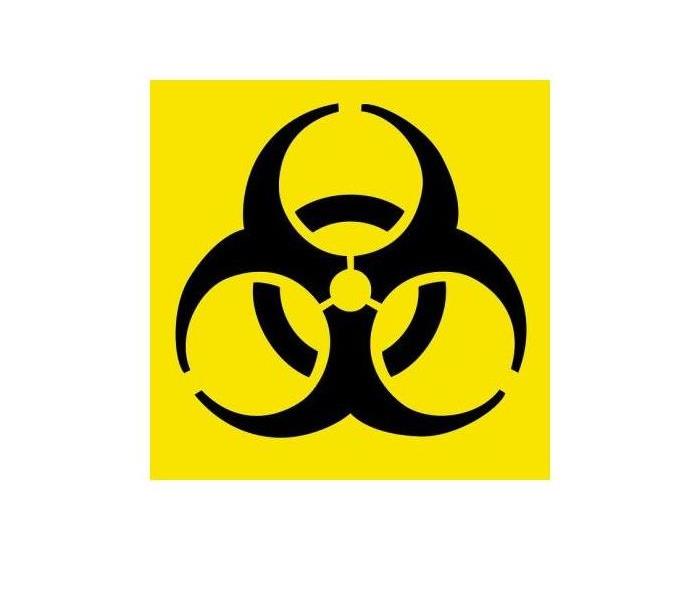 Biohazard cleanup requires professional equipment, following OSHA standards and disposing the waste, including blood, and bodily fluids safely.
Biohazard cleanup requires professional equipment, following OSHA standards and disposing the waste, including blood, and bodily fluids safely.
Always Choose Trained Professionals
Because it’s traumatic: No one should have to deal with the personal impact of cleaning up after the traumatic loss of a loved one. A professional SERVPRO can get a situation cleaned up quickly, compassionately and discreetly.Because it’s safer: Federal regulations classify all human and animal remains, including blood, urine, feces, vomit and bodily fluids, as biohazards. This is because they have the potential of carrying life-threatening pathogens such as Hepatitis B and C, AIDS, HIV, MRSA, Tuberculosis and many more. The safe cleanup and removal of biohazardous materials involves extensive analysis and detailed work, and the use of state-of-the-art cleaning and odor removal technologies.Need Biohazard Cleanup? Call Us Today – 951-351-8033
Licensed Bonded & Insured
It is important to use licensed professionals because they conduct safe cleanup, removal and disposal of bio-hazardous waste. Additional considerations include being registered and compliant with OSHA and FEMA, federal agencies that oversee disasters and workplace safety. Cleanup crews will be coming into your home or the home of your loved one, so be sure the professional you choose is bonded and insured.Approved Vendors for Most Major Insurance Companies
In most cases, insurance will cover much or all of the cost of traumatic even cleanup. You can minimize or eliminate your out-of-pocket expenses by working with licensed and bonded professionals such as SERVPRO of West Riverside City who will deal directly with insurance companies, saving you one more headache in this already difficult process.We provide cleanup and recovery services for many biohazard situations. These include the following:
Sewage backupsCrime scene residuesSuicide/death accidentsHomicide cleanupsBlood cleanupAccident cleanupHoarding scenesAnimal waste/remainsChemical spillsTear gas cleanupMeth lab cleanupFrequently Asked Questions (FAQ)
Q. Can I just use my regular cleaning or janitorial service for biohazard cleanup of blood or bodily fluids?
A: Not unless your regular cleaning or janitorial service has been properly trained and equipped to handle biohazard cleanup and waste such as blood or bodily fluids, and has a legal place to dispose of the recovered biohazardous waste.
Q: Who pays for bio-recovery services?
A: In many cases home, business or auto insurance will pay for bio-recovery services. Ultimately the property owner may be responsible for cost of the service.
Q: Can I have an employee of my business clean the scene?
A: Federal Regulation 29cfr1910.1030 states that no employee can be placed in a position to be exposed to biohazard cleanup of blood spills without first:
Receiving Blood Borne Pathogen (bbp) training.Having a written BBP exposure control plan.Having been provided personal protective equipment.Having been offered Hepatitis B vaccine and exposure evaluation and follow-up.Being provided with a method to remove and properly store the bio-hazardous waste in properly marked containers for disposal at an approved site.For more information please visit:
Biohazard Cleanup & Restoration by SERVPROBiohazard Emergency Tips - Until Help ArrivesTrauma & Crime SceneVandalism & GraffitiEnvironmental Protection Agency (EPA) Hazardous Waste Laws & Regulations InformationAn ordinary cleaning crew is untrained in the cleanup of biohazard materials and crime scenes. The property affected by biohazard waste must be fully decontaminated to be habitable again.
When selecting a vendor to provide biohazard cleaning services, first make sure the company complies with all OSHA standards, not only with the Bloodborne Pathogens program. OSHA regulations that must be followed during the cleanup include Personal Protective Equipment, Hazard Communication and Heat Illness, among others.
Call SERVPRO of West Riverside City we can help. 951-351-8033.
SERVPRO has the Training and Resources to Handle your Commercial Water Damage
7/17/2019 (Permalink)
SERVPRO of West Riverside City handles not only residential damage and restoration, but commercial as well.
Professional water damage restoration services, experts with the right combination of training and resources can quickly identify the problems plaguing your property, take steps to restore your property and belongings, and return the area to a safe, healthy space so that you can get back to work without unnecessary delay.
At SERVPRO, we understand the damage that water or fire can do, and we are always ready to make it “Like it never even happened.” Our teams include restoration professionals trained in water damage restoration, applied structural drying, odor control, and upholstery and fabric cleaning. When you reach out to us for help, we do not hesitate. We move quickly to assess the situation and prevent further damage. We use our knowledge and specialized equipment to identify all the areas impacted by the water, including any hidden pockets of moisture.
After identifying the source of the water, we will create a plan to effectively deal with the troubles at the scene. If water remains, we can use professional-grade pumps and vacuums to extract it before shifting to dehumidifiers and air movers as we carefully monitor the drying process to ensure that the structure and its contents are properly dried.
We also begin working to clean and restore your belongings. With an expansive arsenal of professional tools and techniques, we can save items that many others would forsake, so you retain more of your property and reduce your replacement costs. We can also take steps to sanitize the location with antimicrobial treatments to prevent mold issues and deodorize the space to remove musty, unpleasant odors. We work diligently to restore your commercial facility to its preloss condition so that you can get back to business.
Commercial Damage Levels
There are three levels of commercial damage that are considered:
Level 1
Level 1 is a small commercial loss typically involving 15,000 square feet or less of affected floor space. If the facility was entirely affected, examples of a small commercial loss may include, but are not limited to, a stand-alone retail establishment, a small church, a daycare facility, a small shopping center, a small warehouse or manufacturing facility, or a stand-alone administrative building. A Level 1 loss can also be a small portion of a much larger structure.
Level 2
Level 2 is a midsize commercial loss typically involving 15,000 to 60,000 square feet of affected floor space. The building or buildings involved are usually multi-level or greatly divided spaces. If the facility was entirely affected, examples of a Level 2 loss may include, but are not limited to, a small multi-family property, a midsize church or school, a small shopping center, a multi-tenant administration facility, or a midsize warehouse or manufacturing facility. A Level 2 loss can also be just a portion of a much larger structure.
Level 3
Level 3 is a large commercial loss typically involving more than 60,000 square feet of affected floor space. The building or buildings involved will likely be large multi-level structures. If the facility was entirely affected, examples of a Level 3 loss can include, but are not limited to, a large church, hospital, school, or university; a large multi-family property; a mid- to high-rise retail or administration facility; a large industrial, manufacturing, or warehouse facility; or a large strip-style shopping center or shopping mall. This is the level at which it would be appropriate to refer to the project as a “large loss.”
Once our team determines the level of loss, the property is further assessed, and a team of appropriate size is dispatched.
Commercial Property owners and Property Managers are entrusted with keeping their businesses operational. Facilities Managers rely on us to be ready for Whatever Happens.
General Adjusters and Consulting firms from around the Inland Empire trust SERVPRO of West Riverside city with their most complex claims. Some of our specialties include
- Small Office Buildings
- Large Office/High-Rise Office Buildings
- Apartment Buildings
- Restaurants
- Hotel/Motels
- Commercial Reconstruction
- Small Retail Stores
- Large Retail/Big-Box Stores
- High-Rise Residential
- Manufacturing & Industrial
- Government/Military
- Universities
- Schools
- Restaurants
- Commercial Disaster Recovery Services
We are available around the clock to get your business back up and running. Our expertise includes restoration services for fire and water damage. We are also your business’s best resource for mold remediation. Learn more about our commercial restoration services by calling SERVPRO of West Riverside City at 951-351- 8033.
Why Won't My Water Damage Mitigation Company Give Me an Estimate?
7/15/2019 (Permalink)
It's considered standard practice in the construction industry to expect an estimate of the cost prior to the work being performed. Why then would a Water Damage Mitigation Company refuse to provide an estimate?
It saves money
There are actually a number of reasons why estimates are not normally supplied for water damage drying and mitigation services. First and foremost, when a water damage loss or flood occurs to a property, time is of the essence. Even small delays in getting the mitigation and drying started can result in a substantial amount of additional damage, and associated cost, to the property. The Insurance Industry, which has spent countless billions of dollars paying water damage claims, does not require Mitigation Companies to provide a quote prior to performing the work. These Insurance Companies have learned that the delays associated to waiting for an estimate only increases the overall damage to the property as well as the amount the insurance company ends up paying out in damages.
Additional / subsequent damage may be the property owner's responsibility
The property owner's insurance policy typically includes a clause which places an obligation on the property owner to take action to mitigate further damages. This requires the property owner to protect the property from this further damage. In a water damage loss (pipe break, etc.) or flood, proper and timely drying and mitigation are considered necessary to stop secondary water damage. The water will continue to wick from wet building materials to dry materials, often in hidden locations such as inside wall cavities, etc., until there are no longer any dry materials thereby causing this secondary damage. Timely, professional mitigation initially slows and finally stops this process. If the property owner fails to mitigate a water loss in a timely manner, the Insurance Company can, and will, refuse to pay for any additional damage (secondary damage) caused by this delay. As a result, secondary property damage as a result of unnecessary delays while the property owner waits for price quotes could cost the property owner directly.
It prevents delays that could result in mold
In addition to secondary water damage, Mold contamination is also a factor. Delaying mitigation, even less than a day in some cases, can result in the beginning of mold growth. Once mold begins to grow, costs can skyrocket, increasing the overall job costs by 4 to sometimes 10 times what would have been necessary prior to mold contamination. Prompt, professional, and timely drying and mitigation is essential to reducing costs when a water damage loss or flood occurs. Any delays, even delays associated to getting estimates, generally only increase the overall cost.
Water Damage estimates are inaccurate
Last, it is virtually impossible for a Mitigation Company to accurately estimate the price of a water damage drying and mitigation job. There are too many variables that can affect the nature of the drying, and the time and labor that may be needed to properly dry out a building. As the property dries, water infiltration, by its very nature, will still continue to wick from wet to previously dry areas until the drying is complete. As well, different building materials dry out at different rates. For instance, drywall is more easily dried out when compared to plaster. Also the humidity and temperature within the home, as well as the weather conditions outside, can often affect the drying and mitigation services to your property. It is impossible for any professional Mitigation Company to predict where water will migrate during the drying process or how quickly the property will dry. This makes it impossible to provide any accurate estimate.
Because of this, it is important to only use companies you know you can trust for your water damage drying and mitigation needs. SERVPRO is trusted by the Insurance Industry (both Insurance Adjusters and Agents), many Commercial Property Managers, and the local Real Estate Industry for their water damage drying and mitigation needs.
Should you have a need for Water Damage Mitigation, please Contact Us today! We have crews available 24 / 7 to respond to Emergency Water Damage Claims.
How to Handle Unexpected Water Damage in Riverside City
7/10/2019 (Permalink)
Unexpected water in your Riverside home or water in your business can cause a lot of problematic flood damage. It can ruin your possessions and the building you store them in. If you act quickly, you can mitigate water damage and your restoration efforts can be successful.
Don’t treat flood damage lightly. Even if the water in your Riverside home is only a half an inch deep, it can be a breeding ground for unwanted mold. The growth of mold from water in your house can ruin walls, carpets, and flooring. Water damage can also cause mold that leads to poor air quality and respiratory illness like asthma. The key to keeping your house safe and mold-free is to mitigation water in your home or water in your business very quickly. Before doing any water cleanup or drying, call your insurance company and let them know what you plan to do about the flood damage. After speaking with your insurance, use these tips for mitigation and prevention any further water damage.
Disconnect Power
Remove and unplug any electronics in the vicinity of the water in your home. The quicker you do this, the more likely you can save them from being destroyed and get the water cleanup process started. If the water has risen past the level of electrical outlets, turn off power to the area of the building. Pull up carpets and underpadding that have flood damage. You can potential save carpets if you start the water cleanup, drying, and disinfectant process immediately. You probably won't be able to save the underpadding because of they act like a sponge and absorb large amounts of water.
Water Cleanup
Getting rid of the water quickly is important to mitigating the water damage. If you can't use a wet-vac because of a power issue, the old fashioned way works just fine. Grab some old towels and bucket to sop up as much water as you can. You can pour the water down the drain or out outside onto permeable surfaces. If the situation is more than you and your wet-vac can handle, consider renting a sump pump from a hardware store. The most important thing you can for water damage mitigation is to get rid of the water in your business fast and star the drying and restoration process.
Dry the area
Once the water is out of the way, it's helpful to utilize a dehumidifier and fans for drying. Open up all the windows and get the area dry as soon as possible. If drywall has been affected, you’ll need to cut away the areas that were damaged by the water to prevent mold. Take out the baseboards if they are not real wood, as they are probably not salvageable. If it was real wood, you might get lucky and be able to save them.
Disinfecting
After the water damaged area has dried out, you’ll want to use a strong disinfectant for restoration to rid the area of any bacteria that and contribute to mold growth. Make sure to include walls and furniture.
Dispose of damaged items
Rather than throwing everything into the dumpster, consider organizing the damaged goods into piles of recyclables and non-recyclables. This way, you can help alleviate pressure on landfills and do a little good for the environment. Contact your local waste management authorities to find out how to properly dispose of electronics, furniture, and drywall. Many materials can’t be thrown into the general trash for safety and environmental reasons, so find out the correct place to dispose of the water damaged items.
It’s a nightmare to have to deal with water in the home or water in at your business, but by taking quick action, you can start the mitigation process and get the restoration done fast. Whether it's a broken pipe or a natural flood water, you can minimize the damage by acting quickly. Don’t forget to let your insurance company know what happened so they can give you the go-ahead for taking action.
Every water damage event is a little different and requires a unique solution, but the general process stays the same. So, before you risk further damaging the value of your home or facility by attempting to clean up the mess yourself, call your local SERVPRO of West Riverside City.
Calling SERVPRO of West Riverside City eases the restoration process. We are available 24 hours a day, 7 days a week. We are here to help during holidays too!
If you find yourself with water damage, call us today! 951-351-8033
Summer guests? Need to clean your house? Here are some Tips
7/8/2019 (Permalink)
Spring seems to be the perfect time of the year for a deep cleaning home due to the change of the seasons. However, you may need to prepare for summer out of town guests.
The true of the matter is that cleaning could be the most boring task that needs to be done at home or could be the easiest, all depends of the way you arrange this tasks and the actions you take every day in order to have a clean and a cozy home.
Every Riverside newer home or older home has its own unique characteristics and needs when it comes to straightening things up, there are a few basics that anyone can fall back on when it comes to cleaning.
Kitchens, bathrooms, bedrooms, living areas, for washing, replacing, dusting, sorting…not sure where to start? Don’t feel overwhelmed, here are a few handy tips that you can also use as a check list to make your cleaning easier and fun than a summer breeze. We also recommend you have all the cleaning supplies you need beforehand so you won’t be tempted to put it off.
Kitchen
We recommend that you start cleaning something you like to see shiny so this task will be more appealing as you will see the results immediately.
- Start cleaning inside and outside of refrigerator, and take the opportunity to throw out expired food products, since you will be emptying the shelves to clean them.
- Clean stove and oven and wipe down microwave
- Clean garbage disposal by freshening it with baking soda and/or citrus rinds
- Finally Sweep and mop floors with a nice clean fragrance…Your done!
Bathrooms
This task could be one of those you would like to leave it to the last, but think of the idea of enter to your fresh and clean bathroom, having a nice bath or listening to your family saying…This is great and smells fantastic!!!
- Wipe down shower and tub
- Clean toilet, counter tops, and mirrors
- Sweep and mop the floor
Bedrooms
In case you have many Bedrooms at home you can start with one per day so the task will be easy and you won’t get tired and overwhelm with the rest of the house cleaning.
- Wash bedding
- Wash pillows (or replace if needed it)
- Make space in the closet for your guests
Living Areas
This kind of areas are the most used at home so we recommend you leave it for the last task so you can clean it and organize it properly.
- Vacuum/sweep and mop floor
- Polish furniture (You can start weekly with a piece so you don’t get tired doing it at once)
- Dust electronics/media centers other.
Throughout the House
This tasks can be done one per day and depending of the amount of work needed it
- Dust furniture surfaces and ceiling fans
- Vacuum all carpets
We also recommend to contact us, SERVPRO have the expertise to provide a deeper clean than your basic house cleaning service. Our residential cleaning services will ease the burden of the constant maintenance cleaning of your home, but will also create a safe, clean, and comfortable living environment for you and your family.
You know SERVPRO as a leader in Fire and Water Cleanup and Restoration, our staff is equipped with the knowledge to restore your property. If you would like to schedule service for your home or business, please call today! SERVPRO of West Riverside City specializes in the cleanup and restoration of residential and commercial property after a fire, smoke, or water damage.
Don’t wait, be ready to enjoy your fresh, clean home organizing the activities during the coming months with this useful checklist or by contacting us, don’t rush for spring or summer time we are here to bring you a hand!
Call us if you would like your home professionally cleaned by SERVPRO of West Riverside City, we are here to help...let us do all the cleaning for you so you can feel rested and refreshed before your summer guests arrive!
Who Can You Call When your Commercial Business Experiences Water Damage
7/3/2019 (Permalink)
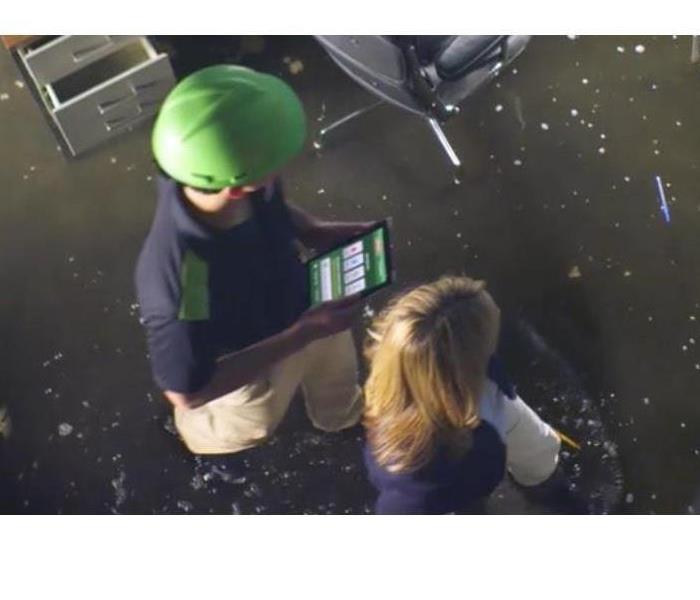 SERVPRO is a trusted and experienced commercial water damage restoration company that delivers quality customer service.
SERVPRO is a trusted and experienced commercial water damage restoration company that delivers quality customer service.
As a commercial business owner, you know that any type of water damage can be detrimental to your business.
It is crucial when faced with a water damage loss that you can resume normal operations as soon as possible to protect your business. If your business is forced to close until water damage repairs are complete your short-term losses will start to add up and your customers may find somewhere else to go which could cause you to lose their business long-term.
SERVPRO can supply precisely that with our commercial water damage restoration services. The problems caused by water damage. Why is water damage such a problem? While water is vital to life, uncontrolled water that infiltrates spaces where it does not belong can do a great deal of harm. It can cause structural damage to your commercial facility and destroy the property, equipment, and inventory that you have stored inside it. It can also produce the ideal conditions for mold growth, setting the stage for a potentially hazardous mold infestation. In fact, unattended water damage can produce health hazards and liability issues that can leave your business vulnerable to lawsuits, so it is vital that the damage is dealt with properly. When water damage occurs, time is not your friend. Any delay in addressing it allows the damage process to continue, which is likely to increase both your losses and your restoration costs. The disruption triggered by water damage can also lead to lost productivity. After all, every hour that you spend working to restore your commercial space is an hour that you were not able to spend focused on what you do best. The solution that your business needs water damage can be a significant problem for your business, but it is one with a clear solution.
SERVPRO of West Riverside City specializes in commercial water damage repair and can help ensure that damages are kept to a minimum, reducing your total losses. Commercial businesses have unique needs when it comes to water damage repairs and the best way to protect your business and its assets is to leave water damage repairs to the pros.
What to Do If Your Property Floods
When your commercial property is affected by water or flooding, the source of water needs to be addressed before water damage repairs can begin. Water damage can affect expensive or specialized equipment and inventory, and losses can quickly add up to thousands of dollars. If your property floods, quick action is necessary to mitigate the damage. SERVPRO of West Riverside City is always ready to respond.
When business owners visualize water damage, they often picture a massive storm wiping out power lines, flooding offices, and shutting down businesses for days at a time. It is true that commercial water damage is often the result of floods and water that stems from weather events and storms.
However, many entrepreneurs and business space renters forget that storms and severe weather aren't the only causes of floods and water damage. Here are some of the typical causes of water damage to commercial buildings.
1. Malfunctioning sprinkler systems
Some older office and retail buildings still have outdated sprinkler systems that work in conjunction with fire protection systems. While such sprinklers can come in handy during a fire emergency, they can also cause commercial flood damage if they are faulty or in need of replacement. This could easily damage inventory and business assets.
2. Damaged appliances and equipment
This cause of commercial flood damage is more common in restaurants and catering facilities, as well as any business that has appliances and equipment that make use of water. If the appliance fails and sends water across your building, especially during late hours when no one is around, you may come back to work and face a water emergency.
3. Broken pipes and plumbing
Just like in a residence, if the plumbing system in your workplace fails water damage could be the result.
4. Backed up sewer lines
This is another cause of commercial water damage that often catches business owners by surprise. Should the sewer line to your building back up or become damaged, realize the potential dangers of contaminated Black Water which can cause health effects and ruin products and office furnishings.
Choosing a Commercial Water Damage Repair Company
Whenever your business is affected by water damage, a fast response is necessary. SERVPRO of West Riverside City provides emergency, 24/7 service and has the equipment and personnel it takes to get your business up and running quickly. SERVPRO is a trusted and experienced commercial water damage restoration company that delivers quality customer service and exceptional water damage repair service for commercial businesses.
In an event of a disaster call SERVPRO of West Riverside City at 951-351-8033. Our SERVPRO team is available 24 hours a day, 7 days a week, 365 days a year!
Lighting Fireworks in Riverside is Illegal this 4th of July Holiday
7/1/2019 (Permalink)
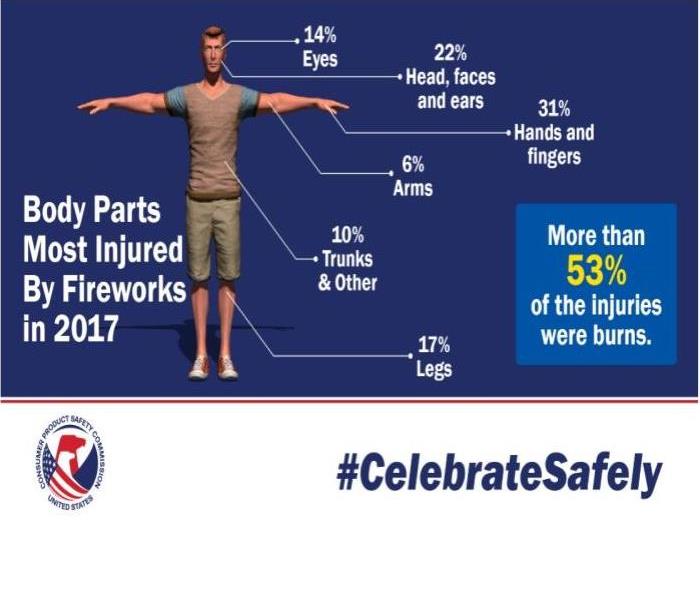 From our friends at CPSC: Fireworks are synonymous with our celebration of Independence Day. Yet, the thrill of fireworks can also bring pain.
From our friends at CPSC: Fireworks are synonymous with our celebration of Independence Day. Yet, the thrill of fireworks can also bring pain.
Residents are urged to attend free July 4 fireworks shows at Mount Rubidoux or La Sierra Park.
It’s that time of year again! Outdoor barbecues, cook-outs, summer beach vacations, and of course, fireworks! Whether you’re celebrating in your red, white and blue this weekend, or just enjoying a little backyard BBQ, knowing the laws of fireworks in your area is really important.
ALL fireworks, including sparklers, are illegal in Riverside County. All fireworks are illegal because they cause serious injuries and very often, cause fires. Riverside County has very diverse terrain. The vegetation is very dry where fireworks can easily start a brush fire. Individuals who cause fires by using illegal fireworks will be held responsible for all suppression costs. These costs can run into the millions of dollars. Read more at the State Fire Marshal website.
Residents are urged to attend free July 4 fireworks shows at Mount Rubidoux or La Sierra Park. Leaders warn ahead of July 4th, you can be fined $1,000.
4th of July Fireworks Displays in Riverside and Neighboring Counties
Many cities and communities in or near Riverside County provide spectacular fireworks displays for their residents. The operators of these displays are licensed and have permits issued by the State Fire Marshal.
Since all fireworks are illegal in Riverside County - Let the experts entertain your family at one of these events throughout the South-land:
RIVERSIDE: Fireworks at Mt. Rubidoux and La Sierra Park: Riverside
RIVERSIDE: July 4th Fireworks, Family Fest: Evergreen Memorial Historic Cemetery, Riverside
From our Friends at the U.S. Consumer Product Safety Commission
Remember, fireworks can be dangerous, causing serious burn and eye injuries. You can help us prevent fireworks-related injuries and deaths. How? By working with a national, state or local organization where you live to promote fireworks safety in your community.
Follow these safety tips when using fireworks in an area that allows fireworks:
- Never allow young children to play with or ignite fireworks.
- Avoid buying fireworks that are packaged in brown paper because this is often a sign that the fireworks were made for professional displays and that they could pose a danger to consumers.
- Always have an adult supervise fireworks activities. Parents don't realize that young children suffer injuries from sparklers. Sparklers burn at temperatures of about 2,000 degrees - hot enough to melt some metals.
- Never place any part of your body directly over a fireworks device when lighting the fuse. Back up to a safe distance immediately after lighting fireworks.
- Never try to re-light or pick up fireworks that have not ignited fully.
- Never point or throw fireworks at another person.
- Keep a bucket of water or a garden hose handy in case of fire or other mishap.
- Light fireworks one at a time, then move back quickly.
- Never carry fireworks in a pocket or shoot them off in metal or glass containers.
- After fireworks complete their burning, douse the spent device with plenty of water from a bucket or hose before discarding it to prevent a trash fire.
- Make sure fireworks are legal
The safest way to enjoy fireworks is to attend a public fireworks display put on by professionals. Those caught with illegal fireworks will be subject to fines, citation and/or arrest; including confiscation of all illegal fireworks. We urge you to leave the fireworks to the professionals!
Help Is Here
The team at SERVPRO of West Riverside City has specialized training and experience in fire restoration services, natural disaster prevention, water damage, chemical cleanup, and natural disaster cleanup.
Remember, you know who to call when disaster strikes! SERVPRO of West Riverside City 951-351-8033
Summer is Here, Enjoy Summer Safely in Riverside!
6/26/2019 (Permalink)
Please review a few tips that can help ensure you have a safe enjoyable summer.
Although we have already enjoyed several warm days here in Riverside, the official first day of summer is June 21th, 2019. Please review a few tips that can help ensure you have a safe enjoyable summer.
Your Home
As we pack away winter coats there are some things you can do to prepare your home for the season:
- Clean your refrigerator coils
- Change your air-conditioning filters
- Ensure your condensation line is clear of clogs and operating normally
- Inspect your driveway for any potential repairs needed
- Let out heat from the attic –high temperatures are a regular cause of mold
- Open windows to reduce moisture in your home
- Install screen doors; ensure the screens are in good condition
- Install reflective/tinted windows-this will protect your furnishing and reduce cooling costs!
- Add plants to your home-plants reduce toxins in the home and even offer health benefits!
- Secure your hose a safe distance from home, slow leaks has caused floods
- Inspect pool for any damage that may have occurred throughout the winter season
Water Activities
With temperatures rising in Riverside, this means a lot of us are all gearing up to take part in water activities and swimming!
We thought we would share some top water safety tips for you to remember before you jump in the water!
- Swim with a buddy. If possible, this is always the safest route no matter where you might be swimming.
- Parents, always watch your kids while they are in the pool. Disasters can happen so fast!
- Have a life jacket and first aid kit on hand. Getting in the habit of taking these things with you to swimming activities can be helpful.
For more great water safety tips, visit the American Red Cross website.
Grilling, Fire Pits, and Fire Works
There is nothing like firing up the grill during the summer months! Did you know, summertime is the season for grill fires? A backyard barbecue can become dangerous quickly if proper safety precautions aren’t considered. Consider the following tips to help ensure your summer celebrations are disaster-free!
Bar B Q Fire Safety
- Propane and charcoal BBQ grills should only be used outdoors.
- Keep a 3 foot area clear on all sides of the grill...kids and pets, too!
- The grill should be placed well away from the home, deck railings and out from under eaves and overhanging branches.
- Keep your grill clean by removing grease or fat buildup from the grills and in trays below the grill.
- Never leave your grill unattended.
- When using a charcoal grill, let the coals completely cool before disposing in a metal container.
- When disposing of any coals, please make sure you use a metal container and a lid, without anything piled on top of the lid!
Don't you just love a fire pit?
- Make sure your fire pit has a cover. It may be needed to extinguish the fire quickly and easily in the event of an emergency.
- Look around the fire pit before lighting it. Make sure there is nothing easily flammable near it...piles of dried leaves, firewood, tiki torches and/or their fluid.
- Watch out for what you are adding to your fire pit. Leaves, paper, magazines or cardboard can separate and send large fire filled pieces into the air, causing a fire elsewhere!
- Not a bad idea to have a fire extinguisher and/or a hose with the water turned on, handy.
Fire Works
It’s firework season! According to the National Fire Protection Association (NFPA), an average of 18,500 fires are started every year by fireworks. This includes 1,300 structure fires, 300 vehicle fires, and 16,900 outside and other fires. “These fires caused an average of three deaths, 40 civilian injuries, and an average of $43 million in direct property damage,” says the NFPA.
Do you think sparklers are the safe way to go? Nope: they account for about a fourth of emergency room fireworks injuries.
Stay safe this summer by paying close attention to children at fireworks events, and avoiding the use of consumer fireworks.
- Anyone using fireworks or standing nearby should wear protective eye-wear.
- Do not try to re-light or handle malfunctioning fireworks. Keep a bucket of water nearby to fully extinguish fireworks that don’t go off or in case of fire.
- Children should never pick up fireworks that may be left over as they may still be active.
- The safest way to enjoy fireworks is to attend a public display conducted by trained professionals.
Wishing you and your family a wonderful summer from SERVPRO of West Riverside City and please be safe!
If fire does damage your home or business this summer, give us a call at 951-351-8033. SERVPRO of West Riverside City will make it "Like it never even happened."
What Sets SERVPRO Apart for your Commercial needs
6/24/2019 (Permalink)
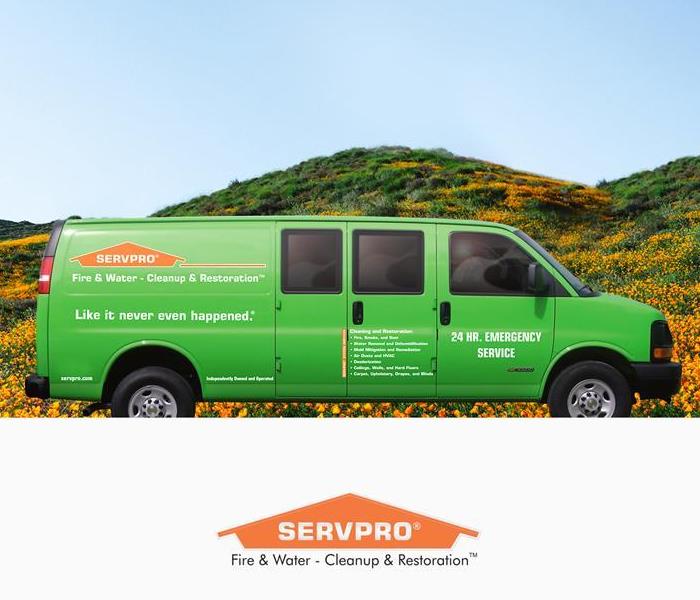 Let the professionals take the stress off your shoulders, we can make it "Like it never even happened."
Let the professionals take the stress off your shoulders, we can make it "Like it never even happened."
Here at SERVPRO of West Riverside City we often get the question of Why SERVPRO?
What is it that SERVPRO can do differently than all the other cleaning and restoration companies out there.
The answer to those questions always start the same way, with the list of all the training and certifications held by SERVPRO employees, the systematic process that is used to manage different projects, and the support provided by corporate and the SERVPRO network. While those are all valuable assets, what truly sets SERVPRO of West Riverside City apart is the people. Between the office manager and our production team, the years of experience with SERVPRO is invaluable. This experience provides them with all of the tools and knowledge necessary to handle projects of any type or size. Whether its routine carpet cleaning or a large commercial water loss or fire damage, the crew at SERVPRO of West Riverside City has the experience to make it "Like it never even happened."
Our Products
When team SERVPRO of West Riverside City comes to clean up your home or business, we have a secret weapon that ensures we can make any disaster “Like it never even happened.” Well, make that DOZENS of secret weapons.
SERVPRO stands out among its competitors, because we use our very own line of proprietary cleaning products. Those products are made to handle restoration work from fires to flood damage, biohazard to mold.
By using our own cleaning agents, we know the exact ingredients in each one. This means our technicians can ensure they perform cleanup work safely and efficiently, with the very best results.
A team of chemists and blenders creates 95 of these cleansers in-house at our corporate facility in Tennessee. The team relies on outside vendors to concoct about 45 more products. Those products from outside vendors still carry the SERVPRO guarantee of Quality Assurance and Quality Control, of course.
Here is a list of the types of products we use:
Spotting AgentsCarpet & Upholstery ProductsWood & Leather Care ProductsDecontamination ProductsDeodorization ProductsCeiling & Wall Cleaning ProductsHard Floor Care ProductsSpecialty ProductsCoatings & Sealant ProductsSERVPRO has even created a line of environmentally friendly or “green” cleansers as part of the company’s efforts to better serve our clients and community.
And while the products are created by SERVPRO’s corporate team, they’re used locally by our team here in the Inland Empire. Our technicians are trained to use each product in the safest, most effective way possible. Whether we’re simply cleaning your carpet, or cleaning up after a major sewage spill, you can rest assured we’re using the best possible tools to get the job done right.
SERVPRO offers much more than just mitigation and restoration services. We provide a wide range of both residential and commercial services. No job is too complicated, too large or too intimidating. From mold remediation, to bio-hazard cleanups and storm situations, we have tackled it all. We are also “one stop shop” for all your cleaning needs.
Trained Technicians and Efficient Equipment
The wisest business owner will seek expert help soon after the event. Failing to respond appropriately when water invades and saturates the structural components and the contents of your business can lead to progressive deterioration and increased expense when the work does begin. Lingering moisture also encourages mold growth with all the concerns that scenario brings. Our commitment to being Faster to any size disaster is why we complete projects to our customers’ satisfaction.
When you first notice water damage in your Inland Valley business, act right away. Water is extremely destructive despite its many uses, and it must be traced to its source before extraction and drying. If the leak is not addressed the damage will recur. We bring decades of experience to your situation, able to diagnose the problem and devise a plan to eliminate it and the harm it causes. Our record of success proves why we are restoration industry leaders in our region.
Removing water from your home and completing structural drying requires specialized equipment. The tools available to a homeowner are not the quality and capacity of those in our inventory. When we arrive at a work site, we have a full stock of commercial strength pumps, extractors, air movers, heaters, and dehumidifiers in our service vehicle. The proper tools make the process easier and faster, which is why SERVPRO can resolve even severe water losses rapidly.
The best equipment cannot help unless the operators are skilled. Highly-qualified technicians are another reason why SERVPRO can take a water damage scenario from chaos to “Like it never even happened.” Our investments in both equipment and personnel set us apart, giving our customers the confidence to call upon us for help under many different circumstances and recommend our services to family and friends.
A short response time is another factor when choosing a water damage restoration company. We are available by phone 24/7, why SERVPRO is the number you keep on speed dial. Since water damage needs remediation within 24 to 48 hours, our accessibility is the key to delivering the best outcome.
Our professional approach, trained technicians, and advanced technology are why SERVPRO of West Riverside City is your trusted restoration resource. Call (951) 351-8300 to set up an appointment to evaluate your water loss.
Summer Heat- How to protect Ourselves, our Workers, and Home
6/19/2019 (Permalink)
The human body is programmed to cool itself down when it gets too hot, usually by sweating.
However, severe heat conditions can cause body temperatures to rise to dangerous levels. Without drinking enough water or resting in the shade, heat exhaustion or heat stroke may occur.
Signs of Heat Exhaustion include:
DizzinessHeadacheSweaty skinWeaknessCrampsNausea, vomitingIncreased heart rateSigns of Heat Stroke include:
Red, hot, dry skinHigh temperatureConfusionConvulsionsFaintingPrepare Yourself Before Going Outside
Wear loose-fitting, light-colored clothingBe sure to apply sunscreenWear sunglassesStay hydrated and limit alcohol and caffeine intake on those days.Be aware and pay attention to signs of Heat exhaustionIf possible, limit your time outside on extremely hot days and stay indoors in the air conditioning. Be sure to check on your pets who may be outdoors or bring them inside. Staying hydrated will help you from experiencing heat exhaustion. Heat exhaustion can lead to heat stroke, which is life- threatening. Signs of heat stroke are high body temperature (103+), rapid and strong pulse, and possible unconsciousness.
Car Safety is also important for your family and pets:
NEVER leave children or pets alone in hot vehicles! Heat can rise in a car, up to 20 degrees in just 10 minutes! Even with the windows rolled down, only minutes in a hot car can be deadly for your pet! NEVER leave your pets in the car!If you see a kid in a hot car- act fast! You could save a life!Heat related deaths ARE preventable! Look before you lock!Source from Ready.Gov
Preparing our Workers
OSHA requires that employers provide workplaces free of any known safety hazards, and this includes protecting them from extreme heat. Here are some tips for establishing a heat illness prevention program:
Make sure workers are provided with enough water, rest and shade.Allow new or returning workers to gradually increase workloads and take more frequent breaks as they acclimatize, or build a tolerance for working in the heat.Train workers on signs and prevention of heat illness, and to keep an eye on fellow workers.Consistently drink water every 15 minutes.In order to cool down, find time to rest in shady areas.Wear a hat and light-colored clothing.If a worker becomes ill, a supervisor should be called immediately, followed by 911 if applicable. Make sure that someone is with the ill worker at all times until help arrives.
This issue hits home for us, since SERVPRO of West Riverside City, technicians are constantly outdoors in the Inland Empire heat. Their safety and well-being is a priority at SERVPRO.
For more information, please visit: OSHA
Prepare Your Home
Install windows air conditioners snugly; insulate if necessary.Check air-conditioning ducts for proper insulation.Install temporary window reflectors (for use between windows and drapers), such as aluminum foil-covered cardboard, to reflect heat back outside.Weather-strip doors and sills to keep cold air in. This can also help keep your electrical bill down in the summer months.Cover windows that receive morning or afternoon sun with drapes, shades, awnings, or louvers. (Outdoor awning or louvers can reduce the heat that enters a home by up to 80 percent.)SERVPRO of West Riverside City specializes in fire, water, and mold remediation. Our highly trained technicians are restoration professionals that use specialized equipment and techniques to properly remediate your home quickly and safely. We service the residents of Riverside county and surrounding counties. Contact our office staff if you have any questions about water or mold damage in your home or business area. Schedule a FREE Assessment at 951-351-8033
June is National Pet Preparedness Month
6/17/2019 (Permalink)
 June is National Pet Preparedness Month
June is National Pet Preparedness Month
A little preparation goes a long way in an emergency and having a "go bag" will help you keep calm and evacuate quickly.
This is especially important if you have the added responsibility of pets. Emergencies come in many forms, and they may require anything from a brief absence from your home to permanent evacuation. Each type of disaster requires different measures to keep your pets safe, so the best thing you can do for yourself and your pets is to be prepared.
If you already have a "go bag" or evacuation pack, use this month as an annual reminder to replace old food and medication and to update photos and emergency contact information.
If you haven't created a bag, use this list to help get you started:
- 7 days worth of food (rotate regularly and if you use canned food, buy cans with a pop-top)
- 7 days of bottled water (rotate regularly)
- Medication (rotate regularly)
- Food/water bowls
- Extra collar, harness, and leash
- Clean up supplies (pet cleaning solution and paper towels)
- Plastic bags (to serve double duty as garbage and poop bags)
- Flashlight
- Blanket
- Toys and chews
- Carrier
- Copies of medical records
- Contact information for local veterinarians, pet friendly hotels and shelters, and out-of-town family members willing to take in your pets
- Recent photo for making lost posters
- First aid kit with pet-specific supplies
For more information on preparing your canine family for natural disasters, visit the ASPCA web site.
Some things to Keep in Mind
- Locate a veterinarian or animal hospital in the area where you may be seeking temporary shelter, in case your pet needs medical care. Add the contact information to your emergency kit.
- If you are unable to return to your home right away, you may need to board your pet. Find out where pet boarding facilities are located.
- Call your local emergency management office, animal shelter or animal control office to get advice and information.
- Most boarding kennels, veterinarians and animal shelters will need your pet's medical records to make sure all vaccinations are current.
- Create a buddy system in case you’re not home. Ask a trusted neighbor to check on your animals.
- Make sure all pets wear collars and tags with up-to-date identification information. Your pet’s ID tag should contain his name, telephone number and any urgent medical needs. Be sure to also write your pet’s name, your name and contact information on your pet’s carrier.
- The ASPCA recommends micro-chipping your pet as a more permanent form of identification. A microchip is implanted under the skin in the animal’s shoulder area, and can be read by a scanner at most animal shelters.
- Get a Rescue Alert Sticker from ASPCA-This easy-to-use sticker will let people know that pets are inside your home. Make sure it is visible to rescue workers (we recommend placing it on or near your front door), and that it includes the types and number of pets in your home as well as the name and number of your veterinarian. If you must evacuate with your pets, and if time allows, write “EVACUATED” across the stickers. You can order a free emergency pet alert sticker for your home, ASPCA Free-pet-safety-pack and allow 6-8 weeks for delivery. Your local pet supply store may also sell similar stickers.
- Store an emergency kit and leashes as close to an exit as possible. Make sure that everyone in the family knows where it is, and that it clearly labeled and easy to carry.
Tips for Large Animals
If you have large animals such as horses, cattle, sheep, goats or pigs on your property, be sure to prepare before a disaster.
- Ensure all animals have some form of identification.
- Evacuate animals whenever possible. Map out primary and secondary routes in advance.
- Make available vehicles and trailers needed for transporting and supporting each type of animal. Also make available experienced handlers and drivers.
- Ensure destinations have food, water, veterinary care and handling equipment.
- If evacuation is not possible, animal owners must decide whether to move large animals to shelter or turn them outside.
Take extra time to observe livestock, looking for early signs of disease and injury. Severe cold-weather injuries or death primarily occur in the very young or in animals that are already debilitated.
Animals suffering from frostbite don’t exhibit pain. It may be up to two weeks before the injury becomes evident as the damaged tissue starts to slough away. At that point, the injury should be treated as an open wound and a veterinarian should be consulted.
Make sure your livestock has the following to help prevent cold-weather problems:
- Plenty of dry bedding to insulate vulnerable udders, genitals and legs from the frozen ground and frigid winds
- Windbreaks to keep animals safe from frigid conditions
- Plenty of food and water
Why SERVPRO is a better Choice in Riverside City
6/13/2019 (Permalink)
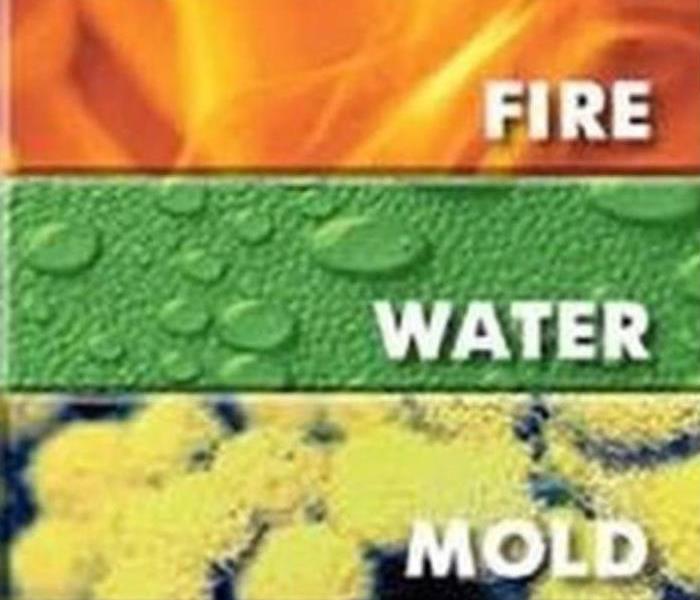 Let SERVPRO of West Riverside City prove we are the right team to help with your disaster. Call us and we can inspect your loss at no charge.
Let SERVPRO of West Riverside City prove we are the right team to help with your disaster. Call us and we can inspect your loss at no charge.
What sets us apart from other restoration companies?
We have a network of over 1700 other franchises and Disaster Relief teams that are ready to help your business get back in business 24/7. We don’t rely on phone answering services after normal business hours. If you call us between 5 pm and 8 am you will speak directly with one of our staff members. Our business hours are 24 hours a day 7 days a week 365 days a year. We understand the effects water damage can have on your business. Our certified technicians will arrive on site and preform any emergency services necessary to minimize the damage to your commercial property. We will work directly with your insurance to relieve any added stress from you.
We are Honest and Ethical
Every consumer has at least one horror story about a company or sales person who has lied to them or stretched a bill to get an extra sale. SERVPRO of West Riverside City is determined to be an ethical company who is honest with our customers about situations and billing. When your home is disrupted by things like a washing machine overflow the last thing you need is to not feel like anyone is there to advocate for you with transparency and trust. If you should experience damage to your home call the team committed to working ethically for you, SERVPRO of West Riverside City
Clean and Organized business
Every evening- sometimes it is even in the middle of the night- we return to our facility after responding to a loss. We clean all of the equipment, including the vans and trailers, so that when we respond to our next customer, we are clean, organized, and ready to spring into action!
Why is this important? When we enter your home or business, it is important that we are prepared to handle your needs immediately and efficiently. We also treat your home or business like it is ours! We believe everything should be fresh, tidy, organized, and ready to go- exactly what we would expect from someone responding to a situation at our home or business.
We are committed to giving each client "White Glove" Service. As defined by the Merriam Webster Dictionary, "White Glove" means to be marked by special care or attention : meticulous. As you can see- we fit that definition precisely! We are meticulous- even before we get to your property!
Call us today and we will provide "White Glove" service and make it "Like it never even happened"- and maybe even a bit better!
Our Training and Technology
At SERVPRO of West Riverside City we are using the latest in technology to help us perform mitigation services.
Moisture mapping technology is used to give you the best options available to get you back to "Like it never even happened."
We also do in house training on a regular basis to keep even our senior technicians fresh in the field. We look to organizations such as the Institute of Inspection Cleaning and Restoration Certification (IICRC) and Restoration Sciences Academy to learn proven techniques that work.
Our biggest piece that sets us apart would be our detailed moisture mapping, documentation, and thorough inventory processes. We have great people who make these things work behind the scenes and it makes the difference if you were to compare.
Our Process for Making, Processing and Settling an Insurance Claim
Several features set SERVPRO apart from other mitigation and restoration companies. These distinctions should be clear to an insurance adjuster as well as homeowners. Here are four ways this company facilitates the process of making, processing and settling an insurance claim.
1. Fast Response A fast response on the part of a mitigation and restoration company benefits clients and insurers. The sooner that damage can be professionally assessed, the sooner mitigation can start. A call response time of one hour, a four hour window for an on-site visit and an eight hour window for a verbal briefing can limit extensive primary and secondary damage.
2. Accurate Estimates A company can make more accurate estimates by hiring certified professionals, relying on a national network of locations for training and maintaining data on locations. An insurance adjuster can use the Claims Information Center to obtain information about individual estimates and compare different companies, causes of loss and job files costs. All of this data adds up to more accurate estimates that account for mitigation and restoration.
3. All-In-One Service Rather than working with separate mitigation and restoration companies, clients and insurers may prefer a one-stop shop. A company that handles the damage remediation process from start to finish can provide a more accurate estimate from the start. There will also be less need to worry about adjusting schedules or necessary tasks getting lost in the shuffle.
4. Electronic Claims Service In addition to the aggregated data available through an electronic claims service, this portal can also make it easy for a restoration service and insurer to share information. This resource can speed up insurance claim processing and allow for faster settlements. All of these are ways in which SERVPRO, a national mitigation and restoration company with local and regional franchises, can support insurers and clients. Whether you are an insurance adjuster or homeowner in the Inland Empire area, you should consider hiring this Preferred Vendor for the best results.
Examples of Biohazard and What To Do About Them
6/13/2019 (Permalink)
Biohazard is an umbrella term for biological materials that are a threat to living organisms.
If you own or manage a Riverside commercial property, biohazards can pose serious harm. Not just to you, but anyone who frequents your establishment. Biohazards could show up almost anywhere. If you have commercial property it is extremely important to be cautious of this threat. However, some people may not know everything that the word biohazard encompasses and how to clean it up. It covers numerous materials. There are even levels of biohazard, each one presenting different threats.
Examples of Biohazard
There are different kinds of biohazard. It is possible that some of these examples will never present themselves in your building. Of course, that does not mean you are safe from harmful materials. Blood is a huge biohazard risk. This also includes anything that has come into contact with blood, or other bodily fluids. Bloodborne pathogens and fluids can lead to disease if they come into contact with someone. Animal bedding and animal waste are also threats. This is especially true if the animal is sick in anyway. Microbiological waste is another example of biohazard. Of course, this kind of threat is more common in labs. A threat that is common in medical settings is sharps waste. This includes needles, glass slides, and scalpels.
While your Riverside commercial property may not be exposed to as many biohazards as other places, it is still exposed. It may not be obvious, but biohazards will be a threat no matter what. SERVPRO of West Riverside City can clean it up safely and efficiently.
Levels of Biohazard
There are numerous levels of biohazard, four to be exact, with different threats. Level one includes E. Coli, Bacillus subtilis, and more. These materials are just a minimal threat to people and the environment. Level two includes HIV, Hepatitis B, and Salmonella. These have the possibility to make people extremely sick. Level two biohazards are contracted through contact with any infected materials or items. Level three includes tuberculosis and other airborne pathogens. They expose people to serious illnesses. Level four biohazards pose the highest threat levels. The diseases they cause have no treatments, and could even be life threatening. This includes the Ebola and Lassa viruses. For threats of this nature it is recommended to contact your nearest EPA office for help.
What Do You Do About Them
If there is biohazard exposure in your Andersonville commercial property you may have no idea what to do. It needs to be cleaned immediately, but most levels require specialty cleaning services. These services are trained to get rid of the problem quickly and efficiently. However, if you have no experience with this, you might not know who to call. SERVPRO of West River City is a 24/7 company that specializes in cleaning up many levels of biohazard exposure. We comply with health regulations and possess all of the equipment needed for safe disposal. We will decontaminate your building in the event of trauma, chemical spills, sewage backups, hoarding, and more. When it comes to biohazard, the substances must be cleaned up properly to prevent serious health risks. SERVPRO of West Riverside City will make sure this gets done so your Riverside building can go back to normal.
Always Choose Trained Professionals
Because it’s traumatic: No one should have to deal with the personal impact of cleaning up after the traumatic loss of a loved one. A professional SERVPRO can get a situation cleaned up quickly, compassionately and discreetly.Because it’s safer: Federal regulations classify all human and animal remains, including blood, urine, feces, vomit and bodily fluids, as biohazards. This is because they have the potential of carrying life-threatening pathogens such as Hepatitis B and C, AIDS, HIV, MRSA, Tuberculosis and many more. The safe cleanup and removal of biohazardous materials involves extensive analysis and detailed work, and the use of state-of-the-art cleaning and odor removal technologies.Need Biohazard Cleanup? Call Us Today – 951-351-8033
Licensed Bonded & Insured
It is important to use licensed professionals because they conduct safe cleanup, removal and disposal of bio-hazardous waste. Additional considerations include being registered and compliant with OSHA and FEMA, federal agencies that oversee disasters and workplace safety. Cleanup crews will be coming into your home or the home of your loved one, so be sure the professional you choose is bonded and insured.Approved Vendors for Most Major Insurance Companies
In most cases, insurance will cover much or all of the cost of traumatic event cleanup. You can minimize or eliminate your out-of-pocket expenses by working with licensed and bonded professionals such as SERVPRO of West Riverside City who will deal directly with insurance companies, saving you one more headache in this already difficult process.We provide cleanup and recovery services for many biohazard situations. These include the following:
Sewage backupsCrime scene residuesSuicide/death accidentsHomicide cleanupsBlood cleanupAccident cleanupHoarding scenesAnimal waste/remainsChemical spillsTear gas cleanupMeth lab cleanupFrequently Asked Questions (FAQ)
Q. Can I just use my regular cleaning or janitorial service for biohazard cleanup of blood or bodily fluids?
A: Not unless your regular cleaning or janitorial service has been properly trained and equipped to handle biohazard cleanup and waste such as blood or bodily fluids, and has a legal place to dispose of the recovered biohazardous waste.
Q: Who pays for bio-recovery services?
A: In many cases home, business or auto insurance will pay for bio-recovery services. Ultimately the property owner may be responsible for cost of the service.
Q: Can I have an employee of my business clean the scene?
A: Federal Regulation 29cfr1910.1030 states that no employee can be placed in a position to be exposed to biohazard cleanup of blood spills without first:
Receiving Blood Borne Pathogen (bbp) training.Having a written BBP exposure control plan.Having been provided personal protective equipment.Having been offered Hepatitis B vaccine and exposure evaluation and follow-up.Being provided with a method to remove and properly store the bio-hazardous waste in properly marked containers for disposal at an approved site.For more information please visit:
Biohazard Cleanup & Restoration by SERVPROBiohazard Emergency Tips - Until Help ArrivesTrauma & Crime SceneVandalism & GraffitiCenters for Disease Control & Prevention BiosafetyEnvironmental Protection Agency (EPA) Hazardous Waste Laws & Regulations Information
Does Bleach Remove Mold from your Riverside home?
6/12/2019 (Permalink)
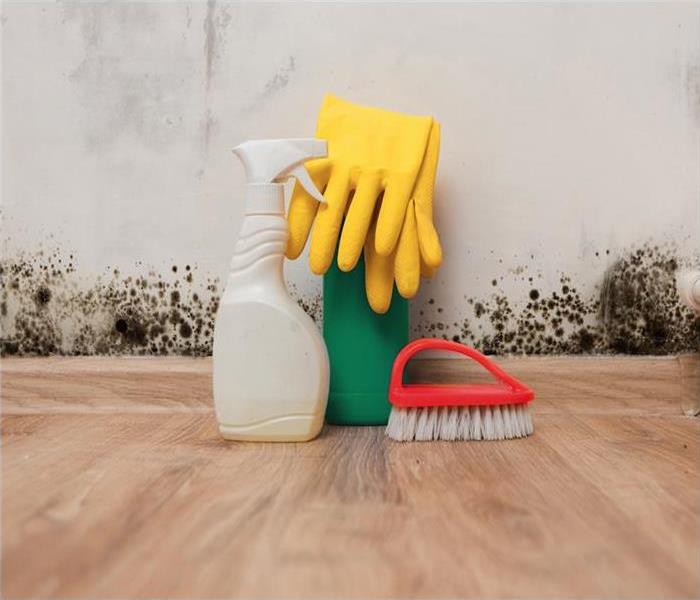 For the best cleanup results and the lowest change of regrowth, contact a mold damage cleanup and remediation company.
For the best cleanup results and the lowest change of regrowth, contact a mold damage cleanup and remediation company.
Consistent exposure to mold has a very negative effect on your family and your home or Business.
The negative consequences of mold exposure can easily go undetected and cause serious problems.
A building owner or manager may want to know whether bleaching mold is an affordable and effective alternative to professional cleanup.
Even if only a small amount of mold can be seen, it is likely you have a bigger problem below the surface.
Take action to remove the problem permanently and safely. Here is what you need to know...
Bleach can kill virtually every species of indoor mold that it comes into contact with. However, using bleach only works if the mold is growing on non-porous materials like tile, tubs, and counter tops. That’s because bleach can’t penetrate porous materials such as wood and drywall. Using bleach on such materials can be deceiving because it will kill the mold above the surface, but mold below the surface will remain. Bleach can be useful but it can also cause damage; it's a harsh, corrosive chemical that gives off harsh fumes. There are safer alternatives.
Cannot Eliminate Hyphae
The multicellular filaments that form during mold growth often go deeper than the surface of a material. Disinfecting or sanitizing surfaces may not eliminate the presence of hyphae, or underlying root structures, and will not be effective for inhibiting future mold growth. If moisture levels remain high and food sources such as cellulose or dust are still available, mold that has been bleached may regrow on non-porous, semi-porous or porous surfaces.
May Damage Materials
A building owner or manager should consider the effects of cleaning solutions on any material supporting mold growth. Chlorine-based solutions may damage delicate materials. Oxygen-based formulas are gentler and safer, but are still not ideal for treating mold on most surfaces. Mold damage experts can recommend more effective fungicides to cleanup mold and inhibitors for prevention or will tear out and replace ruined materials.
Borax is a natural, white mineral powder that has a low toxicity and does not emit dangerous fumes. It can be mixed with water to kill and remove mold because it is a natural mold inhibitor.
Vinegar is a mild acid that can kill 82% of mold species. It’s also natural and safe. Vinegar is non-toxic and doesn't emit dangerous fumes.
Fungicides are more effective than bleach for stopping mold growth. Some treatments may require safety precautions. For the best fungus cleanup results and the lowest change of regrowth, building owners or managers should contact a mold damage cleanup and remediation company in Riverside, CA.
Removing mold can be serious business. When removing mold wear a respirator or face mask and cover your arms, legs and hands to avoid contact with mold spores. You should safely be able to take on bathroom mold or relatively small mold outbreaks in other areas if you take these precautions. For larger problems, especially problems where hidden mold may be a problem, it’s probably wise to call a reputable professional.
Every mold infestation is different, from the amount of mold to the types of materials affected. Each scenario requires a unique solution, but the general process stays the same. The steps listed below illustrate the process for a “typical” mold remediation infestation by a professional:
Inspection and Mold Damage AssessmentMold ContainmentAir FiltrationRemoving Mold and Mold-Infested MaterialsCleaning Contents and BelongingsRestorationSERVPRO of West Riverside City is a trusted leader in the restoration industry. We provide 24-hour emergency service and are dedicated to responding faster to any size disaster. With the training and expertise to handle your restoration and cleaning needs, we’re locally owned and operated and can respond immediately to your emergency. Call us at 951-351-8033, we are here to help!
Why Do I Need Commercial Flood Insurance in Riverside City?
6/10/2019 (Permalink)
 Be familiar with your coverage, talk to your insurance agent regarding your commercial property and flood damage.
Be familiar with your coverage, talk to your insurance agent regarding your commercial property and flood damage.
You may think you don’t need commercial flood insurance, especially if you live in a particularly dry area like Riverside, CA.
You may think you don’t need commercial flood insurance, especially if you live in a particularly dry area of Riverside, CA. Yet you’d be surprised by the situations in which flood damage can strike, and leave you high and dry on coverage for damages. So what’s the deal with commercial insurance?
To understand floods, you must know what makes a flood different from a rainstorm.
- Flood water is defined as accumulating from the ground up, as in the overflow from bodies of water, storm surges, blocked storm drains, and rain or snow melt that inundates ground that is ordinarily dry.
- Floods cover at least two properties or an area determined to be at least two acres.
- Flood damage is confined to buildings in which water and/or mud flow has infiltrated from the ground.
What Flood Insurance Covers
Insurance policies for floods protect business owners against losses to their buildings and what is stored in them. You may already have a commercial property insurance policy, but this only covers water damage related to burst pipes or other such incidents. When floods happen from storms, melting snow, hurricanes, or other natural disasters, you need a separate flood policy to cover it. This policy will cover floodwater damage to:
- Structural damage to walls, floors, and ceilings
- Fixtures
- Furniture
- Inventory
- Business property
If a flood affects your property and these items or structures are damaged, then your commercial flood policy will generally cover the cost of replacing them with comparable items up to a certain point. An insurance adjuster will make necessary determinations regarding a claim, and the amount that may be awarded in compensation.
What Flood Insurance Doesn’t Cover.
Flood insurance doesn’t cover everything, though. Exemptions include loss of use and loss of revenue from having to close the business for any amount of time. If the business is operating with a mortgage from a federally insured or federally regulated lender, carrying flood insurance on the building is required by law. The same is true if the business is operating in an area that has been officially designated as an area at high risk for flooding.
Your policy usually won’t cover things such as:
- Damaged currency
- Mold and mildew damage, particularly if preventable
- Economic losses due to business interruption
- Cost of temporary premises or housing
- Vehicle damage
- External property, furnishings, and décor outside the commercial building
Some of these items will be covered under a standard insurance policy for commercial properties.
So I Need Both Flood and Commercial Insurance?
Yes. Commercial insurance covers one type of water damage, while flood insurance covers an entirely different type of water damage. To be safe, especially if you live in an area prone to flooding, high levels of snow melt, or other natural disasters, you should attain both types of insurance. Many insurance companies will provide you with a quote on a package to combine the two, or discuss your options for purchasing each policy separately.
If you experience a flooding in your Riverside commercial building, don’t despair, we can help. We can take the stress off you by inspecting the damage, and identify the steps that should be taken depending on the type of damage. We understand insurance policies and work closely with your insurance agent and adjuster. Our goal at SERVPRO of West Riverside City is to make it “Like it never even happened.”
What is Containment and Why is it Important for Your Riverside Home and Buildings
6/3/2019 (Permalink)
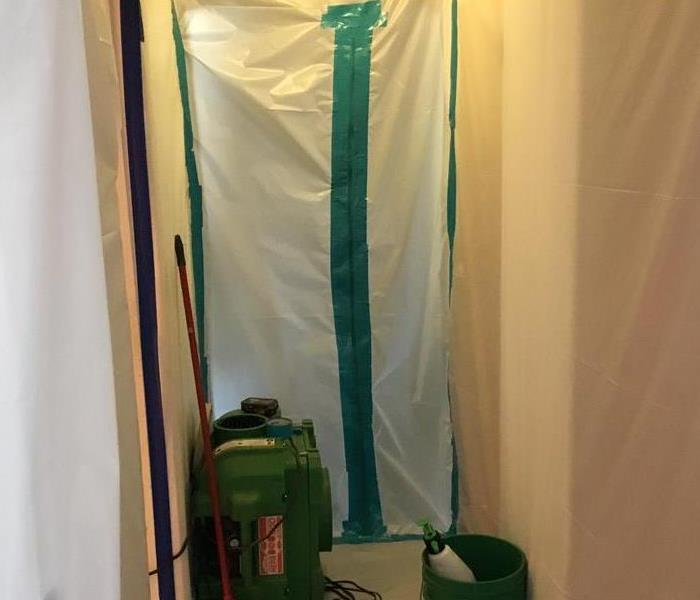 This Riverside home experienced sewage leak, as you can see SERVPRO contained an area to avoid microorganisms from affecting the rest of the home.
This Riverside home experienced sewage leak, as you can see SERVPRO contained an area to avoid microorganisms from affecting the rest of the home.
When it comes to the restoration and remediation industry, you quickly learn that remediation gets rid of the bad stuff while restoration replaces the good stuff.
But often, little mention is given to the first part of the disaster relief team – containment. Yet, proper protocol says to first contain, then remediate and restore.
So what is containment and why is it important? Specifically, containment is preventing something from escaping. The restoration professional is likely to encounter substances like mold, microbial (naturally occurring micro-organisms), toxin-producing pathogens, friable lead and asbestos. Most of these toxins are very small and can easily hitch a ride on normal air currents found in most buildings. Without containing these potentially toxic substances, at the source and within a confined area, they are likely to end up creating a significantly larger mess than first encountered and quickly saturate the air being inhaled by workers, homeowners and occupants of the affected buildings.
The Value of Effective Containment
For the homeowner:
Lessened health consequenceLess likely to be displacedShorter restoration timeLess property damageNo lost incomeFor the lessor:
Reduced liabilityNo loss of rental incomeLower repair costsProperty not devaluedFor the insurer:
Lower liabilityReduced A.L.E.sLower cost of restorationQuicker repair timesFor the restoration company:
Showing you care drives salesHelps manage work loadLowers risks to employeesLessens liabilityAllows for faster turn timesProvides visible proof-of-workMay minimize re-clean, re-testWithin the protocols we use, there should be a very high value on containment because it alone has the ability to prevent further damage to health and property. It keeps a bad situation from getting worse. It puts a lid on it. Everything else addresses the aftermath.
Containment is typically broken into two types: source and area containment.
In talking about source containment, we can use an example of a broken water pipe. With water spewing everywhere, nobody in their right mind would even think about fixing and cleaning up the mess until the water valve was turned off first. That is source containment.
For area containment, think of a quarantine room where someone sick is isolated. The point is not necessarily to keep the person inside, but to keep the pathogens contained and from escaping.
In the first example, the water is quite visible. In the second, the pathogen is microscopic – invisible. This cloak of invisibility is probably the main reason some professionals don’t take containment so seriously. It is the perception that if you can’t see it, it doesn’t exist.
But it does exist. And in the case of some molds, just a slight breeze or vibration and they go into survival mode – spewing hundreds times more spores into the air. Without proper containment, the cost of the loss can increase dramatically. But the greater cost is in the potential health issues by carelessly allowing cross contamination.
Reducing the impact of tiny invisible airborne contaminants is exactly why containment is a valuable part of the protocol.
If you will, picture each part of the mold protocol being a person, a specialist in charge of part of the disaster medical team. You would have a first responder (containment), a surgeon (remediation) and a physical therapist (restoration). Each is tasked with a special function. The first responder stops the bleeding and gets the patient to the surgeon, who cuts away the damaged tissue and does the necessary surgery. The physical therapist gets the body working right again.
It is not uncommon to hear concern about reduced cleaning revenue due to better containment. Don’t do it ever! Not only is great containment going to endear you to your customer but the insurer and adjuster will appreciate that you prevented displacement which can cost them thousands of dollars.
As a restoration professional, containing the site should be of utmost concern for you and your employees. A safer work site always benefits the worker and the employer. Think lower workers compensation costs and liability costs.
By effectively reducing the volume of mold spores by the use of source containment, testing is more likely to pass the first time out – reducing the cost of re-cleaning and testing a second time. The same holds true for effective area containment.
While on this subject, the sequence of source containment and then area containment is important. By securing the site rapidly with source containment, you are avoiding mass propagation of mold spores while erecting area containment. There has already been some level of cross contamination prior to your arrival that will be addressed during remediation. Also, do not make the mistake of only source containment, as what’s behind the moldy surface will need to be contained when the wall is opened up. Don’t skip steps in protocol.
At SERVPRO of West Riverside, we are prepared, alert and we will contain the problem as if someone’s life depended on it – as it very well may.
National CPR/AED Awareness Week
5/30/2019 (Permalink)
SERVPRO of West Riverside City would like to remind you that June 1- June 7 is National CPR and AED Awareness Week.
The resolution was created by the American Heart Association, along with the American Red Cross and the National Safety Council and was passed by congress in 2007.
Would you know what to do if someone needed help?
Every second counts in cardiac arrest. Sudden cardiac arrest claims thousands of lives every year. Knowing when and how to perform CPR (Cardiopulmonary resuscitation) and use an AED (Automated External Defibrillator) can make the difference between life and death for someone suffering from cardiac arrest. The Red Cross recommends that households, businesses and schools receive training in CPR and use of an AED. This training can give them the knowledge and confidence to respond during an emergency situation with the skills that can save a life. Check with your town or the American Heart Association today to sign up for a course.
Life can change in a matter of minutes which is why we know the best way to expect the unexpected is to be prepared. We think CPR and First Aid training is important in the work place for many reasons:
- Having trained employees can make a substantial difference in your ability to maintain a safe work environment. They will be able to respond more quickly and effectively when medical emergencies occur.
- This training and knowledge provides a sense of security and promotes a more confident work environment.
- As staff becomes more prepared and responsive – they also become more aware of their surroundings and more likely to spot potential hazards. This inspires a ‘safety culture’.
- 25% of all emergency room visits can be avoided with basic first aid and CPR certification.
- Safety precautions and preparedness applies to ANY industry of ANY size.
- There are many local resources that can help you get CPR and First Aid Certified such as The Red Cross
Statistics from our friends at HealthSafety.com
(SCA)
- Almost 300,000 casualties of out-of-hospital cardiac arrest are treated each year in the U.S.
- Less than eight percent of people who suffer cardiac arrest outside the hospital survive.
CPR
- Less than one-third of out-of-hospital sudden cardiac arrest casualties receive bystander CPR.
- Effective bystander CPR, provided immediately after sudden cardiac arrest, can double or triple a person’s chance of survival.
Automated External Defibrillators (AEDs)
- Unless CPR and defibrillation are provided within minutes of collapse, few attempts at resuscitation are successful.
- Even if CPR is performed, defibrillation with an AED is required to stop the abnormal rhythm and restore a normal heart rhythm.
- New technology has made AEDs simple and user-friendly. Clear audio and visual cues tell users what to do when using an AED and coach people through CPR. A shock is delivered only if the victim needs it.
From American Heart Association: Why Learn Hands-Only CPR?
Cardiac arrest – an electrical malfunction in the heart that causes an irregular heartbeat (arrhythmia) and disrupts the ?ow of blood to the brain, lungs and other organs – is a leading cause of death. Each year, more than 350,000 EMS-assessed out-of-hospital cardiac arrests occur in the United States. When a person has a cardiac arrest, survival depends on immediately receiving CPR from someone nearby. According to the American Heart Association, about 90 percent of people who suffer out-of-hospital cardiac arrests die. CPR, especially if performed immediately, can double or triple a cardiac arrest victim’s chance of survival.
Read the rest of the fact sheet from American Heart Association
National CPR/AED Awareness Week
Training
If you are interested in taking a course to learn the lifesaving skills of CPR, first aid, and AED, use the Find A Course Tool to locate a Training Center near you.
Try a Blended Learning Course: Many AHA lifesaving training courses are available online via OnlineAHA and eLearning.Heart.org. Courses that involve only cognitive learning can be completed entirely online. For courses that teach CPR, students must complete an in-person skills practice and testing session with an AHA Instructor after they complete the online portion. The Instructor will evaluate the student's skills and upon successful completion of both portions of the course, the student will receive a course completion card, valid for two years. See more information on blended learning and eLearning training.
Red Cross training and certification meets the needs of workplace responders, professional rescuers, school staff and healthcare providers as well as the general public. Several courses are OSHA compliant. Check with your employer as to what class you need if you are taking training to fulfill a job requirement.
SERVPRO of West Riverside City encourages all to be the difference for someone they love. Chances are, you could be trying to save the life of your child, a spouse a friend or a workmate. If an emergency arises, don't hesitate to call 911!
Let Us Protect You from Bio-Hazardous Contaminants
5/29/2019 (Permalink)
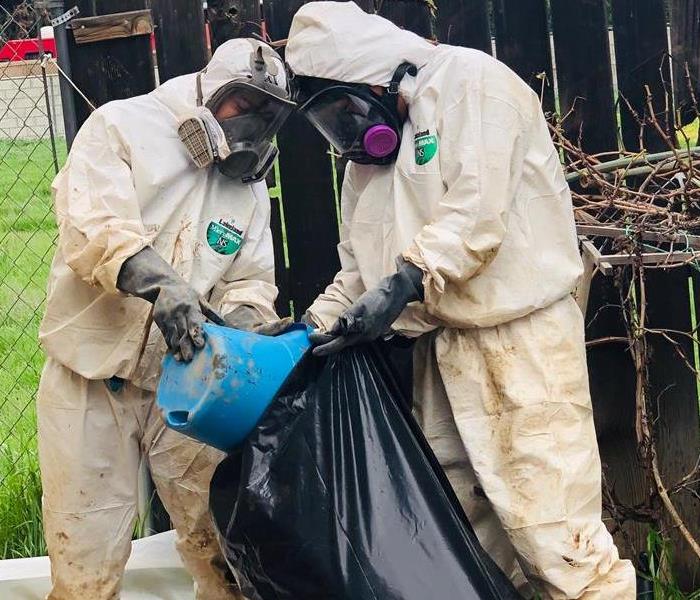 Let us protect you by using proper personal protection equipment and specially designed cleaning products to tackle the job
Let us protect you by using proper personal protection equipment and specially designed cleaning products to tackle the job
Bio-hazard contaminants should be considered very dangerous as they can pose a serious health risk.
SERVPRO of West Riverside City professionals are trained to safely and effectively removed bio-hazardous substances and prepare waste for proper disposal according to OSHA, EPA, and state and local health regulations. Equipped with the necessary safety equipment and cleaning products, SERVPRO professionals help turn unsafe environments into clean, safe homes, and offices.
We can clean any catastrophic issue from bodily fluids to blood borne pathogens. No clean-up is too big or too small, we have the training and know-how to tackle any job. Let us protect you by using proper personal protection equipment and specially designed cleaning products to tackle the job and get your home or business back to a safe and clean condition. We even have special products and techniques to tackle any odor that may be associated with the damages.
Blood-borne Pathogens
SERVPRO West Riverside City remove and dispose of bodily fluids, tissue, and other potentially pathogenic substances resulting from accident, trauma, crime, or death. Trained SERVPRO technicians thoroughly clean, disinfect, and deodorize the structure.
Methamphetamine Labs
Many of the chemicals used in the production of illegal drugs such as methamphetamine are volatile and can leave harmful residues throughout a structure. SERVPRO of West Riverside City follow federal and state guidelines to properly clean all surfaces.
Crime Scene Residues
From fingerprint powder and evidence-gathering chemicals to tear gas and pepper spray residues, SERVPRO of West Riverside City can clean and restore your property and contents.
Arson and Vandalism
SERVPRO is recognized as leaders at helping property owners recover quickly from fire and water damage. SERVPRO also provides general cleaning and deodorization services for situations resulting from vandalism including graffiti, egg, spoiled foods, and human or animal waste.
Sewage Backup
Sewage backups and black water intrusions are more than nasty, smelly deposits- these damages also introduce harmful microorganisms into a structure. SERVPRO remove the sewage, contaminants and moisture, disinfecting as they clean. SERVPRO help ensure the structure is properly cleaned, disinfected, and deodorized.
What to Do After a Contamination
Stay out of affected areas.Call emergency service personnel if the situation is life-threatening.Treat all bodily fluids as if they are contaminated.Turn off the HVAC system if there is sewage damage.What Not to Do After a Contamination
Don’t leave wet fabrics in place. Hang furs and leather goods.Don’t leave books, magazines, or other colored items on wet carpet or floors.Don’t use your household vacuum to remove water.Don’t use television or other household appliances.Don’t turn on ceiling fixtures if ceiling is wet, and keep out of rooms where ceilings are sagging. Bio-hazards like flood water or sewer backups should be considered an emergency and dealt with as quickly as possible. SERVPRO of West Riverside City has water damage restoration specialists and has specific training and expertise to safely remediate bio-hazard contaminants.
SERVPRO of West Riverside City ensures that your home or business is clean, sanitary, and safe for all habitants after it has been affected with a hazardous waste material.
We can help you, call us anytime, day or night. 951-351-8033
The Dangers of Hoarding and How you Can Help
5/27/2019 (Permalink)
Chances are you’ve seen the television show Hoarders. If you haven’t, the basic premise is that a psychologist, a professional organizer, and cleaners go into an individual’s home and help clean up their hoard. When help arrives, the person in question is met with a deadline of some sort, whether it’s eviction, child protective services coming, adult protective services coming, or animal welfare coming and removing their children/themselves/their pets from the home. This show is fascinating to us because we can’t imagine anyone ever living like that. Unfortunately, it’s estimated that at least 2-6 percent of the population is affected by a hoarding disorder. The average age for hoarding is around 50, though it’s suggested that hoarding can appear as early as 11 to 15 years of age.
Hoarding can cause a mess of a problems. Not only does it cause strain on relationships and mental health, it can cause an unhealthy living environment as well. Mold and mildew can become present under piles of things, especially with an unknown water leak. Piles of stuff could topple and seriously injure or even kill the individual(s) living in the home. However, one of the biggest safety concerns relating to hoarding is fire.
The possibility of a fire in a home when hoarding is involved. Cooking becomes unsafe because of items piled high on counter tops or on the floor. If the individual in the home uses a heater, the heater could easily fall over and start a fire, or a pest could chew on electrical wiring.
Hoarding also hinders first responders. If exits or doors are blocked, then they can’t get in the home to help the person in need. They won’t be able to move through the home in a swift manner and can even be trapped or injured by falling objects.
When it comes to cleaning out the home, approach the situation with compassion and understanding. While some items in the home maybe trash to you, they could be valued possessions to a hoarder. Hoarding is related oftentimes to obsessive compulsive disorder (OCD) and anxiety. It can even be genetic.
If family or friends come in to help clear a hoarder’s home, it’s usually met with great distress because often times they don’t get to choose what or what not to keep. If not dealt with in the proper way, within a few months a home could be packed to the brim again.
So, what do you do if your loved one is a hoarder? How do you approach the situation? Here are four tips to get you started on helping your loved one.
Seek Professional Help – Try and find a therapist that specializes in hoarding, OCD or anxiety. They will help the individual understand how hoarding is affecting their life and how to develop healthy habits and abilities to combat it. However, make sure they are ready to make these changes. Don’t force them into seeking help if they aren’t ready.Talk About Safety – Stress safety. They maybe more open to change if you express your concern for their well being and safety in a hoarded home.Celebrate the Small Victories – Help the individual by setting small goals. Even if they take five hours to sort through and throw away a box, celebrate it! It’ll help them feel proud of what they’ve accomplished.Hoards Can Have Bio-hazards – Hoarding situations oftentimes have bio-hazards such as animal and human waste, or animal remains. You can call SERVPRO of West Riverside City to help handle anything bio-hazardous.Our team works compassionately with the home owner and his or her loved ones to clean and sanitize the scene, while health and/or mental health professionals tend to the affected person.
It is our motto to always be there to help, day or night, we’ll be there. Just contact us and our professional staff can assist you with any questions. Just give us a call: 951.351.8033.
Commercial Properties in Riverside can Turn to SERVPRO for Flooding and Water Damage
5/22/2019 (Permalink)
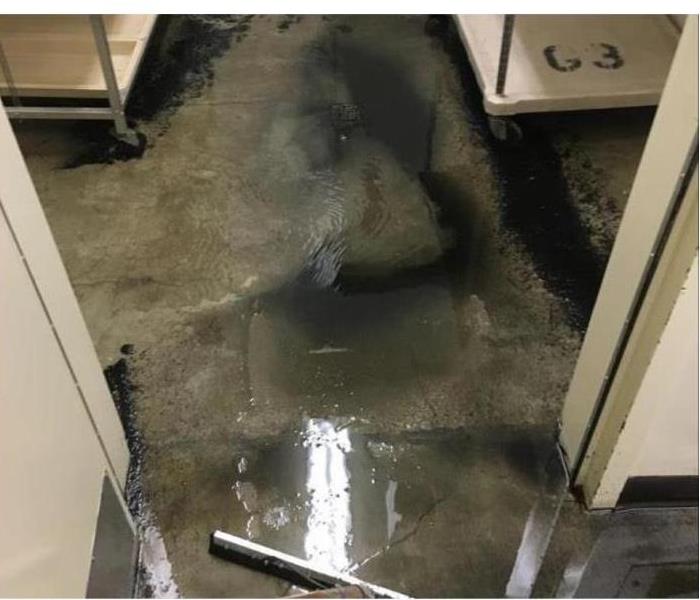 Riverside School district flooding. SERVPRO of West Riverside was called to help with the clean up.
Riverside School district flooding. SERVPRO of West Riverside was called to help with the clean up.
Commercial Flooding and water damage events in Riverside area can be challenging.
Commercial properties are often complex with numerous issues that require a knowledgeable and flexible response. Whether we’re dealing with a relatively small water cleanup scenario or a large scale event, we work quickly to assess each unique situation and isolate the damaged area. Many business owners understand that the business downtime can be more devastating to the property damage -- we understand that many times the most important thing to Riverside and surrounding city businesses is to get back in business . . . fast.
Our professionals are trained to be mindful of legal and environmental concerns and strive to fully restore the damaged area while working within your budgetary constraints. We understand that every hour spent cleaning up is an hour of lost revenue and productivity. So when an emergency situation arises in your business, give us a call and we’ll be there fast with the help you need.
Water intrusion may be more severe in commercial buildings than in a residential setting and the effects can be more extensive. Many commercial structures have a larger volume of water entering the premises through plumbing supply lines and at a higher water pressure. The quantity of outgoing sewage is greater than a typical residence, as well. Also, commercial buildings tend to be of larger square footage than a home, so entry points for water intrusion through areas like the roof, exterior walls or windows are commensurately greater in number, as well.
Water intrusion in commercial buildings can damage high-value equipment like computers and also building services such as HVAC, lighting, elevators and security equipment. Common long-term consequences of water damage like the growth of mold may be even more problematic than in a home due to the larger occupancy of a business or other commercial enterprise. When a greater number of people with a wider range of sensitivity are exposed to mold and bacteria spores, health impacts may be significantly magnified, perhaps leading to an enforced closure of the facility until the situation is fully remediated.
Typical issues from water intrusion in the commercial environment include:
- Water from roof leaks penetrating through ceilings. Chronic leakage through the roof may proceed unnoticed for long periods, hidden by suspended ceiling panels or in electrical or HVAC service areas above.
- Ruptures of water supply lines typically release clean (white) water. Sewage backups or leaks in drain pipes release toxic (black) water that may be a bio-hazard and require evacuation of the premises.
- Flooding from external sources can result from heavy rains, storms such as hurricanes, rapid snow melt or local overflowing lakes or rivers.
- Moisture intrusion through the building envelope is typically more subtle. Humid outdoor air may be drawn in through structural cracks and gaps. Over a period, chronic dampness forms in spaces like wall voids, unventilated attics and service areas, spawning hidden mold growth that persists unseen.
For professional remediation of water intrusion in commercial buildings and its secondary damages such as mold growth, contact SERVPRO of West Riverside City if water becomes an unwanted guest.
Emergencies can happen anytime and with the SERVPRO Ready Profile you can be prepared to handle those emergencies like a water intrusion caused by a broken pipe. For your FREE Emergency Ready Profile, contact the pros at SERVPRO of West Riverside City so we can make your property ready for whatever happens!
About SERVPRO of West Riverside City
SERVPRO of West Riverside city specializes in the cleanup and restoration of commercial and residential property after a water damage event. Our staff is highly trained in property damage restoration. From initial and ongoing training at SERVPRO’s corporate training facility to regular IICRC-industry certification, rest assured our staff is equipped with the knowledge to restore your property. We can be reached at (951) 351-8033.
Some Helpful Facts Regarding Business Fires
5/22/2019 (Permalink)
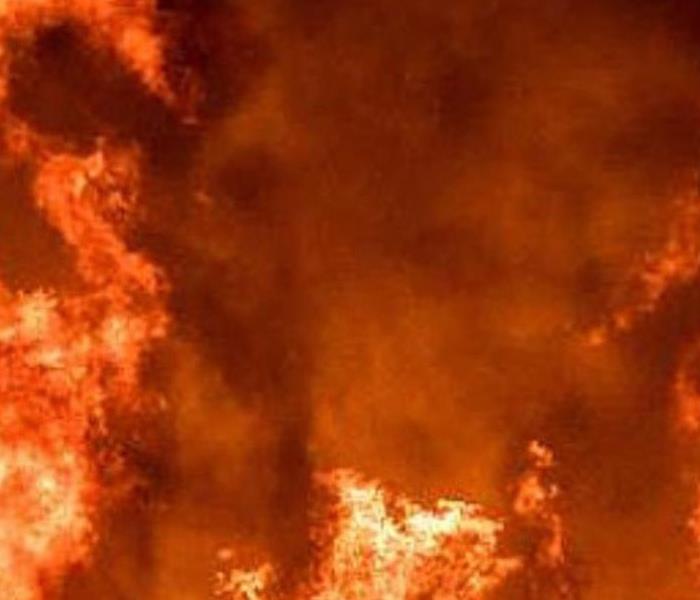 Call SERVPRO of West Riverside City, we can help get your business back up and running, recovery is possible!
Call SERVPRO of West Riverside City, we can help get your business back up and running, recovery is possible!
According to the U.S. Small Business Administration, as many as one in four businesses that suffer some kind of major disaster do not reopen afterward.
It’s true, overcoming a major loss is extremely difficult, but with the right restoration company and team on your side, working hand-in-hand with your insurance company, the chance of your Riverside-area company surviving is pretty high!
Depending on the size of the fire, and the amount of damage, some businesses that have come to SERVPRO for help have reopened just days after the fire happened. Thanks to innovations in smoke odor removal, fire damage restoration, and cleaning in general, it is possible for crews to start work nearly immediately after the fire department clears the scene, and have things back up and running in no time. Although, again, that all depends on the severity of the fire. But no matter the severity, recovery is possible!
According to the National Fire Prevention Association, U.S. fire departments responded to about 3,300 office property fires per year between 2007 and 2011. Those fires resulted in about $112 million in property damage each year, and most were in business offices – and happened during business hours. However, the good news is the number of business fires was down a whopping 71 percent from 1980 to 2011.
Here are some other stats from the NFPA:
Time of Day
Peak time of day for office fires: Noon – 2p.m. (a.k.a. lunch time!)69% happened between 7 a.m. and 7 p.m.The 31% that occurred between 7 p.m. and 7 a.m. caused 67% of recorded property damage, because they went undetected longer. This also highlights the need for automatic detection equipment and working sprinkler systems.19% of fires happened on weekends.Cause of the Business Fires
29% were caused by cooking equipment. However, just 6% of these fires caused actual property damage.Intentionally-set fires caused the most direct property damage – 21%.Electrical equipment is the second leading cause of office fires.Just 2% of office fires start in a concealed space like an attic, in the ceiling, or in another conceals space. However, these fires accounted for 13% of the direct property damage.Containment & Putting it Out
4 out of 5 fires were confined to the room of origin.90% of fires were large enough to activate sprinklers, which were effective 88% of the time.Deaths per 1,000 stores were 62% lower in offices equipped with sprinklers compared to those without.Industrial/Manufacturing Facility Fires
The NFPA also has statistics specific to manufacturing facilities. According to their research, there are about 37,000 fires at industrial or manufacturing facilities each year, resulting in 18 deaths, 279 injuries, and $1 billion in property damage. Heating equipment and stop tools were the leading cause – sparking 28 percent of the fires. Mechanical failure or malfunction caused 24 percent of the fires.
The Best Way to Reduce a Business Interruption Following a Disaster to Your Business is to Plan Ahead for One
As many as 50% of businesses never recover following a disaster, according to the latest industry research. SERVPRO of West Riverside can help you plan ahead for a disaster to minimize business interruption by developing an Emergency Ready Profile (ERP) for your business before one strikes. An ERP provides important contact and building information needed to begin a timely mitigation to help minimize how water and fire damage can affect your business. Benefits of an ERP include:
-A no cost assessment of your facility which means there is no need to allocate funds, giving you a great value at no cost.
-A concise profile document that contains only the critical information needed in the event of an emergency. It will only take a little time to complete and will not take you away from current projects. But it will save a lot of time if ever needed.
-A guide to help you get back into your building following a disaster. This can help minimize the amount of time your business is inactive by having an immediate plan of action.
-Establishes SERVPRO of West Riverside City as your disaster mitigation and restoration provider. You have a provider that is recognized as an industry leader and close by, when needed.
-Identification of the line of command for authorizing work to begin. This saves time so we can begin the work of mitigating the damage which can save you time and money.
-Provides facility details such as shut-off valve locations, priority areas and priority contact information. Having a quick reference of what to do, how to do it and who to call provides solutions in advance of an emergency so that during the emergency you are “Ready for whatever happens.”
Contact SERVPRO of West Riverside City to schedule your FREE Emergency Ready Profile today. 951-351-8033
Part 2: May is Skin Cancer Awareness Month
5/15/2019 (Permalink)
 Visit the Skin Cancer Foundation website for more valuable information.
Visit the Skin Cancer Foundation website for more valuable information.
Here at SERVPRO we talk about protecting your home frequently.
Our hope is that we can help you prevent most disasters and recover quickly from those that you can’t anticipate. We want where you live to be safe and healthy, but what about the home you can’t replace? Taking care of your body is even more important than homeowner tips, and that starts with your skin.
It’s estimated that the number of new melanoma cases diagnosed in 2019 will increase by 7.7 percent-Stern, RS. Prevalence of a history of skin cancer in 2007.
One in five Americans will develop skin cancer in the course of a lifetime- Stern, RS. Prevalence of a history of skin cancer in 2007.
Over the past 31 years, more people have had skin cancer than all other cancers combined-Cancer Facts and Figures 2019. American Cancer Society.
Skin cancer isn’t reserved for the tanning bed regulars or the fair skinned. That being said, I just wanted to pass along some information from the Skin Cancer Foundation on how you can protect your skin in the midst of all these summer activities (and even in the off-season).
Use a sunscreen of SPF 15 or higher whenever you spend time outdoors.
- This applies to all outdoor activities: athletics, shopping, picnicking, walking or jogging, gardening, even waiting for a bus.
- Use a broad spectrum (UVA/UVB) sunscreen with an SPF of 15 or higher every day. For extended outdoor activity, use a water-resistant broad spectrum (UVA/UVB) sunscreen with an SPF of 30 or higher.
- Apply liberally and evenly to all exposed skin. The average adult in a bathing suit should use approximately one ounce of sunscreen per application. Not using enough will effectively reduce the product’s SPF and the protection you get.
- Be sure to cover often-missed spots: lips, ears, around eyes, neck, scalp if hair is thinning, hands, and feet.
- Reapply at least every 2 hours, more often if some of the product may have been removed while swimming, sweating, or towel-drying.
- Choose a product that suits your skin and your activity. Sunscreens are available in lotion, gel, spray, cream, and stick forms. Some are labeled as water resistant, sweatproof, or especially for sports; as fragrance-free, hypoallergenic, or especially for sensitive skin or children.
Cover up.
- Wear long-sleeved shirts and long pants. Tightly woven fabrics and dark colors, such as deep blue and black, or bright colors, such as orange and red, offer more protection. If you can see light through a fabric, UV rays can get through too. Water makes fabrics more translucent, so do not rely on a wet T-shirt.
- A broad-brimmed hat goes a long way toward preventing skin cancer in often-exposed areas like the neck, ears, scalp, and face. Opt for a 3-4 inch brim that extends all around the hat. Baseball caps and visors shade the face but leave neck, lower face, and ears exposed.
- UV-blocking sunglasses with wraparound or large frames protect your eyelids and the sensitive skin around your eyes, common sites for skin cancer and sun-induced aging. Sunglasses also help reduce the risk of cataracts later in life.
Seek the shade.
- Be aware, however, that sunlight bouncing off reflective surfaces can reach you even beneath an umbrella or a tree. Never seek a tan.
- There is no such thing as a healthy tan. A tan is the skin’s response to the sun’s damaging rays.
Stay away from tanning parlors and artificial tanning devices.
- The UV radiation emitted by indoor tanning lamps is many times more intense than natural sunlight. Dangers include burns, premature aging of the skin, and the increased risk of skin cancer.
Protect your children and teach them sun safety at an early age.
- Healthy habits are best learned young. Because skin damage occurs with each unprotected exposure and accumulates over the course of a lifetime, sun safety for children should be a priority.
Because many schools don’t allow students to use sunscreen or wear a hat outdoors during the school day without written permission from a physician, The Skin Cancer Foundation has created a sun protection form that parents and doctors can sign, allowing students to bring these items to school, apply and use as needed.
Download the Sun Protection Form and ask your physician to sign it.
- During a typical school day,it’s not unusual for children to receive a significant amount of sun exposure. Children in elementary school typically have outdoor recess between 10 AM and 2 PM, a time when the sun is especially intense. Proper sun protection in childhood can drastically reduce the risk of developing skin cancer as an adult. Suffering just one blistering sunburn in childhood or adolescence more than doubles a person’s risk of developing melanoma, the deadliest form of skin cancer, later in life.
SERVPRO of West Riverside City cares about YOU!
Part 1: May is Skin Cancer Awareness Month
5/13/2019 (Permalink)
UV exposure is the most preventable risk factor for skin cancer. During Skin Cancer Awareness Month, the American Academy of Dermatology is asking "Do You Use Protection?"
And is encouraging you to practice safe sun every time you are outdoors. Seek shade, wear protective clothing, and use a broad-spectrum, water-resistant sunscreen with SPF 30+ to reduce your risk.
Follow these tips to protect your skin from the sun's damaging ultraviolet rays and reduce your risk of skin cancer:
Seek shade when appropriate, remembering that the sun’s rays are strongest between 10 a.m. and 2 p.m. If your shadow is shorter than you are, seek shade.Wear protective clothing, such as a lightweight long-sleeved shirt, pants, a wide-brimmed hat and sunglasses, when possible.Generously apply a broad-spectrum, water-resistant sunscreen with an SPF of 30 or higher. Broad-spectrum sunscreen provides protection from both UVA and UVB rays.Use sunscreen whenever you are going to be outside, even on cloudy days.Apply enough sunscreen to cover all exposed skin. Most adults need about 1 ounce — or enough to fill a shot glass — to fully cover their body.Don’t forget to apply to the tops of your feet, your neck, your ears and the top of your head.When outdoors, reapply sunscreen every two hours, or after swimming or sweating.Use extra caution near water, snow and sand, as they reflect the damaging rays of the sun, which can increase your chance of sunburn.Avoid tanning beds. Ultraviolet light from tanning beds can cause skin cancer and premature skin aging.Consider using a self-tanning product if you want to look tan, but continue to use sunscreen with it.Perform regular skin self-exams to detect skin cancer early, when it’s most treatable, and see a board-certified dermatologist if you notice new or suspicious spots on your skin, or anything changing, itching or bleeding.A tan is a sign that your skin has been injured. Whether you’re exposed to the sun’s UV rays or visit an indoor tanning salon, every time you tan, your skin is damaged. As this damage builds, you speed up the aging of your skin and increase your risk for all types of skin cancer, including melanoma, the deadliest form of skin cancer.
How to select a sunscreen
Do you know that some sunscreens can prevent sunburn, reduce your risk of getting skin cancer, and help prevent early signs of skin aging?
Broad spectrum: The words "broad spectrum” means that the sunscreen can protect your skin from both types of harmful UV rays — the UVA rays and the UVB rays.SPF 30 or higher: The American Academy of Dermatology recommends that you select a sunscreen with an SPF rating of 30 or higher.Water resistant: Dermatologists also recommend that you look for the words "water resistant.” This tells you that the sunscreen will stay on wet or sweaty skin for a while before you need to reapply. Water resistance lasts either 40 or 80 minutes. Not all sunscreens offer water resistance.How you apply your sunscreen also affects how well it protects you. You can find out how to get the most protection from your sunscreen by watching the Academy’s video “How to apply sunscreen”.
How to apply sunscreen
Sunscreen is safe and can protect your skin against skin cancer and premature aging. However, it is not as effective unless it's applied correctly. Follow these tips from dermatologists when applying sunscreen:
- Choose a sunscreen that has an SPF of 30 or higher, is water resistant, and provides broad-spectrum coverage, which means it protects you from UVA and UVB rays. Follow these helpful tips when selecting a sunscreen.
- Apply sunscreen generously before going outdoors. It takes approximately 15 minutes for your skin to absorb the sunscreen and protect you. If you wait until you are in the sun to apply sunscreen, your skin is unprotected and can burn.
- Apply enough sunscreen to cover all exposed skin. Most adults need about 1 ounce — or enough to fill a shot glass — to fully cover their body. Rub the sunscreen thoroughly into your skin.
- Apply sunscreen to all bare skin. Remember your neck, face, ears, tops of your feet and legs. For hard-to-reach areas like your back, ask someone to help you or use a spray sunscreen. If you have thinning hair, either apply sunscreen to your scalp or wear a wide-brimmed hat. To protect your lips, apply a lip balm with a SPF of at least 15.
- To remain protected when outdoors, reapply sunscreen every two hours, or immediately after swimming or sweating. People who get sunburned usually didn't use enough sunscreen, didn't reapply it after being in the sun, or used an expired product. Your skin is exposed to the sun's harmful UV rays every time you go outside, even on cloudy days and in the winter. So whether you are on vacation or taking a brisk fall walk in your neighborhood, remember to use sunscreen. For more skin cancer prevention tips, see a board-certified dermatologist.
People who get sunburned usually didn't use enough sunscreen, didn't reapply it after being in the sun, or used an expired product.
Your skin is exposed to the sun's harmful UV rays every time you go outside, even on cloudy days and in the winter. So whether you are on vacation or taking a brisk fall walk in your neighborhood, remember to use sunscreen.
For more skin cancer prevention tips, see a board-certified dermatologist.
Wet Carpets? You Can Rely on SERVPRO of West Riverside City for Water Damaged Carpets!
5/13/2019 (Permalink)
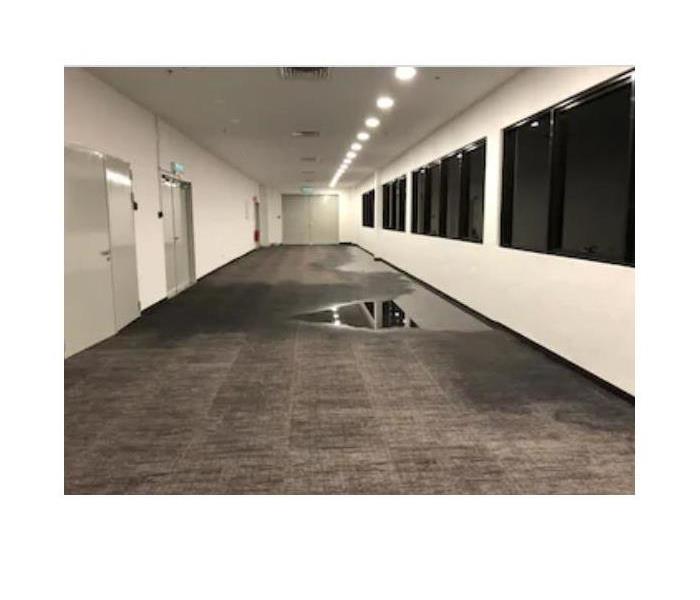 We provide emergency water restoration services 24 hours a day, 7 days a week – including all holidays.
We provide emergency water restoration services 24 hours a day, 7 days a week – including all holidays.
A fast response is needed to salvage we carpet.
When your experience a water main leak, or a kitchen appliance breaks down and floods the ground floor or a pipe cracks and leaks water, a fast response is needed. Residential water damage is very common, but it can escalate quickly, so speed is of the essence.
It applies in particular to fabrics and soft items. Furniture and carpets are often the most damaged objects after a flood because they soak up water so easily. The good news is that we can rescue these materials, as long as the water damage in your Riverside home is ‘clean.’
Clean water is a liquid that is from an uncompromised source; a drinking supply, a household appliance (when not used with chemicals), or rainwater. If it gets into carpets, the IICRC certified experts at SERVPRO know just how to fix it.
The Drying Method
If a relatively controllable amount of water is quickly cleaned up and steps are taken to dry the sub floor surface, padding, and carpet, then the prevention of mold and mildew growth is high. Without moisture, the organic debris within the carpeting cannot sustain mold growth.
There are three ways to dry a water damaged carpet – in place, partially lifted, or fully lifted. The technique used in your home depends on the degree of water intrusion. In the case of mild flooding, only the top fibers are wet, and the carpet remains in place.
Lifting equipment gets used when there is a high chance of water damage to the under flooring as well. The top fibers can be dried out with dehumidifiers (which extract water vapor from the material), but the sub floor is closer to the ground and less accessible.
At SERVPRO, we normally lift (float) the carpet a few inches off the ground and suspend there. It allows the technicians to place portable fans and air movers underneath. They direct the clean, dry air from the dehumidifiers beneath the carpet and speed up the drying process.
The Repair Process
In some cases, the water causes the backing of the carpet to come loose. It is something that we may be able to fix if the problem is limited to small sections of the floor. If the structure of the carpet is in an extremely unsuitable condition, we would advise a full replacement.
Natural fibers usually respond very well to drying, as long as the issue is addressed quickly. However, if the water intrusion originated from a ‘black’ source (containing sewage or chemicals), there is no chance of repair. It is not safe to retain the flooring, and it requires removal, but this is a relatively uncommon situation. Wall-to-wall carpeting must first be released from the tack boards. SERVPRO technicians can work with the carpets and padding to ensure complete drying by utilizing special pumps, wet-vacs, and dehumidifiers. This drying out process may take from several days to several weeks depending on the amount of water intrusion and the speed of extraction. Evaporation can only go so fast though we expedite the process with state of the art dehumidifiers.
Now that we have dried the carpets and area, do we need to clean them and why?
Yes, even though you have taken all the right measures to correctly dry out your carpets after having experienced water damage, you still really should make the effort to clean your carpets. Cleaning can be completed by steam cleaning them and by cleaning the back of the carpet with a disinfectant to stymie the growth of mold.
Do we need to sanitize the carpets after we try to dry them?
Of course, by having SERVPRO spray an antimicrobial product to the carpet and the padding (if it was rescued) it will lessen the chance of infections and diseases. If the carpets were covered with contaminated sewage or ground rising water, called Black Water, there is only one option. Our technicians will safely wrap and dispose of the carpet and padding and then proceed to sanitize the sub floor.
When the extent of water damage to a carpet encompasses a large area, the best call is to SERVPRO. Our skilled IICRC trained technicians will utilize all the equipment and expertise required to restore your carpet "Like it never even happened."
SERVPRO of West Riverside City is a local water damage cleanup and repair service. We help homeowners in the Riverside area and surrounding cities to restore their properties after flooding and residential leaks. Our repairs are fast, effective, and leave homes spotless.
Flooding or Water Damage? Call Us Today – (951) 351-8033
24-Hour Emergency Water Removal Service
Flooding and water emergencies don’t wait for regular business hours and neither do we. We provide emergency water restoration services 24 hours a day, 7 days a week – including all holidays. Riverside residents can expect an immediate response time, day or night.
Why Can you Turn to SERVPRO of West Riverside City
5/13/2019 (Permalink)
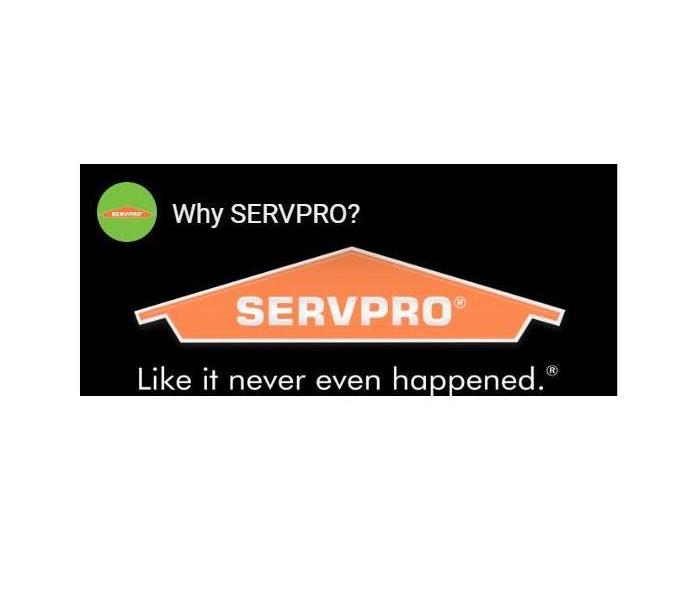 SERVPRO of West Riverside City is always here to help! Call us 24/7 at 951-351-8033.
SERVPRO of West Riverside City is always here to help! Call us 24/7 at 951-351-8033.
Why should I choose a professional restoration company for water intrusion/ damage?
Homeowners and business owners should not risk doing the work themselves as there may hidden water or moisture that can go undetected to the untrained eye. Taking into account that mold growth can occur in as little as 24-48 hours in the presence of moisture, undetected water damage can pose long term problems if not properly handled.Due to the potential hazards associated with water-related damage, moisture and water should be handled by properly trained and equipped professionals to ensure complete and necessary drying to prevent future harm, extensive structural damage and possible contamination.Improper cleanup could hinder property re-sale value.Professional restoration companies have essential tools and techniques to measure moisture in the area to ensure proper and complete drying in a timely manner.Water technicians should be fully aware of water or moisture-related characteristics to locate leaks or water damaged areas that may otherwise go unnoticed.Homes and other properties are large and often expensive assets. Why run the risks associated with improper drying, deodorizing and disinfecting which can lead to potential secondary structural damage? Help protect your property’s value by calling the professionals at SERVPRO of West Riverside City.Why should I choose SERVPRO of West Riverside City for water cleanup and restoration?
SERVPRO of West Riverside City recognizes the necessity for prompt and accurate response and offer 1-4-8 Response Guidelines to help minimize additional, secondary or permanent damage and contamination. In addition, SERVPRO of West Riverside City is available for emergency response 24 hours a day, 365 days a year.Knowledge and training are key elements in effective water removal and moisture damage. SERVPRO of West Riverside City applies their industry knowledge, training and understanding of how relative humidity, temperature, vapor pressure and air movement influence drying conditions.Powerful and professional equipment is essential for proper mitigation and efficient restoration of water damaged areas. SERVPRO of West Riverside City is outfitted with state-of-the-art industrial grade equipment and products to measure the extent of moisture saturation and offer proper drying, deodorizing and disinfecting of water damaged areas.SERVPRO of West Riverside City offers content restoration to restore water damaged contents and personal belongings. Often when water damage occurs, personal possessions are also damaged by moisture. SERVPRO Technicians work diligently to try and return personal contents to preloss conditions.SERVPRO of West Riverside City works with insurance, real estate, contracting and property management companies to offer complete file management, estimates and detailed explanations of work, including status updates, changes and feedback to keep companies fully aware of a property’s drying, cleaning and restoration status. At SERVPRO of West Riverside City, we know you want quality information and proof of results. SERVPRO technology is designed to support your efforts!Timely mitigation is key to the restoration process. Restoring property is the SERVPRO Professional’s first priority. You will appreciate the immediate response, and you will know everything possible is being done to limit the damage. Even if a loss is below the deductible amount, fast action helps assure the event will stay small!Call SERVPRO of West Riverside City today at 951-351-8033. No water damage is too big or too small.
SERVPRO of West Riverside City Supports March of Dimes Walk in Jurupa Valley
5/9/2019 (Permalink)
 Visit our March of Dimes Web page or Face book page to donate.
Visit our March of Dimes Web page or Face book page to donate.
Why We are Fighting for Healthy Families
About half a million babies are born premature or with birth defects in the U.S. each year.
SERVPRO of West Riverside City participated to help all moms and families experience the joy of a healthy baby. With nearly 4 million babies born each year, we have a lot of work to do to help them all. The funds raised enable March of Dimes to support research, lead programs and provide education and advocacy that truly makes a difference to families in our community and across the country. If you believe, like we do, that every baby deserves the best possible start, please make a donation to support this community effort. Together we can fight for the health of all moms and babies.
SERVPRO joined our Executive Team Networking group in this initiative. The walk took place on Saturday, May 4th…(yes, the force was with us!). We took the 5K walk, although there was also a family 3K walk. Our mascot, Ellie also joined us. She was proud to sport a March of Dimes purple t-shirt. Check in for the event was at 8:00 a.m. and the activities began at 9 a.m. at Rancho Jurupa Park in Jurupa Valley. Parking was free for participants. Several vendors, music, snacks and water were provided at this event.
March of Dimes is the leading nonprofit organization for pregnancy and baby health, devoted to improving the lives of the nearly 4 million babies born yearly in the United States through research, education, support, and advocacy.
This year, several area sponsors participated to make the event possible. American Medical Response, KMart, Famous Footwear, Big 5, Ontario International Airport, Loma Linda University Medical Center and United Airlines are just a few of the companies dedicated to helping March of Dimes bring the March for Babies event back to the Inland Empire.
SERVPRO got involved this year thanks to our E Team March of Dimes advocate Ricki Hill. March of Dimes chapter staff and volunteers invest time and resources in local programs and activities in all 50 states, playing a vital role in improving maternal and child health in their communities. As respected leaders in the field of maternal and child health, the March of Dimes is uniquely positioned to partner with local and state public and private health care systems and organizations to enhance and expand the services available to women and their families.
Chapter staff and volunteers partner with local health agencies, community-based organizations, professional associations, hospitals and others to determine the most pressing maternal and child health needs and to develop a multiyear strategic plan that will positively impact the health status of communities. Staff and volunteers then work to enhance and expand community services, and to improve systems of care for mothers, babies and their families through leadership, educational programs and community grants.
Ensuring that women have access to prenatal care and services throughout their pregnancy is a vital role that the March of Dimes plays in communities. Whether bringing high-quality, evidence-based interventions and health care to underserved areas or striving for increased services for pregnant women to help them adopt healthy behaviors, March of Dimes staff and volunteers strategically focus resources and funding in the areas with the most need and potential for impact.
In partnership with community organizations, the March of Dimes encourages expansion of services for pregnant women, including care coordination, home visiting services and maternal medical homes to help moms-to-be access the services they need to have healthier pregnancies and babies. To address factors known to increase a woman’s risk of a poor birth outcome, March of Dimes supports targeted programs aimed at smoking cessation, diabetes management and expansion of substance abuse prevention programs during pregnancy.
Although many instances of preterm birth have no known cause, certain factors are known to increase a woman’s risk of having a premature baby. Chronic medical conditions, like diabetes, obesity and high blood pressure, can increase risk, as can using alcohol, tobacco and other drugs during pregnancy. After assessing their local needs, chapters provide training, education and support for various programs to reduce these risks in the populations they serve. In 2014, chapters reached more than 5,600 professionals with information, training and program support and impacted more than 25,000 women.
Quitting smoking is an important change a pregnant woman can make to improve her health and the health of her baby. Smoking in pregnancy increases a woman’s risk of preterm labor, low birth weight and other serious pregnancy complications. Chapters invested in 20 grants totaling $346,753 to support smoking cessation services for pregnant women.
In 2014, chapters also awarded 16 grants totaling $181,906 for alcohol and substance abuse services to help programs screen women and provide education and case management.
SERVPRO is passionate about serving the community - especially those that support children and families. Whether through infant loss, miscarriage, birth defects or premature birth, March of Dimes has directly impacted the lives of many, my team and the clients we serve. They are an organization fighting for the health of all mothers and babies and we couldn't be prouder to support them. Join us in our fight! $10 or $20 may not mean much to you, but could mean the world to a family in need.
You can donate by accessing our Facebook page or our March of Dimes page:
March of Dimes
Facebook
Emergency Preparedness for Kids in Riverside City
5/8/2019 (Permalink)
Disaster Effects Everyone. And so it take everyone - youth, parents, and community members to help prepare.
Parents Get Your Kids On Your Team!
Preparing for emergencies shouldn't fall on your shoulders alone. Young children and teens alike need to be part of the process — for their own safety and sense of empowerment.
Work together to build an emergency kit.Sit down as a family to talk about your communications plan.Role-play what you would do during a disaster.Hold fire drills in your house.Games- Be a Hero!
Disaster Master
Get ready for some serious adventure! Step into the heart of the action as you help the Heroes face everything from home fires to earthquakes. What should they do? Make the right choice and earn points to get to the next level. Make the wrong choice and watch out! Winners get their own graphic novel! Click the link to play the game
Play the Disaster Master Game
Build a Kit
You're on a mission! Go through different locations with Gayle and her friends to find what you need for an emergency kit. Will you pick the correct items? Have fun and build a checklist along the way. Hurry! Your family is counting on you.
Play the Build a Kit Game
What are WEAs
Wireless Emergency Alerts (WEAs) are emergency messages sent to cell phones by authorized government agencies to let you know about dangerous weather conditions, emergencies, and other local hazards.
- Read the alert
- Take action
- Follow the directions
Emergency Checklist for Kids
Electricity lights up our world! Think of all the ways we rely on electricity: keeping food fresh, cooking meals, and getting information through the internet or TV. It keeps us warm in the winter, cool in the summer, and connected with each other year round. Oftentimes, we use electricity to play and have fun! Are you and your family ready if disaster strikes and your home is without power?
Help your family build an emergency kit! Collect these items and keep them together in a safe place that you can find easily. Make sure you have enough supplies to last for at least three days!
Emergency Supplies List
3-day supply of non-perishable food (dried fruit, canned tuna fish, peanut butter, etc.) Can opener First aid kit Sleeping bag or warm blanket for everyone in your family Change of clothes to last 3 days, including sturdy shoes; consider the weather where you live Matches in a waterproof container (let a grown up handle these) Toothbrush, toothpaste, soap Paper plates, plastic cups and utensils, paper towels Water – at least a gallon per person, per day Battery-powered or hand-cranked radio with extra batteries Flashlights with extra batteries Cell phone with charger, extra battery and solar charger Whistle to signal for help Local maps Pet supplies Baby supplies Books, games or puzzles A favorite stuffed animal or blanketGo on a quest with your family! Create a scavenger hunt! Make planning fun!
Helping Children Cope
Disasters can leave children and teens feeling frightened, confused and insecure. And kids' responses can be quite varied. It's important to not only recognize these reactions, but also help children cope with their emotions.
You are their biggest influence.
When you can manage your own feelings, you can make disasters less traumatic for your kids.
• Encourage dialogue. Listen to your kids. Ask them about their feelings. Validate their concerns.
• Answer questions. Give just the amount of information you feel your child needs. Clarify misunderstandings about risk and danger.
• Be calm, be reassuring. Discuss concrete plans for safety. Have children and teens contribute to the family's recovery plan.
• Shut off the TV! News coverage of disasters creates confusion and anxiety. Repeated images may lead younger kids to believe the event is recurring. If your children do watch TV or use the Internet, be with them to talk and answer questions.
• Find support. Whether you turn to friends, family, community organizations or faith-based institutions, building support networks can help you cope, which will in turn help your children cope.
For many kids, reactions to disasters are brief. But some children can be at risk for more enduring psychological distress. Three risk factors for this longer-lasting response are:
Direct exposure to the disaster such as being evacuated, observing injuries of others, or experiencing injuryLoss/grief relating to the death or serious injury of family or friendsOn-going stress from secondary effects, such as temporary housing, loss of social networks, loss of personal property, or parent's unemploymentResponding to an emergency is one thing …
what's the best way to respond to your
child during or after a disaster?
Resources
Listen, Protect and Connect: a Psychological First Aid Series for parents and children, teachers, and families and neighbors.
Travel Safety Tips for your Pet
5/6/2019 (Permalink)
 Our Mascot Ellie enjoys vacationing by the beach!
Our Mascot Ellie enjoys vacationing by the beach!
For some pet parents, a trip is no fun if the four-legged members of the family can’t come along.
But traveling can be highly stressful, both for you and your pets. If you’re planning to take a trip with pets in tow, we have some tips to help ensure a safe and comfortable journey for everyone.
Remember, no matter where you’re headed or how you plan to get there, make sure your pet is microchipped for identification and wears a collar and tag imprinted with your name, phone number and any relevant contact information. It’s a good idea for your pet’s collar to also include a temporary travel tag with your cell phone and destination phone number for the duration of your trip.
Traveling by plane?
Unless your furry friend is small enough to ride under your seat, it’s best to avoid air travel with your pets. If you must bring your pet along on the flight, here are a few suggestions to keep your pet safe while flying the friendly skies.
- Book a direct flight whenever possible. This will decrease the chances that your pet is left on the tarmac during extreme weather conditions or mishandled by baggage personnel during a layover.
- Make an appointment with your pet’s veterinarian for a checkup. Prior to your trip, make sure your pet’s vaccinations are up-to-date and obtain a health certificate from your veterinarian dated within 10 days of your departure. Tranquilizing your pet is generally not recommended as it could hamper his or her breathing, so use this time to check with your veterinarian for ways to relax your pet if you suspect he or she may become afraid, anxious or uncomfortable mid-flight. For travel outside of the continental United States, additional planning and health care requirements may be necessary. Contact the foreign office of the country you are traveling to for more information.
- Purchase a USDA-approved shipping crate. The crate should be large enough for your pet to stand, sit and turn around in comfortably, and lined with some type of bedding—shredded paper or towels—to absorb accidents. Prior to your trip, tape a small pouch of dried food outside the crate so airline personnel will be able to feed your pet in case he or she gets hungry during a layover. The night before you leave, freeze a small dish or tray of water for your pet. This way, it can’t spill during loading and will melt by the time he or she is thirsty. Make sure the crate door is securely closed, but not locked, so that airline personnel can open it in case of an emergency.
- Make sure your pet’s crate has proper identification. Mark the crate with the words “Live Animal,” as well as with your name, cell phone and destination phone number, and a photo of your pet. Should your pet escape from the carrier, this could be a lifesaver. You should also carry a photograph of your pet.
- Tell every airline employee you encounter—on the ground and in the air—that you are traveling with a pet in the cargo hold. This way, they'll be ready if any additional considerations or attention is needed. If the plane is delayed, or if you have any concerns about the welfare of your pet, insist that airline personnel check the animal whenever feasible. In certain situations, removing the animal from the cargo hold and deplaning may be warranted.
Taking a Road Trip?
Traveling with a pet by car involves more than just loading the animal in the back seat and motoring off, especially if you will be driving long distances or plan to be away for a long time. Here are a few car travel safety tips to help you prepare for a smooth and safe trip.
- Prep your pet for a long trip. Get your pet geared up by taking him on a series of short drives first, gradually lengthening time spent in the car. If you’re traveling across state lines, bring along your pet's rabies vaccination record. While this generally isn't a problem, some states require this proof at certain interstate crossings.
- Keep your pets safe and secure in a well-ventilated crate or carrier. The crate should be large enough for your pet to stand, sit, lie down and turn around in. Secure your pet’s crate so it will not slide or shift in the event of an abrupt stop. If you decide to forgo the crate, don't allow your pet to ride with his head outside the window, and always keep him in the back seat in a harness attached to a seat buckle.
- Prep a pet-friendly travel kit. Bring food, a bowl, leash, a waste scoop, plastic bags, grooming supplies, medication and first-aid, and any travel documents. Pack a favorite toy or pillow to give your pet a sense of familiarity. Be sure to pack plenty of water, and avoid feeding your pet in a moving vehicle. Your pet's travel-feeding schedule should start with a light meal three to four hours prior to departure, and always opt for bottled water. Drinking water from an area he or she isn’t used to could result in stomach discomfort.
- Never leave your animal alone in a parked vehicle. On a hot day, even with the windows open, a parked automobile can become a furnace in no time, and heatstroke can develop. In cold weather, a car can act as a refrigerator, holding in the cold and causing the animal to freeze to death.
Riverside Home Spring Cleaning Tips
5/1/2019 (Permalink)
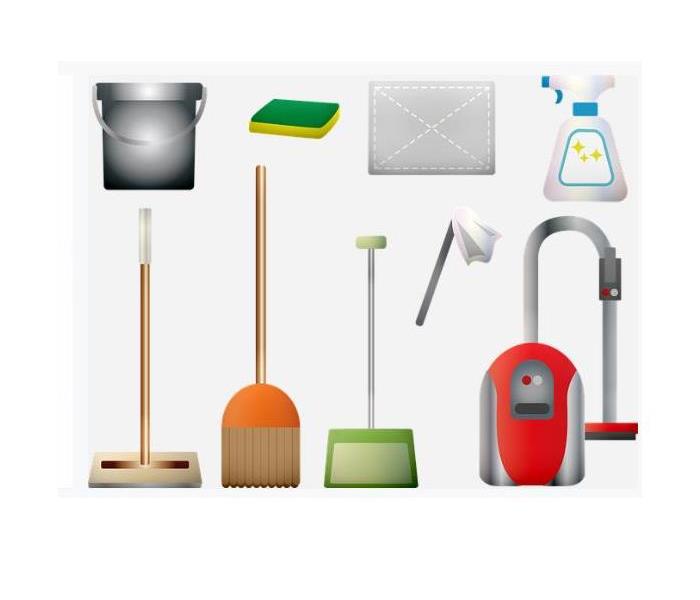 Cleaning is in season and if you need help call the professionals at SERVPRO.
Cleaning is in season and if you need help call the professionals at SERVPRO.
Spring is here!
Traditionally, people feel the need to deep-clean their homes once they feel the warm air arrive and can open their windows to welcome the new season. There are many areas in your home that you will want to clean once begin tackling this spring-time chore. Here are a few tips to help you get started that you may not have considered.
Wash Your Curtains and Drapes
When you start your spring cleaning, one of the first things you should do is clean your window coverings. This includes blinds, shutters, curtains or drapes. This should be done early on in the process as dirt and dust from the coverings can fall to the floor below, so you don't want to clean your floor before the drapes.
Test Your Smoke Detectors
Another step that should be included in spring cleaning is testing your smoke detectors. Most detectors have a test button on them that allows you to ensure they are working. If they don't work, you probably just need to replace the batteries.
Replace Water and Air Filters
As part of your spring-cleaning checklist, be sure to replace water filters and air filters. Filters catch debris from water and air. When they get full, they cannot filter as effectively as they should. The filters should be routinely replaced to ensure that they can work efficiently.
Clean Your Dryer Vent
Your dryer vent can easily become filled with lint and debris. Clean the dryer vent to help improve drying time and energy efficiency and also to prevent a fire. The vent inside your dryer should be cleaned with each load, but in the spring, you should check your exterior vent as well, making sure there is nothing accumulating in the tubing from the dryer to the outside.
Clean Your Grill
Once it begins to get warmer, people start thinking about cooking and eating outside. Now is the perfect time inspect your grill, refill your tanks if it is a gas grill, and clean all the cooking surfaces so it is ready to use when you want to make delicious meals.
Check Your Windows and Doors For Leaks
As you spring clean, take the time to check your windows and doors for leaks or air drafts. If you feel outdoor air seeping in, the seals may need to be replaced.
Check Your Plumbing for Leaks
Take the time to check your plumbing for leaks. Look for leaks under your sinks and for leaking faucets. If you notice any leaks, call in a plumber to make the needed repairs.
Make doormats welcoming
Shake 'em, wash 'em, swat 'em with a broom. Give them the toughest cleaning they can take. They’re your front line against tracked-in dirt—so keep them clean enough to function at peak efficiency.
Clean carpets and upholstery
Fabrics that have absorbed a winter’s worth of dirt, body oil, and germs will need a deep cleaning to get them ready for another year of wear—and for that close inspection by your relaxing guests. Move furniture just slightly—not out of the room or against the wall, as the old rules dictated—and place the legs of each piece back on top of small wax paper squares after shampooing. The wax paper will protect your carpet and keep the furniture legs from getting wet as the carpet dries. Open the windows to speed the drying process, which can take a day or more. If you’re not the furniture-shifting and machine-renting type, use a professional carpet and upholstery cleaner like SERVPRO.
Finish your floors
To protect the floors in your kitchen from another year of wear and tear, wax or apply a sealer following label directions. The simplest method: Use a combination wash-and-wax floor cleaner. No-wax floors don’t need a polishing treatment, but an occasional makeover will keep them looking fresher and add a protective buffer that could help them last longer. Use a floor cleaner that cleans, shines, or both. If you have wood floors, move furniture and rugs aside, then apply a wood cleaner and either liquid or paste polish to clean and add a new wax coating.
Wash walls, cabinets, baseboards, and woodwork
The walls may not look as if they need a bath—dust and soot fall to the floor, right? Most of it does, but just enough clings to vertical surfaces to warrant a seasonal or pre-holiday bath. Use a sponge and hand dish washing detergent, washing the surface in sections. A sponge mop makes it easier to reach higher spots. Use two buckets: one for dish washing detergent solution and another for wringing your sponge. Dry the walls and woodwork with a clean cloth.
Vacuum with intelligence
The old rules mandated that you go through the labor-intensive task of dragging every stick of furniture off the carpet, just so the vacuum cleaner could cover every nook and cranny. Instead, simply move those big items a little to the left or to the right. Vacuum the area previously occupied by the furniture and then move it back into place.
Clean ceiling fixtures
Remove dust and dirt from ceiling fans and air-conditioner vents with a cloth and a vacuum with a soft nozzle attachment.
Clean your light fixtures
A few minutes with a stepladder, all-purpose cleaner, a sponge, and a polish cloth will give new light to your life. If your home has skylights or tall ceilings, consider investing in a stepladder and extended-reach dust-and-dirt-removal tools, all of which are available at your local hardware store and at home supply stores.
Check your coils
You should clean the refrigerator’s condenser coil, usually found behind the toe grille, with a long-handled bottle brush and a vacuum cleaner with an attachment hose to remove dust and lint. Built-up dust can shut down the unit by causing it to overheat. To remove dust from coils attached to the hard-to-reach back side of the fridge, carefully pull the refrigerator out several feet (newer models roll on casters) and vacuum thoroughly; finish by sweeping or vacuuming the floor area you’ve revealed. Expect to rediscover coins, bottle caps, and twist ties that you and the cat knocked over the past year.
Are you looking to get your home clean for spring but lack the time to do it all yourself? Here at SERVPRO of West Riverside City, we can help you with some of your cleaning needs. We offer many services including fire and water clean-up services, mold remediation, and routine house cleaning, including carpet cleaning. Give us a call at 951-351-8033 so we can get started today.
The Key to Mold is Moisture Control from our friends at EPA.gov
4/29/2019 (Permalink)
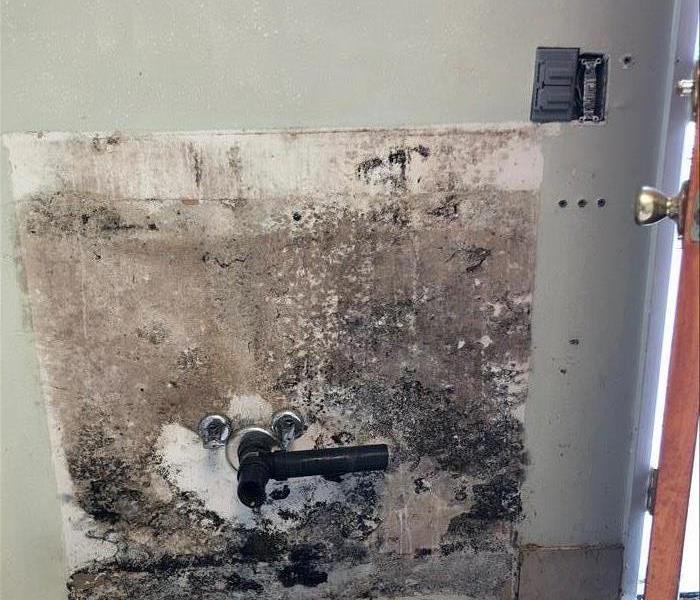 If you already have a mold problem – ACT QUICKLY. Mold damages what it grows on. The longer it grows, the more damage it can cause.
If you already have a mold problem – ACT QUICKLY. Mold damages what it grows on. The longer it grows, the more damage it can cause.
Why is mold growing in my Riverside home?
Molds are part of the natural environment. Outdoors, molds play a part in nature by breaking down dead organic matter such as fallen leaves and dead trees, but indoors, mold growth should be avoided. Molds reproduce by means of tiny spores; the spores are invisible to the naked eye and float through outdoor and indoor air. Mold may begin growing indoors when mold spores land on surfaces that are wet. There are many types of mold, and none of them will grow without water or moisture.
How do I get rid of mold?
It is impossible to get rid of all mold and mold spores indoors; some mold spores will be found floating through the air and in house dust. The mold spores will not grow if moisture is not present. Indoor mold growth can and should be prevented or controlled by controlling moisture indoors. If there is mold growth in your home, you must clean up the mold and fix the water problem. If you clean up the mold, but don’t fix the water problem, then, most likely, the mold problem will come back.
Mold Cleanup
Who should do the cleanup?
Who should do the cleanup depends on a number of factors. One consideration is the size of the mold problem. If the moldy area is less than about 10 square feet (less than roughly a 3 ft. by 3 ft. patch), in most cases, you can handle the job yourself, following the guidelines below. However:
¦ If there has been a lot of water damage, and/or mold growth covers more than 10 square feet, consult the U.S. Environmental Protection Agency (EPA) guide: Mold Remediation in Schools and Commercial Buildings. Although focused on schools and commercial buildings, this document is applicable to other building types. It is available on the Internet at: www. epa.gov/mold.
¦ If you choose to hire a contractor (or other professional service provider) to do the cleanup, make sure the contractor has experience cleaning up mold. Check references and ask the contractor to follow the recommendations in EPA’s Mold Remediation in Schools and Commercial Buildings, the guidelines of the American Conference of Governmental Industrial Hygenists (ACGIH), or other guidelines from professional or government organizations.
¦ If you suspect that the heating/ventilation/air conditioning (HVAC) system may be contaminated with mold (it is part of an identified moisture problem, for instance, or there is mold near the intake to the system), consult EPA’s guide Should You Have the Air Ducts in Your Home Cleaned? before taking further action. Do not run the HVAC system if you know or suspect that it is contaminated with mold - it could spread mold throughout the building. Visit www.epa. gov/iaq/pubs to download a copy of the EPA guide.
¦ If the water and/or mold damage was caused by sewage or other contaminated water, then call in a professional who has experience cleaning and fixing buildings damaged by contaminated water.
¦ If you have health concerns, consult a health professional before starting cleanup.
Mold Clean Up Guidelines
6 Tips and techniques
The tips and techniques presented in this section will help you clean up your mold problem. Professional cleaners or remediators may use methods not covered in this publication. Please note that mold may cause staining and cosmetic damage. It may not be possible to clean an item so that its original appearance is restored.
¦ Fix plumbing leaks and other water problems as soon as possible. Dry all items completely.
¦ Scrub mold off hard surfaces with detergent and water, and dry completely. Places that are often or always damp can be hard to maintain completely free of mold. If there’s some mold in the shower or elsewhere in the bathroom that seems to reappear, increasing the ventilation (running a fan or opening a window) and cleaning more frequently will usually prevent mold from recurring, or at least keep the mold to a minimum.
¦ Absorbent or porous materials, such as ceiling tiles and carpet, may have to be thrown away if they become moldy. Mold can grow on or fill in the empty spaces and crevices of porous materials, so the mold may be difficult or impossible to remove completely.
¦ Avoid exposing yourself or others to mold (see discussions: What to Wear When Cleaning Moldy Areas and Hidden Mold.)
¦ Do not paint or caulk moldy surfaces. Clean up the mold and dry the surfaces before painting. Paint applied over moldy surfaces is likely to peel.
¦ If you are unsure about how to clean an item, or if the item is expensive or of sentimental value, you may wish to consult a specialist. Specialists in furniture repair, restoration, painting, art restoration and conservation, carpet and rug cleaning, water damage, and fire or water restoration are commonly listed in phone books. Be sure to ask for and check references. Look for specialists who are affiliated with professional organizations.
Bathroom Tip
Places that are often or always damp can be hard to maintain completely free of mold. If there’s some mold in the shower or elsewhere in the bathroom that seems to reappear, increasing the ventilation (running a fan or opening a window) and cleaning more frequently will usually prevent mold from recurring, or at least keep the mold to a minimum.
A qualified restoration company understands the science behind mold and mold growth. SERVPRO Franchise Professionals have the training and expertise to remediate the mold in your home or business. Mold remediation focuses on getting mold levels back to normal, natural levels.
If you need a remediation company, call SERVPRO of West Riverside City 951-351-8033
See full document at A Brief Guide to Mold, Moisture, and Your Home
SERVPRO of West Riverside-Commercial Water Damage Experts
4/24/2019 (Permalink)
 Sewage Backup in Riverside High School
Sewage Backup in Riverside High School
Has your business or commercial property recently become a victim of commercial water damage? Then you need to know you can take steps to mitigate the damage to your commercial property.
First, know you must act fairly quickly to preserve as much of your property as possible. Acting quickly is also important in decreasing any health risks to your employees or others after commercial water damage has happened.
One of the first considerations if your commercial property has major water damage is to prepare an adequate space for water damage restoration. You may need a clean and dry staging area where you can bring water damaged furnishings and equipment to be dried out, cleaned up, and worked on. Many commercial business owners don’t realize that some equipment that may look completely ruined can be restored if treated quickly and properly.
Be Sure The Power’s Off
Always remember that before you enter your commercial space (or any flooded building) you must make sure the electrical power to the business is shut off. And consult with the local fire department or other first responders to make certain they agree that you can safely reenter the commercial building.
During flooding events small animals and reptiles tend to seek shelter inside of buildings. Depending on where your business is located you may want to be prepared to deal with the discovery of wild animals in your space.
Questions about commercial water damage? We are experts. Call SERVPRO of West Riverside City (951)351-8033
Wear Proper Protection
Put on proper protection before you enter any flooded building. This includes an organic vapor respirator that you can purchase at any paint and building supply store. Wear rubber gloves, protective clothing, and eye protection.
Once inside, the first thing is to ventilate the water-damaged areas. Open windows. Place fans where they can best move the air to dry out the area.
In any major commercial water damage situation there’s likely to be items you need to throw away. For example, any items that are porous and have absorbed contaminated floodwater cannot be restored. If your commercial space has drywall, mattresses, pillows, box springs, particle board, carpets, or carpet pads, they must be discarded if they have become water-saturated.
Some Good News
But here’s the good news: If your water damaged commercial space includes clothing or household fabrics that can be machine-washed, you may be able to save them. Use your washing machine to clean these items with a 10-minute soak at minimum in hot water with detergent. The soap and normal wash should remove most of the contamination and any staining that is present.
Know that your commercial space will need a thorough professional inspection. You’ll need professional cleaning services, and possibly building renovation. Many water damaged commercial spaces have water damaged walls and installation that must be removed and replaced. Professionals also know how to uncover pockets of saturation and exposed them so they can dry and be sanitizing.
Questions about commercial water damage? We are experts. Call SERVPRO of West Riverside City (951)351-8033
Stop Mold Growth
After major commercial water damage, mold is a threat. Mold growth can take a few days to appear. It thrives in a moist environment with organic-type materials such as paper or particle board and in temperatures that range between 60 and 86 degrees Fahrenheit.
During your restoration process keep good airflow throughout the interior environment. Maintain moderate temperatures to decrease the risk of mold growth. And let your commercial space dry out completely before you begin any rebuilding.
More Information On This Blog
You can learn more by reading other posts here on the SERVPRO of West Riverside City:
Help Is Here
The team at SERVPRO of West Riverside City has specialized training and experience in commercial water damage restoration services, natural disaster prevention, fire damage, and natural disaster cleanup. Call SERVPRO of West Riverside City (951) 351-8033 anytime.
Located in West Riverside but serving all of Riverside and surrounding areas: Corona, Temecula, Moreno Valley, Hemet, Colton, Rancho Cucamonga, Murrieta, Temecula, Eastvale, Loma Linda, Calimesa Perris, Rialto, Redlands, Ontario...call us we can help you out. Your neighbors here in Riverside, family own and operated!
24-hour emergency service including all holidays!
6 Fire Damage Restoration Tips from your Friends at SERVPRO of West Riverside City
4/22/2019 (Permalink)
We’re not going to kid you. Fire damage restoration is tough work.
People call SERVPRO of West Riverside City frequently to ask for advice on how to clean up after a fire. Here are seven of the best tips we give people who ask about fire damage restoration.
Most people can put these tips into practice. But remember that fire damage restoration takes time, work, and skill. Realistically consider whether you want to try these ideas on your own or whether you’d be better off hiring highly trained restoration specialists who will guarantee their work.
Remove Smoke DamageWith any fire you’ll have a degree of smoke damage to your walls, wall paper, and paint. If the smoke damage is not too serious, you should be able to scrub it clean with detergents and bleach. Soot from smoke damage is greasy stuff, so always try to dust as much of it off from a surface before trying to scrub the surface clean. Often, you’ll want to repaint, but make sure all surfaces are clean and dry before you paint.
Limit Activity & Other Simple Fire Damage Restoration StepsUntil your house is restored, limit your activity and movement in the house. This helps prevent soot particles from being embedded into upholstery and carpets. Keep people’s hands clean so you don’t further soil upholstery, walls, and woodwork. Protect your things by placing clean towels or old linens on rugs, upholstery, and carpet traffic areas. Before you clean know the best cleaning method for that particular cleaning job (one example: Clean and protect chrome with a light coating of petroleum jelly or oil.) Wash both sides of the leaves on your houseplants. Change your HVAC filter and tape double layers of cheesecloth over air registers.
Call SERVPRO Of West Riverside City for Cleanup and Restoration. Call (951) 351-8033.
Get Rid of Mold & MildewFirefighters are great. They save many a live and many a home. But they do introduce mold and mildew into houses when they must use water to extinguish the fire. SERVPRO of West Riverside City highly recommends you hire fire damage restoration professionals to deal with mold and mildew. Mold and mildew can cause serious health problems. It’s difficult for a nonprofessional to know for certain if he’s clean up all the areas affected by the mold and mildew. And mold and mildew can contaminate your furniture, carpets, clothing, mattresses, walls, and vents. The best thing you can do immediately is to air out every room and clean out all vents and filters.
Replace Carpets. Clean And Dry Your FloorsYour floors and carpets end up absorbing the worst of the damage from all the water used to put out a fire. In almost every case, SERVPRO of West Riverside City recommends that you pull up any carpets that have water damage and replace them. Water can also seep underneath vinyl flooring and into the cracks in hardwood. You must address this. If you have experience with flooring, you can lift it up and clean under it. But you may want to call a professional fire damage restoration company to assist you.
Avoid Smearing Soot Into ClothingCleaning smoke damage from clothing is one of the biggest jobs you’ll have after a fire. Make sure you don’t smear the greasy soot into the clothing or just throw the smoky clothes into the wash. Often times dry cleaning is the best bet, and you should ask around local dry cleaners to see if any have experience with post-fire laundry. Removing smoke odor is another issue and we’ve covered it in another blog post.
Call SERVPRO of West Riverside City for Cleanup and Restoration. Call (951) 351-8033.
Scrub, Soak, And Cleaning DishesDishes are also important items to clean thoroughly after a fire because they will be in contact with your food. Scrub all dishes well, let them soak in a solution of bleach and water (2 tablespoons of bleach per gallon) for at least 20 minutes and scrub some more for safety. When in doubt, if a dish, pot, or pan won’t come clean, cut your losses and throw it out – especially rubber or wooden dishes that absorb smoke.
Help Is Here
The team at SERVPRO of West Riverside City also has specialized training and experience in fire restoration services, natural disaster prevention, water damage, chemical cleanup, and natural disaster cleanup. Call SERVPRO of West Riverside City (951.351.8033) anytime.
More Information On Our Blog
Join SERVPRO of West Riverside in Supporting RIVERSIDE COUNTY PROFESSIONAL FIREFIGHTERS BENEVOLENT FUND
4/17/2019 (Permalink)
Every day, firefighters are exposed to a soup of toxins and biohazards. These exposures can happen on a call, or even while at the station. Sometimes, the effect of these exposures is immediate. More often, it builds up over time, leading to job-related cancer, heart disease or PTSD.
The Riverside County Professional Firefighters Benevolent Fund is proud to support the firefighters and cooperators in Riverside County. The firefighters of Riverside County provide fire and EMS services to one of the largest counties in California. It is the goal of the Riverside County Professional Firefighters Benevolent Fund to be able to support those men and women in their time of need. The Riverside County Professional Firefighters Benevolent Fund is a 501c3 (Non Profit) and is comprised of a board of Directors. The Riverside County Professional Firefighters Benevolent Fund not only supports the firefighters of Riverside County, it also supports other nonprofit originations that are affiliated with the fire service, such as cancer research and the burn institutes. The Riverside County Professional Firefighters Benevolent Fund has also aligned itself with CDF Firefighters Riverside Chapter Employees Association a 501c4, to help support the organizations that are directly represented by its membership, such as, diabetes and cancer research, RAGNAR and several sporting teams that are directly comprised of CALFIRE Local 2881 members. These teams in turn also raise funds for other nonprofit organizations represented by the fire community. In addition to direct assistance to the firefighting community and other non-profits, we have aligned ourselves with financial organizations to assist our members with their other financial needs.
General Donations:
Our funding comes from several sources. The Riverside County Professional Firefights Benevolent Fund has entered into commercial fundraising contracts with different firms. Firms are under non exclusive contracts and receive fees for their service that are commensurate with the services they provide and the projected outlays the fund would incur if it was to undertake the same efforts for fundraising. Companies are required to present themselves in a professional manner when dealing with the public, they must state who they are working for; have a company ID stating their companies name and that they are certified as a fundraising company by the Attorney General’s Office. The company that is currently under contract is Associated Programs Inc. Companies conduct telemarketing and direct mailing campaigns on behalf of the fund. In addition to our contractual fundraisers the fund also does direct corporate fundraising activates. Both corporate and private donations can also be made via our web. We are also working on developing other social media donation locations. Additionally, we are working on other fundraising events such as our annual “Shop with a Firefighter” event, which pairs children in custody of Riverside Co. Protective Services with Firefighters for a Holiday Shopping event. The newest fundraiser is the “Bacon Fund”, we are sponsoring an underprivileged youth through a local county high schools FFA program, to raise and show a pig at this year’s Perris Fair. Usually the pig is auctioned off, but in our case the pig will be processed and each half of the pig will be raffled off, allowing the youth to complete the production cycle.
Fundraising Time Periods:
January through September : General Solicitation: Direct and indirect solicitation by the RCPFBF and commercial contract companies, via all types of media including written, telephone and internet.
July through Early October: Bacon Fund: Direct Solicitation thru tickets sales via the RCPFBF Board Members; fund representatives and the RCPFBF web page.
September through December: Shop with a Firefighter: Direct and indirect solicitation by the RCPFBF and commercial contract companies, via all types of media including written, telephone and internet.
SERVPRO of West Riverside City would like to thank the firefighters and first responders in the surrounding areas for their incredible service to the community. As a fire damage restoration company, the jobs of the local fire departments are integral to our day-to-day actions, as the volunteers and staff members fight dangerous fires and recover property that SERVPRO can restore.
More importantly, however, our local firefighters work daily to keep us and the members of our community safe and protected from fire emergencies.
We at SERVPRO of West Riverside City encourage everyone to thank their local fire departments for all that they do!
MAKE A DONATION TO RCPFBF
The Riverside County Professional Firefighters Benevolent Fund is organized for the purpose of providing physical, financial, and emotional support to our members and their families during times of need. Our support is provided by an all-volunteer Board of Directors in a non-political and non-denominational manner.
All donations made are tax deductible, under IRS 501(c)3 laws and regulations. A receipt will be provided to you on request. All monetary donations are used to assist the members of the Association and/or for other charitable ventures that our Association supports.
If you would like to make a donation click the link to access their Website
https://www.rcpfbf.com/
Upcoming Events
Baseball Game @ Storm Stadium
RCPFBF vs ??? – April 28, 2019
Before Regularly Scheduled Storm Game. More to come.
Preparing for Spring Weather in Riverside
4/15/2019 (Permalink)
From our friends at Center for Disease Control and Prevention (CDC): be unpredictable. When severe weather hits unexpectedly, the risk of injury and death increases, so planning makes sense. Prepare for storms, floods, and tornadoes as if you know in advance they are coming, because in the spring, they very likely will.
Spring is the time of year when many things change—including the weather. Temperatures can swing back and forth between balmy and frigid. Sunny days may be followed by a week of stormy weather. Sometimes extreme weather changes can occur even within the same day. Mark Twain once said, “In the spring I have counted one hundred and thirty-six kinds of weather inside of four and twenty hours.”
Thunderstorms cause most of the severe spring weather. They can bring lightning, tornadoes, and flooding. Whenever warm, moist air collides with cool, dry air, thunderstorms can occur. For much of the world, this happens in spring and summer.
Because spring weather is so unpredictable, you may be unprepared when severe weather hits—particularly if you live in a region that does not often experience thunderstorms, tornadoes, or flooding. And when severe weather hits unexpectedly, the risk of injury and death increases. So planning ahead makes sense; prepare for storms, floods, and tornadoes as if you know in advance they are coming, because in the spring, they very likely will.
Advance planning for thunderstorms, lightning, tornadoes, and floods requires specific safety precautions.
Often by the time we are aware of an approaching storm, we have little if any time to prepare for it.
Advance planning for thunderstorms, lightning, tornadoes, and floods requires specific safety precautions. You can follow many of the same steps that you would for all extreme weather events. Keep an emergency kit on hand. Some items to include are:
- A battery-operated flashlight, a battery-operated NOAA Weather Radio, and extra batteries for both
- An emergency evacuation or shelter plan, including a map of your home and, for every type of severe weather emergency, routes to safety from each room
- A list of important personal information, including:
- telephone numbers of neighbors, family, and friends
- insurance and property information
- telephone numbers of utility companies
- medical information
- According to the American Red CrossExternal a first aid kit may include:
- non-latex gloves
- assortment of adhesive bandages
- antibiotic ointment
- sterile gauze pads in assorted sizes
- absorbent compress dressings
- tweezers
- scissors
- adhesive cloth tape
- aspirin packets (81 mg each)
- first aid instruction booklet (NOTE: Customize your first aid kitExternal to meet your individual and family needs.)
- A 3–5 day supply of bottled water and nonperishable food
- Personal hygiene items
- Blankets or sleeping bags
- An emergency kit Cdc-pdf[1.08 MB] in your car
Prepare your family members for the possibility of severe weather. Tell them where to seek appropriate shelter as soon as they are aware of an approaching storm. Practice your emergency plan for every type of severe weather. Show family members where the emergency supplies are stored, and make sure they know how to turn off the water, gas, and electricity in your home.
Often by the time we are aware of an approaching storm, we have little if any time to prepare for it. But we do know that when spring arrives, thunderstorms, tornadoes, and floods are real possibilities. So why not take the surprise factor out of severe weather and prepare yourself, your family, and your home? If thunderstorms, tornadoes, and floods do occur, you’ll be ready for them.
SERVPRO of West Riverside City specializes in the cleanup and restoration of commercial and residential property after damaging event. Our staff is highly trained in property damage restoration. From initial and ongoing training at SERVPRO’s corporate training facility for regular IICRC-industry certification, rest assured our staff is equipped with the knowledge to restore your property.
SERVPRO of West Riverside City has experience restoring homes affected by storms and flooding. We can respond immediately with highly trained technicians who employ specialized equipment and techniques to restore your home or business back to pre-storm condition.
Faster Response
Since we are locally owned and operated, we are able to respond quicker with the right resources, which is extremely important. A fast response lessens the damage, limits further damage, and reduces the restoration cost.
Resources to Handle Floods and Storms
When storms hit SERVPRO of West Riverside City can scale our resources to handle a large storm or flooding disaster. We can access equipment and personnel from a network of 1,650 Franchises across the country and elite Disaster Recovery Teams that are strategically located throughout the United States.
SERVPRO of West Riverside City wants our team to be part of your team! Call us at (951) 351-8033 or follow us on Facebook, Instagram, and Twitter!
Financial Preparedness for Disasters and Emergencies
4/10/2019 (Permalink)
This April, the Ready Campaign will host social media events on financial preparedness as part of National Financial Capability Month. From our friends at READY.ORG
Topics include planning and budgeting, saving for disasters and emergencies, and the importance of insurance.
Join us:
- 3 p.m. ET, April 2, Facebook Live, Unlocking Your Financial Future: Build it. Grow it. Secure it.
- 1 p.m. ET, April 10, TwitterChat, Plan for the Unexpected. (#FinancialChat)
- 4 p.m. ET, April 17, Webinar: Money Matters: Resources for Youth in Financial Preparedness. Register for the webinar here.
- 1 p.m. ET, April 24, TwitterChat: Insure your Financial Future. (#FinancialChat)
Join the financial preparedness conversation by following us at #FinancialFuture2019.
Financial Preparedness
Americans at all income levels have experienced the challenges of rebuilding their lives after a disaster or other emergency. In these stressful circumstances, having access to personal financial, insurance, medical, and other records is crucial for starting the process of recovery quickly and efficiently. Taking the time now to collect and secure these critical records will give you peace of mind and, in the event of an emergency, will ensure that you have the documentation needed to start the recovery process without delay.
<ol1">
- Gather financial and critical personal, household, and medical information.
- Consider saving money in an emergency savings account that could be used in any crisis. Keep a small amount of cash at home in a safe place. It is important to have small bills on hand because ATM’s and credit cards may not work during a disaster when you need to purchase necessary supplies, fuel or food.
- Obtain property (homeowners or renters), health, and life insurance if you do not have them. Review existing policies for the amount and extent of coverage to ensure that what you have in place is what is required for you and your family for all possible hazards. Homeowners insurance does not typically cover flooding, so you may need to purchase flood insurance from the National Flood Insurance Program.
- Scroll down for more helpful financial preparedness tips and download the Emergency Financial First Aid Kit (EFFAK) to get started planning today.
The Emergency Financial First Aid Kit (EFFAK), a joint publication from Operation Hope and FEMA to help you prepare financially and provide tips to reduce the impact disasters can leave you with financially.
For Organizations
Encourage people throughout your organization to be financially prepared. Here are some ideas to promote financial preparedness in your organization:
- Hold a brown bag meeting or
- Make a presentation at an existing staff meeting using the Emergency Preparedness Financial First Aid Kit PowerPoint and use the Safeguarding Your Valuables Facilitator Guide to support your discussion.
- Include financial preparedness information in the staff monthly newsletter.
At Home
Using the EFFAK as a guide, or by downloading a secure mobile app on your phone, store important documents either in a safety deposit box, an external drive, on the cloud to make it easy to access during a disaster.
Having your financial and medical records and important contact information will be crucial to help you start the recovery process quickly. Take time now to safeguard these critical documents.
Household Identification
- Photo ID to prove identity of household members
- Birth certificate to maintain or re-establish contact with family members
- Social security card to apply for FEMA disaster assistance
- Military service
- Pet ID tags
Financial and Legal Documentation
- Housing Payments to identify financial records and obligations
- Insurance policies to re-establish financial accounts
- Sources of income to maintain payments and credit
- Tax statements to provide contact information for financial and legal providers & apply for FEMA disaster assistance
Medical Information
- Physician information to provide doctors with health information if medical care is needed
- Copies of health insurance information to ensure existing care continues uninterrupted
- Immunization records
- Medications
Insurance Information
Having insurance for your home or business property is the best way to ensure you will have the necessary financial resources to help you repair, rebuild, or replace whatever is damaged. Document and insure your property now.
Household Contact information
- Banking Institutions
- Insurance agent
- Health professionals
- Service providers
- Place of worship
Get your benefits electronically
A disaster can disrupt mail service for days or weeks. If you depend on Social Security or other regular benefits, switching to electronic payments is a simple, significant way to protect yourself financially before disaster strikes. It also eliminates the risk of stolen checks. The U.S. Department of the Treasury recommends two safer ways to get federal benefits:
- Direct deposit to a checking or savings account. Federal benefit recipients can sign up by calling (800) 333-1795 or sign up online
- The Direct Express® prepaid debit card is designed as a safe and easy alternative to paper
From our friends at: Ready.Gov Financial Preparedness
SERVPRO of West Riverside City is here if you have any questions, we work closely with insurance agencies!
The Equipment We Use to Restore your Riverside Property
4/3/2019 (Permalink)
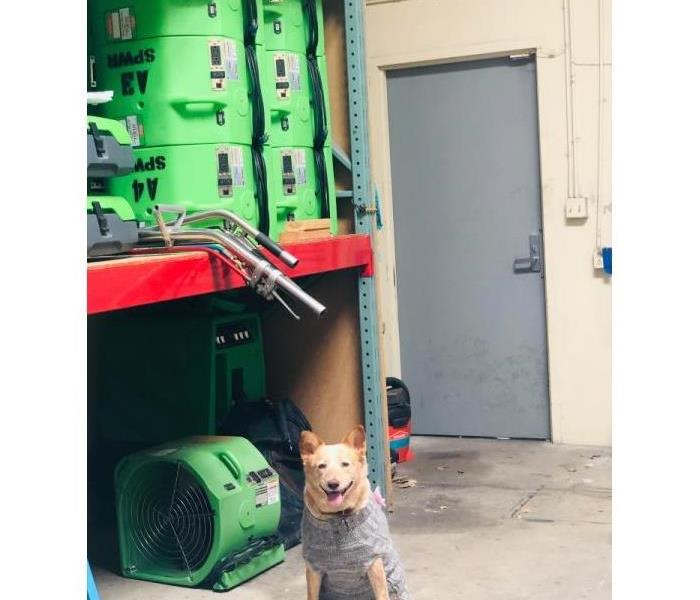 Our Mascot Ellie displays some of the equipment we use to restore Riverside property.
Our Mascot Ellie displays some of the equipment we use to restore Riverside property.
The SERVPRO of West Riverside City franchise takes pride in making sure our customers are helped to the best of our ability.
To do this, our products and equipment need to be the best available so we can make sure the property and situations we encounter during disasters are able to be restored and brought to preloss conditions. With that in mind, we will take you through a behind the scenes look at some of the equipment we use to help get your property and structure to preloss condition. Each machine and piece of equipment has a crucial role in the restoration process. Our technicians are trained to use each piece of equipment to its highest potential. Here are a few of our most commonly seen and used machines, and their purpose.
PORTABLE EXTRACTORS: Extractors are used for cleaning carpets, cleaning upholstery, and removing water from floors after a water loss. An extractor has three major components: a heater, a pump, and a vacuum system. Our technicians use this machine for variable heat controlled cleaning, including to heat the rinse solutions to clean more effectively. The vacuum system and waste recovery tank remove soils and moisture from the surface and collects it in the tank. With this machine, we can expedite the removal of water and moisture from damaged materials and textiles to help restore it to preloss conditions. In doing this, the potential of having to replace materials or belongings is lowered.
THE OZONE GENERATOR: The portable ozone generator eliminates a variety of odors caused by animals, cigarette smoke, mold and mildew, fire, and water damage. This machine generates “ozone”, which consists of unstable oxygen molecules (containing three oxygen atoms). Ozone chemically reacts with odor-causing molecules to oxidize residues and remove the odors. When using this piece of equipment, we follow the absolute and necessary guidelines of use with the purpose of all people and pets should be removed from the environment during ozoning for health and safety reasons. Once the deodorization process is complete, ozone quickly reverts to the normal oxygen molecule, leaving no residues. Once the odor is gone, the results are permanent. One of the features of the ozone generator is that it is made to be compact and portable, yet also be a durable and professional unit.
WEARING AND FIT CHECKING OUR RESPIRATORS: Safety for not only our technicians, but also our customers, is a priority in our company. We enforce that respirators must be worn during all times by our technicians during exposure to hazardous situations. To be safe, we follow one rule of thumb: if the work environment is unpleasant or if it makes you dizzy, our crew is to wear their respirators. No if’s, and’s or but’s. If we are using respirators, we inform customers in the general area of this and advise them with the necessary precautions associated with the work going on for their safety.
DEHUMIDIFIERS: Dehumidifiers remove moisture from the air after it has evaporated. Our technicians position dehumidifiers strategically in a water-damaged structure so the moist, humid air moves through the unit while dry, warm air is discharged from the unit circulating back into the wet areas. Did you know that dry air acts like a sponge to absorb moisture from wet materials? Since it does, we use the dehumidifiers especially because it provides a continual source of dry air to enhance the restoration process. Refrigerant dehumidifiers remove water vapor through condensation, and based on the specific job, we will use a small commercial refrigerant dehumidifier because it removes approximately 8 gallons of water per day from the atmosphere, while an extra-large commercial refrigerant could remove as much as 20 gallons per day.
AIR MOVERS: Air movers are used in water damage restoration to enhance evaporation at the surface level and reduce drying time. These machines introduce airflow at the surface level and replace the highly saturated air with drier air to enhance evaporation. Our crew has gone through specific training on the science of drying to know how many air movers they will need and how to position them to create airflow across all wet surfaces. In some cases, when the lower portion of multiple walls are wet, involving wet drywall behind baseboards, enough air movers are positioned to create a vortex of circular airflow around the walls. Our technicians operate the air movers in several different positions, offering flexibility in how to direct the airflow with the best possible outcome.
There are many other machines and equipment accessories we use, but for today’s behind the scenes look we are proud to show you some our most commonly used pieces of equipment. These machines help us get your personal disaster back to preloss condition and to make it “Like it never even happened!” because SERVPRO of West Riverside City is always here to help!
April Showers Bring May Flowers
4/3/2019 (Permalink)
 Spring showers are great for bringing May flowers, but they can also cause water damage to your Riverside home!
Spring showers are great for bringing May flowers, but they can also cause water damage to your Riverside home!
It's Spring and Mother Nature has a lot to say.
Spring storms can cause a tremendous amount of damage to your home, in a small amount of time. But it is not only storms that caused that damage. There are many reasons that water can cause damage to your home. According to the institute of business and home safety, homes over 30 years old are three times more likely to have a major plumbing or drain problems. Some studies have shown that 75% of water heaters also fail within the first 12 years. While this study only covered homes over 30 years, new homes are not excluded from issues either.
There are some signs to look for when examining your business, home, or a home that you may be looking to purchase:
Look up- Look for water spots forming on your ceiling they may look like small to large brown rings. You can also press on these spots they will be soft to the touch. This is to see if they may be formed from a recent leak.
Feel for soft spots- While we do this for spots in the ceiling, it is also important to watch for these on the floor as well. The floor may sag a little when you are walking to the shower or be soft around the base of the toilet. This can happen not only in the bathroom, but anywhere within the house. This could be from current or previous water damage the wet floor or sub-floor could be wet and causing the floor to rot.
Look for rust- Rust on your hot water tank could indicate a small leak. It is suggested to flush your hot water tank and it will prevent sediment build up.
Step Outside- After a good rain step outside and inspect the ground around your home. Is your home landscaped for proper drainage or does the water gather around the base of your home? Do you see water rings around the base of your home?
Inspecting your roof- Inspection of your roof is very important, particularly after a heavy storm. The combination of high winds, rain and sometimes hail could be detrimental to the life of your roof. Watch for missing shingles, broken tiles, damaged flashing and pools of water.
Smell- Odor caused by mold or mildew that could be linked to some kind of water damage inside your house that may have passed unnoticed or unintentionally mistreated.
Once water damage has happened the clock starts ticking. The water problem can quickly worsen, causing secondary damage like mold. When your property has a water damage you don't have the luxury of waiting around to hope that it dries out on its own so call the professionals to get help. Secondary damage can begin as early as 24 to 48 hours. Mildew spores are everywhere, but it needs moisture and a food source to develop. That is just what your wet carpet and drywall offers. So proper and timely treatment of the water damage is so important.
It is important to note that not all water damages are treated equally. Each cause of origin has its own standards as far as treatment and coverage. It is always important to contact your insurance company immediately for them to determine your policy for coverage.
If we are experiencing spring rain showers or storms, and you find that your home or business is having water damage occur due to storm or ground water intruding into your home or building here are a few steps to take:
Try to locate the source of the intruding water.Try to block the source location of the water.Place all furniture in the affected area up on some sort of risers to prevent damage.Try to soak up as much water as possible.And last but not least, and the most important step of all:
Call SERVPRO of West Riverside City to extract any water that has intruded into your home or building, and to start drying out the affected area(s)If you are dealing with water damage from a storm, do not hesitate to call SERVPRO of West Riverside City, because we are always here to help make your loss “Like it never even happened.”
Visit our Website for additional information on:
Storm DamageWater DamageMold RemediationAll of which are can be a result of spring showers.
We also have many blogs that offer tips, how to prepare for and address many different challenges tied to water, fire, mold, storm, commercial and storm damage!
Save our number in your emergency contacts, we are available 24 hours a day, 7 days a week, and this includes all major holidays!
SERVPRO of West Riverside City, your neighbor and friend!
951-351-8033
Supply Line Burst in your Riverside Home? Causes and Signs
4/1/2019 (Permalink)
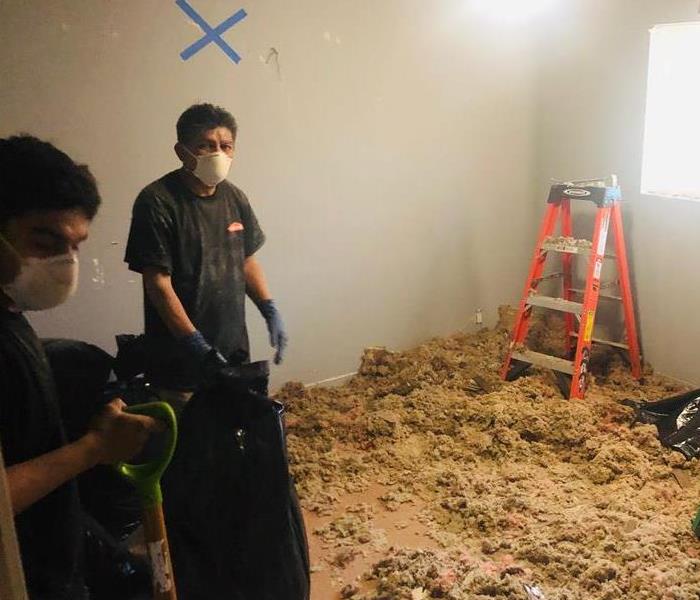 Supply Line Burst in the attic of this Riverside home
Supply Line Burst in the attic of this Riverside home
Did a Supply line Burst in Your Riverside Home?
Rust, installation issues and physical damage to the pipe can cause a hole to form. Even a trickle of water from a small hole can damage drywall, ruin flooring and cause other damage that costs you hundreds or thousands of dollars to repair. Identifying the signs of a problem in your pipes can help you stop the leak before it becomes a major issue.
What causes pipes to burst? There are a number of potential reasons why pipes inside a home can experience too much stress and break open, causing major flooding and damage problems for homeowners. But there are four chief causes of burst pipes:
If water pipes aren’t secured, they can sometimes move around inside the walls whenever water is suddenly turned on or off. If you’ve ever heard pipes clanging inside walls or floors, it’s called water hammer. The pipes move back and forth and gradually can weaken joints in the pipe until one fails and allows pressurized water to escape the pipe. The resulting damage can be catastrophic and expensive.
A hole in a pipe means less water comes through to your faucets. That can cause a decrease in the water pressure that you notice when you wash your hands, fill your sink or take a shower. Lower water pressure can also increase clogs in your toilet or sinks because the decreased water pressure can't push everything down the pipes. A sudden or unexplained drop in pressure could mean water is leaking somewhere in the system. In the case of frozen pipes, you might notice that no water comes out of the faucet.
Pipes often run through your walls behind the drywall. A leaking pipe behind one of your walls can leave marks or dampness on the drywall. On a multi-story home, pipes running to upstairs bathrooms or laundry rooms can leak down into the ceiling. If you can see the visible signs of water, you already have a good idea of where the leak is located. Depending on the location, you may need to remove the drywall or a portion of the ceiling to get to the damaged pipe.
If the leak is bad enough or goes on for some time, you may notice puddles, drips or gushing water coming out of the area. Follow the source of the water to get a good idea of where the leak is in the pipe. A break in the water main leading into your home can cause a sinkhole or puddles in your yard near the source of the leak. If you notice unexplained water or sinkholes, call a professional right away to investigate.
Water Discoloration and Odors
Discoloration of the water that comes out of your faucets can be a clue that you have a leak or may soon have one. Brownish water sometimes indicates your pipes have rust in them, which often leads to leaks. Water odor can also occur when the pipe leaks. The leak can make it difficult for your plumbing system to push sewage out of your home and into the main line, causing the odor.
Strange Sounds Associated With Water Use
Broken pipes sometimes cause issues within the plumbing system that cause you to hear unusual sounds. You might notice bubbling and whistling sounds. Bubbling can happen when air gets in the sewer line caused by the leak. Dented pipes that may eventually leak can cause whistling sounds as the water tries to fit through the constricted section. You might also notice a dripping sound within your walls when you run the water if a leak has already happened.
Pipe Issues
Exposed pipes, such as those that pass through an unfinished basement or beneath your sink, can show signs of an issue or the potential for bursting. Frost, ice or condensation can let you know that the water inside the pipe is freezing or may freeze soon. Bulges in the pipe often mean the water is already frozen and expanding, which often causes a burst. If the pipe hasn't burst yet, you may be able to thaw the water before any damage happens to prevent issues.
Increased Water Bills
Wondering why your water bills are suddenly higher even though your water usage habits haven't changed? That high bill could be your clue that you have a leak. The water pouring out of the leak adds to your water bill even though you're not actually using it. If you notice your water meter seems to be running constantly even when you're not using water, that can be another indicator of an issue.
Locating the Leak
Some burst pipes or leaks are easy to spot. You may be able to trace the source of a puddle or drip. You might see water stains on the drywall. If the damage happens on an exposed pipe, you can see the hole. Other leaks are hidden behind walls and not so obvious.
If you suspect a leak, your first step is to figure out if it's inside your home or outside in the water main. Turn off all appliances that use water, and don't use any faucets, toilets or other sources of water during the test. Look at the water meter. After 30 minutes, check it again to see if it moved at all during that time. If it did, you have a leak.
The next step is figuring out if it's inside or outside the home. Shut off the main water valve coming into the home. Watch your water meter. If it stops moving, your leak is likely inside the house somewhere. If the meter continues moving, the source is likely a water main leak outside the home.
Once you know you have a leak, you can do a little more digging within your home to locate the source. Look for the visible signs of leaks to figure out where the problem lies. Start with obvious spots like toilets, sinks and showers. If you can't find the leak yourself, a plumber can help you find and fix the problem.
Please follow the tips outlined in our Water Damage Tips—Until Help Arrives Guide to protect yourself and your property.
No matter the extent of the damage, our team will respond to any-sized disaster!
Have Water or Flood Damage?
Call Us Today – (951) 351-8033
Part II NIOSH Warns of Hazards during Cleanup Work Following Forest Fires
3/27/2019 (Permalink)
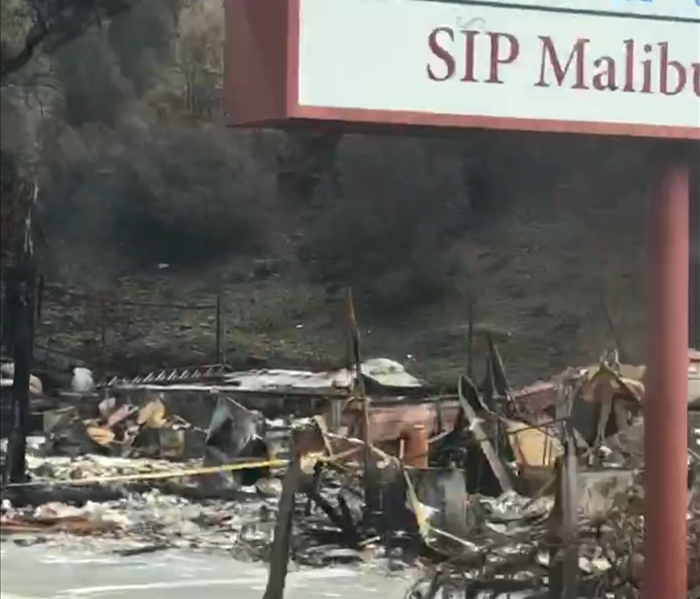 Woolsey fire destroyed many homes and businesses.
Woolsey fire destroyed many homes and businesses.
The National Institute for Occupational Safety and Health (NIOSH) warns workers and volunteers of the potential dangers involved with cleanup operations following the devastation caused by forest fires.
Because the level of experience varies among these workers, cleanup crews must work together and look out for one another to ensure safety.
NIOSH urgently requests your assistance in disseminating the following warnings to all those involved in cleanup work following forest fires. The potential work-related hazards listed here are described below in greater detail: Confined Spaces, Power Line Hazards, Agricultural Hazards, Stress and Fatigue. Additional key resources on health and safety hazards related to fire fighting can be found on the NIOSH web site under the “spotlights” section titled “Fighting Wildfires” (http://www.cdc.gov/niosh/topics/firefighting/).
PREVENTION MEASURES
First Aid
First aid, even for minor cuts and burns, is extremely important. Immediately clean out all open wounds and cuts with soap and clean water. Most cuts, except minor scratches, sustained during cleanup activities will warrant treatment to prevent tetanus. If you are injured, contact a physician to determine the necessary type of treatment.
Protective Equipment
For most clean-up work activities, you will need the following personal protective equipment: hard hats, safety goggles, heavy work gloves, and watertight boots with steel toe and insole (not just steel shank). For information on what equipment you need for protection, contact your local OSHA office or NIOSH.
Excessive noise from equipment such as chain saws, backhoes, tractors, pavement breakers, blowers, and from heavy equipment (e.g., earth moving equipment, helicopters) may cause ringing in the ears and subsequent hearing damage. If working with any noise that you must shout over to be heard, you should wear earplugs or other hearing protection devices.
Working in Confined Spaces
If you are required to work in a boiler, furnace, pipeline, pit, pumping station, septic tank, sewage digester, storage tank, utility vault, well, silo, or similar enclosed structures, you should be aware of the hazards of working in confined spaces. A confined space has one or more of the following characteristics:
- limited openings for entry or exit;
- unfavorable natural ventilation; or
- is not designed for continuous worker occupancy.
Toxic gases, a lack of oxygen, or explosive conditions may exist in the confined area, resulting in a potentially deadly atmosphere. Because many toxic gases and vapors cannot be seen or smelled, never trust your senses to determine if safe entry is possible. Never enter a confined space unless you have been properly trained, even to rescue a fellow worker! If you need to enter a confined space and do not have the proper training and equipment, contact your local fire department for assistance.
Working On or Near Power Lines [Recommendations for Utility Workers ONLY]
Several workers have died of electrocution following natural disasters. Workers and employers must take extreme caution while attempting to restore power or clear areas near downed power lines. In one instance, a worker lost his life while removing trees from a de-energized power line that had been knocked down by a storm. While inspecting the completed work, the man stepped on the line and was electrocuted by "feedback" energy from a portable backup generator at a nearby gas station. Feedback energy occurs when a de-energized line becomes energized by a secondary power source.
Another worker died cleaning branches from a power line, following a storm. He was electrocuted after falling from a tree onto a line thought to be de-energized. Although the workers had opened a fused switch on a transformer, the line remained energized through another transformer.
If you are working on or near power lines, the following steps may save your life:
- Treat all power lines as energized until you have followed the required procedures for personally de-energizing and testing them with an appropriate testing device. Do not rely on "fuzzing" to determine if a power line has been de-energized.
- Verifying that a line is not energized may not ensure your safety. You must also ground lines on both the load and supply sides of the work area. Grounding is necessary to protect you from the hazards of feedback electrical energy from a secondary power source, such as a portable generator.
- When restoring power in underground vaults, added precautions are necessary to avoid explosion hazards. As vaults containing electrical connections are drained or pumped out, and energized, potentially explosive gases may form. If you are required to work in a utility vault, refer to the Confined Spaces section of this Fact Sheet.
RESPIRATORY HAZARDS
If you are involved in cleanup efforts you may be exposed to ash, soot and fire decomposition products that may cause irritation and other respiratory effects. Spoiled and/or wet vegetation and other organic/agricultural materials often grow large amounts of bacteria and mold during warm weather. Breathing these organisms and the organic dust produced may cause lung disease. Use proper engineering controls to exhaust and replenish adequate fresh air if working indoors. A high efficiency particulate air (HEPA)-type vacuum is recommended when cleaning surfaces contaminated with dust. The use of a typical household vacuum should be avoided since it will re-suspend the collected dust into the air. When exposure to dusts cannot be controlled or avoided, exposure can be reduced by routine use of a well-fitted NIOSH-certified air-purifying respirator (such as an N-95 or more protective respirator).
STRESS, LONG HOURS, AND FATIGUE MAY INCREASE THE RISKS FOR INJURY AND ILLNESS
Continued long hours of work, combined with emotional and physical exhaustion and losses from damaged homes and temporary job layoffs, can create a highly stressful situation for cleanup workers. Workers exposed to these stressful conditions have an increased risk of injury and emotional crisis, and are more vulnerable to stress-induced illnesses and disease. Emotional support from family members, neighbors, and local mental health professionals can help to prevent more serious stress-related problems in the difficult months ahead. People working in all phases of cleanup work can reduce their risks of injury and illness in several ways:
- Set priorities for cleanup tasks and pace the work over several days (or weeks). Avoid physical exhaustion.
- Resume a normal sleep schedule as quickly as possible. Get plenty of rest and take frequent rest breaks BEFORE exhaustion builds up.
- Take advantage of disaster relief programs and services in your community.
- Be alert to emotional exhaustion or strain. When family members and neighbors are unavailable for emotional support, consult professionals at community health and mental health centers.
For more information about these or other occupational safety and health topics contact NIOSH at:
1-800-35-NIOSH (1-800-356-4674)
Fax: 513: 533-8573
E-mail: pubstaft@cdc.gov
www.cdc.gov/niosh
Part 1-Warnings from The National Institute for Occupational Safety and Health (NIOSH)
3/25/2019 (Permalink)
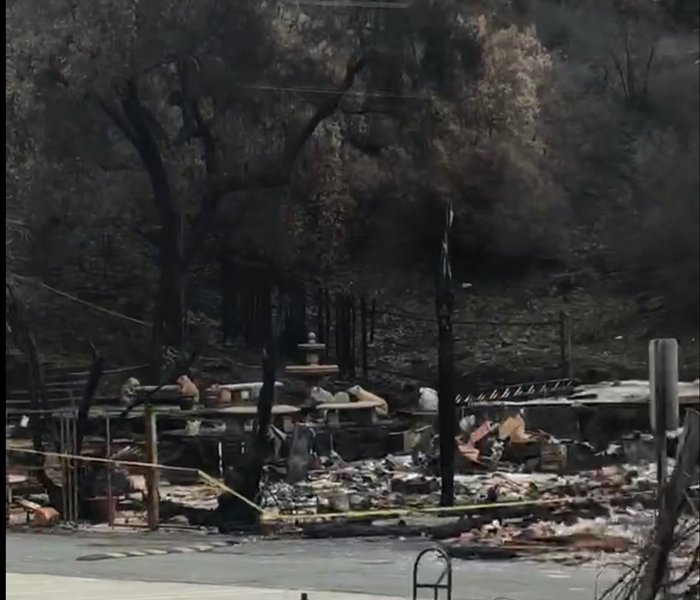 Woolsey fire devastation
Woolsey fire devastation
NIOSH warns workers and volunteers of the potential dangers involved with cleanup operations following the devastation caused by forest fires.
Because the level of experience varies among these workers, cleanup crews must work together and look out for one another to ensure safety.
NIOSH urgently requests your assistance in disseminating the following warnings to all those involved in cleanup work following forest fires.
The potential work-related hazards listed here are described below in greater detail: Fire, Electrical Hazards, Carbon Monoxide, Musculoskeletal Hazards, Thermal Stresses, Heavy Equipment, Structural Instability, Hazardous Materials, Confined Spaces, Power Line Hazards, Agricultural Hazards, Stress and Fatigue. Additional key resources on health and safety hazards related to fire fighting can be found on the NIOSH web site under the “spotlights” section titled “Fighting Wildfires” (http://www.cdc.gov/niosh/topics/firefighting/).
General Considerations
Before cleanup operations are initiated, local and State government emergency policies and guidelines should be checked to determine if any restrictions exist (e.g., water use, discharge of waste water, disposal of debris).
POTENTIAL DANGERS INVOLVED IN CLEANUP OPERATIONS
Fire
Heat sources may remain as a result of smoldering wood or other debris that could reignite if contact is made with a combustible material or if oxygen becomes available. Workers and employers must therefore take extra precautions. At least two fire extinguishers, each with a UL rating of at least 10A, should be provided at every cleanup activity.
Electrical Hazards
NIOSH has investigated several work-related electrocution deaths following natural disasters. To prevent future electrocutions, NIOSH urges those involved in cleanup activities to take the following steps:
- If water has been present anywhere near electrical circuits and electrical equipment, turn off the power at the main breaker or fuse on the service panel. Do not turn the power back on until electrical equipment has been inspected by a qualified electrician. Never enter flooded areas or touch electrical equipment if the ground is wet, unless you are certain that the power is off. NEVER handle a downed power line. No not use electrical equipment that has been exposed to heat from the fire until checked by an electrician.
- When using gasoline and diesel generators to supply power to a building, switch the main breaker or fuse on the building service panel to the "off" position prior to starting the generator. This will prevent inadvertent energization of power lines from backfeed electrical energy from the generators, and help to protect utility line workers from possible electrocution.
- If clearing or other work must be performed near a downed power line, contact the utility company to discuss de-energizing and grounding or shielding of power lines; maintain a safe distance from the power lines until they have been deenergized. Extreme caution is necessary when moving ladders and other equipment near overhead power lines to avoid inadvertent contact. If you are working on or near power lines, refer to the additional recommendations provided in that section below. Be aware of possible fire damage to poles and other structures carrying overhead power lines.
Unstable Work Surfaces
Cleanup activities may involve walking on unstable surfaces such as construction debris, trees and other vegetation. Piles of debris and other unstable work surfaces create a risk for traumatic injury from slips, falls, puncture wounds from nails and sharp objects, and collapsing materials. Extreme caution is necessary when working on these surfaces. Protective equipment, such as hard hats, safety glasses, leather gloves, and steel toe boots should be considered to minimize the risk of injury.
Carbon Monoxide
Cleanup activities may involve the use of gasoline- or diesel-powered pumps, generators, and pressure washers. Because these devices release carbon monoxide, a deadly, colorless, odorless gas, operate all gasoline-powered devices outdoors and never bring them indoors. It is virtually impossible to assess adequate ventilation. NIOSH has investigated several carbon monoxide poisoning deaths in the past caused by the use of gasoline-powered engines indoors or in confined spaces. Be aware that high levels of carbon monoxide may occur in confined spaces from the fires.
Musculoskeletal Hazards
Cleanup workers are at risk for developing serious musculoskeletal injuries to the hands, back, knees, and shoulders. Special attention is needed to avoid back injuries associated with manual lifting and handling of debris and building materials. To help prevent injury, use teams of two or more to move bulky objects, avoid lifting any material that weighs more than 50 pounds (per person), and use proper automated-assist lifting devices.
Thermal Stresses
Heat: Cleanup workers are at serious risk for developing heat stress. Excessive exposure to hot environments can cause a variety of heat-related problems, including heat stroke, heat exhaustion, heat cramps, and fainting. To reduce the potential for heat stress, drink a glass of fluid every 15 to 20 minutes and wear light-colored, loose- fitting clothing. Additionally, incorporate work-rest cycles into work routines, work during the cooler hours of the day, when possible, or distribute the workload evenly throughout the day. When air conditioning is unavailable, open windows and use fans.
Cold: If standing water is present from fire fighting be aware that working in water which is cooler than 75 degrees F (24 degrees C) will remove body heat more rapidly than it can be replaced, resulting in hypothermia. To reduce the risk of hypothermia, wear high rubber boots, ensure that clothing and boots have adequate insulation, avoid working alone, take frequent breaks out of the water, and change into dry clothing when possible.
Heavy Equipment
Only those properly trained should operate heavy equipment such as bulldozers, backhoes, and tractors. If you are operating this type of equipment, make sure you turn it off and block it against motion when not in use. Operators should be aware of the activities around them to protect other workers on foot from being struck by moving equipment. Heavy equipment operators should not exceed the load capacity of cranes and other lifting equipment and ensure that workers do not walk under areas where cranes and other heavy equipment are being used to lift objects.
Structural Instability
Fires can rearrange and damage natural walkways, as well as sidewalks, parking lots, roads, and buildings. Never assume that fire-damaged structures or ground are stable. Buildings that have been burned may have suffered structural damage and could be dangerous. Don t work in or around any building damaged by fire until it has been examined and certified as safe for work by a registered professional engineer or architect. Assume all stairs, floors, and roofs are unsafe until they are inspected. Leave immediately if you hear shifting or unusual noises as this may signal a possible collapse.
Hazardous Materials
Fires to commercial and residential buildings and water used to fight the fire can dislodge tanks, drums, pipes, and equipment, which may contain hazardous materials such as pesticides or propane. Containers may be damaged by fire and heat. Do not attempt to move unidentified dislodged containers without first contacting the local fire department or hazardous materials team. If working in potentially contaminated areas, avoid skin contact or inhalation of vapors by wearing appropriate protective clothing and respirators. Contact NIOSH for more information on the proper safety equipment. Frequently and thoroughly wash skin areas that may have been exposed to pesticides and other hazardous chemicals.
Look for Part II in our next Blog.
California Water Damage and Renter’s Rights
3/20/2019 (Permalink)
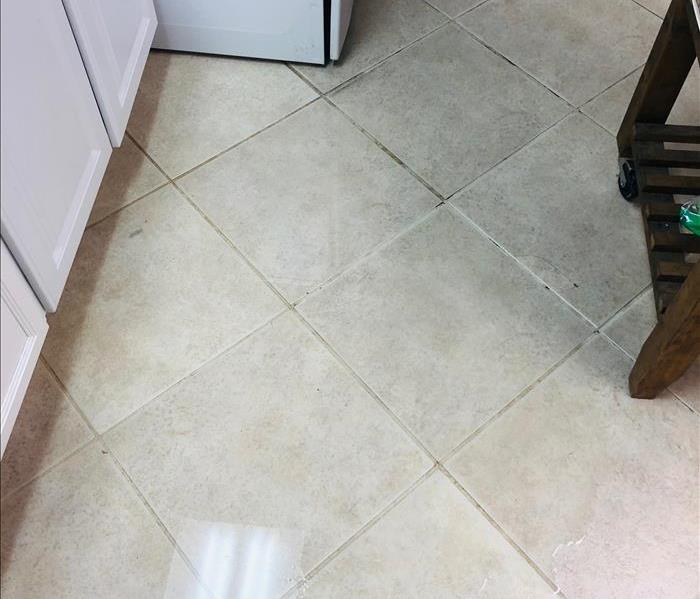 Water seeping into a home from a rainstorm.
Water seeping into a home from a rainstorm.
California renter’s rights protect tenants from expensive repair costs, including water damage.
Southern California experienced torrential rains ... forcing hundreds of residents to evacuate, opening sink holes and causing dangerous mudslides — one of the strongest storms in years for the area.
Most cities have fire departments willing and able to help when flood emergencies arise, especially if the situation is life-threatening. Flooding can cause electrical hazards. "Never turn power on or off yourself or use an electrical tool or appliance while standing in water," warns the National Center for Disease Control website.
Many buildings have an electrical shut-off box outside the unit on a main electrical panel. Find out where the electric shut-off switch is before a disaster.
Another concern is contamination from sewage in standing water. "Discard food that may have been in contact with floodwaters," recommends the Governor's Office of Emergency Services (www.oes.ca.gov).
Once the water flow has been staunched, there probably will be damage to repair.
"Tenants have a right to decent housing, free from habitability or code violations," said Ron Brown, director of the Human Rights and Fair Housing Commission in Sacramento.
Both state and local housing codes require landlords to maintain their property for renters in habitable condition. This covers dwelling needs that include effective waterproofing, weather protection and heating facilities that are in good working order.
Most laws focus on health and safety issues. Basic details can be found through the California Department of Consumer Affairs site at www.dca.ca.gov/legal/landlordbook.
Tenants have a duty under state law to inform the landlord promptly of needed repairs, preferably in writing. Vivid details, such as "water is coming in through my front door through a low spot when it rains," are useful. If possible, take photographs of the problem. Follow up with a friendly phone call.
Although tenants on the scene can stem the tide of damage, repairs should not be undertaken without going through proper channels.
State law allows landlords about 30 days to do most repairs. What if the landlord ignores written notice for flood or other repair work? If a unit is uninhabitable and 30 days have passed, tenants have several options, including making repairs and deducting them from the rent, withholding the rent, suing the landlord and moving.
Under State Civil Code 1941, the repair-and-deduct remedy may be applied only twice in a 12-month period and cannot exceed the monthly rental amount.
What if a tenant thinks the rent should be withheld because the place is uninhabitable? If damage amounts to more than two months' rent, be prepared to provide proof. And be aware that putting a dollar value on the inconvenience of wet carpet and fans running 24 hours to dry it out may be tricky to prove.
If rent is withheld, the situation can get complicated. According to the California Department of Consumer Affairs, "if a landlord brings an eviction action against a tenant for nonpayment of rent, and the unit is found to be uninhabitable, the landlord is liable to the tenant for reasonable attorney's fees and court costs."
Several new laws took effect Jan. 1, 2004. In a supplement to State Civil Code 1941.1, California law prohibits a landlord from collecting or demanding rent on an uninhabitable dwelling. The law also allows tenants to seek damages after inspection by a housing official. A notice of violation has to have been issued to the landlord, and the violation must have remained 60 days after the landlord received notice before a suit can be filed.
Consulting a legal professional is always a good idea before deducting rent or bringing a lawsuit.
To read this article from the Los Angeles Times cllick the link:
Los Angeles Times
Suffering a water loss can be a hectic and stressful time. Emotions run high and often times you don’t even know where to start! The first step should always be to identify the source of incoming water then shutoff or stop the water source if possible. Next make sure to turn off all electrical appliances around the affected area to reduce electrical hazards and turn off the circuit breakers supplying electricity to the wet areas. You will want to remove excess water by mopping or blotting and make sure to never use a regular vacuum to remove water! Keep furniture safe from additional damage by placing aluminum foil or wood blocks between furniture legs and wet carpeting/flooring and make sure to call SERVPRO of West Riverside City at (951)-351-8033 to come assess the damage and get the drying process started immediately. Since we are locally owned and operated, we are able to respond quickly and with the right resources. A fast response lessens the damage, limits further damage, and reduces the restoration cost.
How to Find Your Riverside Home's Main Water Shut Off Valve
3/18/2019 (Permalink)
No one expects pipes to burst, water heaters to break, or toilets and washers to overflow. If this happens, your quick response along with the highly trained specialists from SERVPRO of West Riverside City will limit your damages and potentially save you thousands of dollars! Here are some tips for locating water shut-off valves on your property.
Source: The Spruce…
Finding the Water Shut-Off Valves
Some things in life are worth learning before it's too late—like the locations of your water shut-off valves. If a water pipe springs a leak, knowing where the shut-off valve is could save you thousands in water damage repairs. What's more, you can't make those major plumbing repairs or improvements unless you first turn off the water.
Home water systems contain two types of shut-off valves: main or master shutoff valves for stopping the flow of water to the entire house and individual or supply shut-off valves for specific appliances and fixtures.
Before Anything Else, Try to Cut Off Water Close to Source
If you have a leak at your toilet, sink, clothes washer, or ice maker, shut off water close to the source:
- Toilet: Look under the toilet, against the wall. You will see flexible metal tubing. Turn the handle clockwise until the handle stops. Do not force.
- Sink: Look under the sink cabinet. You will see two sets of flexible metal or plastic tubing. Turn clockwise.
- Clothes Washer: Some houses have the valves clearly exposed above and behind the washer. Turn both valves clockwise. If you do not see these valves, slide the washer outward and you will likely see them.
- Dishwashers: The water supply tube running to the dishwasher often has a fixture shutoff valve controlling it. In many cases, this is also located under the kitchen sink base cabinet, and it may be close proximity to the sink faucet shut-off valves.
- Refrigerator ice makers/water dispensers: The small copper or mesh supply tube running to the refrigerator usually has a small saddle valve or other devices that can be shut off to close down the water supply.
Now for the main water shut-offs to the house…
- Water Main: Locate Shut-Off Valve Within the House
This is the best way to shut off water in your house. It will cut off your home's entire water supply, allowing you to open up any pipe within the house.
Unlike the main water valve, it should be easy to access and not involve special tools or digging. (The only problem is that not everyone has one. In this case, turn off the pump at the electrical box.)
But where would you find yours? Put on your detective's hat for this one. Suggestions:
- Inside/Outside Perimeter: In most cases, it will be near the perimeter of the house—like the outside wall in a utility area where the main water line enters the house, or on an outside wall near the water meter. This valve will always be located on the house side of the water meter and is usually a rather large valve.
- Ground Level: Keep your focus on-grade. If on a ground level floor, you will be looking down.
- Path of Least Resistance: Imagine a straight line extending from your outdoor water meter to the nearest point of your home's exterior perimeter. Water lines will take the shortest path to get to a house. Where that line meets your house is likely where the house's shut-off is located.
- Check Inspection Report: If you still have your property inspection report from when you purchased the house, it should indicate the location of the shut-off valve. Inspection reports often follow a standardized format, so you may find this information located in Section 6.1.
- Access Panels: Look for any kind of access panel. Water cut-off valves are not supposed to be sealed up behind drywall. However, your home's previous owner may have unwisely sealed the valve behind a wall. Most homeowners--and any legitimate contractor--will create an access panel around the valve.
Where It Is Not: It is likely not under a sink. The shut-off to the water heater may look promising, but that only affects the outflow of hot water from that point. Do not confuse the gas shut-off to the furnace or water heater with water lines.
- Water Main: Locate Main Shut-Off Value Outside By Meter
If the previous two options fail, try to shut off the water main outside.
This will cut off all water in the house. This is the most rigorous option and will involve tools, and possibly even tools that you do not have on hand. It is dirty work and may involve digging.
Locate the round, square, or rectangular steel or iron lid. Lift the lid and set the lid to the side. If there is dirt or sand, remove gently with your hand or a garden trowel. Do not discard. If you live in a climate that freezes in the winter, this sand/dirt is required to prevent the pipes from freezing and bursting.
After clearing the box, you will see three things:
- Water Meter: A glass-covered meter that may have a secondary cover to protect the glass. Ignore this as it has nothing to do with shutting off the water.
- Water Company's Shut-Off Valve: This will be on the street side of the water meter. See attached image. This turn-off is designed so that only the water company can turn it off with a special tool. Do not turn this off. Even if you manage to get a Vise-Grip or Crescent wrench on this, you would find it exceedingly difficult to turn.
- Your Shut-Off Valve: This will be on the house side of the water meter. It may have a knob for turning or it may have a nut. There is no standard size for this nut. For example, some are 3/8" and require a ratchet wrench with an extender for access. Turn this clock-wise.
If you need help locating your main water shut-off valves, you can schedule a service call for SERVPRO of West Riverside City to come out and assist you. Call us at 951-351-8033 if you are interested. It would be money well spent to protect your home investment.
Black Mold and your Dog
3/13/2019 (Permalink)
 Ellie, our mascot, appreciates the care we take for all furry friends.
Ellie, our mascot, appreciates the care we take for all furry friends.
The impacts to our furry friends. From our friends at WAG:
When we find black mold in our homes, we are often surprised. For many people, black mold is found as a result of a home renovation or just moving an appliance that has been in place for many years. People can become sick from black mold for years before they understand what has caused them to be so ill. This exposure to black mold can make your dog sick as well. Much like infants and the elderly, dogs tend to be more susceptible to illnesses related to black mold than their adult owners.
Signs and Symptoms
Symptoms common to black mold exposure appear in other conditions as well. It is easy, as happens with humans, to treat symptoms of black mold exposure in your dog as different conditions or illnesses. If your dog has been exposed to black mold, you may see some of the following symptoms:
Excessive licking, especially on your dog's pawsLoss of fur in small areasCoughing Sneezing Discharge from eyes and noseNoisy or labored breathingLethargy and listlessnessLack of appetiteBehavioral changesCare and Treatment
If your dog is affected by black mold, you will need to do two things. The symptoms of black mold exposure will need to be treated by your veterinarian. Your veterinarian may prescribe antibiotics for symptoms such as bacterial infections in the lungs or on your dog’s skin. Your dog may also be prescribed steroids or other drugs depending on how long their exposure was and how sick the dog is. Your doctors may also request you not return the dog to the home until the black mold has been mitigated. Working in your dog's best interest, it might also be recommended you and your animals say out of the home until removal is complete, because treatment will not help if exposure to mold continues.
The second step of caring for your dog who has after black exposure is complete mold removal. Black mold within your home affects humans as well as your dogs. To continue medical treatment for yourself as well as for your dog and improve efficacy, the mold will have to be completely removed from the home. The Environmental Protection Agency, or EPA, recommends hiring a mold remediation team because of their professional training if the mold discovered in your home covers an area greater than ten square feet, if black mold is caused by contaminated water or sewage, or if you have mold within your air duct system. If you are comfortable removing the mold on your own, be sure to clean the hard to reach spots and do your research on do-it-yourself mold removal to reduce the number of spores released into the air and onto your skin during the removal process.
Risk and Prevention
Dogs who are exposed to black mold can have more serious health problems than some owners face when exposed to black mold. The only way to prevent black mold exposure from recurring is to ensure the mold is completely removed. Black mold can cause serious illness in humans as well as for their pets. If you suspect your dog has been exposed to black mold or if your dog is sick for extended periods of time with no diagnosis and no relief, consider taking him to your veterinarian for testing of mold exposure. Some areas of the United States are more susceptible to black mold growth, such as moist, humid climates where weather brings rain, hurricanes, or flooding often. However, even in a dry climate, a leak from faulty refrigerator water line for an extended period of time could cause black mold growth within your home.
Read more at: https://wagwalking.com/wellness/black-mold-and-your-dog
Tips for Keeping Your Pet Safe From Mold
A good rule of thumb is to develop the habit of keeping anything your pet comes in contact with clean and dry:
Keep pet food in a sealed container in a cold, dry area (freezer)Wash food and water bowls at least once a day and throw out plastic dishesLaunder your pet's bedding frequently, and immediately if it becomes dampWash pet toys once a weekWhat Should You Do If You Spot Mold in Your Home?
If the issue is small and contained, you can usually tackle it on your own by washing the surface with a soap and water solution. However, if you face recurring or widespread growth, hire a professional mold remediation team.
If mold is putting your household’s health at risk, the trusted professionals at SERVPRO® of West Riverside City will put your home on the path to wellness. As leading mold remediation and restoration service experts, we know how to tackle mold growth strategically. Equipped with heavy-duty cleaning tools, our crews will not only remove spots, but also implement solutions to control moisture and prevent the problem from returning.
To arrange fast and effective clean-up, call a helpful representative at 951-351-8033 today. We care about your family and that includes your beloved pets.
SERVPRO Cleaning Fire Damage in West Riverside City
3/11/2019 (Permalink)
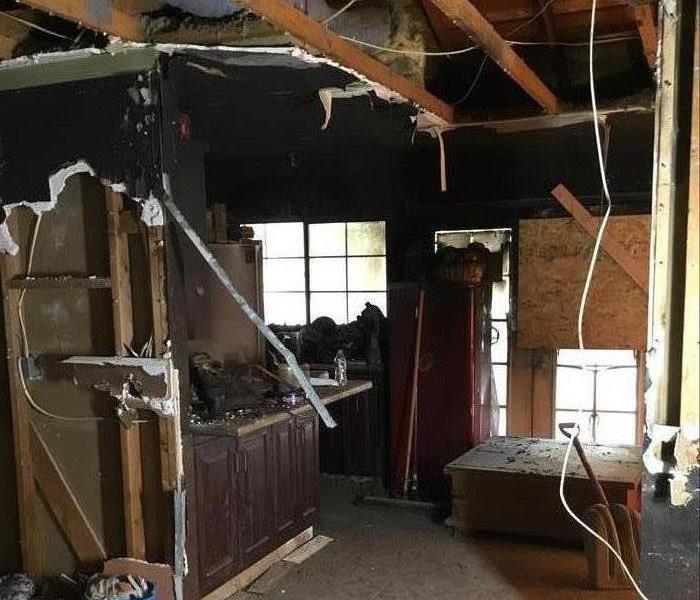 This was the result of a Riverside home fire, SERVPRO provided quality service and care for this customers property.
This was the result of a Riverside home fire, SERVPRO provided quality service and care for this customers property.
SERVPRO Categorizes Fire and Smoke Damage
After a fire, most of the damage to Riverside homes comes from smoke and odor residues that rest on and even penetrate some surfaces like building material and furniture. To fully clean and remove them requires not just experience, but also the right tools.
SERVPRO places fire damage to Riverside homes into three categories: Minor, Medium, and Major. We make this determination for odors and smoke residues depending on how far out they extend from the fire point of origin and how strong the odor or how thick the residue is in each room.
With Minor damage, odors are mild and usually removed with the same cleaning agents we use smoke residues on ceilings, floors, walls, and furniture. The residues themselves are normally light-to-moderate in this category and are limited to only a few rooms. Our technicians can remove all of these with sponges or cloths and hand-spraying a cleaning agent when needed.
Medium damage happens with hotter fires. They produce stronger odors, thicker residues, and spread them throughout more of the home. In this category, a cleaning agent is needed to break up the residues to remove them. Simply cleaning the building material and property does not eliminate all odors in this category, so SERVPRO technicians use an additional deodorizing agent to destroy the odor-causing particles.
To get rid of them, SERVPRO technicians use pressure sprayers and injectors to distribute deodorizing agents. The pressure sprayers are excellent for covering large surfaces such as kitchen walls or living room carpets with either a deodorizer or a cleaning agent. We use the injectors to apply a small amount of deodorizer directly into a small stain in carpets or upholstered furniture.
Major damage occurs close to the fire’s point of origin. Odors are exceptionally strong, and standard deodorizers do not remove all of them. If the fire burned hot enough to cause structural damage, then the smoke residues are exceptionally thick here and spread through the entire home. The level of residue makes removal of building material like drywall cheaper than attempting to clean it. The same may apply to furniture and other personal property due to the extent of the damage or the cost of cleaning.
For heavily covered property, we use an immersion tank to soak and remove the residue in a cleaning agent. We do this only for items not further damaged by soaking. To remove the odors when the usual agents do not work, our technicians bring in an ozone machine. This device generates a gas that oxidizes the odor particles. This gas alters them and removes the odor completely. The drawback to using an ozone machine is we need to evacuate the home of people, pets, and any items made from natural rubber until we finish the procedure.
SERVPRO has the certification and experience to address all levels of fire damage. But what about smoke? Did you know that there are two different types of smoke? Wet and dry.
There are two different types of smoke- wet and dry. As a result, there are different types of soot residue after a fire. Before restoration begins, SERVPRO of West Riverside City will test the soot to determine which type of smoke damage occurred
Smoke and soot is very invasive and can penetrate various cavities within your home, causing hidden damage and odor. Our smoke damage expertise and experience allows us to accurately assess the extent of the damage to develop a comprehensive plan of action.
Wet smoke - Plastic and Rubber
- Low heat, smoldering, pungent odor, sticky, smeary. Smoke webs are more difficult to clean.
Dry Smoke - Paper and Wood
- Fast burning, high temperatures, heat rises therefore smoke rises.
Protein Fire Residue - Produced by evaporation of material rather than from a fire
- Virtually invisible, discolors paints and varnishes, extreme pungent odor.
Our Fire Damage Restoration Services
Since each smoke and fire damage situation is a little different, each one requires a unique solution tailored for the specific conditions. We have the equipment, expertise, and experience to restore your fire and smoke damage. We will also treat your family with empathy and respect and your property with care.
Have questions about Fire, Smoke, or Soot Damage?
Restoring your home after a fire is not a quick process, but SERVPRO of West Riverside City is here with you at each step. If you need our services, call us at (951) 351-8033 today.
There are many companies that you can choose from when it comes to fire restoration in your home. Our crew works to provide the best quality service encompassing the work that we do in your home and our commitment to providing the best in customer consideration. If you experience a fire in your home, trust the team at SERVPRO of West Riverside City to help you get things back to pre-damage condition.
Locally Owned Company with National Resources
Contact SERVPRO of West Riverside City for full-service solutions to emergency situations that may occur on your property, or schedule your home’s initial inspection, today.
Call anytime at (951) 351-8033, were available 24/7 for your emergency needs.
Part II NIOSH Warns of Hazards during Cleanup Work Following Forest Fires
3/7/2019 (Permalink)
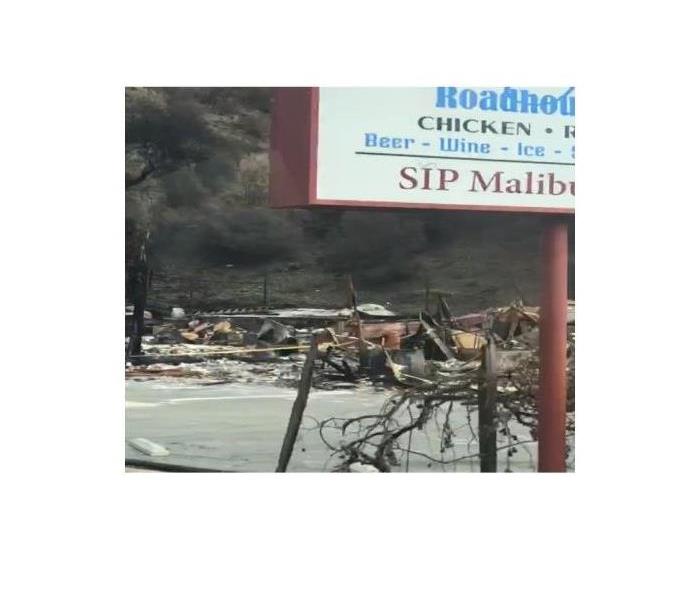 Woolsey fire destroyed many homes and businesses.
Woolsey fire destroyed many homes and businesses.
The National Institute for Occupational Safety and Health (NIOSH) warns workers and volunteers of the potential dangers involved with cleanup operations following the devastation caused by forest fires.
Because the level of experience varies among these workers, cleanup crews must work together and look out for one another to ensure safety.
NIOSH urgently requests your assistance in disseminating the following warnings to all those involved in cleanup work following forest fires. The potential work-related hazards listed here are described below in greater detail: Confined Spaces, Power Line Hazards, Agricultural Hazards, Stress and Fatigue. Additional key resources on health and safety hazards related to fire fighting can be found on the NIOSH web site under the “spotlights” section titled “Fighting Wildfires” (http://www.cdc.gov/niosh/topics/firefighting/).
PREVENTION MEASURES
First Aid
First aid, even for minor cuts and burns, is extremely important. Immediately clean out all open wounds and cuts with soap and clean water. Most cuts, except minor scratches, sustained during cleanup activities will warrant treatment to prevent tetanus. If you are injured, contact a physician to determine the necessary type of treatment.
Protective Equipment
For most clean-up work activities, you will need the following personal protective equipment: hard hats, safety goggles, heavy work gloves, and watertight boots with steel toe and insole (not just steel shank). For information on what equipment you need for protection, contact your local OSHA office or NIOSH.
Excessive noise from equipment such as chain saws, backhoes, tractors, pavement breakers, blowers, and from heavy equipment (e.g., earth moving equipment, helicopters) may cause ringing in the ears and subsequent hearing damage. If working with any noise that you must shout over to be heard, you should wear earplugs or other hearing protection devices.
Working in Confined Spaces
If you are required to work in a boiler, furnace, pipeline, pit, pumping station, septic tank, sewage digester, storage tank, utility vault, well, silo, or similar enclosed structures, you should be aware of the hazards of working in confined spaces. A confined space has one or more of the following characteristics:
- limited openings for entry or exit;
- unfavorable natural ventilation; or
- is not designed for continuous worker occupancy.
Toxic gases, a lack of oxygen, or explosive conditions may exist in the confined area, resulting in a potentially deadly atmosphere. Because many toxic gases and vapors cannot be seen or smelled, never trust your senses to determine if safe entry is possible. Never enter a confined space unless you have been properly trained, even to rescue a fellow worker! If you need to enter a confined space and do not have the proper training and equipment, contact your local fire department for assistance.
Working On or Near Power Lines [Recommendations for Utility Workers ONLY]
Several workers have died of electrocution following natural disasters. Workers and employers must take extreme caution while attempting to restore power or clear areas near downed power lines. In one instance, a worker lost his life while removing trees from a de-energized power line that had been knocked down by a storm. While inspecting the completed work, the man stepped on the line and was electrocuted by "feedback" energy from a portable backup generator at a nearby gas station. Feedback energy occurs when a de-energized line becomes energized by a secondary power source.
Another worker died cleaning branches from a power line, following a storm. He was electrocuted after falling from a tree onto a line thought to be de-energized. Although the workers had opened a fused switch on a transformer, the line remained energized through another transformer.
If you are working on or near power lines, the following steps may save your life:
- Treat all power lines as energized until you have followed the required procedures for personally de-energizing and testing them with an appropriate testing device. Do not rely on "fuzzing" to determine if a power line has been de-energized.
- Verifying that a line is not energized may not ensure your safety. You must also ground lines on both the load and supply sides of the work area. Grounding is necessary to protect you from the hazards of feedback electrical energy from a secondary power source, such as a portable generator.
- When restoring power in underground vaults, added precautions are necessary to avoid explosion hazards. As vaults containing electrical connections are drained or pumped out, and energized, potentially explosive gases may form. If you are required to work in a utility vault, refer to the Confined Spaces section of this Fact Sheet.
RESPIRATORY HAZARDS
If you are involved in cleanup efforts you may be exposed to ash, soot and fire decomposition products that may cause irritation and other respiratory effects. Spoiled and/or wet vegetation and other organic/agricultural materials often grow large amounts of bacteria and mold during warm weather. Breathing these organisms and the organic dust produced may cause lung disease. Use proper engineering controls to exhaust and replenish adequate fresh air if working indoors. A high efficiency particulate air (HEPA)-type vacuum is recommended when cleaning surfaces contaminated with dust. The use of a typical household vacuum should be avoided since it will re-suspend the collected dust into the air. When exposure to dusts cannot be controlled or avoided, exposure can be reduced by routine use of a well-fitted NIOSH-certified air-purifying respirator (such as an N-95 or more protective respirator).
STRESS, LONG HOURS, AND FATIGUE MAY INCREASE THE RISKS FOR INJURY AND ILLNESS
Continued long hours of work, combined with emotional and physical exhaustion and losses from damaged homes and temporary job layoffs, can create a highly stressful situation for cleanup workers. Workers exposed to these stressful conditions have an increased risk of injury and emotional crisis, and are more vulnerable to stress-induced illnesses and disease. Emotional support from family members, neighbors, and local mental health professionals can help to prevent more serious stress-related problems in the difficult months ahead. People working in all phases of cleanup work can reduce their risks of injury and illness in several ways:
- Set priorities for cleanup tasks and pace the work over several days (or weeks). Avoid physical exhaustion.
- Resume a normal sleep schedule as quickly as possible. Get plenty of rest and take frequent rest breaks BEFORE exhaustion builds up.
- Take advantage of disaster relief programs and services in your community.
- Be alert to emotional exhaustion or strain. When family members and neighbors are unavailable for emotional support, consult professionals at community health and mental health centers.
For more information about these or other occupational safety and health topics contact NIOSH at:
1-800-35-NIOSH (1-800-356-4674)
Fax: 513: 533-8573
E-mail: pubstaft@cdc.gov
www.cdc.gov/niosh
California Water Damage and Renter’s Rights
3/7/2019 (Permalink)
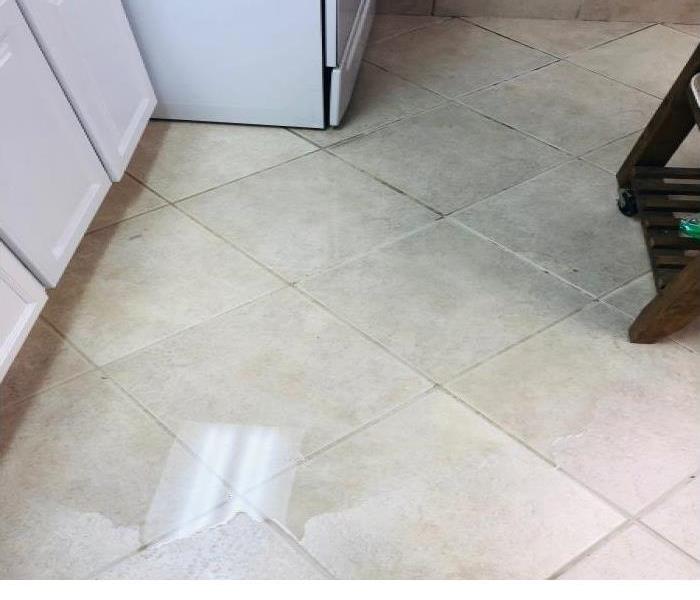 Water seeping into a home from a rainstorm.
Water seeping into a home from a rainstorm.
California renter’s rights protect tenants from expensive repair costs, including water damage.
Southern California experienced torrential rains ... forcing hundreds of residents to evacuate, opening sink holes and causing dangerous mudslides — one of the strongest storms in years for the area.
Most cities have fire departments willing and able to help when flood emergencies arise, especially if the situation is life-threatening. Flooding can cause electrical hazards. "Never turn power on or off yourself or use an electrical tool or appliance while standing in water," warns the National Center for Disease Control website.
Many buildings have an electrical shut-off box outside the unit on a main electrical panel. Find out where the electric shut-off switch is before a disaster.
Another concern is contamination from sewage in standing water. "Discard food that may have been in contact with floodwaters," recommends the Governor's Office of Emergency Services (www.oes.ca.gov).
Once the water flow has been staunched, there probably will be damage to repair.
"Tenants have a right to decent housing, free from habitability or code violations," said Ron Brown, director of the Human Rights and Fair Housing Commission in Sacramento.
Both state and local housing codes require landlords to maintain their property for renters in habitable condition. This covers dwelling needs that include effective waterproofing, weather protection and heating facilities that are in good working order.
Most laws focus on health and safety issues. Basic details can be found through the California Department of Consumer Affairs site at www.dca.ca.gov/legal/landlordbook.
Tenants have a duty under state law to inform the landlord promptly of needed repairs, preferably in writing. Vivid details, such as "water is coming in through my front door through a low spot when it rains," are useful. If possible, take photographs of the problem. Follow up with a friendly phone call.
Although tenants on the scene can stem the tide of damage, repairs should not be undertaken without going through proper channels.
State law allows landlords about 30 days to do most repairs. What if the landlord ignores written notice for flood or other repair work? If a unit is uninhabitable and 30 days have passed, tenants have several options, including making repairs and deducting them from the rent, withholding the rent, suing the landlord and moving.
Under State Civil Code 1941, the repair-and-deduct remedy may be applied only twice in a 12-month period and cannot exceed the monthly rental amount.
What if a tenant thinks the rent should be withheld because the place is uninhabitable? If damage amounts to more than two months' rent, be prepared to provide proof. And be aware that putting a dollar value on the inconvenience of wet carpet and fans running 24 hours to dry it out may be tricky to prove.
If rent is withheld, the situation can get complicated. According to the California Department of Consumer Affairs, "if a landlord brings an eviction action against a tenant for nonpayment of rent, and the unit is found to be uninhabitable, the landlord is liable to the tenant for reasonable attorney's fees and court costs."
Several new laws took effect Jan. 1, 2004. In a supplement to State Civil Code 1941.1, California law prohibits a landlord from collecting or demanding rent on an uninhabitable dwelling. The law also allows tenants to seek damages after inspection by a housing official. A notice of violation has to have been issued to the landlord, and the violation must have remained 60 days after the landlord received notice before a suit can be filed.
Consulting a legal professional is always a good idea before deducting rent or bringing a lawsuit.
To read this article from the Los Angeles Times cllick the link:
Los Angeles Times
Suffering a water loss can be a hectic and stressful time. Emotions run high and often times you don’t even know where to start! The first step should always be to identify the source of incoming water then shutoff or stop the water source if possible. Next make sure to turn off all electrical appliances around the affected area to reduce electrical hazards and turn off the circuit breakers supplying electricity to the wet areas. You will want to remove excess water by mopping or blotting and make sure to never use a regular vacuum to remove water! Keep furniture safe from additional damage by placing aluminum foil or wood blocks between furniture legs and wet carpeting/flooring and make sure to call SERVPRO of West Riverside City at (951)-351-8033 to come assess the damage and get the drying process started immediately. Since we are locally owned and operated, we are able to respond quickly and with the right resources. A fast response lessens the damage, limits further damage, and reduces the restoration cost.
5 Common Questions Regarding Home Restoration Insurance Claims
3/6/2019 (Permalink)
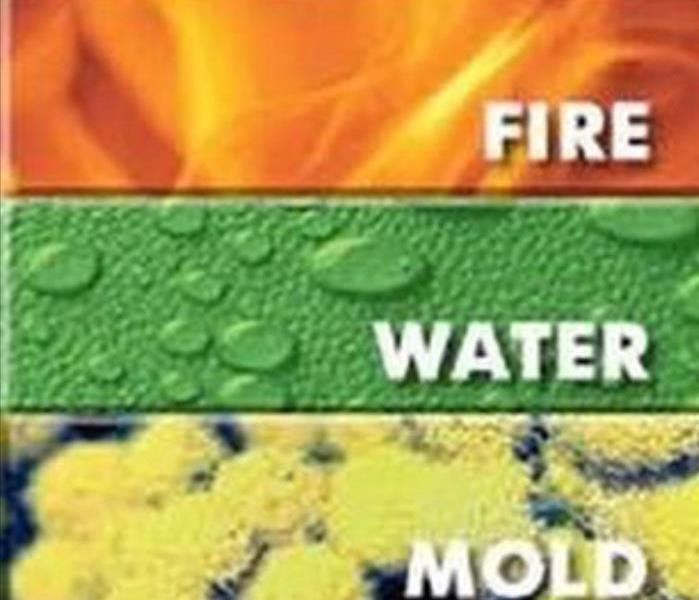 Fire, Water, Mold? Call SERVPRO of West Riverside City
Fire, Water, Mold? Call SERVPRO of West Riverside City
Whether your home is damaged by a flood or a fire, getting things back to the way they were can take time—and money.
However, when you have the support of your home insurance policy and a trusted restoration company, you can save yourself from the heavy stress and high expenses that are associated with water and fire damage repairs. Since navigating restoration insurance claims can be complex, SERVPRO of West Riverside City answers a few common questions homeowners have about the process.
5 FAQs About Using Home Insurance for Water & Fire Damage Repairs
Will Water & Fire Damage Repairs Be Covered By My Policy?
Technically, most home insurance providers cover restoration work related to fire and water damage. However, this damage typically has to be connected to an event that is covered by your policy—also known as a “peril.” For instance, plumbing emergencies and electrical fires may be acceptable perils, but floods may require additional coverage.
Will Putting Off Repairs Affect My Insurance Policy?
In some cases, fire and water damage may seem minor enough to put off repairs. But, if more damage occurs as a result of negligence, your insurance company may not cover those future claims. By staying proactive and making repairs as soon as possible, you can protect yourself against denied claims down the road.
Should I Call My Insurance Company Before the Restoration Company?
When you have a water and fire damage repair company in mind, it is often best to call them before reaching out to your insurance provider. These professionals will fully document the damage, making it easier to file an accurate claim. They will also provide the proactive care to keep your home safe, as well as prevent further damage.
Can I Choose My Own Restoration Provider?
If you do call your insurance provider first, they may recommend a company for your home repairs. While it’s perfectly acceptable to use these references, it is not required. In fact, it is your right as a policyholder to choose who repairs your property.
When Should I Pay Out-of-Pocket?
If your insurance deductible is higher than the cost of the repairs, it is generally best to pay out-of-pocket. In these instances, you would have been required to pay the whole price anyway without any coverage from your provider. However, many water and fire restoration jobs will exceed the cost of the deductible.
In a perfect world, homeowners would always be able to avoid these situations—but accidents still happen. Fortunately, it’s easy to stay prepared when you have SERVPRO of West Riverside City at your side. Providing everything from mold remediation to fire damage repairs, this restoration company will ensure you receive fast, expert care. Visit them online to learn more about their services or call (951) 351-8033 to request 24/7 emergency assistance.
Why Choose SERVPRO?
SERVPRO of West Riverside City recognizes the necessity for prompt and accurate response and offer 1-4-8 Response Guidelines to help minimize additional, secondary or permanent damage and contamination. In addition, SERVPRO of West Riverside City is available for emergency response 24 hours a day, 365 days a year.Knowledge and training are key elements in effective water removal and moisture damage. SERVPRO of West Riverside City applies their industry knowledge, training and understanding of how relative humidity, temperature, vapor pressure and air movement influence drying conditions.Powerful and professional equipment is essential for proper mitigation and efficient restoration of water damaged areas. SERVPRO of West Riverside City is outfitted with state-of-the-art industrial grade equipment and products to measure the extent of moisture saturation and offer proper drying, deodorizing and disinfecting of water damaged areas.SERVPRO of West Riverside City offers content restoration to restore water damaged contents and personal belongings. Often when water damage occurs, personal possessions are also damaged by water or moisture. SERVPRO Technicians work diligently to try and return personal contents to preloss conditions.SERVPRO of West Riverside City works with insurance, real estate, contracting and property management companies to offer complete file management, estimates and detailed explanations of work, including status updates, changes and feedback to keep companies fully aware of a property’s drying, cleaning and restoration status. SERVPRO of West Riverside City we know you want quality information and proof of results. SERVPRO technology is designed to support your efforts!Timely mitigation is key to the restoration process. Restoring property is the SERVPRO Professional’s first priority. You will appreciate the immediate response, and you will know everything possible is being done to limit the damage. Even if a loss is below the deductible amount, fast action helps assure the event will stay small!Call SERVPRO of West Riverside City, we are here to help you with your needs, visit our website for a description of our services.
How to Select A Carpet Cleaning Company in Riverside
3/4/2019 (Permalink)
 Call SERVPRO for you carpet cleaning needs.
Call SERVPRO for you carpet cleaning needs.
The following information comes from an article listed on IICRC.org, the Institute of Inspection, Cleaning, and Restoration Certification. This information is helpful when deciding which company should handle your carpet cleaning needs.
“Cleaning Carpet Can Be a Dirty Business” “Not All Scum Is In the Carpet” “Don’t Let them Pull The Rug Out From Under You” “Clean Your Carpets Without Cleaning Out Your Wallet” “Don’t Get Taken To The Cleaners.” These clever phrases have appeared recently in newspaper articles and televised news programs across the nation warning consumers about carpet cleaning scam operations. The media has related horror stories of trusting consumers who have responded to low-price carpet cleaning specials only to become victims of unethical cleaners who refuse to honor the advertised price, intimidate the consumers and do poor quality work.
Bait-and-switch operators are prevalent in many industries, and the carpet cleaning industry is no exception. This does not mean that all carpet cleaners are rip-off artists. How do you know who is and who is not? The professional carpet cleaning industry has cited these scam activities as a major industry concern and is taking action to help eliminate unprofessional workmanship and unethical tactics. One of the leaders in this campaign is the IICRC, an international, non-profit organization that certifies cleaners who meet prescribed levels of technical proficiency and pledge to operate by a Code of Ethics.
To help educate consumers so they will not become victims of fraudulent practices within the cleaning industry, the IICRC has released a list of guidelines to consider when selecting a carpet cleaner.
- Price – If an advertised price sounds too good to be true – it is! Often carpet cleaners advertise a low price just to get their foot in the door. Use common sense; a low price usually equates to low quality for any product or service. Legitimate business people have expenses they must cover, including license, taxes, insurance, employee wages, and benefits, and quality tools of the trade. A professional carpet cleaner who must cover all of these business expenses and make a profit to stay in the business cannot afford to drive to your house for $5.95, much less clean a room of carpet when there.
- Quality – Never should the price of cleaning services be the sole criterion for selecting a carpet cleaner. A price that sounds high may not be a signal of a rip-off. In all professions, quality work deserves a quality price.
- Truth in Advertising – Read the fine print in advertised specials to find out exactly what the price includes, and request a firm price in writing before the work begins.
- Training – Professional cleaning firms require management and employees to engage in formal training in a variety of cleaning disciplines, and these educational efforts will be ongoing. Consumers should ask about the formal training background of technicians who will be cleaning their carpet.
- Certification – Professional firms require technicians who have certification from organizations like the IICRC or through comparable franchise or independent training and testing organizations.
- Experience – The years of experience a firm has, combined with formal training programs, contribute significantly to the experience and proficiency of its employees.
- Knowledgeable – Professional firms employ and train technicians who have the ability to answer basic questions regarding carpet performance and maintenance, as well as spotting and cleaning.
- References – Consumers should ask for references from previous customers, and they should consult friends and business acquaintances about the reputation of the cleaning firm they are considering. Do not hesitate to call the Chamber of Commerce and the Better Business Bureau.
- Trade Associations – Professional cleaning firms are members of regional or national trade associations or other organizations that promote high ethical standards and continuing education. Look for trade association logos in advertising.
- Credibility – Community involvement through the Chamber of Commerce and/or professional business, charitable or similar organizations will be undertaken by concerned, caring professionals. Look for logos indicating involvement in these organizations.
- Method – Ask the cleaner which method of cleaning will be used and the advantages and disadvantages of this method compared to other methods.
- Proof – Never hesitate to ask for proof. Ask to see the cleaner’s certification card, business license and insurance certificate.
- No Pressure – Technicians must be courteous and willing to take the time to thoroughly explain the cleaning and to answer all questions. The consumer should never feel pressured.
There is no single criterion for selecting a carpet cleaning service. Several combined factors must be considered in the selection decision.
Choose a trusted Service such as SERVPRO of West Riverside City, we also handle Upholstery Cleaning.
We will get the job done right. For a cleaning backed by state-of-the-art equipment, over 40 years of experience and Professionals trained to the highest standards.
Call us for your carpet cleaning or upholstery cleaning needs 951-351-8033!
What Happens to Electronics After a Commercial Fire?
2/27/2019 (Permalink)
The modern business world depends on electronic equipment.
Whether you have a law firm, factory, clothing store or another type of business in Riverside, CA, there is a good chance you have invested in electronic devices. As you may suspect, an electrical fire can damage your company’s digital equipment. Fortunately, if the fire does not ruin your IT equipment, you may be able to salvage it.
Fires Often Cause Extreme Damage
Fires can be unbelievably destructive. Whether your company’s fire was large or small, you may have damage to the following areas:
StructuresInventoryEquipmentElectronic devicesHVAC systemsRecovering from any fire can be stressful. While it is tempting to focus on rebuilding structures and mitigating smoke damage, you must also think about continuing business. If your company uses electronic devices to meet the needs of customers, you need a strategy for computer cleanup.
Computers Are Often Salvageable
When cleaning a computer after an electrical fire, you must be careful to disconnect the unit from its power supply. You must also try not to damage the inner workings of the machine. Still, you should not assume your company’s digital equipment is a complete loss after a fire. Before beginning cleanup or restoration, document damage for insurance purposes.
Cleanup Professionals Understand Electronic Devices
Most electronic devices are complex. Not only does digital equipment have circuit boards and wiring, it often has plastic casings. As such, you can’t merely paint over fire damage. Instead, you must work with a reputable fire-restoration service to salvage electronic equipment. Professional technicians have the experience, skill and equipment to clean electronic devices and recommend repairs. Restorers also have the expertise to recognize when a fire has destroyed digital devices.
Fire and smoke restoration experts who specialize in electrical fire and ensuring that electronic devices are safe to operate follow three general steps.
1. Inspect electronics for evidence of overheating. Heat from a fire can cause devices to overheat, but a black film of smoke and soot can also over-insulate parts that produce heat. The magnetic charge of acidic smoke can short circuits and cause overheating.
2. Wipe down surfaces and check interiors for damage. Electronics restoration experts may need to take devices to a clean and safe location to restore internal components.
3. Recover important information. If a device is damaged beyond repair, experts will focus on recovering data from it.
The extent of damage to electronics depends on the degree to which delicate circuitry or wiring was exposed to heat, smoke, and soot as well as other contaminants like water used to put out a fire. Rather than risking an electrical fire by attempting to turn on or repair electronic devices yourself, you are better off relying on an experienced restoration company in Riverside, CA with electronics and computer cleanup experts on staff. These specialists may be able to save you a lot of stress and money by restoring electronics or recovering important data.
No business owner wants to have to deal with a commercial fire. If your company has sustained damage during an electrical fire, you may not have to order new electronic equipment, however. With the right team, you may be able to save your company’s computer systems.
The Difference Between Flood Claims and Water Damage Claims in Riverside
2/20/2019 (Permalink)
After experiencing water damage, you may be left wondering what your options are.
In most cases, you should make sure that you fix all water damage as quickly as possible. Once you have done this, you can then proceed to file for claims. Fixing your home immediately can prevent problems from getting worse due to mold or decomposition. However, afterward you will still need to deal with the consequences of the bills. For some homeowners, it may be possible for insurance to cover some of the losses. However, many homeowners insurance policies do not always come packaged with flood insurance. To provide assistance, this will take a look at the differences between flood insurance and water damage claims.
Water Damage Claims
After experiencing water damage, your first impulse was probably to call your insurance company. Hopefully, you haven’t done this yet. There is a big difference between water damage and flood insurance. Water damage can be caused by storms, accidents, or bursting pipes. These claims are only valid when water damage is associated with water that did not first touch the ground (such as lakes, ponds, & rivers). This means that water coming from a regular thunderstorm, plumbing, or appliance is usually covered under water damage claims. In contrast, a flooded lake or stream that inundates a person’s home is not covered.
Flood Insurance
It is important to keep in mind that flood insurance is a special form of insurance contract. It does not automatically come with a standard homeowners insurance policy. In almost all cases, individuals have to purchase flood insurance separately from homeowners insurance. Since many homeowners are not aware of this, homeowners are often outraged when they discover that their insurance contract does not cover flood damage. Flood insurance is generally available for just a few dollars each month. Without this insurance, homeowners cannot expect to have any damage associated with flooding covered under their homeowners insurance policy.
Implications of Denied Coverage
If an insurance company declines your application to cover water damage, it could still have a big impact on your monthly insurance rates. Insurance companies can take advantage of information in your claims application to increase your monthly insurance bills. It is not uncommon to see insurance companies viewing homes that have experienced flood damage as high risk. As a result, they have the right to appropriately increase your monthly rates according to this information.
The reality that your insurance rates could increase after being denied coverage makes it even more important to understand the difference between flood damage and water damage claims. Many individual homeowners make the mistake of filing claims for costs associated with flood damage, only to find that these costs are not covered. When the bill comes the next month, there is nothing that homeowners can do to bring their rates back down. Therefore, it is important to only file a claim if flood damage is explicitly covered in the homeowners insurance contract. In some cases, it may even be recommended for homeowners to work with an attorney to ensure that it is appropriate to file a water damage claim.
If you have questions about your coverage, we strongly advise you to contact your insurance agent and review your policy. What incidents and perils are you covered for? What are your deductibles? At SERVPRO of West Riverside City we are here to help you in any we can.
Handling Smoke Damage after a Fire in Your Riverside Home
2/18/2019 (Permalink)
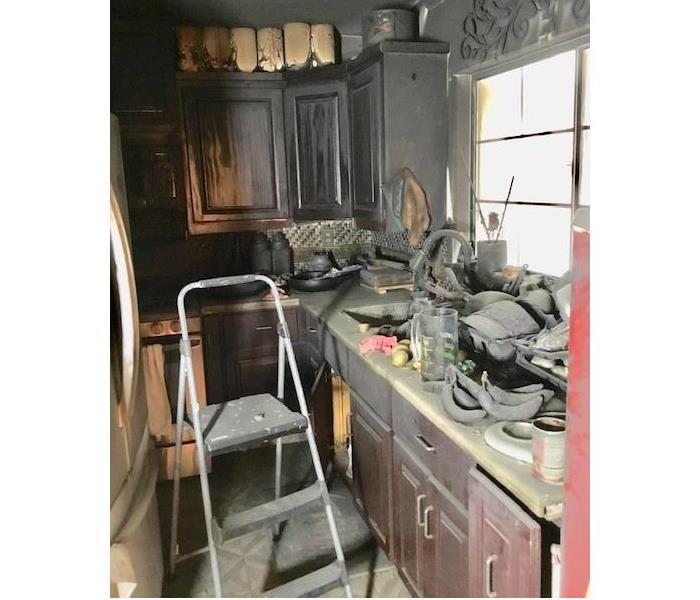 Smoke and Soot damage from a house fire in Riverside City
Smoke and Soot damage from a house fire in Riverside City
The smoke that lingers after a fire has been put out can be more damaging than you might think.
The problem that many homeowners have is that they don’t think a fire or smoke damage could ever happen to them. The reality is that home fires are incredibly common, ranging from the very minor to the more major. Despite the fact that a minor fire may not cause a lot of fire damage, it can still cause smoke damage that is difficult to clean and dangerous to be living around.
Smoke Damage that is a direct result of fire damage should ideally be cleaned by experts. Experts know how to get rid of smoke damage that might be present in the home after it has been ravished by flames. You should always look to hire a licensed and highly experienced professional who has extensive experience dealing with fire damage. The professionals will often start by evaluating the overall extent of the damage that is present in the home, and then they will go over prices and costs of damage remediation for you to get the issue cleaned up by their company.
There are a lot of reasons why handling smoke damage after a fire should be done by experts and as quickly as possible. The smoke that you find after a fire often contains ash, soot and sometimes even carbons and tar that might have come off of the flames. Also, carbon monoxide is incredibly common after fire damage has been exhibited. Carbon monoxide is one of the most dangerous things because it is odorless and cannot be seen or tasted. Therefore, you may not even know that you are surrounded by carbon monoxide until it has been properly tested. An expert damage restoration company will normally test for carbon monoxide levels in a home that has dealt with a fire.
Smoke damage can also be aesthetically damaging. Furniture, walls, ceilings and practically anything in your home can become black or gray from the smoke that has come off from a fire. Many things will need to be professionally cleaned, while other things might have to be fully removed from the home in order to get rid of the problem. Your remediation company will be the one who tells you what can and cannot be saved after you have dealt with massive smoke damage in your own home.
Fires are very common, and even the most minor fire can cause a lot of smoke damage. In fact, some homeowners who have simple fireplaces that are not well-vented could deal with smoke damage without a fire ever being an issue for the home itself. Handling the damage on your own should be avoided simply because of all of the expertise that needs to go into cleaning the mess. Also, you need to have a professional test the home or room for carbon monoxide to ensure that it is going to be safe for you or for them to go in there to clean. For more information please visit SERVPRO of West Riverside City
Our Fire Damage Restoration Services
Every fire damage situation is a little different and requires a unique solution, but the general process stays the same. When various materials burn, the soot they create differs greatly and requires a specific cleaning procedure. The steps listed below illustrate our process for the “typical” fire damage restoration. Learn more about our fire damage restoration process.
Emergency ContactInspection and Fire Damage AssessmentImmediate Board-Up and Roof Tarp Service (if needed)Water Removal and Drying (if water damage is present)Removal of Smoke and Soot from All SurfacesCleaning and RepairRestorationFeel free to call us, we are here to help!
Call Us Today – (951) 351-8033
Preparing for Santa Ana Wind storms in Riverside
2/13/2019 (Permalink)
Santa Ana winds can occur at any time!
The Santa Ana winds are strong, extremely dry downslope winds that originate inland and affect coastal Southern California and northern Baja California. They originate from cool, dry high-pressure air masses in the Great Basin.
Santa Ana winds are known for the hot, dry weather that they bring in autumn (often the hottest of the year), but they can also arise at other times of the year. They often bring the lowest relative humidities of the year to coastal Southern California. These low humidities, combined with the warm, compressionally-heated air mass, plus high wind speeds, create critical fire weather conditions.
If you live in a place prone to windstorms or you know one is coming, then pay close attention to what it takes to prepare. If you currently have a damaged roof or any sign of a roof leak, then your home may not be sound enough to withstand a windstorm. You need to take proper precautions. This may mean repairing any weak areas or covering them so they do not get worse. Here is a list of what you should look out for:
• Broken skylights
• Cracked windows
• Damaged siding
• Missing shingles
Wind Damage
A windstorm may cause a variety of problems to your business or home. On one hand, it may blow off shingles, throw debris at your home or lead to damaged siding. You need to be prepared for just about anything. Not only can the wind cause damage, but the debris the wind brings with it can also. Hard objects can knock shingles off, and large trees may break through your roofing entirely. All of this can lead to a roof leak and further damage.
Cleanup Process
Once the wind has done its damage, it’s time to pick up the pieces. For any damage done to the roof, tarps can be used to cover gaps created by the missing shingles. These tarps will help keep rain from entering your business while you work on restoration. You want to make sure that you do not have any further water damage. Additionally, you can use plywood to cover the holes on the roof. While repairing the building is one thing, you also want to make sure no other issues arise.
A windstorm can cause costly, extensive damage to your Riverside home or business. The best course of action is to reduce the risk wind can cause. Whether you have a roof leak or something more dangerous, don’t let any problems sit until they get worse. In some cases, a professional service may be helpful.
When Is Wind Damage Covered By Homeowners Insurance?
Windstorms are among the perils generally covered by homeowners insurance. Some homeowners policies exclude coverage for wind damage, though. It's a good idea to read your policy to learn whether it includes coverage for wind damage.
If your homeowners insurance policy includes coverage for windstorms, two types of protection may help you after a windstorm damages your home:
- Dwelling coverage, which helps protect a home's structure, may help pay for repairs if wind damages your home's roof, siding or windows, for example.
- Personal property coverage may help pay to replace the contents of your home if they are damaged by wind -- or by rain, snow, sleet, sand or dust that the wind drives inside after damaging your home's structure.
If your home has sustained damage due to a windstorm, call your neighborhood SERVPRO of West Riverside City. Whether a tree has fallen on your home or you see signs of leak due to damage to your roof from winds, we are here to help!
Important Tips for Choosing a Biohazard Cleanup Service in Riverside City
2/11/2019 (Permalink)
Always Choose a Trained Professional
Because it’s traumatic: No one should have to deal with the personal impact of cleaning up after the traumatic loss of a loved one. A professional SERVPRO can get a situation cleaned up quickly, compassionately and discreetly.Because it’s safer: Federal regulations classify all human and animal remains, including blood, urine, feces, vomit and bodily fluids, as bio hazards. This is because they have the potential of carrying life-threatening pathogens such as Hepatitis B and C, AIDS, HIV, MRSA, Tuberculosis and many more. The safe cleanup and removal of bio hazardous materials involves extensive analysis and detailed work, and the use of state-of-the-art cleaning and odor removal technologies.Licensed Bonded & Insured
It is important to use licensed professionals because they conduct safe cleanup, removal and disposal of bio hazardous waste. Additional considerations include being registered and compliant with OSHA and FEMA, federal agencies that oversee disasters and workplace safety. Cleanup crews will be coming into your home or the home of your loved one, so be sure the professional you choose is bonded and insured.Will Work with Insurance Companies
In most cases, insurance will cover much or all of the cost of traumatic even cleanup. You can minimize or eliminate your out-of-pocket expenses by working with licensed and bonded professionals such as SERVPRO of West Riverside City who will deal directly with insurance companies, saving you one more headache in this already difficult process.Frequently Asked Questions (FAQ)
Q. Can I just use my regular cleaning or janitorial service for bio hazard cleanup of blood or bodily fluids?
A: Not unless your regular cleaning or janitorial service has been properly trained and equipped to handle bio hazard cleanup and waste such as blood or bodily fluids, and has a legal place to dispose of the recovered bio hazardous waste.
Q: Who pays for bio-recovery services?
A: In many cases home, business or auto insurance will pay for bio-recovery services. Ultimately the property owner may be responsible for cost of the service.
Q: Can I have an employee of my business clean the scene?
A: Federal Regulation 29cfr1910.1030 states that no employee can be placed in a position to be exposed to bio hazard cleanup of blood spills without first:
Receiving Blood Borne Pathogen (BBP) training.Having a written BBP exposure control plan.Having been provided personal protective equipment.Having been offered Hepatitis B vaccine and exposure evaluation and follow-up.Being provided with a method to remove and properly store the bio-hazardous waste in properly marked containers for disposal at an approved site.For more information please visit:
Biohazard Cleanup & Restoration by SERVPROBiohazard Emergency Tips - Until Help ArrivesCenters for Disease Control & Prevention BiosafetyEnvironmental Protection Agency (EPA) Hazardous Waste Laws & Regulations InformationDo you have a Bio-hazardous situation?
How do you know when you have a bio hazard on your hands? The first thing you need to know is the definition of a bio hazard. Bio hazards are infectious agents or hazardous materials that create a risk for the health of humans or animals. Often this is associated with the possibility of material being considered infectious to anyone in the environment. Now that we know the definition, we must now look at what types of situations can cause infections.
Different Types of Bio hazards
Death - When an individual dies, their body shuts down losing the ability to contain its fluids and wastes. All of these fluids would be considered bio hazard waste, since the fluids might have bacteria or viruses that are still alive. Hence the precautions that are taken when dealing with those situations. Without the proper protections the risk of infection is greatly increased.
Sewage Backups - Sewage backups and dark water intrusions are more than nasty, smelly deposits – these damages also introduce harmful microorganisms into a structure. SERVPRO Franchise Professionals remove the sewage, contaminants, and moisture, and help ensure the structure is properly cleaned, disinfected, and deodorized.
Hoarding - Bio hazards are arguably the most dangerous threat to homeowners and their pets. It is no secret that many hoarding cases are plagued with bio hazards. Bio hazards, or pathogens, are any harmful agents that pose an immediate risk to human beings, animals, or the environment. Bio hazards usually rear themselves in the form of toxic or infectious diseases or agents.
Health - Health bio hazard cleanup is needed when these agents are presented in two major forms within a hoarded home: Airborne and blood borne.
Airborne bio hazards are any pathogens (bacterial, viral, or allergenic) that can be absorbed through the lungs or enter the body in other ways like the ears, nose, throat, and eyes.Blood borne bio hazards are commonly more deadly and quicker to infect a person or pet. Able to enter the blood stream in many similar ways as an airborne pathogen, blood borne bio hazards can also infect someone through open cuts, sores, and any major orifice.Bio hazard Cleanup Services
Here are a few of the benefits we provide during each bio hazard cleanup:
Our services are provided to you with compassion, respect and integrity. We are committed to provide you immediate professional services.We are a preferred vendor for the top insurance companies; this shows we have met their strict criteria to be ethical in conduct, performance and in billing.We remove and decontaminate most all biological hazards. All items deemed unsafe will be cleaned or removed and disposed of properly.We are a Certified Professional Mold Remediation Contractor; meeting the guidelines IICRC S520 Standard and Reference Guide for Professional Mold Remediation.You can rest assured that we follow all state and federal guidelines and regulations in the transportation, incineration, or disposal of all bio-hazardous materials.You can also visit SERVPRO® Biohazard Cleanup to learn more about some of the other bio-hazardous cleaning services we offer.
Plumbing Tips for Commercial Properties in Riverside City
2/6/2019 (Permalink)
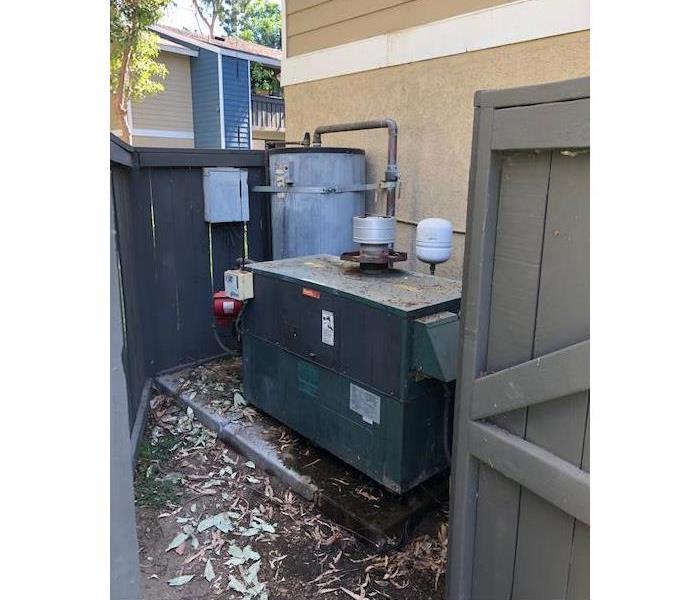 Gated Boiler for a Riverside commercial building.
Gated Boiler for a Riverside commercial building.
Simple Maintenance May be the Responsibility of Tenants
Commercial property owners who rent space to tenants should be aware that in some cases, the tenant is responsible for well-functioning plumbing. What should tenants do?
Avoid putting harsh chemicals or solids down drains.Immediately report a toilet that won’t flush, or make a repair.Immediately alert property manager regarding substantial drops in water pressure or leaks.It is important to check the pressure gauge once the boiler is operating to ensure it is functioning per the pressure levels recommended by the manufacturer. When the pressure is lower than recommended, you can top it up – but do so with caution, as the pressure release valve can easily sustain damage. When this happens, you will need to call a professional for repair.Sufficient space around your boilers is essential as well, so make certain that the area where the boiler is housed is clutter-free. Your boiler needs to breathe, so remove coats, shoes, bags, and other items. If housed in a box, be sure ventilation requirements are met according to manufacturer instructions and that there is an access panel to make your boiler easily accessible for maintenance.Drip faucets when temperatures dip down to freezing levels to prevent frozen pipes.Never Put Up with Leaking Faucets or Pipes
Not only do leaking faucets or pipes waste water (in fact, approximately 900 million gallons in the U.S. each year), leaks also contribute to the growth of mold, wood rot, and other structural issues.
While not all leaks are noticeable, if the water pressure drops you should have a plumbing contractor investigate the situation at once, as it could indicate a leak in the plumbing network. It is not always possible to prevent a leak, however investing in a thorough plumbing inspection once or twice each year is the best way to manage your system and avoid leaks.
SERVPRO of West Riverside City is ready to respond immediately and work quickly to clean or restore your business. We understand that your property’s appearance is important and that every hour spent restoring is an hour of lost productivity. When you need a restoration or cleaning professional, SERVPRO of West Riverside City has the training and expertise to help make it “Like it never even happened.”
Small Office BuildingsLarge Office/High-Rise Office BuildingsApartment BuildingsRestaurantsHotel/MotelsSmall Retail StoresLarge Retail/Big-Box StoresHigh-Rise ResidentialManufacturing & IndustrialGovernment/MilitaryCommercial Building Restoration Services
SERVPRO of West Riverside City is available 24 hours a day to restore your Riverside property and get you back to business. We have the expertise, equipment, and highly trained personnel to handle your commercial water, fire, or mold damage. We can also access the resources of our national network of 1,700 Franchises to handle large commercial projects and major storm events. Learn more about our commercial restoration services:
Commercial Water Damage RestorationCommercial Fire Damage RestorationCommercial Mold RemediationCommercial Storm Damage CleanupDisaster Recovery TeamCommercial Building Cleaning Services
Whether your need is removing an odor problem or deep-cleaning flooring or carpets, you can depend on SERVPRO of West Riverside City to get the job done right the first time. We’ll respond promptly and make your workspace look its very best. Learn more about our commercial cleaning services:
Commercial Cleaning ServicesHave Questions? Call Today – (951) 351-8033
Top 5 Reasons for Water Damage in Your Riverside Home
2/4/2019 (Permalink)
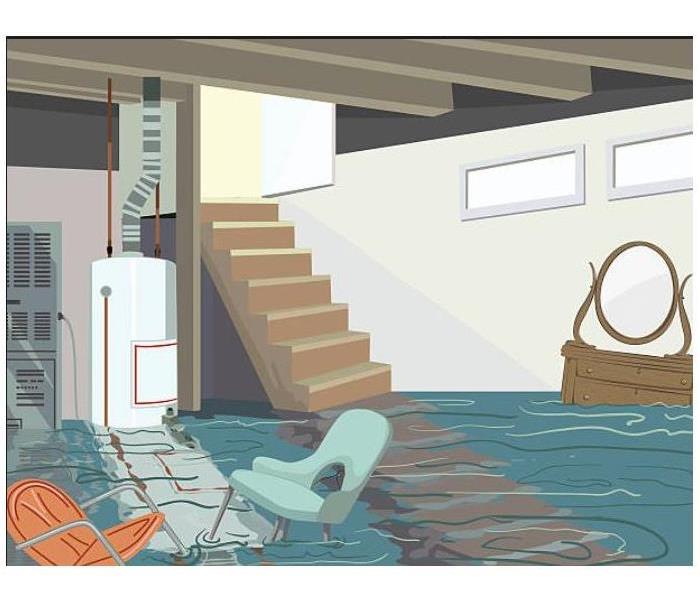 Call your neighbors at SERVPRO of West Riverside City if you have water damage or flood damage 951-351-8033
Call your neighbors at SERVPRO of West Riverside City if you have water damage or flood damage 951-351-8033
Discovering that your home was destroyed by a leak or a flood can be devastating, and repairing water-damaged walls and floors are often very expensive.
Water damage and freezing issues were the third most common reason for a homeowner’s insurance claim between 2011 and 2015 with an average payout per claim of $8,861.
Plumbing Issues
Water damage is often caused by plumbing issues. That’s why it’s important to inspect the plumbing systems in your home at least once a year to ensure that there aren’t any problems with hoses or pipe joints. You should also keep in mind that plumbing pipes have a long lifespan. Brass pipes can last for as many as 70 years while copper pipes can last for more than 50 years. The average lifespan for galvanized steel pipes is often between 20 and 50 years.
Drain pipes are usually made of either cast iron (which can last for as many as 100 years) or polyvinyl chloride (PVC). Properly maintained PVC pipes can last indefinitely. Check your home inspection report or consult a licensed plumber to learn about the lifespan of the plumbing pipes in your home.
If your water bill is unusually high, that might be an indication of an undetected leak. Buying a water leak sensor that sends alerts to your phone is one way to safeguard your home. You should also check around your toilets, tubs, showers and sinks for any soft spots or moisture. Keep an eye out for loose tiles as well. If you have a dishwasher or a refrigerator with a water line, look for warped or discolored floorboards.
Washing Machine Leaks
Unless you’re doing laundry, you probably don’t think twice about your washing machine. But if it breaks down, the results could be catastrophic. For example, if the supply hose is damaged or has a faulty connection to the wall or washing machine, more than 600 gallons of water could potentially spill out within an hour. That could lead to significant water damage, especially if your washing machine is located on the second floor of your home.
To prevent water damage, you should replace your washing machine supply hose at least once every five years. Also, resist the temptation to overload your washing machine. Constantly stuffing too many clothes into your washing machine could loosen gaskets and valves or cause cracks. Take good care of your washing machine and your washing machine will take good care of you.
Bursting Water Pipes
During severely cold winters, pipes can freeze over and burst. That’s more likely to happen if you have certain types of pipes, such as swimming pool supply lines, water sprinkler lines and pipes with minimal insulation that run against exterior walls.
If temperatures tend to freeze in your area, be sure to protect your pipes. Insulate both hot and cold water pipes using heat tape or pipe sleeves available in your home improvement store. If you have water supply lines in your garage, keep the garage door closed as often as possible. Open kitchen and bathroom cabinet doors to allow warmer air to circulate. If you plan to spend some time away from your home, leave the heat on and set your thermostat to at least 55 degrees. You can’t control the weather, but you can put up a good fight to save your pipes.
Aging Water Heaters
Water heaters have a shelf life. You could wait until your water heater starts leaking to replace it. But if you’re being smart about avoiding water damage, you should replace it every 10 years. A tankless water heater can last for as many as 20 years.
You can find out how old your water heater is by looking up the serial number on the manufacturer’s sticker near the top of the water heater. Make sure to regularly inspect your water heater to check for signs of moisture build-up, mold or corrosion. If your water isn’t as hot as it used to be or there’s rust coming from your faucets, it’s time to call a plumber or water heater specialist.
Inclement Weather
Snow may look lovely. But if your home is not weatherproof, a bad snowstorm could damage your roof, walls and ceiling. Make sure your home is ready for inclement weather by ensuring that your rain gutters and downspouts are clean. You should also check doors and windows to ensure that your caulking hasn’t cracked.
If it snows where you live, be wary about the formation of ice dams on your roof. This happens when the heat inside your home causes water to melt in the middle of your roof. The water then refreezes near the edges, forming a dam that prevents melting snow from draining off the roof. The water that backs up can leak into your home and damage ceilings, walls and other areas of your home. To prevent ice dams from forming, insulate your attic to keep heat from rising and reaching the roof.
Roofs should be inspected annually. A professional roof contractor can look for exterior and interior warning signs that your roof’s condition may lead to water damage, including cracked or missing shingles and areas where water is prone to pool. An inspection can cost several hundred dollars, but in exchange for your peace of mind, it’s priceless.
Protect Pets From Winter's Hidden Dangers in Riverside City
1/30/2019 (Permalink)
 Ellie keeping warm and cozy during winter months!
Ellie keeping warm and cozy during winter months!
Pet Owners Urged to Act Now in Winterizing their Animals and Homes -From CVMA
Many people think animals’ winter coats are enough to shelter them from the cold. But according to the California Veterinary Medical Association (CVMA), pets can be extremely vulnerable in the winter months if they are exposed to cold weather and potentially dangerous elements found in and around their owners’ homes. Additionally, as pets vary in size, age, and health status, you need to discuss your pet’s individual needs with your veterinarian.
“Cars, antifreeze, heaters and wood stoves can be death traps for animals if pet owners are not careful,” said Dr. Chris Cowing, past-president of the CVMA. “Even inside a house or apartment, though it may be warmer, dangers are present. Anything with an electrical cord or heat source, which may provide extra warmth for humans in the winter, may be dangerous to the average pet.”
The CVMA asks that pet owners heed these warnings when it comes to protecting their pets from a cold environment:
Keep antifreeze away from pets. Dogs and cats like the sweet taste and smell of the chemical, but ethanol glycol-based antifreeze is highly poisonous. That’s why some states have required that a bittering agent be added to antifreeze to make it taste unpleasant.Bang on your car before starting the engine. Outdoor cats often will curl up into the wheel wells and engine compartments for warmth and they could get trapped.Don’t use unventilated, non-electric heaters as carbon monoxide poisoning of people can pets could occur.Don’t play near frozen lakes, rivers or ponds. Your dog could slip in and drown.Protect animals from wood stoves and portable heaters. Cats can jump on top of them, causing burns to their paws.Keep nails clipped. Shorter nails allow for better traction on icy surfaces.Provide plenty of fresh water. Your dog is just as likely to get dehydrated in the winter as in the summer. Snow is not a substitute for water.Wind chill makes days colder than what the actual temperature might show so you should limit your pet’s time outdoors.Veterinarians say if at all possible, it’s best to keep pets inside and ensure they stay warm, especially at night. If an animal must be kept outside during the day, make sure it is given proper shelter, food and water. That means:
Providing a doghouse large enough to allow the dog to sit and lie down comfortably, but small enough to hold its body heat.Positioning the doghouse out of the wind or placing it on a raised platform for warmth.Covering the floor with cedar shavings or straw and changing the bedding regularly. Blankets are not recommended as they will just get wet and freeze.Giving outdoor pets more food because they will need more energy to stay warm.Using plastic food and water bowls rather than metal to keep containers from freezing. Darker colors are recommended as they will absorb more heat.The CVMA cautions that in the wintertime, pets can be more susceptible to illness. Frostbite can be a hazard especially for animals not offered proper housing. The tips of the ears, tail and feet are particularly susceptible. If a pet owner suspects his or her pet has been exposed to a poisonous substance or is experiencing a sudden drop in body temperature, call a veterinarian immediately. Winter can pose special risks to many household animals and consulting your veterinarian about a pet’s needs early on can keep everyone safe and healthy during this holiday season.
###
The California Veterinary Medical Association is the largest state veterinary medical association in the United States, with more than 7,000 members. Founded in 1888, its mission is to serve its membership and community through innovative leadership and to improve animal and human health in an ethically and socially responsible manner.
SERVPRO to the Rescue to Remove Debris From Your Fire Damaged Riverside Home
1/28/2019 (Permalink)
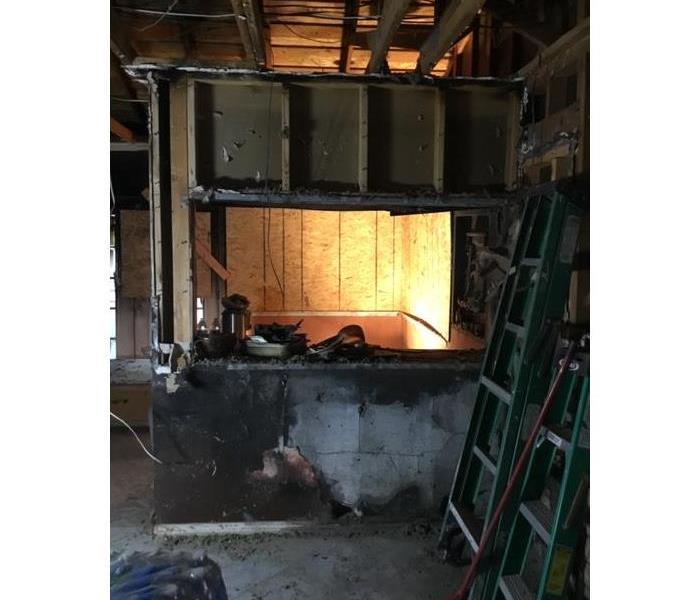 Riverside home caught fire by a candle left on unattended. Call SERVPRO today to remediate any type of Fire Damage!
Riverside home caught fire by a candle left on unattended. Call SERVPRO today to remediate any type of Fire Damage!
Why SERVPRO is the Choice for Fire Debris Cleanup for Riverside Homeowners
Homeowners in Riverside work diligently on their home's maintenance year-round. One disaster can wipe out all that effort instantly, however. Getting things corrected and back to normal can save your family from an ongoing nightmare, which is why SERVPRO is always ready to help out in Riverside with fire debris cleanup teams.
After a house fire in Riverside, the amount of debris left inside and around your home seems staggering. It also poses a high number of risks to anyone wanting to grab a few items needed, including documents or other belongings. Nails, broken glass, and other sharp objects can cause injury. We get all this removed for you, carry it out of your home, and make things safe for restoration work to begin.
Outside, your yard and driveway might also contain burnt siding sections, nails, more broken glass, torn pieces of the gutter, shingles, and many other things. All of this requires removal before work can begin on your home. Without it, even if work did occur, your family's health and safety could suffer.
Our highly trained teams work together in putting their IICRC-certificates to work for you. We obtain the containers required by local ordinances so we can immediately dispose of the damaged items in your property, both inside and out, and get things cleaned up.
Many homeowners are surprised at how much their homes contain that the fire destroyed. We take great care in filling out detailed inventory lists of these items, helping you even more with your recovery efforts. We know it is no small task, and we can help you with experienced guidance. Some items might seem covered only in soot, and undamaged in any other manner. However, the porosity of certain materials makes it almost impossible to clean them to acceptable standards.
We also eliminate the water, and any foam firefighters used during their work. This water can allow mold to begin growing on both existing materials and any new materials that absorb the water vapor in the air. Damage from water can also occur so including this as part of fire debris cleanup gives your house extra protection.
Removing the debris after a fire restores a level of safety to your house and yard, making it safe enough for restoration work to commence. Once this work finishes, we can perform the final touches to your home, including odor control methods.
Contact SERVPRO of West Riverside city by calling (951) 351-8033, day or night, 365 days a year. When your family experiences a house fire, call us for thorough fire debris cleanup and other mitigation services.
What To Do After A Fire
Limit movement in the home to prevent soot particles from being embedded into upholstery and carpets.Keep hands clean so as not to further soil upholstery, walls and woodwork.Place clean towels or old linens on rugs, upholstery and carpet traffic areas.If electricity is off, empty freezer and refrigerator and prop doors open.Clean and protect chrome with light coating of petroleum jelly or oil.Wash houseplants on both sides of leaves.Change HVAC filter.Tape double layers of cheesecloth over air registers.What NOT To Do After A Fire
Don't attempt to wash any walls or painted surfaces or shampoo carpet or upholstery without contacting us.Don't attempt to clean any electrical appliances that may have been close to fire, heat or water without consulting an authorized repair service.Don't use any canned or packaged food or beverages that may have been stored near the fire, heat or water.Don't turn on ceiling fixtures if ceiling is wet. The wiring may be damaged.Don't send garments to an ordinary dry cleaner. Improper cleaning may set smoke odor.Contents Restoration
SERVPRO of West Riverside City specializes in restoring contents damaged by water, fire, or mold. Our expertise and “restore” versus “replace” mentality can help you save money while preserving precious keepsakes that can’t be replaced. We pretest your belongings to determine what items we can restore to pre-fire condition. We use several methods of cleaning your contents, including:
Dry Cleaning - Used for cleaning light residues or to pre-clean prior to wet cleaning.Wet Cleaning - An effective cleaning method for removing moderate to heavy residues.Spray and Wipe -Effective for items that can’t withstand wet cleaning.Foam Cleaning - Used for upholstery fabrics that might shrink or bleed if wet cleaned.Abrasive Cleaning - Involves agitation of the surface being cleaned.Immersion Cleaning - Contents are dipped into a bath of the cleaning product.
Move-Outs/Pack-Outs
If your home requires extensive restoration or cleaning due to fire damage, SERVPRO of West Riverside City can conduct an organized, efficient move-out of the affected area. Move-out will provide several benefits, including:
A quicker remodeling processProtecting items from potential damageProtecting contents from further on-site damageWhen restoration is completed, we will work with you to coordinate the move-in according to your needs. The services offered upon move-in may depend on your insurance coverage.
Electronic Cleanup
Fire-damaged electronics can present a serious hazard. Do not attempt to turn on or operate any electrical device that you suspect has been damaged by fire. Smoke residues can contain acids that corrode metal surfaces. If the residues are not removed, corrosion causes electronic failure in the device. We will coordinate the restoration of your electronics, including:
Television setsDVD playersComputersAnd moreThe key to restoring electronics is taking prompt action to prevent further damage. Electronics will be cleaned and inspected by a qualified electronics technician.
Document / Photograph Drying
When your valuable documents, including photographs, are damaged by water or fire, extreme caution should be taken to help ensure the fire damage does not destroy the document. Although some documents may not be restored to pre-fire damage condition, SERVPRO of West Riverside City can save a great deal and help minimize additional damage.
Depending on the type of documents and the level of fire, smoke, or soot damage, they have five options for the restoration of documents:
Air DryingDehumidificationFreezer DryingVacuum Freeze DryingVacuum Thermal DryingContents Claim Inventory Service
When a fire emergency strikes, the damage can often feel overwhelming. We can help ease the worry and confusion during the recovery process by offering our Contents Claim Inventory Service (CCIS), which provides a detailed and accurate list of your belongings. We take a room-by-room inventory of your contents, including digital photos, and in some instances, bar coding.
Our Contents Claim Inventory Service:
Preloss list and value of contentsDetailed and accurate reportBetter information to settle claims quickerAssistance with burden of proof for claimsPeace of mind when you need it most!
When hoarding is a problem SERVPRO can help!
1/23/2019 (Permalink)
The way they started hoarding, the items they collect, the reasoning behind it, the conditions it is in.
What constitutes a hoarder versus a collector? What is the difference between someone that is thrifty and saves “things” for future use and someone that is a hoarder? Why are some people so attached to the things they find and store in their homes, while other are minimalists, and even the thought of abundant amounts of “stuff” around the house makes them nervous?
What Is Hoarding?
The easiest definition of hoarding is when the amount of acquired clutter prohibits functionality in the home. This means that functional areas such as kitchens, bathrooms, bedrooms and dining rooms cannot be used for their intended purpose. There are 5 levels of hoarding, 1 being minor clutter and 5 being blocked rooms, pathways, animal/human waste, limited ingress and egress, etc. Remember level 5 hoarding cases do not happen overnight, so a level 2 or 3 can quickly become a level 5 if proper methods are not utilized to prevent it.
Because each situation is different we handle each on a case by case scenario. A hoarder home is one of the most difficult types of jobs to handle. Not only do we need to make sure that the contents are packed and boxed in order for us to do our job (handle the water damage/fire) but we also have to be mindful that these contents more than likely holds significant value to our customer.
How does one get into the situation where their home is completely full of contents and they are to the extreme buried alive?
Obsessive-Compulsive Disorder (OCD)
Hoarding is the persistent difficulty discarding or parting with possessions, regardless of their actual value. The behavior usually has deleterious effects—emotional, physical, social, financial, and even legal—for a hoarder and family members.
For those who hoard, the quantity of their collected items sets them apart from other people. Commonly hoarded items may be newspapers, magazines, paper and plastic bags, cardboard boxes, photographs, household supplies, food, and clothing.
Hoarding can be related to compulsive buying (such as never passing up a bargain), the compulsive acquisition of free items (such as collecting flyers), or the compulsive search for perfect or unique items (which may not appear to others as unique, such as an old container).
SYMPTOMS AND BEHAVIOR
Someone who hoards may exhibit the following:
Inability to throw away possessionsSevere anxiety when attempting to discard itemsGreat difficulty categorizing or organizing possessionsIndecision about what to keep or where to put thingsDistress, such as feeling overwhelmed or embarrassed by possessionsSuspicion of other people touching itemsObsessive thoughts and actions: fear of running out of an item or of needing it in the future; checking the trash for accidentally discarded objectsFunctional impairments, including loss of living space, social isolation, family or marital discord, financial difficulties, health hazardsI know that embarrassment can keep people from seeking help but REGARDLESS OF THE REASONING WE ARE HERE TO HELP.
If you know of someone in this situation this website is a very informative website and can help :
https://www.adaa.org/understanding-anxiety/obsessive-compulsive-disorder-ocd/hoarding-basics
SERVPRO of West Riverside city is trained in assisting you in getting your life/home back on track.
You need a company that specializes in cleaning services from packing to biohazard cleaning. SERVPRO of West River side City is first call you should make. Here are the top reasons why you should hire SERVPRO.
Ensure Safe Removal of Items
Hoarders typically collect excessive amount of items, including newspapers to trash. As these items pile up in a home. This can create a serious safety hazard, plus offer an environment for unwanted pests. It is best to hire a company with knowledge to remove the debris in a safe manner.
Avoid Contact with Hazardous Materials
Hoarder homes become a breeding ground not only for pests, but for possible unsafe pathogens. During a cleanup, proper protective equipment should be worn to protect the body. SERVPRO has the necessary tools to safely complete the job.
Perform Complete and Thorough Cleaning
SERVPRO has the knowledge and resources to restore the home to a nearly pristine condition. By doing so, the company will provide a safe living environment for all that reside in the home.
We are cognizant of the fact that there may be heirlooms and valuables beneath the surface of trash. Our professional approach to these jobs is why we are called back time after time and we are pleased to provide this service.
To prevent and respond to hoarding behavior, be sure to be respectful when communicating with the individual. Instead of acknowledging the clutter, focus on expressing safety concerns for not just themselves but for those around such as neighbors, family members, responders etc. The use of outside outlets to help with intervention can be beneficial and necessary.
Types of Hoarders
ANIMAL HOARDINGBIBLIOMANIA (HOARDING OF BOOKS) / INFORMATION HOARDERSYLLOGOMANIA (HOARDING OF TRASH/GARBAGE)LARDER HOARDING (HOARDING OF FOOD)RECYCLERSCOLLECTORSSHOPAHOLICSIf you or someone you know has a hoarding situation, give us a call to see if we can help make it “Like it never even happened.”
Is it Time to Contact a Storm Restoration Expert?
1/21/2019 (Permalink)
As a homeowner, you probably don't want to have to think about your roof leak or getting a roof repair.
You probably don't want to deal with flooding, rain damage, or wind damage. Unfortunately, it might be time to contact a home restoration expert to deal with storm remediation. If you've been thinking about home restoration or water restoration, the time to get started is now. If you aren't sure whether it's time to reach out to a storm restoration or home restoration expert, there are a few things you need to consider.
Have you recently experienced a severe storm?
If you have recently experienced flooding, storm damage, or wind damage, your house may have been physically damaged and you may need storm remediation. Many homeowners don't realize just how severe roof damage, rain damage, wind damage, and ground water can be after a severe storm. Pay attention to when there are storms in your area, as any place that is prone to rain or wind damage may be susceptible to problems.
Does your home have standing ground water?
Does your area frequently have flooding due to high rains? Ground water after flooding? Standing flood water in your yard or home? It could be time to seek storm remediation. A water restoration expert can help to remove ground water with a flood pump. Did you know that a flood pump can be used by a water restoration expert to remove water? A flood pump can effectively remove water from your house. Make sure you contact a water restoration and storm restoration professional when you're ready for someone to use a flood pump at your house.
Is there visible damage to your home?
If you experience storm damage, or wind damage in your area, make sure you visually inspect your home. Do you have a roof leak from roof damage? Do you need a roof repair? Wind damage, roof damage, and a roof leak can all impact your house. Wind damage can be present in many different ways. For example, wind damage can impact the siding on your home, but wind damage can also cause a tree to fall onto your roof. This can lead to roof damage and a roof leak. Unfortunately, this means you'll need a roof repair.
Tree fall on your home? Advise & information about what to do if this happens to you.
With recent storms trees are falling causing damage everywhere, including homes in Riverside! Damage can be significant and there are many homeowners that don't know where to start in this situation. SERVPRO of West Riverside City can help.
Here is some information and advise on what to do should this happen to you.
Usually trees don't fall just because they are old. The rain water can become overwhelming in the ground making it soft and tree roots do not hold well in soft, wet dirt. This along with strong wind surges cause the tree to fall, wind pulls the tree right up from the soft ground causing the fall.
If the tree does hit your home there will likely be damage, depending on the size of the tree the amount of damage can vary. Here are the basic steps to take to secure your home:
- If you are in the home when the fall occurs, immediate walk out-side and visually look at your home for damage. Use an entrance far from the tree if possible. IE: If the main entrance is blocked, go out the back door.
- Call your local Fire or Police and advise them of the tree fall, sometimes there can be street wires that go down with the tree. If this is a problem the local authorities will help secure the area for safety.
- Call your Insurance Carrier and report a claim for the damage to your home. Get a claim number and you adjusters contact information. Also make sure they explain the claim process and how your insurance coverage applies in this situation.
- Call a Tree Company to have the tree professionally removed. Your insurance carrier may assign a company, if not ask for recommendations. DO NOT attempt yourself, this is very dangerous!
- Call SERVPRO of West Riverside City to begin mitigation of the damage. Also to board or secure areas of the house that is needed. The sooner we begin mitigation the better. Damage can get worse the longer it waits.
- Once all of this is done, begin looking for a contractor if any reconstruction is needed.
At the end of the process we at SERVPRO of West Riverside City will make it "Like it never even happened"
We are available 24/7 and 365 days a year for emergency services at 951-351-8033 or visit our website. Click "Request Service Online"
Commercial Property Clean up and Restoration in Riverside City
1/16/2019 (Permalink)
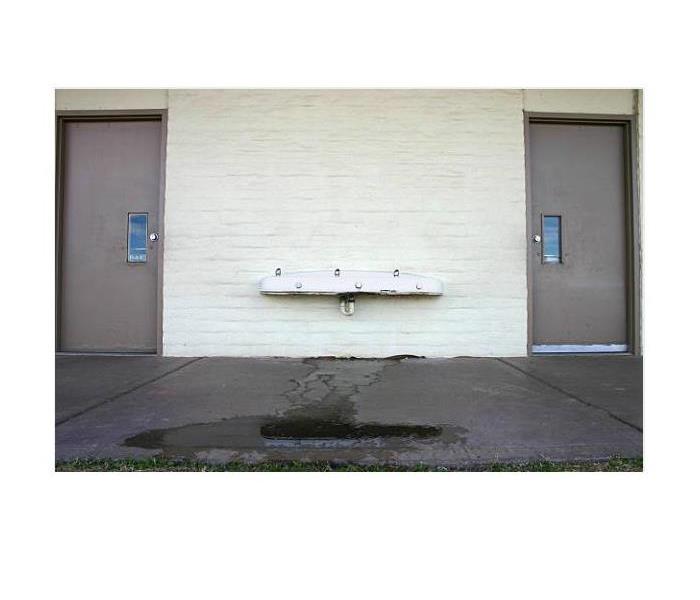 Call SERVPRO of West Riverside city for help with your commercial property (951) 351-8033
Call SERVPRO of West Riverside city for help with your commercial property (951) 351-8033
We are committed to handling our customer's emergency needs 24/7.
In the event of a commercial loss, it is important to know in advance who you can trust to mitigate your damage in a timely and effective manner. Here are 7 reasons you should choose SERVPRO of West Riverside city for your commercial property's cleanup and restoration:
24 Hour Emergency Response. In any type of loss, whether it be due to fire, water, mold, or biohazard, timely mitigation is vital to controlling damage and recovery costs. You can count on SERVPRO’s nationwide coverage and full line of restoration services to help your company make a speedy recovery.Communication. SERVPRO of West Riverside city will keep you informed from start to finish. You’ll know what’s happening every step of the way. From the first notice of loss until the job is complete, we are dedicated to effectively communicating with property owners and managers. Jobs are documented extensively as well to ensure timely mitigation and communication with our customers.Reduce Recovery Time. When damage occurs in a business, it affects everyone from the owner, the managers, the employees, the tenants, and even the customers. Our team at SERVPRO of West Riverside city understands the importance of mitigating damage to the structure and contents in a timely manner to help reduce recovery time and lessen business interruption.Lower Recovery Costs. As an independent franchise ourselves, SERVPRO of West Riverside city understands the importance of frugality. This is why we teach our technicians to employ similar concepts when working with our customers. The following are ways that the SERVPRO System can help your business save money during mitigation:Emergency mitigation services help minimize your secondary damages.Proper restoration versus replacement of contents is less expensive.Faster recovery lessens loss.We use preapproved pricing and procedures.Comprehensive clean up and restoration services help prevent further problems and potential liability risks.Emergency Response Profile. The SERVPRO Emergency READY Profile serves as a quick reference of important building and contact information or can be an ideal supplement to any well-designed emergency preparedness or existing contingency program. Rather than simply reacting to disaster situations, most prefer proactive measures to establish a relationship with a restoration services company. SERVPRO of West Riverside city can help you plan for recovery before disaster even strikes.Full Line of Services. SERVPRO of West Riverside city professionals are trained extensively to utilize the right equipment and supplies to handle all of your clean up needs.
When to Replace Your Hot Water Heater In West Riverside City
1/14/2019 (Permalink)
If your water heater is leaking or not heating up, you may be able to repair it rather than replace it. Regular maintenance will extend the life of your water heater. Some repairs, such as replacing a pressure-relief valve or heating element are pretty simple. Follow our tips to troubleshoot your gas or electric water heater issues and learn how long a water heater should last.
Safety First
Some water heater repairs are simple. However, if you aren't comfortable working with gas or electricity, always call a professional.
Repair or Replace
Based on the manufacturer's suggested service life, the life expectancy of a water heater is about 8 to 12 years. That varies with the location and design of the unit, quality of installation, maintenance schedule and water quality.
If your water heater is more than 10 years old, leaks around the base of the tank, and / or works erratically or not at all, it's probably time for replacement. However, before you begin the replacement process, make sure that an electrical problem, such as a blown fuse or tripped breaker, is not the reason for the unit's failure.
Troubleshooting Common Issues
Perhaps the most common problem connected with a water heater is water that isn't as hot as you want it to be. This is usually caused by a faulty thermostat or a defective heating element. Check the following when your water is not hot enough:
Electric water heater
Make sure that the power is connected. Reset the thermostat.Flush the heater to remove sediment from the tank.Insulate the hot water pipes.Replace the heating element or thermostat.Raise the temperature setting on the thermostat.Gas water heater
Make sure that the gas is connected and the pilot light is lit.Flush the heater to remove sediment from the tank.Insulate the hot water pipes.Clean the gas burner and replace the thermocoupler (a safety device that shuts off the gas automatically if the pilot flame goes out).Raise the temperature setting on the thermostat.Other common problems and possible solutions
Hissing or sizzling noises: Sediment may have collected in the tank. Drain the tank until the water clears. Remove and soak elements in a pan filled with white vinegar for up to an hour and scrape off the collected scale.Leaking pressure-relief valve: Replace valve.Leaking water supply pipes: Tighten the fittings. If that doesn't work, shut off the water and replace the fittings.Water Heater Maintenance
Today’s water heaters are manufactured to require little or no maintenance, but these maintenance tips could prolong the life of your water heater:
Drain the water heater twice a year to rid it of collected sediment that causes corrosion. This also increases efficiency.Test the pressure-relief valve by lifting the valve’s handle and letting it snap back. This should release a burst of water into the overflow drainpipe. If it doesn’t, install a new valve.Lower the temperature setting on the thermostat to 120 degrees Fahrenheit. This reduces damage to the tank caused by overheating.When Replacement Is Necessary
If you're replacing a water heater, you can replace it with the same type of unit. However, upgrade possibilities should be considered. For example, you may choose to increase or decrease the unit's holding capacity to accommodate a changing family. Or, you may opt to go tankless.
When looking for a water heater, consider these features:
Gallon capacity (40-gallon and 50-gallon heaters are the most common)Recovery rate (the number of gallons the heater will heat in an hour)Dimensions (width and height — physical space may limit your ability to upgrade your unit's capacity; will the heater fit in the space you have for it?)Energy efficiency ratings (a sticker on the side should list the estimated annual cost of operation for the unit)Before making repairs or purchasing a new water heater, check the nameplate on the side of your current unit. Here you will find helpful information including the tank capacity, insulation R-value, installation guidelines, working pressure, model and serial number. If you have an electric water heater, the nameplate will also list the wattage capacity and voltage of the heating elements.
How will you dispose of your old water heater? Check local codes governing disposal of such appliances.Will you be able to physically handle the unit? Water heaters are bulky and heavy. You will need assistance.Do you have the tools necessary to do the job? Water heater installation requires adjustable wrenches, screwdrivers, a hacksaw and pliers. You may also need a propane torch if your installation uses copper pipe.Do you have time to do the job? Once you start replacing a water heater, you have to finish.Caution
If you intend to convert from electric to gas or vice-versa, or if you don't feel comfortable doing the repair or maintenance work, hire a professional.
Caution
Make sure your home is equipped with carbon monoxide detectors when gas-powered appliances are present.
Why Professional Bio-Hazard Clean-Up Is Important
1/9/2019 (Permalink)
Bio-hazard contaminants should be considered very dangerous as they can pose a serious health risk.
Hazardous biological materials are very dangerous. They include blood-borne pathogens, microorganisms that live in sewage, and chemicals left behind from producing illegal drugs. In order to make spaces livable again where sewage backups, violent crimes, and drug production have taken place, you need professional bio-hazard clean-up.
If you need professional bio-hazard clean-up in West Riverside City, contact the experts at SERVPRO today by calling (951) 351-8033.
Advantages to Calling in the Pros
Why not just clean up the area yourself? There are many reasons why it’s important to seek professional services.
Exposure to bio-hazards could have serious health consequences
The bacteria, viruses, fungi, parasites, and other pathogenic substances found in biological hazards may be inhaled, swallowed, or permitted to enter the body through damaged skin or mucous membranes. Exposure can happen whether you try to clean up the scene yourself or simply enter the vicinity. Bio-hazard exposure is linked to several health consequences:
Skin irritation: Direct contact with bio-hazards could cause a rash.Allergies: Even if you aren’t already allergic to any fungus, mold, dust, enzymes, or mites found at a bio-hazard scene, exposure to it could cause you to develop an allergy that stays with you for the rest of your life.Infections: Tuberculosis, AIDS, and hepatitis are just a few infections you could contract if a bio-hazard scene isn’t cleaned up thoroughly.Poisoning: Potentially toxic concentrations of toxic materials could cause poisoning.Cancer: Hazardous chemicals are the most likely bio-hazards to have the potential to cause cancer.The clean-up process is carefully considered
Clean-up crews don’t jump into the restoration process until they carefully assess the situation and determine the fastest and most thorough way to go about it. Bio-hazard clean-up usually takes one day or less.
Bio-hazard clean-up crews are specially trained
Clean-up personnel are educated on the best ways of cleaning, disinfecting, and deodorizing a bio-hazard area to make it livable again. Proper training goes beyond learning how to safely remove bio-hazards from an area; it also includes how to dispose of these substances in proper accordance with the Occupational Safety and Health Administration (OSHA) and local health regulations.
Professionals have the right tools and protective equipment
Different clean-up situations require different equipment, and professionals understand that. They come equipped with face protection, personal respirators, protective gloves and clothing, sturdy boots, and any other gear needed for the particular situation. Then, they use disinfecting and deodorizing products to leave the scene as good as new.
Professionals understand the legal requirements of bio-hazard clean-up
Because bio-hazard clean-up is a dangerous job, it’s important to put liability in the hands of a professional bio-hazard removal company. They perform all the necessary safety protocol to reduce worker risk and abide by state sanitary codes so you don’t have to.
Bio-hazard Emergency Tips - Until Help Arrives Guide
After any bio-hazard or sewage contamination in your home or business, your primary focus should be safety:
Is it safe to stay in the house?Exposure to biological and chemical contaminants can pose serious health consequences.Flood water can contain sewage, pesticides, and other contaminants.Only do activities that are safe for you to perform.What to Do After a Contamination
Stay out of affected areas.Call emergency service personnel if the situation is life-threatening.Treat all bodily fluids as if they are contaminated.Turn off the HVAC system if there is sewage damage.What Not to Do After a Contamination
Don’t leave wet fabrics in place. Hang furs and leather goods.Don’t leave books, magazines, or other colored items on wet carpet or floors.Don’t use your household vacuum to remove water.Don’t use television or other household appliances.Don’t turn on ceiling fixtures if ceiling is wet, and keep out of rooms where ceilings are sagging. Contact SERVPRO of West Riverside City When You Need Professional Bio-Hazard Clean-Up
Dealing with a bio-hazard scene is stressful. Take some of the worry away by choosing SERVPRO of West Riverside City to conduct the clean-up and restoration process.
24 Hour Emergency Service
Bio-hazards like flood water or sewer backups should be considered an emergency and dealt with as quickly as possible. SERVPRO of West Riverside City has water damage restoration specialists and has specific training and expertise to safely remediate bio-hazard contaminants.
SERVPRO of West Riverside City proudly serves Riverside and all surrounding areas.
Contact us online or by phone at (951)351-8033 to schedule your bio-hazard clean-up.
Heating your Home Safely in Riverside City
1/7/2019 (Permalink)
There is something about the winter months and curling up with a good book by the fireplace. But did you know that heating equipment is one of the leading causes of home fire deaths? With a few simple safety tips and precautions you can prevent most heating fires from happening.
BE WARM AND SAFE THIS WINTER!
- Keep anything that can burn at least three feet away from heating equipment, like the furnace, fireplace, wood stove, or portable space heater.
- Have a three-foot "kid-free zone" around open fires and space heaters.
- Never use your oven to heat your home.
- Have a qualified professional install stationary space heating equipment, water heaters or central heating equipment according to the local codes and manufacturer's instructions.
- Have heating equipment and chimneys cleaned and inspected every year by a qualified professional.
- Remember to turn portable heaters off when leaving the room or going to bed.
- Always use the right kind of fuel, specified by the manufacturer, for fuel burning space heaters.
- Make sure the fireplace has a sturdy screen to stop sparks from flying into the room. Ashes should be cool before putting them in a metal container. Keep the container a safe distance away from your home.
- Test smoke alarms at least once a month.
Heating Equipment Smarts
Install wood burning stoves following manufacturer's instructions or have a professional do the installation. All fuel-burning equipment should be vented to the outside to avoid carbon monoxide (CO) poisoning.
Install and maintain CO alarms to avoid the risk of CO poisoning. If you smell gas in your gas heater, do do not light the appliance. Leave the immediately and call your local fire department or gas company.
FACT
Half of home heating fires are reported during the months of December, January, and February.
NATIONAL FIRE
PROTECTION ASSOCIATION
The leading information and knowledge resource
on fire, electrical and related hazards
nfpa.org/education ONFPA 2017
Call SERVPRO
After the fire trucks are gone, your Riverside home and belongings likely suffer from not only fire and smoke damage, but also extensive water damage from firefighting efforts. SERVPRO of West riverside City has the specialized fire and water damage cleanup and restoration training and experience to quickly restore your home to pre-fire condition. We also have specific training and equipment for odor removal and deep cleaning of upholstery and carpet.
Fire damage can be devastating for you and your family. Feelings of confusion and stress are common, and you need a caring expert to guide you through this crisis. We always treat your family with the greatest empathy and respect, and we’ll treat your property with great care.
Why Call SERVPRO?
We’re Faster to Any Size Disaster
When fire and water damage strikes, a fast response is critical. We’re dedicated to responding immediately, day or night, to your Riverside home or business. A faster response helps to prevent secondary damage and to reduce cost.
We’re Fire and Water Damage Specialists
As water and fire damage specialists, we have the experience, the expertise, and the advanced training that enables us to get your property restored quickly and thoroughly.
Fire & Smoke Restoration TechnicianOdor Control TechnicianUpholstery & Fabric Cleaning TechnicianWater Damage Restoration TechnicianOur Restore vs. Replace Mentality
We clean and restore your property using specialized equipment and cleaning techniques. Our “restore first” mentality reduces interruption and gets you back to your life.
Our Fire Damage Restoration Services
Every fire damage situation is a little different and requires a unique solution, but the general process stays the same. When various materials burn, the soot they create differs greatly and requires a specific cleaning procedure. The steps listed below illustrate our process for the “typical” fire damage restoration. Learn more about our fire damage restoration process.
Emergency ContactInspection and Fire Damage AssessmentImmediate Board-Up and Roof Tarp Service (if needed)Water Removal and Drying (if water damage is present)Removal of Smoke and Soot from All SurfacesCleaning and RepairRestorationHave Questions about Fire, Smoke, or Soot Damage?
Call Us Today – 951-351-8033
Top Culprits of Water Damage in Riverside Homes
1/2/2019 (Permalink)
By knowing the top causes of water damage to Riverside homes, reduce the chance of water damage occurring to your home. Below are the top causes of water damage to homes, outside of a natural disaster like flooding.
Refrigerator
If you notice water pooling below your kitchen refrigerator, you most likely either have a water line that is leaking or a freezer that is not cold enough. Check the bottom of your freezer to see if there is standing water or ice forming. As the water or ice forms, it can melt and leak every time you open the freezer. If you don’t find ice or water forming at the bottom of your freezer, you may have a water line that is loose or leaking.
The water line is used to make ice and sometimes provide water in the refrigerator door. The line is usually located in the back of the refrigerator and can be knocked causing a slow leak. It’s a good idea to occasionally check around your refrigerator for standing water and fix the problem before the water gets worse or causes damage to your floors.
Dishwasher
Much like your refrigerator, a dishwasher can leak water for a while until it is discovered. The water line and/or the drain to the dishwasher is usually connected at the back of the dishwasher and any leaks could take weeks or months to appear. While you can’t do anything about hidden leaks, the other commonplace that a dishwasher leaks is around the door. If the seals around the door have been cracked or compromised, water can leak out while it is running and pool below the dishwasher.
It’s always a good idea to check on a regular basis around the bottom of your dishwasher for any standing water or signs of water. If you do find any signs, you can then further investigate to determine if it’s around the door or if it’s coming from the water or drainage line hidden behind your dishwasher.
Washing Machine
You can probably start to see a pattern here. While water can come through a damaged roof or windows or under doors, it’s common appliances and household items that are hooked up to water that tend to cause most water damage in homes.
The washing machine is no exception to leaking, with its water intake and water drainage. Water can also leak out around the door of the washing machine from old or damaged seals. Just like your dishwasher, it’s important to regularly check around your washing machine for any signs of water leakage. Check the water hookup, water drainage, and around the door for signs of water.
Toilet
The water leaking from a toilet can be particularly bad. If the water is leaking from the back tank, then the water is most likely clean and while it is still bad, it’s not as bad of a situation if the water leaking is coming from around the toilet drain. Toilets usually drain the content of their bowl down underneath the toilet where it connects with the sewer drain. To prevent leaking and odors, the toilet drain is seated with a wax ring into the sewer drain. If your toilet is not completely bolted down or becomes loose over time, the wiggling can break the wax seal causing dirty, contaminated water to seep out below the toilet. If not discovered, this water can seep into the floor and cause serious water damage and most likely mold damage.
If you notice your toilet wiggles, check for any signs of water leakage and tighten down your toilet. If you do find water, then you may have to buy a new wax ring and reseat your toilet although you might want to have a water damage professionals check for any water or mold damage
Air Conditioner
The last common source of water damage in homes is the air conditioner. Whether you have a central air conditioner or window ac units, they both can cause water to leak and damage your home. In both systems, the air conditioner typically creates a lot of condensation when running in the hot summer. This condensation is usually gathered in a pan where it then drains outside or into a drain. If the drain becomes clogged, the water in the pan can overflow and drip inside your home or into other parts of the air conditioner where it can promote mold growth.
If you notice your vents are blowing air that smells moldy then you need to check for standing water or mold growth around the blower, filter, and cooling coils of the unit. You might also find water dripping or pooling around the unit. Again, just like your other appliances, it’s a good idea to regularly check your air conditioner as well as maintain it.
If You Do Have Water Damage, Call the Pros
If you do discover water damage from any of the above culprits or from other places like a leaky roof or burst pipe, it’s important to call water damage restoration experts at SERVPRO of West Riverside City as soon as possible. Water damage can quickly get much worse if not treated immediately. Water can seep and soak further into the floors and walls causing more damage and it can also promote mold growth if not removed and treated quickly. Hopefully, you don’t have any water damage and catch it in time by regularly checking the culprits above.
Give us a call today! - (951)351-8033
7 (totally doable) New Year's resolutions that will change your life
12/31/2018 (Permalink)
 Taking 10 minutes a day to do something you enjoy (like cuddling with your pet) is an easy goal with big return.
Taking 10 minutes a day to do something you enjoy (like cuddling with your pet) is an easy goal with big return.
Goals that take just 10 extra minutes a day (or less), and can lead to big improvements in your health and happiness.
Does the New Year mean a new you — or another failed New Year’s resolution? Probably the latter for most of us, psychologists say, because thinking the flip of a calendar is enough to motivate us to ax all of our bad habits and behaviors is actually really unrealistic.
First of all, we’re not always as committed to those resolutions as we need to be to actually be motivated to stick with them. Instead of setting discrete, measurable goals for ourselves, we often set broad intentions, like exercise more. We don’t think clearly enough about how we will implement this change.
Plus, there’s the fact that we only have so much willpower we can turn to help us stick to the new habits. When people try to make multiple changes, they put multiple demands on that limited willpower and end up failing.
That means the more willpower it takes to skip the afternoon cookie break, the less you’ll have left to help you stick to your resolution to hit the gym that evening. Willpower — a type of mental energy — is actually fueled by glucose and can be strengthened and fatigued, just like our muscles.
What does work when it comes to resolutions is setting goals that are specific and attainable, so you know exactly what you need to do to accomplish it — and you do it.
Here a few such resolutions you can try in 2019 that each take 10 extra minutes a day (or less), and can lead to BIG, impactful improvements for your health, happiness and well-being.
- SET A DAILY INTENTION
It can be as simple as deciding not to overreact if your kids or another family member gets on your nerves — or take a walk over your lunch hour instead of not leaving your desk. If you feel like you’re living on auto-pilot, starting your day by setting a daily intention can help you feel more in control of your life and your actions. And over time, those intentions can each serve as a small step toward big changes, she says.
- CROSS OFF THE TOUGHEST TASK ON YOU TO-DO LIST FIRST
Figure out the toughest, most important or most intimidating task you want to get done by the end of the day and tackle it first. That way it’s done, so it’s not hanging over your head or stressing you out the rest of the day.
- START A BELLY BREATHING HABIT
Shallow breathing keeps our bodies in that high-stress, fight-or-flight mode. But deep belly breathing sends a message to our brains to relax. Slowing down your breath can slow down the chatter in your head, and reduce stress and anxiety. (You may also find yourself thinking more clearly and sleeping better)
How to do it: You can literally do this anytime and anywhere. Just, stop. Focus your attention on your breath. Let all your air out and take a deep inhale, then exhale, then repeat.
- TAKE THE STAIRS INSTEAD OF THE ELEVATOR
Stairs are a great way to quickly get the body moving, the heart rate up, and increase your metabolic rate – no gym required. It’s not the only change you’ll need to make if you have big weight-loss goals or want to get from the couch to a marathon finish line — but it can be the first step to just get in the habit of moving more, which can encourage you to be more active in other areas of your life, too.
5. APOLOGIZE AUTHENTICALLY
Whether you got in a tiff with a friend, family member or colleague, get better at apologizing by doing what you can to reconcile the conflict, rather than hold a grudge. It takes little risk and little time, but it can be intrinsically rewarding in a big way. Being able to say you’re sorry and mean it, makes it easier to get back to a positive mood after going through something difficult.
- TELL A FAMILY MEMBER OR FRIEND ONE THING THAT WENT WELL EVERY WEEK
Too often we get hung up on the little things that go wrong from day to day, rather than focusing on everything that’s going right and what we have accomplished. Talking (out loud) about something that we’ve achieved helps us remember our true potential and the impact we’re having on the world around us.
- TAKE 10 MINUTES EVERY DAY TO DO SOMETHING FOR YOU
It’s easy to get caught up in the whirlwind of work emails, after-school carpool schedules and life’s countless obligations. Spending 10 minutes of quality you-time could mean reading a magazine, meditating or playing with your pet. Focus on activities that not only make you feel good, but also relieve stress and improve your well-being (diving into a bag of potato chips or mindlessly scrolling through your Facebook feed are NOT the goal).
And whichever resolution you choose, remember to be committed, celebrate the small successes as you do big ones and go easy on yourself. Be ready for setbacks and forgive yourself when you fail (which you WILL do).
Are You Allergic to Your Pet? Breathe Easy—You Can Still Keep Your Animal Companion!
12/26/2018 (Permalink)
Although many people have discovered the beneficial effects of caring for a furry friend, the fact remains that roughly 15 to 20% of the population is allergic to animals.
The result? Countless pet parents in unhappy, unhealthy situations—and their beloved pets are the cause! Allergen is the medical term for the actual substance that causes an allergic reaction. Touching or inhaling allergens leads to reactions in allergic individuals. Symptoms can include red, itchy, watery eyes and nose; sneezing; coughing; scratchy or sore throat; itchy skin, and most serious of all, difficulty breathing.
The most common pet allergens are proteins found in their dander (scales of old skin that are constantly shed by an animal), saliva, urine and sebaceous cells. Any animal can trigger an allergic response, but cats are the most common culprits. People can also become allergic to exotic pets such as ferrets, guinea pigs, birds, rabbits and rodents. There is no species or breed to which humans cannot develop allergies. Fur length and type will not affect or prevent allergies. Certain pets can be less irritating than others to those who suffer from allergies, but that is strictly on an individual basis and cannot be predicted.
Once the diagnosis of a pet allergy is made, a physician will often recommend eliminating the companion animal from the surroundings. Heartbreaking? Yes. Absolutely necessary? Not always. Keep in mind that most people are allergic to several things besides pets, such as dust mites, molds and pollens, all of which can be found in the home. Allergic symptoms result from the total cumulative allergen load. That means that if you eliminate some of the other allergens, you may not have to get rid of your pet. (Conversely, should you decide to remove your pet from your home, this may not immediately solve your problems.) You must also be prepared to invest the time and effort needed to decontaminate your home environment, limit future exposure to allergens and find a physician who will work with you. Read on for helpful tips:
Improving the Immediate Environment
Create an allergen-free room. A bedroom is often the best and most practical choice. By preventing your pet from entering this room, you can ensure at least eight hours of freedom from allergens every night. It's a good idea to use hypoallergenic bedding and pillow materials.Limit fabrics. Allergens collect in rugs, drapes and upholstery, so do your best to limit or eliminate them from your home. If you choose to keep some fabrics, steam-clean them regularly. Cotton-covered furniture is the smartest choice, and washable blinds or shades make good window treatments. You can also cover your furniture with sheets or blankets which you can remove and wash regularly.Vacuum frequently using a vacuum equipped with a HEPA (high-efficiency particulate arresting) filter or a disposable electrostatic bag. Other kinds of bags will permit allergens to blow back out of the vacuum.Install an air purifier fitted with a HEPA filter. Our modern, energy-efficient homes lock in air that is loaded with allergens, so it’s smart to let in some fresh air daily.Use anti-allergen room sprays. These sprays deactivate allergens, rendering them harmless. Ask your allergist for a product recommendation.Clean the litter box frequently. Use low-dust, perfume-free filler. Clumping litter is a good choice.Dust regularly. Wiping down the walls will also cut down on allergens.Invest in washable pet bedding and cages that can be cleaned often and easily.Decontaminating Your Pet
Bathe your pet at least once a week. Your veterinarian can recommend a shampoo that won't dry out his skin. Bathing works to wash off the allergens that accumulate in an animal’s fur.Wipe your pet with a product formulated to prevent dander from building up and flaking off into the environment. Ask your veterinarian to suggest one that is safe to use on animals who groom themselves.Note any symptoms of dermatitis exhibited by your companion animal. Dermatitis often leads to accelerated skin and fur shedding, which will up your allergen exposure.Brush or comb your pet frequently. It’s best to do this outdoors, if possible. (The ASPCA does not recommend keeping cats outdoors, so make sure your feline is leashed if you take him outside.)Taking Care of Yourself
If possible, have someone other than yourself do the housecleaning, litter box work and pet washing, wiping and brushing. If you must clean the house or change the litter, be sure to wear a dust mask.Wash your hands after handling your companion animal and before touching your face. The areas around your nose and eyes are particularly sensitive to allergens.Designate a “pet outfit” from among your most easily washed clothes. Wear it when playing or cuddling with your companion, and you’ll leave other clothing uncontaminated.Find a physician, preferably an allergy specialist, who will make sure that your pet is the cause of your allergies and will help alleviate your symptoms. Medications and immunotherapy (desensitizing shots) can often allow you and your companion animal to remain together happily ever after.
Tips to prevent mold in your Kitchen and bathroom
12/24/2018 (Permalink)
Bathroom and kitchen mold can often be very frustrating. But hopefully with these quick tips you can learn the causes of bathroom and kitchen mold and how you can prevent it.
8 Ways to help prevent mold growth in your kitchen:
Cooking and eating both require a lot of food and moisture, which makes your kitchen a top-notch room for mold growth. Food spoils, water splashes, and crumbs can get everywhere. Implement the following 8 tips to prevent mold from growing in your kitchen.
Keep surfaces dry: Mold loves moisture, so it’s important to keep kitchen surfaces dry. Immediately wipe up spills on the floor, counter-tops, or table. Rinse and wipe out the sink after doing dishes. Make sure your dishes and cutlery are dry before putting them into cabinets.Take out the trash: Leftover food, packaging, and other garbage makes your trash can a perfect place for mold to grow. Make sure to take out your kitchen garbage bin regularly to prevent mold growth.Use the exhaust fans: Humid environments are ideal for mold. When you cook on your stove, moisture can flood the air and condensate around the area. To cut down on humidity, use the exhaust fans when you use the stove-top.Clean the fridge: Old, spoiled food containers are one of the most common places to find mold in a kitchen. Clean out your fridge once a week to prevent food from spoiling and growing mold.Watch your fruit and potatoes: It doesn’t take long for fruit or potatoes to start growing mold, so it’s important to examine all fruit and potatoes on a daily basis, especially if you don’t keep them in the refrigerator.Clear the garbage disposal: Food can gather out of site within your garbage disposal. Even if your sink drains well, you should clean the disposal regularly. Remember to run it daily to clear out the debris. You should also pour vinegar down it weekly.Wash your cutting boards: Food particles and moisture can settle into your cutting boards, which gives mold everything it needs to grow. Use vinegar to wash your cutting boards at least once a week.Sweep and mop regularly: It’s easy for crumbs and other food particles to build up on your floor over just a few days. Sweep the floor every day, and mop it weekly.9 Tips to reduce mold growth in your bathroom:
Mold loves dark, damp areas, which makes bathrooms an ideal environment for it to grow. Regular showers and baths keep the room moist, and various crevices provide perfect spaces for mold to flourish. However, you can help prevent mold growth in your bathroom with these nine tips.
Regularly Wash Your Rugs and Shower Curtain. These items retain water longer than other surfaces in the bathroom, so they are perfect targets for mold. Most rugs and fabric curtains can go in the washing machine, but read their tags for specific instructions. To clean plastic liners, simply soak them in your tub in either a mix of water and all-purpose cleaner or water and bleach for a half an hour. Replace these items as necessary.Turn on the Ventilation Fan. Whenever you bathe or shower, make sure to turn on the bathroom ventilation fan. Keep it on until your bathroom is dry. The bathroom will, weather permitting, dry even faster if you open windows and doors.Air Out the Curtain and Towels. After showering, make sure to extend your shower curtain. If it’s scrunched up, it will take longer to dry, and mold may start to grow in the folds. Hang up your towels and pick up any clothes off the floor so they will dry faster as well.Check for Leaks. Regularly examine all bathroom fixtures. Don’t forget the pipes under the sink. Water from small leaks can provide the perfect breeding ground for mold.Wipe Down Bathroom Surfaces. If you have a glass shower, make sure to squeegee the excess water off the glass panes before you hop out of the shower. Wipe any moisture accumulation off the bathroom walls and flooring as well.Manage Household Humidity Levels. If your house is already humid, it will be more difficult for your bathroom to dry out after a shower. If your house feels humid you can use the AC or a dehumidifier to help.Keep the Clutter Out of the Shower/Tub. Avoid storing toys, shampoo bottles, loofahs, and washcloths in the shower. These items often help retain moisture in the bathroom and all give mold an ideal location to grow and hide. Try storing bottles, washcloths, toys, etc. in wire hanging baskets, in mesh nets, or on hooks that will allow everything to drip dry.Clean the Bathroom Weekly. Mold spores can remain dormant for quite some time while waiting for the right circumstances to grow. It’s important to regularly clean your bathroom even if there are no visible signs of a problem. Scrub your toilets, counters, sinks, tub, and walls. Don’t forget to dust as well. Clear out your drains as needed so water remains in sinks and bathtubs for less time.Seal Grout Lines. If you have tile, it’s important to seal grout lines once a year. This will prevent mold from growing in between your tiles. You can usually use standard grout sealer.While implementing these tips can help prevent mold growth, mold is persistent and, with the right conditions, can grow almost anywhere. If you find mold on your property, call us so we can start the mold remediation process.
At SERVPRO of West Riverside City, we understand mold growth. We have the training and experience necessary to make your home “Like it never even happened.” Call us today at 951-351-8033 or request service online.
What to do if your roof is leaking in Riverside
12/20/2018 (Permalink)
What to do if your roof is leaking?
With winter coming upon us and approaching rainy season, there’s a chance for some possible roof leaks. A leaky roof can certainly cause a rain on any homeowner’s parade. Rainy weather is often when roof leaks get discovered. That's when it's too late for anything but a repair. No time to contemplate, no time to plan with the rain causing interior damage right now, just get to the phone and get a roofer there as soon as possible. But what can you do to temporarily stop the leaks from causing more damage until help arrives?
First Things First - Deal with inside the house to minimize interior damage
In most cases, a leak will slowly pool at the ceiling until it finds an escape route -- usually a penetration point like at a light fixture or heat register. After several hours, the leak will start to find multiple escape routes, making the leak look much worse than it actually is. To minimize your ceiling damage, find the wettest spot or a bulge in the ceiling and poke a small hole in the middle. Use a bucket to collect the draining water.
Second Step – Locate the point of entry
Start with the inside, such as an attic. It will prove to be quite difficult to stop a leaky roof in the rain. Try to locate the leak but keep in mind that the leak in the ceiling and the leak in the roof may not align. If your roof covering is over a layer of plywood, then you should keep in mind that water will generally travel from the leak in the roofing material to the nearest joint in the plywood, depending on how the roof slopes.
Third Step – Maintain the situation until help arrives
Once you locate the point of entry from the inside, there are a couple of options for temporary repair such as roofing cement, roofing tape or a tarp. Available for purchase at any home improvement store, roofing cement or tape can be applied to the inside of the roof decking inside your attic, as well as to the outside of the roof. If you feel confident enough scale your rooftop, tarping is a quick and easy option to control any further leaking until your roofing contractor arrives. When using a tarp to cover your roof, a good rule of thumb is to cut the tarp so that it adequately covers the damaged area. Leave at least an extra four feet of tarp on each end to cover the roof damage. Secure the tarp with 2 x 4 boards. You can staple or nail the tarp to the boards, but be sure to use nails that are not so long that they will go through your roof.
These steps will help you prevent further damage to your home until a professional can arrive. Keep in mind when hiring a roofing contractor you want to have a reputable company, someone who is going to stand behind their work. Your roof will last a long time so you don’t want someone working on it who is not a local, reliable company.
Contact if you have water damage from a leak in your roof.
If you are in Riverside and find yourself in this vulnerable position, make a call to SERVPRO of West Riverside City and let the professionals take over. After you have done all that you as a homeowner are capable of doing to lessen the damage, let the experts use both their knowledge, experience, and resources such as vacuums and fans to dry out the water and the damage that has already taken its toll.
Next in the damage restoration process is to deodorize the building where it needs to treated. Depending on the assessed level of damage and the kind of water that did the dirty work--disinfecting may also be a necessary step to take. The goal is to get the residence or building structurally back to the standards it was at before the water accident. In some cases, further action may need to be taken such as structural repairs.
Unfortunately, homeowners may learn that they are not covered like they thought--or hoped--that they were. When that happens, the cost of repairing water damage might default to the homeowner. If you are not sure if you are covered for flooding and other water damage, call your insurance company to find out what is what. If you choose to, add coverage and discuss your location, possible natural disasters in your region, and other related matters. Insurance is there to ease your worries for a price. Put those worries to rest and get the coverage you think you need so that you can continue to live your life with as few financial surprises as possible.
So what happens when you need water damage restoration services for your Riverside residence? SERVPRO of West Riverside City Professionals concentrate on safely drying, deodorizing and disinfecting any areas flooded or damaged by water. Water damage in Riverside residences or businesses is not desirable, but there is hope and help to get you out of the mess you are in.
Why Many Insurance Agents And Adjusters Use SERVPRO
12/19/2018 (Permalink)
We aim to make the insurance agent's and the claim adjuster's jobs easier
SERVPRO of Riverside City has worked with many insurance agents and claim adjusters. We understand your situation. As an agent or adjuster, you have a responsibility to keep claim costs down while providing the best services possible for your clients. Here are a few reasons we’re trusted by so many insurance agents and adjusters:
Fast Emergency Response
Restoring commercial or residential property is the first priority at SERVPRO of Riverside City. Your insurance client will appreciate our immediate response and you will know we’re doing everything we can to limit the damage and the costs.
Pretesting Reduces Claims Expense
Like insurance agents and claim adjusters, we know restoring property is less expensive than replacing property. Our goal is always to restore whenever possible and replace only when necessary. That’s why SERVPRO of Riverside City performs pretesting on every loss so we can determine restorability.
Claims Inventory Service
SERVPRO of Riverside City can provide insurance agents and claim adjusters with an itemized loss inventory. We give you an Excel formatted report and pictures of important items. Your work is made simpler and clearer because we provide you with a complete and accurate picture of the incident.
Electronic Claims Information
Our corporate Claims Information Center provides the fast, accurate information you need to make sound decisions, including:
• A complete electronic job file (by email or on paper)
o First notice of loss
o Detailed estimate
o Digital loss photos
o Scanned forms and paperwork
• Informative reports (including job cost data) to improve results
• Performance comparison to industry standard
Superior, Time-Tested Training
Effective training is the best way to help ensure your clients receive the service they deserve. All SERVPRO of Riverside City crews are trained to IICRC (Institute of Inspection Cleaning and Restoration Certification) standards in fire and water cleanup and restoration. We also conduct continuing education classes.
Vendor Qualification Compliance and Professionalism
If you call SERVPRO of Riverside City, we will use only qualified vendors to service your clients. Our commitment means you receive:
• Access to the SERVPRO National Call Center to achieve prompt handling of your claims
• Assurance that our crew uses industry best practices
• Efficiencies through our insurance and file documentation requirements
• The benefits of our quality assurance program
Serving Adjusters and Your Clients
A SERVPRO of Riverside City professional's job is to reassure your clients, perform quality service, and report to you quickly. We know your job is to interpret the policy and adjust the claim. We don’t want you to have to deal with problems from vendors. Working with you, we strive to save you time so you can focus on priority files, while having complete control of every loss you’re assigned. We offer you 24-hour emergency response, damage mitigation, loss assessment, and an electronic file within hours. SERVPRO of Riverside City documented, measured performance increases value for you, your agency, your managers, and your clients.
Hard-earned results have made SERVPRO leaders in the fire and water cleanup and restoration industry. The SERVPRO System is geared to achieve customer satisfaction and mitigation results, adding to your competitive advantage.
Insurance Services
As a leader in fire and water cleanup and restoration, SERVPRO Franchise Professionals offer your insurance company an array of competitive advantages. Our goal is to restore both your customer’s property and their peace of mind through timely mitigation and adherence to IICRC standards. The result? Lower claims costs and satisfied customers – and that’s just the tip of the iceberg.
Why SERVPRO?
The SERVPRO Difference - SERVPRO Franchise Professionals are uniquely qualified to keep claims costs down while still providing the best services possible for your customers.
Large Loss Response
No Restoration Project Is Too Large Whether it’s a large commercial project or a major storm event, the SERVPRO Disaster Recovery Team can provide help quickly.
Training
From initial training at SERVPRO's Corporate Training Facility to IICRC certifications, SERVPRO Franchise Professionals are highly trained in property damage restoration.
SERVPRO offers both credit and non-credit courses for insurance agents, insurance adjusters and Real Estate professionals.
The CE courses provide you with information to better service your customers
These programs are designed to improve the knowledge of your staff regarding emergency mitigation.
Here are some of the Continuing Education courses that are offered by SERVPRO
- Fire Damage Restoration
- Understanding Mold in the Restoration Industry
- Restorative Drying for Water Damage
- Mitigation Awareness Response Seminar
- Biohazard Cleanup
Here To Help
The team at SERVPRO of Riverside City has specialized training and experience in fire restoration services, natural disaster prevention, natural disaster cleanup, and natural disaster restoration.
Call SERVPRO of West Riverside City (951.351.8033) anytime, 24/7.
Like it never even happened.
Steps Towards Professional Commercial Fire Damage Restoration
12/17/2018 (Permalink)
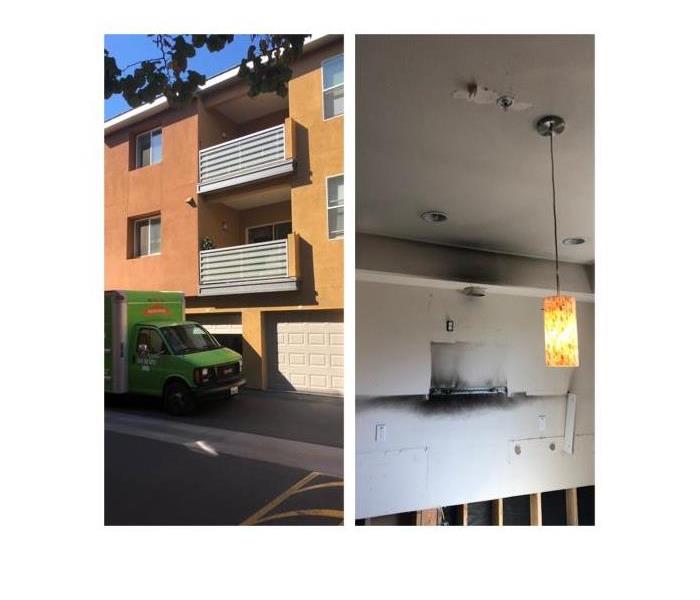 Fire located at this Riverside Apartment Complex. We can handle any commercial building!
Fire located at this Riverside Apartment Complex. We can handle any commercial building!
Steps Towards Professional Commercial Fire Damage Restoration
It is without a doubt that fire can be devastating; especially if it breaks out in business premises. Given the intensity of the loss that fire can cause in a commercial building, most of the business owners take up measures that could reduce losses. One of the most common and effective ways is to install fire sprinkler systems.
In utility room fire or electrical fire, the fire sprinkler system can detect the heat change and ring the alarm as it opens up its valves. The rooms in the building are sprayed with a lot of water from the fire sprinkler system. Further, the alarm helps in evacuation and calling the local firefighters to respond to the utility room fire or electrical fire.
Firefighters usually respond to a fire distress quickly because they know that utility room fire or electrical fire does not wait for anyone. They arrive with fire trucks and long fire hose to make sure that they can access any part of the building is important to back up fire sprinkler system. A fire truck is filled with a mixture of water and fire redundant chemicals not forgetting the pressure pumps that help in fire suppression.
Firefighters can use cranes on the fire truck to hoist the fire hose and reach any height necessary. All the effort put by the firefighters in fire suppression effort also causes destruction as well as that caused by utility room fire or electrical fire damage. Firefighters are forced to break into windows and doors to ensure that fire hose has access to all areas under fire. Other than fire damage, the owners will have to deal with damages caused during fire suppression, smoke damage, and soot damage.
After the last flame goes off, the work of the firefighters comes to an end, they pack up their fire hose and get into their fire truck and leave the area to wait for another assignment. The business owner now has a chance to have a look at the fire suppression aftermath. The scene is always heart breaking, charred mess, flooded floors, overturned furniture, choking smell from smoke damage and soot damage is all over. You cannot guess what needs to be done but thanks to the professional fire restoration services as they can handle any commercial fire damage restoration.
Unlike the fire suppression efforts, the fire restoration service requires proper planning to avoid causing more damages and loss. For this reason, fire damage professionals have to begin with the inspection of the building to assess the extent of commercial fire damage. This gives them an opportunity to plan and come up with appropriate approaches to deal with the mess. In a short while, they list and remove items that can be cleaned or repaired and take it to their facility. They also do the documentation to ascertain your loss, which can also be used to file insurance claims.
Fire damage restoration begins with the clearing of the charred mess and removal of floods caused by the fire hose. You will also be involved in each step to ensure that everything is, as you want it to be. The professional's commercial fire damage restoration services also ensure that all other damages such as soot damage, smoke damage and water damage is taken care. Soot damage would require repainting of the walls and cleaning ash from the vents. Smoke damage will call for deodorization of all the porous items and upholstery.
You should not let time pass by after commercial fire damage before calling professional fire restoration services. The more you delay, the further will be the damages, especially through floods. It is also prudent to consider bringing back the business up on its feet before your clients get absorbed by your competitions.
The most important thing is to make sure that you hire the right fire damage restoration experts. This could be achieved through a simple background check and contacting their reference for a tip off. Commercial fire damage may not bring back the losses, but it can help you have a platform to trudge on with your business.
Visit SERVPRO of West Riverside City for more information on fire damage.
If your business experiences a fire loss, call the fire and water damage restoration experts and we’ll respond immediately to get you back to business.
24 Hour Emergency ServiceFaster to Any Size DisasterA Trusted Leader in the Fire and Water Restoration Industry with over 1,700 FranchisesHighly Trained Fire and Water Damage Restoration SpecialistsSERVPRO of West Riverside City has the training, experience, and equipment to handle large commercial fire damage emergencies.
Fire and Smoke Restoration TechnicianOdor Control TechnicianUpholstery & Fabric Cleaning TechnicianWater Damage Restoration TechnicianCommercial Fire Damage? Call Us Today – (951) 351-8033
How To Clean Your Riverside Home Fast!
12/12/2018 (Permalink)
 Three of our green cleaning products Carpet & Upholstery Green Clean, All Surface Green Clean, Window Green Clean
Three of our green cleaning products Carpet & Upholstery Green Clean, All Surface Green Clean, Window Green Clean
So you have company coming in an hour and the house is a mess?
Or maybe you’ve just been putting off those chores and want to get it over with as quickly as possible. So, how do you clean your house fast?
When I was in college I worked a couple summers as a hotel maid and house cleaner. I picked up a few tricks and I’m telling you that yes, you can clean an ENTIRE average size house in an hour but it takes work-and focus! No getting distracted while gathering up those old magazines, or checking your phone for the latest on Facebook. If you keep moving and follow this guide you’ll have that house sparkling in no time!
HOW TO CLEAN HOUSE FAST!
Start at the Top
No matter what room you’re cleaning, clean from the top down so that dirt and dust from higher surfaces falls on lower surfaces that haven’t yet been cleaned. Dust ceiling fans, then furniture wiping dirt directly on the floor. Clean all of the floors as your last step to remove the dirt and dust.
Bedrooms-6 minutes per bedroom
- Strip linens and remake beds. When making beds rather than hunch over tucking bottom sheets under the mattress use one hand to lift the corner while tucking the sheet with the other.
- Clear all clutter, if you’re in a hurry gather clutter in a spare basket or bin for later organization and tuck out of sight in a closet.
- Wipe down furniture with a dusting spray and microfiber cloth, working top to bottom.
Bathrooms-7 minutes per bathroom
- I like to clean all of my bathrooms at once-make a quick trip around all the bathrooms in the house to clear counters and spray counters and tubs with cleaner, allow to sit while you clean toilets and wipe down the outer toilet surface.
- Go back and wipe down counters and rinse tub then clean mirrors.
- Come back to clean the floors when cleaning the kitchen floor.
Living/Dining Rooms-7 minutes
- Clear all clutter.
- Starting in one corner of the room and working around dust all surfaces top to bottom. (If you have blinds and/or ceiling fans, dust those first.)
- Use an upholstery attachment and vacuum upholstered furniture.
- Vacuum floors along with all house carpeting as last cleaning step.
Kitchen-12 minutes
- Load all dirty dishes in the dishwasher and fill sink with hot soapy water. If your stove top has removable burner pieces that need to be cleaned, place in water as well.
- Clear counters.
- Dunk sponge in hot water and squeeze out excess, wipe down cabinets, counters and other surfaces again working top to bottom. Rinse sponge in hot water as you clean-you’ll be amazed how much dirt comes off!
- Wipe down appliances.
- Finish cleaning any stove pieces and replace.
- Clean floors last along with all hard flooring surfaces in the house.
Floors-15 minutes whole house
- When vacuuming carpeted rooms work your way backwards out of the room moving quickly and without too much overlap to save time.
- Vacuum, don’t sweep hard floors-use an attachment to get corners where dust and pet hair can accumulate. This helps prevent kicking dust into the air that will quickly settle again and aggravating allergies.
- Steam mops or Hardwood Floor Cleaners also make cleaning hard surfaces much faster than traditional mops, so I highly recommend investing in one of those to keep your cleaning quick!
As a SERVPRO Franchise, we have access to SERVPRO Industries, Inc. resources and technology. Part of this includes the large range of cleaning products SERVPRO has developed. Over the years SERVPRO Industries has strived to develop green chemicals that are safe for your home and family as well as the environment. We have been members of the EPA’s Design for Environment (EPA/DFE) initiative for a longtime. This allows us access to resources that help in formulating environmentally friendly cleaning products, known as “Green” chemistry. Our most notable green cleaning products are highlighted below.
Carpet & Upholstery Green Clean #251: This product is designed for cleaning both carpet and upholstery. It is truly a “one product does all” in that it can be used as a spotter, pre-spray and in-line cleaner for use with a variety of equipment.
All Surface Green Clean #250: This is an environmentally friendly alternative to traditional surface cleaners. The product is designed as a one product cleans all for surfaces that can be wiped or mopped. It can safely be used on walls, ceilings, countertops, floors, etc. The exclusive formulation contains both ionic and non-ionic surfactants that are naturally derived and provide excellent multi-functional cleaning.
Window Green Clean #249: This cleaner is an environmentally friendly alternative to traditional glass cleaners. The product is formulated with soft water to eliminate spotting and streaking.
You should be able to handle most of the cleaning around your house, but for any of those tough stains - give us a call! We can help! SERVPRO of West Riverside City has the industry experience and expertise to provide a deeper clean than your basic home cleaning service.
We're here to make things easier for you.
Need cleaning services?
Give us a call today! - (951)351-8033
Protect your home while your out of town this travel season
12/10/2018 (Permalink)
Do you have plans to head out of town for the holiday season?
Do you know how to prepare your home before you head out of town? Follow these tips to help prevent possible damage while you are gone.
Water Damage
The last thing you want to find on your return from a relaxing vacation is flooding and water damage in your home. There are a variety of potential causes of water damage. Plumbing and appliances in your home can malfunction and leak while you are away. When you leave consider turning off your water, or have someone come check your home regularly and have them flush your toilets and run several faucets to ensure they are working.
Make sure windows are closed and sealed, and check to make sure there are no small leaks before you leave the home. A small leak can lead to significant water damage and potential mold growth.
Examine the Flooring
Depending on the type of flooring you have in each room of your home, you’ll want to look for different warning signs of water damage.
In rooms with tile, laminate, or wood, look for warning signs such as:
CracksWarped, soft, or squishy areas along the surfaceBulges in the material (particularly with wood and laminate)Look for white or dark stains on wood floors as well.
Carpet can mask problems that lie beneath the surface. Watch for more obvious signs like wet spots in your carpeting, but also pay attention to any gradual rises underneath the floor. Damp, moldy smells can also be a sign of water damage.
Check the Walls and Ceilings
Walls can easily hide small leaks, but the water buildup will usually reveal itself in time. Regularly examine your walls and ceilings for the following signs of water damage:
Soft spots, potentially with a swollen appearanceCracks in the drywallStaining or any off-color areasWet spotsIf you’re not the original owner of the home, you may want to look for areas on the ceilings and walls with a lot of localized paint buildup. Make sure the previous owner did not simply paint over water damage.
Inspect the Bathroom and Kitchen
It’s easy to neglect the cabinets beneath your sinks—especially if you don’t keep anything you regularly use down there. Check the area for the following signs of a problem:
Standing waterCondensationLeaking pipesWater stainsIn addition to looking under the sink, you should inspect all fixtures for signs of wear including missing grout, leaks, rust, or mold. Examine your laundry room and water heater for similar potential signs of water damage.
Survey the Attic and Roof
You can often find signs of roof damage in your attic; however, these signs may go unnoticed since attics tend to be a low-traffic area. Examine your attic regularly to look for key indicators of potential problems.
The insulation should be dry and in good condition. Pay attention to points where two roof planes come together and the flashing where the roof meets the walls. Watch for signs of damage such as:
MoldStainingWarped/cracked wood or drywallYour roof is one of the largest surfaces of your home that is exposed to the outside elements. As such, even small problems, if unnoticed or ignored, can lead to potential home damage.
After clearing debris that could hide potential problems, search your roof for signs of damage including:
Broken or damaged flashingMissing shinglesCurled or cracked shinglesWhile you are outside, pay attention to the foundation of your home as well. Make note of any standing water along the foundation, as this can also indicate otherwise unseen issues.
Mold Damage
To help reduce the risk of mold growth while you are gone, make sure to clean your kitchen and bathrooms before leaving. Clean out your refrigerator before you leave and get rid of any food that might spoil while you are gone, such as milk, meats and produce. Spoiled food can cause bad smells and even lead to mold growth in your refrigerator and freezer. Also, clear out any perishable foods in your pantries, and don’t leave any food open. Be sure to take out your trash, especially if it contains spoiled food or other smelly items. Clean your sink drain and disposer to get rid of food buildup.
Along with cleaning before you leave, check for any water leaks or wet spots. Wet, damp areas create a perfect environment for mold growth.
Fire Damage
Make sure your smoke detectors are in working order before you leave. Also unplug appliances like computers and TVs to reduce power usage, the risk of power surges damaging your devices and of cords shorting out and starting a fire. Finally, make sure your oven and grill are off before you leave.
Burglary/ Vandalism
This is one of the big concerns when leaving town. One of the biggest keys is to make your home look like it’s still occupied. Set lights on a timer in your home and have your mail and newspapers put on hold while you are out. Don’t say you are out of town on your answering machine or on social media. This tells the world that you are gone and that your home is unoccupied. Have a friend come check in on your home regularly. Make sure your doors are locked and windows closed and locked before you leave.
We all want our homes to be safe while out of town. These tips can help prevent potential damage to your home. If things do happen while you are out, give us a call and we can get your home back to normal in no time. SERVPRO of West Riverside City can clean and restore most damage, from broken windows and other vandalism to water and smoke damage. Give us a call at SERVPRO of West Riverside City, 951-351-8033, to start the restoration process. We’ll make it “Like it never even happened.”
Fire Safety and Candles in your Riverside Home
12/6/2018 (Permalink)
There’s a special beauty and tranquility to candles, but a lighted candle is also an open flame, and a potential fire hazard if not carefully monitored.
In fact, accidental candle fires account for approximately four percent of all U.S. residential fires.
A study by the U.S. Consumer Product Safety Commission suggests that 85 percent of candle fires could be avoided if consumers followed three basic safety rules:
Never leave a burning candle unattended.Never burn a candle on or near anything that might catch fire.Keep candles out of the reach of children and pets.The National Candle Association urges consumers to always follow the basic rules of fire safety when burning candles.
HOW TO BURN A CANDLE SAFELY
BEFORE LIGHTING
Before burning, always trim the wick to ¼ inch. You can use a wick trimmer, nail clippers, or scissors. Long or crooked wicks can cause uneven burning, dripping or flaring.When lighting a candle, use long matches or a long-reach lighter. Keep your hair and loose clothing away from the flame.Always use a candleholder specifically designed for candle use. It should be heat resistant, sturdy, and large enough to contain any drips or melted wax.Burn candles in a well-ventilated room.Place the candleholder on a stable, heat-resistant surface. This will also help prevent possible heat damage to counters and table surfaces and prevent glass containers from cracking or breaking.Keep the wax pool clear of wick trimmings, matches and debris at all times.Avoid drafts, vents or air currents. This will help prevent rapid or uneven burning, sooting, and excessive dripping.Follow the manufacturer’s recommendations on burn time and proper use. In general, it is recommended that candles do not burn for longer than four hours and cool for at least two hours before relighting.WHILE BURNING
Never touch or move a burning candle. Never move a votive or container candle when the wax is liquefied.Don’t burn a candle all the way down. For a margin of safety, discontinue burning a candle when 2 inches of wax remains (1/2 inch if in a container).Place burning candles at least three inches apart from one another. This is to make sure they don’t melt one another, or create their own drafts that will cause the candles to burn improperly.Extinguish a candle if the flame becomes too high or flickers repeatedly. Let the candle cool, trim the wick, and check for unwanted drafts before re-lighting.Always keep the candle within your sight. If you are going to leave the room, be sure to first blow out all candles.Always burn candles in a well-ventilated room. Don’t burn too many candles in a small room or in a “tight” home where air exchange is limited.Never use a candle as a night light.Be very careful if using candles during a power outage. Flashlights and other battery-powered lights are safer sources of light during a power failure. Never use a candle during a power outage to look for things in a closet, or when fueling equipment – such as a lantern or kerosene heater.Never burn a candle on or near anything that can catch fire. Keep burning candles away from furniture, drapes, bedding, carpets, books, paper, flammable decorations, etc.Keep candles out of the reach of children and pets. Do not place lighted candles where they can be knocked over by children, pets or anyone else.WHEN EXTINGUISHING
Use a candle snuffer to extinguish a candle. It’s the safest way to prevent hot wax from splattering.Never use water to extinguish a candle. Water can cause the hot wax to splatter and might break a glass container.Make sure the candle is completely out and the wick ember is no longer glowing before leaving the room.Don’t touch or move the candle until it has completely cooled.Never use a knife or sharp object to remove wax drippings from a glass holder. It might scratch, weaken, or cause the glass to break upon subsequent use.Download a complete list of candle safety rules.
WHAT MAKES A SAFE & QUALITY CANDLE?
NCA invites you to view the webinar, What Makes a Safe & Quality Candle? This webinar is designed to to educate and inform the retail community on candle basics, safety standards, and testing of candle products. This is a must for compliance personnel and candle buyers.
In this webinar, you will learn:
An Overview of Candle Basics: Wax and wick types, the difference between dyes and pigments, why fragrance does more than just smell nice, and how changing just one of these elements affects the entire candle.The ASTM Safety Standards in Plain English: What it means when a flame is too high, what “secondary ignition” and “end of useful life” mean, and the requirements for glass and plastic containers, candle accessories, warning labels and more.What to Ask For and Expect from Your Test Lab: What determines if a candle passes or fails the ASTM standards, the common causes of test failures, and what to do if you think you need additional testing.Plus: Tips for Success and Q&ACANDLE FIRE STATISTICS
An estimated 8,700 residential fires are caused each year by the careless or inappropriate use of candles, according to the National Fire Protection Association (NFPA.)
The National Candle Association urges consumers to always keep a burning candle within sight, keep candles away from anything combustible, and to keep candles out of the reach of children and pets.
Roughly one-third of home candle fires start in bedrooms, says the NFPA. Avoid using candles in bedrooms or any place where people are likely to fall asleep.
Three of every five candle fires started when something that could burn, such as furniture, mattresses or bedding, curtains, or decorations, was too close to the candle.
In 16% of the fires, the candles were unattended or abandoned, according to the NFPA.
*SOURCE: HOME CANDLE FIRES, FIRE ANALYSIS AND RESEARCH DIVISION, NATIONAL FIRE PROTECTION ASSOCIATION, DECEMBER 2015. BASED ON 2009-2013 ANNUAL AVERAGES
Coping with Disaster and Understanding Disaster Events
12/5/2018 (Permalink)
Understand Disaster Events
The emotional toll that disaster brings can sometimes be even more devastating than the financial strains of damage and loss of home, business, or personal property.
- Everyone who sees or experiences a disaster is affected by it in some way.
- It is normal to feel anxious about your own safety and that of your family and close friends.
- Profound sadness, grief, and anger are normal reactions to an abnormal event.
- Acknowledging your feelings helps you recover.
- Focusing on your strengths and abilities helps you heal.
- Accepting help from community programs and resources is healthy.
- Everyone has different needs and different ways of coping.
- It is common to want to strike back at people who have caused great pain.
Children and older adults are of special concern in the aftermath of disasters. Even individuals who experience a disaster “second hand” through exposure to extensive media coverage can be affected.
Contact local faith-based organizations, voluntary agencies, or professional counselors for counseling. Additionally, FEMA and State and local governments of the affected area may provide crisis counseling assistance. The SAMHSA Disaster Distress Helpline is a national hotline dedicated to providing year-round immediate crisis counseling for individuals experiencing emotional distress related to any natural or human-caused disaster.
As you recover, it is a good idea to make sure that you have updated your family disaster plan and replenished essential disaster supplies just in case a disaster happens again. You will always feel better knowing that you are prepared and ready for anything.
Recognize Signs Of Disaster-Caused Stress
Seek counseling if you or a family member are experiencing disaster-caused stress. When adults have the following signs, they might need crisis counseling or stress management assistance:
- Difficulty communicating thoughts.
- Difficulty sleeping.
- Difficulty maintaining balance in their lives.
- Low threshold of frustration.
- Increased use of drugs/alcohol.
- Limited attention span.
- Poor work performance.
- Headaches/stomach problems.
- Tunnel vision/muffled hearing.
- Colds or flu-like symptoms.
- Disorientation or confusion.
- Difficulty concentrating.
- Reluctance to leave home.
- Depression, sadness.
- Feelings of hopelessness.
- Mood-swings and easy bouts of crying.
- Overwhelming guilt and self-doubt.
- Fear of crowds, strangers, or being alone.
Easing Disaster-Caused Stress
Talk to someone and seek professional help for disaster-caused stress. The following are ways to ease post-disaster stress:
- Talk with someone about your feelings - anger, sorrow, and other emotions - even though it may be difficult.
- Seek help from professional counselors who deal with post-disaster stress.
- Do not hold yourself responsible for the disastrous event or be frustrated because you feel you cannot help directly in the rescue work.
- Take steps to promote your own physical and emotional healing by healthy eating, rest, exercise, relaxation, and meditation.
- Maintain a normal family and daily routine, limiting demanding responsibilities on yourself and your family.
- Spend time with family and friends.
- Participate in memorials.
- Use existing support groups of family, friends, and religious institutions.
Ensure you are ready for future events by restocking your disaster supplies kits and updating your family disaster plan. Doing these positive actions can be comforting.
Helping Kids Cope With Disaster
Disasters can leave children feeling frightened, confused, and insecure. Whether a child has personally experienced trauma, has merely seen the event on television, or has heard it discussed by adults, it is important for parents and teachers to be informed and ready to help if reactions to stress begin to occur.
Children may respond to disaster by demonstrating fears, sadness or behavioral problems. Younger children may return to earlier behavior patterns, such as bedwetting, sleep problems, and separation anxiety. Older children may also display anger, aggression, problems in school, or withdrawal. Some children who have only indirect contact with the disaster but witness it on television may develop distress.
Recognize Risk Factors
For many children, reactions to disasters are brief and represent normal reactions to "abnormal events." A smaller number of children can be at risk for more enduring psychological distress as a function of three major risk factors:
- Direct exposure to the disaster, such as being evacuated, observing injuries to or the death of others, or experiencing injury along with fearing one’s life is in danger.
- Loss/grief caused by the death or serious injury of family or friends.
- On-going stress from the secondary effects of disaster, such as temporarily living elsewhere, loss of friends and social networks, loss of personal property, parental unemployment, and costs incurred during recovery to return the family to pre-disaster life and living conditions.
Vulnerabilities in Children
In most cases, depending on the risk factors above, distressing responses are temporary. In the absence of severe threat to life, injury, loss of loved ones, or secondary problems such as loss of home, moves, etc., symptoms usually diminish over time. For those that were directly exposed to the disaster, reminders of the disaster such as high winds, smoke, cloudy skies, sirens, or other reminders of the disaster may cause upsetting feelings to return. Having a prior history of some type of traumatic event or severe stress may contribute to these feelings.
Children’s coping with disaster or emergencies is often tied to the way parents cope. They can detect adults’ fears and sadness. Parents and adults can make disasters less traumatic for children by taking steps to manage their own feelings and plans for coping. Parents are almost always the best source of support for children in disasters. One way to establish a sense of control and to build confidence in children before a disaster is to engage and involve them in preparing a family disaster plan. After a disaster, children can contribute to a family recovery plan.
Meeting the Child’s Emotional Needs
Children’s reactions are influenced by the behavior, thoughts, and feelings of adults. Adults should encourage children and adolescents to share their thoughts and feelings about the incident. Clarify misunderstandings about risk and danger by listening to children’s concerns and answering questions. Maintain a sense of calm by validating children’s concerns and perceptions and with discussion of concrete plans for safety.
Listen to what the child is saying. If a young child is asking questions about the event, answer them simply without the elaboration needed for an older child or adult. Some children are comforted by knowing more or less information than others; decide what level of information your particular child needs. If a child has difficulty expressing feelings, encourage the child to draw a picture or tell a story of what happened.
Try to understand what is causing anxieties and fears. Be aware that following a disaster, children are most afraid that:
- The event will happen again.
- Someone close to them will be killed or injured.
- They will be left alone or separated from the family.
Reassuring Children After a Disaster
Suggestions to help reassure children include the following:
- Personal contact is reassuring. Hug and touch your children.
- Calmly provide factual information about the recent disaster and current plans for insuring their safety along with recovery plans.
- Encourage your children to talk about their feelings.
- Spend extra time with your children such as at bedtime.
- Re-establish your daily routine for work, school, play, meals, and rest.
- Involve your children by giving them specific chores to help them feel they are helping to restore family and community life.
- Praise and recognize responsible behavior.
- Understand that your children will have a range of reactions to disasters.
- Encourage your children to help update your family disaster plan.
If you have tried to create a reassuring environment by following the steps above, but your child continues to exhibit stress, if the reactions worsen over time, or if they cause interference with daily behavior at school, at home, or with other relationships, it may be appropriate to talk to a professional. You can get professional help from the child’s primary care physician, a mental health provider specializing in children’s needs, or a member of the clergy.
Monitor and Limit Exposure to the Media
News coverage related to a disaster may elicit fear and confusion and arouse anxiety in children. This is particularly true for large-scale disasters or a terrorist event where significant property damage and loss of life has occurred. Particularly for younger children, repeated images of an event may cause them to believe the event is recurring over and over.
If parents allow children to watch television or use the Internet where images or news about the disaster are shown, parents should be with them to encourage communication and provide explanations. This may also include parent’s monitoring and appropriately limiting their own exposure to anxiety-provoking information.
Use Support Networks
Parents help their children when they take steps to understand and manage their own feelings and ways of coping. They can do this by building and using social support systems of family, friends, community organizations and agencies, faith-based institutions, or other resources that work for that family. Parents can build their own unique social support systems so that in an emergency situation or when a disaster strikes, they can be supported and helped to manage their reactions. As a result, parents will be more available to their children and better able to support them. Parents are almost always the best source of support for children in difficult times. But to support their children, parents need to attend to their own needs and have a plan for their own support.
Preparing for disaster helps everyone in the family accept the fact that disasters do happen and provides an opportunity to identify and collect the resources needed to meet basic needs after disaster. Preparation helps; when people feel prepared, they cope better and so do children.
Flooding After Wildfires in Riverside County – Reduce Your Risk
12/3/2018 (Permalink)
Flooding is the most common and costly natural hazard in the nation.
Wildfires carry a one-two punch. After the damage caused by the wildfire, flooding is the most common and costly natural hazard in the nation. And, after the record-breaking wildfires in California, the risk of flash flooding and mud flows increase significantly. Even light rain can lead to devastating flash flooding and mudflows.
Residents of California’s Riverside, Los Angeles, Butte, Ventura counties and surrounding areas are urged to protect themselves by planning evacuation routes, collecting supplies and purchasing flood insurance today. Even if your home was not directly impacted by the wildfires, you are at increased risk of flooding. All surrounding areas are at risk of flooding for up to several years. To learn more, visit FEMA-Flood-after-fire.
Large-scale wildfires like Holy, Camp, Hill and Woolsey will dramatically alter the terrain and ground conditions. Normally, vegetation absorbs rainfall, reducing runoff. Wildfires, however, leave the ground charred, barren and unable to absorb water, creating conditions ripe for flash flooding and mudflow. Flood risk remains significantly higher until vegetation is restored—up to five years after a wildfire. Flooding after a fire is often more severe, as debris and ash left from the fire can form mudflows. As rainwater moves across charred and denuded ground, it can also pick up soil and sediment and carry it in a stream of floodwaters, which can cause more significant damage.
A flood does not have to be a catastrophic event to bring high out-of-pocket costs; and you do not have to live in a high-risk flood area to suffer flood damage. Around 20 percent of flood insurance claims occur in moderate-to-low risk areas.
Property owners should remember to:
Buy Flood Insurance. Most standard homeowner’s policies do not cover flood damage. Flood insurance is affordable and important to protecting your investment. By law, there is a 30-day waiting period from the date of purchase until the flood insurance coverage takes effect.
Just an inch of water in an average-sized home can cause more than $25,000 in damage. An average flood policy costs around $890 a year, and rates start at less than $516 a year for homes in moderate- to low-risk areas.
Prepare Now. Gather supplies in case of a storm, strengthen your home against damage, and review your insurance coverages.
Plan Ahead. Plan evacuation routes. Keep important papers in a safe, waterproof place. Conduct a home inventory; itemize and take pictures of possessions and the inside and outside of your home.
For more information about flood insurance, please call your insurance agent or contact the National Flood Insurance Program Call Center (NFIP) at 1-800-621-3362 for information about the NFIP or questions about an existing policy.
Visit the National Flood Insurance Program at FEMA National Flood-Insurance Program to learn more about flood risk and flood insurance.
Getting Prepared-Evaluating your Property
After a fire, it is important to thoroughly evaluate and plan for storm events in order to help protect your property. First, start by determining where water and debris are likely to flow and collect. Once you have located potential routes where water and debris may flow, plan and implement diversions in those identified flow pathways. Pay particular attention to steep, barren slopes, low spots, and high flow areas when planning for structure and property protection. General Precautions During a storm event, property damage can be attributed to stormwater runoff, debris (mud, rocks, branches, etc.), or both. When devising a protection strategy for your property, pay special attention to the following general rules:
o Never underestimate the power of stormwater and debris flows.
o Try to direct stormwater and debris flows away from any structures.
o Avoid altering natural or existing drainage patterns in a way that might worsen conditions for you or your neighbor. Work cooperatively with your neighbor to achieve the best results.
o Avoid trying to control or confine flows more than is absolutely necessary; remember that the water and debris flows need to go somewhere.
o Place protection devices in such a way so as to deflect debris; do not try to create a dam or stop the flows in any way; this may cause flooding.
o In extreme condition, board up windows as necessary to prevent debris from entering structures.
o Protect your most valuable property first - your home; then consider what time and money are available to protect other less valuable objects such as swimming pools, landscaping, or other minor structures.
o Be prepared to sacrifice the use of portions of your property to achieve the greatest amount of protection.
o Don’t take unnecessary risks; if your debris control problems appear to warrant solutions beyond the scope of this guide, consult a competent expert such as a civil or geotechnical engineer or a landscape architect for additional advice.
To get life back on track after flooding and storm damage, call SERVPRO of West Riverside City 951-351-8033
10 Reasons To Use SERVPRO of West Riverside City
11/28/2018 (Permalink)
People and businesses rely on SERVPRO to restore damaged property for many reasons. Here are just 10
- We Get It
SERVPRO of West Riverside City understands your situation. You want to keep costs down, repair the damage, and get back to normal. Those are our goals, too.
- SERVPRO Is Qualified
Our repair and restoration team members have the best training in the industry. SERVPRO of West Riverside City is among the top 10% of SERVPROs in the nation. Our results will create a measurable difference for you.
- We Respond To You Immediately
You can reach us 24/7. When a disaster strikes we respond as quickly as possible. SERVPRO of West Riverside City can draw on more than 1,650 U.S. locations to get the right equipment and right professionals to you faster than other companies.
- You’re Part Of Our Team
We work with you and for you. You are in charge. You receive a complete explanation of the work we will do and why it needs to be done a certain way. Like you, we don’t appreciate surprises.
- We Use The Latest Technology
The past few years have seen a rapid advancement in the technology and techniques used in the restoration industry. These advancements allow SERVPRO of West Riverside City to restore your property to preloss condition quickly, reliably, and more effectively.
- We Practice The Golden Rule Of Restoration
Restoring property is less expensive than replacing property. SERVPRO of West Riverside City professionals practice the golden rule, "Restore whenever possible, replace only when necessary." We make sure pretesting is completed on every loss to determine restorability.
- For Claim And Other Purposes, Your Loss Is Itemized
SERVPRO of West Riverside City can give you an itemized loss inventory. You will receive an Excel formatted report and pictures of important items.
- We’ll Help You Prevent Losses, Not Just Deal With Them
Our services start with prevention. We’ll come out to your business or home and do a review of how you can protect yourself, your family, your business, and your property from potential losses. That’s another old rule (from Ben Franklin) we like: An ounce of prevention is worth a pound of cure. Check out our SERVPRO Ready Plan.
- We Handle Any Loss From A Natural Disaster—Big Or Small
Have multiple locations? No problem. Suffer a small loss from water or fire or wind? We can handle it. Have a massive, complex disaster to recover from? That’s within our scope of services, too.
- We’re Approved, Certified, And Experienced
We’re trained to IICRC (Institute of Inspection Cleaning and Restoration Certification) standards in fire and water cleanup and restoration. Our professionals attend SERVPRO continuing education classes. SERVPRO has been in business for more than 45 years. Hard-earned results have made SERVPRO a leader in the fire and water cleanup and restoration industry.
California, Help Is Here
The team at SERVPRO of West Riverside City has specialized training and experience in fire restoration services, natural disaster prevention, and natural disaster cleanup.
Call SERVPRO of West Riverside City (951.351.8033) anytime, 24/7.
We've served clients in Riverside, Corona, Murrieta, Placentia, Walnut, Menifee, Moreno Valley, Hemet, Redlands, Perris, Eastvale, Bloomington, Lake Elsinore, Rialto, and beyond.
SERVPRO of West Riverside City
IICRC Certified
Gary Shank
Certified SERVPRO technician
24 hour emergency service
Riverside Residents, Learn How to Use a Fire Extinguisher
11/26/2018 (Permalink)
 Remember the acronym P.A.S.S.
Remember the acronym P.A.S.S.
Learning How to Use a Fire Extinguisher Can Help You For a Future Emergency
It’s important to understand that with the proper training and education, fire extinguishers can save lives and property. Many adults might not know how or when to use fire extinguishers.
A portable fire extinguisher can be a life and property saving tool when used correctly. In order to operate an extinguisher, the National Fire Association suggests remembering the word PASS: Pull the pin. Hold the nozzle pointing away from you and release the locking mechanism. Aim low. Point the extinguisher at the base of the fire. Squeeze the lever slowly and evenly. Sweep the nozzle from side-to-side. Read the instructions on the fire extinguisher and become familiar with them before a fire breaks out. Remember, extinguishers do have limitations. It is also important to ensure you have the correct type of extinguisher for your facility. Refer to the back of this brochure to learn more about the different classes of extinguishers and the type of fire each are designed to extinguish.
Class A: For use with ordinary materials like cloth, wood and paper. Often found in homes and businesses.
Class B: For use with combustible and flammable liquids like grease, gasoline, oil and oil-based paints. Often found in homes and businesses.
Class C: For use with electrical equipment like appliances, tools, or other equipment that is plugged in. Often found in homes and businesses.
Class D: For use with flammable metals Often found in factories
Class K: For use with vegetable oils, animal oils and fats in cooking appliances. Often found in commercial kitchens (restaurants, cafeterias, catering businesses)
Contact SERVPRO of West Riverside City if you experience fire loss. Putting out a fire can be worse than the fire itself. The first 48 hours after a fire damage can make the difference between restoring versus replacing your property and personal belongings. SERVPRO of West Riverside City will provide timely response with mitigation services ranging from fire, smoke, and soot removal to contents. Our services help ensure your property, belongings and memories are restored to preloss condition when possible.
Thunderstorm Safety & How to Prepare- Tips from you neighbors at SERVPRO West Riverside City
11/21/2018 (Permalink)
Last months thunderstorms inspired us here at SERVPRO of West Riverside to share some thunderstorm safety information and give some tips on how to prepare for a storm.
Did you know SERVPRO of West Riverside City is a proud partner with the American Red Cross? According to the Red Cross, A thunderstorm is considered severe if it produces wind gusts of at least 58 miles per hour. Every thunderstorm produces lightning, which kills more people each year than tornadoes or hurricanes. Heavy rain from thunderstorms can cause flash flooding, and high winds can damage homes and blow down tree and utility poles - causing widespread power outages.
WATCH vs. WARNING
Watch: Severe thunderstorms are possible in and near the watch area
Warning: Severe weather has been reported by spotters or indicated by radar. Warnings indicate imminent danger to life and property.
Be Prepared
Learn about your local community’s emergency warning system for severe thunderstormsPick a safe place in your home for household members to gather during a thunderstorm This should be away from windows, skylights and glass doors that could be broken by strong winds or hailMake a list of items to bring inside in the event of a severe thunderstormMake trees and shrubbery more wind resistant by keeping them trimmed and removing damaged branchesProtect your animals by ensuring that any outside buildings that house them are protected in the same way as your homeMake Preparedness Kit
Water—one gallon per person, per dayFood—non-perishable, easy-to-prepareFlashlightBattery-powered or hand-crank radio (NOAA Weather Radio, if possible)Extra batteriesFirst aid kitMedications (7-day supply) and medical itemsMulti-purpose toolSanitation & personal hygiene itemsCopies of personal documentsCell phone with chargersFamily & emergency contact informationExtra cashFinal Step
Call SERVPRO of West Riverside City at 951.351.8033 if your home or business experiences damages from a storm. We have the resources to handle any size disaster.
There's a reason they say we are "Faster to any Disaster!"
For more information, visit the Red Cross website: Red Cross website
Remodeling Can Lead To The Discovery Of Mold Damage In Your Riverside Home
11/19/2018 (Permalink)
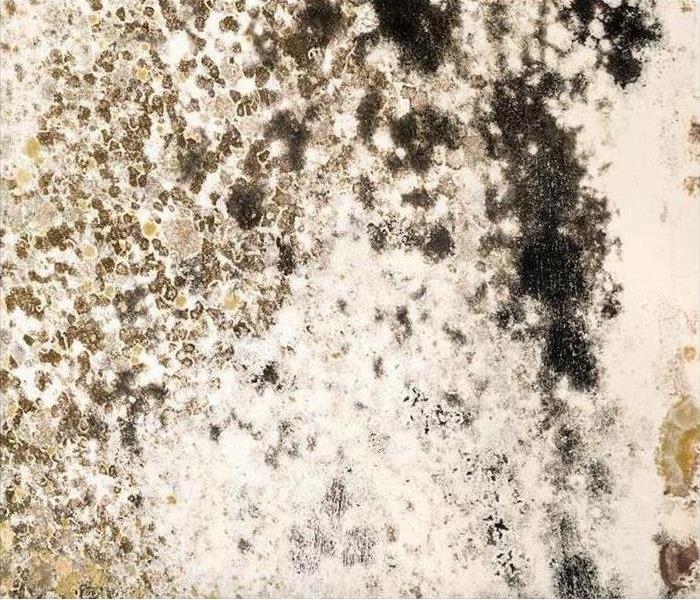 SERVPRO of West Riverside City uses advanced mold remediation techniques and equipment
SERVPRO of West Riverside City uses advanced mold remediation techniques and equipment
Discovery Of Mold Damage
There are several stories about people discovering pieces of the past, some of which were very valuable, while they were in the process of remodeling their home. Others end up finding problems. One of these more unpleasant discoveries sometimes includes different types of damage. It can often result in increased costs instead.
Adding on to your home or upgrading it can end up with the discovery of mold damage. Few construction crews are qualified to handle the disposal of mold contamination. Without an expert in mold remediation and containment, contamination of other areas in your home can happen quite easily. SERVPRO has the ability to work alongside other crews to remediate mold correctly, so future problems do not become a reality.
Our professional team members are trained according to IICRC standards, and then given experience working with other employees. Our customers receive the best of both types of training. When remodeling, or another kind of work, is ongoing, discoveries such as mold damage can be surprising. We can install temporary plastic sheeting if it has not already been put in place, or expand the area contained if needed. As the remodeling crew removes damaged materials, we can dispose of these pieces of drywall, wood, or other material correctly, and then check for more areas that are affected by mold patches.
Giving your family the gift of an improved home is one that can be costly but is also well worth the price. Mold can put a dent in your investment, but the incorrect handling of an infestation of mold can make matters much worse. SERVPRO of West Riverside wants to help you protect your family and your investment from harm. Call us at (951) 351-8033 whenever you find mold growing out of control in your home so we can remediate things correctly for you.
Most Common Causes of Water Damage in Your West Riverside Home
11/14/2018 (Permalink)
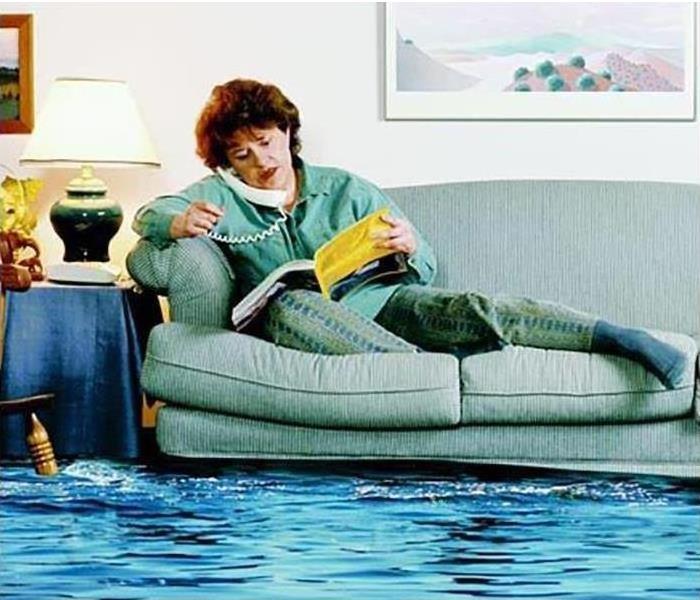 Call SERVPRO of West Riverside City if you have water damage in your home or commercial property, we are here to help! 951-351-8033
Call SERVPRO of West Riverside City if you have water damage in your home or commercial property, we are here to help! 951-351-8033
Most Common Causes of Water Damage in the Home
Sometimes, homeowners and property managers may need urgent West Riverside water damage restoration and not even be aware of it. At SERVPRO, we know that it's quite common for homeowners to assume that they won't don't need any help from the professionals until something dramatic like a burst pipe or heavy rain fall occurs.
Though, it is far more normal for water destruction to come as a thief in the night, sneaking slowly throughout your home, causing graduation deterioration and damage. Standing water may also cause sanitary, and health issues, and will decrease your home's efficiency. Even worse, slowly-spreading West Riverside water damage can play host to mold colonies, weaken critical structural beams and cause other forms of widespread damage throughout your home.
Here are a few common situations that could potentially lead to slow water destruction:
Flat Roofs
While many homes are perfectly legal with a flat roof, a more standard sloped roof is far more efficient and redistributing rainwater. Of course, most flat roofs are not completely flat and are build with a small slope, but if branches or other debris build up, water can deform and damage your roof.
Leaky Plumbing
Sometimes people dismiss leaking pipes and other parts of their plumbing system, assuming that it won't be a big problem. A water leak that affects your floor boards might be more than enough to invite toxic black mold into your home. Homeowners should check the acidity of their home water to make sure that the copper lining of their pipes is not being destroyed.
Gutters & Drains
When installed properly and clean, your gutter and drainage system should easily be able to disperse rainwater safely away from your home or building. Unfortunately, if gutters and drains get clogged with leaves and other debris, a dam can form, leading water to overflow its bounds and cascade down the walls of your home. When your walls start to become continually wet, they will begin to break down and cause severe damage to the structural integrity of your home or property.
Other Problems
Homeowners worried about these, and other potential sources of water destruction should contact their local Riverside city restoration professionals. A professional will be able to help you quickly restore your home to its full comfort. At SERVPRO West Riverside City, we have years of experience in helping homeowners and property managers quickly remove and repair water problems.
Locally Owned Company with National Resources
We live and work in this community too; we might even be neighbors. As a locally owned and operated business, SERVPRO of West Riverside City is close by and ready to respond to your flood or water damage emergency.
Earthquake Preparedness in Riverside City
11/12/2018 (Permalink)
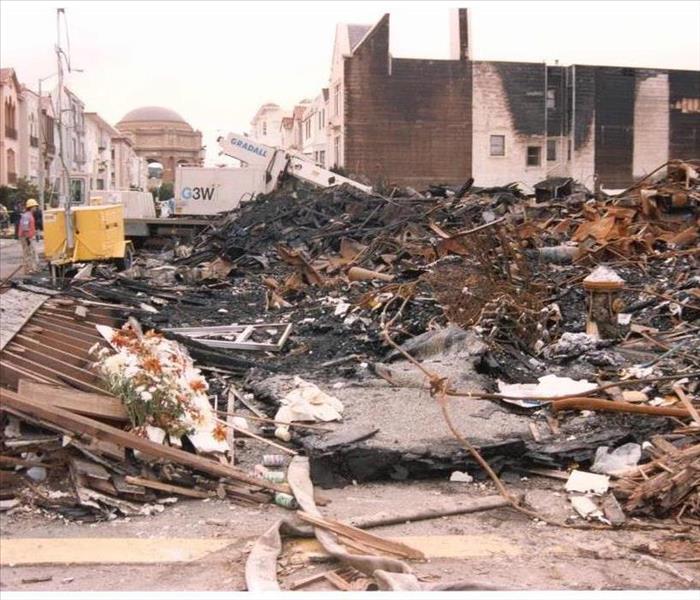 Photo by Fema News Photo- The devastation after the San Francisco earthquake in 1989
Photo by Fema News Photo- The devastation after the San Francisco earthquake in 1989
Tuesday, October 17, 1989:
A powerful 6.9 earthquake shook San Francisco for a minimum of ten consecutive seconds...
It was during the Game 3 warm-up. Some 12,000 homes were wrecked beyond habitability. Natural gas lines ruptured and set fires to buildings in the Marina district.
Earthquakes can collapse buildings and cause heavy items to fall, resulting in injuries and property damage.
We all know that earthquakes are a common occurrence in California and other parts of the West Coast regions, but earthquakes can happen at any time of the year and occur without warning. After the initial earthquake, the aftershock may follow. Most are smaller than the initial earthquake but larger magnitude aftershocks also occur. Earthquakes may cause household items to become dangerous projectiles; cause buildings to move off foundations or collapse, damage utilities, roads and structures such as bridges and dams, or cause fires and explosions. They may also trigger landslides, avalanches, and tsunamis.
SERVPRO of West Riverside City wants to emphasize the importance of preparation before an earthquake strike. By making an effort to be prepared and having a plan of action in place, you can lessen the impact a disaster might have on you, your home and your family.
Learn and follow these steps now to PREPARE before, during, and after an earthquake.
What to Do Before an Earthquake:
Make sure you have a fire extinguisher, first aid kit, a battery-powered radio, a flashlight, and extra batteries at home.Secure items that could fall or move and cause injuries or damage such as; bookshelves, picture frames, mirrors, light fixtures, televisions, computers, hot water heaters, etc.Learn how to turn off the gas, water, and electricity.Make up a plan of where to meet your family after an earthquake.Don’t leave heavy objects on shelves as they can fall during an earthquake.Learn the earthquake plan at your school or workplace.What to Do During an Earthquake:
Stay calm and stay put.If you’re indoors, DROP to the ground; take COVER by crawling under a sturdy table or stand in a doorway. If under a desk or heavy table, cover your head and neck with your arms and HOLD ON until the shaking stops.If there isn’t a desk or sturdy table nearby, crawl away from windows, next to an interior wall. Stay away from glass, windowsIf you’re outdoors, stay away from building, trees, power lines or anything that might fall.If you’re driving, move away from overpasses, stop slowly in a safe area and stay in your vehicle.Don’t use elevators (they’ll probably get stuck anyway). Don’t run out of the building during the shaking as objects may be falling off the building and cause serious injuries or death.What to Do After an Earthquake:
When the shaking stops, check yourself and others for injuries.If the building is damaged, safely evacuate, go to an open space away from damaged areas.Check water, gas, and electric lines for damage. If any are damaged, shut off the valves to avoid fire and hazardous leaks.Be careful of around broken glass and debrisInspect your chimneys for unnoticed damaged that could lead to fires.Stay away from beaches. Tsunamis sometimes hit after the ground has stopped shaking.If you’re at school or work, follow the emergency plan or the instructions of the person in charge.If your home or business suffers from earthquake damage, call our professionals at SERVPRO of West Riverside City. We can respond quickly and help make disasters, "Like it never even happened."
Any Questions - Call Us Today 951-351-8033
SERVPRO is a Proud Sponsor of the First Responder’s Bowl
11/7/2018 (Permalink)
SERVPRO First Responder Bowl at Cotton Bowl Stadium
SERVPRO of West Riverside City is excited to announce that the Cotton Bowl Stadium football bowl game in f Dallas has been renamed the SERVPRO First Responder Bowl!
We’re proud to honor and support the service of all America’s First Responders. These brave men and women keep our communities safe every day of the year. First Responders include firefighters, police, EMS workers, military members, and more.
Kickoff is set for December 26, 2018 at 12:30 P.M. Central. ESPN will televise the game, and tickets go on sale in September.
"We are proud to present the SERVPRO First Responder Bowl dedicated to honoring some of the hardest working men and women in our country," says CEO of SERVPRO Industries, Sue Steen. "We recognize the dedication and selfless acts of our First Responders and are honored to help highlight and celebrate the commitment of these everyday heroes."
The 2018 SERVPRO First Responder Bowl is part of almost 90 years of history of games played at Cotton Bowl Stadium on the grounds of Fair Park in Dallas.
“This is an exciting change, and we are humbled by the fact that an actual bowl game has been named exclusively for the first responders of this country,” says Dallas Fire Rescue Fire Chief David Coatney.
“We are truly honored to have a bowl game here in Dallas named after the hard working men and women serving and protecting communities across this country. It always feels great to be recognized, and I know our officers and firefighters are touched by this overwhelming show of support,” says Dallas Police Chief, Ms. Renee Hall.
SERVPRO has always had a very special relationship with America’s First Responders and we have a deep and strong appreciation for their efforts. Many times we follow them as “second responders” after fires, storms and other emergencies. It is a tremendous privilege to honor these brave men and women and spotlight their service and sacrifices made for us all. It’s hard to think of a more appropriate cause or a more appropriate sponsor for this game.
Visit First Responder Bowl for information as it becomes available.
What Should Renters Do After A Riverside Apartment Fire?
11/5/2018 (Permalink)
Fire damages can be devastating. Even when your home isn’t completely affected, fire damage victims still have to handle significant losses. When you’re a renter at an apartment complex, many questions may enter your mind:
Is the apartment complex responsible for fire damage costs or am I?Does my insurance cover my fire damage?Where will I go?How will I get all my stuff back?How long will it take to get my apartment back?Handling a fire damage can easily become overwhelming.
We’ve helped many renters that have experienced a fire in their apartment in all of Riverside City. Our team knows how to work with apartment complexes, landlords, and insurance providers to help restore your life. We can help you, too.
Apartment Fires and Insurance Claims
When you call us to handle your fire damage restoration, you will be assigned a crew chief from our office. Their responsibility is to establish a relationship with your insurance adjuster. They will communicate with them day to day about the status of your claim. We’ll work with them to:
Establish your fire damage restoration coverage.Ask for approval to clean and restore any contents that could be saved from the fire.Ask for approval to clean your smoke and fire damaged clothing.Ask for approval to store your contents as your apartment is being cleaned and restored.Process and close your fire damage claim.Content Cleaning (Household Items)
Content is what we call everything that is inside your apartment. They are all the belongings you and your family have inside.
The first step when content cleaning is to identify all the items inside your apartment. We separate them into two categories:
Salvageable. These are items that can be cleaned, deodorized, and sanitized. They are inventories and moved to our cleaning facility. Once they’re cleaned, we store them until you’re ready to receive them again.Unsalvageable. These are items that are permanently damaged and cannot be cleaned. We do our best to identify these items and report them to your insurance company so they can determine the replacement cost. Sometimes, the contents are so badly burnt that we cannot identify them. After we have identified everything we and send the inventory to your insurance company, we ask for your permission to dispose of them.Trusted Leader in Fire Damage Restoration in Riverside California
SERVPRO of West Riverside City is a water damage restoration and fire and smoke damage restoration company in Riverside, California. With our crew responding immediately to jobs, we are faster to any size disaster.
We are available for 24 hour emergencies every day of the year. We can be reac
10 Things You Should Know About Mold
10/29/2018 (Permalink)
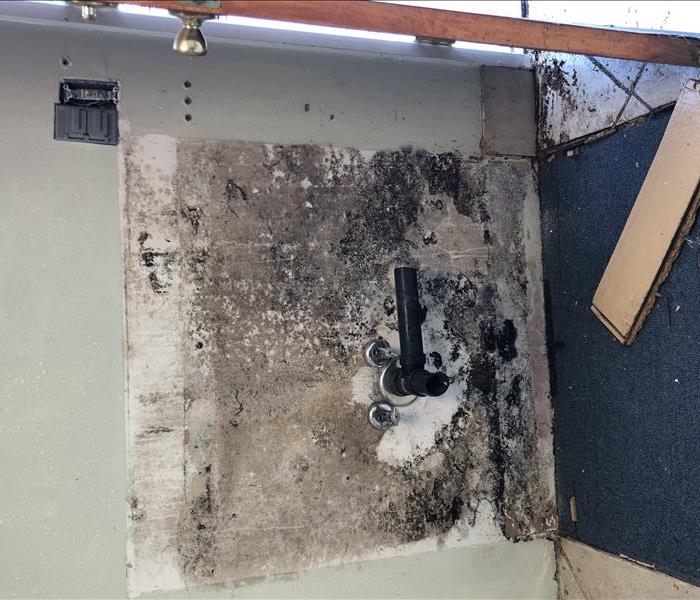 Mold in a residential home in Riverside
Mold in a residential home in Riverside
Tips from our friends from United States Environmental Protection Agency (EPA)
1. Potential health effects and symptoms associated with mold exposures include allergic reactions, asthma and other respiratory complaints.
2. There is no practical way to eliminate all mold and mold spores in the indoor environment; the way to control indoor mold growth is to control moisture.
3. If mold is a problem in your home or school, you must clean up the mold and eliminate sources of moisture.
4. Fix the source of the water problem or leak to prevent mold growth.
5. Reduce indoor humidity (to 30-60%) to decrease mold growth by:
• Venting bathrooms, dryers and other moisture-generating sources to the outside
• Using air conditioners and de-humidifiers
• Increasing ventilation
• Using exhaust fans whenever cooking, dishwashing and cleaning
6. Clean and dry any damp or wet building materials and furnishings within 24-48 hours to prevent mold growth.
7. Clean mold off hard surfaces with water and detergent, and dry completely. Absorbent materials such as ceiling tiles, that are moldy, may need to be replaced.
8. Prevent condensation: Reduce the potential for condensation on cold surfaces (i.e., windows, piping, exterior walls, roof, or floors) by adding insulation.
9. In areas where there is a perpetual moisture problem, do not install carpeting (i.e., by drinking fountains, by classroom sinks, or on concrete floors with leaks or frequent condensation).
10. Molds can be found almost anywhere; they can grow on virtually any substance, providing moisture is present. There are molds that can grow on wood, paper, carpet, and foods.
Contact Us 951-351-8033 to ask a question, provide feedback, or report a problem.
From EPA.gov
Halloween Fires-Ensure that Halloween is a safe holiday for everyone in Riverside
10/24/2018 (Permalink)
 Halloween fires occurred most frequently in the late afternoon and early evening hours, peaking between 6 p.m. and 7 p.m.
Halloween fires occurred most frequently in the late afternoon and early evening hours, peaking between 6 p.m. and 7 p.m.
Candle flames and flammable costumes can be a dangerous combination
- COSTUMES: Flame-resistant fabrics, such as polyester and nylon, are best. They should be brightly colored or trimmed with reflective tape to make them visible to motorists at dusk and in the dark.
- MASKS: Check that eye holes are large enough to allow full visibility and nose holes allow for adequate breathing.
- CANDLES: Keep candle-lit jack-o-lanterns and other decorations where children cannot brush against the flame. Try LED lights instead.
- TREATS: Put reflective tape on treat bags. No toys with small parts for children under 3.
October is Fire Protection Month here in West Riverside and across the US
10/22/2018 (Permalink)
Pet Fire Safety
Home fires are the most common disaster that the American Red Cross responds to – and also the most preventable.
- The best way to protect your pets from the effects of a fire is to include them in your family plan. This includes having their own disaster supplies kit as well as arranging in advance for a safe place for them to stay if you need to leave your home.
- When you practice your escape plan, practice taking your pets with you. Train them to come to you when you call.
- In the event of a disaster, if you must evacuate, the most important thing you can do to protect your pets is to evacuate them, too. But remember: never delay escape or endanger yourself or family to rescue a family pet.
Prevent Your Pets from Starting Fires
The National Fire Protection Association estimates that nearly 1,000 home fires each year are accidentally started by the homeowners' pets.
The American Kennel Club and ADT Security Services have joined forces to provide the following tips:
- Extinguish Open Flames - Pets are generally curious and will investigate cooking appliances, candles, or even a fire in your fireplace. Ensure your pet is not left unattended around an open flame and make sure to thoroughly extinguish any open flame before leaving your home.
- Remove Stove Knobs - Be sure to remove stove knobs or protect them with covers before leaving the house - a stove or cook top is the number one piece of equipment involved in your pet starting a fire.
- Invest in Flameless Candles - These candles contain a light bulb rather than an open flame, and take the danger out of your pet knocking over a candle. Cats are notorious for starting fires when their tails turn over lit candles.
- Secure Young Pets - keep them confined away from potential fire-starting hazards when you are away from home such as in crates or behind baby gates in secure areas.
Help Firefighters Help Your Pets
- Keep pets near entrances when away from home. Keep collars on pets and leashes at the ready in case firefighters need to rescue your pet. When leaving pets home alone, keep them in areas or rooms near entrances where firefighters can easily find them.
- Affix a pet alert window cling and write down the number of pets inside your house and attach the static cling to a front window. This critical information saves rescuers time when locating your pets. Make sure to keep the number of pets listed on them updated.
Fire Safety for Kids in West Riverside City
10/17/2018 (Permalink)
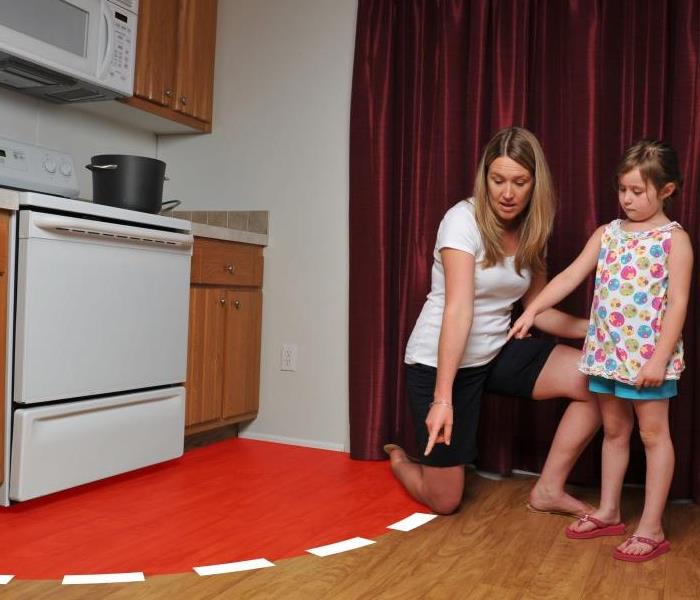 Teach children the importance of remaining at a safe distance from a stove
Teach children the importance of remaining at a safe distance from a stove
Tips from our friends at American Red Cross
A home fire is a devastating event, and one that you never count on happening. Your children are most at risk when this disaster occurs. In fact, children under five are twice as likely as other people to die in a home fire. Tragically, many home fires are started by children playing with dangerous household items – especially lighters and matches. Taking sensible precautions in the home and teaching your child how to escape from a fire can help your family avoid this type of heartbreak.
Prevent Your Child from Starting Fires
The U.S. Fire Administration estimates that 300 people are killed and $280 million in property is destroyed each year as the result of children playing with fire.
Keep matches, lighters and other ignitable substances in a secured location out of your child’s reach. Only use lighters with child-resistant features.Invest in flameless candles. These candles contain a light bulb rather than an open flame, and take the danger out of your child knocking over a candle.Help Your Child Survive a Fire
Install smoke alarms on every level of your home, inside bedrooms and outside sleeping areas. Once a month check whether each alarm in the home is working properly by pushing the test button. Replace batteries in smoke alarms at least once a year. Immediately install a new battery if an alarm chirps, warning the battery is low.Teach your children what smoke alarms sound like and what to do when they hear one.Ensure that all household members know two ways to escape from every room of your home, and where to meet up outside..Practice your fire escape plan at least twice a year and at different times of the day. Practice waking up to smoke alarms, low crawling and meeting outside. Make sure everyone knows how to call 9-1-1.Emphasize “get out, stay out.” Only professional firefighters should enter a building that is on fire—even if other family members, pets or prized possessions are inside.Use quick-release devices on barred windows and doors. Security bars without release devices can trap you in a deadly fire. If you have security bars on your windows, be sure one window in each sleeping room has a release device.Consider getting escape ladders for sleeping areas on the second or third floor. Learn how to use them, and store them near the windows.
Common Mistakes You're Making with Your "Small" Water Damage in West Riverside City
10/15/2018 (Permalink)
When Water Damage Strikes
When finding themselves in the midst of a water damage event, many people immediately react by jumping in and cleaning up the mess. Beginning the restoration process as soon as possible is important, but starting before you have taken the necessary steps or know exactly what you are doing could actually make things worse in the end. To help avoid these mishaps, a few of the most common mistakes in water damage clean up are listed below. The most critical mistake to not make is failing to hire a professional restoration company to do the dirty work for you. SERVPRO of West Riverside City is your local expert to help you navigate the “waters”.
Mistake #1- Not Having the Job Done RIGHT the First Time
Adopting the “do it yourself” approach when it comes to water damage clean-up is often the go-to mindset. However, this is usually a more difficult process than people think. It can be a long process and following the proper procedures is very important. For example, if you neglect to begin airing out your home by opening up windows and doors for ventilation and using fans to dry things out as soon as possible, the damage will eventually be worse.
Mistake #2- Not Being Completely Thorough
As mentioned above, the water damage restoration process done right requires that you be very thorough. Cutting corners and major shortcuts will not make a big difference and can actually cause more damage. It is better to have the job done right up front, but it will not happen overnight. To ensure all the water is removed and mold will not begin to grow on and in your walls, ceilings, and carpet, you will want to make sure your contractor is certified to do the work needed in an appropriate time frame.
Mistake #3- Waiting Too Long
It can be tempting to put off dealing with flooding or water damage when it’s just a small incident, especially when life is hectic. Even minor flooding can lead to major damage in the long run. The water seeps into walls and flooring over time when not dried properly and can cause structural damage and mold growth. It’s not worth the risk to procrastinate. It could save you a lot of time, heartache, and money in the long run.
Mistake #4- Not Involving a Certified Restoration Company
Trying to tackle the water damage restoration process on your own is great undertaking. Having it done right the first time requires the proper expertise, the right equipment, and enough time to be as thorough as required. Though it may seem like you have the time and resources to clean it up, you will soon realize the process is more involved than originally thought. Should you ever find yourself in a situation where your home or business has been compromised by flooding or water damage, don’t hesitate to contact the professionals at SERVPRO of West Riverside City.
Let SERVPRO of West Riverside City help you recover your property properly following a water damage event. Call us today – 909-351-8033.
How to Prevent Outdoor Cooking Fires!
10/10/2018 (Permalink)
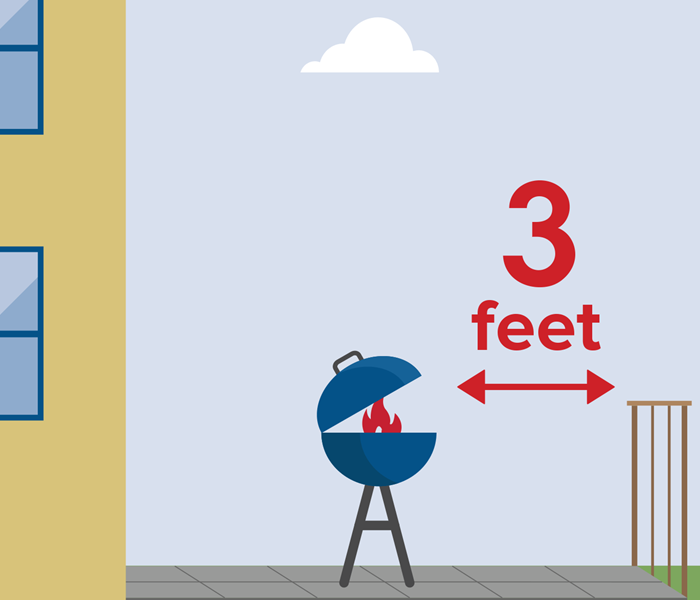 Place your grill at least 3 feet from siding, deck railings, eaves and overhanging branches.
Place your grill at least 3 feet from siding, deck railings, eaves and overhanging branches.
Grill fires cause an estimated $37 million in property loss each year.
Almost half of home grill fires happen between 5 and 8 p.m.Fifty-seven percent of home grill fires occur during the months of May, June, July and August.Patios, terraces, screened-in porches and courtyards are leading home locations for grill fires.Seventy-nine percent of all home grill fires involve gas grills.“Mechanical failure, malfunction” is the leading factor in the start of grill fires. Leaks or breaks of containers or pipes are often to blame.Source: Grill Fires on Residential Properties
Grilling fire safety tips:
Only use grills outdoors, away from siding and deck railings.Clean grills often and remove grease or fat build-up.Make sure your gas grill lid is open before lighting.Have a 3-foot safe-zone around grills and campfires. Keep kids and pets away from the area.Dispose of coals after they have cooled in a metal can.Never leave grills, fire pits and patio torches unattended.
Oct 7-13 is Fire Prevention Week
10/8/2018 (Permalink)
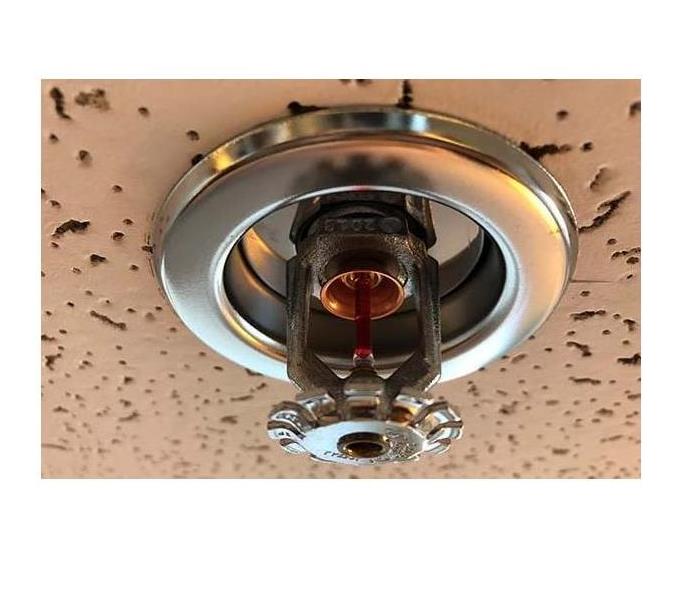 SERVPRO of West Riverside city increasing awareness of the life-saving and financial benefits of home fire sprinklers in our community.
SERVPRO of West Riverside city increasing awareness of the life-saving and financial benefits of home fire sprinklers in our community.
More than 50 percent of cooking fires are caused by grease according to the National Fire Protection Association (NFPA)...
“Look. Listen. Learn. Be aware – fire can happen anywhere.”
Prevent Kitchen Fires
Did you know? Cooking is the main cause of home fires and fire injuries. You can prevent cooking fires. Take these steps to keep your family safe!
Smoke alarms
Three out of five home fire deaths result from fires in properties without working smoke alarms.
- Choose interconnected smoke alarms, so when one sounds, they all sound.
- Put smoke alarms inside and outside each bedroom and sleeping area. Put alarms on every level of the home.
- Make sure your smoke alarms work. Your family is not safe if they can’t hear the smoke alarms.
- Test smoke alarms every month and replace 9-volt smoke alarm batteries at least once every year.
- Smoke alarms do not last forever. Get new smoke alarms every 10 years.
- When you hear a smoke alarm, you may have less than 2 minutes to get everyone outside and safe.
Fire Escape plan
If there is a fire in your home, you could have less than 2 minutes to get out safely once the smoke alarm sounds.
Make a fire escape plan. Draw a map of each level of your home showing all doors and windows. Discuss the map with everyone who lives with you.Plan two ways out of every room. Choose an outside meeting place in front of your home.Make a fire escape plan around your abilities. If you need to use a wheelchair or a cane, make sure you can get to it easily and get out quickly. If you wear hearing aids or eyeglasses, put them next to your bed while you are sleeping.Make sure all doors and windows open easily.Practice your fire escape plan by having a home fire drill at least twice a year with everyone in the home.If there is a fire in your home, get out and stay out. Never go back inside for people, pets or things.Home Fire Sprinklers
Installing sprinklers and smoke alarms in your home increases your chance of surviving a fire by more than 82 percent.
Safer fire service: The risk to firefighters is much less. Sprinklers reduce the heat, flame and smoke from a fire.Fast response: Home fire sprinklers are more sensitive to heat than those found in businesses or industrial buildings. This means the fire will be detected much sooner.Can blend with your home decor: You can buy home fire sprinklers in different colors. Some can be installed flush with the ceiling, so you will hardly notice they are there.Reliable: Home fire sprinklers only spray when the temperature in the room rises quickly. The sprinkler above the fire is the only one that sprays.Investment protection: Sprinklers can prevent devastating home damage by putting out flames quickly. Sprinklers can limit the damage caused by smoke and fire. They are less damaging than water damage caused by firefighting hose lines.Easy installation: Installing a home sprinkler system in a home under construction or being remodeled requires a little extra piping and labor and greatly increases the safety of residents.Low water requirement: Home fire sprinklers can be connected to the home water supply. They require less water than business and industrial systems.Low cost: A sprinkler costs about $1.35 per square foot. This cost is about the same as upgraded cabinets or carpet.Lower insurance: Installing a sprinkler system has the potential to lower insurance rates by 5-15 percent by meeting code requirements.
October is Fire Protection Month here in West Riverside and across the US
10/3/2018 (Permalink)
Tips for Making a Claim After a Fire
When a fire damages your home in Riverside, CA, you may not be in the right frame of mind for making good decisions. The decisions you make regarding your fire insurance claim, however, can affect how much of the fire restoration is covered by your insurer. Here are three tips to help you think through the process rationally and hopefully get the settlement you need to restore your home.
1. Call Insurance Company
One of the first calls you make after a fire has ravaged your home is to the insurance company. Timely reporting is essential to getting your claim processed and approved. As soon as the company receives your call, an assessor can be sent to review the damage and substantiate your claim.
2. Call Professional Restorers
After a fire, your home is likely permeated with the odor of smoke and soot damage. Firefighters probably had to use a lot of water to put out the fire, resulting in water damage as well. Certified fire restoration specialists offer both smoke cleaning and water damage remediation to fix the problems in your home. They often offer board-up services to secure the house during the restoration process, and they can give you an estimate on what the repairs are going to cost, which can back up your claim with the insurance company.
3. Don't Touch Anything
Once you have made the necessary calls and the waiting begins, you may be tempted to start cleaning up the damage yourself. Fight the urge to do so. The insurance agent that comes to assess the damage needs to see it as it is, and without the knowledge and skills of the specialists, you may cause more damage. While you wait, it is a good idea to take pictures of the damage as long as it is safe to do so.
You may feel powerless when your home suffers fire damage. By calling the appropriate professionals and waiting on their guidance, however, you can speed up the fire restoration process.
October is Fire Protection Month here in West Riverside and across the US
10/2/2018 (Permalink)
As Fire Prevention Week approaches, the West Riverside City Fire Department encourages residents to “Look. Listen. Learn.” What does that mean?
Look for places fire could start.Listen for the sound of the smoke alarm.Learn 2 ways out of every room. Every year, the majority of fire deaths in North America happen at home. Today’s home fires burn faster than ever. In a typical home fire, you may have as little as one to two minutes to escape safely from the time the smoke alarm sounds.
Home Fire Escape Planning:
• Home fire escape planning and drills are an essential part of fire safety. A home fire escape plan needs to be developed and practiced before a fire strikes.
• A home escape plan should include the following:
- Two exits from every room in the home – usually a door and a window
- Properly installed and working smoke alarms
- A meeting place outside, in front of the home, where everyone will meet after they exit
- A call to 9-1-1 or the local emergency number from a cell phone or a neighbor’s phone Smoke Alarms
• Smoke alarms detect and alert people to a fire in the early stages. Smoke alarms can mean the difference between life and death in a fire.
• Working smoke alarms cut the risk of dying in a home fire in half.
• Install smoke alarms in every sleeping room, outside each separate sleeping area, and on every level of the home, including the basement.
• Test smoke alarms at least once a month using the test button.
• Make sure everyone in the home understands the sound of the smoke alarm and knows how to respond. Cooking
• Cooking is the leading cause of home fires and home fire injuries. The leading cause of fires in the kitchen is unattended cooking.
• Stay in the kitchen when you are frying, boiling, grilling, or broiling food.
• If you are simmering, baking, or roasting food, check it regularly and stay in the home.
• Keep anything that can catch fire away from your stovetop. Heating
• Heating equipment is one of the leading causes of home fires during the winter months.
• Space heaters are the type of equipment most often involved in home heating equipment fires.
• All heaters need space. Keep anything that can burn at least 3 feet (1 meter) away from heating equipment.
• Have a 3-foot (1-meter) “kid-free zone” around open fires and space heaters.
• Purchase and use only portable space heaters listed by a qualified testing laboratory.
• Have a qualified professional install heating equipment.
• Maintain heating equipment and chimneys by having them cleaned and inspected by a qualified professional
For more information on recovering from fire damage, contact SERVPRO of West Riverside City- 951-351-8033, were here to help our neighbors
How To Safely Put Out a Grease Fire
9/27/2018 (Permalink)
More than 50 percent of cooking fires are caused by grease according to the National Fire Protection Association (NFPA)
Your home’s kitchen is where heat, electricity, water, and grease come together. It’s no wonder, kitchen fires are the number one cause of home fires. And the most common type of kitchen fire is a grease fire. A grease fire is extremely dangerous as it can get out of control quickly and spread from the stove throughout the kitchen and other rooms of the house.
There are two common types of grease fires in the kitchen. One is in the cooking pan itself and the other is under the burner in the drip pan. Often, drip pan fires result from previous cooking sessions. When something is spilled into the drip pan it cannot be cleaned until the burner and the stove has cooled. It’s not uncommon for people to forget to go back and clean the drip pan, setting themselves up for trouble the next time they cook.
Here are some tips for preventing kitchen grease fires:
- Before cooking anything, make sure the burner is cool and wipe up any spills in the drip pan and around the burner before turning on the heat.
- The most common reason for a grease fire is leaving a hot pan unattended. Keep your eye on all pans while cooking.
- Pay attention to heat ratings for cooking oil. Some oils can be heated more than others before catching fire. If you are cooking and the oil starts to smoke, it is too hot. The flash point of a grease fire is 500 degrees Fahrenheit. Grease will smoke furiously before it ignites, so if you notice smoke, turn down the heat immediately.
- Keep cookbooks, towels, paper towels and anything combustible away from the stove. A grease fire can quickly turn into a bigger fire if it catches onto other combustibles.
- Avoid heating grease before putting food into it. Food can fall quickly into the grease and make it splash out, causing grease burns to you or hitting the heat source and catching fire.
- When deep frying, use a pan or cooking container designed for deep frying that will allow equal space of the grease and food contents above what you are frying. For example, if you are cooking chicken and the grease and chicken are three inches deep, the pan sides should be at least six inches deep.
- Have a class ABC fire extinguisher in your kitchen. Experts recommend having at least three fire extinguishers in your home; in the kitchen, garage and main living area.
- If a pan does catch fire, the best thing to do is smoother it, by using an oven mitt and placing a lid on top of the pan or by using a fire extinguisher. NEVER throw water on the fire or try to run it to the sink or outside.
And if a kitchen grease fire does get out of control, resulting in damage or odor to your home, our experts at SERVPRO of West Riverside are here to help. We can clean your home "Like it never even happened."
Prepare For Emergencies Now: Information For Pet Owners.
9/25/2018 (Permalink)
 SERVPRO West Riverside City mascot, Ellie, is ready for any emergency!
SERVPRO West Riverside City mascot, Ellie, is ready for any emergency!
Preparing Your Pets for Emergencies Makes Sense. Get Ready Now.
If you are like millions of animal owners nationwide, your pet is an important member of your household. The likelihood that you and your animals will survive an emergency such as a fire or flood, tornado or terrorist attack depends largely on emergency planning done today. Some of the things you can do to prepare for the unexpected, such as assembling an animal emergency supply kit and developing a pet care buddy system, are the same for any emergency. Whether you decide to stay put in an emergency or evacuate to a safer location, you will need to make plans in advance for your pets. Keep in mind that what’s best for you is typically what’s best for your animals. If you must evacuate, take your pets with you if possible. However, if you are going to a public shelter, it is important to understand that animals may not be allowed inside. Plan in advance for shelter alternatives that will work for both you and your pets. Make a back-up emergency plan in case you can’t care for your animals yourself. Develop a buddy system with neighbors, friends and relatives to make sure that someone is available to care for or evacuate your pets if you are unable to do so. Be prepared to improvise and use what you have on hand to make it on your own for at least three days, maybe longer.
SERVPRO Emergency Ready Profile
9/20/2018 (Permalink)
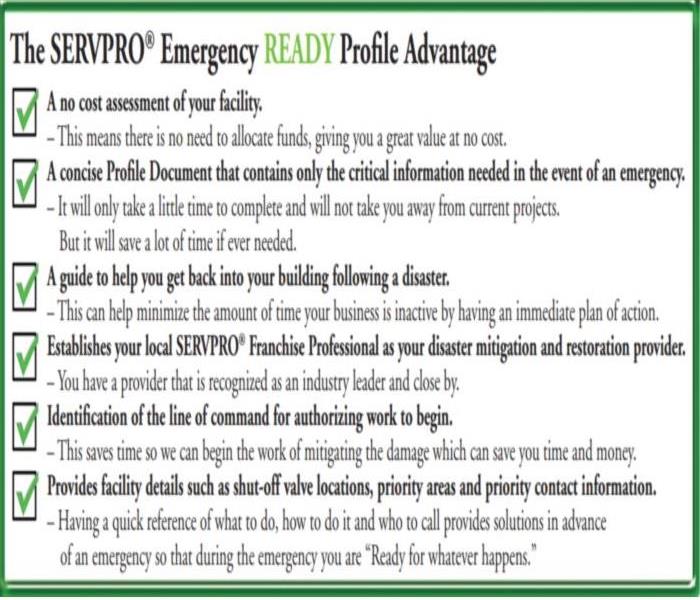 SERVPRO is a leader in water and fire damage response and can help you quickly get your property back in working order.
SERVPRO is a leader in water and fire damage response and can help you quickly get your property back in working order.
Are You "Ready for Whatever Happens" in Riverside?
Preparation is a key component for making it through any size disaster, whether it’s a small water leak, a large fire, or an area flood. The best time to plan for such events is not when the event happens, but well before it happens.
The SERVPROEmergency READY Profile serves as a quick reference of important building and contact information or can be an ideal supplement to any well-designed emergency preparedness or existing contingency program. Rather than simply reacting to disaster situations, most prefer proactive measures to establish a relationship with a restoration services company.
By working with SERVPRO of West Riverside City to develop your personalized Emergency READY Profile your business will receive the benefit of over 40 years of experience in reducing the impact of any natural or man-made disaster. SERVPRO is a leader in water and fire damage response and can help you quickly get your property back in working order.
Call us Today for a No Cost Assessment
of Your Facility!
What Happens When You Call Us?
9/17/2018 (Permalink)
Got Water Damage? Wonder What Happens once you Call?
Within Minutes
Water quickly spreads throughout your property, saturating everything in its path.Water is absorbed into walls, floors, upholstery, and belongings.Furniture finishes may bleed, causing permanent staining on carpets.Photographs, books, and other paper goods start to swell and warp.Hours 1 - 24:
Drywall begins to swell and break down.Metal surfaces begin to tarnish.Furniture begins to swell and crack.Dyes and inks from cloth and paper goods spread and stain.A musty odor appears.48 Hours to 1 Week:
Mold and mildew may grow and spread.Doors, windows, and studs swell and warp.Metal begins to rust and corrode.Furniture warps and shows signs of mold.Paint begins to blister.Wood flooring swells and warps.Serious biohazard contamination is possible.More Than 1 Week:
Restoration time and cost increase dramatically; replacing contaminated materials and structural rebuilding may be extensive.Structural safety, mold growth, and biohazard contaminants pose serious risks to occupants.Here at SERVPRO of West Riverside City we specialize in the cleanup and restoration of residential and commercial property after a fire, smoke or water damage event. Our staff is highly trained in property damage restoration. From initial and ongoing training at SERVPRO’s corporate training facility to regular IICRC-industry certification, rest assured our staff is equipped with the knowledge to restore your property.
Emergency Preparedness Month-Life Saving Skills for Riverside City
9/12/2018 (Permalink)
What You Should Know About Life Saving Skills
- Know basic preparedness skills to protect your family and home.
- Eliminate common electrical and fire hazards around your house and property.
- Install smoke, carbon monoxide, and natural gas alarms and test them monthly.
- Teach children what to do when they hear smoke, carbon monoxide, and natural gas alarms.
- Place natural gas detectors on every level of your home and test them monthly.
- Know how to turn off utilities like natural gas in your home.
- Talk to your landlord or building manager about evacuation routes and fire safety.
- Develop and practice a family communication plan and discuss it with your family.
- Have emergency supplies in place at home, at work, and in the car.
- Pay attention to alerts and warnings.
- Know two ways out of your home in the event of a fire and practice evacuation plans.
- Set some money aside from your income in case of an emergency.
. Fire Safety
- Do a fire drill with your children regularly.
- Make sure your family knows two ways out of your home.
- Identify two ways out of every room when making your fire escape plan.
- Meet with your landlord or building manager to learn about the fire safety features in your apartment building.
- #DidYouKnow your apartment building should hold a fire drill with residents once a year? You should participate.
- Know your apartment building’s evacuation plan, in case of a fire.
- Identify each exit in your apartment building before an emergency like a fire.
- Memorize the number in case you have to find the exit in the dark.
- Talk to your family about what they should do in a fire.
- Put smoke, carbon monoxide, and natural gas alarms on every level of your home and close to bedrooms.
- Be sure your smoke, carbon monoxide, and natural gas alarms work by testing them monthly.
- Get a smoke, carbon monoxide, and natural gas alarm with flashing lights or vibrating signals if you’re deaf or hard of hearing.
- Keep electrical cords tangle free to help prevent possible fires.
- Remove electrical cords from under a carpet or rug. It is a fire hazard!
- Do not overload power strips. This can cause a fire.
Power Outage
- Create or update your emergency supplies with this list: Build a Kit
- Get ahead of the next disaster by making sure you have emergency supplies: Build a Kit
- Gather the supplies you may need if there is a power outage Build a Kit
- Have emergency supplies at home in case there is a power outage.
- Learn what supplies you may need when a power outage happens at Power Outage
- Stock up on batteries for flashlights, radios, medical devices, and phones in case there is a power outage.
- Always have extra batteries in your emergency kit: Build a Kit
- Ask your doctor or health care provider about how you can prepare for a power outage if you have medical needs.
- Make sure your loved ones who use medical equipment can keep using it if there is a power outage.
- Have medication for at least three days in your emergency supplies.
- If you have medical needs and rely on medical equipment, make a plan before a power outage or other emergency: Home Medical Devices That Require Electricity
- Keep water, non-perishable food and other supplies at home.
- Check the expiration date on your emergency supplies, and replace any old items.
Natural Gas
- Protect your family by putting natural gas detectors in your home.
- Install natural gas detectors throughout your house.
- If you live in an apartment, talk to your building manger or landlord about how to turn off the gas in an emergency.
- Carbon monoxide is deadly, colorless, and odorless. Put natural gas detectors in your home to detect carbon monoxide.
- If you ever smell natural gas, Get Out! Call 9-1-1 once you get to a safe distance from your house.
- Know how to turn off the gas in your home in case you ever have a gas emergency.
- #DidYouKnow most natural gas detectors can detect propane and carbon monoxide? Select a detector that can handle both.
- Get a detector that can check for several types of gases including natural, propane, and carbon monoxide.
- Save money and get a natural gas detector that can check for propane and carbon monoxide too.
- Gas shut-off procedures vary by gas meter. Learn your proper shut off procedure and tell everyone in your household.
- Practice the proper gas shut-off procedure for your unit, BUT do not actually turn off the gas when practicing.
- If you turn off the gas in an emergency, get a qualified professional to turn it back on.
Emergency Plan
- Know your alerts and warnings. Download the FEMA app to stay informed: Mobile App#LifeSavingSkills
- Have a plan before an emergency. Get prepared at Checklist
- Keep important documents in a safe place like a waterproof and fireproof safe or box.
- Discuss with your family how you will communicate if there is an emergency.
- Decide and practice your emergency plan with your family.
- Know several evacuation routes before an emergency happens.
- Houses, apartments, and high-rise buildings have different evacuation considerations. Make a plan for each: ready.gov/plan-for-locations
- If you live in a mobile home, create an emergency plan that includes alternate shelter locations and practice getting there.
- Ask your neighbor about their plans during an emergency. You may be able to work together.
- Know where all the exit doors and stairs are on your apartment floor. Put this info in your emergency plan.
Financial Preparedness
- Save for a rainy day, you never know when it may pour. Here’s how: Financial Preparedness#LifeSavingSkills
- Emergencies will happen, but your savings can be your fall back plan. Start saving today!
- Create a budget that includes putting money into an emergency fund every month. Financial Preparedness
- Pay yourself first! Before you spend, put a little bit of it in your savings account. Financial Preparedness#LifeSavingSkills
- 56% of adults can cover a $400 emergency. Be part of the growing number who are savers and have an emergency fund.
- Life can be unpredictable. It pays to have an emergency fund for when life happens.
- Teach your kids this simple Life Saving Skill: save some money now to be one-step ahead when an emergency hits.
- Your emergency savings can help you get life saving items like food, shelter, and water in an emergency. Saving Tips: Financial Preparedness
- Saving money is not only a good practice, but puts you in a position to help loved ones and your community after a disaster. Learn to save: Financial Preparedness
Build A Kit
Make sure your emergency kit is stocked with the items on the checklist below. Most of the items are inexpensive and easy to find, and any one of them could save your life. Headed to the store? Download a printable version to take with you. Once you take a look at the basic items, consider what unique needs your family might have, such as supplies for pets, or seniors.
After an emergency, you may need to survive on your own for several days. Being prepared means having your own food, water and other supplies to last for at least 72 hours. A disaster supplies kit is a collection of basic items your household may need in the event of an emergency.
Basic Disaster Supplies Kit
To assemble your kit, store items in airtight plastic bags and put your entire disaster supplies kit in one or two easy-to-carry containers such as plastic bins or a duffel bag.
A basic emergency supply kit could include the following recommended items:
- Water - one gallon of water per person per day for at least three days, for drinking and sanitation
- Food - at least a three-day supply of non-perishable food
- Battery-powered or hand crank radio and a NOAA Weather Radio with tone alert
- Flashlight
- First aid kit
- Extra batteries
- Whistle to signal for help
- Dust mask to help filter contaminated air and plastic sheeting and duct tape to shelter-in-place
- Moist towelettes, garbage bags and plastic ties for personal sanitation
- Wrench or pliers to turn off utilities
- Manual can opener for food
- Local maps
- Cell phone with chargers and a backup battery
Download the Recommended Supplies List (PDF)
Additional Emergency Supplies
Consider adding the following items to your emergency supply kit based on your individual needs:
- Prescription medications
- Non-prescription medications such as pain relievers, anti-diarrhea medication, antacids or laxatives
- Glasses and contact lense solution
- Infant formula, bottles, diapers, wipes, diaper rash cream
- Pet food and extra water for your pet
- Cash or traveler's checks
- Important family documents such as copies of insurance policies, identification and bank account records saved electronically or in a waterproof, portable container
- Sleeping bag or warm blanket for each person
- Complete change of clothing appropriate for your climate and sturdy shoes
- Household chlorine bleach and medicine dropper to disinfect water
- Fire extinguisher
- Matches in a waterproof container
- Feminine supplies and personal hygiene items
- Mess kits, paper cups, plates, paper towels and plastic utensils
- Paper and pencil
- Books, games, puzzles or other activities for children
Maintaining Your Kit
After assembling your kit remember to maintain it so it’s ready when needed:
- Keep canned food in a cool, dry place
- Store boxed food in tightly closed plastic or metal containers
- Replace expired items as needed
- Re-think your needs every year and update your kit as your family’s needs change.
Kit Storage Locations
Since you do not know where you will be when an emergency occurs, prepare supplies for home, work and vehicles.
- Home: Keep this kit in a designated place and have it ready in case you have to leave your home quickly. Make sure all family members know where the kit is kept.
- Work: Be prepared to shelter at work for at least 24 hours. Your work kit should include food, water and other necessities like medicines, as well as comfortable walking shoes, stored in a “grab and go” case.
- Vehicle: In case you are stranded, keep a kit of emergency supplies in your car.
Find out more about our Emergency Ready Profile.
It is a start up approach that provides the critical information needed to begin mitigation and recovery services. It is designed to serve as a quick reference of important building and contact information. By working with SERVPRO's Emergency Ready Profile, your business or home will receive the benefit of over 40 years of experience in reducing the impact of any natural or man-made disaster. SERVPRO is a leader in water and fire damage response and can help you get your property back in working order.
Call us for more Information.
National Emergency Preparedness Month in West Riverside City
9/10/2018 (Permalink)
Earthquakes
An earthquake is the sudden, rapid shaking of the earth, caused by the breaking and shifting of underground rock. Earthquakes can cause buildings to collapse and cause heavy items to fall, resulting in injuries and property damage. Earthquakes can:
Happen anywhere – though higher risk areas include California, Alaska, and the Mississippi Valley;
Happen without warning;
Cause fires and damage roads; and
Cause tsunamis, landslides, and avalanches.
If an earthquake happens, protect yourself right away. Drop, Cover, then Hold On!
If in a vehicle, pull over and stop.
If in bed, stay there.
If outdoors, stay outdoors.
Do not get in a doorway.
Do not run outside.
HOW TO STAY SAFE WHEN AN EARTHQUAKE THREATENS
Prepare NOW
- Secure items, such as televisions, and objects that hang on walls. Store heavy and breakable objects on low shelves.
- Practice Drop, Cover, then Hold On with family and coworkers. Drop to your hands and knees. Cover your head and neck with your arms. Crawl only as far as needed to reach cover from falling materials. Hold on to any sturdy furniture until the shaking stops.
- Create a family emergency communications plan that has an out-of-state contact. Plan where to meet if you get separated.
- Make a supply kit that includes enough food and water for at least three days, a flashlight, a fire extinguisher, and a whistle. Consider each person’s specific needs, including medication. Do not forget the needs of pets. Have extra batteries and charging devices for phones and other critical equipment.
- Consider obtaining an earthquake insurance policy. Standard homeowner’s insurance does not cover earthquake damage.
- Consider a retrofit of your building to correct structural issues that make it vulnerable to collapse during an earthquake.
Survive DURING
Drop, Cover, then Hold On like you practiced. Drop to your hands and knees. Cover your head and neck with your arms. Hold on to any sturdy furniture until the shaking stops. Crawl only if you can reach better cover without going through an area with more debris.
If in bed, stay there and cover your head and neck with a pillow.
If inside, stay there until the shaking stops. DO NOT run outside.
If in a vehicle, stop in a clear area that is away from buildings, trees, overpasses, underpasses, or utility wires.
If you are in a high-rise building, expect fire alarms and sprinklers to go off. Do not use elevators.
If near slopes, cliffs, or mountains, be alert for falling rocks and landslides.
Be Safe AFTER
- Expect aftershocks to follow the largest shock of an earthquake.
- Check yourself for injury and provide assistance to others if you have training.
- If in a damaged building, go outside and quickly move away from the building.
- Do not enter damaged buildings.
- If you are trapped, cover your mouth. Send a text, bang on a pipe or wall, or use a whistle instead of shouting so that rescuers can locate you.
- If you are in an area that may experience tsunamis, go inland or to higher ground immediately after the shaking stops.
- Save phone calls for emergencies.
Once safe, monitor local news reports via battery operated radio, TV, social media, and cell phone text alerts for emergency information and instructions.
Use extreme caution during post-disaster clean-up of buildings and around debris. Do not attempt to remove heavy debris by yourself. Wear protective clothing, including a long-sleeved shirt, long pants, work gloves, and sturdy, thick-soled shoes during clean-up.
The Best Way to Reduce Business Interruption Following a Disaster is to Plan For it NOW.
As many as 50% of businesses may never recover following a disaster, according to the latest industry research. Of the businesses that survive, the overwhelming majority of them had a preparedness plan in place. Pre-planning can serve as an insurance policy aimed at peace of mind. By developing a SERVPRO Emergency READY Profile for your business, you minimize business interruption by having an immediate plan of action. Knowing what to do and what to expect in advance is the key to timely mitigation and can help minimize how water and fire damage can affect your business.
Are You Ready?
The SERVPRO Emergency READY Profile
Advantage A no cost assessment of your facility. – This means there is no need to allocate funds, giving you a great value at no cost. A concise Profile Document that contains only the critical information needed in the event of an emergency.
– It will only take a little time to complete and will not take you away from current projects. But it will save a lot of time if ever needed. A guide to help you get back into your building following a disaster.
– This can help minimize the amount of time your business is inactive by having an immediate plan of action. Establishes your local SERVPRO Franchise Professional as your disaster mitigation and restoration provider.
– You have a provider that is recognized as an industry leader and close by. Identification of the line of command for authorizing work to begin.
– This saves time so we can begin the work of mitigating the damage which can save you time and money. Provides facility details such as shut-off valve locations, priority areas and priority contact information.
– Having a quick reference of what to do, how to do it and who to call provides solutions in advance of an emergency so that during the emergency you are “Ready for whatever happens.”
Call Us Today To Get Started!
National Preparedness Month in West Riverside
9/6/2018 (Permalink)
September is National Preparedness Month (NPM)
Recognized each September, provides an opportunity to remind us that we all must prepare ourselves and our families now and throughout the year. This National Preparedness Month will focus on planning, with an overarching theme: Disasters Happen. Prepare Now. Learn How.
Take time to learn lifesaving skills − such as CPR and first aid, check your insurance policies and coverage for the hazards you may face, such as flood, earthquakes, and tornadoes. Make sure to consider the costs associated with disasters and save for an emergency. Also, know how to take practical safety steps like shutting off water and gas.
The devastating hurricanes and wildfires of 2017 reminded the nation of the importance of preparing for disasters. Often, we will be the first ones in our communities to take action after a disaster strikes and before first responders arrive, so it is important to prepare in advance to help yourself and your community.
This year for National Preparedness Month, join your community in preparing for emergencies and disasters of all types, and leading efforts to encourage the community as a whole to become more prepared. “Disasters happen” and not only devastate individuals and neighborhoods, but entire communities, including businesses of all sizes. You can take simple steps:
* Plan to stay in business
* Encourage your employees to become ready
* Protect your investment
*Visit https://www.ready.gov/september
We must work together as a team to ensure that our families, businesses, places of worship and neighborhoods are ready. At Ready.gov/business, companies can find vital information on how to begin preparing their organization and addressing their unique needs during an emergency. You can also contact SERVPRO West Riverside City to find out more on how to be ready when disaster strikes with the Emergency READY Program.
Important Tips:
Keep your family safe. Install natural gas detectors throughout your house.#PrepareNow #NatlPrep
Commit to learning and sharing life-saving emergency skills with the #UntilHelpArrives training http://go.usa.gov/x5Xcm #PrepareNow
What’s deadly, colorless, and odorless?
Carbon monoxide. Protect your family by installing a carbon monoxide detector #PrepareNow #NatlPrep
Do you know how to turn off the gas in your home? Learn how to in case you ever have a gas emergency in your home. #NatlPrep
Be prepared for a power outage by having enough food, water, & medicine to last for at least 72 hours: www.ready.gov/kit #PrepareNow
Whether you need batteries for your remote or flashlight, always make sure you have spare batteries handy in an emergency: www.ready.gov/kit #PrepareNow #NatlPrep
Never use candles for emergency lighting. Use flashlights and stock up on extra batteries. #PrepareNow #NatlPrep
Do you have emergency supplies? Get ahead of the next storm or wildfire by making sure you’re ready in case you are asked to leave your home: www.ready.gov/kit #PrepareNow
Replace all home smoke alarms when they are 10 years old. #PrepareNow #NatlPrep
Put smoke alarms on every level of your home and test them monthly. #PrepareNow #NatlPrep
Keep anything that can catch fire away from your stovetop. #PrepareNow #NatlPrep
Keep anything that can burn at least 3 feet from your furnace, water heater, and other heat-generating equipment. #PrepareNow #NatlPrep
Have chimneys and vents cleaned and inspected by a qualified professional at least once a year to prevent home fires. #PrepareNow #NatlPrep
Practice how to “Drop down onto your hands and knees. Cover your head and neck with your arms. Hold on to any sturdy covering until the shaking stops. More info at www.ready.gov/earthquake#PrepareNow
Do you know what to do when an emergency happens? Learn actions to save a life #UntilHelpArrives: https://community.fema.gov/until-help-arrives #PrepareNow
Giving CPR to a person struck by lightning can save their life. Learn how to perform Hands-Only and how to use an AED to prepare for a health emergency. #PrepareNow
Sewage Backup in Commercial Building in Riverside, CA
9/5/2018 (Permalink)
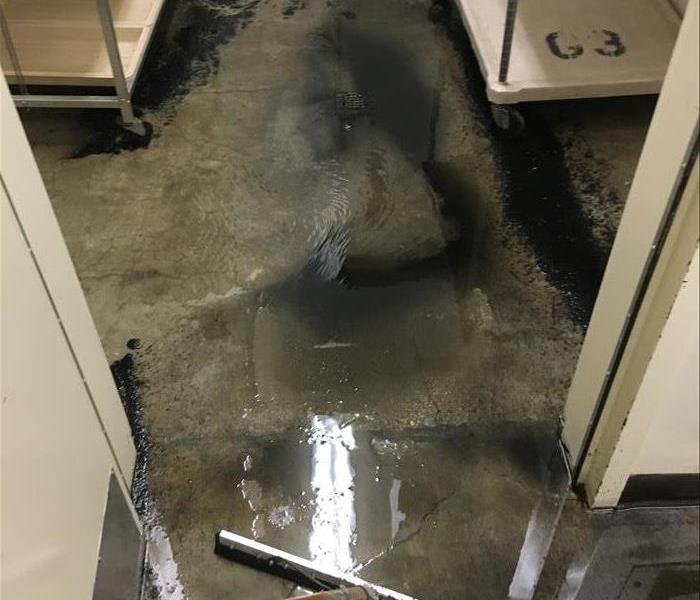 Sewage Backup in Riverside High School
Sewage Backup in Riverside High School
Work Place Water Damage is Restored by SERVPRO
When business owners visualize water damage, they often picture a massive storm wiping out power lines, flooding offices, and shutting down businesses for days at a time. It is true that commercial water damage is often the result of floods and water that stems from weather events and storms.
However, many entrepreneurs and business space renters forget that storms and severe weather aren't the only causes of floods and water damage. Commercial water damage in Edison is surprisingly common year-round, and it can drastically effect the operation of your business. Here are some of the typical causes of water damage to commercial buildings.
1. Malfunctioning sprinkler systems
Some older office and retail buildings still have outdated sprinkler systems that work in conjunction with fire protection systems. While such sprinklers can come in handy during a fire emergency, they can also cause commercial flood damage if they are faulty or in need of replacement. This could easily damage inventory and business assets. Be sure to have your sprinkler system inspected annually by professionals.
2. Damaged appliances and equipment
This cause of commercial flood damage is more common in restaurants and catering facilities, as well as any business that has appliances and equipment that make use of water. If the appliance fails and sends water throughout your building, especially during late hours when no one is around, you may come back to work and face a water emergency.
3. Broken pipes and plumbing
Just like in a residence, if the plumbing system in your workplace fails water damage could be the result. If you doubt the stability of some pipes contact a licensed plumber for a thorough inspection and assessment.
4. Backed up sewer lines
This is another cause of commercial water damage that often catches business owners by surprise. Should the sewer line to your building back up or become damaged, realize the potential dangers of contaminated water which can cause health effects and ruin products and office furnishings. SERVPRO of West Riverside City has certified technicians to deal with this type of water damage.
If your business has suffered commercial water damage of any kind, SERVPRO of West Riverside City can get you back up and running again. Call us anytime at 951-351-8033 for fast help. Read more about sewage backups here.
Water Damage in Upstairs Laundry Room, Riverside CA
8/20/2018 (Permalink)
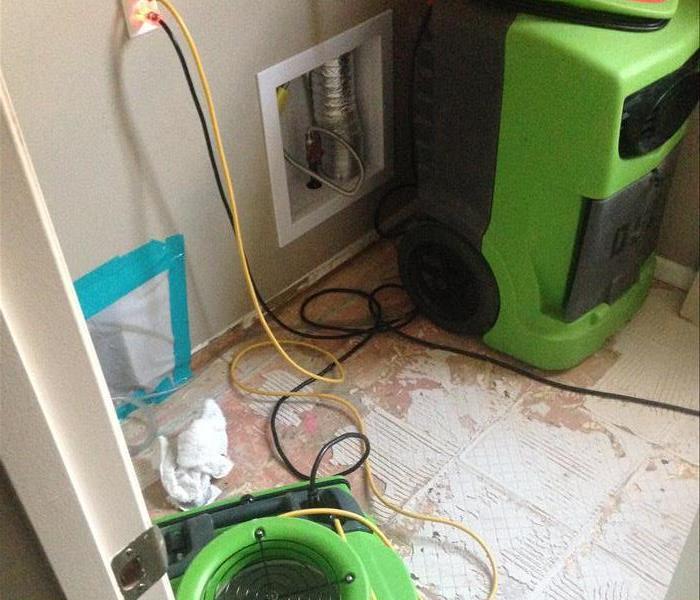 Drying the subfloor and drywall in upstairs laundry room.
Drying the subfloor and drywall in upstairs laundry room.
When someone mentions they have a laundry emergency, most people’s first thought would be a red wine or grass stain, but here at SERVPRO of West Riverside City a laundry emergency is a much BIGGER deal! What you aren’t thinking about is without proper inspection and maintenance those appliances you rely on can really lead to a serious disaster in your home.
Washing Machines typically run a few times per week in most homes, and the typical life expectancy of a washing machine is 10-11 years, during that time it can wash up to 5,000 loads. Washers come with 3 hoses filled with water: hot water, cold water and a drain, that gives that appliance 3 opportunities to suddenly leave you with a laundry room flood, or worse widespread water damage.
To complete a full cycle of laundry you have to put those wet clothes somewhere, and it is convenient that the clothes dryer is located right next to the washing machine, right? No one forgets to throw in the laundry detergent when doing a load, but forgetting to dispose of your dryer lint, well that can cause BIG problems. Dryer lint is very combustible, the accumulation of lint in your dryer and vent can reduce airflow, causing your dryer to overheat. An improperly vented dryer can have dangerous consequences and is a leading cause of fire damage in homes.
Steps to prevent a laundry emergency in your home:
1. Inspect the hoses on your washing machine regularly, remember to check for leaks thoroughly but be sure not to disconnect them. The best way to check is to start a small load on a short cycle and make sure you don’t see any water, with each cycle. Better yet replace rubber hoses with a stainless-steel option, they have a longer life span.
2. Give your washer some room, keeping it 6” away from the wall can help prevent the hoses from kinking. Also, make sure you don’t see a lot of movement, an imbalanced washer can move around enough to loosen or cause added stress on your hose connections.
3. If you seem to have continued problems with your washer install a flood stopper. It’s placed on the floor near your washing machine and when it detects water it can shut off the water supply.
4. It is recommended to have your dryer exhaust system cleaned at least twice a year. Make sure you remove lint from your filter and underneath it every time you start a new load. Don’t use dryer sheets and fabric softener and remove the back of the dryer regularly to remove trapped lint.
5. Check that your dryer vent outside is lifting/venting properly. When installing the duct line keep it as short as possible to accumulate less debris. Keep the area around your dryer free of dust and other debris.
Accidents sometimes happen even after taking proper precautions and performing routine maintenance in your home. We here at SERVPRO of West Riverside City have responded to dozens of calls for water or fire property damage caused by laundry emergencies. We specialize in the cleanup and restoration of residential and commercial property after fire, smoke or water damage. Our professional staff has the equipment, expertise, and experience to respond faster to any size disaster.
If you have a laundry emergency caused by Fire/Water Damage! SERVPRO of West Riverside City is always here to help!
Providing 24 Hour Emergency service, 7 Days a week, 951-351-8033 we are just a phone call away!
Water Damage Prevention Tips
8/13/2018 (Permalink)
We all know what water damage to homes and businesses look like after a flood or a heavy rain. Oftentimes, events such as these are unexpected, and if we aren’t prepared for what may happen during a stormy season, we can suffer more water damage than we need to.
- DO REGULAR INSPECTIONS. Take a good look around your home or place of business; are you prepared for wet weather? Do exterior doors fit as tightly as they should, and are both doors and windows properly weather-stripped? The roof of your office or warehouse needs to be well-maintained, too, to protect your machinery, product, and staff furniture from water damage. The parking lot or driveway of your home or business needs to have a well-planned drainage system so that clients, employees, and family members can get to and from their vehicles safely. If people have to wade in from their cars, floors will suffer, and a slip-and-fall accident due to wet floors can be a disaster. Inspect the parking lots of your business regularly for potholes, especially after a storm. If you know you’ll see a lot of run-off from the parking area, consider using sandbags. Low-lying buildings next to a parking lot full of water can end up flooding, and you will want to plan ahead to prevent that from happening.
- DO REGULAR UPKEEP AND MAINTENANCE. Rain gutters and spouts need to be checked on a regular basis. If your rain gutters become clogged with debris such as dead leaves or small branches, they aren’t going to be able to drain away rain water. As water backs up, it can leak back into the walls of your building, sometimes without you knowing it, and you can find yourself with water damage, and even mold. These types of issues can be alleviated by regular maintenance.
- COMMUNICATE WITH PUBLIC SERVICES. Power lines and telephone poles near to your home place of business can be an issue when storm season comes if they are not in good condition. Contact your utilities companies and have them come take a look prior to wet weather to make sure you, your business, and your employees and loved ones will be safe. Be aware of the condition of any large trees on your property. If the grounds of your place of business become saturated, a tree with an unstable root base can fall and create problems for you, your employees, and your customers. Some trees and plants are the city’s responsibility, depending on where they are placed. Make sure you know who to call should the time come.
The team here at SERVPRO of West Riverside City is standing ready to help in any way we can! We have the expertise to handle water and fire damage, and specialize in mold remediation. If you have sustained water damage to your property, give us a call today at 951-351-8033, or visit on our website: SERVPRO of West Riverside City
SERVPRO - A Qualified Mold Remediation Company
8/1/2018 (Permalink)
Mold Growth in your Home
Mold is a microscopic organism called fungi that can grow anywhere there is a damp or wet environment, a food source (ranging from wood to tile and other organic based materials), and high humidity. If certain types of mold didn’t exist we wouldn’t have cheese or penicillin, but there are other types of mold that can create major health concerns. Some molds growing in your home also produce mycotoxins that can pose serious health risks to humans and animals. When people touch or breathe in these mold spores they can elicit nasal and sinus congestion, induce runny nose and eye irritation, and provoke respiratory problems such as chest tightness and sneezing fits. At SERVPRO West Riverside City we are committed to the protection of your property and the health of your family, so we have cutting-edge mold cleanup and restoration packages to suit your home repair needs.
The first step for eliminating mold is to investigate your home for any sources of major indoor moisture. Pay special attention to piping connected to the roof, plumbing leaks, backed-up sewers, and the space around the humidifier or air conditioning unit. If you are a tenant you want to alert your property manager of potential water damage areas that should be fixed immediately.
One way that you can safeguard your home against mold is to improve the ventilation in your residence. Not all heating or cooling systems circulate fresh air into your home, so in order to help keep your home well-ventilated you should consider using kitchen and bathroom exhaust fans, window or attic fans, or a window air conditioner with the vent control open. If weather permits it’s always helpful to keep the window open as well.
SERVPRO Does Mold Removal and Remediation
If you are suffering from unwanted mold in your home SERVPRO West Riverside City, a quality mold cleaning company, can help alleviate some of your stress. The goal of our dedicated technicians is to make sure you are comfortable in your home, and if we can’t, then we aim to make the process as quick and painless as possible.
Give us a call for a mold inspection. 951-351-8033
Fire Damage Restoration Tips in Riverside, CA
7/30/2018 (Permalink)
 Contact us if you have any questions regarding a fire or smoke damage.
Contact us if you have any questions regarding a fire or smoke damage.
Fire Restoration Help
What To Do After A Fire
- Limit movement in the home to prevent soot particles from being embedded into upholstery and carpets.
- Keep hands clean so as not to further soil upholstery, walls and woodwork.
- Place clean towels or old linens on rugs, upholstery and carpet traffic areas.
- If electricity is off, empty freezer and refrigerator and prop doors open.
- Clean and protect chrome with light coating of petroleum jelly or oil.
- Change HVAC filter.
- Tape double layers of cheesecloth over air registers.
What NOT to Do After A Fire
- Don't attempt to wash any walls or painted surfaces or shampoo carpet or upholstery without contacting us.
- Don't attempt to clean any electrical appliances that may have been close to fire, heat or water without consulting an authorized repair service.
- Don't use any canned or packaged food or beverages that may have been stored near the fire, heat or water.
- Don't turn on ceiling fixtures if ceiling is wet. The wiring may be damaged.
- Don't send garments to an ordinary dry cleaner. Improper cleaning may set smoke odor.
Have Smoke or Fire Damage? Call 951-351-8033
Emergency Water Damage on Your Hands?
7/25/2018 (Permalink)
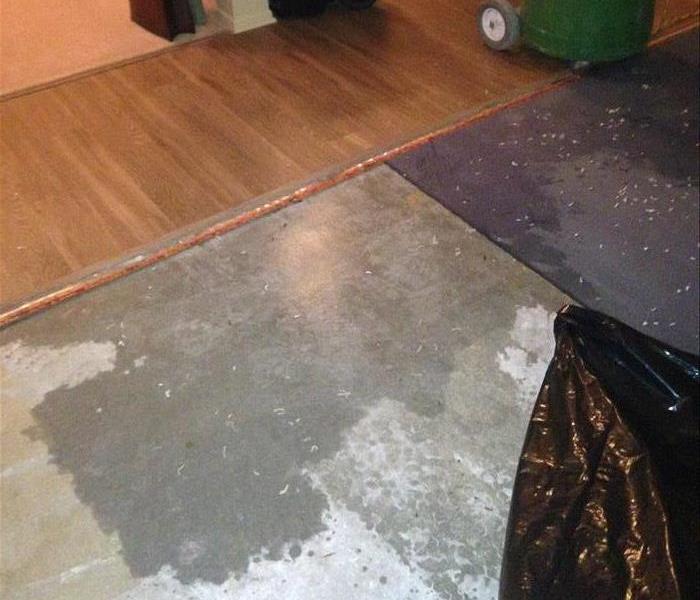 Water Damage Experts Ready to Respond 24/7 365 Days a Year
Water Damage Experts Ready to Respond 24/7 365 Days a Year
Have A Water Damage Emergency? Call 951-351-8033
What To Do After Flooding
- Remove excess water by mopping and blotting.
- Wipe excess water from wood furniture after removal of lamps and tabletop items.
- Remove and prop wet upholstery and cushions.
- Place aluminum foil or wood blocks between furniture legs and wet carpeting.
- Turn air conditioning on for maximum drying in summer.
- Remove colored rugs from wet carpeting.
- Remove art objects to a safe, dry place.
- Gather loose items from floors.
What NOT to Do After Flooding
- Don't leave wet fabrics in place. Hang furs and leather goods.
- Don't leave books, magazines or other colored items on wet carpet or floors.
- Don't use your household vacuum to remove water.
- Don't use television or other household appliances.
- Don't turn on ceiling fixtures if ceiling is wet and keep out of rooms where ceilings are sagging.
Mold Growth Problems Riverside, CA and surrounding areas
7/23/2018 (Permalink)
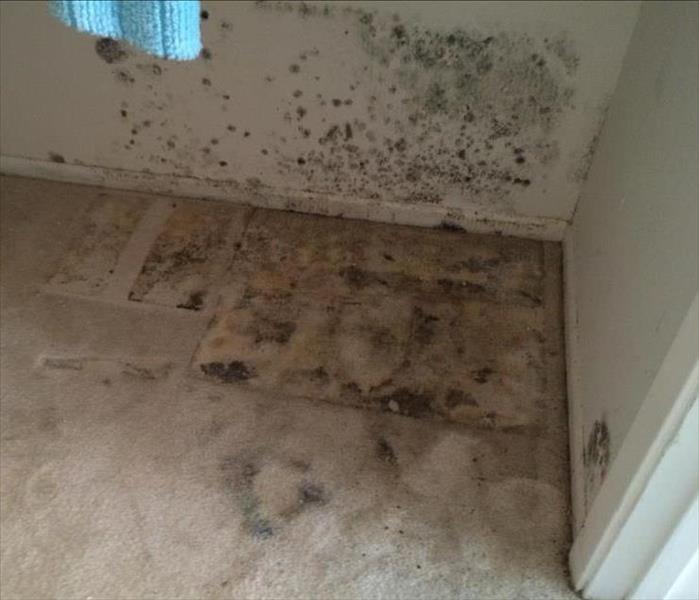 Mold can be very dangerous. Before you do anything to it have someone with mold experience come and take a look at it.
Mold can be very dangerous. Before you do anything to it have someone with mold experience come and take a look at it.
If you suspect that your home or business has a mold problem, SERVPRO of West Riverside City has the training, equipment, and expertise to handle the situation.
What to Do:
Stay out of affected areas.
Turn off the HVAC system and fans.
Contact SERVPRO of Flagler County for mold remediation services.
What Not to Do:
Don’t touch or disturb the mold.
Don’t blow air across any surfaces with visible or suspected mold growth.
Don’t attempt to dry the area yourself.
Don’t spray bleach or other disinfectants on the mold.
Call our office to speak with one of our claim specialists to schedule an appointment with one of our Estimators. From Estimation to Completion, our team is ready to take care of your water damage restoration needs.
If you have a mold problem, call us today 951-351-8033.
Trained Water Damage Restoration Technicians
7/18/2018 (Permalink)
At SERVPRO of West Riverside City we strive to be the best in the business. When a water disaster strikes your home, we will be there within the hour to help. Our skilled technicians will explain the process to you and promptly begin work. Our training program includes the following:
- IICRC Training
- Employee Certification Training
- Initial Franchise Training
- e-Learnings
- Continuing Education Classes
SERVPRO of West Riverside City offers both credit and noncredit courses for insurance agents, insurance adjusters, real estate professionals, and Franchise staff. These programs are designed to improve knowledge of emergency mitigation.
Call our office at 951-351-8033 to speak with one of our claim specialists to schedule an appointment with one of our Estimators. From Estimation to Completion, our team is ready to take care of your water damage restoration needs.
Fire Restoration, Riverside CA and surrounding areas
7/16/2018 (Permalink)
Fire Restoration
Often times after a fire people assume everything is a loss. When hiring professionals like SERVPRO of West Riverside City the process of restoration can save a lot of the presumed loss.
Professionals can clean smoke damage and restore items affected by a fire, but they must be brought to the site as soon as possible to halt the ongoing issues that ash residue can cause. The first thing that ash does to the home is discolor most surfaces. Anything that is made of plastic or was close to the fire will start discoloring within minutes, and within several hours, fiberglass and finishes on appliances will begin to yellow. Metals may also tarnish. After a few days’ pass, the ash will cause walls to discolor permanently, along with clothing and upholstery. Wood and vinyl will need to be refinished or replaced, and metal will start corroding.
The fire, smoke and soot are the expected result of the fire and most people do not think of the damage the water used to extinguish the fire can cause. It is equally important to extract the water and dry the structure properly. If not dried properly even more damage can result in the future.
Quick action to hire professionals such as SERVPRO of West Riverside City helps keep costs down as prevention of further damage is key. Without quick action metals may need to be replaced, carpet will permanently discolor and glass may be severely etched. It will also become apparent that the odors caused by the disaster may still be present and intense enough to not only be distracting, but in some cases harmful. Because ash is acidic, the longer it takes to hire experts, the more destruction it will cause.
This entire process is very detailed, and hiring a professional like SERVPRO of West Riverside City that can be trusted to do the job right is imperative.
Each disaster needs its own special attention to detail and that is why SERVPRO of West Riverside City has a team that will come and assess the damage and create a scope of work needed to take you through the entire process of remediation through reconstruction to make it “Like it never even happened”. You may visit http://www.SERVPROwestriversidecity.com/fire-smoke-damage-restoration to learn more.
SERVPRO of West Riverside City professionals stand ready to help you 24/7 365 days a year 951-351-8033
Prepare for the unexpected, Water Damage, Flood or Storm
7/11/2018 (Permalink)
 Download the app and have SERVPRO help you prepare for the next emergency that might happen to your home or business
Download the app and have SERVPRO help you prepare for the next emergency that might happen to your home or business
Emergency Preparedness
is usually discussed a few times a year, particularly at the beginning of storm season and then left to collect dust on the corner of a desk. Everyone knows it’s an important subject however it’s one of those items that keeps getting pushed to the proverbial tomorrow. Most people have a “plan” to get out however very few people have a true plan to get back in.
No one plans on a disaster, but you can plan to be “Ready for whatever happens” and SERVPRO of West Riverside City wants to help you. SERVPRO has a tool designed to not only help you before the storm but also prepare you to get back to business after the storm. The Emergency Ready Profile is a no cost assessment of your property containing pertinent information about utilities, account #’s, priority contacts including your insurance. The profile is compiled on an App compatible with your smart device, therefore this information is always at your fingertips.
If you’re tired of looking at the unfinished plan on the corner of your desk and want to quickly and effectively make a plan to reduce business interruption as well as protect your property and investments
Call SERVPRO of West Riverside City today 951-351-8033
Prevent Mold Growth in Bathrooms, Riverside, CA
7/9/2018 (Permalink)
 Mold Growth Behind Bathroom Cabinets
Mold Growth Behind Bathroom Cabinets
Fighting mold in your bathroom? That’s because showers, sinks, bathtubs and toilets are each high producers of lingering moisture, creating the perfect environment for mold to grow in.
The good news is, there are preventative measures you can take to help combat mold growth in these areas, and stop it from spreading to the rest of your home:
- Make sure your bathroom is properly ventilated. Ventilation is key in regulating the amount of moisture in the air and keeps it from settling on surfaces where mold can grow. If you have a fan, make sure it is on or a window is open while you are showering so the steam can be directed away from the rest of the room.
- Once you finish taking a bath or shower, allow your bathroom fan to run for at least 30 minutes longer. This will give the air time to circulate.
- Mildew-resistant materials to the rescue! If you have a shower curtain or window curtains in your bathroom, make sure they are mildew resistant so mold can’t grow on them.
- Wipe down your shower often. Wiping down your shower after using it removes any lingering moisture that otherwise would have no place to go.
- Wash your shower curtain. Many people forget this one, but you should always wash your shower curtain at least once a month! Not only will it keep your bathroom looking fresh and clean, it will help remove any mold spores that could potentially grow and wreak havoc on the material.
- NEVER leave damp laundry on the floor. Or any laundry for that matter. When damp laundry is left on the floor, it creates the perfect breeding ground for mold spores. It also can ruin your clothes!
- Repair any water leaks. If any drains, faucets, or pipes are leaking water, it creates a constant source of moisture for mold to live on and grow from. Fix leaks immediately to reduce the chances of mold.
SERVPRO Helps You Prevent Mold Growth in Bathroom in Riverside, CA.
If you find mold, or suspect you may have mold in your home, give SERVPRO of West Riverside City a call and we will come inspect it for you. 951-351-8033
Sewage Backups Means Black Water Damage in Norco
6/27/2018 (Permalink)
 This photo shows how we remove the affected flooring and drywall when dealing with a category 3 water emergency.
This photo shows how we remove the affected flooring and drywall when dealing with a category 3 water emergency.
Sewage backups are a dirty business—literally. Thankfully, we at SERVPRO of West Riverside City know exactly how to handle it. When toilets backup or start to overflow, sometimes it’s just a little toilet water that needs to be removed, but sometimes it is infinitely worse. The category of the sewage water (Category 1, 2 or 3) will directly affect how we treat the situation. With Category 1, we clean, disinfect and remove anything too saturated. On the other hand, Category 3 requires us to remove anything the water touched. Category 3 means you, the homeowner, could be in danger if we do not remove everything.
A Norco homeowner recently experienced a Category 3 sewage backup. As with most sewage backups, it originated in the bathroom. It happened while the homeowner was not home, so when she returned it had already spread to other rooms. She knew she would need a professional to help her remove the damage, so she called her property manager who referred her to SERVPRO of West Riverside City.
As soon as the call came in, we sent our Project Manager to the home. His initial inspection found that the kitchen, bathroom and hallway were all affected. He also determined the water to be Category 3 sewage water, so he informed the homeowner anything the water touched would have to be removed for her safety. As soon as we had her approval (and the approval of her insurance), he called out our technicians.
Our technicians ended up removing the lower cabinets in the kitchen as well as the backsplash and counter tops. From there, they moved to the bathroom where they removed the vanity, tile floor and shower tile. And then finally they moved to the hallway where they removed all the hallway carpet, baseboards and a foot of drywall. Once everything was removed we worked to disinfect every area and then we set up air scrubbers and dehumidifiers to make sure everything was dry and sanitary for the homeowner.
She was so grateful for our work! She told us she could not have picked a better water damage company to come out to her home. Though her damage was extensive, she knew our ultimate priority was her safety and for that, she was grateful.
To read more about what categories of water exist, click here.
Call us today at 951-351-8033
Should You Be Concerned About Cracks in Your Foundation?
6/25/2018 (Permalink)
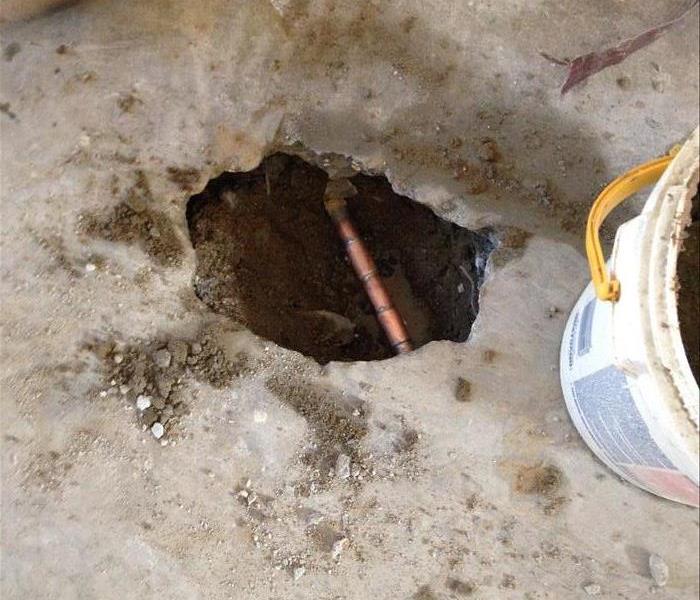 This photo shows one kind of slab leak, a slow leak from a pin hole.
This photo shows one kind of slab leak, a slow leak from a pin hole.
The foundation underneath your home serves a very important purpose. It’s what keeps your house aboveground, deters moisture, and insulates your home against the cold weather. When that foundation starts to form cracks, it should make any homeowner concerned. This is because properly developed foundations are created to withhold natural settling that occurs when a house ages. This means that if you see cracks in your home’s foundation, something is not right. Because of its seriousness, SERVPRO of West Riverside City wants to help educate others on how serious cracks in a home’s foundation can be.
What’s the big deal with having cracks in a home’s foundation?
It doesn’t matter where the cracks are located or how big or small they become, finding a crack in the foundation is never a good sign, as it means that the foundation itself is moving. Because the foundation acts as the platform for a house to be built on, having the foundation move around only leads to structural problems and damages to your home. When cracks start to form, it can lead to many unwanted scenarios or events. Here are just a few:
1. Water damage.
If there are cracks in your foundation, that means that the cracks can act as an entranceway for water to enter your home and ruin the basement and other parts of your house. Along with that, the water can help make the cracks larger and spread at a faster rate, which only means more damage to your home.
2. Degrading foundation.
When a foundation starts to degrade, the water entering can cause the foundation to erode at a faster pace, which can also cause serious damage to a home.
3. Termites.
Nobody wants to deal with termites. Unfortunately, cracks in a house’s foundation can help invite them into your home. The cracks make it very easy for them to gain access to your home. Once the termites are there, the repercussions are costly and no fun.
How do cracks form?
All three items mentioned above are clearly things that no homeowner ever wants to deal with. Oftentimes the damage is not as bad if the cracks in the foundation are found earlier on. So what should a homeowner do? It helps to know the background as to how these cracks are formed in the first place. Here are a few ways cracks can form on your house’s foundation:
1. Earthquakes.
Living in Southern California, earthquakes are a common occurrence. Along with the damage they can do to your personal items inside your house, earthquakes can also affect the foundation of your home. The stronger the earthquake, the weaker your foundation can become. Along with that, smaller earthquakes can also make current cracks worse, so beware of the possible damages caused by earthquakes.
2. Improper mix solution.
The actual creation of a house’s foundation is very important as to whether or not cracks will form. If the foundation mixture has too much sand or water, it will not set properly, which overtime, can cause the foundation to erode.
3. Exposure to extreme heat.
An intense amount of sunlight exposure can cause concrete to expand during the day. When the sun goes down, the concrete can go back to its normal position. Having this constant expansion and shrinkage occur can cause your foundation to crack.
4. Leaks in the plumbing.
Having to deal with water leaks in your house is a pain and often very time consuming. But when a leak happens, don’t forget to check your home’s foundation. If there is an excess amount of water leaking into your basement, this can cause pressure against the foundation, making it more vulnerable to cracks.
5. Droughts or floods.
Southern California’s recent weather has caused quite a bit of chaos. First, there was the statewide drought. Then El Nino brought possible flooding issues to some homeowners. Both cases are no good for a house’s foundation. Droughts and floods can change the typical soil pressure around the foundation, which can then cause it to move and eventually crack.
How Water Can Damage a Home’s Foundation
Water can have a huge impact on a home. Whether it’s a pipe leak or a flood, the damage it can bring to the home is overwhelming. But on top of that, water can create major problems with a home’s foundation. Here is how water plays a major role in a home’s foundation damage.
1. Soils make a difference.
We can’t always escape water. At some point, rain or snow will hit your home. But there are certain soils that drain better than others. Those made out of loam or sand typically have good drainage, which means these soils don’t provide an issue with foundation damage. However, soils made out of clay are expansive and tend to absorb water around them. When the soil expands, it surrounds the foundation of a home and creates a pressure against the foundation. As this pressure starts to build against the foundation wall, cracks start to form.
2. The absence of water hurts, too.
The absence of water can actually damage your foundation as well. In times of drought, the previously saturated soil under the foundation shrinks. This leaves a void in the soil that supports it, which can make the foundation drop or sink, causing damage to the foundation as well as the structure it supports.
So, what can I do to prevent it?
After reading about all of the terrible effects and damages a cracked foundation can have on a home, you may be wondering to yourself, “what can I do to prevent all of this from happening to my home?” Fortunately, SERVPRO of West Riverside City has compiled a list of tips to help you prevent water damage and a cracked foundation to your property.
1. Clean your gutters.
Cleaning your gutters on a regular basis can help ensure good drainage. This in turn can help prevent cracks to your foundation.
2. Test your sump pump.
In order to avoid cracks forming within your foundation, be sure to test your sump pump at least once a year. If it’s storm season in your area, be sure to check it more frequently.
3. Fix the water leaks.
Any visible leaks should be repaired as soon as possible, in order to prevent any future water damage. Be sure to check for dark spots on ceilings or pipes, as it can also be an indicator of water damage. Evidence of water damage has the ability to create cracks in the foundation. If your home shows any signs of water damage, be sure to contact SERVPRO of West Riverside City, as we are leaders in the water damage removal process.
How Cracks in a Home’s Foundation Can Create Slab Leaks
Oftentimes, a crack in a house’s foundation can lead to a slab leak in your home, which is another thing no homeowner wants to deal with. Fortunately, SERVPRO of West Riverside City has lots of experience in dealing with slab leaks.
Recently, SERVPRO of West Riverside City received a call from a homeowner who realized that the carpet in their bedroom was very wet in a specific area, which had no connection to plumbing. Unsure of what to do, the homeowner reached out to their insurance agent who referred him to SERVPRO of West Riverside City.
When we received their call, we immediately sent out our Project Manager to inspect the damage. After looking around the area, he realized that the homeowner had a slab leak that ended up affecting the bedroom, bathroom and laundry room. He reached out to Crew Chief and his team of technicians started to get the project underway immediately.
The SERVPRO of West Riverside City team had to remove the wet baseboards in all the rooms and the padding in the bedroom, but they were able to save the carpet by floating it. They then set up dehumidifiers and fans to help the rooms dry out.
The homeowner was very happy and appreciated all of SERVPRO of West Riverside City’s help. They were thrilled that we were able to save their carpet and grateful for our quick service. They let us know that if they’d call us for their future water damage needs.
If your home has been affected by a cracked foundation or has any other signs of water damage, give SERVPRO of West Riverside City a call! We are happy to help with any water damage problems.
Slab Leak Affects Riverside Kitchen with Water Damage
6/20/2018 (Permalink)
 Water Damage in Riverside Kitchen
Water Damage in Riverside Kitchen
Water damage can happen to anyone at any time. Thankfully, you always have SERVPRO of West Riverside City at your disposal for any of your water damage remediation needs. Some of the calls we receive lead to projects that can be completed within a day or two, but others take a little bit longer. Depending on the damage, we will make sure to be at your house until the water damage is completely removed and safe for future living. We pride ourselves on our efficiency, so taking too much time should not be much of a problem.
A homeowner in Riverside recently contacted us with a slab leak. His first call had been to his plumber, who came out and diagnosed the leak after the homeowner had noticed some damp laminate flooring. From there, the plumber told him that he needed to call a water damage company to take a look. The plumber recommended that he call SERVPRO of West Riverside City.
We immediately dispatched our Project Manager to the home to take a look at the damage. He found that the kitchen was luckily the only room affected, but unfortunately the damage was pretty extensive. He called our Crew Chief and technicians out to the scene to get the work started.
Our technicians ended up removing the lower cabinets as well as some drywall and laminate flooring. Then we set up air movers and dehumidifiers to make sure everything was completely dried all the way through and that mold would not be a threat in the future. Between the removal and the drying, the entire project took a full eight days to complete.
The homeowner was so happy with our work! Though it was a long eight days for him, he knew his home was safest in the hands of SERVPRO of West Riverside City and he would absolutely be calling us again in the future.
Sewage Backup in Riverside High School
6/19/2018 (Permalink)
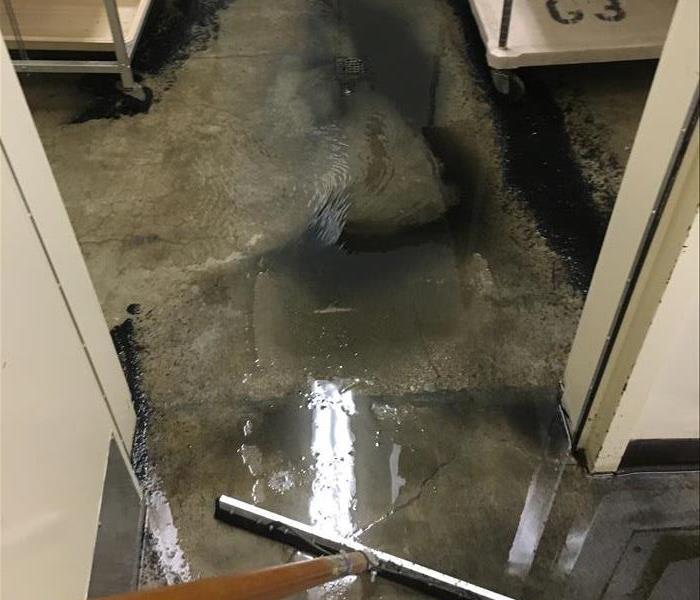 This photo shows a recent sewage backup in a Riverside High School.
This photo shows a recent sewage backup in a Riverside High School.
Sewer backups should be considered an emergency since the water may contain viruses, bacteria, and other microbes that cause serious illnesses. SERVPRO of West Riverside City have specialized training and equipment to quickly and safely clean contaminants like sewage.
Toilet Overflow or Sewer Backup?
Call Today 951-351-8033
Water damage can be classified by the three types of contaminated water. SERVPRO of West Riverside City will inspect your home or business to determine the appropriate plan of action for the type of water encountered.
The three types of contaminated water:
Category 1: "Clean Water"
Category 1 water is from a clean source like a broken water supply line or leaking faucet. If not treated quickly, this water can turn into category 2 or 3, depending on length of time, temperature, and contact with surrounding contaminants.
- Water from a clean source like a broken water line
- If left untreated, can degrade into category 2 or 3
Category 2: "Gray Water"
Category 2 water is contaminated and could cause discomfort or illness. Examples include washing machine overflow; toilet overflow with some urine, but no feces; or dishwasher overflow.
- May contain bacteria and viruses
- Can quickly degrade into category 3 if left untreated
Category 3: "Black Water"
Category 3 water is grossly contaminated and could cause severe illness or death if ingested and any contact should be avoided. Examples include flooding from rivers or streams, water from beyond the toilet trap, water from the toilet bowl with feces, or standing water that has begun to support microbial growth.
- May contain untreated sewage, harsh chemicals, and microbes
- Water from flooding rivers or sewer backup
24 Hour Emergency Service
Water contaminated with sewage backup should be considered an emergency situation and dealt with as quickly as possible. SERVPRO of West Riverside City are available 24 hours a day, 365 days a year. We are water damage restoration specialists with specialized training, equipment and protective gear to safely restore your home or business.
SERVPRO Offers Mold Damage Remediation in Riverside, CA
6/13/2018 (Permalink)
Mold Prevention
With the summertime heat right around the corner, it isn’t uncommon to find moisture and heat coexisting on the same surfaces in your home. Recently SERVPRO West Riverside City helped a distraught client that was headed out of town before he discovered harmful mold growing in his home.
Our client was initially distressed because he was all set to go away when he noticed the hazardous green and black mold spots but he still didn’t want to cancel his travel plans. The experienced SERVPRO West Riverside City mold damage remediation team immediately rushed to his rescue to create a mold damage repair plan. SERVPRO of West Riverside City technicians identified, assessed, and cleared the mold in the structure of his home by using a specialized anti-microbial disinfectant treatment to prevent the spread of mold spores that can make one sick and spread infectious diseases.
Mold poses the biggest health threat for infants, children, pregnant women, the elderly, and individuals with existing respiratory conditions.
How to find Mold in your Home
One way to detect mold in your home is to look out for any foul, musty odors. Often dangerous mold spores are located in air ducts and wall cavities and mold may not be seen but is still present. Mold grows rapidly in dark damp crevices so the best defense against mold damage is prevention.
- Keep it clean: If you notice any musty odors, which can occur before the mold spots show up, use bleach, borax, or vinegar to disinfect the area thoroughly.
- Do the laundry: During the summer many of us like to go swimming, but don’t leave soiled clothes out in places where they will not dry within an hour.
If you are looking for mold damage repair in Riverside and surrounding areas SERVPRO West Riverside City can help alleviate some of your stress. The goal of our experienced technicians is to make sure you are comfortable in your home, and if we can’t, then we aim to make the process as quick and painless as possible.
Call us at 951-351-8033 for a mold inspection!
Water Leak Affects Two Homes in Riverside,CA
6/11/2018 (Permalink)
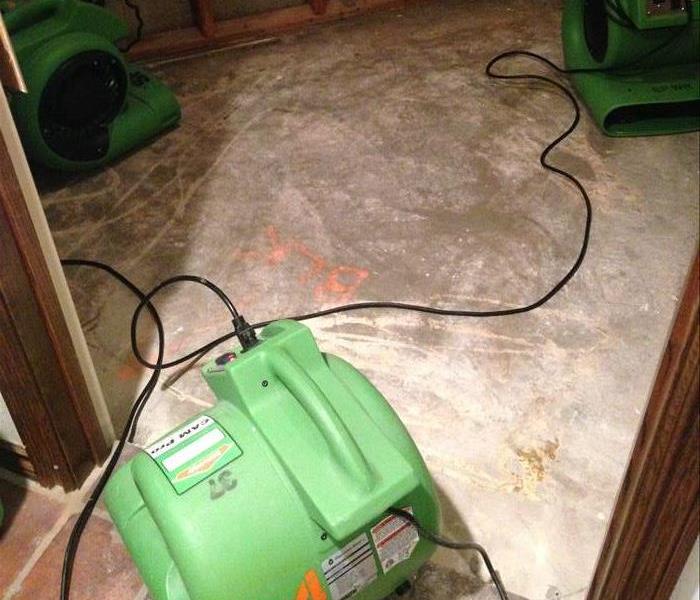 Equipement in place to start the drying process.
Equipement in place to start the drying process.
One Water Leak Affects Two Homes
At SERVPRO of West Riverside City, we understand that water damage can be rather stressful for a homeowner to deal with, especially if they are trying to tackle it all by themselves. Cleaning up water damage correctly and effectively requires knowledge, experience and the proper tools. That’s why it is so important to hire a professional water damage company like SERVPRO of West Riverside City to take care of the remediation process for you. We’ll get your home back to normal in no time at all, so give us a call today!
A homeowner in Riverside called us after discovering water damage in his home. Originally, SERVPRO of West Riverside City was doing work on his neighbor’s home after a pipe had burst. However, the homeowners shared a wall, which caused the water damage to spread to the other house, affecting the living room, bedroom and their shared wall. Because their neighbors had used SERVPRO of West Riverside City to remedy the problem, the homeowner decided to give us a call.
We immediately went out to the home to inspect the damage. The neighbor’s pipe burst did in fact affect the living room and bedroom. He knew this was the perfect job for SERVPRO of West Riverside City, so he called the rest of our crew out to get started on the remediation process.
As soon as our technicians arrived, we began removing the drywall in both the living room and bedroom. Fortunately, the laminate flooring in the living room and carpet in the bedroom were dried in place.
The homeowner was very satisfied with our work. He appreciated how fast our team responded to his call and was pleasantly surprised in our ability to remove the water damage in its entirety.
For more information on our water damage services, give SERVPRO of West Riverside City a call today! 951-351-8033
SERVPRO helps Corona Homeowner after Regular Business Hours
6/4/2018 (Permalink)
 Drying equipment in place to dry out drywall and flooring.
Drying equipment in place to dry out drywall and flooring.
At SERVPRO of West Riverside City, we understand that water damage can come and damage your home at any time and day of the week. Whether it’s a Saturday morning or a Monday night, water damage is most often unexpected and unwanted by homeowners. While many water damage remediation companies only operate during usual business hours, SERVPRO of West Riverside City is different. In order to help and respond to our customers’ needs as soon as possible, we are open every hour of every day of the week. No matter what time of day it is, our team will be at your house to remove the water damage in no time at all.
We recently received a call from a homeowner in Corona, who happened to call on a Saturday evening for help. Homeowner explained to our call center that she had discovered leaking water from her toilet, which ended up causing water damage to multiple rooms. Not sure how to clean up the damage on her own, the homeowner decided to contact a water damage remediation company that was open 24/7: SERVPRO of West Riverside City.
As soon as we got off the phone with the homeowner, we sent our Operation Manager, Gary, out to inspect the damage done to the home. After taking a look around, he detected water damage in the bathroom, hallway, closet and dining room.
With a plan in place, the rest of our crew made their way over to the house to begin the cleanup process. In the bedroom, we had to float the carpet and remove some of the walls. In the hallway, we removed the hard wood flooring, but were able to dry the walls in place. We also removed some of the ceiling in the dining room. To make sure everything was completely dry, our team set up drying equipment in all of the affected areas of the house.
The homeowner was very pleased with our end results. She appreciated how fast our response time was and our ability to remove every sign of water damage in the home. We were happy to help!
Call us if you notice a water leak in your home after hours! We will be there to help no matter what time it is! 951-351-8033
Unsure if Mold Is Affecting Your Home? This Checklist can Help.
5/28/2018 (Permalink)
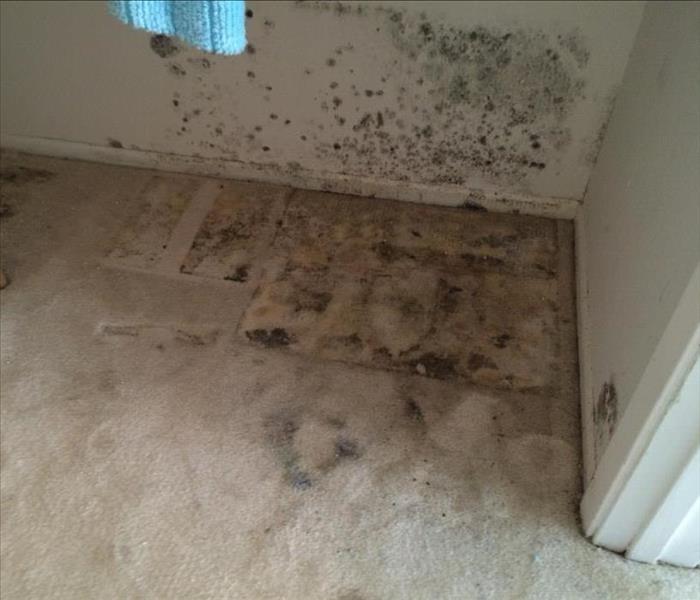 Water Damage Goes Undetected and Mold Starts Growing. SERVPRO of West Riverside was there to help and make this Riverside Home safe to live in again.
Water Damage Goes Undetected and Mold Starts Growing. SERVPRO of West Riverside was there to help and make this Riverside Home safe to live in again.
“You have mold.”
These are words no homeowner ever wants to hear. Not only is mold a hassle to remove, but if it’s not removed properly, it can also cause serious health problems and damage to a home. SERVPRO West Riverside City realizes how hazardous mold can be to a home and its residents. That’s why we offer excellent mold remediation services. However, there are certain warning signs that all homeowners should take into consideration. We at SERVPRO have compiled a checklist of ways to detect mold in their house.
How to Detect Mold
1. Something smells suspicious
Mold has a very distinct smell. The odor typically has a musty or mildew scent to it. When mold is kept contained to one area of your home, you may notice an unpleasant odor when you enter that area. Mold can sometimes live within the walls of your home. This means that while you may not be able to visually detect it, mold can still be growing in your home, so if you smell something strange, this could be a sign of mold.
2. It might not just be seasonal allergies
While it might seem like you only have a little winter cold, you might want to think again. A symptom of mold is that it can oftentimes leave you feeling sick. Depending on how sensitive you are to mold, exposure to mold can cause a runny nose, sneezing, red eyes, skin rashes, shortness of breath and other respiratory issues.
3. Take a look around your house
While not all molds are visible, many of them are. The easiest way to detect mold is by simply taking a look around your house. If you feel like there is a possibility of mold in your home, check out our Home Checklist that covers where you should be on the lookout for mold.
Spotting for Mold
1. The colors of mold
When inspecting for mold, it helps to know what kind of colors you should be looking out for. Mold comes in a variety of colors including, green, grey, brown, white and black. The most common types of mold usually come in the shade of black.
2. Check water source areas
Because mold loves to grow in moist areas, it’s a good idea to look around areas where your water comes from. If you check places like your kitchen sink, laundry room, basement and bathroom early enough, you might be able to protect your home from further mold growth.
3. Look up
Do you find any water spots on your ceiling? This could possibly mean that you have a condensation or humidity problem. The water spots have most likely been caused by a water leak above the ceiling, which means your house could be the victim of mold.
4. Look down
Just like mold can affect your ceilings, it can also affect your flooring. Moisture, dust and dirt make the perfect landing spot for mold to grow. The biggest trappers of dust are typically carpets and tiles. Carpets contain moisture very well, so if you want to prevent mold, it’s important to consistently inspect your flooring for any water damage.
5. Check your walls
Do you have paint peeling or wall discoloration? This is a classic symptom of your wall being exposed to moisture. If you see this, it’s important to really take a closer look at your walls and if necessary, take action immediately. While it might just be the beginning of some tiny mold growth, it could actually be much worse. Mold might be growing behind the wall, and seeing it on the wall’s surface can be a sign that there is a larger problem underneath.
6. Inspect your furniture
There are certain pieces of furniture that molds likes to grab a hold of. Furniture made of wood or other organic materials are common places for mold growth. Upholstered furniture typically holds moisture well, which means it’s a perfect space for mold to grow. One way to prevent mold from reaching your furniture is to keep it away from your walls. If you have mold growing on your walls and your furniture is touching those walls, it is likely that the mold will then grab ahold of your furniture. Because of this, be sure to check inside your cabinets and cupboards as well.
7. Take a look at your windows
During the colder months, windows and window frames can very easily become the victims of mold growth. Due to the cold outside air, condensation frequently forms on windows, which cools the glass. If your windows are dirty, the combination of the moisture and grime add up to be a great spot for potential mold to grow. Be sure to clean your windows on a regular basis. Also, check the area around your windows where the frame meets the wall.
8. Always keep dry clothes
Leaving wet clothes unattended for a long period of time can create mold. Keeping damp towels or wet clothing items for more than a day creates a very good possibility of mold growth.
9. Call SERVPRO!
If you are unsure as to whether or not there is mold in your home, our SERVPRO team can help! We use various professional testing tools and equipment to examine whether or not your house has been exposed to mold.
If by chance you discover mold in any area of your home, call SERVPRO today! We are experts in mold remediation and removal. As soon as we receive your call, we are dedicated to making the remediation process as quick and as smooth as possible. The faster we are able to get to your home, the more affective we can be in removing any signs of mold.
SERVPRO’s Mold Remediation Process
The process of removing mold from your home depends on the amount of mold growth and the types of surfaces on which the mold appears to be. We use certain antifungal and antimicrobial treatments to eliminate mold colonies and to help prevent new colonies from forming. Depending on the severity of the mold damage, SERVPRO will remove mold-infested pieces like drywall and carpeting if needed.
Do’s and Don’ts
When it is determined that you do in fact have mold in your home, the hardest part can be waiting for the removal process to be completed. While it might be difficult, there are certain things that should and should not do while you wait:
Do…
- Stay out of affected areas.
- Turn off the HVAC system and fans.
- Contact a SERVPRO Franchise Professional for mold remediation services.
Don’t…
- Touch or disturb the mold.
- Blow air across any surfaces with visible or suspected mold growth.
- Attempt to dry the area yourself.
- Spray bleach or other disinfectants on the mold.
How to Prevent Mold in the Future
Once the mold is removed from your home, there are certain things homeowners can do to help make sure that the mold does not come back. Here are a few tips on how to prevent mold in the future:
1. Be weary of indoor humidity
Higher than normal indoor humidity can support the growth of mold in a home. We recommend homeowners to keep the indoor humidity below 45 percent.
2. Clean up wet and water damaged areas as soon as possible
Whether it’s a simple water spill or a disastrous flood, it is important to respond immediately to the potential water damage. The sooner you can dry up those water damaged areas, the more likely you can prevent mold from coming pack into your home. As soon as you discover the water damage, give SERVPRO West Riverside a call, as we also specialize in water damage remediation as well.
3. Repair your home’s gutters
If the mold originated from a leaking roof, it is possible that there might be an issue with your gutters. In the future, be sure to clean them on a regular basis. If the damage is severe, you might need to repair or purchase new gutters all together.
4. Increase the airflow in your home
As the cold winter temperatures start to kick in, the air doesn’t hold as much moisture as it does in the warmer months. That leaves the extra moisture to appear on your walls, windows, floors and other surfaces in your home. To prevent this from happening, it is essential to have good airflow in your home. Open doors throughout your home and move your furniture away from walls to let fresh air in and prevent the possibility of mold forming in your home.
Mold in a home will never be welcomed. It smells, it’s hazardous to our health and can be just plain gross. We at SERVPRO of West Riverside City understand that and are dedicated in helping our customers completely remove any and all types of mold in a home. If you discover mold in your house, contact SERVPRO today! 951-351-8033
Slab Leak leave Behind Major Water Damage
5/21/2018 (Permalink)
 Pin hole in pipe caused Water Damage in Riverside Home, affected several rooms with carpet and wood. SERVPRO was there to help immediately.
Pin hole in pipe caused Water Damage in Riverside Home, affected several rooms with carpet and wood. SERVPRO was there to help immediately.
Slab leak affects Riverside and Norco Homes
At SERVPRO of West Riverside City, we see firsthand all the many ways a home can be affected by water damage. One of the most popular sources of water damage we see is water damage caused by a slab leak. A slab leak occurs when the water lines beneath your home’s concrete slab start to leak. When this happens, the leak can end up damaging multiple areas throughout your home.
But fortunately, companies like SERVPRO of West Riverside City exist to help remove the water damage from your home. Our staff has the experience and knowledge required to remove water damage properly and efficiently.
In the past few weeks, we have received quite a few phone calls from homeowners finding signs of water damage caused by slab leaks. Here are just a few of their experiences:
Slab Leak Affects Multiple Rooms in a Riverside Home
Our call center recently received a call from a homeowner in Riverside who had detected water damage in her home. Not sure how the damage originated, she decided to call her plumber for assistance. Her plumber stopped by and let her know that the water damage was coming from a slab leak. He repaired the leak and recommended that she call SERVPRO of West Riverside City for help with the water damage removal process. She gave us a call immediately.
With our team of technicians present, we started by removing some of the laminate flooring in each room. Because of the severity of the slab leak, the laminate started to come up, which gave us no other option than to remove the affected areas. We then removed some of the affected drywall. To make sure that every ounce of water damage was completely removed from the home, we completed the project by setting up our heavy duty drying equipment in all the affected areas.
In the end, the homeowner appreciated our ability to remove all signs of water damage from her home. She let us know that if water damage affected her home in the future, she knew exactly who to call: SERVPRO of West Riverside City.
Slab Leak Causes Severe Water Damage to a Norco Home’s Wood Flooring
Another homeowner in Norco, CA reached out to us through our call center after he discovered some water damage affecting his wood flooring. Having never dealt with water damage before, he decided to go on Yelp and searched for the best water damage remediation companies in Riverside County. After reading several positive reviews, he knew that there was only one company he could go with: SERVPRO of West Riverside City.
When we talked to the homeowner on the phone, he let us know that the damage seemed to be coming from a slab leak. We decided to send our technician, Gary, out to the home immediately to perform an initial inspection. After taking a look around the home, it appeared that the wood flooring as well as some drywall had been affected by water damage in the bathroom and hallway.
With a plan in place, the rest of our team made their way out to the home to begin the cleanup process. We ended up removing the affected drywall, but fortunately, we were able to save the wood flooring. By strategically placing drying equipment in the affected areas and drying out the saturated framing studs, there was minimal removal required.
The homeowner was very impress with our results. He appreciated our hard work and excellent customer service. We were happy to help!
Don’t let a slab leak ruin your home – contact SERVPRO of West Riverside City! Our team will help remove any and all signs of water damage from your home. Give us a call today and we’ll have your space back to normal in no time at all.
SERVPRO of West Riverside City Specializes in Mold Remediation
5/16/2018 (Permalink)
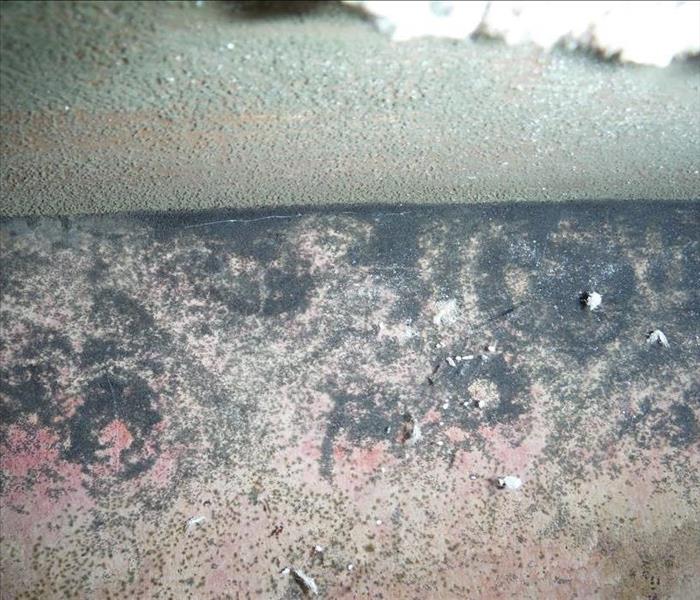 Call us for a mold inspection of your Riverside, CA Home or Business
Call us for a mold inspection of your Riverside, CA Home or Business
Mold Detection
Mold thrives in humid environments with excess water or moisture. It’s no surprise that mold often lurks in the rafters of old and worn roofs. Whether it is damaged drywall due to a leaky roof or harm to your ceiling, attics, floors, or walls, water damage can proliferate the spread of toxic mold if not eradicated promptly and efficiently. SERVPRO West Riverside City specializes in quality mold removal and mold remediation for your home as soon as the presence of mold is identified. Additionally, SERVPRO West Riverside City recognizes that a mold problem is really a moisture control problem and the key to getting rid of mold is identifying the source of excess moisture and squelching it. Therefore, our experienced technicians perform an assessment of your home that focuses on a specialized water damage removal and water damage restoration plan.
Water leaks from a faulty roof on your home can be deadly and they can affect every single room in your home. We know you want each room in your home to have breathable, sanitary air, but when water damage has taken place this is not always possible without outside intervention. Oftentimes the mold growing in your attic has made itself at home and must be attacked with a powerful fungicide. In the kitchen the water damage can increase moisture that can promote mold growth around the kitchen sink. The moisture level in your bathroom may also increase and you want to pay special attention to mold growing on tiles and grout. In the bedrooms, the rise in moisture can be marked by stained vinyl flooring or noticeable condensation on the windowsills.
Mold Remediation
If you are looking for water damage repair in Riverside or surrounding areas, SERVPRO can help alleviate some of your stress. The goal of our experienced technicians is to make sure you are comfortable in your home, and if we can’t, then we aim to make the process as quick and painless as possible.
Can I dry my carpet after a water leak?
5/14/2018 (Permalink)
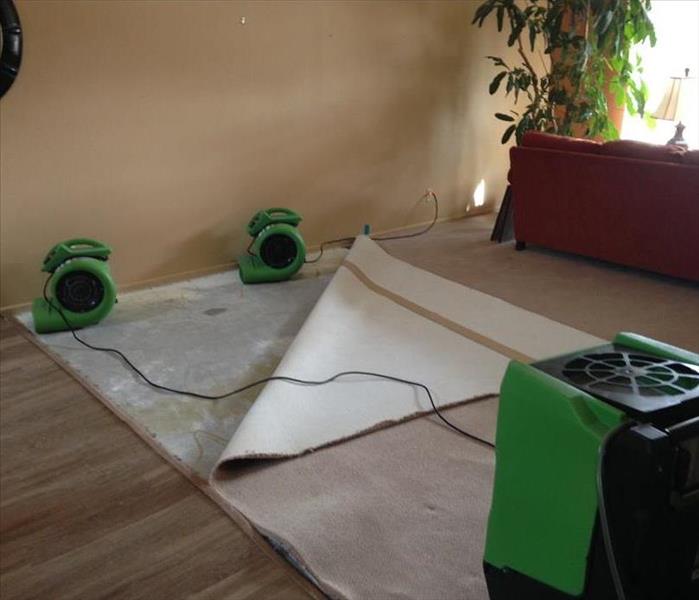 This photo shows how we can save your wet carpet and dry it out in place after a water damage.
This photo shows how we can save your wet carpet and dry it out in place after a water damage.
It doesn’t matter where the water damage stems from; discovering soggy, wet carpet in your home is never ideal. We at SERVPRO of West Riverside City understand how unfortunate it is to stumble upon water damage in your flooring and want to help. That’s why we’re sharing these important facts to know about water damage pertaining specifically to your carpet. Take a look!
1. Know if your carpet can be saved:
Depending on how extensive the damage is, you might not need us to remove any of your carpet. It all comes down to the source of the water damage. If the damage is coming from a sewage-contaminated leak, then you will most likely have to remove the carpets for health safety reasons. Sewage contains dangerous bacteria that can be hazardous to you and your family’s health. So if your carpet is wet with this type of water, it’s probably safest to remove the carpet. However, if the water damage is coming from a non-sewage leak source, SERVPRO of West Riverside City will do everything we can to save your carpet.
Whether or not we are able to save your carpet also depends on how long the water damage has been there. If the damage has been soaking for a long time, it becomes more difficult to properly remove all of the water from the carpet. And if the water damage is not cleaned up in its entirety, you might have to deal with removing mold from your carpets as well. The amount of mold will affect whether or not your carpet can be saved. That’s why it’s so important to contact a professional like SERVPRO of West Riverside City as soon as you detect the water damage.
2. How to dry savable carpet:
If you accidentally spill water on the carpet, it’s easy to dry it out by stomping on the area with some dry towels until it stays dry. But anything bigger than a tiny spill should be checked out by a water damage remediation professional like SERVPRO of West Riverside City. We’ll send out our talented team and set up the proper drying equipment, like air movers and dehumidifiers. If the damage is more severe, we have the proper training to remove any water damage that cannot be dried in place.
3. How to take care of the carpet pad:
The carpet pad, located in between the flooring and carpet, will most likely need to be replaced once it’s been hit by water damage. If the pad gets soaked with water, fortunately SERVPRO of West Riverside City’s team of technicians can come in and remove the pad. This is because if the pad is wet, the underlying flooring will need thorough drying as well.
We had a homeowner in Riverside contact us after a supply line in her laundry room burst and started to flood her home. Her plumber suggested that she turn her water off and call a water damage remediation company to help with the rest. What company did he recommend? SERVPRO of West Riverside City, of course ;)
Once we received her call, we sent our Crew Chief, Gary out to the home. He discovered that the damage had made its way to the hallway, bathroom and bedroom. After his initial inspection, Gary brought his team of technicians out to the home and got started on the clean up.
We ended up having to remove the carpet and padding from the bedroom, but we were able to save the drywall. Drying equipment was also set up in order to clean up the rest of the damage and prevent mold from growing.
The homeowner was very pleased with our work. She loved and appreciated how fast we were able to come out and get started on her house. She also told us that she’d be calling us again in the future for help with any of her water damage needs.
4. Mold affecting your carpet:
As mentioned earlier, water damage that’s left as is in your carpets can lead to a serious mold problem. In fact, after about 48 to 78 hours, mold can begin to grow in the affected areas of your home. That’s because a moist area attracts mold, which if left undetected, can lead to a huge removal process.
We had a homeowner call us after they found mold and water damage in their carpet. Not sure of how to remove it, they searched the Internet for the best water damage remediation and mold removal companies around. SERVPRO of West Riverside City was at the top of the list.
After talking to the homeowners on the phone, we sent our crew chief Gary out to the home immediately. His inspection found mold in four different rooms.
Along with our team of excellent technicians, Gary got to work right away. They first removed all of the affected drywall and flooring. Then, to make sure that no future mold would grow, they sprayed down an antimicrobial agent. An air mover was then set up to eliminate any left over water damage and mold.
The homeowner was so happy with our work! After seeing how thorough we were with removing the mold and water damage, they knew they had made the right choice by calling SERVPRO of West Riverside City.
5. How to prevent carpet mold from spreading:
As mentioned earlier, a homeowner never wants to hear that they have mold in their home, especially if there’s water damage to clean up as well. Not only can mold smell, but it can also be dangerous to your health and is always a hassle to clean up. You can’t always prevent water damage from reaching your carpets, but there are some ways to prevent mold from settling in to your floors and spreading to other parts of your home. As you wait for SERVPRO of West Riverside City to come and remediate the damage, try these helpful tips to prevent carpet mold from spreading.
• Check your furniture.
To keep your furniture safe from mold, check the bottoms and see if they are wet from the carpet’s water damage. If they are, be sure to tell SERVPRO of West Riverside City and we will dry them to the best of our ability. Regardless of whether or not it is wet, it is best to remove any and all furniture from the affected rooms. This will help minimize the amount of clean up that’s needed on your home and prevent mold from latching on to these items.
• Sanitize and clean your walls and baseboards.
If there is mold forming in your carpet, prevent it from spreading to your walls and baseboards by cleaning them off with soap and water. You may not have the ability to control the wet and moldy carpet, but you can try to control how much it spreads to other areas of your house.
• Wait for SERVPRO of West Riverside City's help.
We know that you want to put your home back together as soon as possible. The best way to do that is to let SERVPRO of West Riverside City come out and clean up the rest of the water damage and mold for you. We’ve got the proper dehumidifiers, fans and all other equipment that’s needed to prevent mold from seeping into your carpets. You can count on us to provide the best service and do everything we can to save your home.
Whether it’s just water damage or potential mold entering your carpets, SERVPRO of West Riverside City is here to help. Call us to remediate any and all water damage problems you might have!
Fire Restoration, Riverside CA and surrounding areas
5/9/2018 (Permalink)
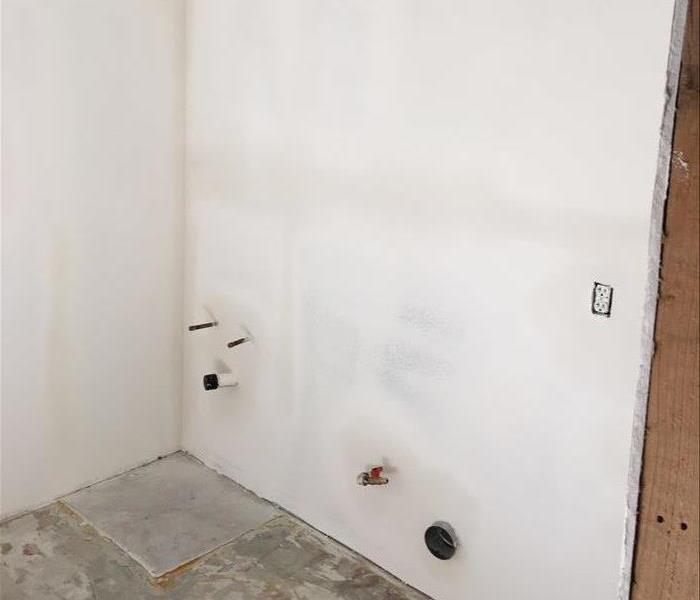 After photo from fire started in Laundry Room
After photo from fire started in Laundry Room
Fire Damage Restoration
At SERVPRO of West Riverside City we strive to please our customers. Our goal is to always have your property look “like it never even happened”. You may feel stressed and confused after such a disaster, and you’ll need a caring expert to guide you through this crisis.
SERVPRO of West Riverside City has the specialized fire and water damage equipment and expertise to help you through this tough time. Immediate action is crucial when dealing with water and fire damage. We’re dedicated to responding immediately when you need help. A fast response helps lessen the damage, limits secondary damage, and reduces cost. Check out our before and after page to see photos of fire losses we have recently worked on. Click here to see a few examples.
SERVPRO does more than Water, Mold and Fire Damages
5/7/2018 (Permalink)
We also do cleanings, from carpet cleanings to biohazard cleaning. Our skilled technicians can handle it all. The decontamination of a home or business due to trauma, sewage backups, chemical spills, hoarding or other biohazards can be both dangerous and emotional. Specialized training and experience is key when choosing a cleanup company to resolve these circumstances.
We provide cleanup and recovery services for many biohazard situations. These include the following:
- Sewage backups
- Crime scene residues
- Suicide/death accidents
- Homicide cleanups
- Blood cleanup
- Accident cleanup
- Hoarding scenes
- Animal waste/remains
- Chemical spills
- Tear gas cleanup
- Meth lab cleanup
Call our office at 951-351-8033 to speak with one of our claim specialists to schedule an appointment with one of our Estimators. From Estimation to Completion, our team is ready to take care of your water damage restoration needs.
Mold: The Water Damage Consequence That Keeps Living
4/30/2018 (Permalink)
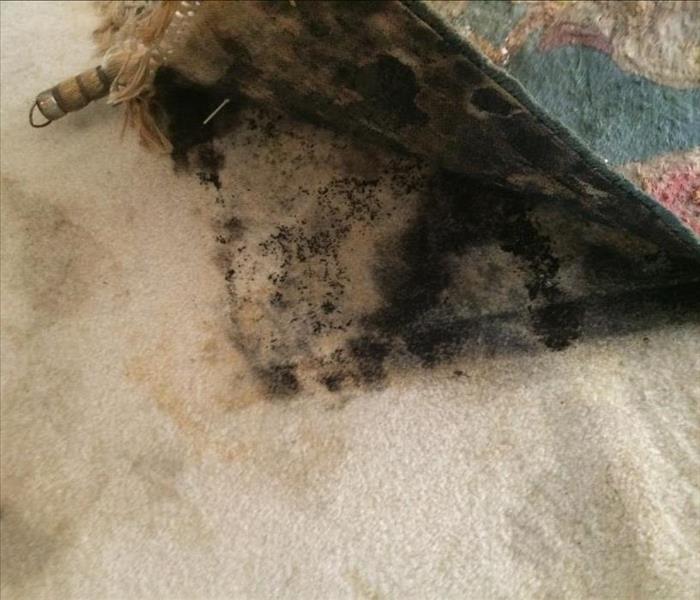 Mold Growth under rug in Bedroom
Mold Growth under rug in Bedroom
An often-unforeseen consequence of a residential water leak is the occurrence of secondary damage. This type of damage is not directly caused by water spillage but is a result of the high humidity environment created by persistent moisture. Black mold is an example of this.
What Is Mold?
Wetness from plumbing leaks can persist for weeks in humid areas such as Riverside, CA causing mold to grow. Mold is a type of microorganism related to yeast, classified in the Fungi kingdom. Fungi are decomposers that occupy an ecological niche, breaking down dead plants and animals, using the detritus for energy, and converting the dead matter into a form that is usable by other creatures via the carbon and nitrogen cycles. This becomes a problem when they start decomposing your house.
Where Does Mold Live?
Fungi thrive in the following environmental conditions:
• Low light
• Moist
• Relatively undisturbed
In the wild, decomposers are an essential part of the ecosystem. Black mold reproduces in the environment by a process called sporulation. Mold spores are produced from hyphae and carry progeny from suitable environment to suitable environment on wind currents or by clinging to the outside of an animal or person’s shoe. When the spore finds a high-humidity environment, chemical signals initiated by moisture start the process of cell division, and a new colony of mold forms. These spores are ubiquitous in the environment, including the air in your home. Secondary damage occurs when mold begins to grow in your house because of residual moisture from a water leak.
How Do You Fix It?
If you find yourself in a situation where black mold is an issue, it is best to call in the professionals. A musty odor or visible growth on walls or ceilings can be indicative of mold growth. Left to grow, mold can cause secondary damage that is worse than damage caused by the initial plumbing leak, but you don’t have to let these moisture-loving fungi turn your home into a tropical rainforest.
Visit http://www.SERVPROwestriversidecity.com for more information on water damage.
Kitchen Fire - SERVPRO does Fire Restoration
4/25/2018 (Permalink)
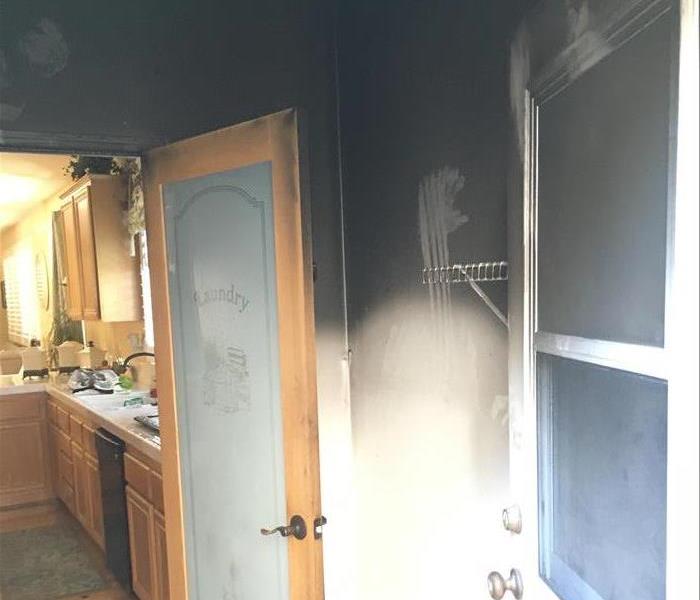 Call us if you have any questions about Fire, Smoke, or Soot Damage?
Call us if you have any questions about Fire, Smoke, or Soot Damage?
Smoke and soot is very invasive and can penetrate various cavities within your home, causing hidden damage and odor. Our smoke damage expertise and experience allows us to inspect and accurately assess the extent of the damage to develop a comprehensive plan of action.
Smoke and soot facts:
- Hot smoke migrates to cooler areas and upper levels of a structure.
- Smoke flows around plumbing systems, seeping through the holes used by pipes to go from floor to floor.
- The type of smoke may greatly affect the restoration process.
Our Fire Damage Restoration Services
Since each smoke and fire damage situation is a little different, each one requires a unique solution tailored for the specific conditions. We have the equipment, expertise, and experience to restore your fire and smoke damage. We will also treat your family with empathy and respect and your property with care.
Have Questions about Fire, Smoke, or Soot Damage?
Call Us Today – 951-351-8033
Mold Remediation in Riverside, CA
4/23/2018 (Permalink)
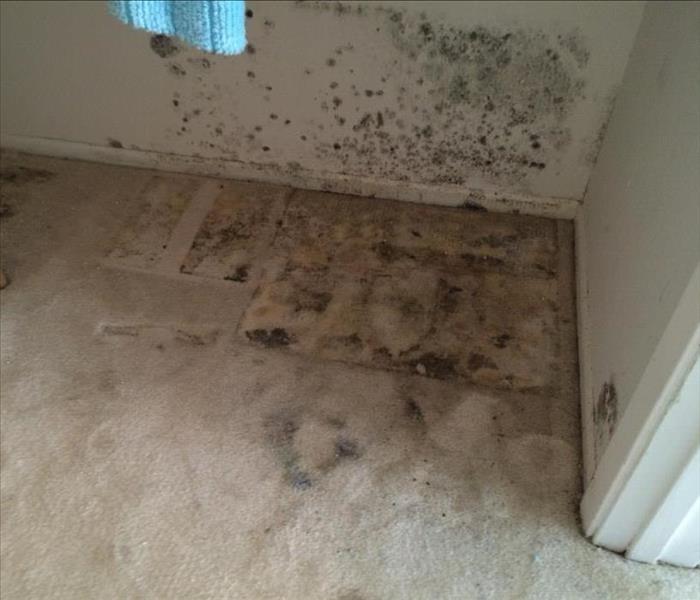 Quick Mold Removal and Remediation in Riverside and surrounding areas. Call us at 951-351-8033
Quick Mold Removal and Remediation in Riverside and surrounding areas. Call us at 951-351-8033
Understanding Mold
Microscopic mold spores exist naturally almost everywhere, indoors and outdoors, so removing all mold from a home or business is impossible. Some restoration businesses advertise “mold removal” and even guarantee to remove all mold, which is a fallacy. Consider the following mold facts:
- Mold is present almost everywhere, indoors and outdoors.
- Mold spores are microscopic and float along in the air, and they may enter your home through windows, doors, or AC/heating systems or even hitch a ride indoors on your clothing or a pet.
- Mold spores thrive on moisture. Mold spores can quickly grow into colonies when exposed to water.
- Before mold remediation can begin, any sources of water or moisture must be addressed. Otherwise the mold may return.
- Let your nose lead the way. Mold often produces a strong, musty odor, and can lead you to possible mold problem areas.
- Even higher than normal indoor humidity can support mold growth. Keep indoor humidity below 45 percent.
Call us if you need Mold Removal and Remediation in your home, apartment or business. 951-351-8033
Where to look for Water Damage
4/18/2018 (Permalink)
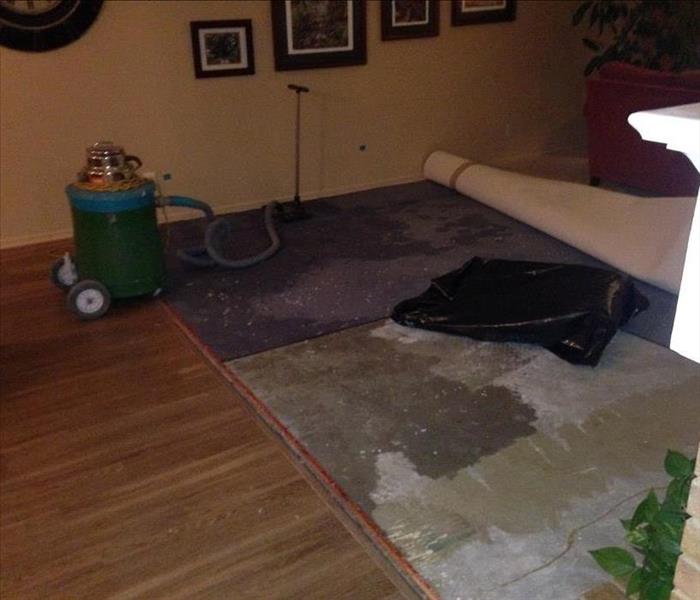 SERVPRO your #1 Cleanup Company in Riverside and surrounding areas
SERVPRO your #1 Cleanup Company in Riverside and surrounding areas
Here are some common causes of water damage and how you can spot the warning signs.
Weather is a common cause of water damage. Rains cause flooding that can get into your home. Even if it isn’t raining there is still moisture in the air. Damp air can lead to condensation and water damage to your walls. This is especially true of basements, bathrooms, and other damp areas of your home that don’t get much airflow.
Appliances like your washing machine, garbage disposal, water heater, toilet, and air conditioner can all contribute to water damage if they leak or stop draining properly.
Water from our pipes and plumbing systems can also cause water damage. Leaks and drips can go on for months, or even years, raising your water bill and doing unseen damage to your home.
So if these are all the ways water can sneak into your home, what are the signs of water damage?
Here are a few warning signs that you have a water damage problem in your home.
Standing water – This may sound pretty obvious, but if you notice water pooling in your house you have a water problem that needs to be taken care of immediately.
Bad smells – While water doesn’t normally have much of a smell, the mold and bacteria that grow in damp environments can give off a distinct musty, wet odor. If you smell mold or mildew you might have a water issue.
Stains and spots – Stains on the ceilings or walls can be a sign of water damage. You might have a leaky pipe or roof. Call a professional to determine the cause of the problem and to clean up the damage before it becomes a serious mold problem.
Peeling paint – Paint damaged by water will start to peel, bubble, or flake off.
Uneven surfaces – Water damage can cause floors, ceilings, walls, and other surfaces to warp and feel uneven.
Cracks – Water is always seeking the path of least resistance out of your home. Water can enter through cracks and once water finds it’s way in, the crack will expand allowing even more to get into your home. Make sure you seal all visible cracks on your property.
If you notice your home has signs of water damage call the experts at SERVPRO of West Riverside City we will immediately come and check it out and assess the situation.
SERVPRO your #1 Cleanup Company in Riverside and surrounding areas
Process of Mold Removal
4/16/2018 (Permalink)
 Mold Behind Bathroom Cabinets
Mold Behind Bathroom Cabinets
Every mold damage scenario is different and requires a unique solution, but the general mold remediation process stays the same. The steps listed below illustrate our “typical” process:
- Emergency Contact - (951) 351-8033
The mold cleanup and restoration process begins when you call us. Our representative will ask a series of questions to help us determine the necessary equipment, resources, and personnel.
- Inspection and Mold Damage Assessment
We carefully inspect your property for visible signs of mold. Mold feeds on cellulose and water and can be hidden from plain view. We use various technologies to detect mold and hidden water sources.
- Mold Containment
Our professionals use various containment procedures to prevent the spread of mold. We may use advanced containment procedures like negative air chambers to isolate the contaminated area with physical barriers and negative air pressure to keep the mold spores from spreading during the cleanup process. All fans and heating and cooling systems will be turned off to prevent the spread of mold.
- Air Filtration
Our specialized filtration equipment allows our Professionals to capture microscopic mold spores out of the air. We utilize powerful “air scrubbers” and HEPA vacuums to prevent the spread of these mold spores while the mold remediation is in process.
- Removing Mold and Mold-Infested Materials
The mold remediation process depends on the amount of mold growth and the types of surfaces on which the mold appears. We’ll use antifungal and antimicrobial treatments to eliminate mold colonies and to help prevent new colonies from forming. It may be necessary to remove and dispose of mold-infested porous materials, like drywall and carpeting, to remediate heavy mold growth.
- Cleaning Contents and Belongings
We clean your furniture, decorative items, curtains, clothing, and other restorable items affected by mold. We use a variety of cleaning techniques to clean and disinfect your belongings. We’re also trained to remove odors and deodorization using fogging equipment.
- Restoration
Depending on the level of mold damage, drywall, subfloors, and other building materials may have been removed. Restoration may involve minor repairs, such as replacing drywall, painting, and installing new carpet; or it may entail major repairs such as the reconstruction of various areas or rooms in a home or business. The restoration step gets your home or business back to normal.
How we help you find Hidden Mold
4/16/2018 (Permalink)
 We understands mold and mold growth and has the training and expertise to remediate the mold in your home or business.
We understands mold and mold growth and has the training and expertise to remediate the mold in your home or business.
There is no easy way to find hidden mold, but we carefully inspect your property for visible signs of mold. Mold feeds on cellulose and water and can be hidden from plain view. We use various technologies to detect mold and hidden water sources.
This photo shows us doing a inspection hole in the drywall where the water damage had happened earlier. As you can see in the photo we found visible mold and started the remediation process immediately. We might find it hard to open up the drywall to check for mold, but if mold goes undetected it has the potential to cause dangerous health effects and can spread through your property in as little as 48 hours.
We understands mold and mold growth and has the training and expertise to remediate the mold in your home or business.
Call us for an inspection if you have had a water damage and might be concerned about mold.
We help you find hidden mold.
Call us at 951-351-8033.
Smoke Damage Cleanup
4/11/2018 (Permalink)
 Call us for a Smoke Damage Professional Consultation today. 951-351-8033
Call us for a Smoke Damage Professional Consultation today. 951-351-8033
A fire can wreak havoc on any residential or commercial building in Riverside, CA. Once everything has settled down, you need to begin addressing the remaining smoke damage. This will require you to hire professional smoke cleaning services. This cleanup team will have a lot to take care of, and you want to allow them to handle remediation rather than attempting to fix items on your own.
1. Remedy Smoke and Fire Damage
Soot damage can travel fast. Areas of the building that did not actually catch fire may still need to be remedied for smoke and soot. This is particularly true for textiles and upholstery. You do not want to simply toss these items in a washing machine. Improperly washing items with soot may only deteriorate them further. Instead, give these items to professionals so that they can be washed and dry-cleaned adequately.
2. Clean Up Fire Retardant
Smoke damage restoration professionals will also need to clean up any fire retardant used to put out the fire. Whether this is material that came from a fire extinguisher or from the firefighters, it could be dangerous to handle on your own. Some extinguishers use ammonium phosphate, and you do not want to use chlorine to clean up that chemical. Experts know what precautions to take to stay safe.
3. Throw Away Badly Damaged Items
Although professionals will know how to salvage some items, it will be best to throw others away. Occasionally, this disposal is in the best interest of your health and safety. For example, food should always be disposed of following a fire. It could become contaminated from smoke and soot, making it dangerous to consume.
Rectifying smoke damage is a multi-pronged approach. The expert team you hire will need to carry out some basic actions to ensure your company gets back up and running in no time.
Visit http://www.SERVPROwestriversidecity.com for more information on commercial fire damage.
Mold Removal in Riverside Area
4/10/2018 (Permalink)
 Call us for a free inspection if you need mold remediation.
Call us for a free inspection if you need mold remediation.
SERVPRO of West Riverside City does remediating of mold in homes and businesses in Riverside and surrounding areas. Since microscopic mold spores exist naturally almost everywhere, indoors and outdoors, removing all mold from a home or business is impossible, but we understand mold and mold growth. SERVPRO of West Riverside has the training and expertise to remediate the mold in your home or business.
It is important, especially after a water damage, to quickly address any signs of mold in the home or business. If there is moisture present, growth can start in as little as 48 hours. If not addressed in a timely manner, mold spores can quickly grow into colonies when exposed to water. These colonies may produce allergens and irritants. Mold can also produce a strong, musty odor, and that odor can lead you to possible mold problem areas.
If you discover mold in your home, don’t hesitate to call the professionals who will abide by a remediation process:
- Contact - (951) 351-8033
- Inspection and Mold Damage Assessment
- Mold Containment
- Air Filtration
- Removing Mold and Mold-Infested Materials
- Cleaning Contents and Belongings
Places for Mold Growth
4/9/2018 (Permalink)
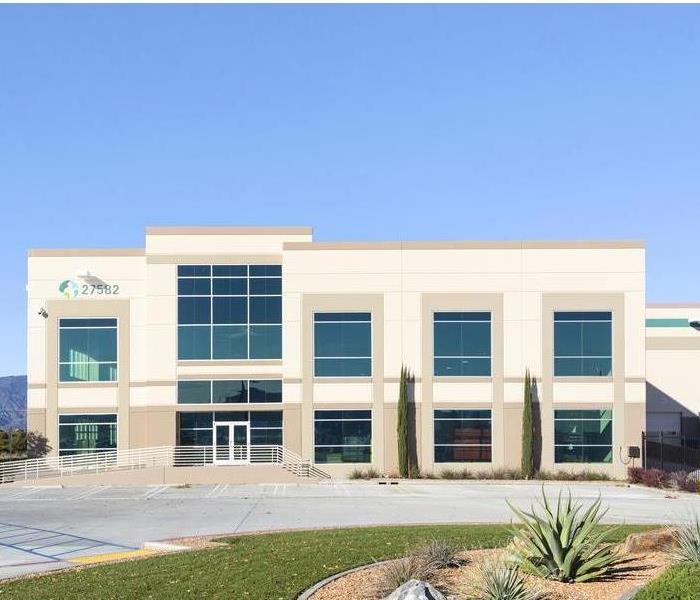 If you suspect mold somewhere, contact SERVPRO for an inspection at 951-351-8033
If you suspect mold somewhere, contact SERVPRO for an inspection at 951-351-8033
Mold spores are present indoors and outdoors and do not pose a major problem until they find an environment that is conducive to growth. If you have noticed a mold or mildew smell in a commercial property, check five of the most common places for signs of visible mold. If you smell mold but cannot find any evidence, you should contact a service in Riverside, CA that provides mold testing services.
1. Near water sources: Mold requires moisture to thrive. Bathrooms and kitchens are more likely to develop a mildew smell and mold than drier and less humid areas. Other parts of the building exposed to water may run the risk of developing mold.
2. Appliances: Appliances that process water such as air conditioners or water heaters are also prone to developing mold. Condensate or drain pans and terminal units are common locations for mold colonies.
3. Ductwork: HVAC systems expose ductwork to humid air. If condensation accumulates in duct linings or a leak occurs, mold can develop. Make sure that air-flow rates are set at an appropriate level.
4. Walls: Condensation, roof leaks or mechanical system leaks can lead to the growth of visible or hidden mold within walls. Moist masonry or wallboard is particularly susceptible to mold growth.
5. Ceiling tiles: Depending on the material, ceiling tiles can absorb moisture that encourages the development of mold. Several common culprits include condensation from pipes, humidity around HVAC vents and leaks.
Inspect any part of a property with a mildew smell for visible mold, but do not try to find hidden mold. If you happen to disturb a colony in your search, you can spread many more mold spores throughout a property. If you are concerned about mold growth in a commercial property in Riverside, CA contact us for an inspection!
Visit http://www.SERVPROwestriversidecity.com for more information on mold.
Sewage Damage and Sewage Cleanup
4/2/2018 (Permalink)
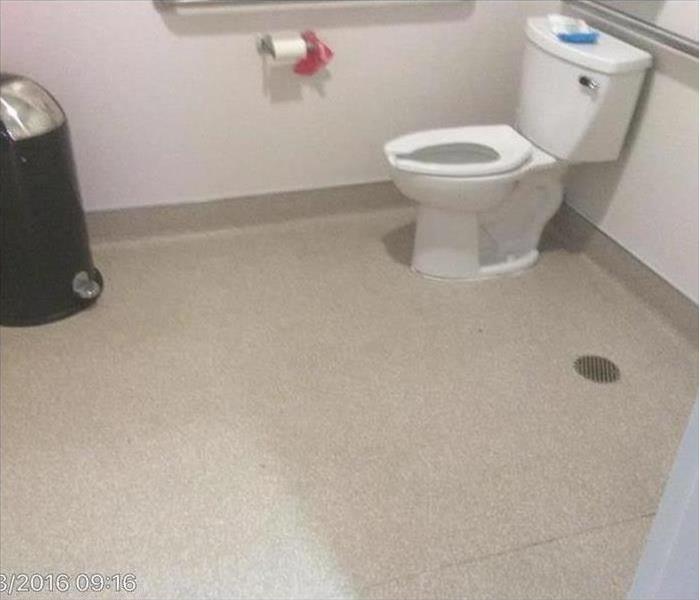 Sewage Cleanup/ Toilet Overflow
Sewage Cleanup/ Toilet Overflow
No one enjoys cleaning up after a flooded toilet, but the process must be done quickly and thoroughly to reduce the risk of your family becoming ill due to sewage backup. The flooded area, whether confined to a small bathroom or spread out over an entire floor of your home, needs to be scrubbed thoroughly and disinfected to remove all traces of bacteria. When you begin the time-consuming process of sewer cleanup, use these tips to restore flooded areas.
Cleaning
Before you can begin disinfecting the area as part of the sewer cleanup process, you must remove every bit of remaining water. Depending on how much dirty water remains in the flooded area, you can use any of the following items to remove it:
• Old towels
• Buckets
• Sump pump
• Trash pump
• Wet vac
Once the water has been removed, use wet rags and household cleaners to wipe down every surface that touched the sewage to remove every trace of dirt, debris, and filth from the area. Any porous items that may have absorbed water should either be thoroughly washed and dry cleaned or discarded.
Disinfecting
Once the area has been cleaned and all filth has been removed, you can begin the process of disinfecting. Mixing household disinfectant sprays with bleach and warm water makes the best solution to kill any remaining bacteria. Apply the solution to every surface that may have been contaminated and let it soak for a few minutes before scrubbing with a clean rag. After the solution has been removed, rinse every surface with clean, warm water.
Dealing with a flooded toilet in Riverside, CA is never fun. Sewage backup presents a hazard, so it should be cleaned up as quickly and thoroughly as possible. For small areas, you may choose the complete the sewer cleanup by yourself, but larger areas may require the help of a qualified restoration company. In either case, use these tips on cleaning and disinfecting to make the cleanup process easier.
Visit http://www.SERVPROwestriverisidecity.comfor more information on water damage.
Water Damage and Restoration Riverside, CA
4/2/2018 (Permalink)
 Call us for an inspection!
Call us for an inspection!
If you have a water loss in your home or business it is important to get it taken care of immediately.
1. The first step is to get the water extracted. Once all of the water is extracted, SERVPRO can begin to get the drying process started. It is critical to make sure all of the water is removed to prevent secondary damages from happening.
2. Once all of the water is removed, SERVPRO will place the required number of air movers and dehumidifiers. This equipment will be monitored daily to make sure it is working properly.
3. After the structure is dry, SERVPRO can start the rebuilding process. In most cases, SERVPRO can handle every job from start to finish.
If you have any questions, feel free to reach out to us at anytime.
For more information on the water damage restoration process here.
Mold Removal and Mold Remediation
3/28/2018 (Permalink)
Molds are found in every environment, and mold spores reproduce rapidly when moisture is present. An institute of Medicine study found excessive dampness indoors encourages the growth of molds and other organisms potentially causing a public health problem. The EPA advised that the potential health concerns from molds are important reason to prevent moisture problems leading to mold growth. Possible health effects include runny nose, sneezing, coughing, aggravation of asthma, sore throat, or inflammation of the sinuses.
SERVPRO of West Riverside professionals handle water damages every day and know prompt action is required to prevent mold growth, if there is an ongoing moisture problem in the building, be alert for:
- The presence of visible mold
- Strong, musty odors, which may indicate mold is present
- Any evidence of past moisture problems that might have caused undetected mold growth
- Excessive humidity.
These conditions may require the expertise of a qualified Indoor Air Quality/Environmental Professional to inspect the building for mold growth and water damage problems.
SERVPRO of West Riverside City cares about proper restoration of your structure and, in most water damage situations, can safely restore your building to preloss condition.
Call us for a residential or commercial mold inspection!
Mold Damage and Mold Removal
3/23/2018 (Permalink)
 Get professional help to remediate and removal all mold!
Get professional help to remediate and removal all mold!
The Truth is, It's Everywhere
Let’s face it, mold is everywhere. It can be found indoors and outdoors. It can enter your home or business through windows, vents and HVAC systems. Mold from outdoors can attach to clothing, shoes, pets and can be carried indoors. It grows anywhere, especially where there is moisture. And the worst part is, it can cause a variety of health effects. Children, the elderly, and anyone with respiratory problems are more likely to suffer the effects mold can have.
Mold’s Best Friend:
Water. Any home or business can quickly become infested with mold with the introduction of a water source, like a roof or plumbing leak. Mold can spread throughout a property in as little as 48-72 hours.
“Mold Removal” vs. Remediation
Because mold is everywhere, removing all mold from your home or business is impossible. A qualified restoration company understand the science behind mold and mold growth and knows how to remediate the problem area. So what do you do when you find mold growth in your home or business?
- Step 1: Emergency Contact SERVPRO at 951-351-8033
- Step 2: Inspection and Mold Damage Assessment
- Step 3: Mold Containment
- Step 4: Air Filtration
- Step 5: Removing Mold and Mold-Infested Materials
- Step 6: Cleaning Contents and Belongings
- Step 7: Restoration
Fire Don't Have to Burn
3/21/2018 (Permalink)
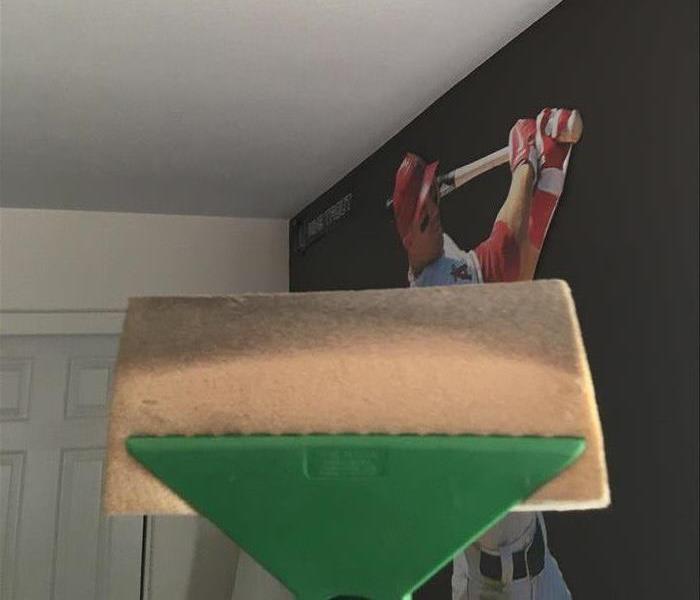 Fires in the home or workplace may occur from something as simple as an overloaded socket.
Fires in the home or workplace may occur from something as simple as an overloaded socket.
Fires can happen anywhere at anytime in the workplace or the home. Home fires are most commonly caused from cooking, candles, careless smoking, space heaters or dirty chimneys. Fires may also erupt from an overloaded outlet or extension cord.
When it comes to fires in the workplace, the issue, as in the home, is often general negligence. Negligence often refers to leaving food in the microwave too long, leaving hot drinks where they may be spilled on electrical wires, and as in the home, overloading sockets or extension cords.
Most of these fires can be avoided by keeping a vigilant eye on things and regularly checking and maintaining appliances, extension cords and sockets, as well as keeping both home and work environments clean and free of clutter. As well, it helps to prepare for potential fires by keeping fire extinguishers, smoke alarms and carbon monoxide alarms in high risk areas throughout the house and workplace. Where appropriate, especially in the work environment, think about having fire sprinkler systems installed. As well, make sure family, friends and employees are aware of safety precautions involved to prevent potential fires.
If your home or business does suffer a fire damage, water damage, mold damage or bio-hazard event, SERVPRO of West Riverside City is ready 24/7 to be 'Faster to any size disaster'. Our team is IICRC trained and certified to make it 'Like it never even happened'. And we will treat your property, family and employees with the utmost of compassion, respect and consideration.
Call SERVPRO of West Riverside City 951-351-8033
What to Expect with Professional Water Extraction
3/19/2018 (Permalink)
Whether by storm or by burst pipe, you wake up one morning to find that your Riverside, CA basement is flooded with two feet of water. What can you do next? The next step is usually to call a specialist who can remedy the flood with the proper equipment. If this sounds daunting or you aren’t sure what to expect, here is what happens when you use a professional service to help with your flooded basement.
1. Find the Source
The first thing that any professional is going to do is find the source of your flooding. If you already know where the leak is coming from, you can, of course, point them in the right direction. In some cases, it may be difficult to tell where the leak is coming from on your own.
2. Extract Water
The next step is to extract the water. Experts will have equipment with them that you may not have access to on your own. For example, some people may have a sump pump in their home, but many don’t. Generally, before they can begin to restore the property, specialists will use a trash pump mounted to their truck to extract the flooding in your basement.
3. Salvage Any Materials
If there are any materials that can be salvaged, they will do this for you. Additionally, they will be able to throw out what can’t be saved. This can be anything from drywall, carpets, stuffed animals, bedding and even ceiling tiles. If it’s porous, mold can grow inside the spaces of the object and be impossible to clean.
At the end of the day, hiring a professional service to remove water from your basement and to restore your home is less stressful than trying to handle it on your own. Without the proper equipment, you may not get the job done and it could lead to more issues and property damage down the road. A team of experts will make sure everything is quickly and thoroughly taken care of, giving you your home back as soon as possible. Visit http://www.SERVPROwestriversidecity.comfor more information on storm damage.
Celebrate National Wildlive Week
3/13/2018 (Permalink)
This week we can all join the annual celebration of National Wildlife Week!
The rich history of National Wildlife Week dates all the way back to its first celebration in 1938. As our longest-running education program, National Wildlife Week connects budding conservationists of all ages to the awesome wonders of wildlife. Now more than ever, these connections serve as a vital component to recovering our nation’s most vulnerable wildlife.
For people across the nation, this week is a chance to learn more about the incredible animals native to North America, their habitats, and how we can help them thrive. This year we’re highlighting some of those species as we hit the road to the Final Fur and providing educational resources for students to take action in order to save our treasured species.
Read more on www.nwf.org
Common Places to Find Mold
3/12/2018 (Permalink)
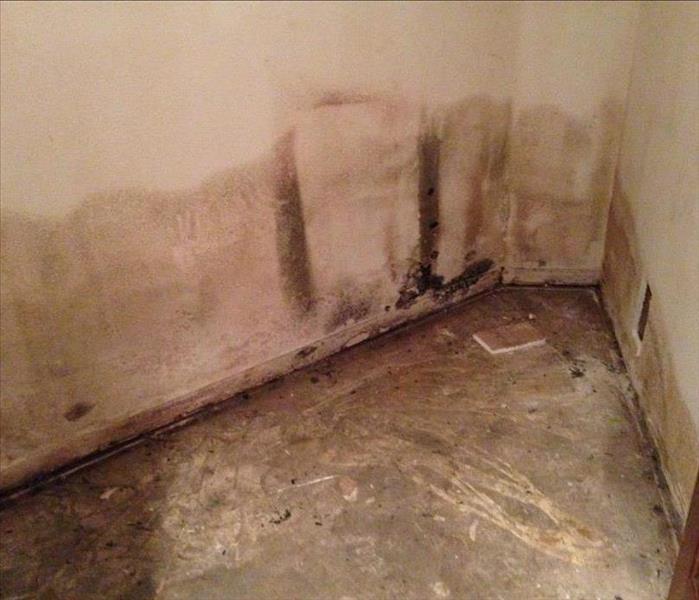
Mold spores are present indoors and outdoors and do not pose a major problem until they find an environment that is conducive to growth. If you have noticed a mold or mildew smell in a commercial property, check five of the most common places for signs of visible mold. If you smell mold but cannot find any evidence, you should contact a service in Riverside, CA that provides mold testing services.
1. Near water sources: Mold requires moisture to thrive. Bathrooms and kitchens are more likely to develop a mildew smell and mold than drier and less humid areas. Other parts of the building exposed to water may run the risk of developing mold.
2. Appliances: Appliances that process water such as air conditioners or water heaters are also prone to developing mold. Condensate or drain pans and terminal units are common locations for mold colonies.
3. Ductwork: HVAC systems expose ductwork to humid air. If condensation accumulates in duct linings or a leak occurs, mold can develop. Make sure that air-flow rates are set at an appropriate level.
4. Walls: Condensation, roof leaks or mechanical system leaks can lead to the growth of visible or hidden mold within walls. Moist masonry or wallboard is particularly susceptible to mold growth.
5. Ceiling tiles: Depending on the material, ceiling tiles can absorb moisture that encourages the development of mold. Several common culprits include condensation from pipes, humidity around HVAC vents and leaks.
Inspect any part of a property with a mildew smell for visible mold, but do not try to find hidden mold. If you happen to disturb a colony in your search, you can spread many more mold spores throughout a property. If you are concerned about mold growth in a commercial property in Riverside, CA contact a service that specializes in mold testing and clean-up as soon as possible.
Visit http://www.SERVPROwestriversidecity.com for more information on mold.
Large Loss Water Damage - Call West Riverside City
2/23/2018 (Permalink)
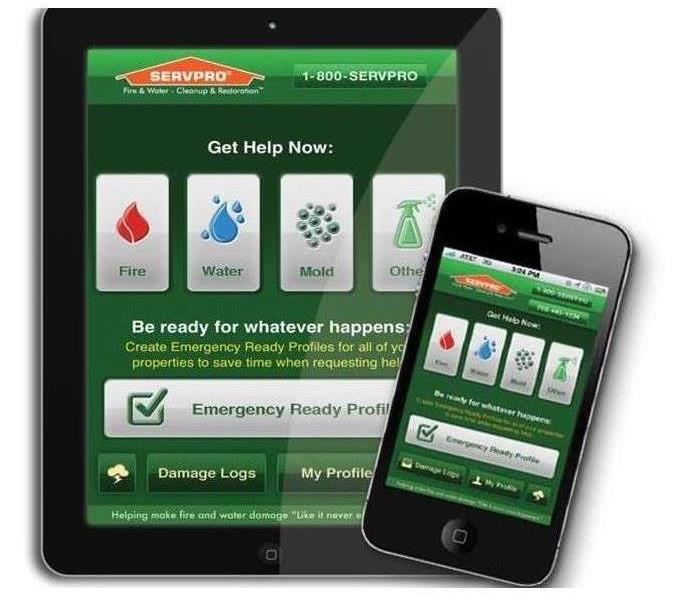 Be Ready for Disaster with the App. Press one button and we will be there!
Be Ready for Disaster with the App. Press one button and we will be there!
If you have a large water damage and you are a business that people rely on, call SERVPRO first!
Many of our country's beautiful resort style hotels learns first hand the power and speed of the SERVPRO network when it comes to getting an enormous water damage repaired.
It is hard to think clearly when you have a flood in one room of your home let alone an entire floor of your award-winning hotel.
Luckily SERVPRO makes it easy to access your information in case of an event (which happens every day, and when you least expect it) by providing a service called SERVPRO Ready Plan and it is a free service that you should have done for your business just in case tragedy strikes your building!
Download the app here now and SERVPRO will be in touch with soon!
CLICK HERE TO DOWNLOAD
The signs of Black Mold!
2/21/2018 (Permalink)
Usually, you can smell mold before you will ever see it. Mold can be extremely harmful to you, your family and/or your friends.
If you experience sudden health-related problems, you might have a black mold problem.
We suggest you call a mold specialist at SERVPRO to come inspect your home or office and let the franchise professional decide if there is indeed a mold problem or not. SERVPRO has professional grade equipment to handle black mold so your mind can rest.
After the inspection and mitigation of the mold make sure you have the SERVPRO of West Riverside City specialist come back out and follow up on the fact that the mold has been removed.
If you need a qualified company to remove the mold call SERVPRO at 951-351-8033
Spring Cleaning Tips
2/16/2018 (Permalink)
 Spring is here, its time to get cleaning!
Spring is here, its time to get cleaning!
If spring is in the air, don't let a musty house spoil it. Here are seven tips for giving the season the welcome it deserves.
- The best refrigerator cleaner is a combination of salt and soda water. The bubbling action of the soda water combines with the abrasive texture of the salt to make a great cleaner.
- The best way to get rid of lime buildup around the faucet it is to lay paper towels over the fixture, soak it with vinegar and let it set for an hour. The deposits will soften and become easier to remove.
- Clean screens with a scrap of carpeting. It makes a powerful brush that removes all the dirt.
- Clean windows with a rag and soapy water, and then dry them with another rag. You can also go to an auto-parts store and buy a windshield squeegee, which cleans very well.
- If drapes are looking drab, take them out of the window, remove the hooks and run them through the air-fluff cycle in the dryer along with a wet towel (to draw off the dust) for 15 minutes. Hang them back in the windows immediately.
- Clean the blades of a ceiling fan by covering them with a coat of furniture polish. Wipe off the excess and lightly buff.
- Sometimes comforters, blankets and pillows don't need to be cleaned, but they do need to be aired out after a long winter in your closed-up home. Take them outside and hang them on a clothesline for a day.
If your house needs more detailed cleaning than you can handle, please don't hesitate to call us for an inspection!
Happy Spring Cleaning everyone!
Large Loss Water Damage - Call West Riverside City
2/16/2018 (Permalink)
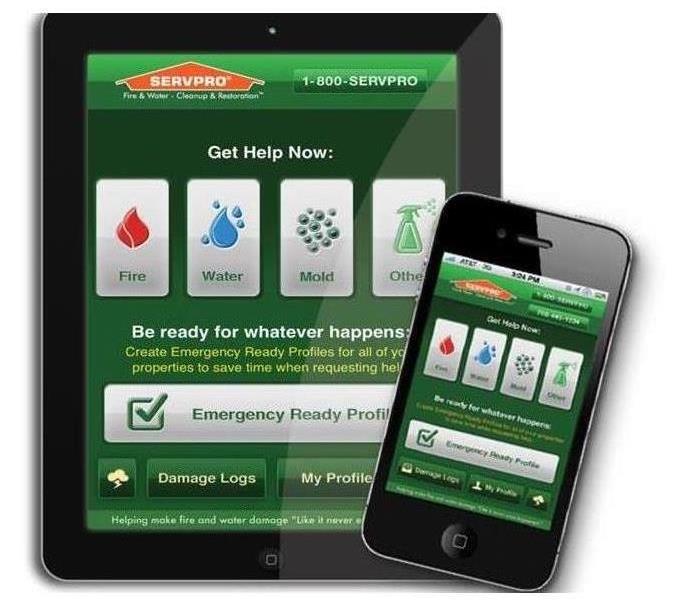 Be Ready for Disaster with the App. Press one button and we will be there!
Be Ready for Disaster with the App. Press one button and we will be there!
If you have a large water damage and you are a business that people rely on, call SERVPRO first!
Many of our country's beautiful resort style hotels learns first hand the power and speed of the SERVPRO network when it comes to getting an enormous water damage repaired.
It is hard to think clearly when you have a flood in one room of your home let alone an entire floor of your award-winning hotel.
Luckily SERVPRO makes it easy to access your information in case of an event (which happens every day, and when you least expect it) by providing a service called SERVPRO Ready Plan and it is a free service that you should have done for your business just in case tragedy strikes your building!
Download the app here now and SERVPRO will be in touch with soon!
CLICK HERE TO DOWNLOAD
Smoke Damage in your Riverside, CA home
2/16/2018 (Permalink)
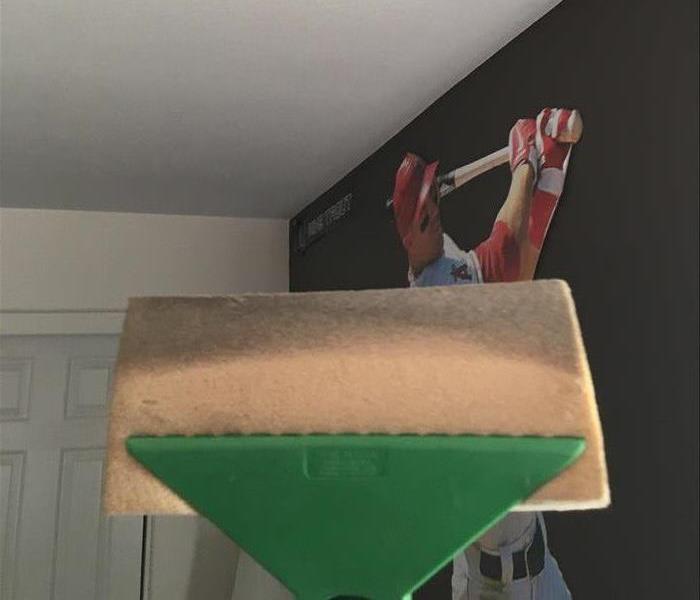 Cleaning a visibly "clean" wall to find heavy amounts of invisible soot on the walls. Have your home professionally cleaned after a smoke damage.
Cleaning a visibly "clean" wall to find heavy amounts of invisible soot on the walls. Have your home professionally cleaned after a smoke damage.
You’re relieved that the fire damage was minimal but shocked to find that the smoke damage is extensive.
It is easy to forget about the destructive power of smoke but we are quickly reminded of it by the horrible odor that is filling your home. The smoky pollutant irritates your eyes and airways, while the sticky residue on scorched walls and the layer of ashes begin to corrode your personal possessions.
The urgency to clear out the smoke sets in as you realize that although the flames did not reach far, the smoke did massive damage. Smoke and ashes travel through doors and vents, reaching your entire home, penetrating your carpet, drapes, and furniture with the odor of smoke.
Even the paint on the wall is not safe! Microscopic molecules of smoke embed deep into the pores and crevices of almost anything.
As you can see, a simple opening of windows, a wipe down with a household cleaner, and the passage of time will not be enough to fix this sort of smoke damage.
So call SERVPRO to come and put your life back together quickly and professionally. 951-351-8033
Mold Containment in Riverside
2/1/2018 (Permalink)
 This is a mold containment to keep spores from spreading.
This is a mold containment to keep spores from spreading.
This home in Riverside, CA was affected by mold in the living room and hallway. The customer had noticed an odd smell and discoloring in their kitchen. They called SERVPRO to inspect for damage and mold was discovered. It had been a slow leak from the sink in the kitchen into the hallway wall. Our crew had to cut through the drywall to find the mold that had spread through part of the insulation. All of the affected materials were removed from the home and then an air scrubber was placed to ensure the air was safe to breathe. The plastic containment in this photo was used to ensure no spreading of mold spores to anywhere else in the home.
Call SERVPRO is you think there might be mold growth in your home!
Why you need the SERVPRO ERP
1/30/2018 (Permalink)
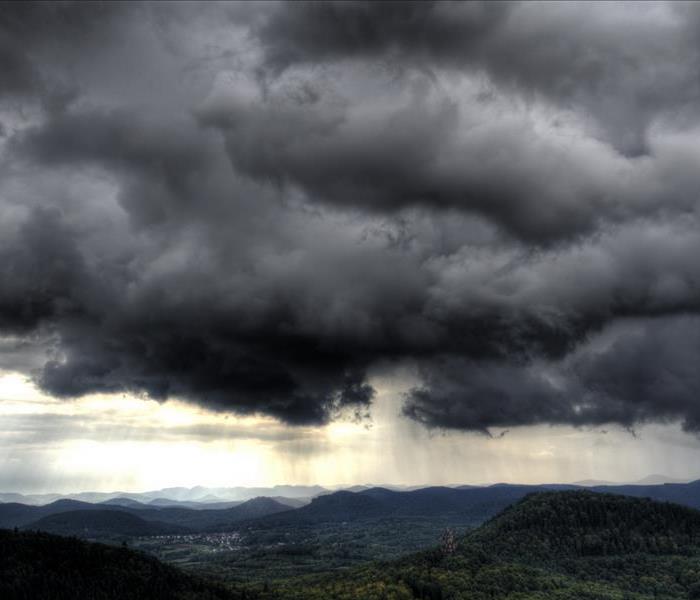 Be ready for whatever disaster that might strike!
Be ready for whatever disaster that might strike!
No matter where you live, it is important to be informed and prepared for any natural disaster that may occur. Natural disasters often strike without warning, leaving behind a trail of destruction and devastation. Though Mother Nature's disasters are often unpredictable, there are steps you can take to ensure you are prepared.
Contact SERVPRO of West Riverside City to establish an Emergency READY Profile (ERP) for your home and business property. SERVPRO's ERP serves as a quick reference document, detailing important building and contact information for your property in the event of an emergency. The ERP is an ideal supplement to any existing preparedness plan, or may be used as a standalone document. Knowing what to do and who to call in advance is the key to timely mitigation, and can minimize the effects of any weather-related disaster, water, or fire damage to your home or business.
When disaster strikes, make sure you have experienced professionals on the line. No matter how big or small, SERVPRO of West Riverside City will be ready to help make your property damage "Like it never even happened."
Common Types of Water Leaks
1/30/2018 (Permalink)
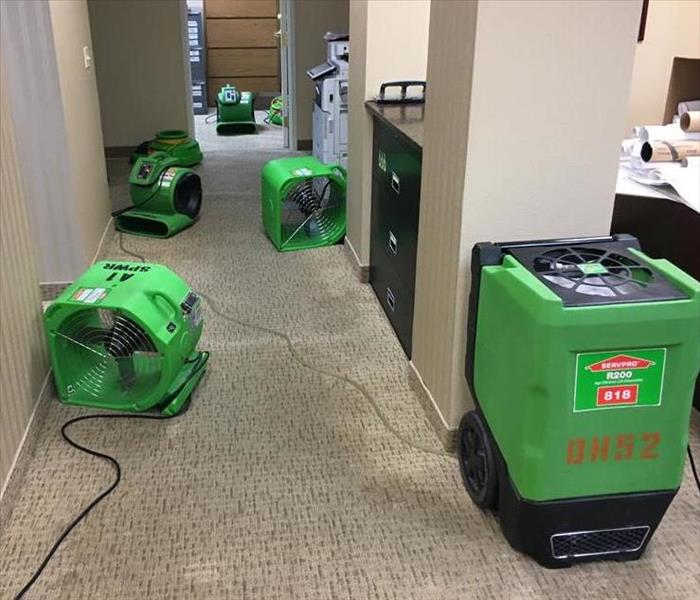 SERVPRO will be there to help with any kind of water damage!
SERVPRO will be there to help with any kind of water damage!
SERVPRO technicians deal with all types of water leaks.
Leaks are one of the most expensive types of damage that can happen to a home, but also one of the least detected. In some cases it can take months or even years for leaks to cause visual damage, but by that point, it’s too late to take preventative measures. Leaks can weaken structures, waste water, dissolve building materials, creates dangerous compounds, and foster mold growth. These are some of the most common leaks we encounter on a typical residential call, and how they start:
Technicians from SERVPRO of West Riverside City are trained extensively in water damage restoration of all kinds, and we feel confident we can handle any water disaster you have. Call us 24/7 at 951-351-8033 for emergency services or a quote.
Dryer Fire Damage
1/30/2018 (Permalink)
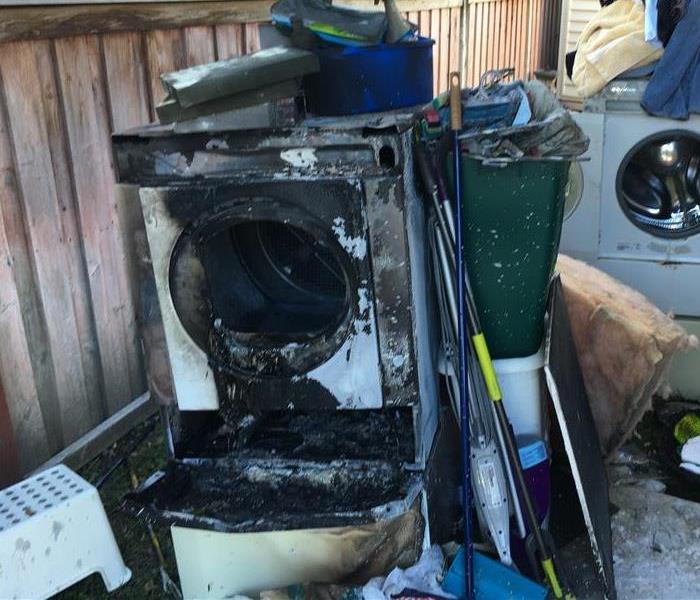 Dryer fires are one of the lead causes of fires in home
Dryer fires are one of the lead causes of fires in home
You may not think of your clothes dryer as a fire hazard, but these appliances account for tens of thousands of house fires each year. The problem most frequently occurs when lint and dust are allowed to build up. Over time, this can cause the dryer vent to become clogged with highly flammable materials, which easily combust when exposed to high temperatures. Your best option for dryer safety is to clean the lint trap each time before you use the dryer, and to inspect and clean the dryer vent area to remove lint buildup and other potential blockages. Regular cleaning can ultimately make all the difference in avoiding a house fire.
Quick statistics: 2,900 home clothes dryer fires are reported each year and cause an estimated 5 deaths, 100 injuries, and $35 million in property loss.
How do I Clean up After a Water Damage?
1/30/2018 (Permalink)
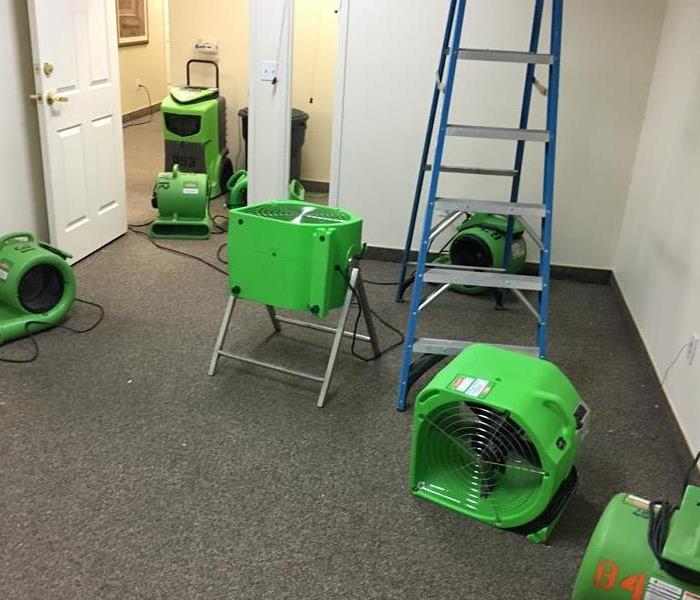 Call SERVPRO if you have any questions regarding what to do if you have a water damage!
Call SERVPRO if you have any questions regarding what to do if you have a water damage!
If you have a water loss in your home or business it is important to get it taken care of immediately.
1. The first step is to get the water extracted. Once all of the water is extracted, SERVPRO can begin to get the drying process started. It is critical to make sure all of the water is removed to prevent secondary damages from happening.
2. Once all of the water is removed, SERVPRO will place the required number of air movers and dehumidifiers. This equipment will be monitored daily to make sure it is working properly.
3. After the structure is dry, SERVPRO can start the rebuilding process. In most cases, SERVPRO can handle every job from start to finish.
If you have any questions, feel free to reach out to us at anytime.
What to do Immediately after a Home Fire
1/30/2018 (Permalink)
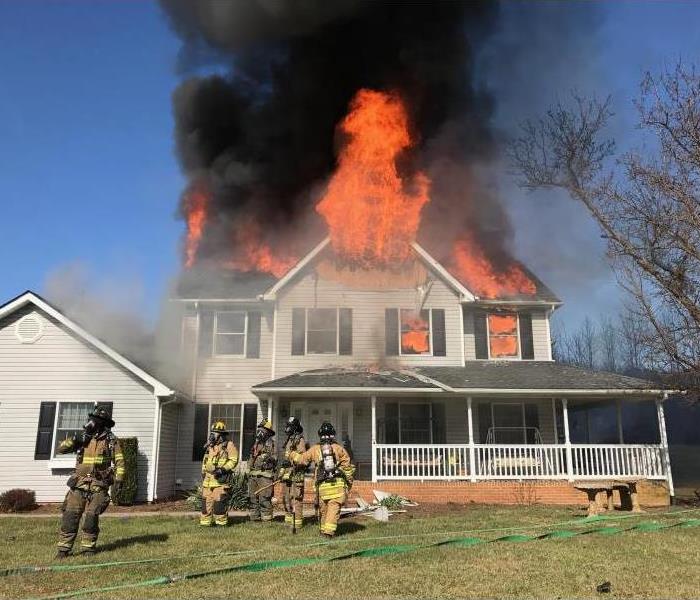 SERVPRO is here to help!
SERVPRO is here to help!
- Ask whether it is safe to enter the home. Do not enter if the fire authorities deem it unsafe. They may establish a safety zone, but never assume a room is safe, until it has been cleared to enter.
- Know who to call.
- Contact family members and let them know you are safe, and unharmed.
- Contact your insurance agent. They will be able to talk you through the necessary steps, including proper documentation and emergency lodging and living expenses (keep all of your receipts!) The insurance company may assist in securing a company to help with clean up options.
- You may request SERVPRO at this time for contents cleaning, restoration etc. Contact SERVPRO.
- Another call may be to your landlord if applicable, and to your local American Red Cross.
- Secure the property to prevent possible looting. SERVPRO is available to assist with securing property/ Board Ups.
- If water hoses were used to exterminate the fire, drying your home is critical. It is best to call the professionals at SERVPRO to do water/ fire cleanups. Water can lead to mold damage if not dried properly. SERVPRO is an approved restoration contractor for many major insurance carriers and adheres to the highest standards in the restoration industry.
- Seek counseling if needed. Children and adults can feel a traumatic sense of loss, and may need help to avoid a lasting sense of sadness and disorientation after a house fire. Don’t be afraid to reach out for help. A house fire is a traumatic event and individuals need to be treated with respect and compassion by those close to the process of rebuilding.
For more information on contents and structural drying, extinguisher residue and soot removal call SERVPRO at 951-351-8033.
Cleaning Up Sewage Backup
1/30/2018 (Permalink)
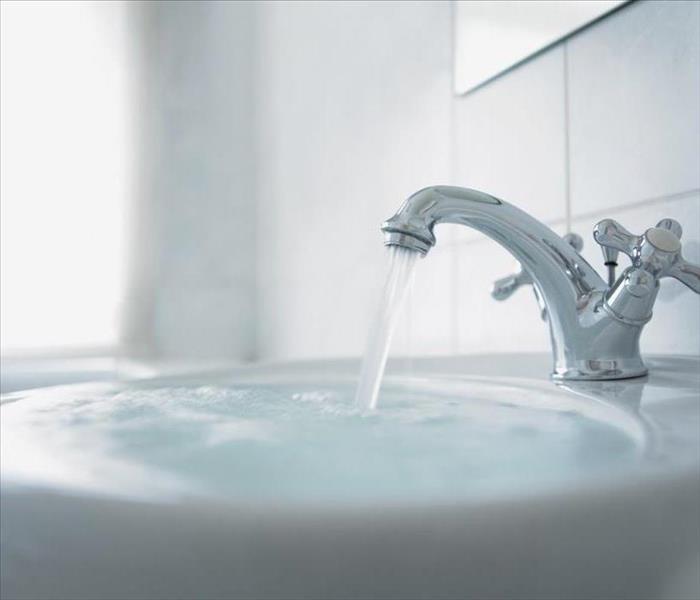 Call SERVPRO for your Sewage Backup Problems
Call SERVPRO for your Sewage Backup Problems
No one enjoys cleaning up after a flooded toilet, but the process must be done quickly and thoroughly to reduce the risk of your family becoming ill due to sewage backup. The flooded area, whether confined to a small bathroom or spread out over an entire floor of your home, needs to be scrubbed thoroughly and disinfected to remove all traces of bacteria. When you begin the time-consuming process of sewer cleanup, use these tips to restore flooded areas.
Cleaning
Before you can begin disinfecting the area as part of the sewer cleanup process, you must remove every bit of remaining water. Depending on how much dirty water remains in the flooded area, you can use any of the following items to remove it:
• Old towels
• Buckets
• Sump pump
• Trash pump
• Wet vac
Once the water has been removed, use wet rags and household cleaners to wipe down every surface that touched the sewage to remove every trace of dirt, debris, and filth from the area. Any porous items that may have absorbed water should either be thoroughly washed and dry cleaned or discarded.
Disinfecting
Once the area has been cleaned and all filth has been removed, you can begin the process of disinfecting. Mixing household disinfectant sprays with bleach and warm water makes the best solution to kill any remaining bacteria. Apply the solution to every surface that may have been contaminated and let it soak for a few minutes before scrubbing with a clean rag. After the solution has been removed, rinse every surface with clean, warm water.
Dealing with a flooded toilet in Riverside, CA is never fun. Sewage backup presents a hazard, so it should be cleaned up as quickly and thoroughly as possible. For small areas, you may choose the complete the sewer cleanup by yourself, but larger areas may require the help of a qualified restoration company. In either case, use these tips on cleaning and disinfecting to make the cleanup process easier.
Press here for more information on water damage.
Mold Containment used when removing mold
1/29/2018 (Permalink)
 This photo shows a containment put up in Riverside, CA home
This photo shows a containment put up in Riverside, CA home
Containment during remediation is used to limit mold releases into the air and surroundings within a building. By allowing your building to have a quarantined area where the mold affected area does not spread allows for the tenant’s space to have greater chance of cleanliness and also improves the efficiency of the mold remediation process. In assessing the mold situation in a building, you want to find where the source is. In identifying the source, it allows for a greater chance for complete removal of the mold. Depending on the size of the mold area it is important to understand what types of containment methods could be used. The three most common types are surface containment, or the area affected, local containment which consists of the area affected and the immediate area, or a full containment which includes the entire building. By properly assessing your unique situation and creating a plan with one of these methods for mold remediation, then you can implement a plan to begin the removal process of the mold within a building.
We can help ANY commercial Property
1/29/2018 (Permalink)
A lot of people know about our fire and water services, but SERVPRO can service you in more ways than just an emergency. Our crew is also certified in various types of commercial cleaning as well as restoration. Our franchise is trained in various types of odor removal and cleaning, like biohazard removal, vandalism events as well as your general white glove tests. Whether a property management company needs a cleaning before their grand opening or hospital has spilled some dangerous biohazards, we aim to make sure that your commercial facility operates with excellent health and safety along with minimal interruption. This is why we operate 24/7 and preach our 1-4-8 program to allow you to feel safe in using our team to service your property. Our franchise focuses our efforts to make sure that we can be a reliable resource for any and all emergencies in your facility. In the event of an emergency please call SERVPRO of West Riverside City at 951-351-8033.
Heavy Rains Causes Roof Leak!
1/17/2018 (Permalink)
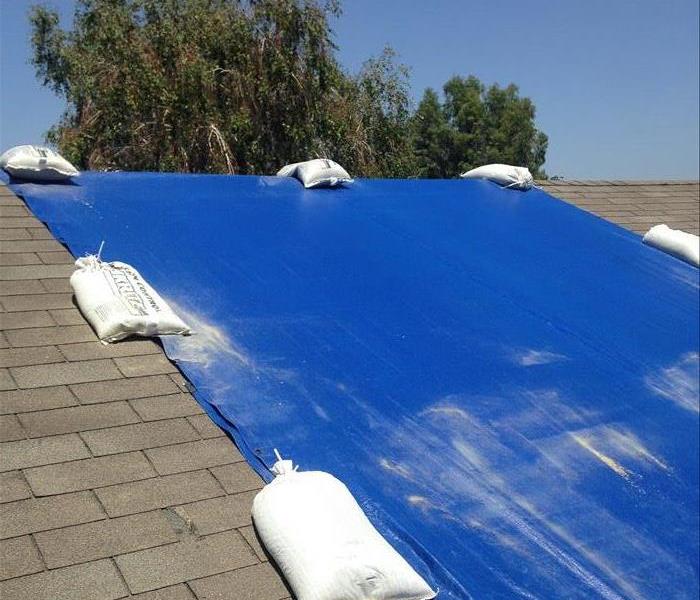 This photo shows a roof tarping of a roof with damages from a recent storm.
This photo shows a roof tarping of a roof with damages from a recent storm.
Let's be honest, how often do you really climb up onto your roof and check to make sure everything is looking one hundred percent? Probably not at all, I would assume that most people don't. It's not until they experience a storm damage that they realize their roof may not be in the best shape to be over their head. Recently storms rolled through Southern California and a lot of unhappy homeowners realized that their homes were NOT prepared for all the rain that we were receiving. Because the high winds and heavy rains were not a good combination and led to most water damages within the ceiling and/or in the home. SERVPRO should be your first call when it comes to any storm damage that you may experience.
Call us for an inspection if you think you might have a roof leak!
Mold Damage can Ruin your Home's Framing
1/17/2018 (Permalink)
 Mold Damage in Riverside, CA Home
Mold Damage in Riverside, CA Home
Mold Can Even Damage Your Home's Framing, Just Like This Riverside, CA home.
When given the chance, time and right conditions mold can even damage your home's framing.
Water by itself is harmless but under the right conditions with other materials or substances, it will help foster microbial growth as seen in this Woodburn, Oregon home.
The smallest leaks can create issues over time that eventually damage some materials beyond cleaning and treating to full repairs and replacement.
The sooner you begin the process to dry out the material the better off you'll be. Call SERVPRO of West Riverside City at 951-351-8033 for an inspection and estimate to dry your home.
Our technicians are highly qualified in the services we provide and they're always ready to help.
What to do if you Discover Mold?
1/17/2018 (Permalink)
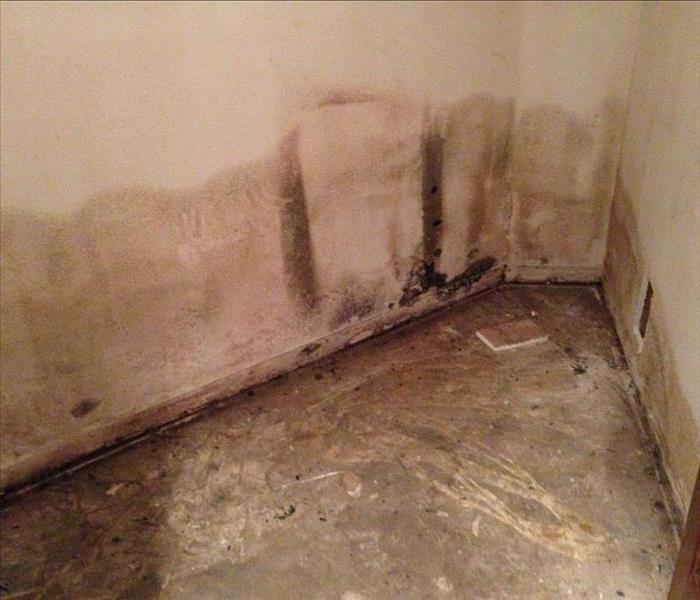 Mold should always be removed safely!
Mold should always be removed safely!
If you see visible mold, do not disturb it. You can inadvertently spread the mold. Dead mold spores can be just as harmful as live spores. Bleach and other cleaners will not get rid of mold, but may actually help the mold spread. When mold is disturbed, the mold can release microscopic mold spores which become airborne and can circulate inside your home.
What to Do:
- Stay out of affected areas.
- Turn off the HVAC system and fans.
- Contact SERVPRO for mold remediation services.
What Not to Do:
- Don’t touch or disturb the mold.
- Don’t blow air across any surfaces with visible or suspected mold growth.
- Don’t attempt to dry the area.
- Don’t spray bleach or other disinfectants on the mold.
If you have noticed any mold growth in your home or office, please don't hesitate to contact SERVPRO to get a professional opinion on what to do next!
Mold Containment In Norco, CA Home
1/17/2018 (Permalink)
 Mold Containment in Norco, CA Home
Mold Containment in Norco, CA Home
Containment during remediation is used to limit mold releases into the air and surroundings within a building. By allowing your building to have a quarantined area where the mold affected area does not spread allows for the tenant’s space to have greater chance of cleanliness and also improves the efficiency of the mold remediation process. In assessing the mold situation in a building, you want to find where the source is. In identifying the source, it allows for a greater chance for complete removal of the mold. Depending on the size of the mold area it is important to understand what types of containment methods could be used. The three most common types are surface containment, or the area affected, local containment which consists of the area affected and the immediate area, or a full containment which includes the entire building. By properly assessing your unique situation and creating a plan with one of these methods for mold remediation, then you can implement a plan to begin the removal process of the mold within a building.
Storm Weather floods this Orange, CA Home
1/17/2018 (Permalink)
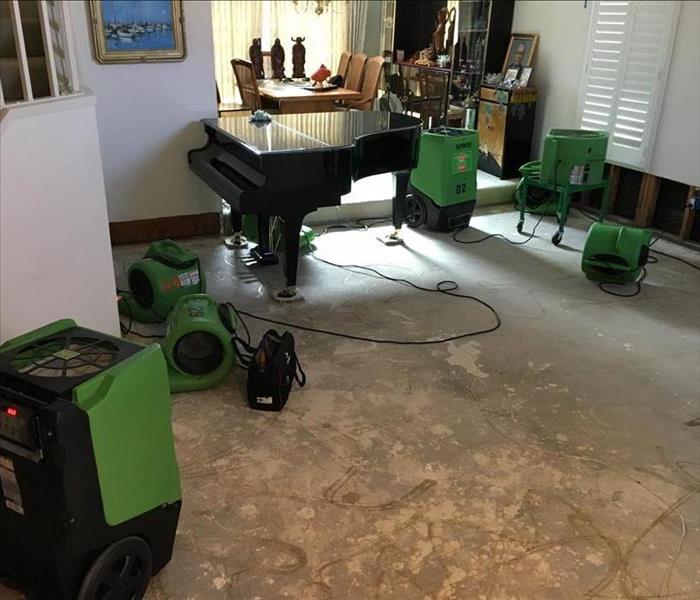 Drywall removed when flood water entered this living room in Orange, CA
Drywall removed when flood water entered this living room in Orange, CA
This home in Orange, CA was flooded with outdoor water. Flood water can carry bacteria and its important treat flood water damage a specific way. Affected materials like drywall, pad and carpet often have to be completely removed and replaced to make it safe again. SERVPRO of West Riverside City recommends removing the material at least 12 inches from where the water touched.
This home needed many of its walls cut thrown out along with their carpet and pad. The first photo shows the living room before anything was done, and the second photo shows our equipment drying out the structure and floor.
If you experience anything like a flood from the outside, please don't hesitate to call SERVPRO and get our professional opinion on what should be done!
Water Damage From Roof Leak in Riverside School
1/15/2018 (Permalink)
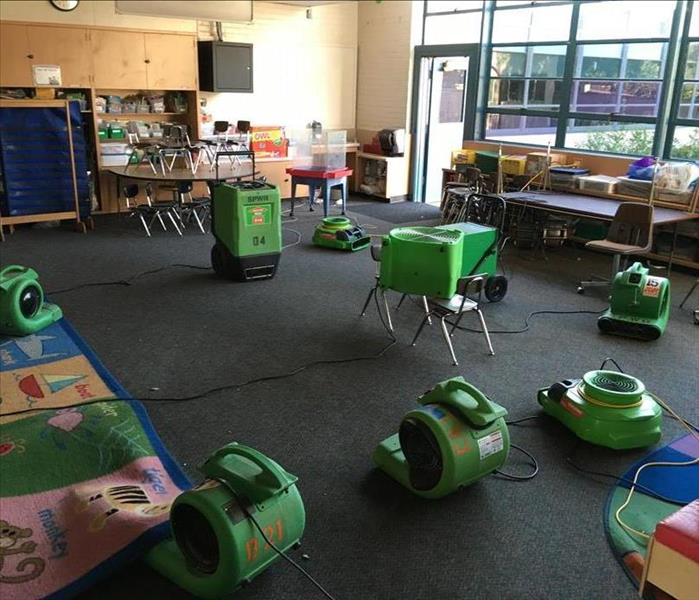 AIr movers and dehumidifiers drying out classroom in Riverside, CA
AIr movers and dehumidifiers drying out classroom in Riverside, CA
This school experienced a ceiling collapse due to a leaking roof and several classrooms were affected. The weight of the water caused the insulation to fall through the ceiling tiles and make a huge mess of water and insulation throughout many of their classrooms. SERVPRO of West Riverside City was able to help them coordinate with a roofer to fix the leak and then cleanup the entirety of the office. Our customer was impressed that they were able to begin using their classrooms again like normal within days of this accident.
Our Water Damage Restoration Process
Every water damage situation is a little different, and requires a unique solution, but the general process stays the same. The steps listed below illustrate our process for the “typical” water damage emergency.
Step 1: Emergency Contact
Step 2: Inspection and Damage Assessment
Step 3: Water Removal/Water Extraction
Step 4: Drying and Dehumidification
Step 5: Cleaning and Repair
Step 6: Restoration
Commercial Water Damage from Second Floor Unit
1/15/2018 (Permalink)
 This office was affected by water damage from the unit upstairs.
This office was affected by water damage from the unit upstairs.
Southern California is filled with tall buildings and boulevards filled with apartments, condominiums, town houses, businesses, homes, etc. This means if your neighbor has a pipe burst in their bathroom and floods his entire unit you more than likely are going to have some sort of damage to your property as well. Sometimes you might get lucky and escape the wrath of an angry burst pipe, but in the case you don't SERVPRO is the expert to call. We have been able to build special relationships with property managers and building owners that have used us either in the past or have been referred to us which allows us to help them with any properties they own or manage.
Call SERVPRO if you have experienced a water damage!
Boarded up after Car Crashes into Store Front
1/15/2018 (Permalink)
 We boarded up where the broken glass used to be!
We boarded up where the broken glass used to be!
A car crashed into the storefront of this business causing damage to his window and entrance. The owner did not know what to do and luckily his insurance referred him to the professionals at SERVPRO. He was thrilled to know that SERVPRO could temporarily make his business run until the damages could be completely fixed. SERVPRO of West Riverside City was there to complete the emergency board up of the business until repairs could be scheduled. The professional staff of SERVPRO are available 24 hours per day, 365 days per year, to help our customers in their time of need!
Insurance professionals, property managers and building owners contact us. They have confidence in what we do.
We also offer a no-cost Emergency Ready Profile, which is part of a disaster preparedness plan. You can start your by clicking HERE.
When you need us, call us. 951-351-8033
How to Prevent Fires Starting from Dryers
1/15/2018 (Permalink)
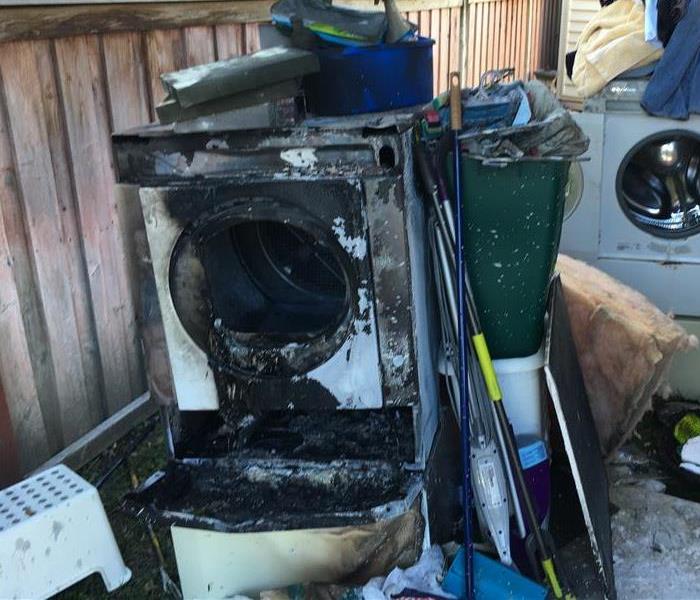 Please clean your dryer vents and ducting regularly for safety.
Please clean your dryer vents and ducting regularly for safety.
In 2010 an estimated 16,800 home fires, involving clothes dryer occurred.
- An estimated 2,900 clothes dryer fires in residential buildings are reported to U.S. fire departments each year and cause an estimated 5 deaths, 100 injuries, and $35 million in property loss.
- Clothes dryer fire incidence in residential buildings was higher in the fall and winter months, peaking in January at 11 percent.
- Failure to clean (34 percent) was the leading factor contributing to the ignition of clothes dryer fires in residential buildings.
- Dust, fiber, and lint (28 percent) and clothing not on a person (27 percent) were, by far, the leading items first ignited in clothes dryer fires in residential buildings.
- Fifty-four percent of clothes dryer fires in residential buildings were confined to the object of origin.
For more information click HERE
Fire Damage From Candle
1/15/2018 (Permalink)
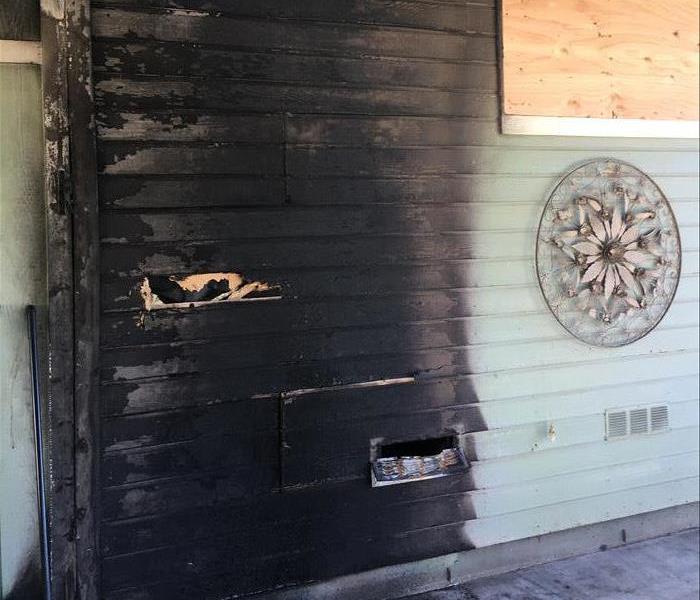 Fire Damage caused by a Candle
Fire Damage caused by a Candle
Smoke damage to walls can come in many forms, from the black sooty deposits that linger after a fire to cigarette smoke. The method used to clean this type of fire damage depends on the type of wall and the nature of the damage. After a house fire, it is always advisable to consult a professional restoration company. They have the tools, experience, and gear to do the job properly.
This home in Riverside was affected by a fire that started with a candle on a table. Read more about fire candle prevention tips here.
All traces of smoke and soot on the walls and furniture after this fire damage was properly cleaned and taken care of by SERVPRO.
If your walls have sustained smoke and fire damage, you can count on SERVPRO to restore them to preloss conditions quickly and efficiently, "Like it never even happened."
Water Damage From Heavy Rain Storm
1/15/2018 (Permalink)
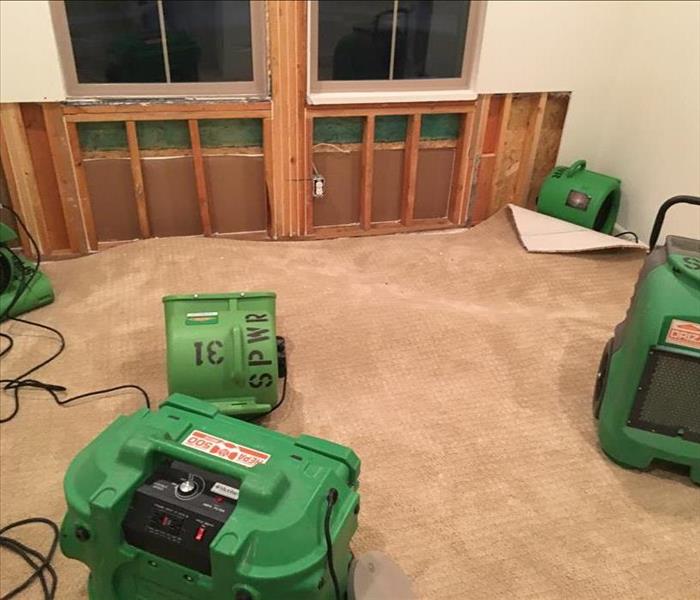 Water Damage affected wall under window from heavy rain
Water Damage affected wall under window from heavy rain
This customer experienced a water damage from the roof in a heavy rain storm in California. The first photo shows were most of the water came in, above the window! The after photo shows the demolition that had to be performed to dry out the home. SERVPRO of West Riverside City was able to complete the demolition and set equipment to dry the home within 24 hours. Our customer was expecting a much longer process and was thrilled that we were able to dry the home within four days. SERVPRO of West Riverside City is here to help 24-7!
If you have experienced any water damage in the last rains please don't hesitate to get professional help to clean and dry out your structure!
Roof Leak from Rain Storm in Riverside, CA
1/15/2018 (Permalink)
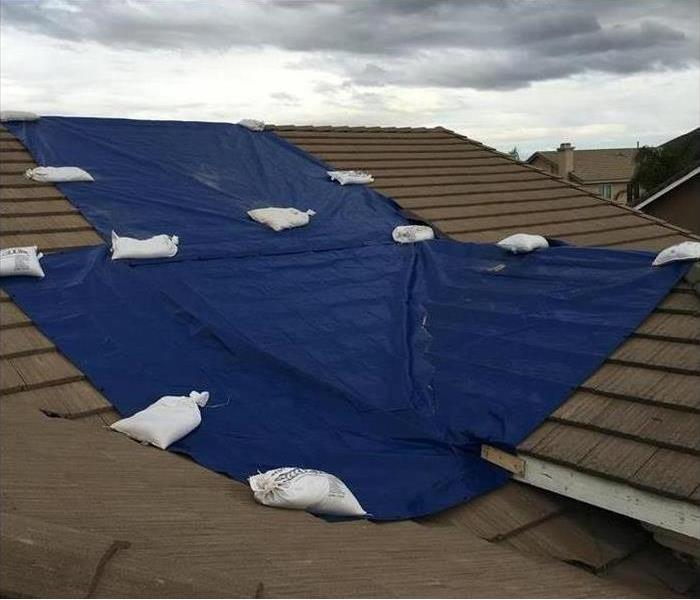 Roof Leak Repair after Rain Storm in Riverside, CA
Roof Leak Repair after Rain Storm in Riverside, CA
Once again the time of the rains have come. Although they may be short or very light, a surprise storm could always be just around the corner. Here we have a situation were a storm had enough strength to more some of the roof tiles around and cause a water leak that worked its way into the clients home. We received the call and quickly determined the general area it was coming from in the roof. With all the precautions in place, we were able to help the client with a tarp over the area strong enough to hold off the rain until it could receive proper attention and repairs.
Highly Trained Restoration Specialists
Our SERVPRO Professionals are highly trained in property restoration. From initial and ongoing training at SERVPRO's Corporate Training Facility to regular IICRC industry certifications, our Professionals are equipped with the knowledge to restore your property. The SERVPRO training program includes the follow:
- IICRC Training
- Employee Certification Training
- Initial Franchise Training
- e-Learnings
- Continuing Education Classes
Early Signs of Water Damage
1/2/2018 (Permalink)
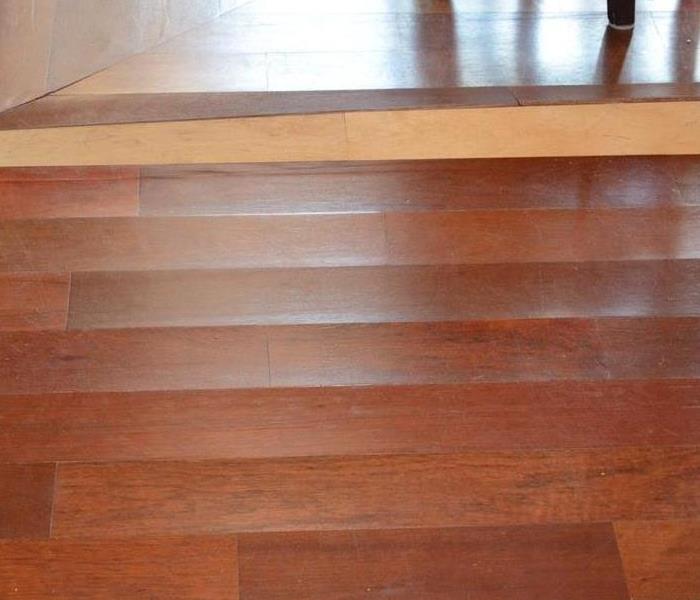 If you noticed any signs of water damage in your Riverside Home, call SERVPRO!
If you noticed any signs of water damage in your Riverside Home, call SERVPRO!
While it may seem like water damages should be easy to spot, many times their signs are subtle and hard to find. Water damages, particularly when they go unnoticed for a long period of time, can cause extensive damage to the structure of homes and they encourage mold growth. Early intervention can save you time and money. Here are some signs that you might have a water damage in your home:
Wall Stains – Water damages can leave yellow, brown, or copper colored marks on your walls or ceilings. Excessive moisture can also lead to peeling, cracking, or bubbling paint. If you see any of these in your home, you may have had a water damage in the past or may have one currently. Rust marks under sinks or on water heaters don’t necessarily mean you have a current leak issue, but they are areas that you will want to keep your eye on in the future.
Damage to Floors – Floor boards affected by water may be discolored, but more often will show texture changes. Warped floor boards have gaps between them and curl at the edges. Some boards may have a spongy, soft spot or sink down lower than normal. Water damaged floors may also buckle or expand.
Water Bill – If you notice that your water bill has been higher than usual then you may have a leak somewhere in your home. A water meter check, either of the flow indicator or an actual reading, can help confirm any potential leaks.
Odor – A musty odor can indicate both mold and a water damage. Mold can grow within 24-48 hours when provided with a source of moisture, so if you see any signs of mold in your home there is a good chance you have had a water damage.
If you suspect a water damage in your home it is time to call in the SERVPRO of West Riverside City. Call us for 24-hour emergency services at 951-351-8033.
What happens if you have a water damage?
1/2/2018 (Permalink)
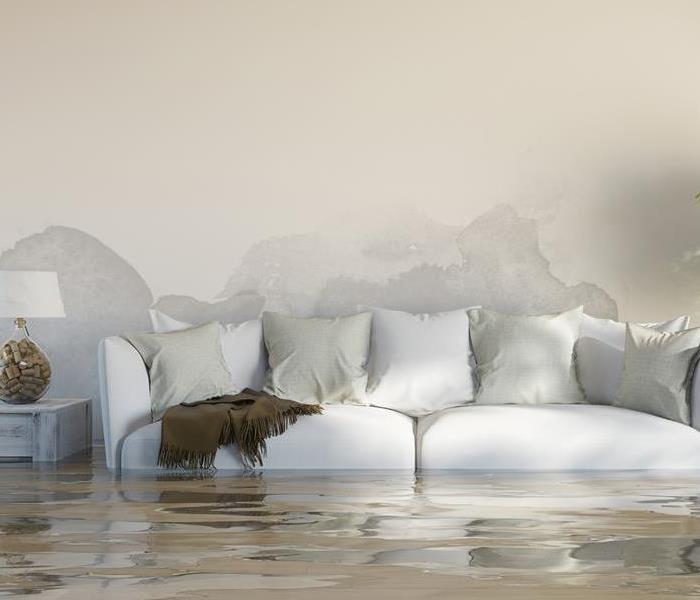 Questions regarding a water damage, don't hesitate to call us at 951-351-8033.
Questions regarding a water damage, don't hesitate to call us at 951-351-8033.
I Have a Water Damage. What Happens Now?
We’ve helped restore many homes and businesses after a water damage. For over 30 years, we’ve responded to water damage emergency calls on a daily basis. We can help you, too.
#1 Call us; we’ll be there in less than 4 hours
SERVPRO of West Riverside City’s promise is to respond to all water damages within 4 hours of receiving a call. We will gather information about your loss and dispatch a prepared crew immediately. We offer emergency services 24/7/365.
#2 Call your insurance (if you want to file a claim)
While we’re on the way, give your insurance provider a call and let them know what is happening. Inform them that SERVPRO of West Riverside City is on the way.
#3 Extraction
When we arrive, we will inspect the extent of the water damage and begin extracting all the water. Our crew will document all affected areas and begin the documentation process for your insurance claim (even when an insurance claim is not filed, our documentation process is still the same).
#4 Drying and Monitoring
Once all standing water has been extracted, we will set professional equipment to begin drying your home. We will place air movers, dehumidifiers, and possibly other specialty equipment for hard-to-reach places. We will return to your property once a day to monitor the drying process and remove equipment. For more information about our drying process, read here.
#5 Restoration
Restoration is the process of restoring your home or business to its pre-water damage condition. Restoration may involve minor repairs, such as replacing drywall and installing new carpet, or may entail major repairs, such as the reconstruction of various areas or rooms in a home or business.
If you find your property has experienced a water damage, don’t despair. We’re an experienced, certified, and professional team that can help.
SERVPRO of West Riverside City services Riverside and all surrounding areas. We can be reached 24/7 at 951-351-8033.
Follow us:
Facebook Twitter Google+
Wildfire Preparedness
1/2/2018 (Permalink)
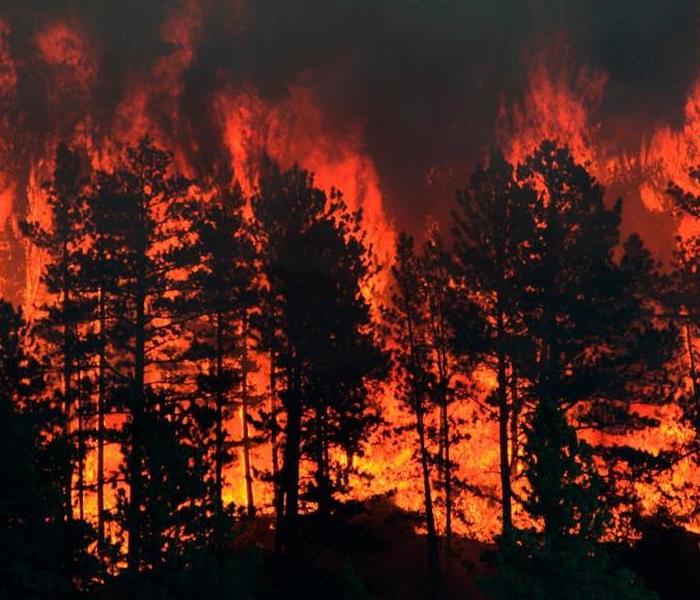 Have Questions about Fire, Smoke, or Soot Damage?
Call SERVPRO today
Have Questions about Fire, Smoke, or Soot Damage?
Call SERVPRO today
What
A wildfire is an unplanned, unwanted fire burning in a natural area, such as a forest, grassland, or prairie. As building development expands into these areas, homes and businesses may be situated in or near areas susceptible to wildfires. This is called the wildland urban interface.
Wildfires can cause death or injury to people and animals, damage or destroy structures, and disrupt community services including transportation, gas, power, communications, and other services. The impact may cover large areas with extensive burning, embers traveling more than a mile away from the wildfire itself, and smoke causing health issues for people far away from the fire. Wildfires damage watersheds leave areas prone to flooding and mudslides for many years.
When
Wildfires can occur at any time throughout the year, but the potential is always higher during periods with little or no rainfall, which make brush, grass, and trees dry and burn more easily. High winds can also contribute to spreading the fire. Your community may have a designated wildfire season when the risk is particularly high.
Before
Make a Wildfire plan
Know your wildfire risk.
- Familiarize yourself with local emergency plans. Know where to go and how to get there should you need to evacuate.
- Make a wildfire emergency plan including an evacuation plan and a communication plan.
- Many communities have text or email alerting systems for emergency notifications. To find out what alerts are available in your area, search the Internet with your town, city, or county name and the word “alerts.”
- Build or restock your emergency preparedness kit, including a flashlight, batteries, cash, and first aid supplies.
- Stay tuned to your phone alerts, TV, or radio, for weather updates, emergency instructions or evacuation orders.
After
Returning Home
Return home only when authorities say it is safe.
For several hours after the fire, maintain a "fire watch." Check and re-check for smoke, sparks or hidden embers throughout the house, including the roof and the attic.
- Use caution when entering burned areas as hazards may still exist, including hot spots, which can flare up without warning. Evacuate immediately if you smell smoke.
Cleaning Your Home
Wear a NIOSH certified-respirator (dust mask) and wet debris down to minimize breathing dust particles.
Discard any food that has been exposed to heat, smoke or soot.
Do NOT use water that you think may be contaminated to wash dishes, brush teeth, prepare food, wash hands, or to make ice or baby formula.
- Photograph damage to your property for insurance purposes.
Here are some more information about wildfires form ready.gov.
Have Questions about Fire, Smoke, or Soot Damage?
Call Us Today – (951) 351-8033
Disaster Preparedness
1/2/2018 (Permalink)
 Be Informed and Ready if a disaster where to strike.
Be Informed and Ready if a disaster where to strike.
Build A Kit
Make sure your emergency kit is stocked with the items on the checklist below. Most of the items are inexpensive and easy to find, and any one of them could save your life. Headed to the store? Download a printable version to take with you. Once you take a look at the basic items, consider what unique needs your family might have, such as supplies for pets, or seniors.
After an emergency, you may need to survive on your own for several days. Being prepared means having your own food, water and other supplies to last for at least 72 hours. A disaster supplies kit is a collection of basic items your household may need in the event of an emergency.
Basic Disaster Supplies Kit
To assemble your kit, store items in airtight plastic bags and put your entire disaster supplies kit in one or two easy-to-carry containers such as plastic bins or a duffel bag.
A basic emergency supply kit could include the following recommended items:
- Water - one gallon of water per person per day for at least three days, for drinking and sanitation
- Food - at least a three-day supply of non-perishable food
- Battery-powered or hand crank radio and a NOAA Weather Radio with tone alert
- Flashlight
- First aid kit
- Extra batteries
- Whistle to signal for help
- Dust mask to help filter contaminated air and plastic sheeting and duct tape to shelter-in-place
- Moist towelettes, garbage bags and plastic ties for personal sanitation
- Wrench or pliers to turn off utilities
- Manual can opener for food
- Local maps
- Cell phone with chargers and a backup battery
Download the Recommended Supplies List (PDF)
Additional Emergency Supplies
Consider adding the following items to your emergency supply kit based on your individual needs:
- Prescription medications
- Non-prescription medications such as pain relievers, anti-diarrhea medication, antacids or laxatives
- Glasses and contact lense solution
- Infant formula, bottles, diapers, wipes, diaper rash cream
- Pet food and extra water for your pet
- Cash or traveler's checks
- Important family documents such as copies of insurance policies, identification and bank account records saved electronically or in a waterproof, portable container
- Sleeping bag or warm blanket for each person
- Complete change of clothing appropriate for your climate and sturdy shoes
- Household chlorine bleach and medicine dropper to disinfect water
- Fire extinguisher
- Matches in a waterproof container
- Feminine supplies and personal hygiene items
- Mess kits, paper cups, plates, paper towels and plastic utensils
- Paper and pencil
- Books, games, puzzles or other activities for children
Maintaining Your Kit
After assembling your kit remember to maintain it so it’s ready when needed:
Keep canned food in a cool, dry place
Store boxed food in tightly closed plastic or metal containers
Replace expired items as needed
Re-think your needs every year and update your kit as your family’s needs change.
Kit Storage Locations
Since you do not know where you will be when an emergency occurs, prepare supplies for home, work and vehicles.
Home: Keep this kit in a designated place and have it ready in case you have to leave your home quickly. Make sure all family members know where the kit is kept.
Work: Be prepared to shelter at work for at least 24 hours. Your work kit should include food, water and other necessities like medicines, as well as comfortable walking shoes, stored in a “grab and go” case.
Vehicle: In case you are stranded, keep a kit of emergency supplies in your car.
Read more here to be prepared for any kind of natural disaster that might occur.
Candle Fire Safety
12/29/2017 (Permalink)
 If you experience a fire or smoke damage in your Riverside home, call SERVPRO for fire cleanup.
If you experience a fire or smoke damage in your Riverside home, call SERVPRO for fire cleanup.
The darker winter season is upon us and a lot of us enjoy candles to light up our homes. But did you know that are several thousand home fires every year that is started by candles?
Here are some facts about candles that might make you take extra precautions when it comes to candles in your home.
From 2009-2013, U.S. fire departments responded to an estimated 9,300 home structure fires that were started by candles. These fires caused 86 deaths, 827 injuries and $374 million in direct property damage.
Facts and figures
During the five-year period of 2009-2013:
- December is the peak time of year for home candle fires. In December, 11% of home candle fires began with decorations compared to 4% the rest of the year.
- Roughly one-third (36%) of home candle fires started in bedrooms. These fires caused 32% of the associated deaths and 47% of the associated injuries.
- Falling asleep was a factor in 11% percent of the home candle fires and 30% of the associated deaths.
- On average, 25 home candle fires were reported per day.
- More than half (58%) of home candle fires occurred when some form of combustible material was left or came too close to the candle.
- Candles caused 3% of reported home fires, 3% of home fire deaths, 6% of home fire injuries, and 5% of the direct property damage in home fires.
If you experience a fire or a smoke damage in your Riverside home, don't hesitate to call SERVPRO West Riverside City at 951-351-8033.
Read more here about fire prevention tips.
SERVPRO makes sure your HVAC system runs smoothly during the Winter season!
12/29/2017 (Permalink)
 If you experience the need for air duct cleaning, call SERVPRO!
If you experience the need for air duct cleaning, call SERVPRO!
The nights are getting colder and that means it’s time to switch on the heat.
Even in Southern California we do get some chilly nights during our winter and that's when you need your HVAC system ready and working efficiently to heat up those cool nights.
Here are 6 maintenance tips from SERVPRO that will help you enjoy a warm and cozy home all winter long.
- Clean and/or Replace the Air Filter
- Clean the Air Vents
- Add Some Insulation
- Check Your Thermostat
- Cover the Outdoor AC Unit if needed
- Schedule an Inspection from SERVPRO
SERVPRO is here to assist you. Through cleaning and repair, the experienced, professional, and friendly technicians at SERVPRO West Riverside will make sure your heating system is ready for the winter season. 951-351-8033
Mold grows year-round
12/29/2017 (Permalink)
 If there is cause for concern with mold growth in your Riverside home, call SERVPRO!
If there is cause for concern with mold growth in your Riverside home, call SERVPRO!
There is a common misconception that mold only grows in the warmer months. The truth is that mold doesn't discriminate based on the climate. Mold has the potential to grow year round, and SERVPRO of West Riverside City is here to help you avoid mold this winter.
Here are some ways that winter mold invades your home or business:
- Cranking up the heat in your home traps the warm air inside with no ventilation. Condensation builds up moisture and affects the relative humidity level. If the weather permits, consider cracking a window for a small amount of time to allow stale air to escape.
- Remove your shoes before entering your home. Dead plants and leaves are a source of heat on the ground and have the potential to release mold spores. Wet shoes in the winter will also release moisture into your carpets. Moisture entering a warm building with poor air flow can cause mold to grow.
- Make sure the windows and doors in your home are properly sealed to avoid moisture entering your home.
If you have concerns about mold growth in your home, please contact us at 951-351-8033 for an inspection.
Make your business ready for any emergency
12/29/2017 (Permalink)
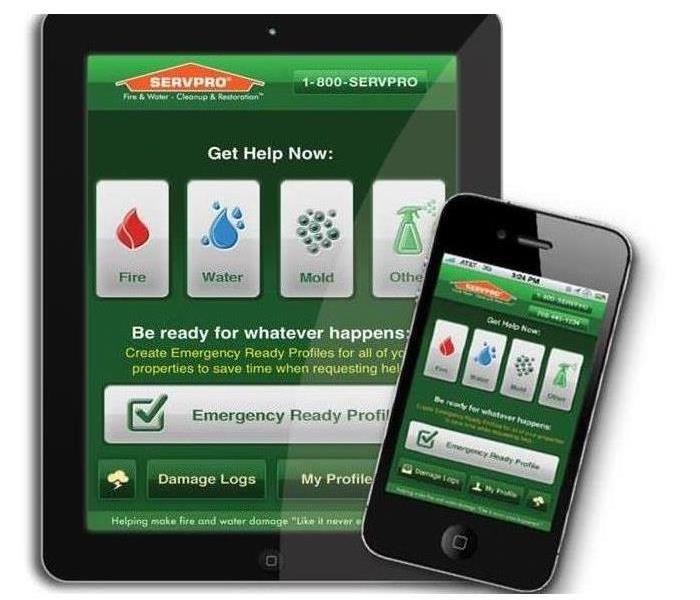 Riverside Businesses Benefit from Using the SERVPRO ERP Plan
Riverside Businesses Benefit from Using the SERVPRO ERP Plan
Use SERVPRO's ERP Plan to Help Prevent and Mitigate Losses
Water has the potential to damage any business. A broken pipe or leaking faucet in your Riverside business could lead to temporary closure or water damage to equipment or furnishings such as your carpet or drapes. Any closure or destruction is bad news for your business because not only do you lose money when you are closed, but you also have to pay to replace any damaged items. That is why SERVPRO recommends salons have a water removal plan in place to guide you should the worst happen.
Your Riverside business might need water removal at any time. You cannot always prevent leaks or spills from occurring, but you can draw up an emergency plan so that you and your staff know what to do and whom to call in the case of an emergency. We recommend including these key points.
Who to call in an emergency: Make sure everyone knows whom to call when something happens. Include managers, emergency services if necessary, and of course, do not forget to add SERVPRO. Our IICRC-certified technicians have free standing and truck mounted pumps and a range of extraction tools on hand to deal with any water removal needs.
The chain of command: Your staff needs to know whom to call and who is responsible for each aspect of the cleanup and water removal operation.
Insurance details: Ensure everyone knows how to contact your insurers and has all the insurance details to hand. Not all business insurance covers water removal so make sure you have the right coverage in place before anything happens.
Action steps: Set out a list of action steps to take, for example moving items to a higher position, or stopping the flow of water until the emergency services arrive, if possible.
Plan for reopening: The idea is to get your business up and running again as fast as possible. Have a plan in place to make the process smoother and easier.
The SERVPRO Ready Profile Plan has an easy to use app that makes it easy for business owners to plan for water removal and other incidents. You get the guidance you need to assess your premises and draw up an emergency plan, and also receive downloadable forms and plans you can use in an emergency.
For help with water removal in Riverside and surrounding areas, call SERVPRO of West Riverside City at 951-351-8033 today.
Learn more about making your business ready for any emergency here!
Repeat Customer Happy to See SERVPRO
12/27/2017 (Permalink)
Some times when we wrap up a job, a happy customer will joke "It was a pleasure meeting you but I hope we never see you again!" We don't take it personally. We don't wish that stressful situation on anybody.
But one recent customer was thrilled to see SERVPRO of West Riverside for the second time in as many years. This particular customer was disabled, so when she had a flood late at night affecting all of the bathrooms and bedrooms in her home, a caretaker was tasked with contacting a restoration company to respond. When the homeowner saw Gary walking through the door, she gave him a big hug and said "I'm so happy to see you again, I had no idea who would be coming this time!" We are so pleased to provide our customers with a good experience that leaves a lasting impression.
Flooded Office Building in Jurupa Valley
12/27/2017 (Permalink)
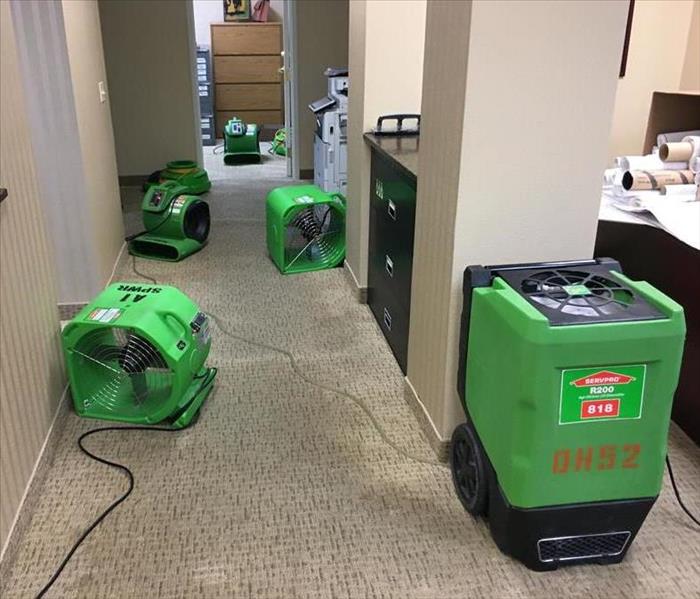 This workplace needed to get dried out, but it didn't mean that business had to be disrupted.
This workplace needed to get dried out, but it didn't mean that business had to be disrupted.
Any business owner knows that water or fire damage to your business can really be crippling. Our goal SERVPRO of West Riverside City is to get your business up and running as soon as possible.
We were able to accomplish that goal on this job in Jurupa Valley. The SERVPRO crew responded late in the evening to extract almost 200 gallons of water in multiple office suites from a broken pipe on the second level. We moved two businesses on the lower level into other unoccupied suites so that by the time they arrived for work the next morning, they were able to resume work almost immediately! Serving businesses and their unique needs is one way SERVPRO of West Riverside City helps make it like it never even happened.
Small Mistakes can Lead to Major Water Damage
12/27/2017 (Permalink)
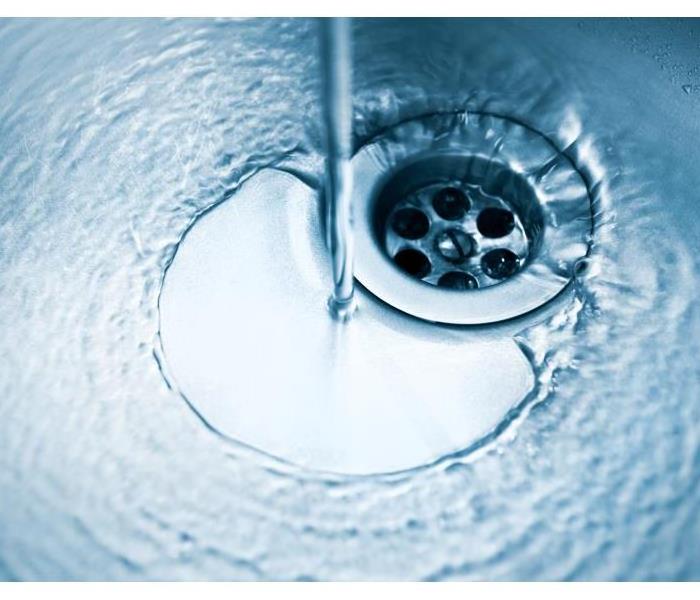 Clogged Water Drains cause Water Damage in Riverside Homes, Call SERVPRO for Water Removal and Dry-Out
Clogged Water Drains cause Water Damage in Riverside Homes, Call SERVPRO for Water Removal and Dry-Out
Accidents are not always kind to the average homeowner. Something as simple as forgetting to turn off a faucet can have disastrous results to your Riverside house. These unexpected and potentially damaging accidents are amplified considerably when there are young children in the home. Regardless of how it happened, you want to know how to clean up the mess it has left behind.
Water damage in Riverside homes is not something uncommon, but it can very quickly put your life to a halt. Though you may return in a short time, this surplus of water can seep into your flooring can create a substantial mess. Even the most careful and diligent of homeowners cannot account for a brief bit of forgetfulness, and it can often require restoration services and water removal efforts.
The trouble with excessive water damages is that there are often issues that you cannot even see fully with the naked eye. Structural weaknesses in your floors or walls can be made exponentially worse with the presence of water, and these kinds of lasting damages are not always apparent. That is why giving our SERVPRO team a call can help you to keep total damages to a minimum and provide a peace of mind that you have seen the last of the trouble the accident created.
Fortunately, our SERVPRO emergency response team is available 24/7 to help you get your house back in order quickly and mitigate costs associated with the problem being allowed to get worse. Restoration is a process that begins with the removal of all of the water via wet vacs. Pumps are used if the volume of water exceeds the limitations of portable wet vac units, and then drying air movers are set up to remove all trace of lingering moisture from the incident altogether.
Accidents are just that: accidents. You cannot anticipate when they might happen or the potential damages they could do, but you do know who can clean up the messes they create. Give our team at SERVPRO of West Riverside City a call anytime at (951) 351-8033.
Click here for more about Riverside.
Will Your Roof Leak This Year?
12/1/2016 (Permalink)
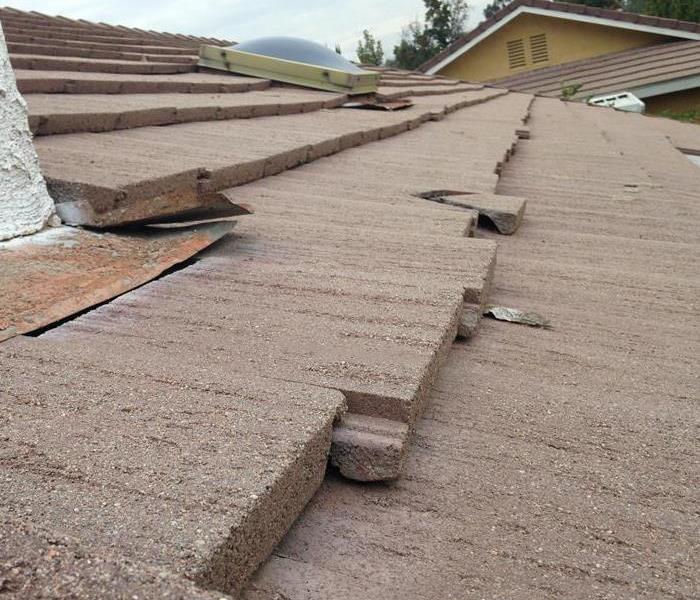 A home roof in Riverside CA with some sipped and cracked tiles...
A home roof in Riverside CA with some sipped and cracked tiles...
Got leaks?
The weather in southern California is hard to beat. We get lots of sunshine, low humidity and a nice long summer to accommodate for all of our activities. However, this is exactly why we can get in trouble when we enter our short rain season. We don't get much rain so we assume our roofs are in good shape, often times not thinking twice on giving them some maintenance work from time to time...
During this potential rainy season, we will receive many calls from homeowners that will unfortunately have water damage in their homes due to roof leaks. Many can not be prevented if we have a heavy storm but the vast majority can actually be prevented. So lets take a look at some of the very common situations we come across.
Slipped Tiles: These can be ceramic tiles or concrete tiles. both have some nice weight to them and can usually withstand some heavy winds. But from time to time and over time, these heavier tiles can slip or slide away from their original position creating gaps in the surface area where potential water damage can occur. Wind, heavy water flow and the weight of the tiles settling in over years can all cause this "slippage". Also, broken tiles from objects impacting them can be a problem along with the occasional cracked tile from someone walking on it...
Missing Shingles: This is more topical of your asphalt shingle roofing. Asphalt shingles are very popular and perhaps the most commonly used. Their appearance is like that of sandpaper some say. They have good durability and usually come with a smaller price tag. With this kind of roofing we usually see "missing shingles". It is typical wear-and-tear that usually makes this happen. Over time heavy winds can eventually lift a shingle and continually work it to the point it detaches. Bad installation can also result in compromised performance when storms or wind hits.
Wind Driven Damage: This can and will happen to basically any type of roof. Wind driven damage is a term used to describe a situation where the wind was strong enough to be the main reason behind the damage. Strong wind can blow out weak or poorly installed shingles but when coupled with rain, it can actually force water to move up and under the roof shingles regardless of type. Water will usually find its way into the attic. In a situation we encounters not to long ago. Hail was present during a strong and windy storm. The wind was strong enough to push the smaller hail pellets up and under the roof shingles. The home owner thought the worst was over after the storm was done. However, it did not take to long for the hail deposited in his attic to start melting and cause massive water damage.
Tips:
1) We recommend doing a yearly routine inspection of the roof ether by carefully doing the inspection yourself or getting a professional to do it for you. We strongly recommend getting help to do this inspection if you are not comfortable doing this yourself. It can be dangerous work if not handled properly.
2) Also, have your gutters cleaned out to prevent water from pooling along the gutter and flowing into the attic.
3) Pay close attention to wood shake shingles if you have them. They can be very easily damaged when old or worn out.
4) Don't forget that many times your home owners insurance can help in situations like this. Always check with your insurance agent first before putting in a claim.
5) Finally, getting an inspection from a trusted service provider that works with all insurance companies like ourselves can be of great value in keeping cost and time spent down should anything happen.
We hope this helps out and helps keep you dry and leak free!
SERVPRO of West Riverside City Cares!
11/29/2016 (Permalink)
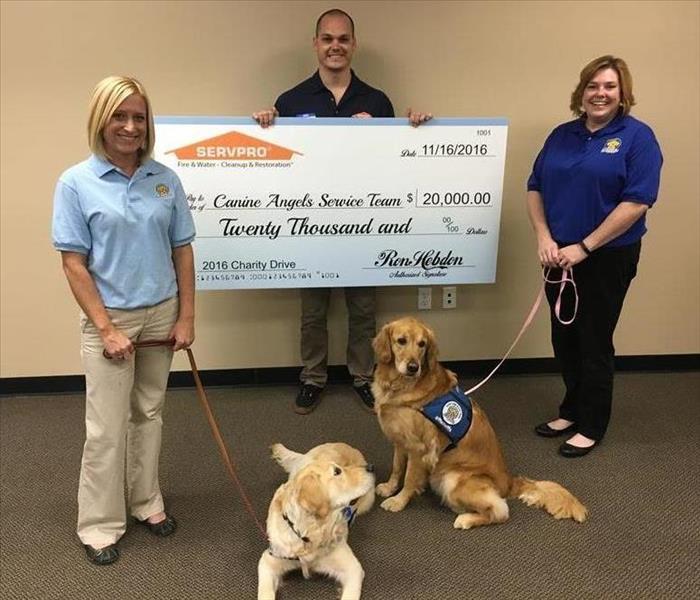 Canine Angles team along with Calypso and JJ receive a gift from our very own Christopher!
Canine Angles team along with Calypso and JJ receive a gift from our very own Christopher!
Helping Weave The Fabric of Our Community
Being a local franchise of the Riverside area in CA, we get to experience the community first hand. We are professionals trained to perform our professional services, but we also care for our clients and community. When we heard of an organization called "Canine Angles Service Team" helping our local and neighboring communities, we had to take a closer look. We liked what we found and decided to help them make a change and deliver a good impact to the life of others.
Canine Angles Service Team is a company that provides highly trained service dogs specifically to children. We were touched by the help and joy that this organization brings to others and decided to seize the opportunity to help them with their quest to bring service along with a smile to our community. We were able to make a very nice contribution to their work and even though we did not expect anything in return, we were rewarded with meeting some of the team members which included Calypso and JJ the service buddies! Here is a link to their website should any like to read more about the great service they provide.
Canine Angles Service Team
On behave of SERVPRO West Riverside City, congratulations Canine Angles and keep up the good work!
Smoke Types
10/5/2016 (Permalink)
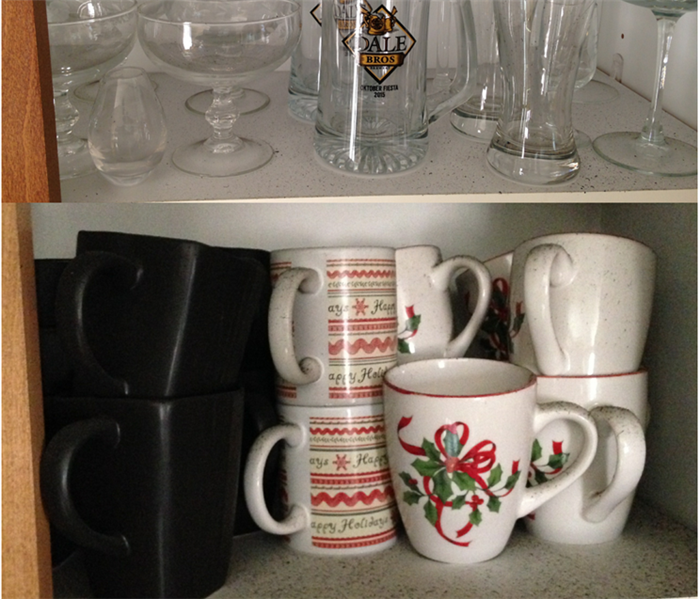 Contents inside cabinets affected by candle fire that created "Wet Smoke" damage in Riverside CA.
Contents inside cabinets affected by candle fire that created "Wet Smoke" damage in Riverside CA.
Let's talk smoke...
So just like everything else, smoke has a few secrets and tricks to it that most people are not aware of, but here at SERVPRO of West Riverside City, it’s our job to know them to properly conduct smoke damage restoration when we get the call.
A client gives us a call after coming home and finding that a small candle that was left lit while they were gone burned down to its end but not before burning its decorative plastic wrapper, a table cloth and a leather phone case. As well as melting other nearby objects like hand lotion bottles. These items produced a type of smoke categorized as “Wet Smoke”. This is because when most plastics and synthetic man made materials burn, they produce a dark, sticky ash that almost behaves like grease. Unfortunately, when our clients got back home, that’s the ash that awaited them and it covered all their belongings. Thankfully, the worst did not happen and their home was not lost or damaged from the fire other than needing an extensive cleaning and painting some of the walls and ceilings.
So why is identifying the smoke type important information for us? Because now we know the kind of cleaning method we will need to utilize when attempting to restore the house to its former glory. “Wet Ash” must be cleaned off the walls with a wet method such as a cloth damped in a special solution to most effectively remove the ash. When something like paper or wood burns, it produces a “Dry Smoke” that can be cleaned with a dry method such as using a special dry sponge that will collect the ash in its pores. Attempting to clean these different ash types with reversed cleaning methods will result in further damage or permanent staining of the surface.
Smoke Types
Wet Smoke - Plastics and Synthetic Materials. Low heat, pugnant odor, sticky residues.
Dry Smoke - Paper and Wood. Fast burning, high temperatures.
Protein Smoke - Food. Virtually invisible residues, discolors paints and varnishes, extreme pugnent odor.
Fire & Smoke Damage Tips
Do:
- Limit movement in the home or work area to prevent soot particles from being embedded into upholstery and carpet.
- Keep hands clean. Soot on hands can further soil upholstery, walls and woodwork.
- Place dry, colorfast towels or old linens on rugs, upholstery and carpet traffics areas.
- If electrical is off, empty freezer and refrigerator completely and prop doors open to help prevent odors.
- Wipe soot from chrome on kitchen and bathroom faucets, trim and appliances, then protect with these surfaces with a light coating of lubricant.
Don’t:
- Attempt to wash any walls or painted surfaces without first consulting a professional.
- Attempt to shampoo carpet or upholstered furniture without first consulting a professional.
- Attempt to clean any electrical appliances (TV sets, radios, etc.) that may have been close to fire, heat or water without first consulting an authorized professional.
- Turn on ceiling fixtures if ceiling is wet. Wiring may be wet or damaged and cause electrical shock, and air movement may create secondary damage.
Flooded Home In Riverside
8/19/2016 (Permalink)
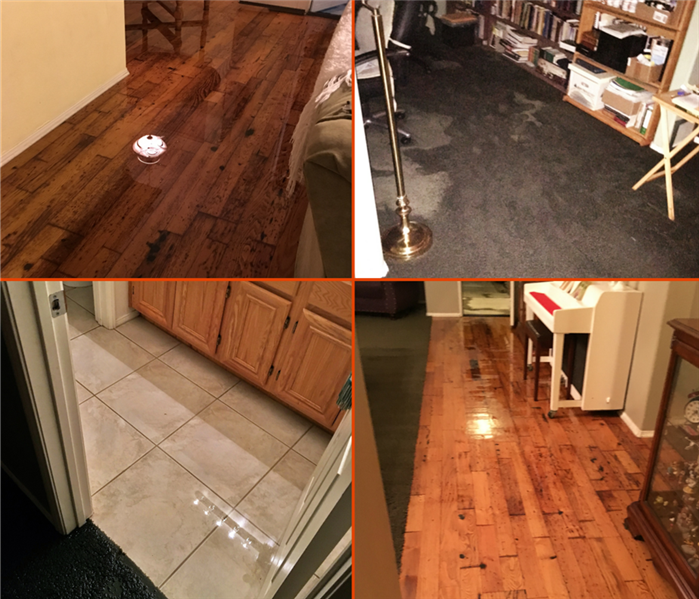 Different shots of the initial water damage found
Different shots of the initial water damage found
The Water Bug Bites...
There is nothing better than coming home from a nice family vacation and getting some rest as you settle back in. But what happens you when you come home only to find a massive water problem?
The Story
That is exactly what happened to a family in Riverside. After a good vacation with their loved ones, they come home late in the evening only to see a horrifying site. Water streaming out from their front door. As they go inside to see what the problem could be, they find that the vast majority of their home is flooded. Carpet, padding, furniture and wood flooring have all fallen victims of water damage. The problem? The toilet supply line in the master bedroom had ruptured and leaked for an indefinite amount of time. Thankfully the client was familiar with SERVPRO and did a quick search for the closest franchise to him.
The Call Out
Approximately around 10:30PM Christopher gets the call from the home owner and the restoration process begins. Some information of the loss was gathered, tips were given to the home owner and the vehicle was dispatched to give the customer the much needed help.
Upon arrival, the extent of the damage was very apparent but even then a thorough inspection is needed to make sure we find all the areas where water could be hiding from our view. Carpet is completely soaked, walls and lumber are wet and even the reclaimed wood flooring has turned into a water bed. A few hours pass while the water extraction is being conducted to remove all excess water from the scene and the environment is finally getting under control. Equipment was placed to start the dry down process and contents such as furniture and light stands are all propped up to prevent water damage to occur to them or the carpet. The next day our technicians are ready for round two.
The Conclusion
After a few days of work and great progress, the home owner cheers up and can see the hope for him and his family at the end of all this. He shares with us how happy he is with his decision to call us out and thanks us for being attentive and treating his home with respect. Soon, the home owner and his family will be back at work doing whatever it is that made them happy at home and will not have to worry about mold or any issue relater to this water loss because they know we indeed made it "Like it never even happened".
Did you know water has different categories?
7/27/2016 (Permalink)
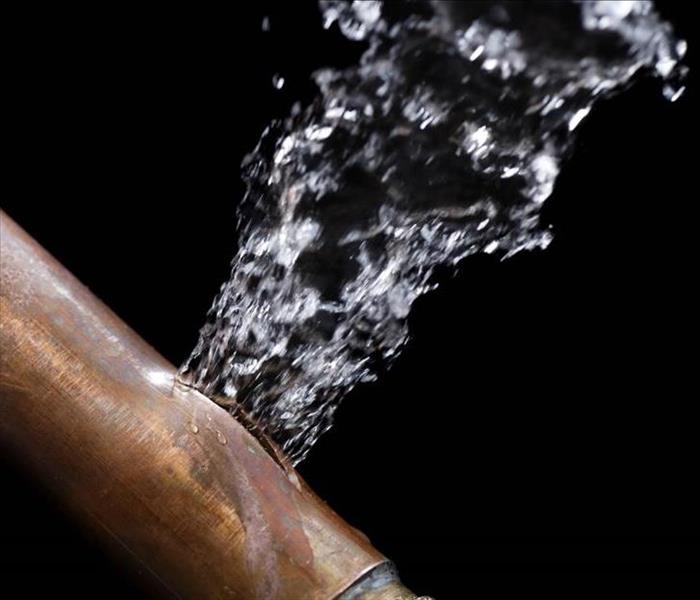 Even water from a clean source like a broken pipe can quickly change category if left unattended.
Even water from a clean source like a broken pipe can quickly change category if left unattended.
Water Types play a huge roll in how a professional will decide to tackle any water loss. Many people are not aware that water is categorized by the amount of pollutants it carries or that it picks up as it travels through materials. This is very important to note because as water dries up, these pollutants will be left behind or can even be blown around the area with air movement or foot traffic creating a potential hazarded to health and safety. Sometimes, it’s best to get rid of affected materials instead of drying them and risking your safety and the safety of others.
Categories
Clean – Broken pipe, icemaker, drain overflow - No waste or contaminants
Gray – Washing machine, dishwasher, roof leak - Some soils and contaminants
Black – Raw sewage, floods - High degree of waste and contaminants
“The safety of our clients and their 100% satisfaction in our services is always part of our goal.”
Should You Mitigate?
7/1/2016 (Permalink)
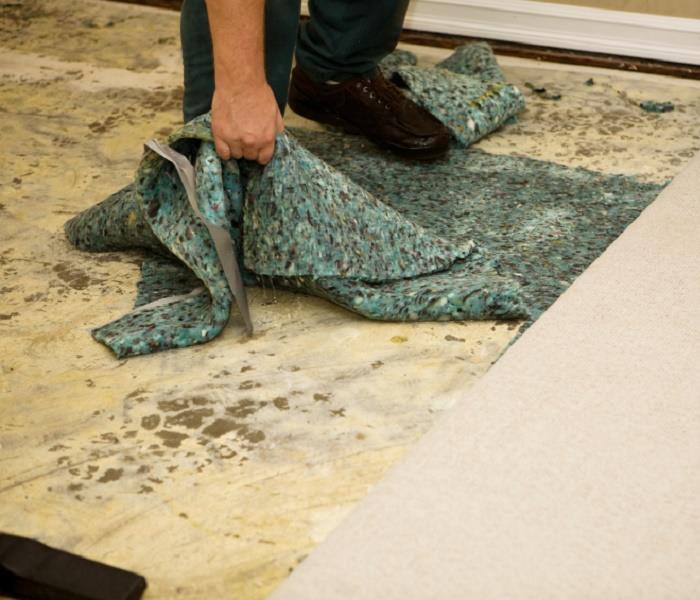 Water Damage traveling through carpet & carpet padding
Water Damage traveling through carpet & carpet padding
When it comes to Water Damage, it is critical to have proper mitigation as soon as possible to prevent the spread of damage. But what exactly is mitigation?
Mitigation is defined as the action of reducing the severity, seriousness, or painfulness of something.
In the case of a water loss, part of what is done to reduce the severity of damage is to extract any excess or standing water from the site. Standing water in a structure can be very dangerous and has a very high potential to increase the severity of the damage by seeping through building materials such as carpet, padding, wood floors, vinyl and even walls! But it doesn’t stop there, if left unchecked it can damage furniture, create rust stains, destroy paper goods and worst of all it can accelerate bacterial and fungal growth leading to mold. All of this can also be done by any unchecked moisture and not just by excess or standing water. This is why it is critical to have quick mitigation but also a proper restoration as a whole.
So, Why Mitigate?
• Mitigation reduces the losses of life and property
• Mitigation enables people to recover more quickly from disasters
• Mitigation lessens the financial impact of disasters
When to Mitigate:
• Water damage
• Fire
• Vandalism
• Crime Scene
We are here to help!
6/14/2016 (Permalink)
 Quick response with a portable water extractor
Quick response with a portable water extractor
A pip bursts. A water heater leaks. A bathtub overflows. A sprinkler system malfunctions. Flood waters rush in. Water damage can happen in any number of ways. But if your business or home is under a few inches of water, everything else takes a back seat. The only thing in your mind will be to find a solution and quick.
Your local SERVPRO® franchise of West Riverside City is exactly that solution. We understand the stress a situation like water damage can introduce to your life and we want to help you get rid of it quickly and efficiently. We have experienced with our clients that simply having someone show up onsite ASAP, begins to alleviate some of that overwhelming stress. This is because knowing that you have the right people for the job makes all the difference in the world, especially when its your work place or even worse, your home. We understand the importance of diong things as quickly, carefully and thoroughly as possible so you can return to your regular activities.
Tips
This is why we recommend that you take the time to visually inspect your work area and/or your home and become familiar with were critical things like the main water and gas shut off valves are located. This simple knowledge will empower your ability to take quick actions should anything happen in the future. Also, keep a list of helpful contacts for any number of different situations that could play out in your home or work place. And dont forget that we are ready, local and just a phone call away from serving you.
Free Inspection Code AC20, call now: 951-351-8033
The Behavior of Smoke
10/27/2015 (Permalink)
A fire loss can result in complex damages because of the unique behavior of smoke. Our professionals know smoke can penetrate various cavities within the structure, causing hidden damage and odor. Here are some facts you may not know about smoke.
The grilling fun isn't over!
7/22/2015 (Permalink)
Here are a few simple tips to keep in mind this summer while cooking...
Water Damage Facts From Discovery
6/2/2015 (Permalink)
May showers can create flood conditions faster than you may realize. Here are some interesting facts about #WaterDamage from our friends at Discovery.
Check out this 30 sec video from Discovery
#SERVPROWestRiverside
#EarthDay
4/22/2015 (Permalink)
Today is #EarthDay! How will you make a difference today?
Facebook #EarthDay
Emergency Preparedness Checklist
3/25/2015 (Permalink)
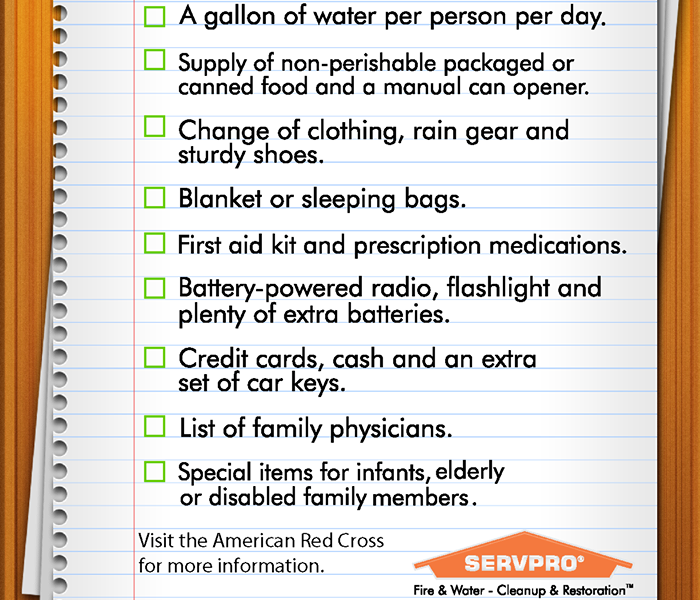 Emergency Preparedness Checklist
Emergency Preparedness Checklist
This week we're gathering supplies for our Emergency Preparedness Kits. We'll show you how it turns out, so you can make one for your home or business.
Check out our Twitter Page
Did you know?
8/22/2014 (Permalink)
Fire sprinklers have been saving lives for more than a century! Stopping a fire early may reduce the amount of property damage.
http://www.servprowestriversidecity.com/fire-smoke-damage-restoration
Emergency Ready Plan
8/14/2014 (Permalink)
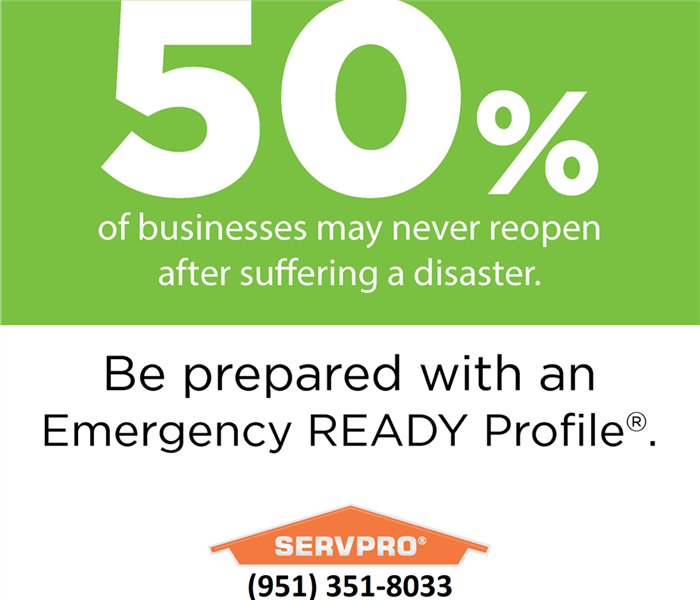 Emergency Ready Profile with SERVPRO West Riverside City
Emergency Ready Profile with SERVPRO West Riverside City
Knowing what to do and what to expect in advance is the key to timely mitigation, and can help minimize how water and fire damage affect your business.






 24/7 Emergency Service
24/7 Emergency Service































